
- korean culture / Rest Of Korea / Seoul Travel Blog

Guide To Tipping In Korea, The Dos And Don’ts
· Updated April 4, 2023 THIS POST CONTAINS AFFILIATE LINKS
Tipping in Korea is not a common practice and is generally not expected. In fact, attempting to tip someone may even be seen as rude or disrespectful. This is because the culture places a strong emphasis on mutual respect and egalitarianism. Instead of tipping, it is more common to show appreciation by simply saying thank you or complimenting the service provided.
However, in some cases, such as high-end restaurants or luxury hotels that cater to foreign tourists, tipping may be accepted or even expected. In these cases, a tip of around 10% may be appropriate.
Overall, visitors to Korea should be aware of the cultural norms around tipping and should not feel pressured to do so if it is not customary. Read on to find more about tipping in Korea.

If you do decide to give a tip in South Korea, don’t give cash directly from your wallet or pocket. Always place the money in an envelope before giving it. These envelops can be bought in any convenience store as they are also used when giving money at a wedding, funeral, Korean national holiday, etc.
Do You Tip In Korea?
Things to know when visiting korea, 1. tipping in restaurants, 2. tipping taxi drivers, 3. tipping tour guides, 4. tipping in hotels & spas, south korea tipping etiquette, frequently asked questions.
To the question ‘do you tip in Korea’, the answer is no, you are not expected to tip in Korea. This is not part of the culture, and some people might even be confused or offended by this action, but there are some occasions where tipping is accepted.
The ground rule is not to tip in any restaurants, except if there is a tipping jar. You can tip a taxi driver by telling them to keep the change and tour guides that are used to working with foreigners or Americans will happily accept a small tip. In other occasions tipping in South Korea is a no no. Only tip in big cities like Seoul or Busan .
- What To Wear In Korea – Summer is humid and hot, with temperatures going up to 40°C. Winters are cold and dry, with temperatures dropping to -20°C. Check what to pack for Korea here.
- Power Adapters – If you are from the USA, UK, Japan or South East Asia then you will need the right travel adapter when coming to Korean. Find more info about travel adapters here.
- T Money Transport Card – When going around the country using public transport like subways, buses and even taxis then make sure to buy a T Money card upon arrival at the airport. More info here .
- Foreigner Special Discounts – Check out Trazy or Klook for the best discount packages designed for foreigners. These include tons of restaurants, museums, attractions and experiences.
Tipping In Korea
Tourists from the USA are so used to tipping, especially when going to eat out in a restaurant . Korea is the exact opposite, tipping is something most people are not in favour of, and many even refuse to accept tips. The general rule is, you are paying for a great service, why should you have to pay extra? The best thing to do in a restaurant is not to tip, just be polite to the staff and thank them for their services.
But, more and more western restaurants are starting to put tipping jars on the counter, if you notice a tipping jar, that means the restaurant is open to accepting tips from their customers. Best thing to do is put your tip in the jar instead of giving it to one of the staff members. This is only recommended in western style restaurants, not traditional Korean restaurants.
Don’t forget when entering or leaving a restaurant to do a small bow with your head towards the staff and say annyeonghaseyo to the person at the reception desk. This is a polite way of saying hello. Do the same when leaving, but instead of saying annyeonghaseyo, say kamsahamnida. This is a polite way of thanking the staff for their services.
Korea is a country of excellent public transport . The subway and bus system is superb. Sometimes you need to get somewhere fast and then taking a taxi is the best option. As a foreigner be weary when taking a taxi, make sure they use their meter and don’t take any detours. When taking a taxi make sure to have the address of your hotel written in Korean, so you can show this to the taxi driver. Alternatively you can point to your destination on a map.
They are generally easy to find and can be hailed on the street or through ride-hailing apps like KakaoTaxi or Uber. The taxis in Korea are usually color-coded, with orange taxis indicating regular taxis, and black taxis representing premium or deluxe options. Taxis in Korea are typically clean, safe, and equipped with GPS systems to ensure drivers take the most efficient routes.
However, fares can be higher than public transportation, especially during peak hours. It is important to note that some taxi drivers in Korea may not speak English, so it is recommended to have your destination written in Korean or a translation app handy.

It is not a common thing to do, tipping your taxi driver. Especially because you can pay with card in the taxi. Nowadays taxi drivers have a bad reputation, as they drive super fast and have a hard time communicating with foreigners. But sometimes you find that really great taxi driver, that drives carefully and is friendly. In those occasions you might want to tip. The best way to tip a taxi driver is to pay with cash and tell them to keep the change.
In case of tour guides, tipping can be done as most tour guides are used to receiving tips because they are working for an American tour company or get in contact with many foreigners that are used to tipping.
This isn’t mandatory, but most tour guides will appreciate the gesture and be happy you liked their services. Only tip tour guide in the touristic areas of Korea, tipping a tour guide in the countryside is a no no as they are not used to this gesture and might be confused or offended.
The staff in hotels or spas in South Korea do not expect a tip. This might even be refused when you decide to leave a tip, don’t be offended if this happens. If you do decide to leave a tip, place the money in a pretty envelope you can find in any convenience store and leave the tip behind in the room when checking out. Do not give the tip in person .

In spas or traditional Korean jjimjilbangs you should not leave a tip. Just be polite to the staff and thank them for their services. Don’t forget to do a bow when greeting the staff. This counts for greeting any Korean person.
When you do decide to offer a tip in South Korea, the etiquette rules are quite different than in the USA. You don’t just take out your wallet and give the staff some cash.
First of all check if the establishment has a tipping jar, if there is no jar, put the cash into a nice envelope and hand it over using both hands. This is the same for handing over business cards . Business are always handed over and received with two hands.
These envelopes can easily be found at a Korean convenience store or one of the stationary shops like Daiso or Artbox .
Tipping is not common in Korea and is not expected in most service industries. In fact, in some places, such as traditional Korean restaurants, leaving a tip may be seen as rude or disrespectful. It is more customary to show appreciation by using polite language, making eye contact, and thanking the person for their service.
While tipping is not expected, if you receive exceptional service and wish to show your appreciation, you can do so by giving a small gift or offering to pay for a meal or drink. Gifts such as small souvenirs from your home country or a thoughtful handwritten card can also be a great way to express gratitude.
If you do decide to tip, it is generally not expected to leave a large amount. Instead, a small amount, such as 5-10% of the total bill, is considered generous. However, it is important to keep in mind that tipping is not customary in Korea and the person receiving the tip may feel uncomfortable or embarrassed.
Liked this blog post about tipping in South Korea and the dos and don’ts? Why not pin it ?

Are you planning on visiting South Korea and have any more questions about the South Korea tipping customs? Let me know in the comment section below.
You may also like....

Paragliding In Korea | Yangpyeong, Gyeonggi-do
April 11, 2023
by Marie · Published April 11, 2023

Incheon Airport To Seoul Station

How to Enjoy a Traditional Korean Jjimjil bang or Bathhouse
April 10, 2023
by Marie · Published April 10, 2023
4 Responses
- Pingbacks 0
Useful information. Thank you.
I am just beginning to do some research to travel to South Korea.
I want to move to South Korean when I’m 19 or 20 and attend college there. Is that a good idea?
I really appreciate the guide. This is very helpful and allows me to respect the culture.
I appreciate this a lot. I’m writing a book and wanted to know if one character should tip the other and if yes, then how should they do it. So thank you 💙✨
Leave a Reply Cancel reply
Your email address will not be published. Required fields are marked *
- Next story The Most Instagrammable Places In Seoul
- Previous story New Year Eve In Seoul | Where To Celebrate
DON’T MISS OUT

In My Korea
Complete South Korea Travel Guide 2024: Korean Travel Tips
Planning a trip to Korea but not sure where to start? First-time traveller who isn’t sure if Korea is the right country for your next trip? Worried about travelling to Korea and facing problems with the Korean language, culture, money, Internet, transportation, hotels, food, or etiquette? Then this complete South Korea travel guide is packed full of tips that you’ll certainly need.
You’ll find all the best Korean travel tips and advice in this article. Whether you’re a first-time traveller to Korea, or you’ve visited before, this South Korea travel guide will show what to see, when to travel, and which places to visit, as well as help you avoid any difficult situations or surprising culture shocks.
This guide is designed to walk you through everything you need to know to prepare for your trip to Korea. You can use it to plan your itinerary, to pre-book travel essentials, to learn about what festivals and seasonal events are on, and to find more reasons to want to travel to Korea right now.
Table of Contents
Affiliate Disclaimer : This site contains affiliate links and I may earn commission for purchases made after clicking these links.
What’s In This South Korea Travel Guide
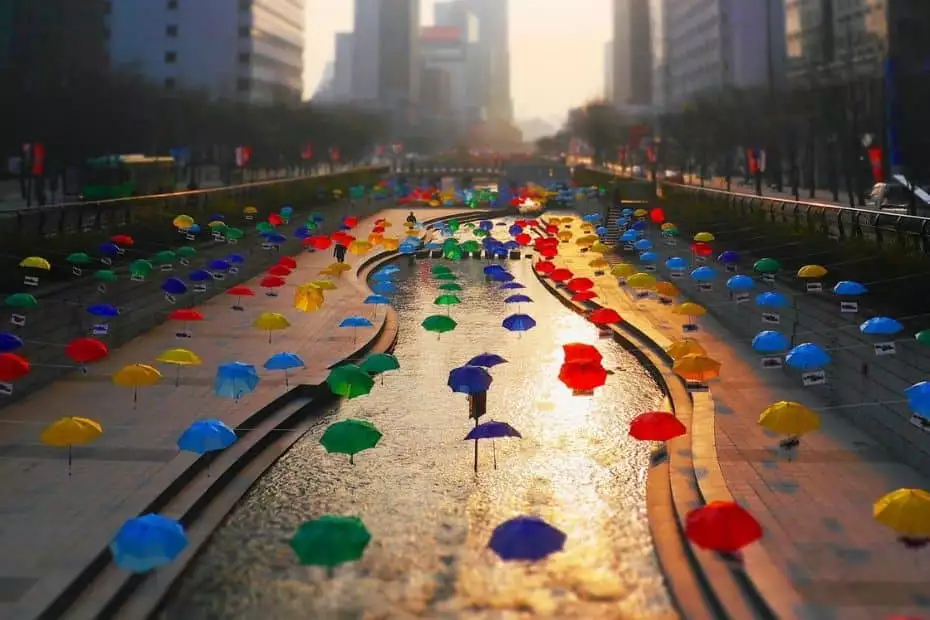
This South Korea travel guide covers all the essential information you need to plan a trip to Korea. This is useful for first-time travellers to Korea who might not be aware of uniquely Korean cultural and travel issues. Even if you’ve visited Korea before, I’m sure you can learn a lot from this travel guide.
This article contains lots of insights and knowledge about travelling to Korea and is quite long. I’ve added links in each section to articles that provide more information about each topic. Therefore, I suggest viewing this South Korea travel guide on a desktop computer as it will be easier to read.
What Are You Looking For?
To help make it easier for you to find what you’re looking for, I’ve broken this article into the following sections. Click the quick links below to jump straight there or keep reading through all parts.

Latest Travel News
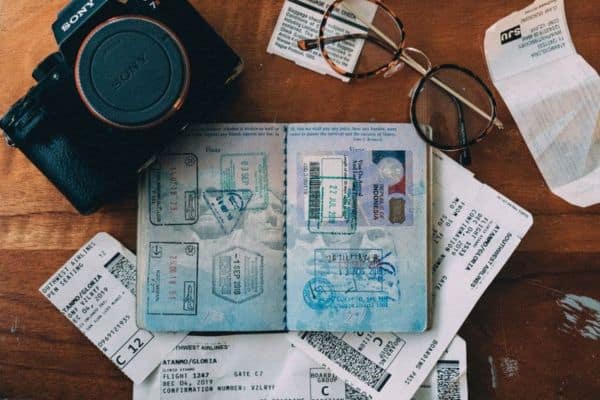
Entry Requirements
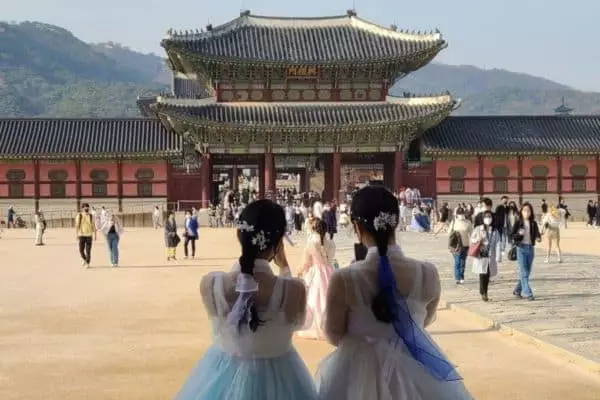
Why Visit Korea
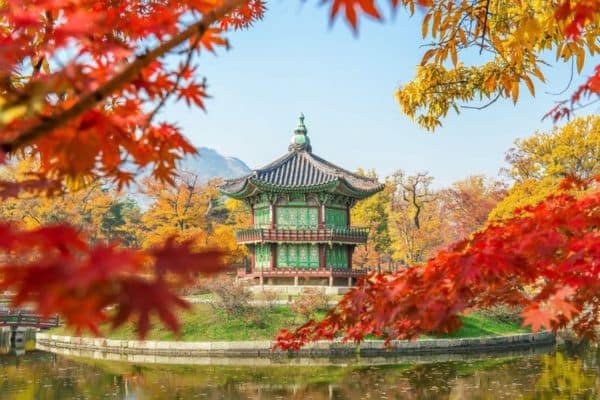
When To Visit
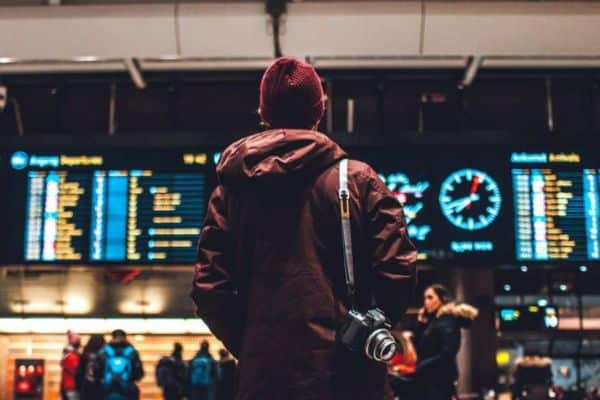
Flights To Korea
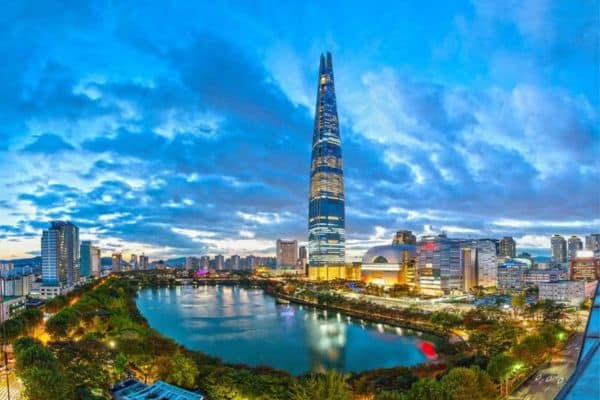
Where To Stay

Korea Travel Costs
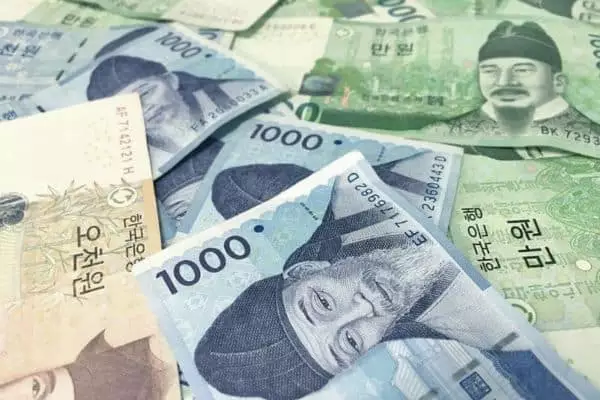
Travel Money
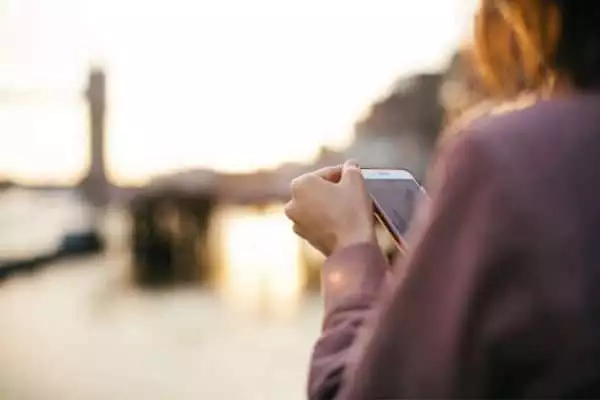
Phones & Internet
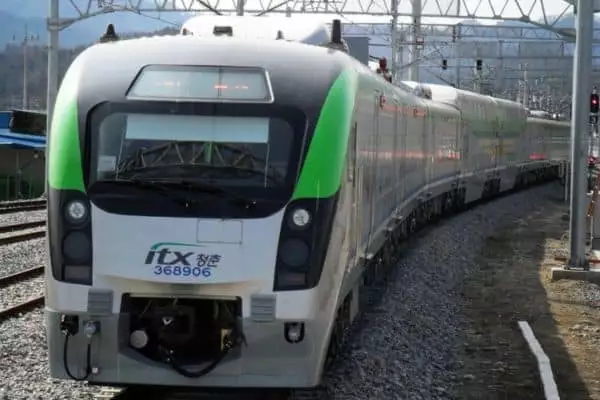
Public Transport
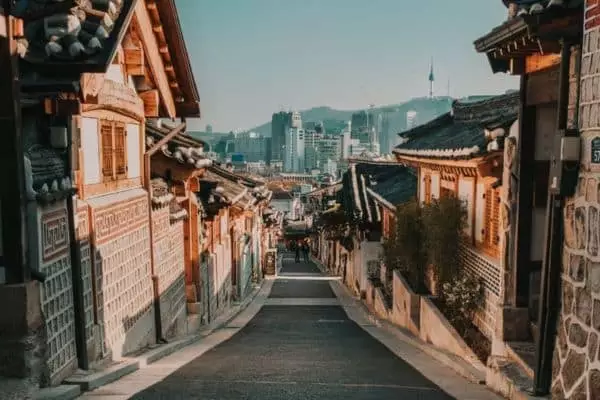
Where To Visit
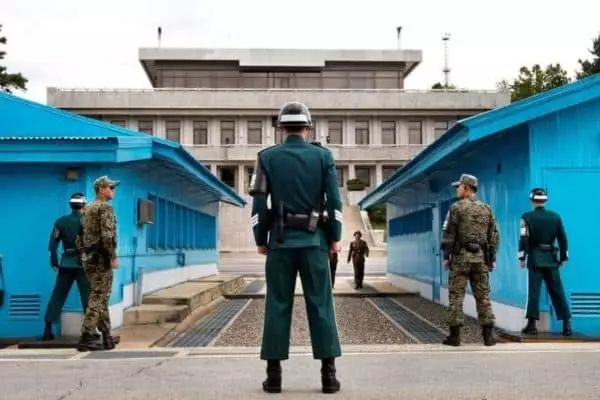
Seoul Day Tours
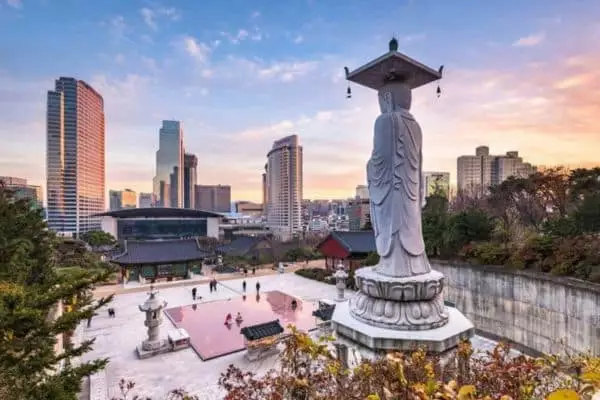
Sightseeing Spots
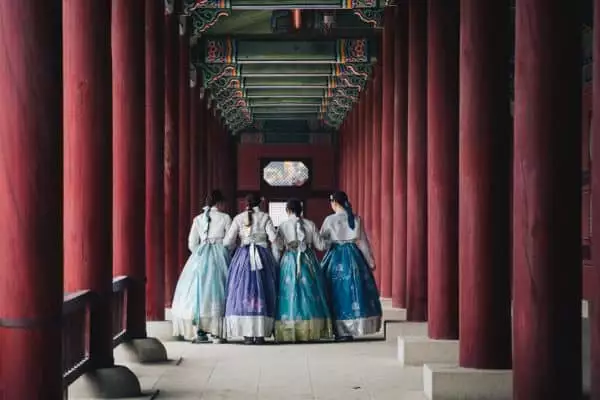
Korean Activities
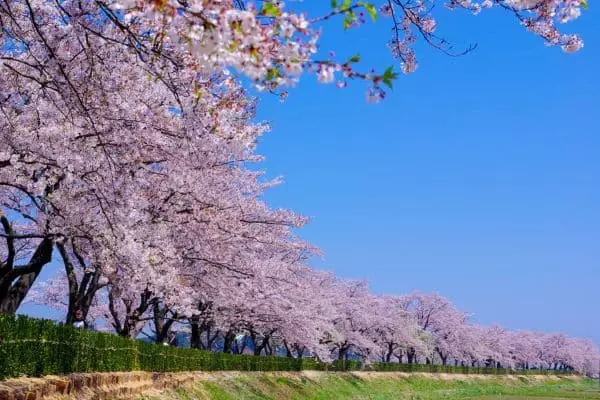
Korean Festivals
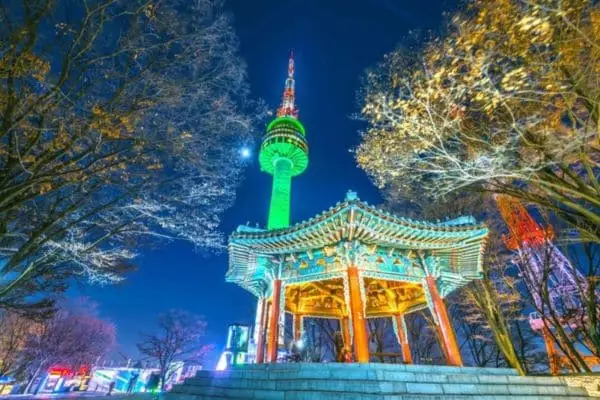
1-Week Itinerary
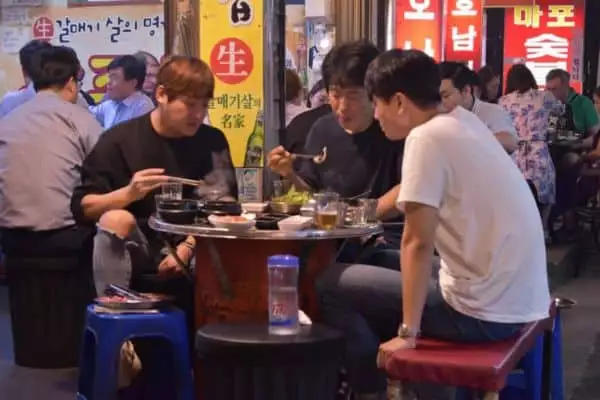
Culture Issues
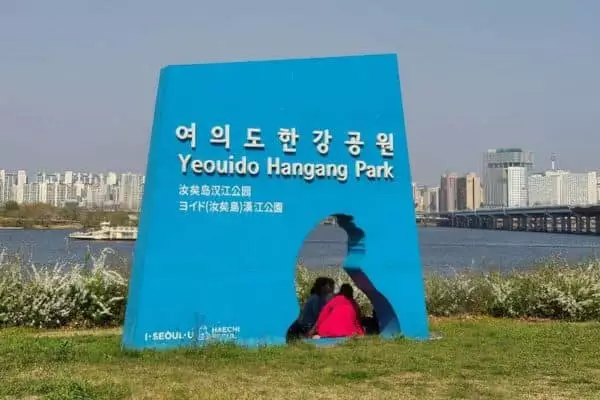
Language Issues
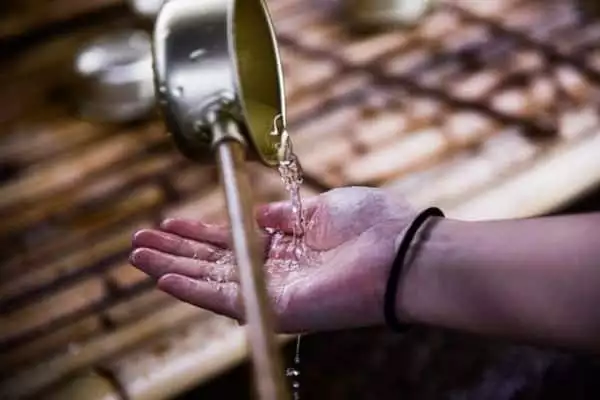
Health & Safety
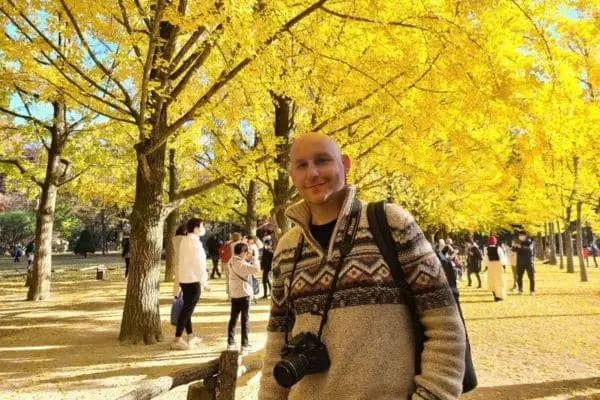
Korean Travel Tips
Korean Travel News And Travel Restrictions 2024

This section of the South Korea travel guide will show you the latest travel news and restriction updates, including any temporary or permanent changes to the entry process, visa changes, and other things that might affect travel to Korea. COVID-related updates will also be posted here.
Latest Korean Travel News In 2024
This section will detail any interesting or important travel news that could affect travellers to Korea, such as price increases in public transport, travel changes, new services, or closures.
The Korean government is aiming to boost tourism to Korea by doubling the amount travellers can claim back in tax when shopping in Korea. From 2024, travellers will be able to claim up to 5,000,000 KRW on eligible purchases with a limit of 1,000,000 KRW tax back per transaction. Source : Korea Herald
From August 2023, the price to travel on buses in Seoul is set to rise. Bus fares will rise to 1,500 KRW per journey. From October 7th, 2023, Seoul’s subway fares will rise to 1,400 KRW per journey. Other cities in Korea will enact similar rises throughout 2023 to cover higher costs of public transportation. Source : Korea Herald
From July 15th, 2023, the requirement to register your health condition through the Q-Code portal will be scrapped. Source : Korea Times
From July 3rd, 2023, children aged 17 years and younger, as well as adults aged 65 and older, will no longer need to apply for a K-ETA to travel to Korea. Furthermore, the validity period has been increased from 2 years to 3 years to make travelling to Korea easier. Source: K-ETA website .
From June 2023, Korea will end almost all pandemic-related restrictions for tourists and locals. Masks will no longer be necessary except in hospitals and infected people no longer face mandatory self-isolation (although the government still recommends 5 days self-isolation). Q-Code requirements haven’t been mentioned, however. Source : Korea Herald .
From April 2023 until December 2024, travellers from 22 countries won’t have to complete a K-ETA when visiting Korea, saving time and money for citizens of those countries. People from other countries still need a K-ETA. Source : K-ETA
The 22 countries temporarily excluded from the K-ETA requirement are Australia, Austria, Belgium, Canada, Denmark, Finland, France, Germany, Hong Kong, Italy, Japan, Macao, Netherlands, New Zealand, Norway, Poland, Singapore, Spain, Sweden, Taiwan, UK, US (including Guam).
From April 2023, all foreigners under 19 years old (18 and under) can now enter major royal palaces and tombs, including Seoul’s Gyeongbokgung Palace, for free. Previously, all foreigners were made to pay a fee to enter. Source : Korea Herald
From March 2023, a quarter of all buses in Seoul will refuse cash payments and allow only card payments using transportation cards, such as the T-Money card. Seoul’s night buses won’t be included for now, and 262 of Seoul’s 370 bus routes will still accept cash. Expect further increases in cash-free buses in the future. Source : Korea Herald
From February 2023, the base fare for a taxi journey in Korea has increased by 1,000 won to a minimum of 4,800 won. The distance that the base fare applies has also been shortened from 2km to 1.6km, which will make fares more expensive. Source : Korea Times
What Are the Current COVID Restrictions In Korea In 2024?
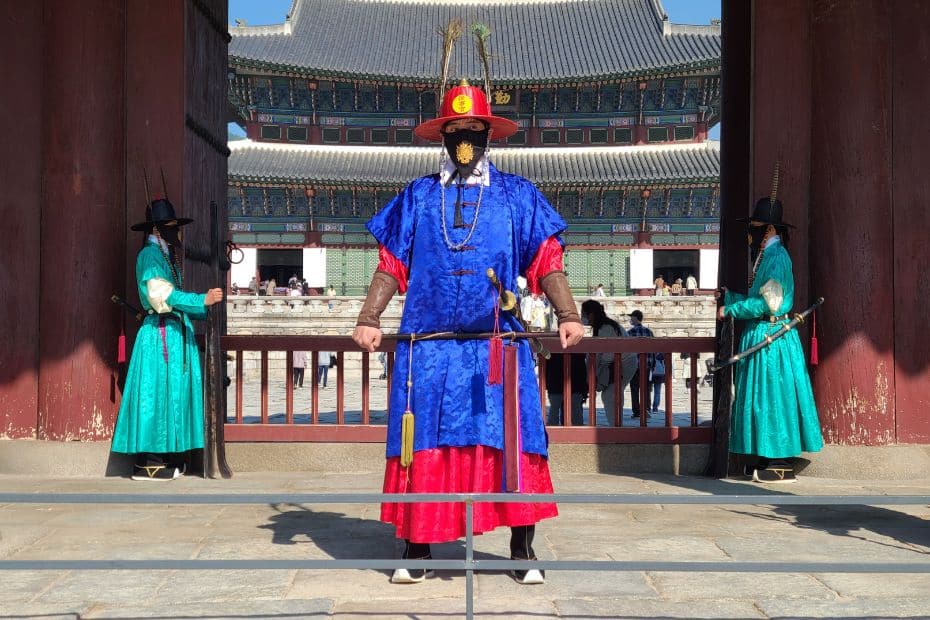
Korea has been removing COVID-related restrictions in the country throughout 2022 and 2023. It is no longer necessary to show a QR code to enter a building and restrictions involving masks and health checks have mostly gone. The latest COVID-related rules for Korea are as follows .
Masks : From Monday, March 20th, Korea has removed the mandatory mask rule for public transport, one of the final places that masks were required for the general public. The only places that require a face mask (from June 1st) are in medical facilities (hospitals). Masks are not mandatory elsewhere, including in schools, shops, restaurants or anywhere outside. Source : Korea Herald
Self-Quarantine : From June 1st, Korea will no longer impose a mandatory self-isolation period on infected people. The government instead ‘recommends’ a period of self-isolation for 5 days to reduce the chance of transmission to other people. Source : Korea Herald
For further details about the latest COVID requirements for entering or travelling in Korea, check out the second section of this South Korea travel guide, which has a list of all the updated entry requirements, including visas, tests, and other considerations.
Planning to visit Korea? These travel essentials will help you plan your trip, get the best deals, and save you time and money before and during your Korean adventure.
Visas & K-ETA: Some travellers to Korea need a Tourist Visa , but most can travel with a Korean Electronic Travel Authorisation (K-ETA). Currently 22 Countries don’t need either one.
How To Stay Connected : Pre-order a Korean Sim Card or a WiFi Router to collect on-arrival at Incheon Airport (desks open 24-hours). Alternatively, download a Korean eSIM for you travels.
Where To Stay : For Seoul, I recommend Myeongdong (convenient), Hongdae (cool culture) or Gangnam (shopping). For Busan, Haeundae (Beach) or Seomyeon (Downtown).
Incheon Airport To Seoul : Take the Airport Express (AREX) to Seoul Station or a Limo Bus across Seoul. Book an Incheon Airport Private Transfer and relax to or from the airport.
Korean Tour Operators : Tour companies that have a big presence in Korea include Klook , Trazy , Viator , and Get Your Guide . These sites offer discounted entry tickets for top attractions.
Seoul City Passes : Visit Seoul’s top attractions for free with a Discover Seoul Pass or Go City Seoul Pass . These passes are great for families and couples visiting Seoul – you can save lots.
How To Get Around : For public transport, grab a T-Money Card . Save money on Korea’s high speed trains with a Korea Rail Pass . To see more of Korea, there are many rental car options from Klook , EconomyBookings , and RentalCars .
Travel Money : Use money exchanges near Myeongdong and Hongdae subway stations for the best exchange rates. Order a Wise Card or WOWPASS to pay by card across Korea.
Flights To Korea : I use flight comparison sites such as Expedia and Skyscanner to find the best flights to Korea from any country. Air Asia is a good option for budget flights from Asia.
Travel Insurance : It is important to insure your trips to protect yourself against the unexpected. World Nomad is a specialized travel insurance provider with options for different coverage for travellers from around the world. You can also purchase cover when you are already travelling.
How To Learn Korean : The language course from 90 Day Korean or Korean Class 101 both have well-structured lessons and lots of useful resources to help you learn Korean.
Current Requirements To Travel To Korea In 2024
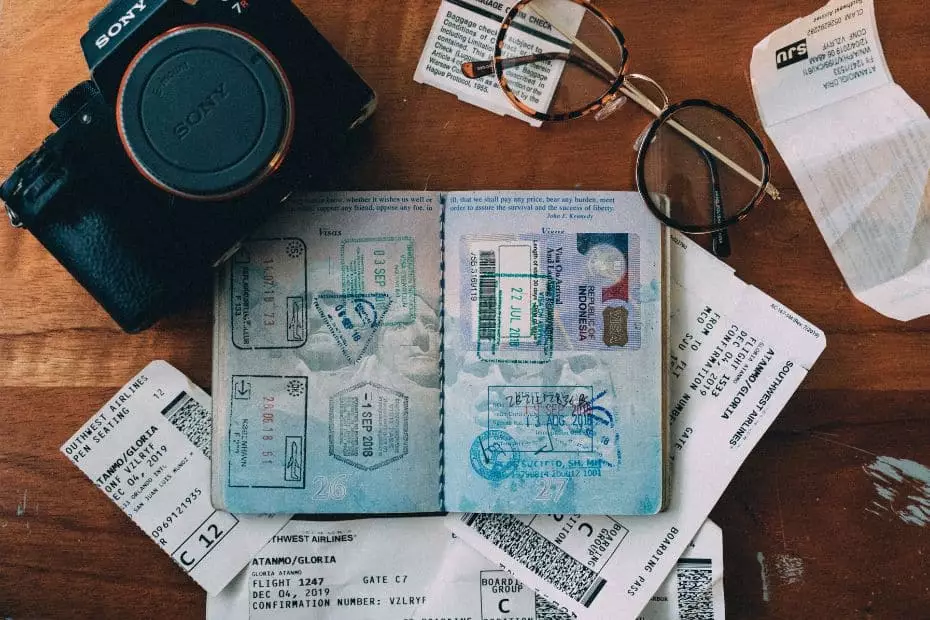
This part of the South Korea travel guide is for tourists . If you plan to travel for business, employment, or other reasons, check your nearest Korean embassy for the latest travel requirements.
Most of the restrictions and requirements for travelling to Korea have now been scrapped. You can see what entry and travel rules are in place for Korea in the table below:
The following section provides more information and exceptions about these requirements:
COVID-positive travellers should avoid travelling to Korea : To avoid infecting others on the way to Korea, as well as in Korea, the Korean government recommends that you shouldn’t travel to Korea if you exhibit COVID-symptoms or have tested positive. Self-quarantine is mandatory in Korea.
There are no PCR or other testing requirements : It is not necessary to take a PCR or other test before travelling to Korea. However, you will be asked to take a test if you show symptoms of COVID or similar illnesses when travelling to or arriving in Korea.
There is no quarantine on arrival : Travellers to Korea no longer need to quarantine when entering Korea. From June 1st, there is only a ‘recommended’ 5 day self-isolation period for infected travellers, but this is not enforced.
Complete the self-health check before or on arrival : From July 15th, 2023, travellers to Korea no longer need to complete a Q-Code self-health check or declare their health status on arrival.
Apply for a K-ETA or tourist visa before travelling : You need to apply for either a K-ETA or tourist visa for South Korea before flying to the country. Entry will be prohibited without the correct one. From April 1st, 2023 until December 31st, 2024, 22 countries are excluded from the K-ETA.
If you’re not sure which of these you need to apply for, more information is provided in the next section of this South Korea travel guide about the K-ETA and tourist visa for Korea.
K-ETA (Korean Electronic Travel Authorisation)
The K-ETA (Korean Electronic Travel Authorisation) is an online travel authorisation that visa-free foreign visitors aged 18 to 65 must obtain before entering the Korea for tourism, visiting relatives, participating in events or meetings, and for business purposes other than profitable activities.
Tourists from 112 eligible countries need to apply for a K-ETA before travelling to Korea and won’t be allowed to board a flight to Korea without it. The approval process isn’t difficult, but requires accommodation details, travel dates, and personal details such as passport number, etc.
From April 1st, 2023 until December 31st, 2024, the Korean government has decided to suspend the K-ETA requirement for travellers from the following 22 countries:
Australia, Austria, Belgium, Canada, Denmark, Finland, France, Germany, Hong Kong, Italy, Japan, Macao, Netherlands, New Zealand, Norway, Poland, Singapore, Spain, Sweden, Taiwan, UK, US (including Guam).
The aim is to reduce the burden of travellers coming to Korea and to encourage more people to visit Korea during the ‘Visit Korea Year’, which runs during 2023 and 2024.
Source : K-ETA website news .
From July 3rd, 2023, the Korean government will no longer ask for travellers who are 17 years and younger, or 65 years and older, to apply for a K-ETA when visiting Korea. These are ages based on the time you travel to Korea, not the age when you apply to travel.
Furthermore, the validity period of the K-ETA is now 3 years, not 2 years. The Korean government has decided to extend the validity period to make it easier for people to travel to Korea.
The K-ETA is based on your nationality , not the country you’re travelling from. That means, if you require a tourist visa from your home country (e.g. the Philippines), but are travelling from a country that requires a K-ETA (e.g. the USA), you can’t use the K-ETA to travel to Korea.
Tourists should apply as far in advance as possible at the official K-ETA website. If you would like to know more about the K-ETA, check out my article explaining what is the K-ETA . The K-ETA costs 10,000 KRW (about $9.00 USD). If you are charged more than this, you’re on the wrong site.
Official K-ETA website
Not sure if you need a K-ETA? Check out this infographic to find out.
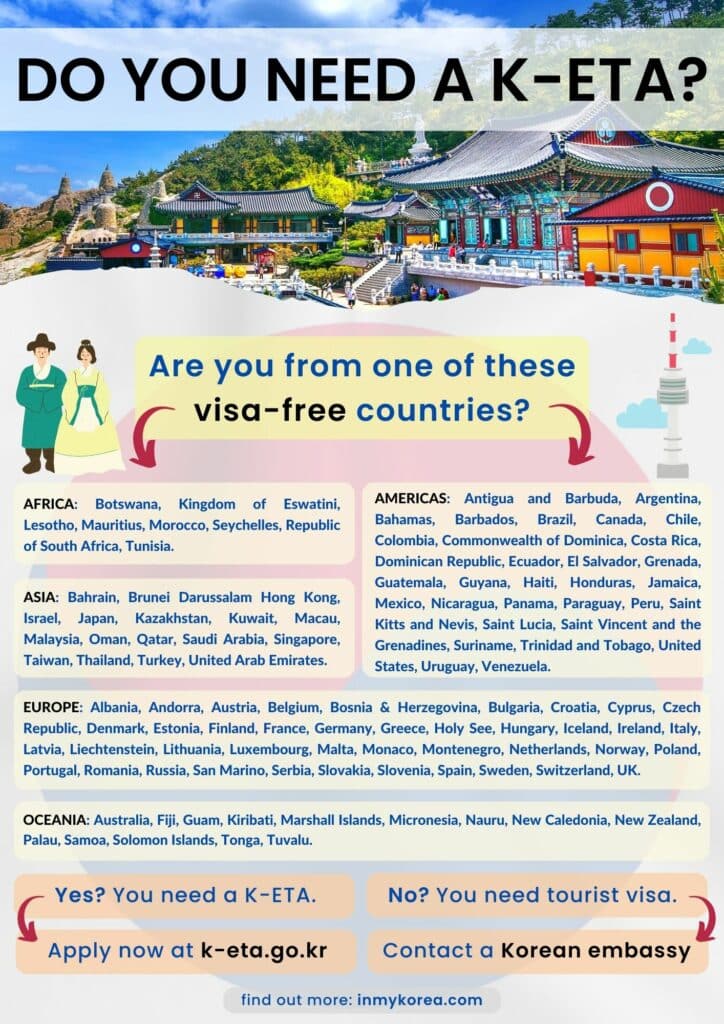
Will The K-ETA End In The Future?
The K-ETA will continue for the indefinite future. It is not a pandemic-related travel restriction but a permanent feature that just happened to start in 2021. The Korean government have stated that the K-ETA will be ongoing and other countries and areas, such as the EU, are planning similar ETAs.
Update : In July 2023, the Korean government stopped requiring children 17 years and younger and adults 65 years and older to apply for a K-ETA. The validity period was also increased to 3 years.
Update : In April 2023, the Korean government suspended the K-ETA for travellers from 22 countries (listed previously). This is in an effort to reduce the burden on travellers visiting Korea during the ‘Visit Korea Years’ of 2023 and 2024. This lasts until December 2024, but could possibly go on longer.
Tourist Visas For South Korea
Tourists that aren’t from one of the 112 countries that require a K-ETA to travel to Korea will need to apply for a tourist visa. This includes nationals from countries such India, Indonesia, Pakistan, and the Philippines. Tourist visas are based on nationality (passport), not country of residence.
The process to apply for a tourist visa differs depending on the country and may be as simple as submitting an application at the Korean embassy in the country you live in. For other countries, it may be necessary to submit extra information like bank statements and a full itinerary.
If you need a tourist visa for South Korea, contact your nearest Korean embassy as soon as you can to start the process. Tourist visas may be rejected, delayed, or take longer than expected. For some countries, such as the Philippines, it is necessary to apply through a specialist visa agency.
Transit Tour Visas For South Korea
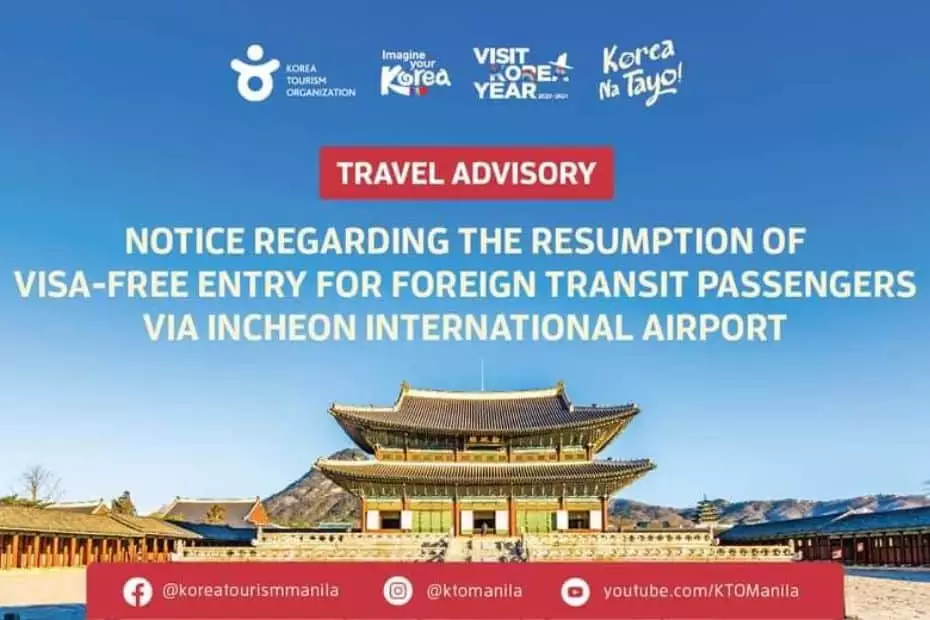
Visa-free entry for foreign transit passengers at Incheon Airport will resume from May 2023 after being suspended for 3 years during the pandemic. There are two types of visa-free transit entry methods for travellers to Korea, they differ in length, requirements, and eligibility.
The first type of visa-free entry for transit passengers is open to all travellers to Korea and allows entry for 3 days, as long as they take a transit tour from Incheon Airport. The second type of visa-free entry for transit passengers is available for 30 days, but only from travellers from 36 select countries.
Visa-Free Entry For Transit Passengers (3 Days)
From May 15, 2023, travellers from any country can travel from Incheon Airport to the Seoul Metropolitan area for up to 3 days, as long as they book at least 1 transit tour from Incheon Airport. If Korea is not their final destination, they’re free to explore more of Seoul after the tour.
There are a wide range of transit tours available from Incheon Airport, including cultural, historic, food, shopping, and entertainment tours. See the sights of Seoul’s most popular places in a few hours, or stay for longer and see more. You can find out more about transit tours from the Visit Korea website .
Requirements : To be eligible for a transit tour visa, travellers must:
- Have an onward flight to their home country or a 3rd country after Korea.
- Participate in a transit tour program by a designated travel agency.
- Stay within the Seoul Metropolitan area only.
- Have more than 2 hours between connecting flights.
Eligible countries : Visa-free entry with a transit tour is open to passengers of all countries, as long as they meet the above requirements.
Tip : If you have a transit tour in Korea, I recommend staying in Hongdae , as there is a direct train from Incheon Airport to Hongdae called the All-Stop Airport Line. Hongdae is also a really fun place where you can see lots of culture, try Korean dishes, and pack your suitcase with Korean souvenirs.
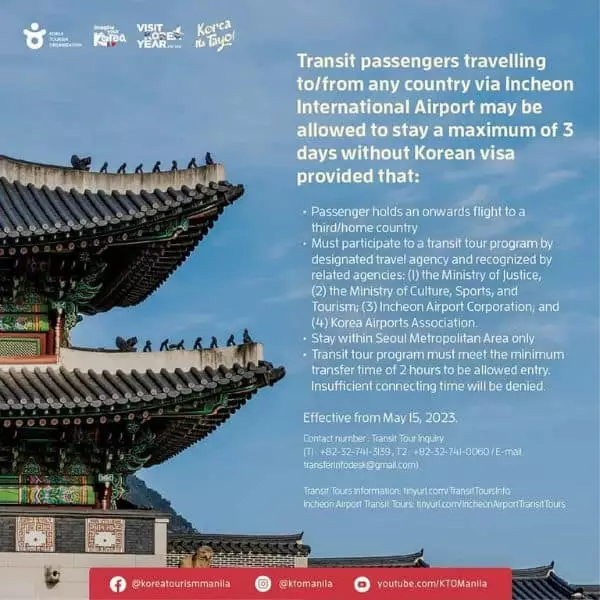
Visa-Free Entry For Transit Passengers (30 Days)
This will allow travellers from 36 countries to enter and stay in Korea for up to 30 days without a Korean visa. Travellers must be travelling to or from one of these 36 countries to be eligible to stay in Korea without a visa. This includes passengers who are not citizens of those countries.
Requirements : To be eligible for a visa-free entry as a transit passenger, travellers must:
- Hold an onward flight to any of the 36 countries mentioned below.
- Have no illegal stay records of any kind, nor have been denied entry to Korea.
- Not have exceeded a maximum of 3 days stay in any other transit airport.
Eligible countries : Travellers from the USA, Canada, Australia, New Zealand, and 32 EU countries (see picture below) can stay for up to 30 days, as long as the above-mentioned requirements are met.
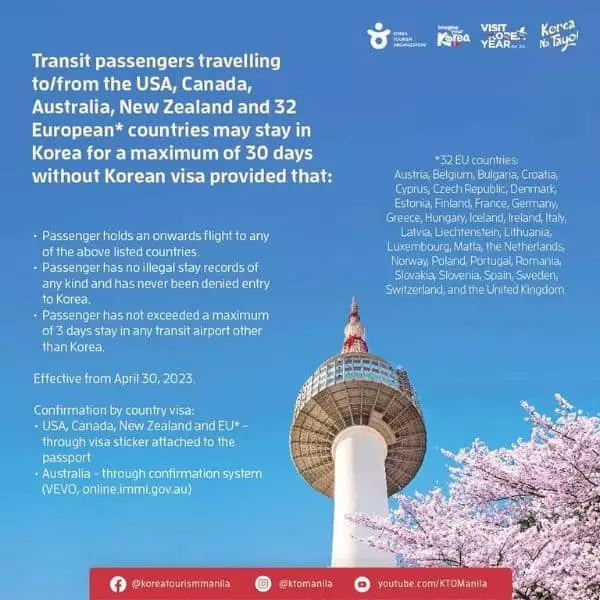
Why You Should Travel To Korea In 2024
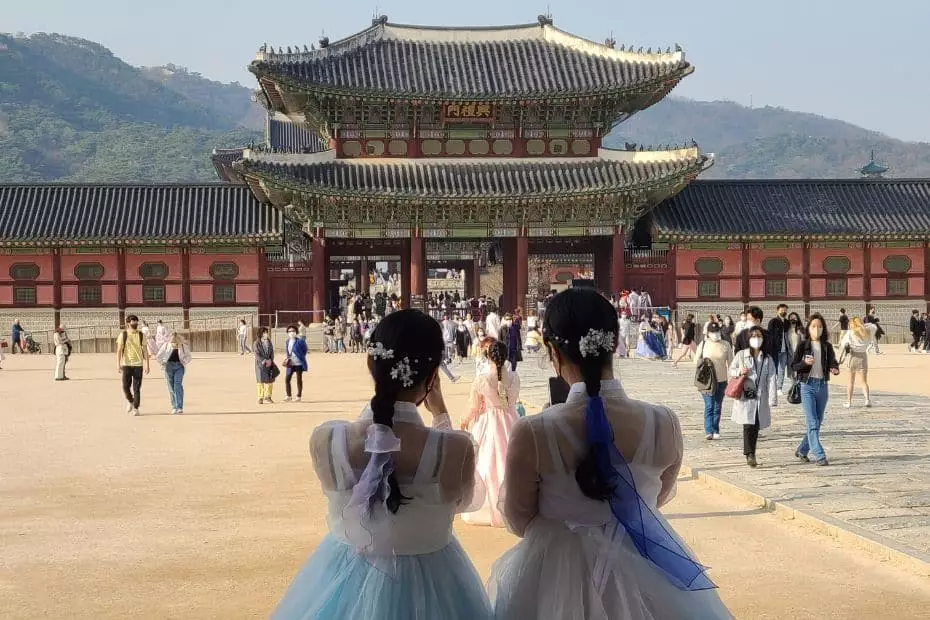
There’s not enough space in this South Korea travel guide to write down all of the reasons why you should travel to South Korea. Korea is an under-appreciated gem that has so much to discover and experience that’s completely different from what you’ll find in other countries.
Much the way that Japan has a very distinct culture and history, Korea has lots of unique, appealing places to see, people to meet, history to learn about, and natural sights to appreciate. Many people only see a small slice of Korean culture and beauty through modern media, but there’s a lot more.
Here are some of the reasons you should travel to Korea:
- Delicious foods and tasty seasonal dishes.
- Four distinct seasons that offer a variety of views.
- Fascinating history to learn about and explore.
- Stunning mountains and beaches for outdoor lovers.
- Unique and unusual festivals throughout the year.
- Friendly locals and a safe country to travel around.
- Modern, high-tech cities that are clean and efficient.
- Welcoming Buddhist temples and temple stays.
- Cheaper than most other developed countries.
- A shopper’s paradise with many markets and malls .
- Korea really wants you to come and visit.
Korea wants you to visit so much that they declared 2023-2024 the Visit Korea Year . This two-year period, confusingly referred to as a single year, is set to feature loads of events and activities to draw tourists to Korea, and includes promotions for discounted flights, accommodation, and food.
Some of the events you can expect to see during the Visit Korea Year(s) include K-Pop concerts, e-sports competitions, food festivals, and cultural celebrations. There’ll be K-Cultural stars involved, too, including your favourite K-Pop and K-Drama stars. Get ready to travel to Korea soon!
Want to know what you can do in Korea that you can’t do in other countries? Check out these amazing unique Korean experiences that should definitely be on your Korean bucket list.
The Best Time To Visit Korea
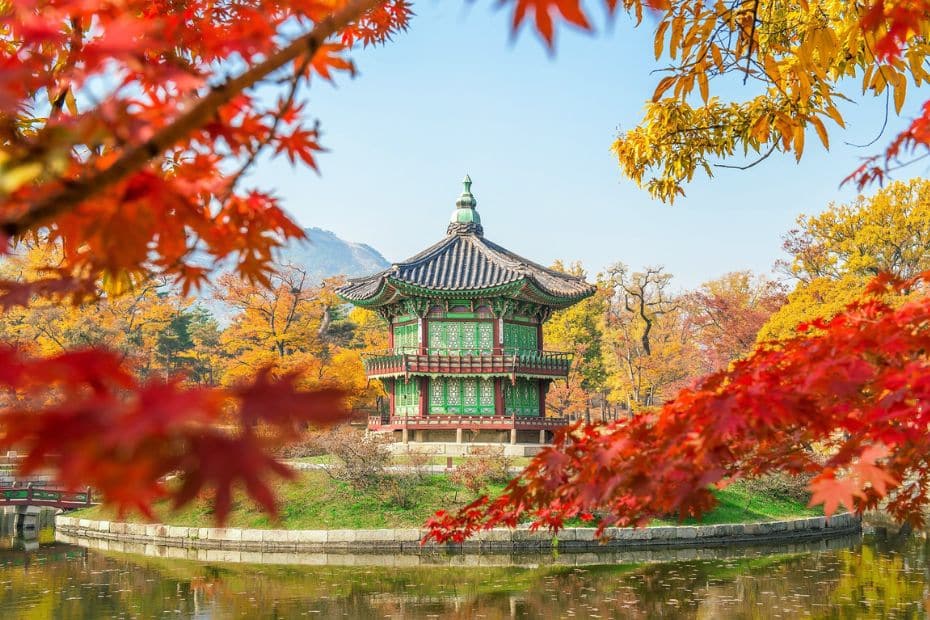
The best time to visit Korea is in spring (late-March to May) or autumn (mid-September until mid-November). These seasons have the most comfortable weather, ranging from 10 to 30 degrees Celsius, an average amount of rain, and also have the most festivals and events.
My favourite months to travel in Korea are April and October . Early-April is when cherry blossoms come out and the weather warms up enough to stop wearing a jacket. October in Korea is a beautiful month when autumn foliage sweeps across the country and the weather is warm and calm.
When you travel to Korea, the season you travel in can have a big impact on what you can see, eat, and do. This section of the South Korea travel guide is one of the most important and if you want to travel to Korea in the future, I recommend learning about Korea’s seasons before making plans.
What Can You See In Korea Each Season?
Although spring and autumn are undoubtedly the best time to visit Korea, there are plenty of reasons to visit in other seasons, too. Visitors to Korea who are restricted to travelling during certain times, such as during school or work holidays, needn’t be put off by travelling in summer or winter.
Here’s a summary of what you can see and do in each season in Korea:
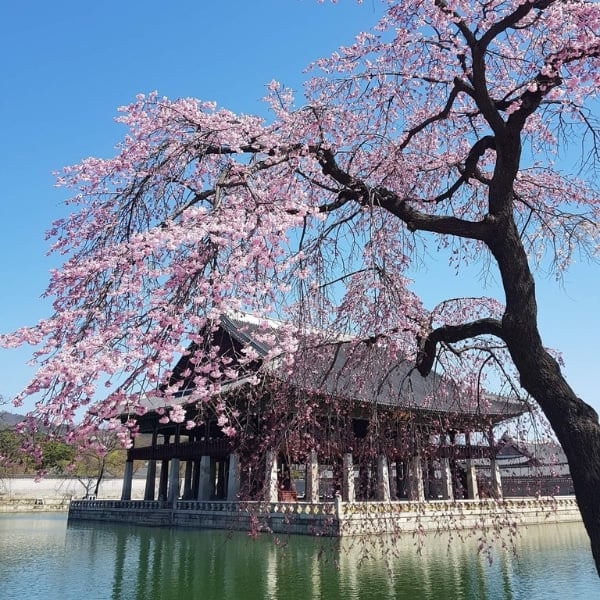
Spring: Cherry Blossoms, Blooming Nature, Culture Festivals
Spring is an amazing season to travel in Korea as you can see colourful plum blossoms (Mar), cherry blossoms (Mar-Apr), and many other bright sights. The warm weather allows people go out more to enjoy cultural activities and spring festivals , such as the Lotus Lantern Festival and Jindo Sea-Parting Festival, and also trekking, hiking, and cycling. Spring is one of the most popular times to travel in Korea for locals, so expect places to be busy, especially around cherry blossom season.
Check out my cherry blossom guide for the best places to see cherry blossoms in Korea.
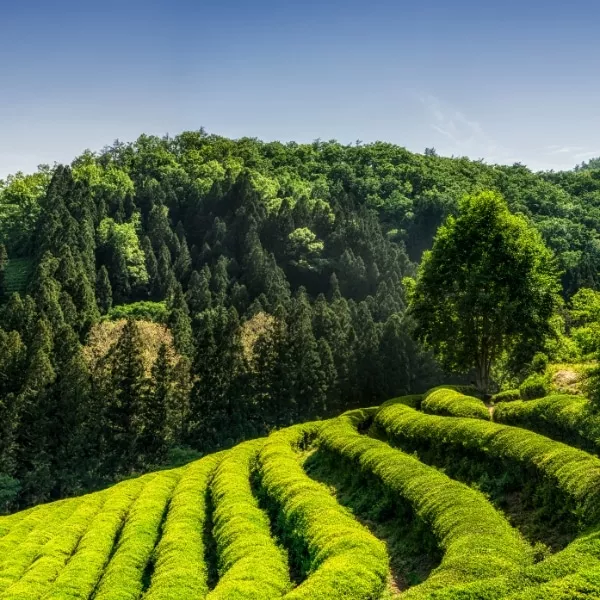
Summer: Beaches, Korean Desserts, Water Sports, Camping
Summer is a difficult season for travellers due to the high humidity and heat. June and July are rainy season in Korea and it may rain for days on end, causing people to change travel plans to indoor activities. In late July and August it gets very hot, which is good for going to the beach and enjoying water sports or water parks, which Korea has many of. Evening activities like hiking, drinking in rooftop bars, and visiting night markets are great ways to get out in summer when it’s not as hot.
Check out my guide to Korean summer activities for the best places to have fun during summer and rainy day activities in Busan in case the weather isn’t so good.
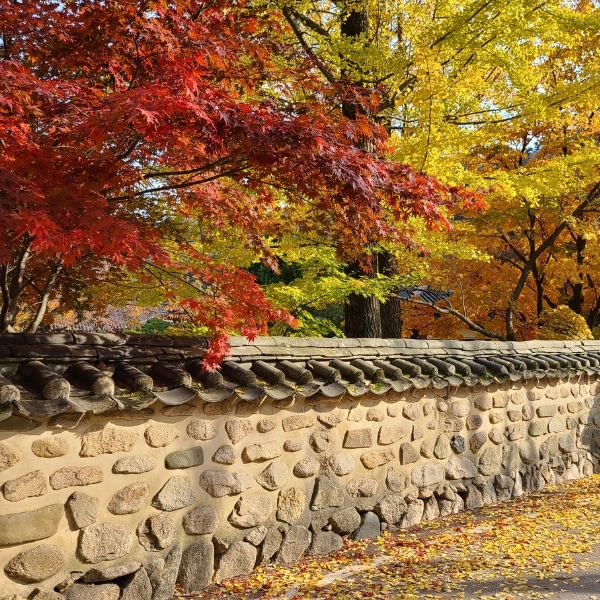
Autumn: Foliage, Festivals, Fresh Foods, Harvest Festivals
Autumn is another incredibly popular time to travel in Korea, especially in October when the autumn foliage is at its best. The foliage really brings everything to life, adding shades of colour to plain palace walls, mountains, and parks. The calm weather is warm with clear skies, making it perfect for going into nature to see the fresh fruits and other harvest goods, as well as join in harvest and cultural festivals. Enjoy local Korean dishes, fresh from the farm to your table.
Check out my guide to autumn foliage in Korea for the best places to see the leaves.
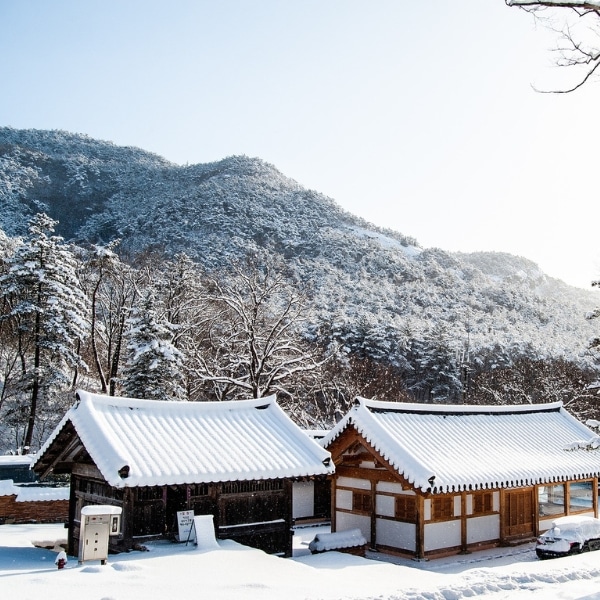
Winter: Snow, Winter Sports, Ice Fishing, Light Festivals
Winter in Korea is often neglected due to the cold weather, but is actually a very nice time to travel with delicious winter foods to try. It’s the driest time of year with blue skies making everything bright and beautiful. When it snows, sights look even more incredible. Jeju Island is a great place to visit during winter as it has fresh citrus and colourful camellia flowers to see. You can enjoy winter sports, festivals and activities, such as ice fishing, ice skating, sledding, and more.
Check out my guide to Korean winter activities for the best places to have fun during winter.
What Is The Weather Like In Korea?
The weather in Korea follows a similar pattern each year, spread over five distinct seasons. As well as spring, summer, autumn, and winter, Korea also has a rainy season, which starts around mid-June and finishes mid-July. It doesn’t constantly rain during rainy season, but may do for several days.
There’s always something to do in Korea, no matter what the season. Even rainy season in Korea is fine for travelling, as long as you plan lots of indoor activities and can be flexible with your schedule. Don’t let the weather in Korea put you off visiting, you’ll find plenty to do in each season.
Here’s a summary of the weather in Korea each season:
The graph below shows you the average temperature each month in Seoul. This is an average temperature, so some days will be much hotter and others much colder. I’ve experienced summer temperatures of over 35 degrees and winter nights of -20, so be prepared for both.
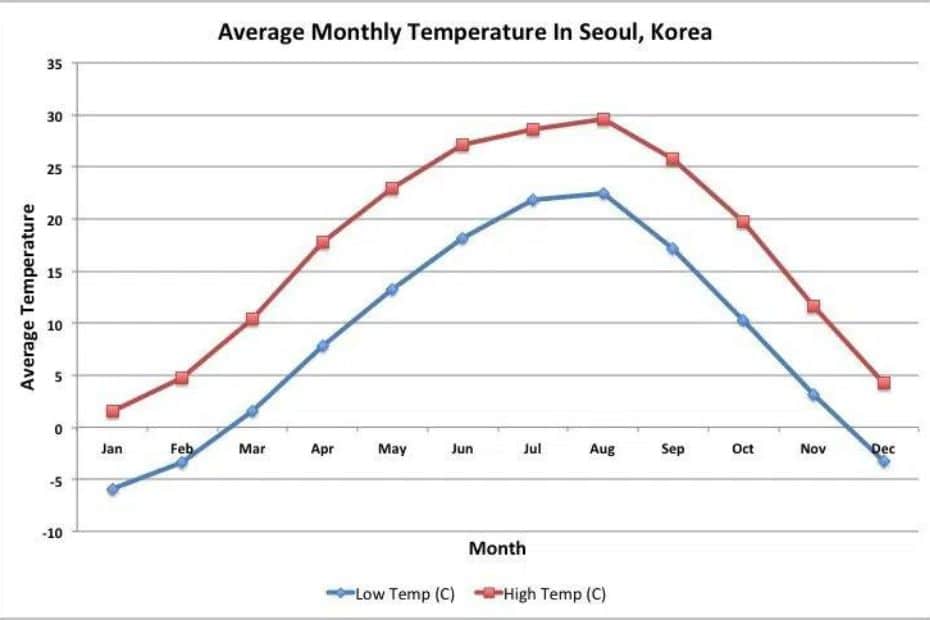
The table below shows the average rainfall for each month in Korea, based on records from climate-data.org . The summer months have the most, while winter in Korea is very dry. The rainfall in the winter months can turn to snow when it’s cold enough, too.
There will be more information about the sights, festivals, and events you can enjoy in Korea in later parts of this South Korea travel guide. Check them out for travel ideas for your trip to Korea.
How To Book Flights To Korea
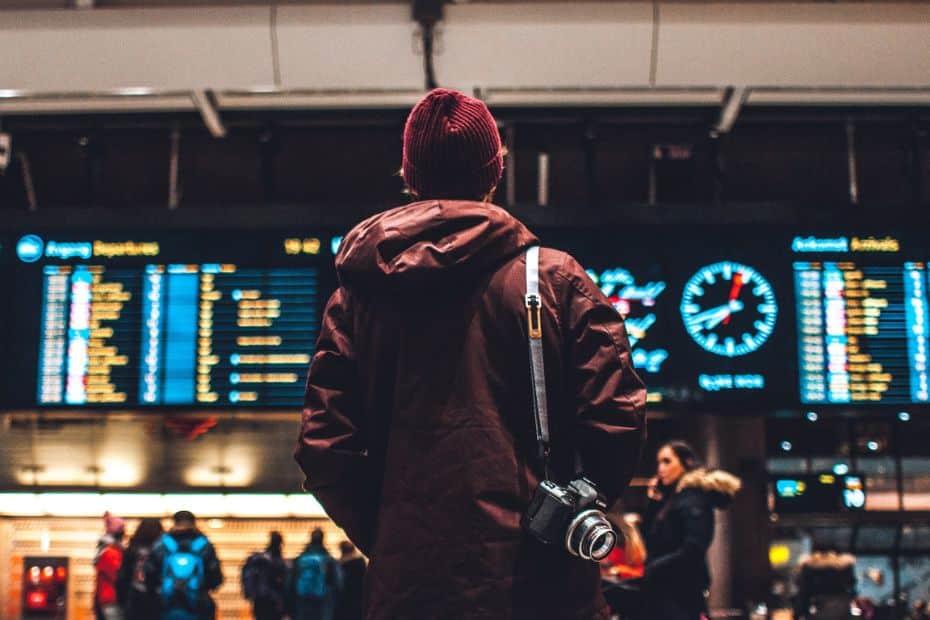
Flying to Korea in 2024 is getting easier with more airlines offering direct or connecting flights to Korea and budget airlines adding more routes to Korea from other parts of Asia and as far away as the USA. There aren’t as many routes as there were in 2019, but they are returning month by month.
Booking a flight to Korea is one of the first things most people do and finding the right flight can really affect your travels. Choosing the right flight not only affects how much money you need to spend, but also when you’ll arrive, how you’ll get to your hotel, and where you’ll arrive in Korea.
Check out my guide to booking flights to Korea to discover the best ways to book a flight to Korea, including the best time to book (21 to 127 days before travel), where to get cheap flights, the various airlines that offer flights to Korea, and lots more.
Arriving At Incheon Airport
Most flights to Korea arrive at Incheon Airport, which is near Seoul. It takes about an hour to get to the centre of Seoul from Incheon Airport and there are various transportation options including a high-speed train, subway, limo buses, taxis, and private transfers.
The best option for transferring from Incheon Airport to your hotel is usually a limo bus as these run to popular areas of Seoul, such as Myeongdong, Hongdae, Gangnam, and Insadong. There’s also a direct train to Seoul Station and a subway that goes to Seoul Station via Hongdae.
Arriving during the daytime gives you the best options for getting from Incheon Airport into Seoul, while nighttime flights will leave you fewer options. There are a few night buses that run, but late arrivals will either need to stay at the airport or book a private transfer or taxi instead. More details about taking a taxi from Incheon Airport can be found in my guide to taxis in Korea .
If you want to book a private transfer direct to your hotel from Incheon Airport, contact Jerry Heng , a freelance driver. I want to recommend Jerry as he has years of experience organising airport pick-ups and drop-offs, as well as personalised tours around Korea. He’s also a friendly guy.
Recommended Flight Comparison Sites
I suggest checking at least one flight comparison website before booking any flights. You can alter the arrival and departure times, flight duration, choose direct or indirect flights, and sort by price to find the perfect flight for you. Skyscanner is my preferred comparison site, but they’re all useful.
Take time to change the dates and flight times to find the most suitable flights for you. Cheaper flights often have inconvenient arrival times, so you should decide whether it’s worth the hassle to save a bit of money. Sometimes spending more for the right flight is worth it, especially when time is limited.
I try to go for a balance of convenience and savings and avoid flights that arrive late at night or leave too early in the morning. These flights require you to book an extra night at the airport or make you lose time when you could be travelling and doing more interesting things.
Here are 4 of the best flight comparison sites for booking flights to Korea:

Skyscanner is one of the most popular flight aggregators and offers flights, hotels, and other travel bookings for all major destinations. Skyscanner shows airline environmental ratings and which flights are practical or difficult.

Expedia is a large US travel company that offers tours, flights, hotels, and other services around the world. You can book hotel and flights together, to save you time and effort when travelling. A good place to start your flight search.
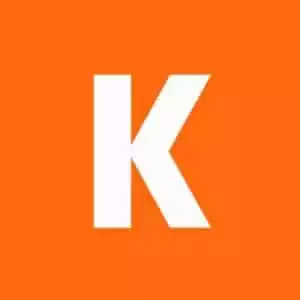
Kayak is great for people looking for cheap flights to Korea. You can see price trends for your flight to Korea to see when the best prices are available. There are also lots of budget travel options on the site that can save you more.

WayAway is a flight comparison site for the modern generation, with Instagram tips & travel advice as well as a good selection of cheap flights. You can get cashback on bookings with their premium service.
Where To Stay In Seoul

Incheon Airport is the main arrival destination for most travellers visiting Korea, with more than 71 million travellers passing through the airport in 2019, making it the world’s 14th busiest airport . It’s close to Seoul and has lots of transportation options to get into Korea’s capital.
Seoul is the first place people visit, not only because it’s close to Incheon Airport, but because it’s undeniably the heart and soul of Korea. The greater Seoul area includes about 50% of Korea’s population (25 million people) and is by far the biggest, most vibrant, and fun city in Korea.
To travel to Korea you need either a K-ETA or tourist visa . One of the requirements to apply for these is the address of the first place you’ll be staying in Korea. Therefore, you should book at least your first hotel in Korea so you can begin those applications. Seoul is an ideal first place to stay.
Best Neighbourhoods To Stay In Seoul
Deciding where to stay in Seoul can be difficult because there are so many unique neighbourhoods, each offering something interesting for travellers to experience. Knowing which has the best sights, entertainment, culture, shopping, transport, markets, restaurants, cafes, etc., is useful.
Seoul’s neighbourhoods typically contain a mixture of several of these elements and will appeal to different types of travellers. Below is a very rough guide for which neighbourhood each type of traveller might enjoy. Of course, there are plenty of other things to do in each area.
As you can see from the list above, both Hongdae and Myeongdong have a lot to offer and I would definitely recommend either of these neighbourhoods for first time travellers to Seoul. Even people who have travelled to Korea before will find lots of reasons to stay there. They’re where I usually stay.
I have detailed guides to hotels in the two best districts for staying in Seoul – Hongdae and Myeongdong. My guide to hotels in Hongdae includes a range of hotels for all types of travellers, while my guide to hotels in Myeongdong highlights Myeongdong’s best budget to mid-range hotels.
Each neighbourhood feels unique and offers something to discover, from traditional markets and eateries, modern Insta-worthy cafe districts, peaceful parks and lakes, world-class skyscrapers, and many fun activities. Wherever you choose to stay, you’re sure to find something you enjoy.
I’ve included the 8 best neighbourhoods in Seoul in this South Korea travel guide, along with a small summary about what you can expect in each area. These are the most popular areas for tourists to stay in, but certainly not the only places to stay. There are also links to hotels in these areas.
Here are the 8 best neighbourhoods in Seoul:

Myeongdong is arguably one of the best places to stay in Seoul for any traveller. It has the best range of budget and mid-range hotels in Seoul and is conveniently located for sights, activities, and public transport. It’s close to popular tourist sites, such as the N Seoul Tower and royal palaces. There are traditional markets and Myeongdong’s famous street food alley to check out. As Myeongdong is popular with tourists, you’ll find more people that can speak English and places to exchange money.

Hongdae is one of the coolest neighbourhoods in Seoul and a must-see for any traveller to the city. This area has emerged as a creative hotbed for the latest Korean fashion, art, food, and culture, thanks to innovations from students of nearby universities. Youth culture is on display in Hongdae’s main and side streets, with boutique shops, trendy bars and cafes, inventive restaurants, street art, and live performances. If you want to see a vibrant, colourful side of Seoul, then Hongdae is the place for you.
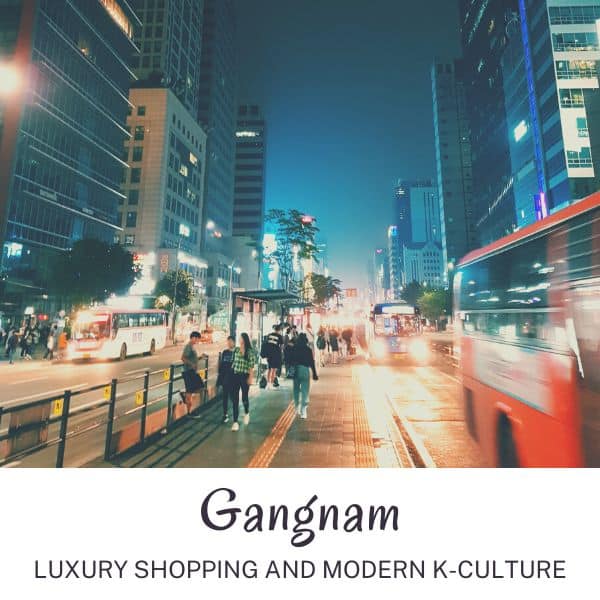
Gangnam is an upscale area of Seoul that’s home to some of Korea’s biggest stars. This area was where K-Pop was invented, as can be seen by the golden Gangnam Style statue outside COEX Mall. Gangnam is a lot more than that, and is a powerful business area with Seoul’s best shopping and dining experiences, as well as some of the city’s finest cafes and bars. Gangnam has a host of upmarket hotels that provide outstanding luxury, but also has a selection of budget and mid-range hotels making it accessible for all travellers.
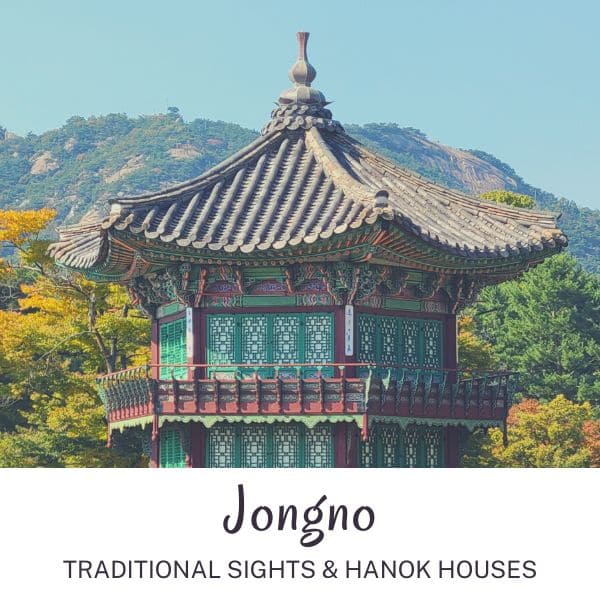
Jongno is the area north of Myeongdong that includes Insadong, Bukchon Hanok Village, Ikseongdong Hanok Village, Jogyesa Temple, 4 of Seoul’s royal palaces, the presidential Blue House, and lots more. This area is packed full of interesting sights and traditional restaurants and tea houses to explore. You can find a good range of hotels in Insadong, Seoul’s artistic area that is home to artists and tourist-friendly attractions. There are also guesthouses and apartments to rent in the residential areas of Jongno that offer a more homely stay.
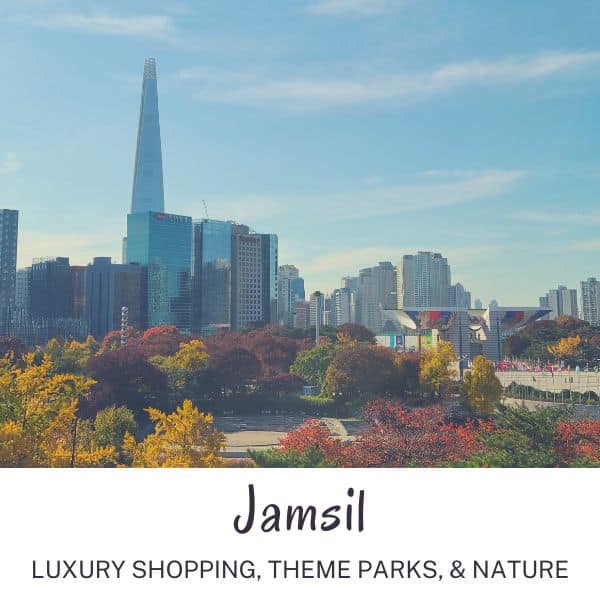
Jamsil is an upmarket residential neigbourhood close to Gangnam that’s home to one of Korea’s largest companies, Lotte. You’ll find the Lotte World Tower, Lotte World Theme Park, and Lotte Aquarium in this area, as well as the beautiful Seokchon Lake and leafy Olympic Park. Jamsil is a great base for people visiting for cherry blossoms in spring as the Seokchon Lake Cherry Blossom Festival is one of Seoul’s best. There are lots of trendy cafes and bars near the lake and it’s a relaxed part of the city to stay in.
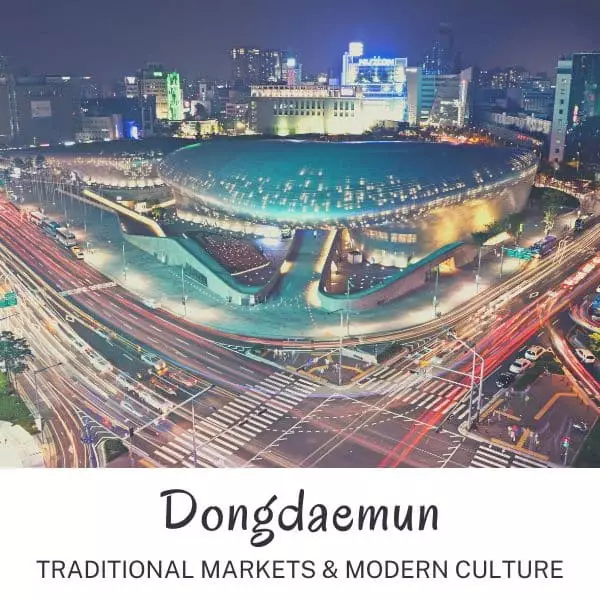
Dongdaemun is known for both its traditional markets, where you can buy a range of goods, as well as the futuristic Dongdaemun Design Plaza (DDP). The area is an unusual mix of traditional Seoul, with Gwangjang Market offering some of Seoul’s best Korean street food, and modern culture, displayed by the night markets and art installations at the DDP. There are lots of cheap eats and bargain markets and malls in this area, making it a great place to stay if you plan to do a lot of bargain shopping in Seoul.
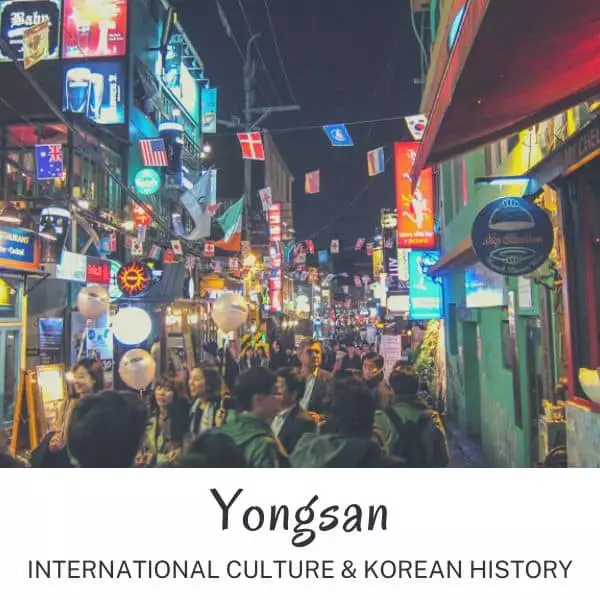
Yongsan is the area encompassing the N Seoul Tower, the popular international area of Itaewon, the trendy hilltop area of Haebangchon (HBC), Seoul Station, the National Museum of Seoul, and many riverside parks. Yongsan has a busy train station with towering skyscrapers and hotels around it catering to business and luxury travellers, as well as shoppers. This quiet business and residential area has good transport links and fewer crowds than other parts of Seoul, as well as interesting cultural attractions.
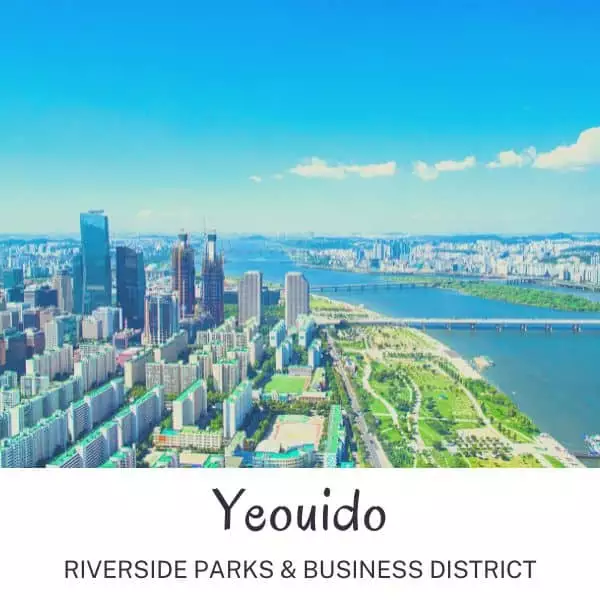
Yeouido is a large island that rests in the Han River, overlooking Hongdae and Yongsan. It has some of the best parks in Seoul and is a popular place for locals to walk along the river on weekends and at night. These parks are home to Seoul’s biggest cherry blossom festivals, as well as summer night markets, fireworks performances, live music, and people enjoying life outside of work. Yeouido is the upmarket financial centre of Seoul, making it an ideal base for business, luxury, and family travellers.
Seoul’s neighbourhoods are informal designations, not necessarily the official district name. For example, Hongdae is a neighbourhood in the Mapo-gu district and Myeongdong a neighbourhood in the Jung-gu district. Whereas Jongno is both the neighbourhood and district name (Jongno-gu).
You might see some areas referred to differently. However, the terms I’ve used in this section are the names most commonly used to describe these areas by tourists and expats. Koreans will certainly know which area of Seoul you’re talking about when you use these names.
Learn more : If you want to know more about Seoul’s best districts and figure out where the best place to stay for your trip to Korea, then check out my detailed guide about where to stay in Seoul . It’s packed with useful info about each neighbourhood, hotel recommendations for different budgets, and tips about booking accommodation in Seoul. Also learn more about the Han River Boat Service launching in 2024 to connect Yeoudio, Jamsil and other riverside destinations.
Hotel Recommendations For Seoul
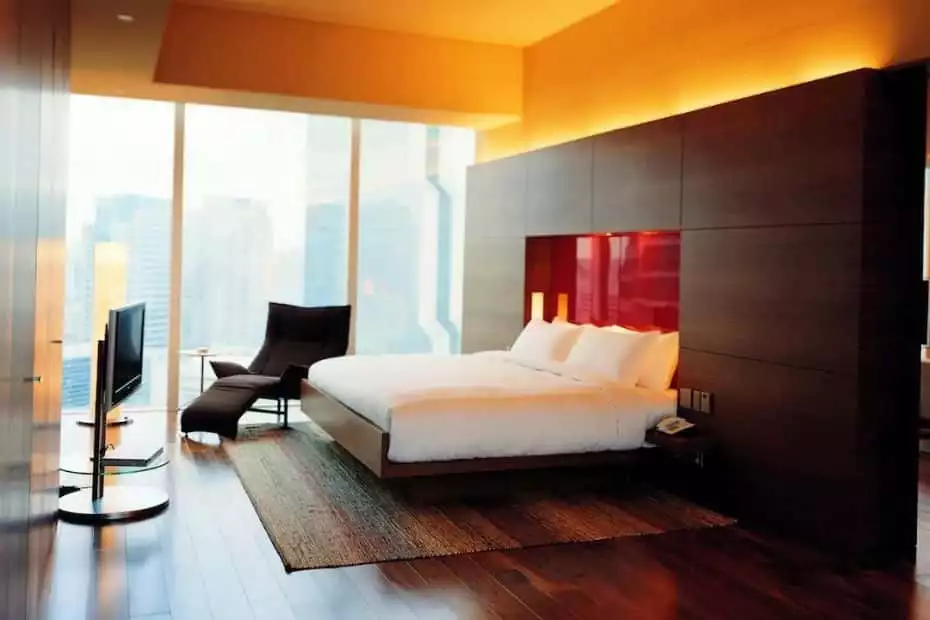
There are hundreds (maybe thousands) of hotels in Seoul to choose from ranging from multi-person dorm rooms to the height of luxury looking down over Seoul from a 5-star hotel room in the Lotte World Tower . Whatever your budget or requirements, there’ll be somewhere to stay in Seoul for you.
To save you time searching for the best places to stay in Seoul, I’ve created a list of the 9 best luxury, mid-range, and budget hotels in Seoul, as well as 6 long-stay serviced apartments. This list has been created based on customer reviews, location, facilities, amenities, reputation, and quality.
I live outside of Seoul, so often book hotels when I’m visiting Seoul for the weekend . I’ve stayed at quite a few of these, so can personally recommend them based on my own experience. I’ve had both good and bad hotel experiences in Seoul and only want to recommend the best to you.
Recommended Luxury Hotels
Seoul has some incredible luxury hotels to enjoy, each with a true 5-star service, excellent amenities, and delectable restaurants. Many of Seoul’s best luxury hotels are located in Gangnam, Seoul’s wealthiest district, where you can find top restaurants and designer brand shopping.
Recommended Mid-Range Hotels
If you want to experience a luxurious stay in Seoul without breaking the bank, then these mid-range hotels will be perfect for you. These unique, 4-star hotels are reasonably priced and provide stylish, comfortable rooms that you’ll sleep easily in after a busy day exploring Seoul.
Recommended Budget Hotels
Seoul has a wide range of excellent budget hotels with prices that might surprise you for a large city. These are some of my favourite places to stay in Seoul when I visit for the weekend and are popular with travellers due to their convenient location, facilities, and comfortable beds.
Recommended Serviced Apartments
If you plan to stay in Seoul for a month or more, these serviced apartments will provide you all the comforts of home with the benefits of staying at a hotel. These excellent serviced apartments come with cleaning services, health facilities, cooking facilities, and are value for money.
Cost To Travel In South Korea In 2024
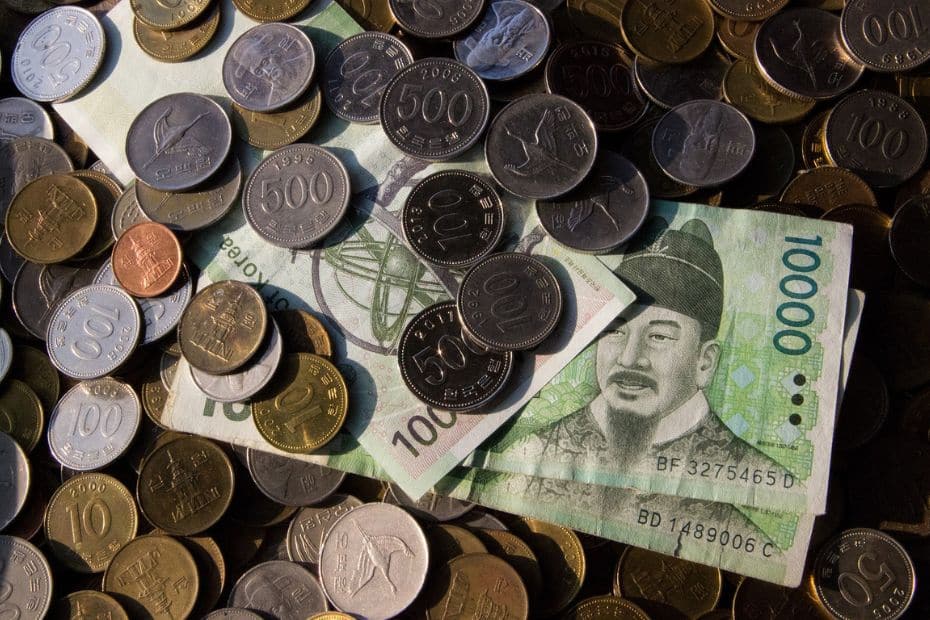
This part of the South Korea travel guide will help you understand some of your expected costs to travel to Korea. The costs to travel to Korea include flights, accommodation, food, drinks, transportation, activities, sim cards, visas, souvenirs, travel insurance, and lots more.
The costs you will pay when you travel vary massively depending on what type of traveller you are and what style of travel you can afford. If you want 5-star luxury and fine-dining, your budget will be very different from someone eating ramyeon from 7-11 and staying in a budget guesthouse.
Therefore, I will try to provide expected costs for 3 different types of traveller – budget , mid-range , and luxury . These aren’t exact figures, but should give you a rough idea of how much you’ll spend.
Daily Costs To Travel In Korea
There are costs that you will pay each day when travelling in Korea that can be averaged out to give you a daily cost. Knowing these figures will help you plan your budget for Korea and to see where you can afford to spend more for the one-off costs to travel, which will be covered next.
The daily costs are accommodation, food & drinks, transportation, attractions & tours, and miscellaneous expenses that can pop up unexpectedly. These miscellaneous costs might include getting a street food snack, an unexpected entrance fee, or a few extra drinks in the evening.
Transportation will be covered later in this South Korea travel guide and there are some useful tips to reduce your transportation costs. You will also be able to see some of the best attractions, tours, and activities in Korea and you’ll be able to work out how much you’ll spend on those.
Here are the daily costs per person to travel in Korea:
Please note : These are costs per day, per person . Couples and families sharing a room will have lower costs as double rooms aren’t much more expensive than single rooms. Some days will be cheaper, some much more expensive, especially if you take day trips or visit premium attractions.
There are also one-off costs not included in these daily costs. These can be pre-travel costs, such as flights and a K-ETA or tourist visa (already covered), travel insurance, vaccinations, and such like. Pre-travel costs are different for each traveller and depend on your country of residence.
Other one-off costs during travel in Korea may include day tours, souvenirs, shopping, celebrations, medical costs, and expenses that you don’t normally pay each day. Again, these vary for each traveller and are difficult to calculate as people’s budgets are so different.
Is Korea A Cheap Country To Travel In?

Korea is relatively cheap country to visit, but certainly isn’t always a budget destination. The cost to travel to Korea has risen over the last few years and might be more expensive than you think, even if you’ve previously visited Korea. Flying to Korea is certainly more expensive now.
Food costs rose by 7.5% in 2022 alone and these costs have been passed on to restaurants, which now charge higher prices for meals. Transportation costs rose by about 20% in 2023 for buses and subways, although these are still relatively cheap compared to some countries.
Despite these price increases, travelling in Korea is still cheaper than travelling in most other high-income industrialised countries such as Japan, the USA, and Western Europe. If you’re from countries such as the Philippines, Thailand, Indonesia, or Malaysia, Korea may seem expensive.
City Passes That Save You Money In Seoul
There are a number of city passes that can save you money when visiting Seoul by offering free or discounted entry to some of the best attractions in the city for a single price. The original city pass for Seoul is the Discover Seoul Pass, but now there is also the Go City Pass and Klook Pass Seoul.
Here’s a summary of each of these Seoul city passes:
Discover Seoul Pass : Available in 24 | 48 | 72 hour periods, allows entry to top attractions in Seoul such as Lotte World Adventure, N Seoul Tower, COEX Aquarium, Alive Museum, Zoolung Zoolung, Sealala Sauna, Gyeongbokgung Palace, and more. Prices start at 50,000 KRW .
Go City Seoul Pass : Available as 1 – 5 day passes or a flexible pass for up to 7 attractions. Covers a wider amount of attractions than the DSP, including a DMZ Tour, Nanta Cookin’ Musical, Seoul Land, Seoul Pub Crawl, Seoul Ghost Tour, and more. Prices start at 68,000 KRW .
Klook Pass Seoul : Available for use 2 – 5 attractions, including Everland or Lotte World Adventure theme parks. The Klook Pass Seoul allows free entry to selected attractions within a 30 day period. Attractions include the N Seoul Tower and Lotte World Aquarium. Prices start at 44,000 KRW .
If you’d like to know more about these passes, be sure to check out my article about the Klook Pass Seoul , as well as my suggested Discover Seoul Pass itineraries . I’ll have a review article of the Go City Seoul Pass soon, too.
How To Save Money In Korea
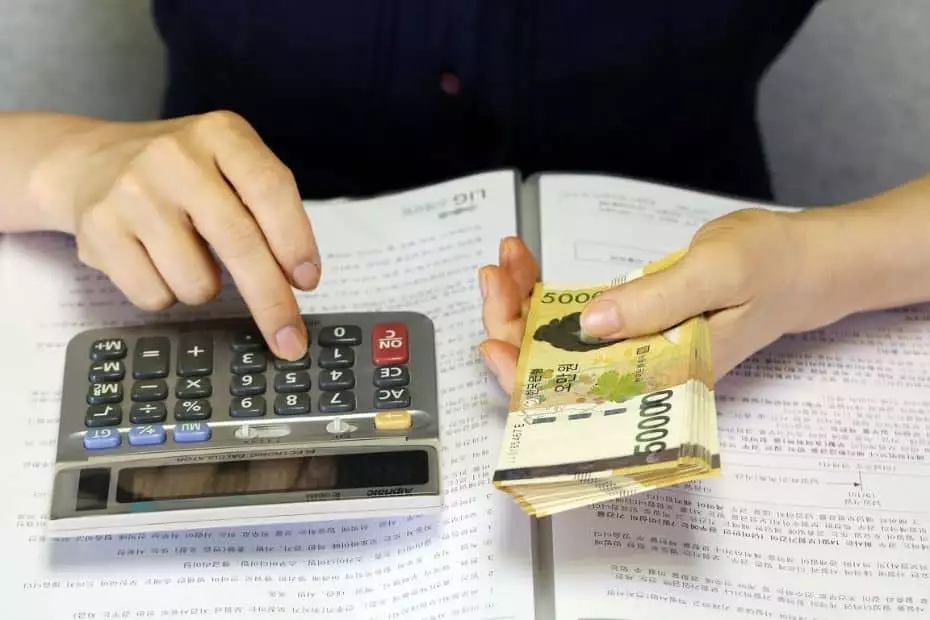
There are always ways to save money and spend less in Korea. Budget options exist for travellers and you can travel in Korea for less than 150,000 KRW per day, even as little as 50,000 KRW per day. Here are some of the ways you can save money in Korea and travel more for less:
Eat like a local : Visit the traditional markets, food stalls, and traditional Korean restaurants. These are much cheaper than eating foreign foods in Korea. University areas are usually cheap, too.
Spend less on coffee : Coffee in Korea can be expensive, but it doesn’t have to be. A latte could cost you 5,000 KRW in a chain store, but there are cheap hole-in-the-wall cafes where it’s half that.
Shop in the markets : From designer goods (possibly fake) to souvenirs, the markets of Seoul and other cities usually have the best prices. Don’t be afraid to haggle.
Use public transport : Korea has a fantastic public transport network both in cities and between cities. Don’t waste money on taxis and private transfers when you can use a bus or subway.
Book everything online : You can find discounted entry and tour tickets online that are much cheaper than the regular price. Use Klook , Get Your Guide , and Viator for the best prices.
Stay in guesthouses and hostels : You can find rooms for as little as 10,000 KRW per night in shared dorms and 20,000 KRW in guesthouses. Book ahead to find the best prices.
Take advantage of free things : There are lots of places you can visit for free in Seoul and free services, such as walking tours in Seoul, 30-minute hanbok rentals, and even free entry to the palaces.
Get your tax back : Korea makes it really easy to recover tax you’ve paid when shopping. Stores in Seoul will process tax returns for you or you can claim a refund at the airport when you leave.
You will see tips and links in this South Korea travel guide that are designed to help you save money when you visit Korea. Booking tours, attractions, and sim cards in advance can save you a lot of money, as can using a T-Money card and Wise travel card. Keep reading for more money-saving tips.
Travel Money And Money Exchanges In Korea
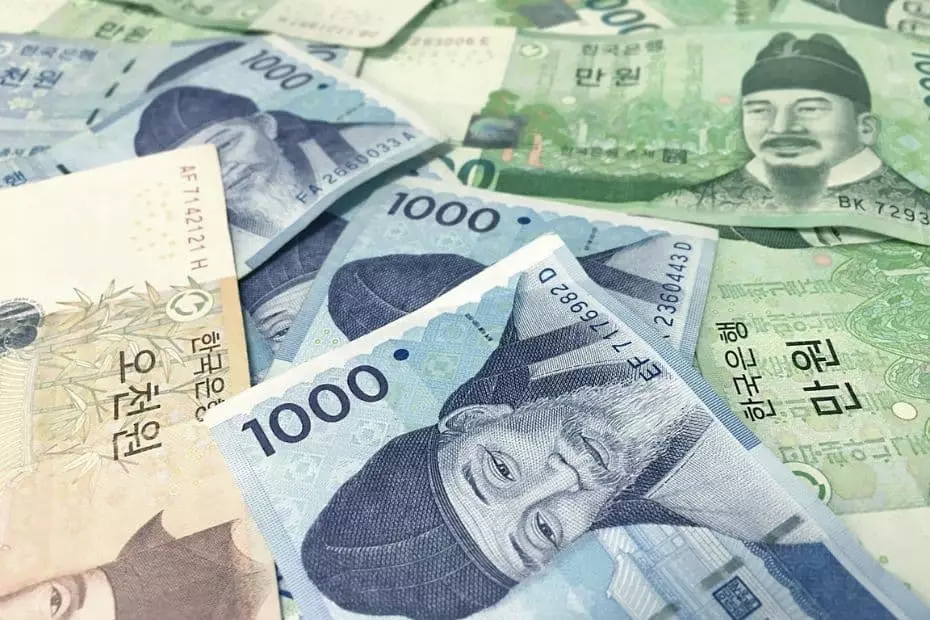
If you follow the tips in this section of this South Korea travel guide, you can certainly save yourself a lot of money and avoid unnecessary fees when spending in Korea. Learn where and how to exchange money, how to avoid ATM and card fees, and how to get tax back before you leave.
Because this section covers a lot of the common questions people ask about travel money in Korea, it will be broken down into a question and answer format. This should make it easier for you to find the information you’re looking for and discover answers you didn’t know you were looking for.
Can You Use A Foreign Card In Korea?
Almost all foreign credit cards with Visa or Mastercard will be accepted in Korea and it is possible to use these cards to pay across the country. American Express is also accepted in popular tourist areas, but not as widely as Visa or Mastercard and may have problems outside of big cities.
Foreign debit cards should work if they use Visa or Mastercard, but there may be restrictions in place with your bank when using them abroad. It is recommended that you call your bank to check before travelling. For both credit and debit cards, check your bank for any fees you’ll pay overseas.
Can You Withdraw Cash From An ATM In Korea?
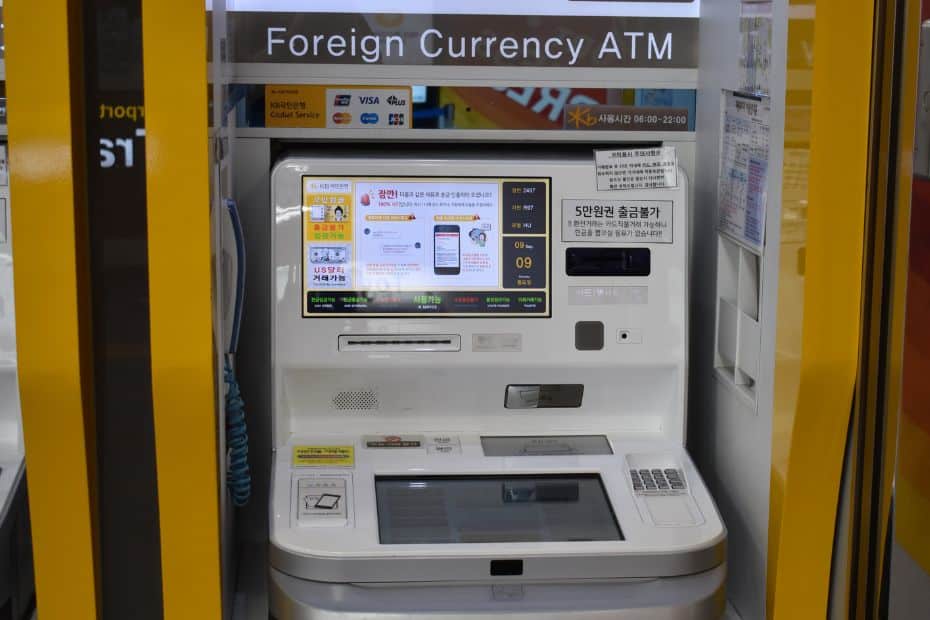
You can withdraw cash from ATMs in Korea using a debit card, but not all ATMs will accept international cards. Look for a sign saying ‘Global ATM’ or ‘Foreign Currency ATM’ to withdraw cash in Korea with a debit card. You can also withdraw cash using a credit card, but it’s more expensive.
Whether you use a debit or credit card, an ATM is likely to charge a fee to withdraw money using a foreign card. Your bank or credit card company may also charge a fee or give a bad exchange rate. These costs can add up a lot if you withdraw regularly, so try to make fewer withdrawals.
Learn more : Should you use cash or card when you visit Korea? This article about the how to pay in Korea has lots of useful information about payment methods in Korea, including alternatives to the usual mix of cash and a credit card.
How Can You Save Money When Paying By Card In Korea?
Instead of using a foreign debit or credit card in Korea, which might have expensive fees or not work in places, here are two better options. The first is the WOWPASS travel card , which offers tourist-friendly card services in Korea. The other is to apply for a travel card that can be used globally.
Both the WOWPASS and the two other travel cards offer the ability to pay by card in Korea and to withdraw cash in Korean won. They also offer better exchange rates than you’ll find in airport or local money exchanges in Korea. They each have some unique features, which will be illustrated below.
Pay Like A Local With WOWPASS
The WOWPASS is a new way to pay in Korea that combines the essential functions of a T-Money transportation card with the benefits of a local debit card. This is a prepaid card you can top up at more than 90 locations in KRW or your own currency. Just look for the bright orange WOW machines.
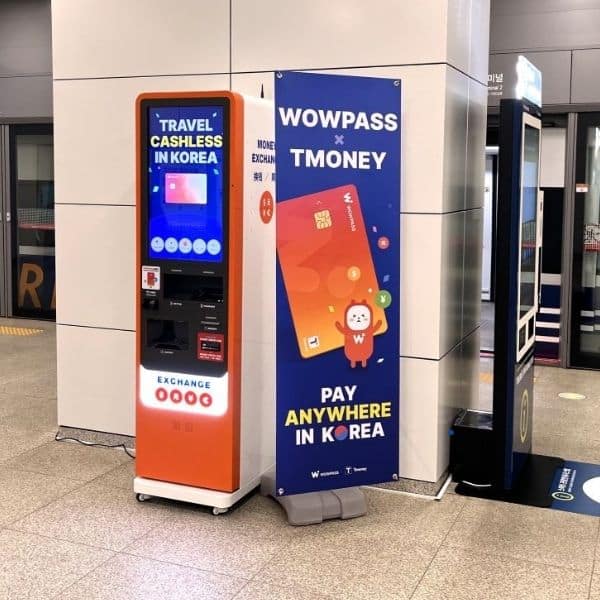
The T-Money function in the WOWPASS means it’s more useful than other travel cards as you don’t need to carry two separate cards when you travel. Please note, you still need to charge the T-Money balance of WOWPASS with cash, just like a regular T-Money card.
The WOWPASS travel card allows you to add up to 1,000,000 KRW to your card and can be used to pay for almost anything in Korea without any fees. The card is issued by a Korean company, so you can use it to withdraw cash at any WOWPASS machine located in Seoul & other cities in Korea.
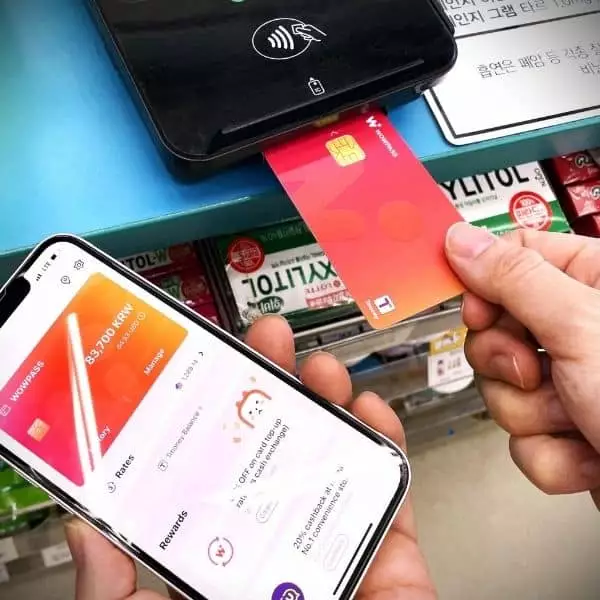
Thanks to the user-friendly WOWPASS app, users can freeze or replace their card, check their spending, add funds, and check exchange rates. Because the WOWPASS isn’t tied to your home bank account, it also reduces the damage by card fraud, in case the worst was to happen.
As well as a regular WOWPASS, you can also reserve the All-In-One Airport Package , which includes the WOWPASS, 10,000 KRW T-Money balance, and a discounted Korean sim card. This is really useful for those who want to get connected and travelling as soon as they arrive in Korea. Get the WOWPASS app for Android or Apple .
Tip : Use the invitation code INMYKOR1 to get cashback on WOWPASS top-ups in foreign currency.
Overseas Travel Cards You Can Use In Korea
Overseas travel cards are another option for spending in Korea and I use them myself to spend money from my UK bank account in Korea, as well as when travelling in other countries. They’re really simple to use and are much cheaper than paying with my foreign card or exchanging money.
Two of the leading travel card companies are Wise and Revolut . I use both of these to pay for things in Korea and have written an article about how to use the Wise card in Korea . You can use them to pay for hotels, food, drinks, transportation, taxis, attractions, and lots more. They’re really useful.
Here’s a summary of the main features of these travel cards:
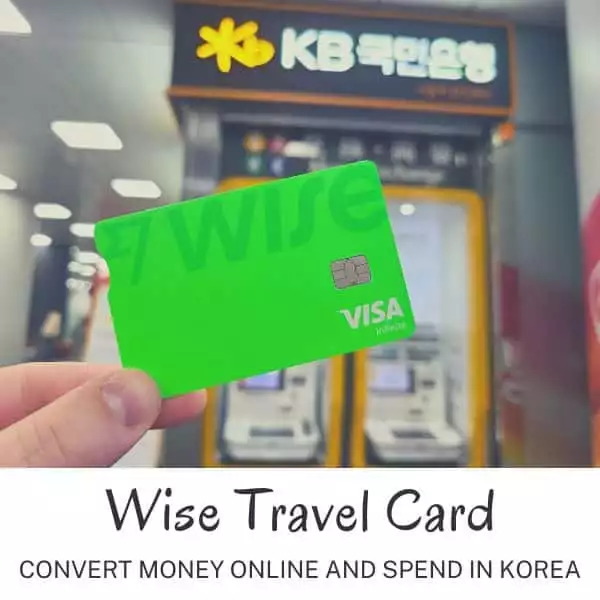
The Wise travel card allows you to easily transfer and convert money from your home bank account into dozens of other currencies and use this money to pay when you’re travelling. You only need to transfer as much as you plan to spend and can easily transfer back anything you haven’t. The exchange rate will be better than your bank or a money exchange offers, too.
A versatile, easy to use app breaks down what you’ve spent by category so you can track your travel spending. You can withdraw cash from ATMs, pay by QR code, use it for Google Pay, and pay by contactless. Even if you lose your card, you can still spend money. It’s also really safe as you can freeze your card, set spending limits, and limit how much money you transfer.
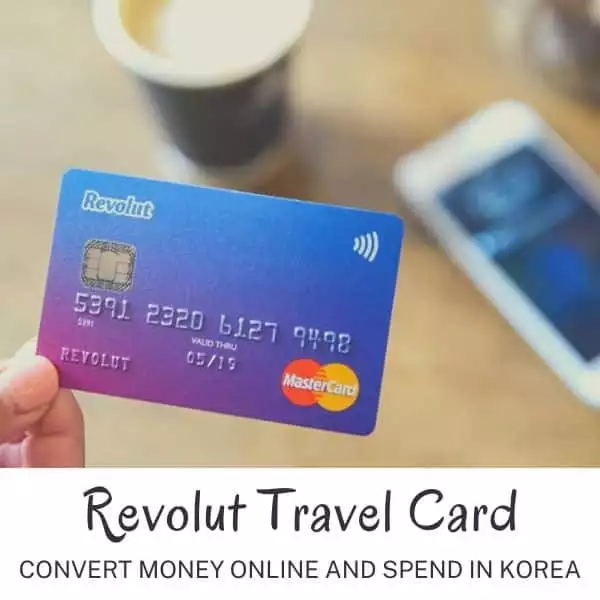
The Revolut travel card can be used in Korea to pay for a wide range of goods and services without expensive fees for spending your home currency overseas. Unlike the Wise travel card, which lets you transfer money into different currencies and then spend in a local currency, such as Korean won, the Revolut travel card lets you pay fee-free with your home currency.
The Revolut travel card comes with an easy to use app that can be used to manage your money both at home and when travelling in Korea. You can check your spending with categories and reports and set budgets for your spending. The Revolut travel card also offers cashback in the US, stock and crypto investments, and the same security features as the Wise travel card.
Can You Use Apple Pay In Korea?
Apple Pay wasn’t previously available in Korea due to a lack of approval by Korea’s financial regulator. However, in February 2023, Apple Pay received approval to begin operating in Korea through the Hyundai Card Co., allowing payments with Apple devices from March 2023 onwards.
The Apple Pay payment system has been available in Korea since March 21st , 2023 and allows Apple Pay members to pay for goods and services at NFC-enabled payment terminals. However, on the launch date of Apple Pay, there were only 70,000 NFC-enabled payment terminals in Korea.
The lack of NFC-enabled payment terminals will be a big issue for Apple Pay users in Korea as there are around 2,900,000 shops in Korea and most won’t accept Apple Pay. Franchises like Starbucks can’t accept Apple Pay and it can’t be used to pay for public transport. You’ll need a T-Money card.
Samsung Pay, which uses MST technology, not NFC, currently dominates the Korean market. NFC-enabled terminals should grow, especially in tourist areas and city-centres from 2023 onwards. This will be good news for Google Pay, which also uses NFC technology and also isn’t in use in Korea yet.
Should You Exchange Money Before Travelling To Korea?
It is not necessary to exchange money into Korean won before travelling to Korea, but it can certainly be useful to have a small amount of money. Exchange rates for Korean won outside Korea may not be as good as within Korea and changing large amounts of cash before you travel isn’t essential.
It might be hard to get Korean won from your local bank or money exchange as it’s not one of the most commonly exchanged currencies. Therefore, you might find exchange rates less favourable and extra fees applied to exchange money. Using travel cards like Wise or Revolut is a better option.
Should You Change Money At Incheon Airport?
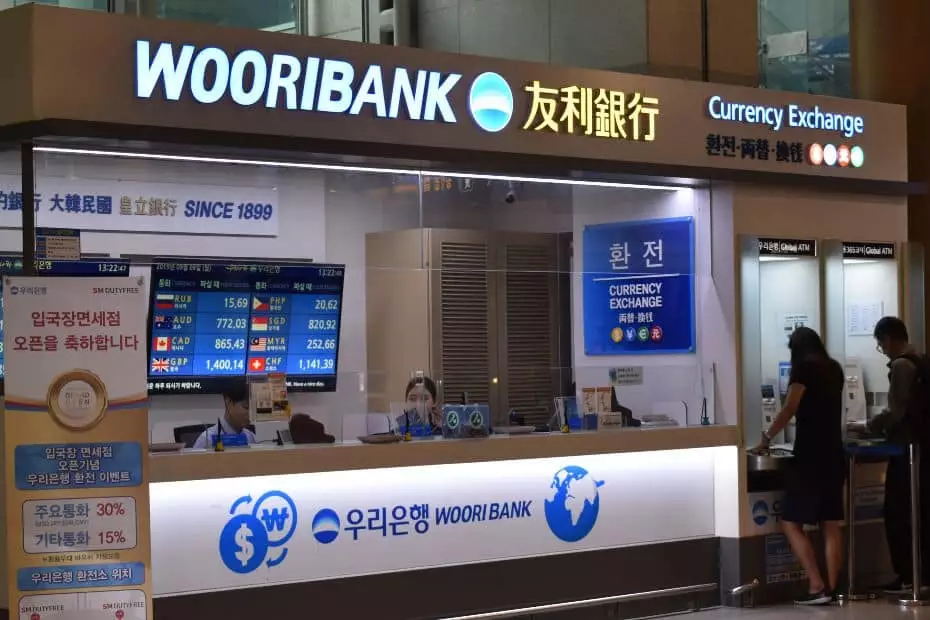
I’ve travelled around the world and always avoid exchanging money at the airport if I can help it. Airports often have the worst rates for money exchange as they know people need to get local cash, there aren’t many other options, and you need at least a bit of money to travel to your hotel.
Incheon Airport is an exception to this rule and I’ve compared travel exchange rates at several times when flying into and out of the airport. The foreign currency exchange rates at Incheon Airport aren’t that bad and are just slightly higher than what you’d find in Seoul. Not the best, but not bad.
There are also Global ATMs at Incheon Airport, so you can withdraw cash here. If you have a Wise or Revolut travel card, you can withdraw up to $200 fee-free from an ATM in Korea. However, Korean banks will charge a withdrawal fee (about 3,000 KRW), which applies to any foreign card used.
Where Can You Exchange Money In Seoul?
Seoul is the first destination for most travellers to Korea and if you want to save money on exchange rate fees, I recommend exchanging money in the capital. There are two main options for exchanging money easily and quickly in Seoul – WOW money exchange machines and money exchanges.
Here’s a summary about the two main ways to exchange money in Seoul:

The cheapest and most convenient option for exchanging money in Seoul is through a WOW money exchange machine. This automated machine gives the best exchange rates and can quickly and easily exchange foreign cash for Korean won. It doesn’t accept card payments, only cash. All you need to do is scan your passport and deposit your cash and it will convert it into Korean won immediately. There are dozens of these machines in Seoul, as well as in other cities like Busan and Daejeon.
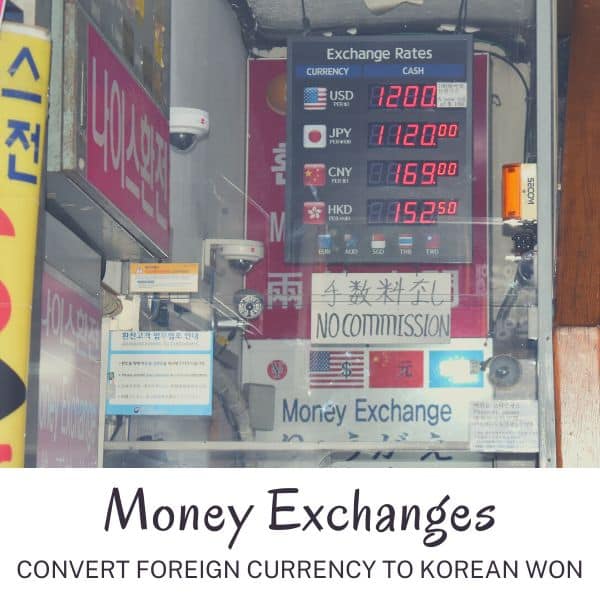
The traditional way to exchange foreign currency in Seoul was through a money exchange. You can find these in Myeongdong, where many tourists stay and visit in Seoul. There are also money exchanges inside banks and in other tourist hotspots. These used to be the best place to exchange money, until the WOW money exchanges were introduced and travel cards like Wise and Revolut made it easier to use a card. If you want to use a money exchange in Seoul, Myeongdong is the best place to do it.
Can You Get Tax Back When Shopping In Korea?
Travellers to Korea can claim tax back on eligible purchases during their trip. This can be done immediately after you purchase an item (if the shop offers the service) or at Incheon Airport or other airports in Korea before you depart.
Instant tax refunds are available at certain locations in Seoul and other big cities. These are usually department stores and large chain stores. You are able to claim tax refunds for goods up to a total value of 2,500,000 KRW (incl. tax). There is a tax refund limit of 500,000 KRW per transaction.
2024 Tax Refund Changes : From 2024, the tax refund limits will be doubled, so you will be able to claim up to 5,000,000 KRW of tax back and claim up to 1,000,000 KRW back per transaction. Source: Korea Herald .
To claim a tax refund you need:
- To show your passport
- To be a tourist in Korea
- To spend between 30,000 to 300,000 KRW in one place
- To be leaving Korea within 3 months
Tax isn’t refundable on all purchases, so be sure to check when shopping. Tax refunds can also be claimed at the airport as long as you have the receipt and the goods you’ve purchased.
Mobile Phones And Internet In Korea
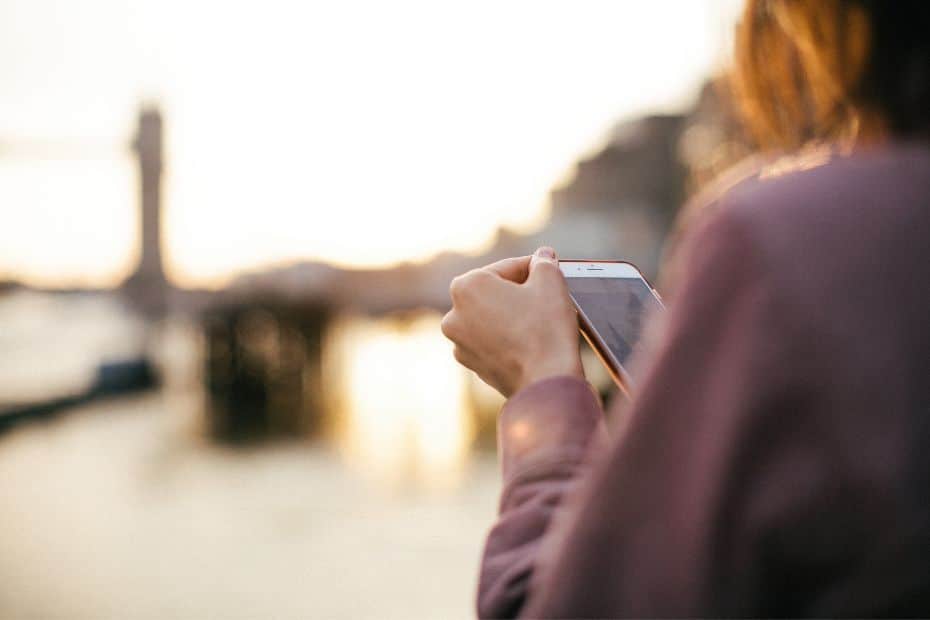
Staying connected to the Internet when visiting Korea is becoming more and more essential these days. Keeping your mobile phone, tablet, or computer connected to the web is useful not only to stay in touch with people back home, but also to help you save money and travel Korea more easily.
There are several options to stay connected in Korea when you travel. The main options for travellers are tourist SIM cards, either physical or eSIMs, portable WiFi routers, and relying on free WiFi provided in public places and hotels. All of these are good options, but there are other considerations, too.
This South Korea travel guide will cover the main differences between Korean SIM cards and portable WiFi routers and which will be most suitable for you. There are also details about why you might want a Korean phone number and which apps to use to help you travel in Korea.
Don’t forget, if you bring your phone or other mobile devices to Korea, you’ll need a travel adapter .
Should You Get A Korean SIM Card Or WiFi Router?
Both a Korean SIM card or portable WiFi router will provide access to Korea’s high-speed mobile networks and keep you connected to the Internet. They provide a secure internet connection, but do so in a different way and with different available features. Find out about the best Korean SIM card for tourists in this SK SIM card review .
Here are the main features of Korean SIM cards and WiFi routers:
Costs : SIM cards and WiFi routers are similarly priced when using them for a two week period, but they are charged in different ways. SIM cards are fixed-price and can be bought for set time periods, whereas WiFi routers are charged daily. WiFi routers are cheaper in the short-term.
Ease of use : If you purchase or pre-order a SIM card or portable WiFi router at Incheon Airport, which I highly recommend, the staff will install or setup everything for you. Once they’re activated, it’s very simple to use either one. Cancelling and returning them at the airport is also easy for both.
Here are the reasons you should get a Korean SIM card or portable WiFi router in Korea:
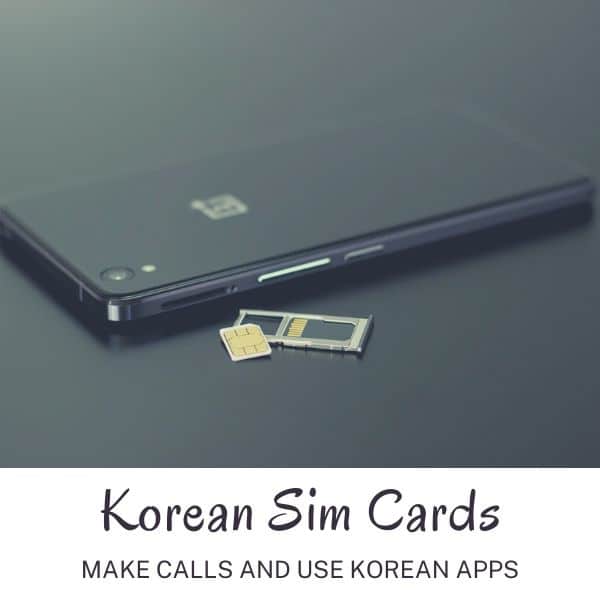
You should get a Korean SIM card when visiting Korea to get a Korean phone number. The benefits of having a Korean phone number are mainly to make calls and use Korean apps. SIM cards are also useful if you want a secure connection everywhere you go and plan to make calls or send texts. When you have a SIM card, you can tether your network connection to connect other devices you own. Korean phone coverage is amazing and you’ll get service everywhere. SIM cards don’t require you to carry any extra devices and are cheaper over the long-run than WiFi routers.
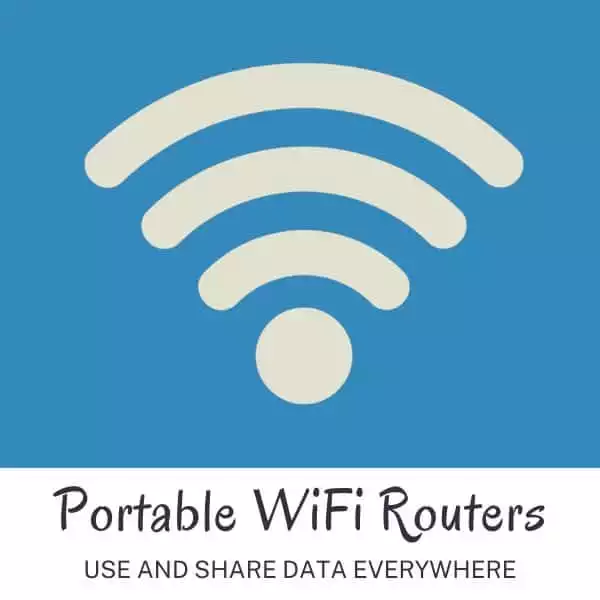
You should get a portable WiFi router if you’re travelling in a group or as a family as you can connect multiple devices to one router. This is much cheaper than getting separate SIM cards for all travellers, but also requires people stay close together. WiFi routers are charged per day and if you need additional days, they’ll be automatically added and charged when you return the router. This means you’ll never have to worry about your service suddenly ending. The main downside to using a WiFi router is the lack of Korean phone number, but that might not be an issue if you don’t need one.
Where Can You Get Korean SIM Cards Or WiFi Routers?
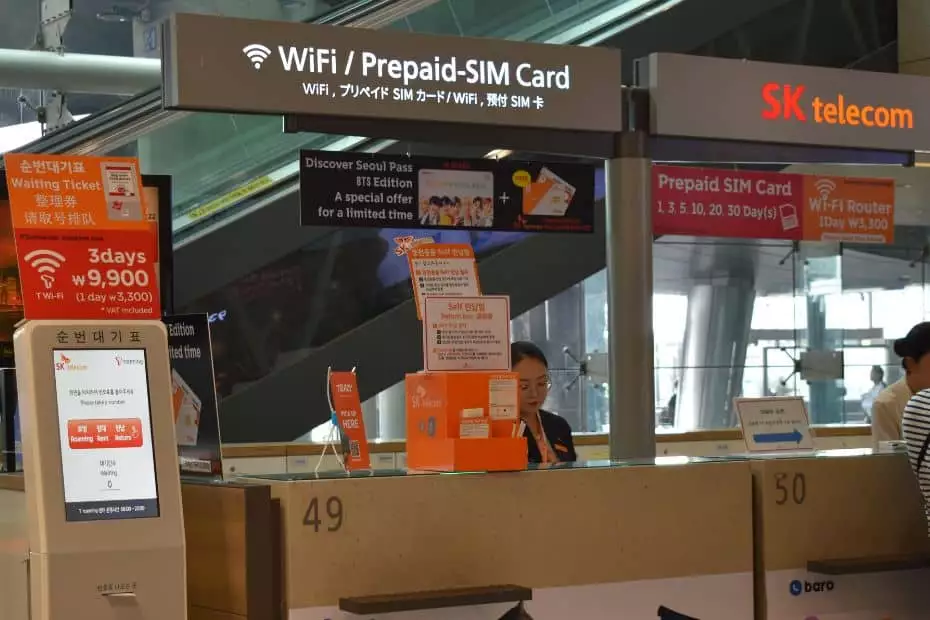
You can get a Korean SIM card or portable WiFi router in several ways. The easiest way, and one that I definitely recommend, is to purchase online through a tour company such as Klook , Viator , or Get Your Guide , and get a SIM card at Incheon Airport or other entry point into Korea when you arrive..
The main reason I recommend this method is that you can guarantee you will get a SIM card or router and it will be waiting for you when you arrive. The collection desks at Incheon Airport are open 24-hours a day and they will help you install everything you need to get started immediately.
You can also get SIM cards and WiFi routers when you arrive at the airport and you should find similar rates. However, you won’t be guaranteed a device and you will need to pay in person. When you book online, you can pay in your home currency and avoid those issues.
I don’t recommend getting a SIM card or WiFi router in Seoul or other cities. It is possible, but you may run into language issues and find less tourist-friendly options. Phone shops outside the airport usually cater to Koreans, not tourists. Airport rentals are the easiest options for visitors to Korea.
What’s The Benefit Of A Korean Phone Number For Tourists?
There are two main benefits of having a Korean phone number for tourists. The first benefit is the ability to call people when you’re in Korea. This can be useful for making reservations, keeping in touch with people, and in case of emergencies.
The second benefit of having a Korean phone number is the ability to use Korean apps . It isn’t mandatory to have a Korean phone number to use Korean apps, but most won’t let you use their services unless you sign up with a phone number. Using Korean apps makes travelling easier.
A phone number is like a form of identity in Korea, which is why you need your passport to register a SIM card. Once you have a phone number, many more services are available, including food delivery, ordering taxis, making reservations (such as for the Busan Sky Capsule ), and online messaging.
What Apps Do I Need For Travelling In Korea?
If you have a Korean phone number, you can use Korean apps. Even without a Korean number, you can still download these apps and use some of their services. Full features typically require a phone number though. There are other, non-Korean apps that will help you when travelling, too.
Here are the most useful apps to use when travelling in Korea:
Papago : This is the essential translation tool for visiting Korea. Papago’s translation services are the best and you can use the app to take pictures and translate Korean signs, menus, and other pictures.
Naver Maps : To find your way around Korea, use Naver Maps or Kakao Maps. Their systems are much more accurate in Korea than Google Maps. Use them to plan travel routes and transport times.
Kakao Taxi : Uber and Grab don’t really exist in Korea, so if you plan to take a taxi, you’ll need to use Kakao Taxi. Simple to use and takes the hassle out of trying to use Korean to give directions.
Kakao Talk : This is Korea’s most popular messaging app and is useful for keeping in touch with Korean friends, contacting businesses in Korea, and even calling abroad.
Seoul Subway : Use this app to travel around Seoul’s underground more easily. Plan your route, see when the next train is due to arrive, check connections, and see how late the trains run.
Korail Talk : This app allows you to book trains on Korea’s high-speed train network and regular train routes. This app has an English setting, so you can check train times and prices easily.
Coupang Eats : This is a food-delivery app that allows you to order almost anything edible and get it sent directly to you. You can even order convenience store goods. Useful for rainy days.
Mango Plate : Find restaurants in Korea with this app and discover the best places to go out and eat. You can also see restaurant details and get directions in Naver Maps and Kakao Maps.
WOWPASS : To use the WOWPASS to pay like a local in Korea and for T-Money functions, you’ll need the WOWPASS app. This will let you check your balances and spending and control your card.
Wise & Revolut : As mentioned in this South Korea travel guide, using a travel card to pay for items in Korea will save you money when you travel. If you use Wise or Revolut, make sure you have the app.
Klook : This company provides some of the best tours in Korea and if you make bookings through their website, you can easily manage them with the Klook app.
Intercity Bus by T-Money : This app is great for booking buses between cities in Korea. There is an English version that allows you to book tickets, check times, and see available seats.
These apps should be available on both Android and Apple. Some of these apps might default to Korean, but you should be able to change them to English in the side menu.
Is There Free WiFi In Korea?
Travellers in Korea have the option to not get a sim card or portable WiFi but still stay connected. This is thanks to the excellent Free Wifi in Korea that is provided in public transport, government buildings, restaurants, cafes, and many other places. This is mostly in the cities, however.
Hotels also provide free WiFi in most cities in Korea. If you plan to rely on free WiFi, I recommend using the hotel’s WiFi to plan routes, check opening times, and research places you want to visit. Take screenshots of these details so you can see them later, even if you don’t have Internet access.
The only warning I would give about relying on free WiFi when travelling in Korea is the increased use of mobile-dependent apps and passes in Korea. Physical tickets and passes are being phased out in favour of digital versions, which often need an active Internet connection to use.
I’ve noticed in recent years that services that impact travellers have moved to digital versions. This includes the T-Money card, Discover Seoul Pass, train and coach tickets, attraction tickets and event tickets. I believe that having a reliable net connection will be a must for most travellers soon.
Using Public Transport In Korea In 2024
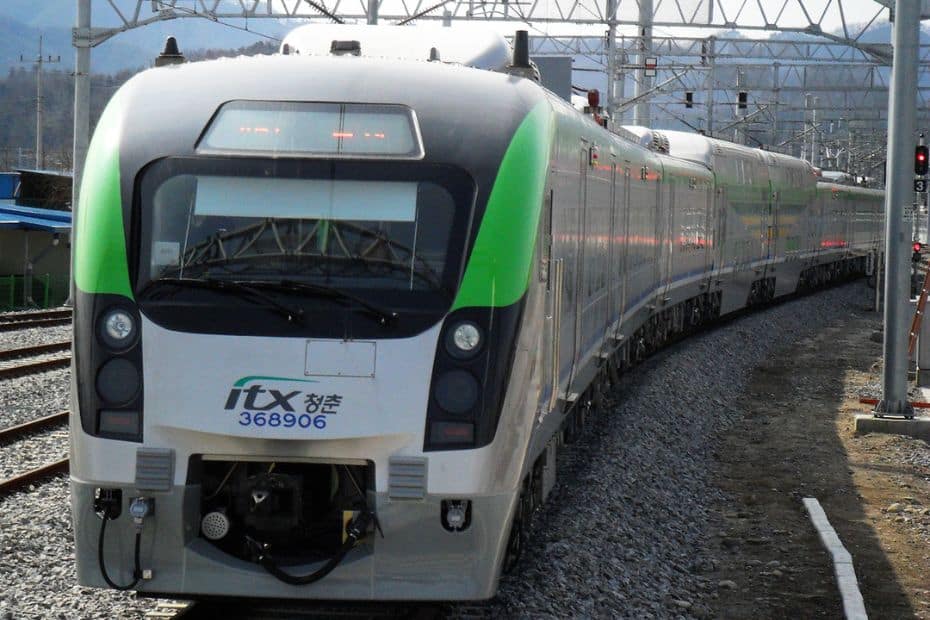
This section of the South Korea travel guide looks at Korea’s public transport system and how to navigate it as a traveller. Korea has arguably one of the best public transport systems in the world. It’s cheap, well-connected, frequent, and runs on time. Other countries could learn a lot from Korea.
The great news for tourists is that Korea’s public transport is very foreigner friendly and information is provided in English in almost all places, as well as Chinese and Japanese in popular areas such as Seoul and Busan. Travelling by public transport in Korea is cheap, easy, and convenient.
How Much Does Public Transport Cost In Korea?
The cost of public transportation in Korea is fixed, no matter what day you purchase tickets on. If you buy one month in advance, or last minute, you will pay the same price for the journey. Journeys within a city are a single price and not dependent on how far you travel, unless you leave the city limits.
All journeys are single fares and you can’t buy return tickets. You will need to buy two singles when you want to travel somewhere and back again. The cost of a single fare depends on how you pay for the ticket – by cash or with a transportation card.
Here are the costs for public transport in Korea by payment method, type and user:
Please note : The cost of subway rides is set to rise to 1,400 / 1,500 KRW in October 2023. These prices will be adjusted when this occurs.
How Do You Pay For Public Transport In Korea?
The cost of public transport in Korea depends on whether you pay with a transportation card, such as T-Money, a Korea Tour Card , or Cashbee, or in cash. This applies to both subways and buses. If you use a transportation card, you should add credit to it, then touch it to the card reader at the subway or bus to pay.
To use cash to buy a subway ticket, you will need to buy a ticket at the station. For buses, you should pay the correct fare to the driver when boarding the bus. However, since 2022, buses across Korea have started to end the use of cash and some will insist on payment by transportation card only.
In the future, bus payments are expected to become simpler with fares deducted via bluetooth-enabled phones that have the relevant app downloaded. This system has already been in place in Gyeonggi Province since March 2022 and is likely to spread to more bus routes in the future.
I highly recommend getting a T-Money card when you travel to Korea. You can use it to pay for public transportation (at a discounted rate), and it will work almost everywhere in Korea. It can also be used to buy goods from shops, cafes, and restaurants. It’s really convenient and a must-have for Korea.
Using T-Money To Pay For Public Transport In Korea
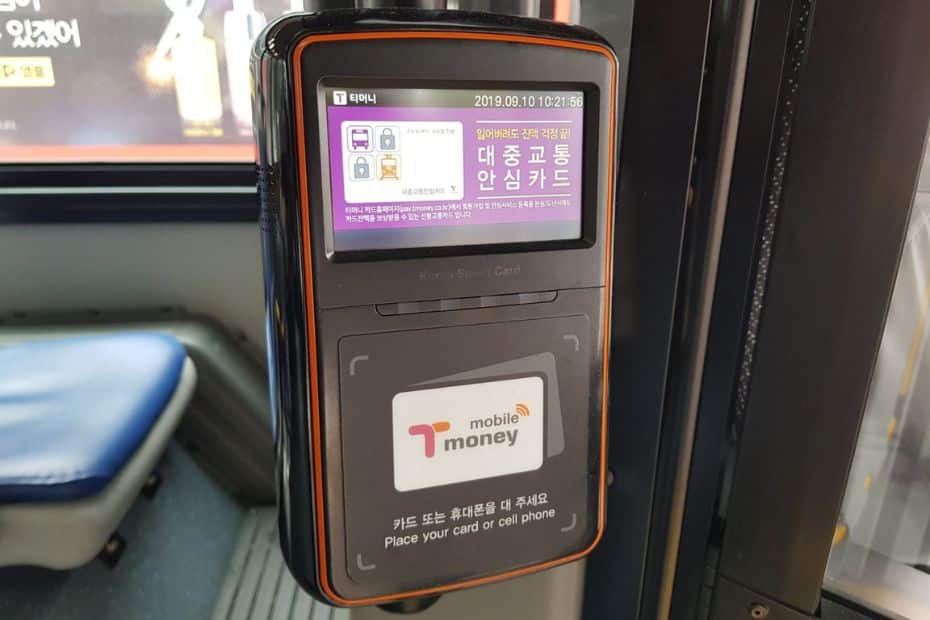
A T-Money card is the essential transportation card for using public transport in Korea. You can purchase one at Incheon Airport, subway and train stations, and convenience stores across Korea. The card can be used in many places. It never expires, so you can use it on different trips, too.
Here is how to use a T-Money card in Korea:
- Purchase a T-Money card (2,500 KRW)
- Add money to the card (cash top-up only)
- Enter the bus or subway station
- Tap the T-Money card against the card reader (see pic above)
- Tap the T-Money card again when you get off (for transfer discount)
- Recharge when necessary
I recommend adding about 10,000 KRW for each day you plan to travel in Korea. That means about 70,000 KRW for a week. You can add more money later if necessary. You can top up at convenience stores and transport stations. There is also an app version of T-Money, but the card version is better.
How Do You Use Trains In Korea?
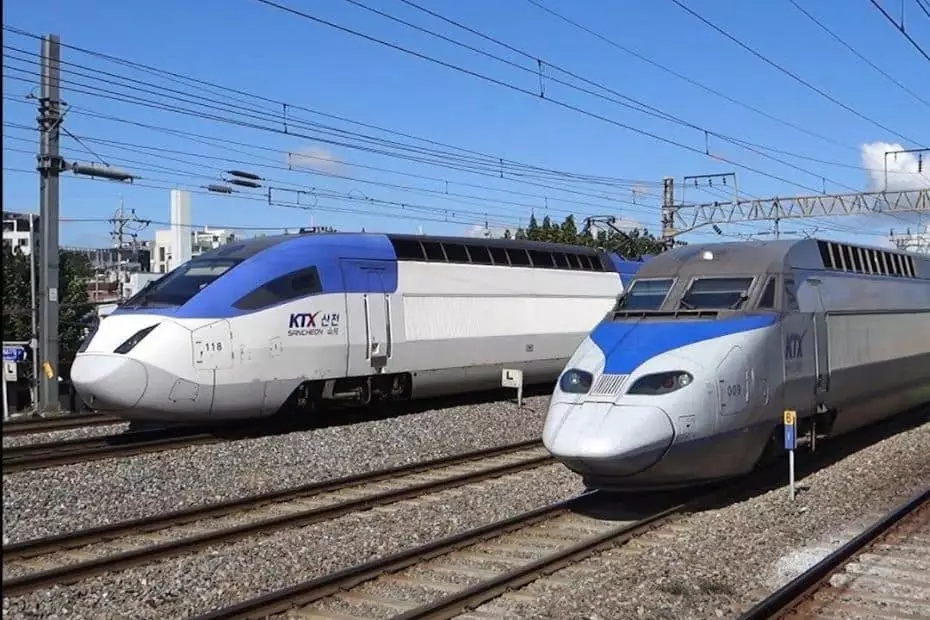
The train network in Korea is divided into high-speed trains (KTX) and regular trains (ITX and Mugunghwa). The KTX network connects major cities in Korea and is convenient for travelling around Korea quickly and cheaply. The carriages are comfortable and come with modern facilities.
Unlike other forms of public transport in Korea, transportation cards like T-Money aren’t accepted for trains. You will need to buy a train ticket to travel and all tickets are single tickets. The price to buy a ticket doesn’t change and you can refund a ticket up to the last minute for only a small fee.
You can book tickets within 30 days of travel through the official Korail website or app, or at a train station in Korea. Unfortunately, buying a train ticket online in Korea can be difficult as Korean payment systems often reject cards issued outside of Korea. Buying in person is recommended.
How To Book Korean Rail Tickets Outside Of Korea
If you want to book Korean train tickets outside of Korea, you can do it online with Trip.com , which is Korail’s exclusive overseas distributor. The price is slightly higher (about 5%) than the price you’ll pay in Korea, but it will allow you to book tickets online and secure your seat in advance.
If you plan to travel on the main KTX route between Seoul and Busan, I highly recommend booking tickets in advance. There are three types of tickets available – first class, regular, and standing. The journey takes 2:34 and you don’t want to be standing for all that time. Book ahead for comfort.
Is The Korea Rail Pass Worth The Price?
The Korea Rail Pass is a good option for tourists who plan to travel long distances by train in Korea, such as between Seoul and Busan or Seoul and Jeonju. The pass has two main options – flexible and consecutive. These mean you can use it any time (flexible) or within consecutive days.
The flexible pass is more expensive, but offers more freedom to travel around Korea over a longer period. You can use the pass to only cover big journeys and won’t feel pressured to use it again until you’re ready. The extra cost is more than worth the inconvenience of having to rush travel plans.
Will you save money with the Korea Rail Pass? That depends on your travel plans, how often you’ll be travelling by train, and how many people are travelling. If there are 2 people or more, purchase the group saver pass and save 10,000 KRW each on the pass. Group tours make it better value.
The Korea Rail Pass does not allow you to ride on the subway for free, which would make it better value. It can also be complicated to reserve tickets online using the pass and buying tickets in the regular way is more convenient. Overall, the pass isn’t essential, but might save you money.
How Do You Use Taxis In Korea?
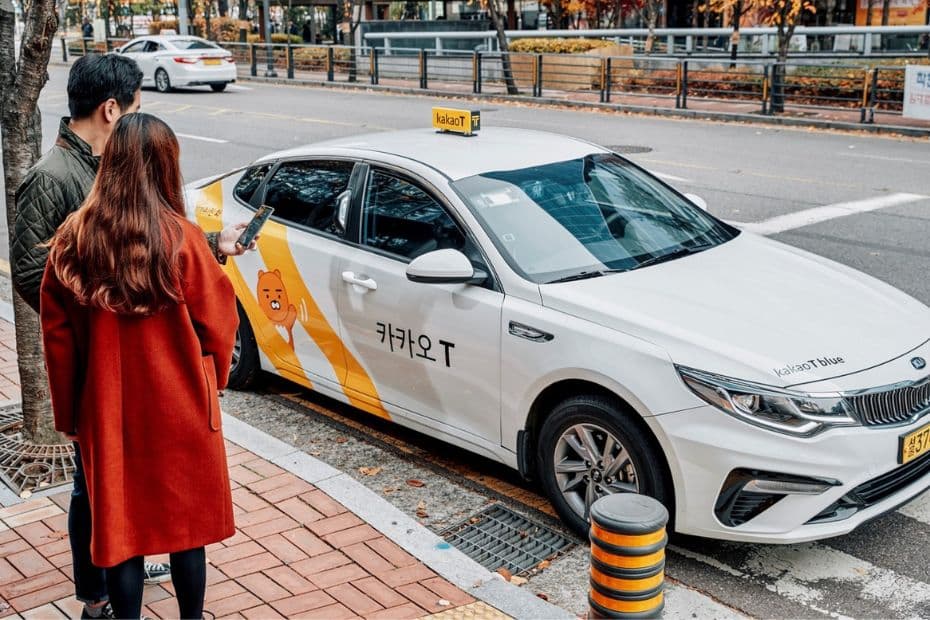
Taxis in Korea can be hailed from the street or called directly to you using apps such as Kakao Taxi . Companies like Uber and Grab don’t have a large presence in Korea and operate the same way as Kakao Taxi, by helping you find an official taxi driver. Private taxi services aren’t common.
The big issue facing the Korean taxi industry in 2024 is the lack of taxi drivers. This can make it hard to get a taxi, even when using an app like Kakao Taxi. Late night taxis are particularly difficult to find. Read this guide about how to use Kakao Taxi to help you learn how to call a taxi in Korea.
Taxi prices in Korea are reasonable, especially compared to countries like Japan and the UK. Although base taxi fares rose in 2023 to 4,800 KRW, the price is still low and relatively affordable to travel by taxi if you need to. It’s a good option if there are no direct public transport routes.
Taking a taxi to and from Incheon Airport is a convenient option if you have a lot of bags or you are travelling in a group. For solo travellers or couples, I would recommend using public transport or a limo bus, as it’s significantly cheaper and won’t take much longer than a taxi.
How Do You Use Intercity Buses In Korea?
Intercity buses in Korea operate in a similar way to trains. You can only book tickets within 30 days of travel and can only buy single tickets. Book tickets online through websites such as T-Money Bus or Bustago , through app versions of these sites, or at the bus terminal you will depart from.
You can’t walk onto intercity buses without a ticket, nor can you use transportation cards like T-Money to pay on entry. You will need to pay for and receive your ticket (physical or digital) before you can enter the bus. Ticket machines usually (but not always) have English options for buying tickets.
There are no return bus tickets in Korea and you can only buy tickets from your point of departure, unless you book online or via an app. If you’re travelling from Seoul to Gangneung, for example, you will need to buy a ticket in Seoul and then a ticket in Gangneung. You can’t buy both in Seoul.
How Can You Hire A Car In Korea?
Renting a car is a great way to see parts of Korea that aren’t covered by the train network and gives you the freedom to explore at your leisure. If you plan to travel to Jeju Island, which doesn’t have any trains, hiring a car will be a lot more convenient and is almost a must if you plan to travel inland.
Car rental in Korea isn’t that expensive and you can rent a modern car for as little as 75,000 KRW per day. I recommend booking car rentals through Klook , they will deal with the Korean car rental companies and reserve a car for you. This is easier than trying to do it in Korean.
To hire a car in Korea, you will need:
- Driver’s license (must have had it for at least 1 or 2 years)
- International Driving Permit (in some cases)
- Credit card (in the name of the main driver)
- Valid photo ID (passport)
- Printed voucher for rental (if booked online)
Here’s some more information about the International Driving Permit and rules you should follow when driving in Korea, such as the legal requirement to wear seatbelts, booster seats for under 6s, and not using your phone while driving. Be sure to read up on local rules before driving in Korea.
Best Places To Visit In Korea In 2024

The next few sections of this South Korea travel guide will help you figure out what you want to do and see on your travels. This first section will give you a brief introduction to the best places to visit in Korea, including the major cities, tourist hotspots, and unique areas that you’re sure to love.
Here are the best places to visit in Korea:

Seoul: Korea’s Capital
Seoul is Korea’s vibrant, bustling capital and truly a must-see for any first-time visitor to Korea. There is so much to see and do in Seoul that you could easily spend a week or more exploring the city and not get bored. You will find yourself falling in love with the city for different reasons. Maybe it’s the friendly people, the deliciously cheap street eats, the way things just work, the hidden murals on old buildings down side streets, the feeling of safety even in a big city, or the historic sights creeping out from modern buildings. Seoul includes everything Korea has to offer, plus a lot more you won’t find elsewhere.
What To See In Seoul
Here are 10 great places to visit in Seoul:
- Gyeongbokgung Palace
- Bukchon Hanok Village
- Myeongdong Street Markets
- Lotte World Tower & Seokchon Lake
- Dongdaemun Design Plaza & Markets
- Yeouido Han River Park & Cruise
- Secret Garden (Changdeokgung Palace)
- N Seoul Tower & Namsan Mountain
- COEX Mall & Bongeunsa Temple
- Bukhansan National Park
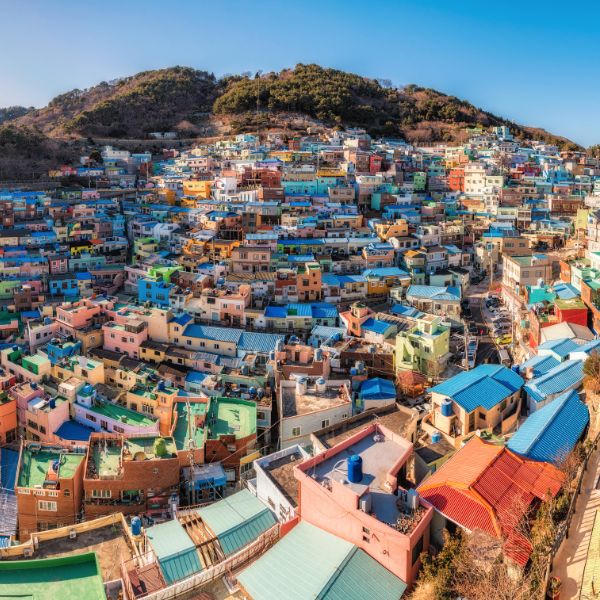
Busan: Big Coastal City
While Seoul is a showcase of all things Korean, Busan is unashamedly its own city and a celebration of coastal life and local culture. Busan is famous for fresh seafood, traditional markets, great beaches, big festivals, movies, temples, and places to explore the coast. Beaches are popular places to visit in Busan, along with cliff-side walkways with views over the ocean. Central Busan is a lively spot with lots of entertainment and markets to enjoy, including a famous fish market where you can choose your own lunch and then eat it. Busan is spread out and deserves several days to explore it properly.
What To See In Busan
Here are 10 great places to visit in Busan:
- Haeundae Beach & Beach Train
- Jagalchi Fish Market
- Gamcheon Culture Village
- Haedong Yonggungsa Temple
- Songdo Beach & Cable Car
- Huinnyeoul Culture Village
- BIFF Square & Centum City Mall
- Oryukdo Skywalk & Coastal Paths
- Lotte World Busan
- Busan X The Sky Observatory
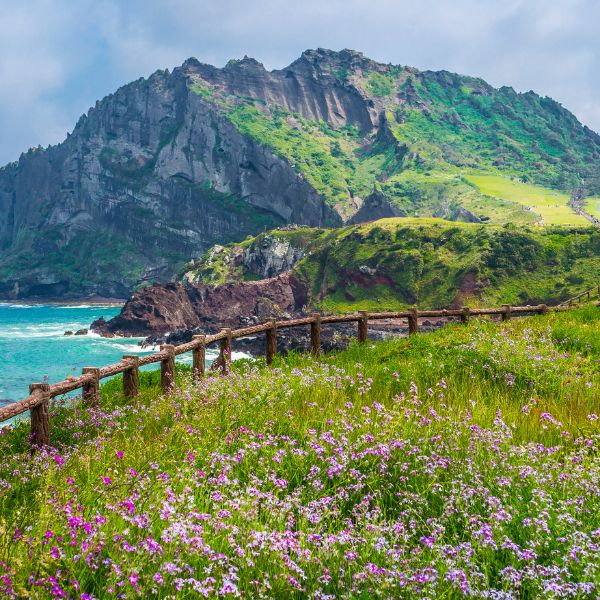
Jeju Island: Natural Wonder
Jeju Island is a gorgeous island created from a volcano rising out of the ocean 2 million years ago. Today it’s one of the New 7 Natural Wonders of Nature and deservedly so. The lush island is packed with pine trees, tangerines, rolling hills and fields, cacti, and jet black volcanic rock tumbled all around. You can relax on a beach, go horse riding, explore ancient lava tubes, scuba dive, climb to the volcano’s peak, chill in a beach-side cafe, explore traditional markets, learn about local culture, and lots more. The island has two main cities, but the attractions are spread out along the coast.
What to See On Jeju Island
Here are 10 great places to visit on Jeju Island:
- Hallasan Mountain (Volcano)
- Seongsan Ilchulbong Sunrise Peak
- Hyeopjae & Hamdeok Beaches
- Seogwipo Maeil Olle Market
- Jeju Folk Village
- Yakcheonsa Coastal Buddhist Temple
- Jungmun Beach & Jusangjeolli Cliff
- O’Sulloc Green Tea Museum
- Cheonjiyeon & Jeongbang Waterfalls
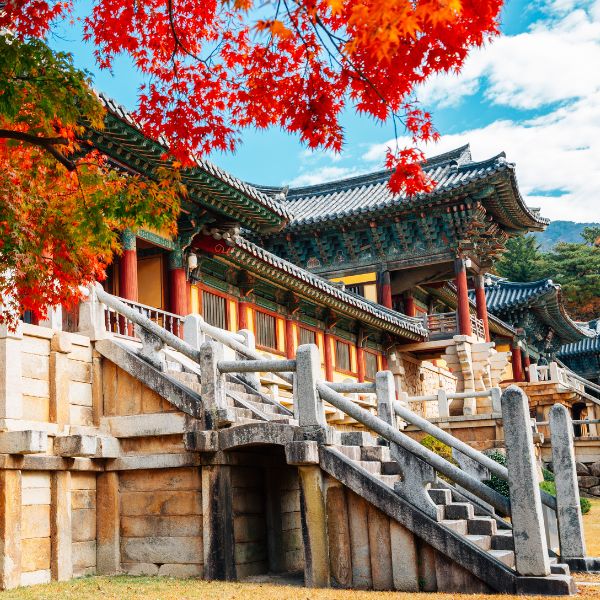
Gyeongju: Historic Capital
Gyeongju , the former capital of the Shilla Kingdom in ancient Korea, is a true treasure trove of UNESCO World Heritage sites, as well as local culture, history, and natural beauty. Described as an outdoor museum, you can see many of the big attractions in the Gyeongju Historic Area, including the 1,400 year Cheomseongdae Observatory . There’s so much to see in Gyeongju outside this area though, including the impressive Bulguksa Temple, one of the best Buddhist temples in Korea. There’s also the Bomun Lake Tourist District, a dreamy sight during cherry blossom season.
What To See In Gyeongju
Here are 10 great places to visit in Gyeongju:
- Bulguksa Temple & Seokguram Shrine
- Cheomseongdae Observatory
- Donggung Palace & Wolji Pond
- Yangdong Folk Village
- Hwangnidangil Hanok Street
- Daereungwon Tomb Complex
- Bomun Lake Tourist Complex
- Woljeonggyo Bridge
- Gyeongju National Museum
- Gyochon Traditional Hanok Village
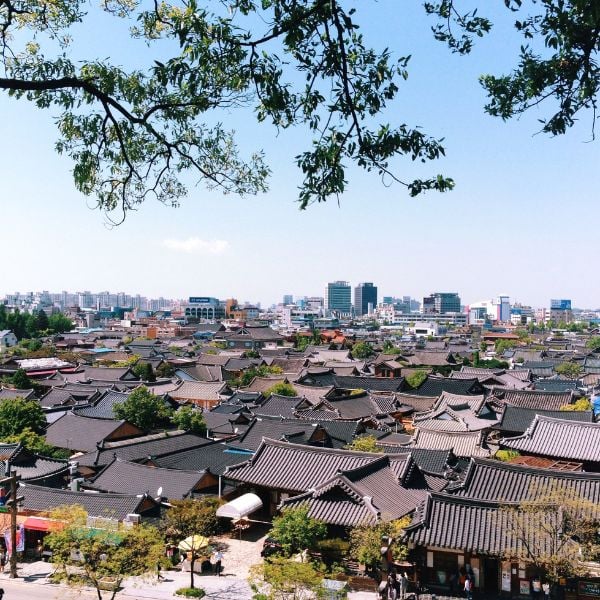
Jeonju: Traditional Views & Food
Jeonju is the perfect destination for a day trip from Seoul and has most of its main attractions in one area of the city. What can you see in Jeonju? The main attraction is the gigantic Jeonju Hanok Village , featuring more than 700 traditional hanok houses. You can dress up in Korean hanbok, dine on Jeonju’s famous bibimbap in an old restaurant, and see how life in Korea used to be. There are plenty of other sights nearby, including a traditional market, pretty river, and the rather unusual Jaman Mural Village.
What To See In Jeonju
Here are 5 great places to visit in Jeonju:
- Jeonju Hanok Village
- Jeongdong Catholic Church
- Gyeonggijeon Shrine
- Nambu Traditional Market
- Jaman Mural Village

Suwon: Fortress City
Suwon is another city close to Seoul that you can visit in a day and see many interesting and unique sights. The main draw of Suwon is the Hwaseong Fortress and the fortress walls, which are still intact and run for 6km around the city. Inside this fortress you’ll find lots of museums, historic buildings, parks, and activities, such as archery. There are often cultural festivals in this area, too. Surprisingly, Suwon is the best place to get KFC (Korean Fried Chicken). There’s a whole street dedicated to making it.
What to See In Suwon
Here are 5 great places to visit in Suwon:
- Hwaseong Fortress & Fortress Walls
- Hwaseong Haenggung & Haengridan Gil
- Fried Chicken Street
- Korean Folk Village
- Gwanggyo Lake Park
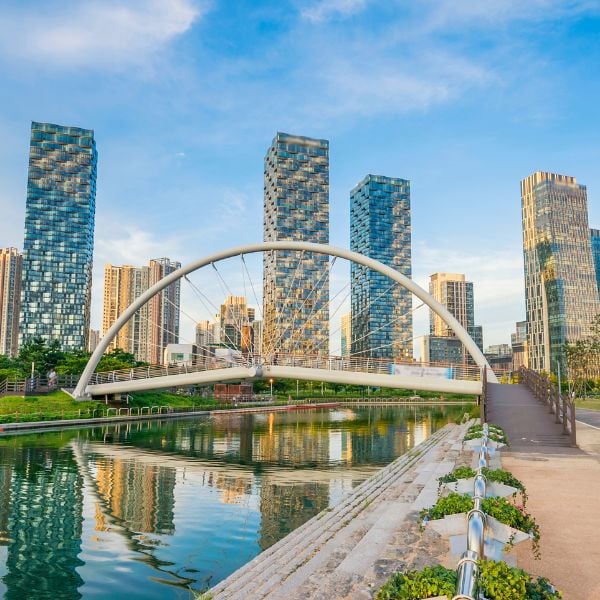
Incheon: Modern City With Islands
Incheon is one of Korea’s largest cities, but is sadly ignored as it’s right next to Seoul and most people think it’s just there for the airport. That’s not true at all and there’s plenty to see and do in Incheon. Described as a futuristic city, Incheon is at the front of Korea’s push to become an ultra-modern country and nowhere shows that more than Songdo Central Park . The traditional side of Incheon is also worth exploring, including the Chinatown, which is home to Korea’s most popular student food – jajangmyeon . If you want to explore a lesser-seen side of Korea, check out the islands near Incheon to see ancient fortresses, temples, and charming sights.
What to See In Incheon
Here are 5 great places to visit in Incheon:
- Songdo Central Park
- Incheon Chinatown
- Wolmido Island
- Incheon Grand Park
- Ganghwa Jeondeungsa Temple
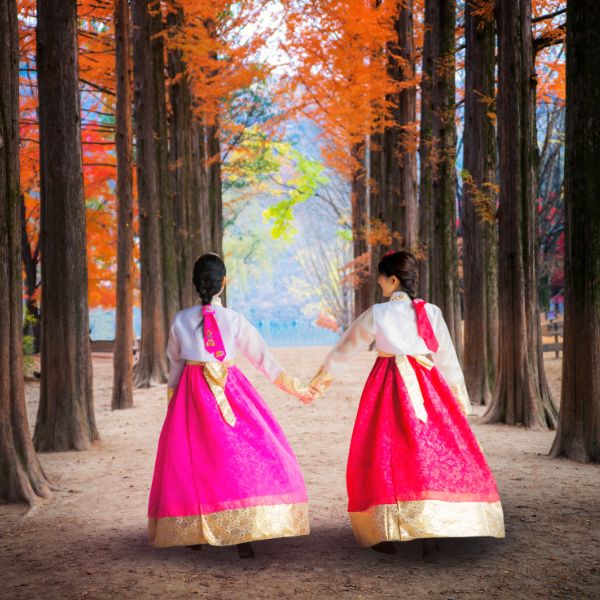
Gapyeong County: Tourists Treats
Gapyeong County is a rural part of Korea just outside Seoul that is one of the most popular day trip destinations for visitors and locals alike. Inside Gapyeong County is the lovely Garden of Morning Calm , a beautiful sculpted garden that showcases traditional Korean buildings set amongst thousands of different plants and trees. There’s also Nami Island , an ever-popular attraction that has long tree-lined streets to explore, woodland animals, bike paths, and even a zip line to the island. You can also visit Petite France, a recreation of a French village, Gapyeong Rail Bike Park, and Cheongpyeong Lake, and many other attractions in Gapyeong.
What To See In Gapyeong
Here are 5 great places to visit in Gapyeong:
- Nami Island
- Garden of Morning Calm
- Petite France
- Gapyeong Rail Bike Park
- Cheongpyeong Lake

North-East Coast: Amazing Beaches
The north-east coastal region of Korea, spreading between Sokcho and Gangneung , features some of Korea’s most popular summer seaside resorts and beaches. The wide, sandy beaches are perfect for water sports, working on your tan, and sitting at night listening to local musicians perform BTS covers and their own tunes. Sokcho deserves at least two days to explore, more if you plan to visit nearby Seoraksan National Park , one of Korea’s best places to see autumn foliage. Gangneung is where to see cherry blossoms in spring, sit and relax at a seaside cafe at Gangneung Coffee Street , and enjoy beach life.
What To See On The North-East
Here are 5 great places in north-east Korea:
- Sokcho Beach
- Gangneung Beach
- Seoraksan National Park
- Yangyang Surfyy Beach
- Gangneung Coffee Street
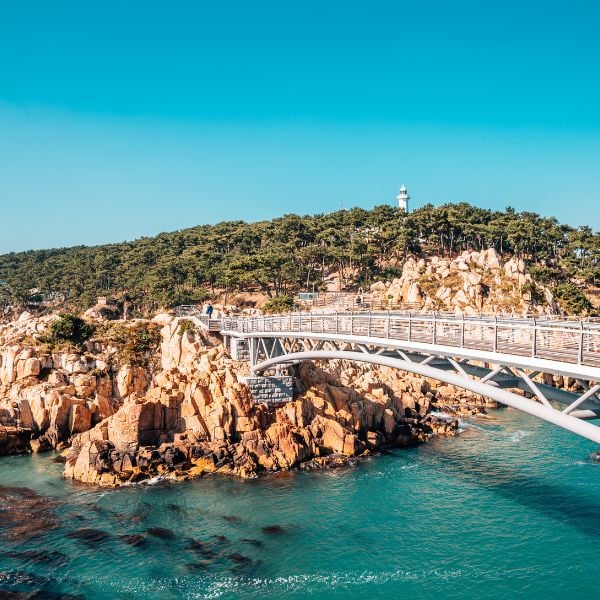
East Coast: Harbour Cities
Ulsan and Pohang are two industrial cities that don’t get enough attention, but are ideal for a weekend visit once you’ve explored other top sights. These coastal cities both have good beaches, coastal walks, and green spots, including a pretty bamboo forest in Ulsan. In Pohang, you can see the dizzying Space Walk , which looks out over the city and ocean. There’s also a former Japanese district with old buildings, and the famous Homigot Sunrise Square where you can watch the first sunrise of the year. Ulsan is famous for whaling and visitors should check out the charming Jangsaengpo Whale Museum and Daewangam Park.
What To See On The East Coast
Here are 5 great places on Korea’s East Coast:
- Yeongildae Beach & Space Walk
- Ilsan Beach & Daewangam Park
- Jangsaengpo Whale Museum
- Homigot Sunrise Square
- Taehwagang National Garden
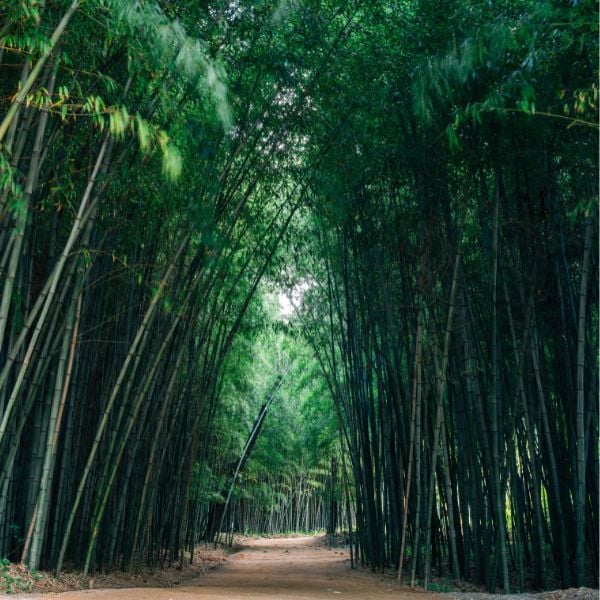
South-West: Iconic Rural Destinations
South-west Korea is a long way from most travellers’ typical route, but this area is worth visiting if you have time. Gwangju , one of Korea’s largest cities, is hidden away down here and surrounded by natural beauty, including the Juknokwon Bamboo Forest , Boseong Green Tea Fields, and Suncheon Bay Nature Reserve. If you plan to hire a car , these spots will show you a completely different side to Korea. Gwangju, too, which is a fun city and the birthplace of Korean democracy. Hidden in the far corner of Korea is Mokpo, a lovely coastal city that has a new cable car carrying you over the ocean.
What to See In The South-West
Here are 5 great places in south-west Korea:
- Damyang Juknokwon Bamboo Forest
- Boseong Green Tea Fields
- Gwangju Culture Park & Penguin Village
- Suncheon Bay Nature Reserve
- Mokpo Marine Cable Car

South Coast Islands: Summer Getaways
Best explored during the hot summer months and early autumn, the south coast islands in Korea, which span from Busan to Mokpo, are where Koreans spend their summer holidays. The most popular destinations here are Geoje, Tongyeong, Yeosu, Namhae, and Goheung and each offers winding coastal paths, beaches, natural beauty, and fun summer activities. The best way to see these islands is with a rented car or by bike, riding around the coast visiting a few different beaches and attractions. Don’t expect too many cultural sights, instead you’ll find luges, gardens, water sports, and lots of fun.
What to See On The South Coast
Here are 5 great places on Korea’s South Coast:
- Dolsan Park & Cable Car
- Namhae Geumsan Boriam Hermitage
- Hallyeohaesang National Park
- Oedo-Botania Botanical Garden
- Skyline Luge Tongyeong
As you can see, there are many great places to visit in Korea. Korea is truly a country of undiscovered wonders that people aren’t aware of. Seoul is an incredible place to visit, but there’s so much more to see. That’s why I try to include lesser-known places in this South Korea travel guide.
The list above covers a lot of the most popular or tour-worthy destinations in Korea, but there are still more places I could recommend, such as Andong (home to the mask dance festival), Gunsan (port town with a retro vibe), Daegu (big city with historic sights), Daejeon , and many more.
Besides cities and towns in Korea, there are also 18 national parks to explore, thousands of mountains, Buddhist temples, beaches, bike routes, campsites, and so much more. I’ll include a few of each of these in the next few sections of this South Korea travel guide.
Best Day Tours From Seoul In 2024
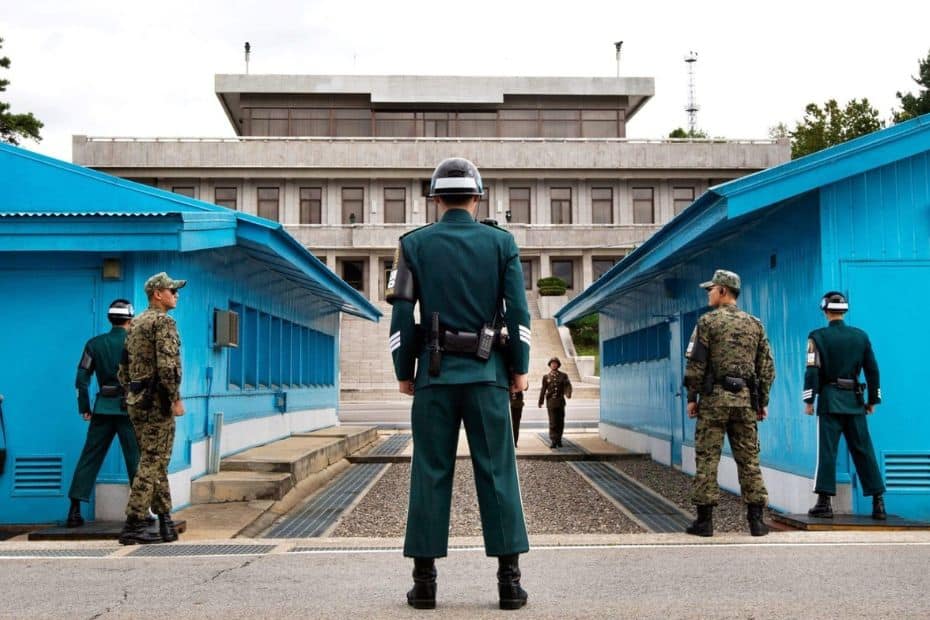
Taking a day tour while you’re staying in Seoul is a great way to see more of Korea’s top attractions without the hassle of moving hotels to somewhere new. The 10 day tours from Seoul below can all be done in a day or less and can even be combined with other activities in the same day.
I don’t want to include every day tour available in this South Korea travel guide as there isn’t enough room to talk about them all. If you want to find more day tours, I recommend looking at the options available through tour providers such as Klook , Viator , and Get Your Guide .
Please note : There are many day tours from Seoul and they come with various prices. I recommend avoiding the very cheapest as these will often waste your time by taking you to some overpriced gift shop area and pressuring you to buy souvenirs or rushing you through too many attractions.
Here are 10 great day tours from Seoul:
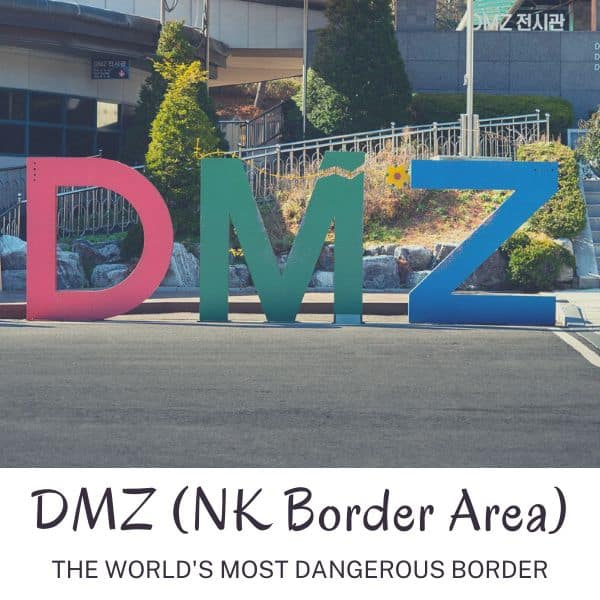
Why Visit The DMZ
The DMZ, the demilitarised zone between North & South Korea is a truly unique place to visit when you’re in Korea. There are several different locations to see in this area, each reflecting the bitter struggle between the two Korea’s in the ongoing Korean War. Some of the highlights are the 3rd Tunnel, Dora Observatory, Dorasan Station, Gamaksan Suspension Bridge, and the Imjingak Park. There’s also the Panmunjom Truce Village where you can walk into North Korea, but this is currently closed. Tours are required to travel to certain parts of the DMZ.
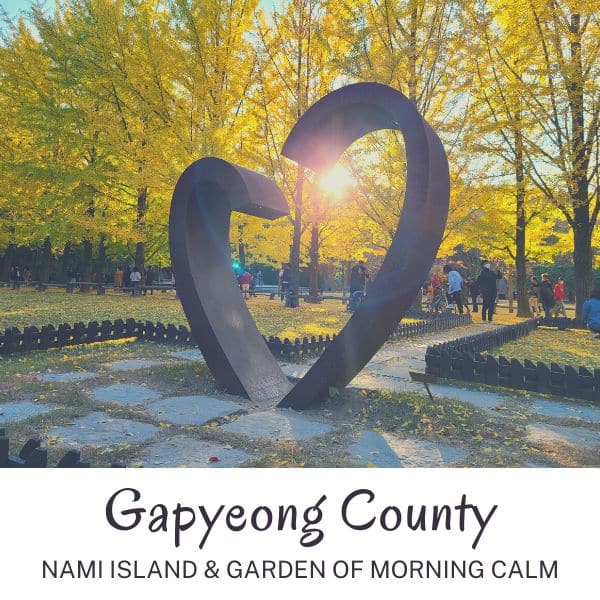
Why Visit Gapyeong County
Gapyeong County is home to Nami Island, the Garden of Morning Calm, Petite France, Gapyeong Rail Bike Park, and several other fun attractions. Nami Island and the Garden of Morning Calm are the most popular and can both be visited in a day. You can witness beautiful scenes at these destinations, especially during cherry blossom season (April) and autumn foliage season (October). Tours from Seoul to Gapyeong County are convenient and can take you to multiple places in one day without the hassle of buses and finding your own way.

Why Visit Hwaseong Fortress
Hwaseong Fortress and its fortress walls offer a unique chance to see what life was like in Korea 200 years ago. Not only can you walk the full length of the walls around the city, you can also try archery and other traditional activities in the fortress grounds. There are many museums, fortress buildings, and exhibitions showing how people lived in this period. You can also enjoy the beautiful ponds and streams that run through the palace with traditional Korean restaurants and cafes looking out over these areas.
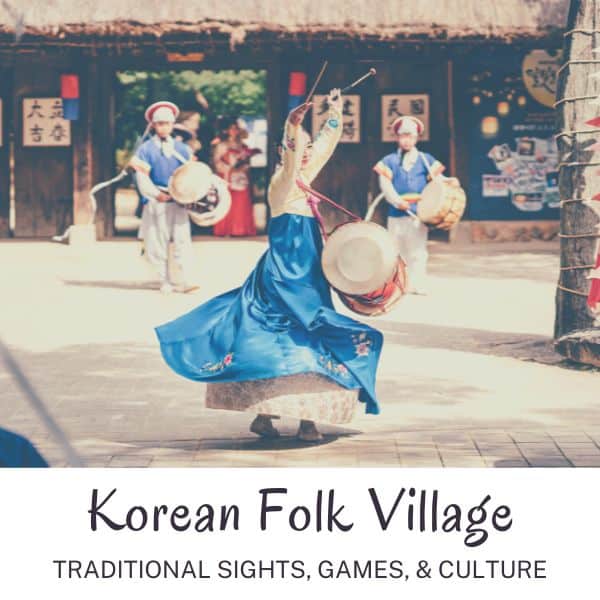
Why Visit Korean Folk Village
Discover traditional Korean life at the Korean Folk Village in Yongin during a day trip from Seoul. Walk through dozens of recreated farm buildings, government offices, academies, shops, smiths, schools, and other traditional buildings from Korea’s past to get a feel for how people lived at this time. Actors dressed in traditional Joseon-era costumes bring the scenes to life. You can try fun activities, such as mask carving, horse riding, and archery. Witness exciting festivals and cultural performances, too.
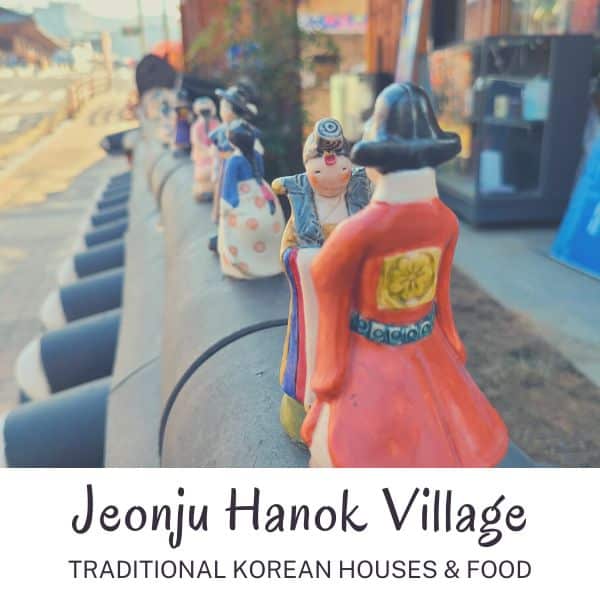
Why Visit Jeonju Hanok Village
A day trip to the Jeonju Hanok Village in Jeonju is a great way to experience various traditional Korean cultural activities in a beautiful setting. This sprawling hanok village has over 700 traditional buildings for you to explore, dine in, or even stay in. Make sure you rent hanbok in Jeonju so you look like Korean royalty and make memorable photos during your trip. Whilst you’re in Jeonju Hanok Village, you can try local delights such as Jeonju bibimbap and PNB chocopies. Also check out the traditional Nambu Market and Jeongdong Catholic Church.

Why Visit Alpaca World
When you travel to Korea, you may not think about seeing alpacas, which are from an entirely different continent. But Korea’s love of all things cute means that these furry friends have become very popular in Korea and have their own theme park a few hours from Seoul. There are dozens of cuddly alpacas to see, feed, and play with at Alpaca World , as well as hundreds of other cute critters such as ponies, rabbits, deer, goats, fennec foxes, and more. There are 17 separate areas to explore in Alpaca World and it’ll provide hours of fun for the whole family.
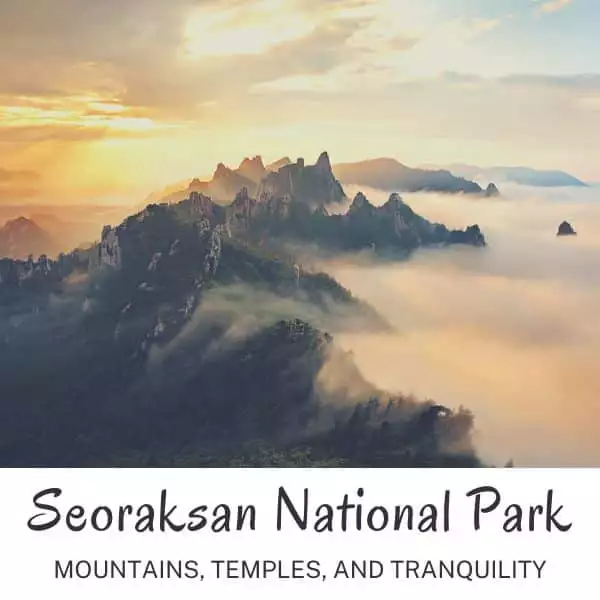
Why Visit Seoraksan
Seoraksan National Park on Korea’s east coast is a great day trip from Seoul for those who want to see mountain peaks, leafy valleys, stony rivers, and a gigantic Buddha. Even if you’re not a keen hiker, you can explore lots of the park’s valley pathways easily, or reach the top thanks to the convenient cable car. See the sights from the observatory and check out the small temple in the clouds. Make sure you try haemul pajeon (seafood pancake) and makgeolli (rice wine). It’s the traditional meal Koreans enjoy after hiking.

Why Visit Everland
Everland is Korea’s biggest theme park and is packed with attractions for everyone to enjoy. Thrill seekers will love the rollercoasters, such as T Express (the world’s 4th steepest rollercoaster) and many more exciting rides. Check out the Zootopia section to see wild animals and wild rides, or the Plantopia section for floral beauty, romantic walkways, and seasonal delights. There are plenty of attractions, cultural performances, entertainments, and seasonal events to keep you amused all day long.

Why Visit Danyang
A great way to see Korea’s countryside is with a day trip to Danyang to enjoy the rush of sailing over valleys and beside mountains while tandem paragliding. Feel the wind in your face and the sensation of riding the air currents as you pass over the many delightful views of Danyang. You can enjoy other activities in this area, such as the Mancheonha Skywalk , a clifftop lookout with incredible views, riding an alpine coaster, and zooming along a zip line. The perfect day tour from Seoul for thrill seekers.
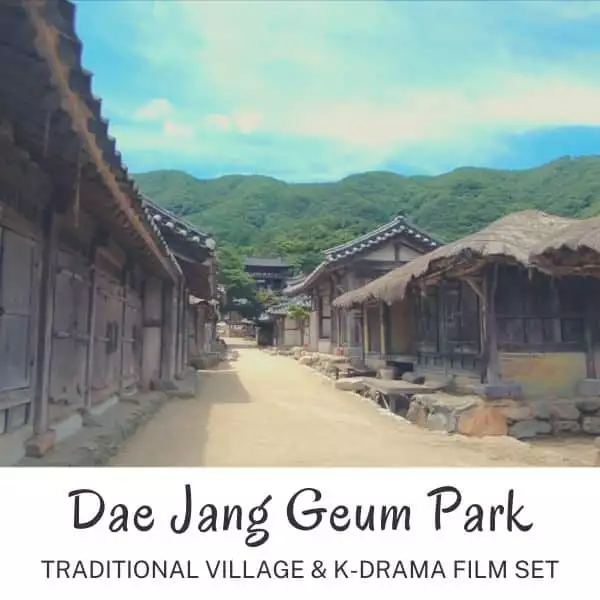
Why Visit Dae Jang Geum Park
Fans of Korean period dramas and movies will love a day trip to Dae Jang Geum Park in Yongin. This is the largest historical drama filming set in Korea and was used to film MBC productions such as ‘Wind in the Palace’ and ‘The Great Queen Seondeok’, as well as K-Pop videos including Daechwita by Suga from BTS. If you’re lucky, you may see filming going on here. But even if you don’t, it’s a fun place for those who want to learn more about Korea’s history and take some cool pictures in a real movie set.
I’ve linked to tours provided by reliable tour companies in Korea. If you would rather book a tour through a local guide, contact Jerry Heng or Andrew Chung Hanbyul . They’re freelance guides with years of experience offering tours in Korea and both offer amazing service.
These places are accessible by public transport, but may take much longer than a tour would do, wasting your precious time. Check out my guide for getting to Nami Island to help you navigate Gapyeong County. For other destinations, I would recommend a tour – it’s more practical.
Best Sights To See In Korea In 2024
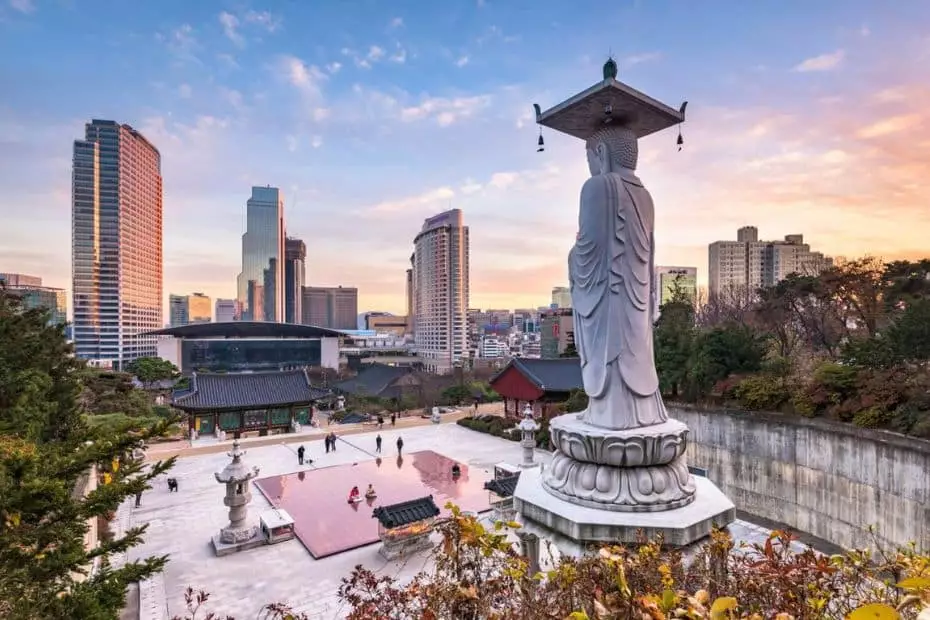
South Korea truly has something for everyone. There’s so much I want to include in this South Korea travel guide, which is why this section is full of different sights to see and explore. However, to keep things short and simple, I’ll just list them, not give full details about each one.
Whether you’re travelling to Korea to learn about Korean culture or history, to see Korea’s impressive landmarks, to enjoy family fun attractions, to hop from cafe to cafe, to immerse yourself in nature, or simply to eat and shop, then you’ll definitely find something for you in this section.
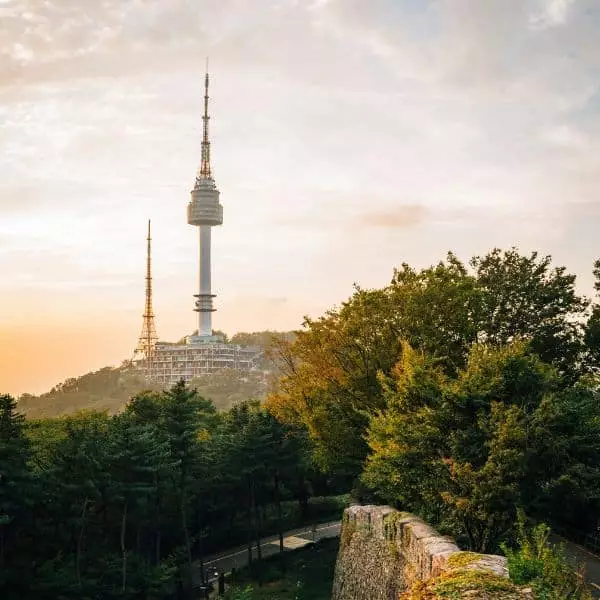
Famous Landmarks In Korea
Landmarks and iconic buildings are often top of a traveller’s bucket list for Korea as they provide great photo opportunities, showcase the best of the country, and offer fantastic views. Seoul has many top landmarks, but you can see plenty of other sights outside of the capital, too.
Here are 10 famous landmarks in Korea:
- Lotte World Tower (Seoul)
- N Seoul Tower (Seoul)
- Dongdaemun Design Plaza (Seoul)
- Cheonggyecheon Stream (Seoul)
- DMZ Area (near Seoul)
- Nami Island (Gapyeong County)
- Gamcheon Culture Village (Busan)
- Seongsan Ilchulbong (Jeju)
- Homigot Sunrise Square (Pohang)
- Banwol Purple Island (West Coast)
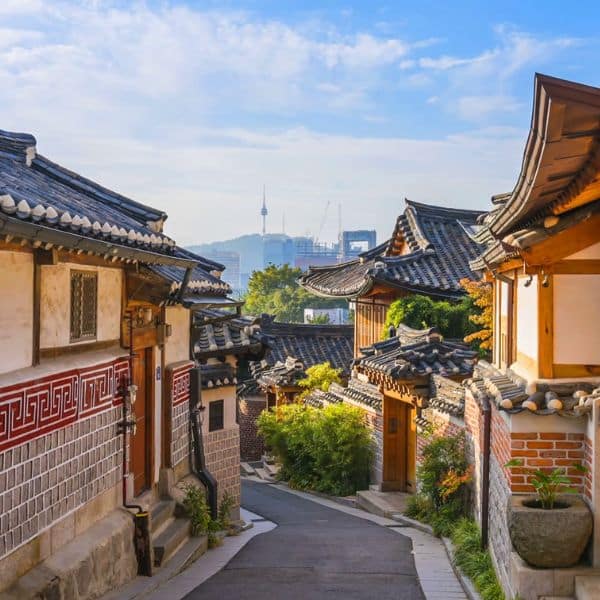
Historic Sights In Korea
Discover life in the Joseon period and before in Korea’s many captivating historic sights, including royal palaces, Buddhist temples, fortresses, and hanok villages. There are so many amazing historic sights to see in Korea, with each city having something to see.
Here are 10 historic sights in Korea:
- Bukchon Hanok Village (Seoul)
- Gyeongbokgung Palace (Seoul)
- The Secret Garden (Seoul)
- Seoul Fortress Walls (Seoul)
- Hwaseong Fortress (Suwon)
- Bulguksa Temple (Gyeongju)
- Gyeongju Historic Area (Gyeongju)
- Jeonju Hanok Village (Jeonju)
- Haedong Yonggungsa Temple (Busan)
- Andong Hahoe Village (Andong)
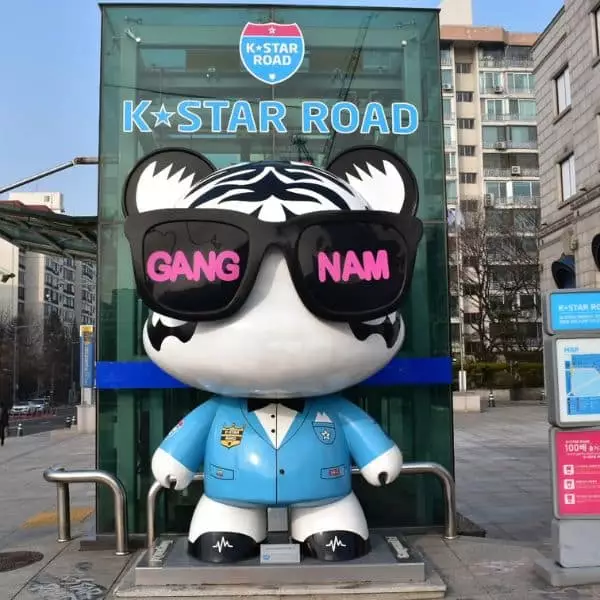
Korean Modern Cultural Sights
Fans of BTS, K-Dramas, Korean movies, and modern Korean culture in general have a lot to see and do in Korea. As well as famous filming locations across the country, these modern cultural sights will entertain, inform, and provide great destinations to visit.
Here are 10 modern cultural sights in Korea:
- Hallyu K Star Road (Seoul)
- K-Style Hub (Seoul)
- Hongik Uni. Station Area (Seoul)
- COEX Artium (Seoul)
- Asia Culture Centre (Gwangju)
- BIFF Square (Busan)
- Dae Jang Geum Park (Yongin)
- Sunshine Studio (Nonsan)
- Kim Gwang-Seok Street (Daegu)
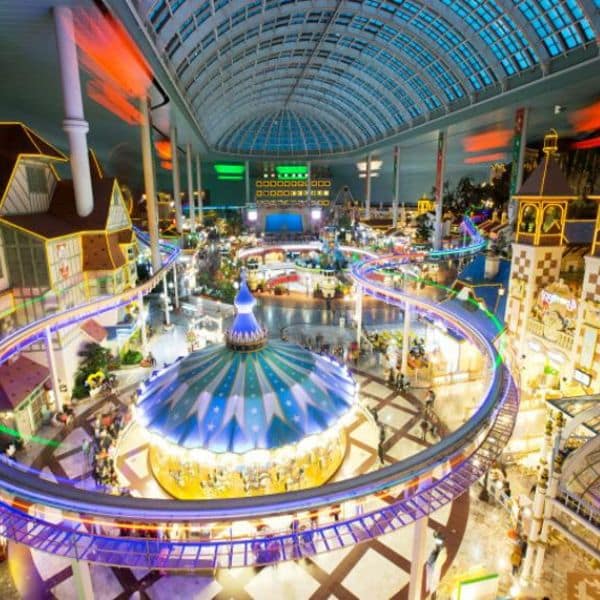
Family Fun Attractions In Korea
Families travelling to Korea have plenty of things to see and do and ways to enjoy spending time together. There’s no Disneyworld or Universal Studios in Korea, but there are plenty of great alternatives, as well as places for children to explore, learn, and discover.
Here are 10 family fun attractions in Korea:
- Lotte World Adventure (Seoul)
- Everland Theme Park (Yongin)
- Seoul Grand Park & Zoo (Seoul)
- Alive Museum & Dynamic Maze (Seoul)
- Seoul Children’s Museum (Seoul)
- Zoolung Zoolung (Seoul)
- Sea Life Busan Aquarium (Busan)
- Jeju Dinosaur Island (Jeju Island)
- Alpaca World (Gangwon Province)
- Skyline Luge & Lotte World (Busan)
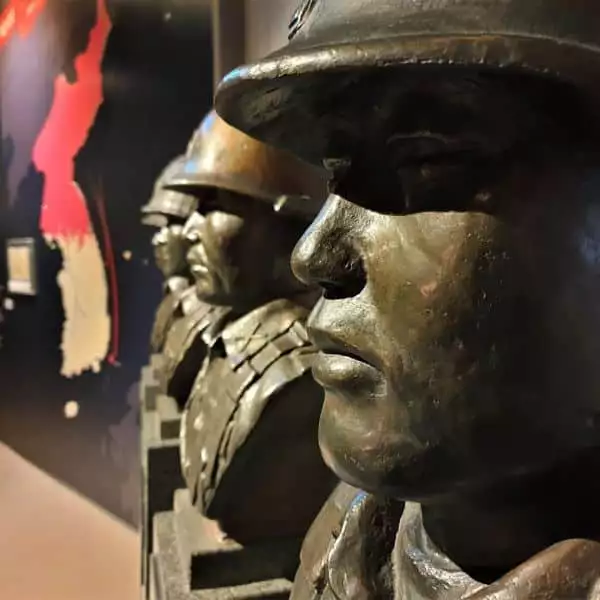
Korean Museums & Galleries
Travellers to Korea who want to learn about Korea’s history, culture, and art will love Korea’s impressive museums and galleries. These are great places to visit when the weather is bad and you might be surprised at how much there is to learn about Korea’s past.
Here are 10 museums & galleries in Korea:
- National Museum of Korea (Seoul)
- War Memorial of Korea (Seoul)
- Seoul Museum of Art (Seoul)
- Seoul Museum of History (Seoul)
- Seodaemun Prison Museum (Seoul)
- Museum Kimchikan (Seoul)
- National Folk Museum of Korea (Seoul)
- Gyeongju National Museum (Gyeongju)
- National Maritime Museum (Busan)
- Daegu Art Museum (Daegu)
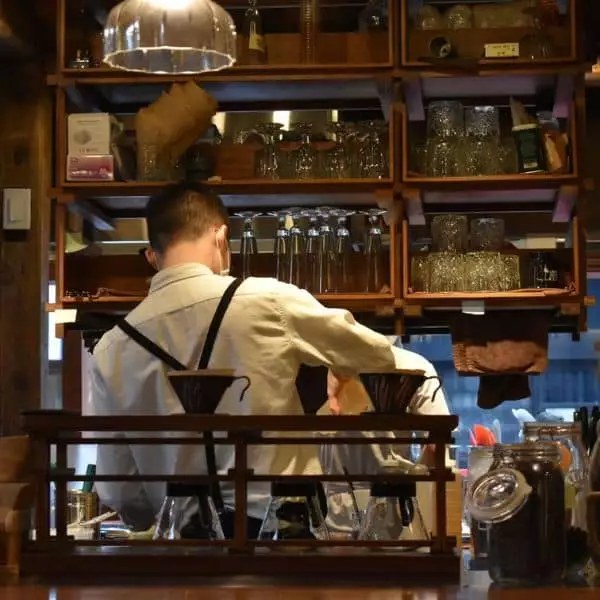
Cafe Areas In Korea
When you need a break from travelling in Korea, visit one of these cosy cafe areas and take time to relax and recharge. Although Korea was traditionally a tea drinking country, cafes are now everywhere and you’ll find photogenic cafes everywhere these days.
Here are 10 cafe areas to visit in Korea:
- Ikseondong Hanok Village (Seoul)
- Gyeongui Line Parks (Seoul)
- Samcheondong Cafe Street (Seoul)
- Sinsa-dong / Garosugil Road (Seoul)
- Jukjeon Cafe Street (Seoul)
- Jeonpo Cafe Street (Busan)
- Haeridangil (Busan)
- Hwangnidangil (Gyeongju)
- Hwaseong Haenggung Area (Suwon)
- Gangneung Coffee Street (Gangneung)
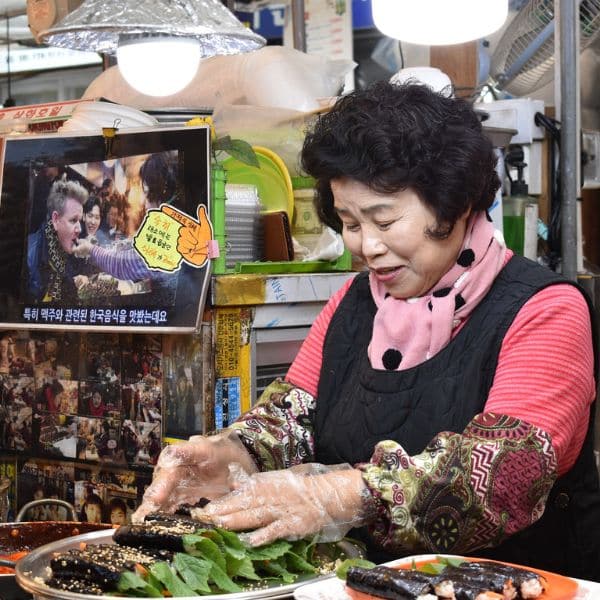
Korean Markets & Malls
If you want the best selection of street food, souvenirs, and bargain shopping options, be sure to visit Korea’s many traditional markets. It’s a cultural experience itself. Korea also has some of the world’s largest malls with a wide variety of Korean and international goods.
Here are 10 markets & malls in Korea:
- Gwangjang Market (Seoul)
- Dongaemun Market (Seoul)
- Hongdae Shopping Street (Seoul)
- Starfield COEX Mall (Seoul)
- Jagalchi Fish Market (Busan)
- Seomyeon Underground Mall (Busan)
- Centum City Mall (Busan)
- Seogwipo Maeil Olle Market (Jeju)
- Nambu Market (Jeonju)
- Paju Premium Outlets (Paju)
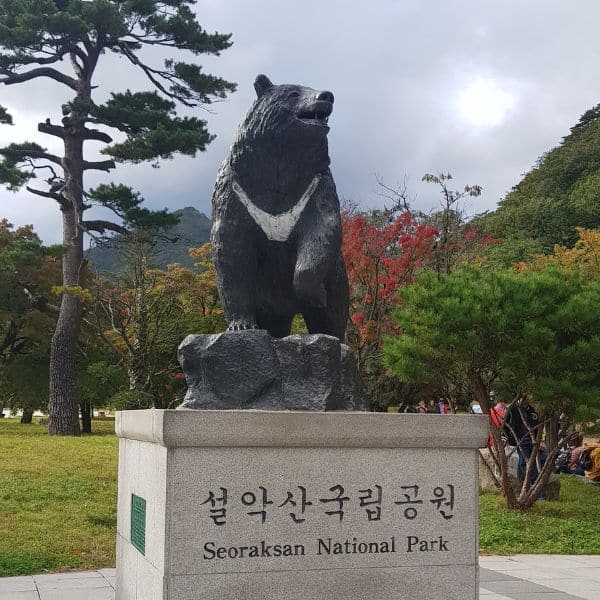
Korean Natural Wonders
Korea is a country covered in mountains, waterfalls, valleys, rice terraces, and beautiful natural sights. Make time to visit some of these natural wonders when you visit Korea and you’ll be amazed at the incredible views you can find. The national parks are truly breathtaking.
Here are 10 natural wonders to see in Korea:
- Hallasan Mountain (Jeju)
- Jirisan National Park (Southern Korea)
- Seoraksan National Park (Gyeonggi)
- Garden of Morning Calm (Gapyeong)
- Juknokwon Bamboo Forest (Damyang)
- Boseong Green Tea Fields (Boseong)
- Udo Island (Jeju Island)
- Seongsan Ilchulbong Sunrise Peak (Jeju)
- Hyeopjae Beach (Jeju)
- Suncheon Bay National Park (Suncheon)
These 100 ideas are just the tip of the iceberg for what you can enjoy when travelling to Korea. There’s so much more to discover and I recommend you add some time to your travel plans to explore without a plan. Sometimes the best travel memories come from unexpected discoveries.
Best Activities To Try In Korea In 2024
Often the most memorable moments when travelling come from the experiences we have, not just the places we visit. Visiting a palace is interesting, but visiting a palace while dressed in traditional Korean hanbok , pretending you’re Joseon-era royalty with your friends or family is much more fun.
This section of the South Korea travel guide offers 10 fun activities you can try when you visit Korea. These will give you a good introduction to Korean culture, food, history, and nature. If you want more ideas, check out my list of 50 unique Korean experiences you can only do in Korea.
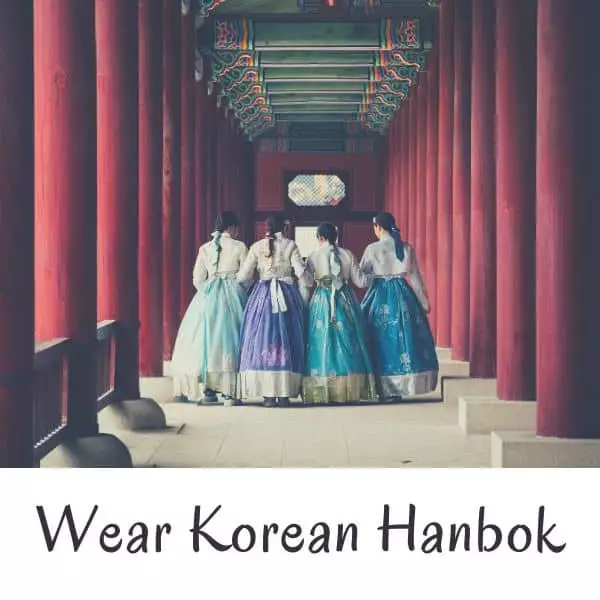
One of the top experiences to try in Korea has to be wearing Korean hanbok. It is available for all members of the family (even pets) and you can rent hanbok near most palaces or hanok villages. The hanbok easily fit over your regular clothes and come in a variety of colourful or traditional designs. You can get hair styling, accessories, and even have a hanbok photoshoot . Rentals can be as short as one hour or up to a full day.

Travellers to Korea can’t say they’ve truly tried Korean cuisine until they’ve eaten Korean street food from a market stall or street vendor. There are many types of Korean street food to sample in Korea, such as savoury snacks like tteokbokki and eomuk , to sweet treats like hotteok and bungeo-ppang . Korean street food is cheap and delicious. It’s usually not that healthy, but always leaves you feeling great. Give it a try.
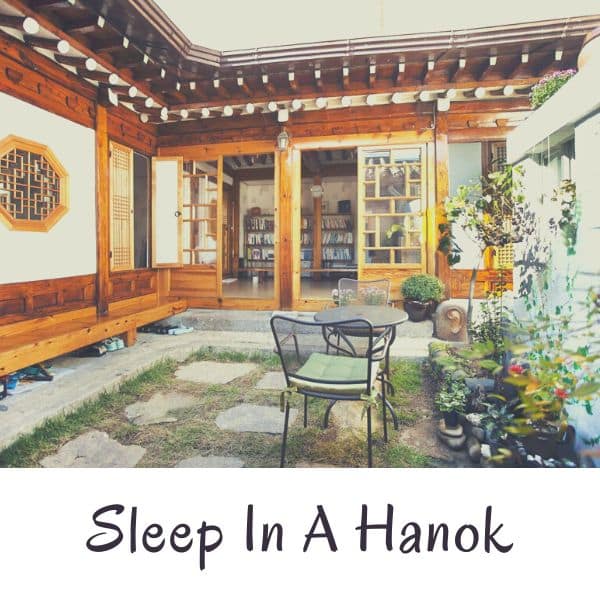
Experience life as a Korean would have in the Joseon-era with a night in a traditional hanok house. A hanok stay is very different from sleeping in a hotel and allows you to try a night on a futon (with underground heating keeping you warm in winter). Slide the doors aside in the morning and walk out onto the wooden decking to enjoy traditional Korean tea at a low table and the sight of the ornately decorated garden. Don’t forget to take your shoes off before you enter.
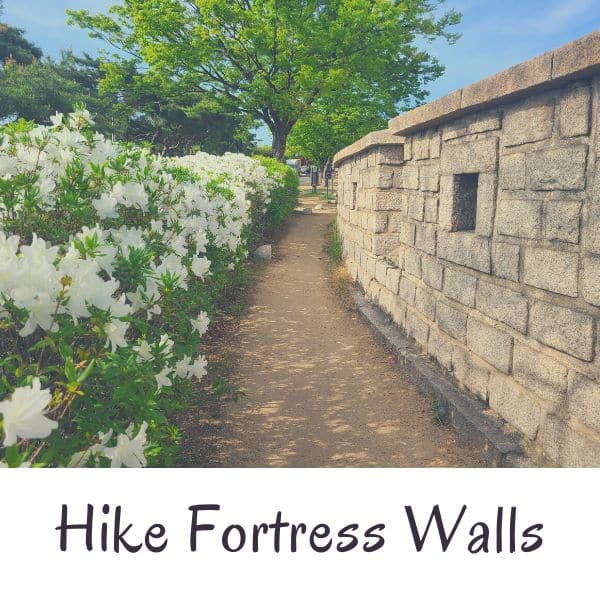
Seoul and other cities in Korea still have fortress walls you can walk or hike along that will offer incredible views of cities and mountains. As you walk along the fortress walls, you begin to imagine what life would have been like as a soldier keeping the city safe from invaders. Nowadays, you can enjoy exercise and sightseeing at the same time. Seoul’s fortress walls are a good place to start, but you can find fortress walls in many other places.
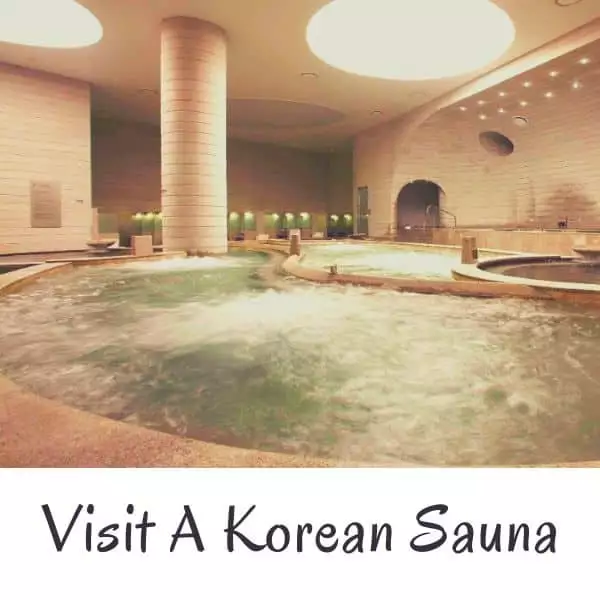
Visiting a Korean sauna might be a bit shocking for first-time travellers to Korea, but it’s a great way to relax and is especially good in winter. When you enter a Korean sauna, you should take off all your clothes, have a shower, and then enter one of the hot baths. Being naked in front of others can be scary for some, but you soon overcome that fear. Korean saunas sometimes have a communal resting area called a jjimjjilbang . These areas require pyjamas and offer snacks, drinks, and places to rest.
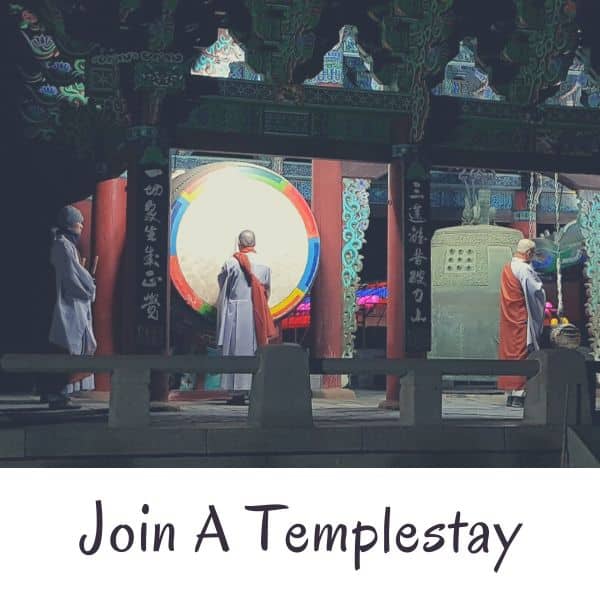
The Cultural Corps of Korean Buddhism have set up a templestay program at dozens of temples across Korea where you spend a day or two at the temple and join in various activities. This is truly a unique experience that you should try in Korea as you get to see customs performed by the monks that aren’t normally shown to the public. You also get to stay overnight at the temple and experience a hanok stay at the same time. Guests can also eat healthy vegan temple food, learn a lot, and chat with the monks.

A noraebang is the Korean version of a karaoke room, but is more popular in Korea and is commonly visited by locals and tourists alike. This is a great place to visit in the evening after a big Korean bbq meal and a few drinks. Everyone can relax and belt out their favourite Korean or international tunes together (or alone), shake some tambourines in support, or just watch and enjoy the atmosphere with some drinks. You can find these in every town and city in Korea and they provide a cheap night of fun and drinks.
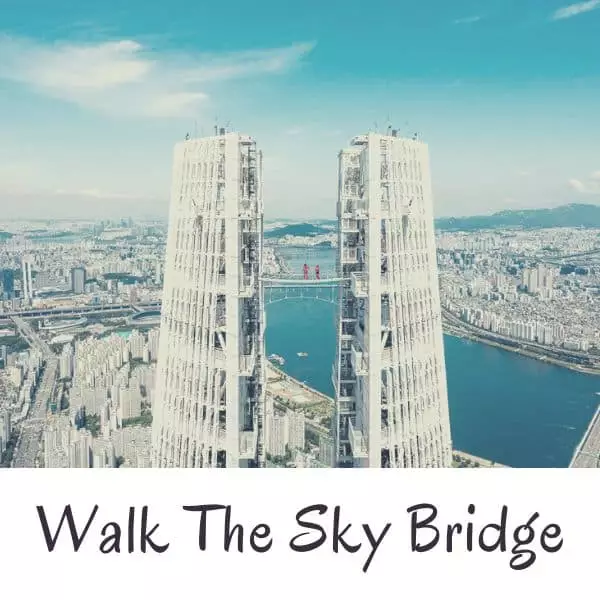
Open since 2020, the Sky Bridge at Lotte World Tower offers unbeatable views of Seoul and a nerve-racking trip above the city. Walk between the two towers at the top of the Lotte World Tower and peer down the 541 metre drop to the city streets below. It’s actually very safe and you’re strapped into a harness as you walk from one side to the other, but this definitely isn’t for the faint-hearted. If you’re not sure you can handle the height, check out the Seoul Sky Observatory on the 117th floor instead.

Koreans love to drink coffee and also love cute, unusual things, which is probably why theme cafes have become so popular in Korea. Besides the many cat cafes, there are theme cafes where you can stroke sheep, pet dogs, and see other animals. There’s more to Korea’s theme cafes than just drinking coffee with animals, you can also try drinking from a toilet at the Poop Cafe , paint pictures, build lego, go camping, practice being a wizard, and more. Hongdae in Seoul is the best place to find theme cafes.
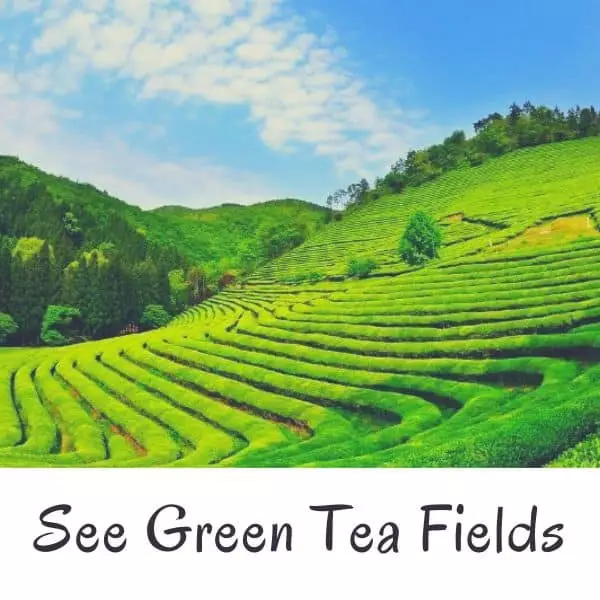
Although cafes are replacing Korean tea houses, Korea still grows and drinks lots of tea, especially green tea. You can visit these tea fields in areas such as Boseong and on Jeju Island, both of which have visitor centres and attractions to teach you about the wonderful world of Korean tea. The Daehan Dawon Tea Plantation in Boseong has lush green fields all year round and has been used as a filming location for several Korean shows. The O’sulloc Tea Museum on Jeju Island also has lovely views.
I recommend trying at least a few of these unique activities, they’ll really make your trip to Korea more memorable and offer insights into Korean culture and life. My advice is to be brave when visiting Korea and try new things, even if they seem a bit unusual at first. The same applies to Korean foods.
Best Korean Festivals To Join In 2024
There are dozens of festivals held in Korea each year celebrating the seasons, local products, traditions, culture, and often just for the sake of having fun. Visiting a festival in Korea will offer you a glimpse of how locals celebrate life, culture, and nature and let you join in the fun.
Whenever you visit Korea, there’ll be festivals going on. However, the biggest festivals occur in spring or autumn. As mentioned previously in this South Korea travel guide, these are the best seasons to visit Korea as the weather is pleasant and people are celebrating the end of summer or winter.
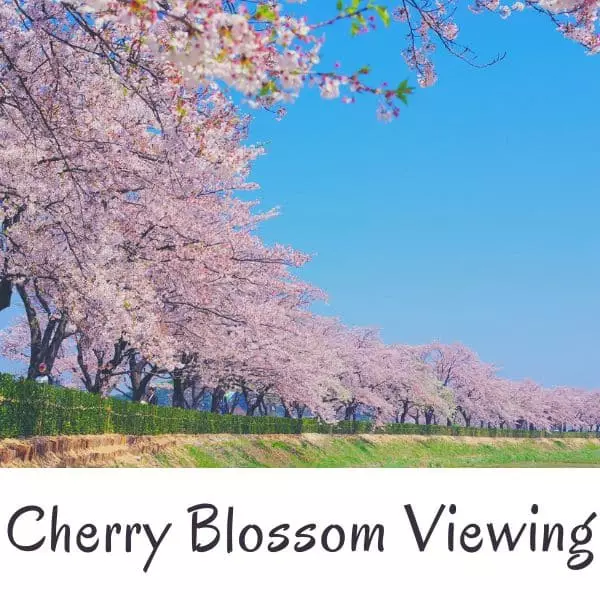
Cherry Blossom Festivals
The cherry blossom festivals in Korea occur in late March and early April and are some of the biggest festivals in Korea. People flock to forests, lakes, and rivers to see the pretty blossoms. The Jinhae Cherry Blossom Festival has over 2 million visitors each year, and even more people visit Seokchon Lake and Yeouido Hangang Park in Seoul. There are many festivals and tours to see cherry blossoms in Korea so you should be able to find a quiet place to enjoy the view.
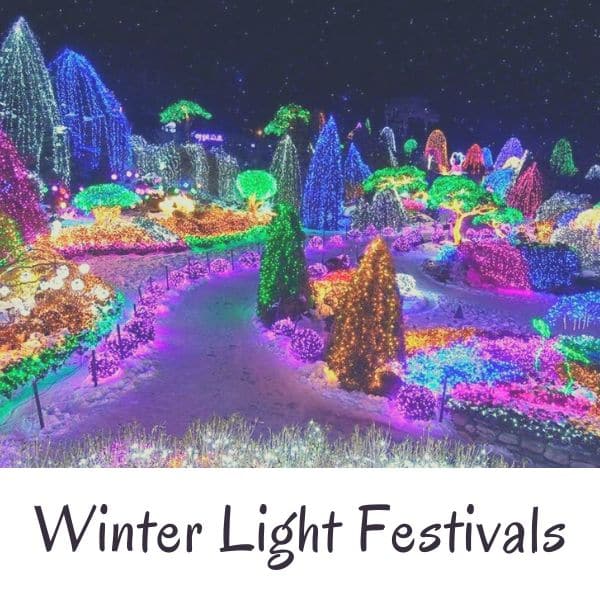
Winter Light Festivals
During the cold, dark days of winter, attractions such as Nami Island, the Garden of Morning Calm, and Herb Island transform into sparkling winter wonderlands with millions of bright lights illuminating them. There are also winter illumination festivals in Korean cities, such as the Haeundae Lighting Festival in Busan, Cheonggyecheon Stream Winter Lights in Seoul, and the Busan Christmas Tree Cultural Festival. When it snows in Korea, these festivals look even more magical.
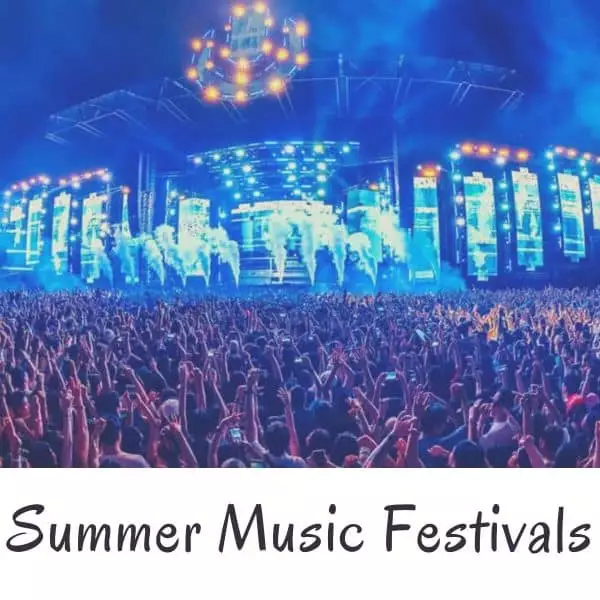
Summer Music Festivals
Summer in Korea is hot, but that doesn’t stop people enjoying day-long music festivals across the country. From chilled jazz festivals like the Seoul Jazz Festival , to action-packed concerts like Psy’s Summer Swag , there are music festivals to suit everyone. This is a popular summer activity in Korea , so be sure to book in advance for ticketed events. If you can’t get tickets, just go to a popular beach in the evening and you’ll usually find musicians performing.
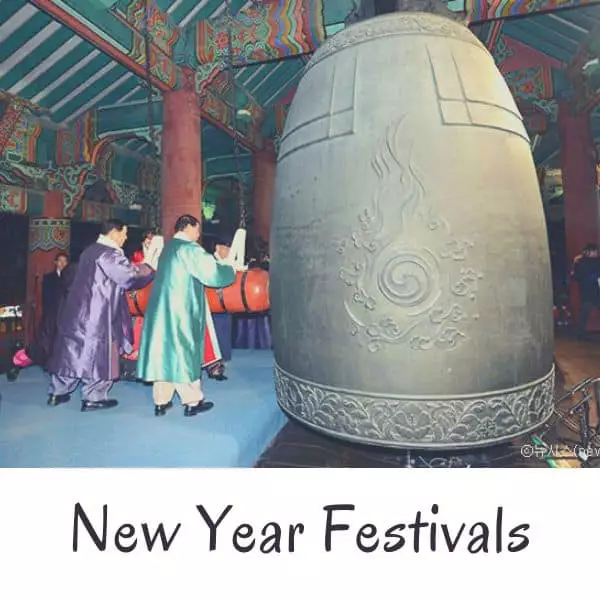
New Year Festivals
There are various festivals in Korea to celebrate the solar new year. New Year’s Eve festivals involve a bell-ringing ceremony where a giant bell is rung at midnight to welcome in the new year. Fireworks festivals are common events in cities across Korea, starting at midnight, too. Koreans celebrate the start of the new year by visiting the East Coast to see the first sunrise of the year at places like Homigot Sunrise Square or Seongsan Ilchulbong on Jeju Island.
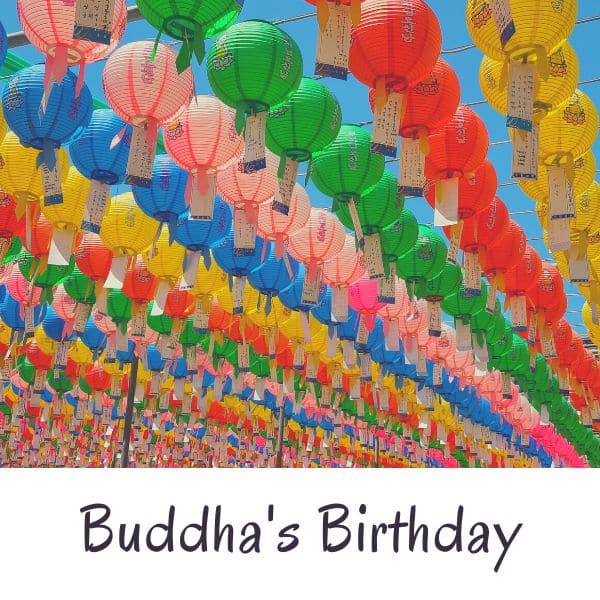
Buddha’s Birthday Festivals
Buddha’s Birthday is like Christmas for the Buddhist world, but celebrated very differently. It also falls on changing dates each year as it follows the lunar calendar, just like Korean New Year. Korean Buddhist temples across Korea will celebrate by putting up colourful lanterns and decorations for at least a month before the actual date. The biggest festival celebrating Buddha’s Birthday is the Yeon Deung Hoe Lantern Festival , which features thousands of lanterns and a lantern parade through central Seoul.
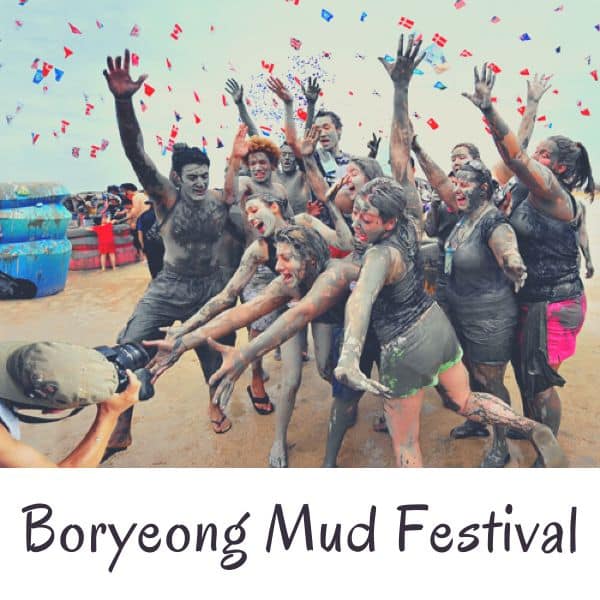
Boryeong Mud Festival
The Boryeong Mud Festival is one of Korea’s largest festivals and attracts visitors from around the world. Running for 2 weeks during rainy season, this is the best way to see a Korean festival even when the weather is bad. There’s a lot to see and do at this festival, including getting dirty in the mud with mud sports, mud wrestling, mud tug-of-war, and other mud-filled events. Boryeong is famous for the high-quality mud found in nearby waters and, by joining this festival, you’re getting a free mud facial.
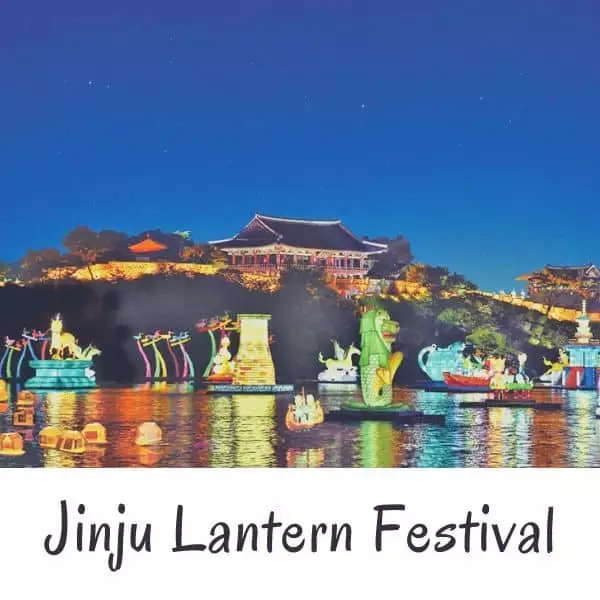
Jinju Lantern Festival
The visually stunning Jinju Lantern Festival is held in October each year in Jinju City and runs for several weeks. During the day, watch cultural performances and enjoy exploring the central fortress grounds of Jinju. Once it gets dark, see the city transform as thousands of lanterns, some as big as trees, come to life. There are so many weird and wonderful lanterns to discover at this festival. You can also set your own lanterns to float down the river with your wish inside.
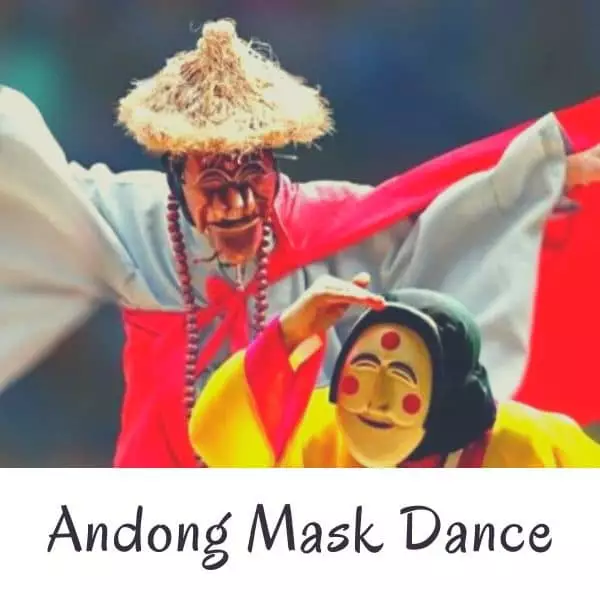
Andong Mask Dance Festival
The Andong Mask Dance Festival in Andong, home of the Andong Hahoe Village, is a great opportunity to witness traditional Korean dance and music performances. Not only can you see traditional Korean performances during this 4 day festival, there are also international performers displaying their own culture’s dancing. Get hands-on with traditional Korean culture at this festival. Explore Andong and learn about its contributions to Korea’s cultural development.
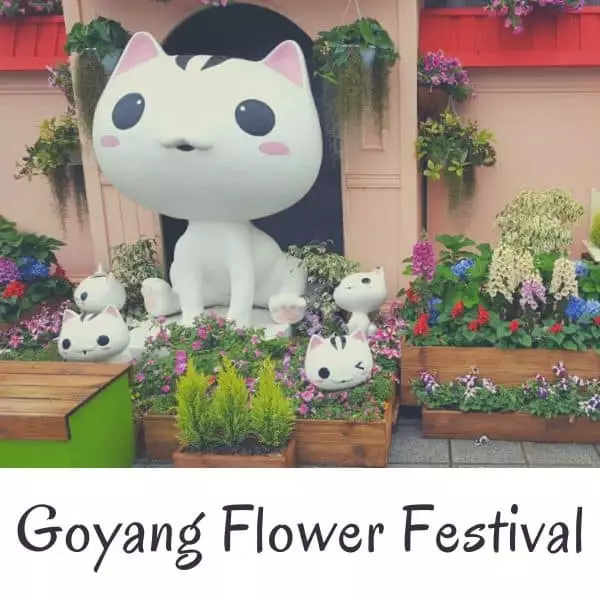
Goyang Flower Festival
The Goyang International Flower Festival runs twice per year, once in spring and once in autumn. It’s a beautiful celebration of floral beauty mixed with Korean cuteness and creativity. At this flower festival you can stroll through a maze of different displays, with each section focusing on certain flowers and plants. There are indoor displays with vividly coloured roses, nature-based outdoor photo zones, and the lovely Ilsan Lake Park in the background.
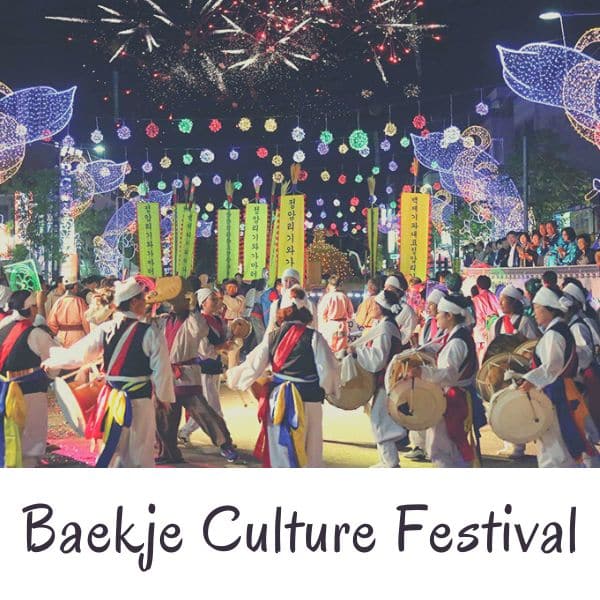
Baekje Culture Festival
The Baekje Culture Festival probably isn’t one that first-time travellers to Korea would know about. Held in Gongju and Buyeo, the two former capitals of the ancient Baekje Kingdom, this 10-day long festival held around Chuseok (Korean mid-autumn harvest festival), is packed with unique events and sights and is set in historic locations in each city. There’s local food to try, musical & cultural performances, fun photo zones, lantern displays, and much more.
Knowing when you plan to visit Korea will help you research what festivals are on and what the weather will be like. There are certainly a lot more than just the ones mentioned above, including some others mentioned previously in the seasons part of this South Korea travel guide.
I recommend using a tour company to see out of the way festivals like the Jinju Lantern Festival and the Jinhae Cherry Blossom Festival. These are often far from typical tourist destinations and can take hours to get to by public transport. Tours are worth the cost to save you time and avoid hassle.
Recommended Itinerary For Korea In 2024
In this section of this South Korea travel guide is my recommended first-timer itinerary for South Korea. This introduces you to two of Korea’s biggest cities, as well as a couple of day trips to highly rated destinations in Korea. There’s a mix of history, culture, nature, sights, and experiences.
This itinerary starts in Seoul as that’s where most people arrive to Korea after flying into Incheon Airport. If you arrive in Busan, you can change the route to start and end there instead. For travellers to Korea with only 2 or 3 days, I recommend using the first few days of this itinerary instead.
The itinerary lasts for one week, which isn’t enough time to see all of Korea, but enough time to get a feel for the country. If you have more time, use this itinerary and add in or replace extra destinations as you like. Jeju Island is certainly worth visiting if you have an extra 2 or 3 days.
Classic Sights Of Korea Itinerary
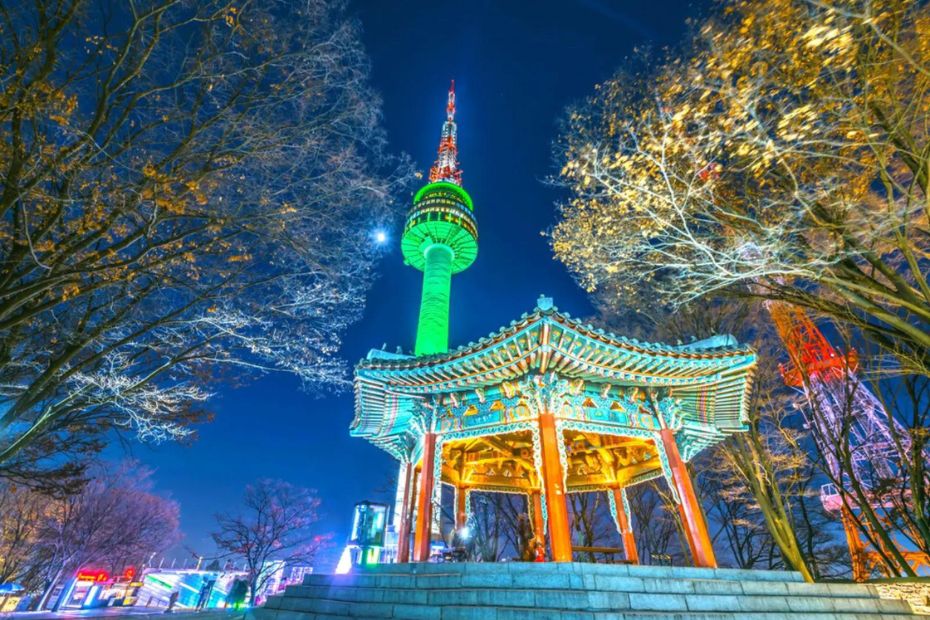
This itinerary covers a few must-see sights in Korea, including the two largest cities, the history city of Gyeongju, and some popular day trip destinations from Seoul.
Day 1 : Arrive in Seoul and explore Gyeongbokgung Palace, Bukchon Hanok Village, Insadong Art Street, Jogyesa Temple, and Cheonggyecheon Stream. Get dinner at the Jonggak Avenue of Youth for authentic Korean food that’s better than the touristy places in Myeongdong.
Day 2 : Learn about Korean history at the War Memorial of Korea or National Museum of Korea, explore Seoul’s traditional Gwangjang market in Dongdaemun, take the cable car to the N Seoul Tower for sunset & night views, then head down to Itaewon or Myeongdong for dinner & drinks.
Day 3 : Take a day trip to Gapyeong and visit Nami Island, the Garden of Morning Calm, and the Gapyeong Rail Bike Park. Return to Seoul for dinner and rooftop drinks in Myeongdong and then walk along the fortress walls from Dongdaemun Station if the weather is good.
Day 4 : Take the KTX to Busan, drop your bags, and take the subway to Nampo-dong for Jagalchi Fish Market, Bosu-dong Book Alley, and traditional sights. Take a taxi to Huinnyeoul Culture Village. End the day in Haeundae for evening dinner & drinks and a walk along the beach at night.
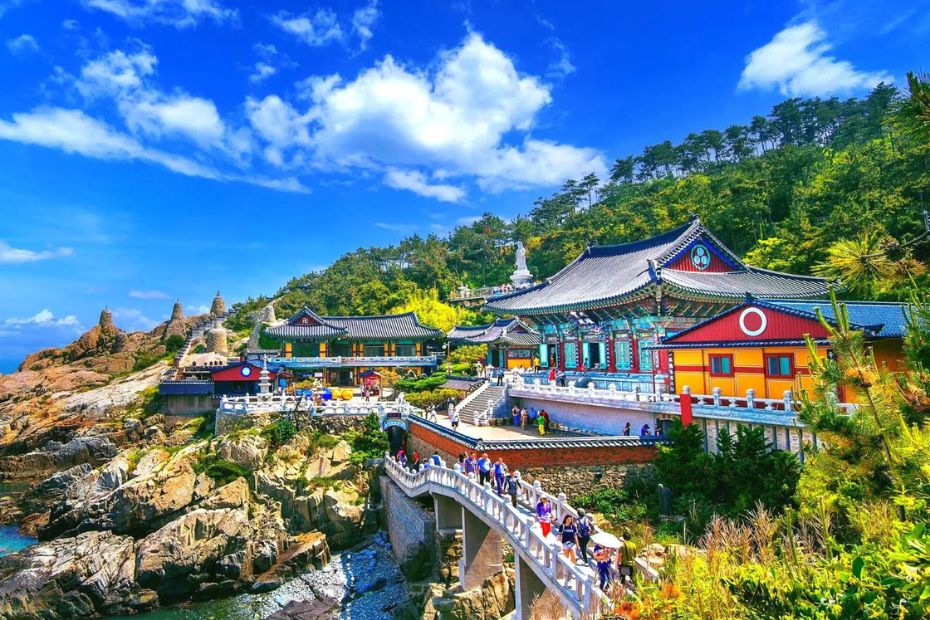
Day 5 : Take the bus to Haedong Yonggungsa Temple, then a taxi to Songjeong Beach. Relax in a beachside cafe, then take the Haeundae Beach Train to Cheongsapo, change to the Sky Capsule, and end up in Haeundae. Take a bus to Gamcheon Culture Village and get dinner at Songdo Beach.
Day 6 : Take a day trip from Busan to the UNESCO World Heritage City of Gyeongju. Visit the Gyeongju Historic Area, then Gyeongju Gyochon Traditional Village for traditional food and sights of Woljeonggyo Bridge. See tranquil night views of Wolji Pond before getting dinner at Hwangnidangil.
Day 7 : Head back to Seoul on the KTX for a final day of shopping and sightseeing in Hongdae. Walk along the Gyeongui Line Forest Park or Book Street or visit a theme cafe. Take the subway directly to Incheon Airport from Hongdae or spend a night here and check out the lively night scene.
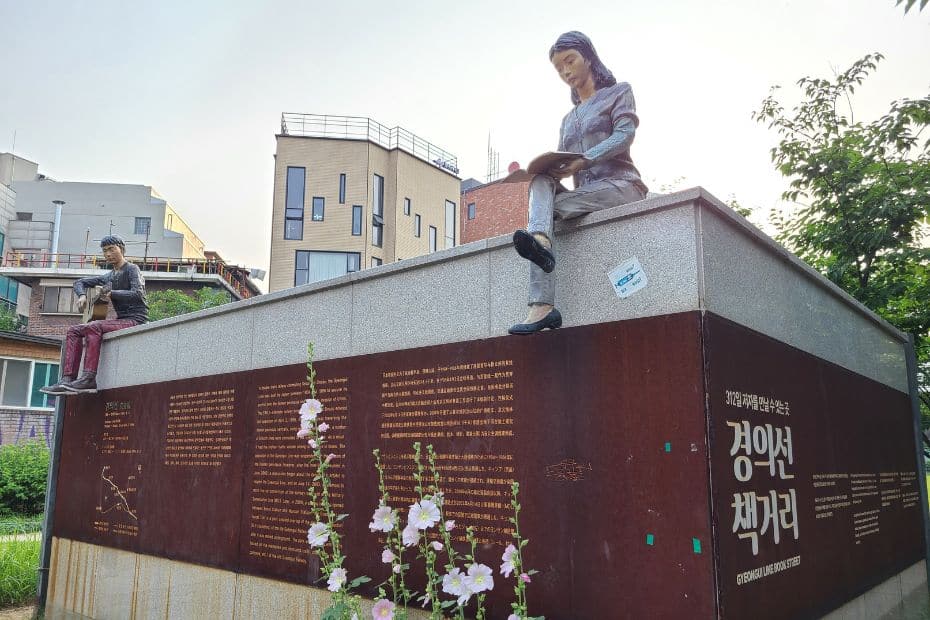
Please note : I recommend trying not to cram too much into your itinerary. You may want to see as much as possible, but people often end up rushing past sights and not appreciating them. Plan for less and see more if you have time. It gives you a chance to be spontaneous.
To plan a realistic itinerary for South Korea, it is important to factor in transportation, meal breaks, and rest times. Use Naver Maps to plan your route and work out travel times. A short journey on the map might take much longer if there’s no direct route. Also consider breaks if you plan to walk a lot.
Cultural Issues When Visiting Korea
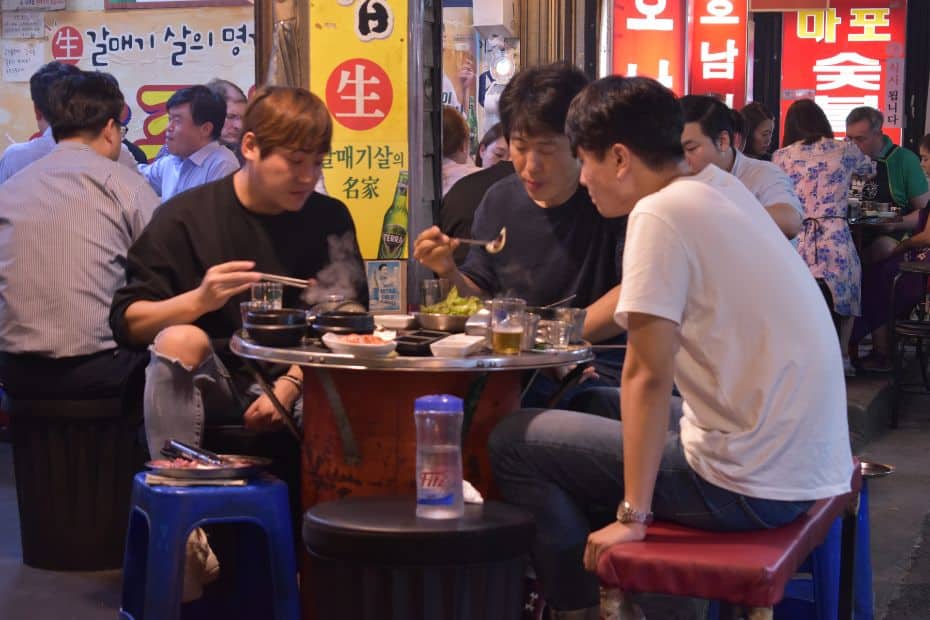
The next few sections of this South Korea travel guide will provide answers to some of the most common questions first-time travellers to Korea have in regards to cultural, language, and safety issues. Korea is a culturally unique country with customs and traditions you might not be aware of.
Korea is a society that places a strong emphasis on social image, respect for others, and social harmony. This means Koreans will often try to avoid conflict, especially in public. To show respect for Korean culture and to avoid being rude, try to respect social harmony and always avoid conflict.
If you follow these tips, you’ll find it easier to avoid accidentally upsetting someone in Korea. There’s far too much to cover in this South Korea travel guide, so if you’d like to know more, check out my detailed guide to Korean etiquette and culture , it’s packed with tips and insights to understand Korea.
What is considered rude in Korea? It is considered rude to point with one finger or with chopsticks, give and receive with one hand, cross your legs when sitting, and to walk inside with your shoes on. Things considered rude in other countries such as swearing and spitting are also rude in Korea.
What is considered unlucky in Korea? It is considered unlucky to write someone’s name in red ink and to stand chopsticks upright in rice. Both are used in rituals for deceased people. The number 4 is also unlucky as the word is the same as the word for ‘death’.
Do you need to tip in Korea? It’s not necessary to tip in Korea and most restaurants and cafes won’t expect or allow you to tip. There is no service charge added to bills in Korea, with the exception of some upmarket restaurants, bars, and hotels in touristy areas of Seoul. Tipping guides is okay.
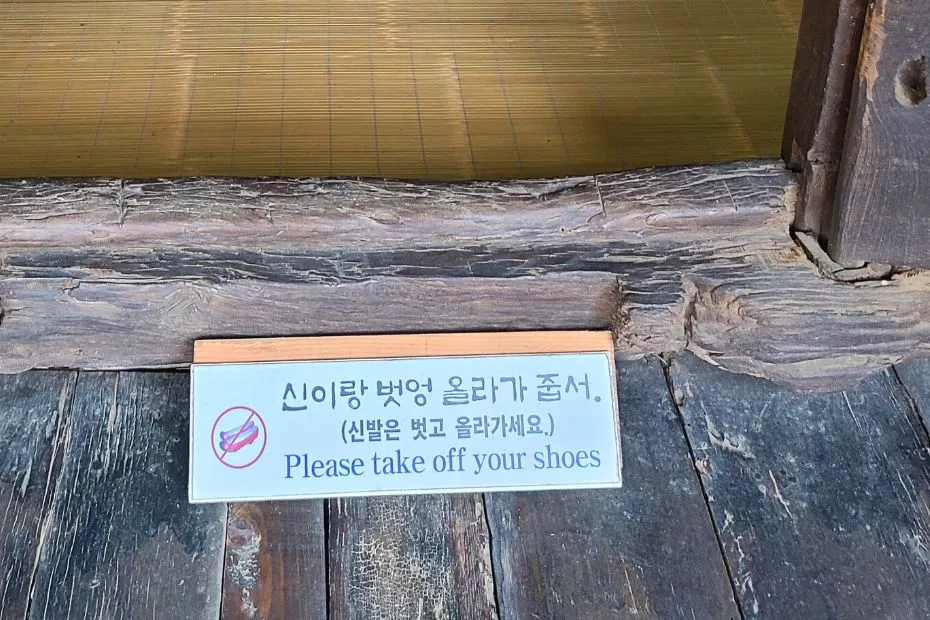
Do you need to take off shoes when going inside? If you enter someone’s house in Korea, you should take off your shoes. This rule also applies to temples, traditional restaurants, and other places in traditional buildings. Most cafes, shops, and restaurants won’t ask you to take off your shoes.
When should you use two hands in Korea? You should use two hands when giving and receiving things in Korea, such as money, a gift, a business card, or food. When you shake hands, use both hands, not just one. The same applies to pouring drinks, both pouring and holding a glass.
Do I have to act like a Korean in Korea? You don’t have to follow Korean customs and traditions when you visit Korea. You are a guest in the country and Koreans won’t expect you to know every rule. However, showing cultural awareness in Korea will help you make friends and impress locals.
The best tip for being culturally sensitive in Korea is to first consider all the things that you’d consider rude in your own country – spitting, swearing, shouting, physical violence, etc. Show the same acts of kindness you’d show at home – help others, give up your seat for those in need, be polite, etc.
Furthermore, remember that social harmony is really important in Korea and try not to cause a scene. Keep your voice down in public, don’t talk or act aggressively, be polite, and don’t force things when people are reluctant. Koreans may feel obliged to do things, even when they don’t want to.
Language Issues When Travelling Korea
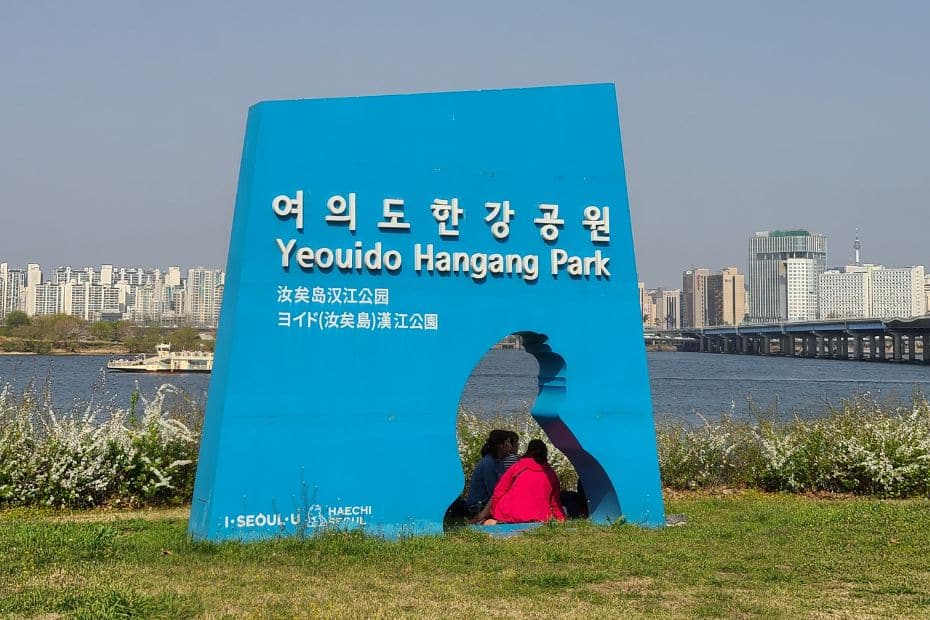
Language issues can be a big concern for first-time travellers to Korea as Korean is a very different language from English and has a unique alphabet. Korean is also one of the most difficult languages to learn for English speakers, ranked alongside Japanese, Chinese, and Arabic.
However, as a tourist to Korea, you don’t need to worry about mastering the language. English is used for signs and announcements in most places that you’ll need it, such as on public transport, at the airport, at attractions & tourist sites, on menus, and most other places. It’s common across Korea.
If there is a sign or notice that isn’t in Korean, I recommend using the Papago app to take translate it. Use the image translation function in the app to scan the sign and Papago will translate it into English for you. It’s really convenient and the way I translate things I can’t read in Korean.
Do Korean People Speak English?
Speaking in English to Korean people is different from being able to read and translate signs. English is taught from elementary school until the end of high school. That doesn’t mean everyone will remember it, but there’s a good chance some people will know English, especially younger Koreans.
It is best to ask if someone speaks English before trying to have a conversation. You can do this in Korean by asking “영어 할 수 있어요?” (Yong-oh hal su iss-o-yo?) or just ask it in English. Tour guides and people in the tourism industry will probably be able to speak English, but it’s not guaranteed.
Shyness is an issue in Korea and locals may be reluctant to speak English at first for fear of making a mistake. As an English teacher in Korea, I know that Korean students are usually quite competent in English, but lack confidence to use it. Be patient and encouraging when talking in English.
Although some Koreans may be too shy to use English, other people may be enthusiastic about speaking English to you and want to practice it. I’ve been asked random questions in English by strangers in the street in Korea who want to practice English and find out about my life.
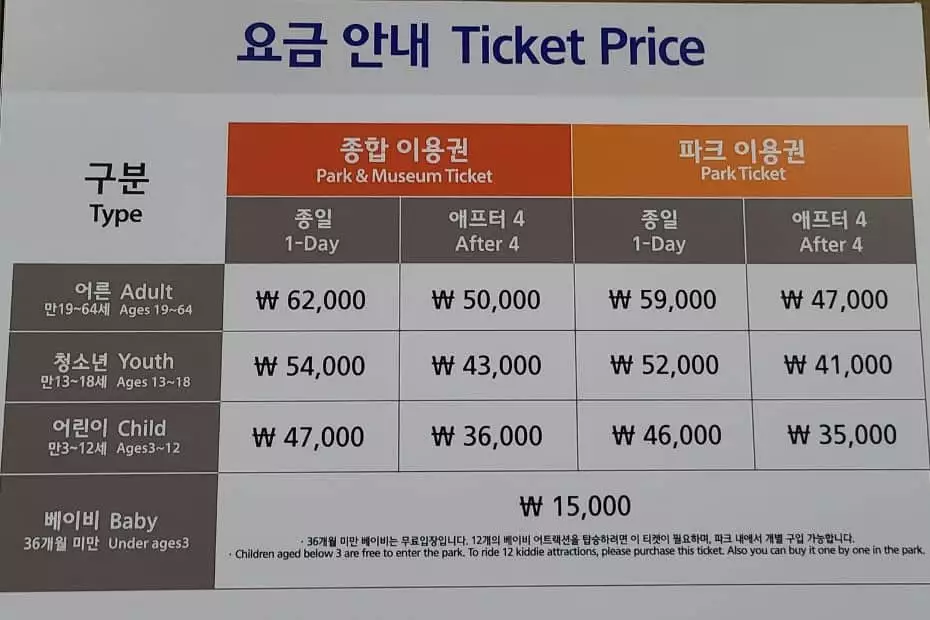
Should You Learn Korean Before Visiting Korea?
If you do want to learn some Korean before you travel, I recommend you start by learning the Korean alphabet , or at least learning some basic Korean travel phrases . Knowing how to introduce yourself, discuss prices, ask for directions, and ask for help will make your trip to Korea a lot easier.
You can learn Korean online through courses such as 90 Day Korean and Korean Class 101 , or with self-study textbooks like the excellent Talk To Me In Korean series. There are lots of resources on YouTube, too. I particularly like Learn Korean with GO! Korean Billy as he explains things clearly.
Another way to prepare to move to Korea is to read some Korean novels in English . Although these books won’t teach you any Korean, they’ll offer up valuable insights into Korean culture, both traditional and hidden under the surface. Literature is a good way to gain an understanding of a culture.
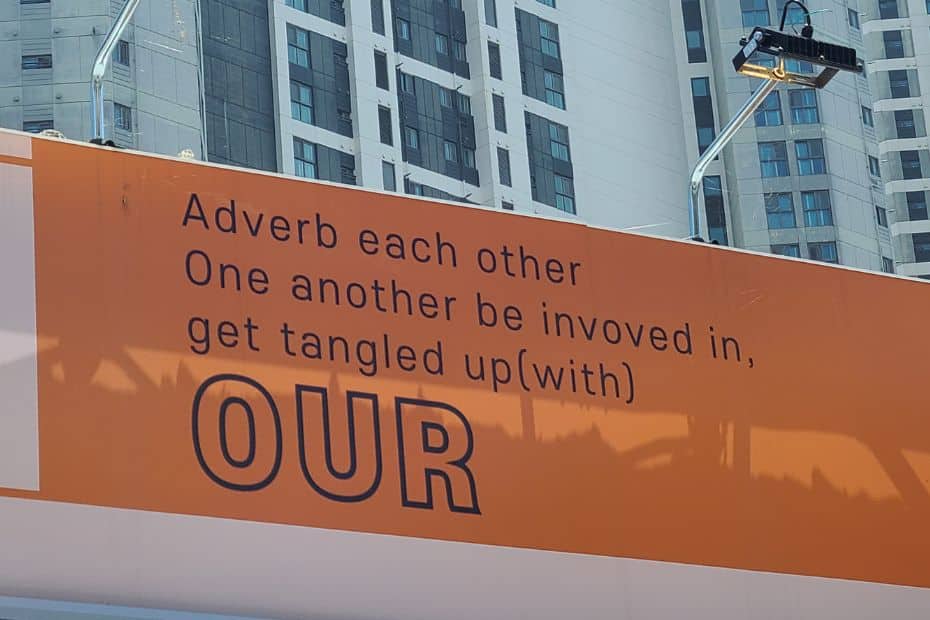
A warning about Konglish : Although Korea uses English in many useful ways, there’s also a lot of Konglish. The sign above is a good example of random English words being used to look cool, but ending up being confusing. There’s a lot of this in Korea and it’s mostly harmless, so don’t worry.
Health And Safety Issues In Korea
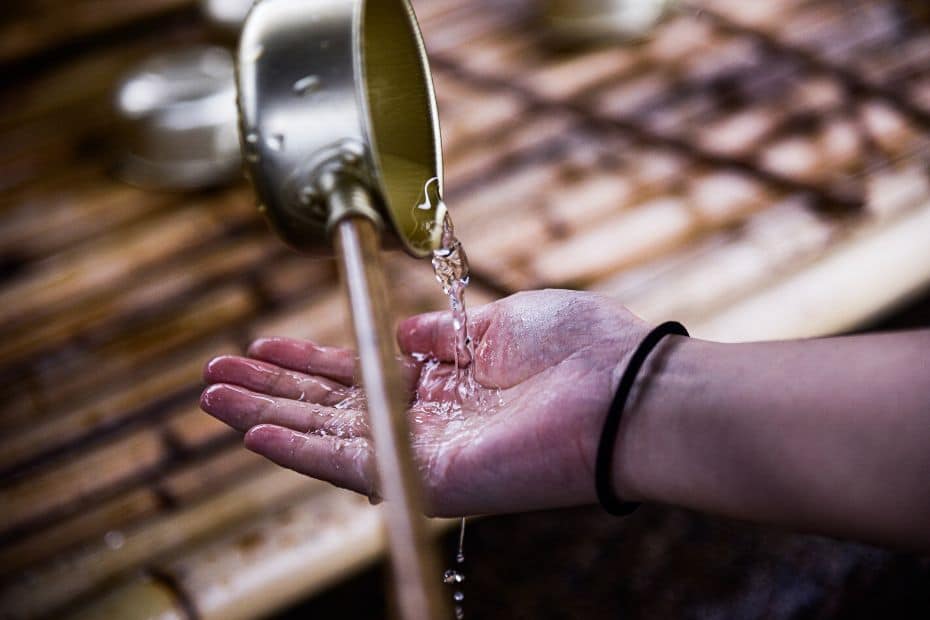
First-time travellers to Korea may be worried about health and hygiene issues, such as if certain foods are available and if they’re safe to eat. Other issues include vaccinations, personal safety, and how easy it is to contact emergency services. These issues are addressed below.
Is Korean Street Food Safe To Eat?
Korean street food is generally safe to eat and won’t give you any health issues unless you have an intolerance to the food. Korean street food can be spicy or contain a lot of salt, be aware of your own personal tolerances and dietary requirements before trying it.
Also be careful when ordering food with meat or seafood and check that it is cooked thoroughly. Korean street food that has been left out for a long time is more likely to cause food poisoning problems, so ask for freshly cooked food if you’re concerned.
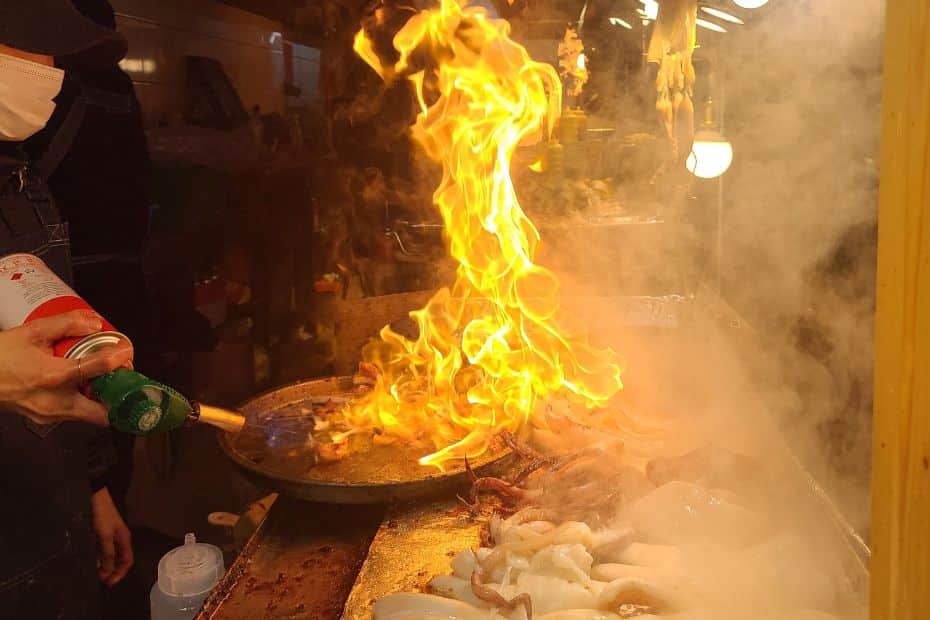
Is It Easy To Find Vegan-Friendly Food In Korea?
There are many vegan-friendly Korean dishes , such as gimbap , japchae , pajeon , bibimbap , ramyeon , and tteokbokki . However, some restaurants may use non vegan-friendly ingredients when preparing these foods, so be careful. Kimchi isn’t vegan-friendly due to its seafood ingredients & sauces.
Vegetarianism and veganism aren’t common in Korea with fewer people following these diets than in countries such as the USA or UK. Vegetarians in Korea account for 3% of the population, while vegans in Korea are only 0.2% of the population as of 2022. The UK is 10% and 2% respectively.
However, the number of vegan-friendly restaurants and bakeries is increasing each year in Korea, especially in areas such as Hongdae and Itaewon. Korean Buddhist temple food is vegan-friendly and a good option for vegans who want to enjoy vegan food while learning about local Korean culture.
If you’re concerned about accidentally ordering non vegan-friendly food, or want to know how to tell someone about food allergies or requirements, check out my guide to Korean phrases for ordering food . This has a whole section about special requests when ordering food in Korean.
Is It Safe To Drink Tap Water In Korea?
Korean tap water is potable and safe to drink. Korea ranks 23rd for water hygiene, which is above the USA, Canada, and Australia. However, many Koreans don’t drink tap water , preferring to use water purifiers and bottled water instead, claiming that tap water smells strange or water pipes are bad.
Personally, I don’t like drinking tap water in Korea as it tastes a bit stale, but it’s perfectly fine to drink and doesn’t cause any problems. Bottled water is very cheap in Korea and costs 600 KRW for a 500ml bottle from a convenience store. Buying water from a supermarket is a cheaper option though.
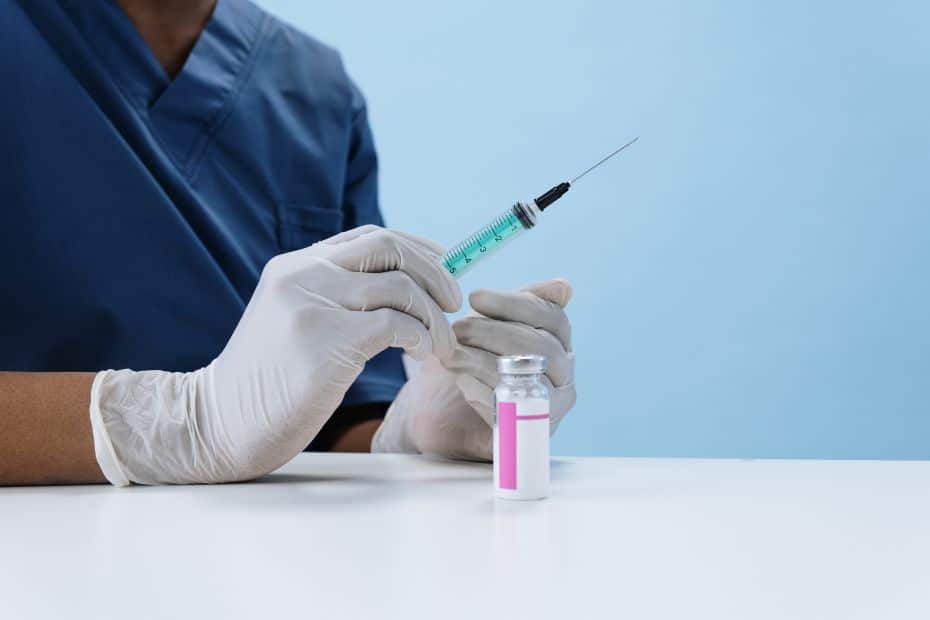
Do You Need Any Vaccinations To Travel To South Korea?
There are no mandatory vaccinations required to travel to Korea , but it is suggested you should have at least routine vaccinations such as tetanus, MMR, and polio. Hepatitis A & B, typhoid, and Japanese encephalitis vaccinations are also recommended.
Is Korea Friendly To Tourists?
Korea is generally friendly and welcoming to tourists. The Korean government spends a lot of money and effort to promote Korean tourism to the world and there are many incentives to bring people to the country. Korean people are also mostly polite and welcoming, especially in the tourism sector.
Is Korea A Dangerous Country To Travel In?
South Korea is a safe country to travel in and the crime rate in Korea is low, comparable to Norway or the Netherlands. Public crimes, such as theft and assault, are rare. Pickpocketing and purse snatching aren’t common and unattended goods are generally left alone or reported to the police.
How safe is Korea? I regularly see people leave their phone or handbag on a cafe table to reserve it before going up to order a drink. People even leave their laptops open while they pop out for lunch or go to the toilet. Stealing disturbs social harmony and is one of the reasons it’s rare in Korea.
Physical violence is also rare, but still occurs in Korea, as it does in all countries. This is most often found in areas with lots of bars and when people are drunk. However, visiting bars in Korea is a lot safer than I’ve experienced in other countries and trouble is not common, even in busy places.
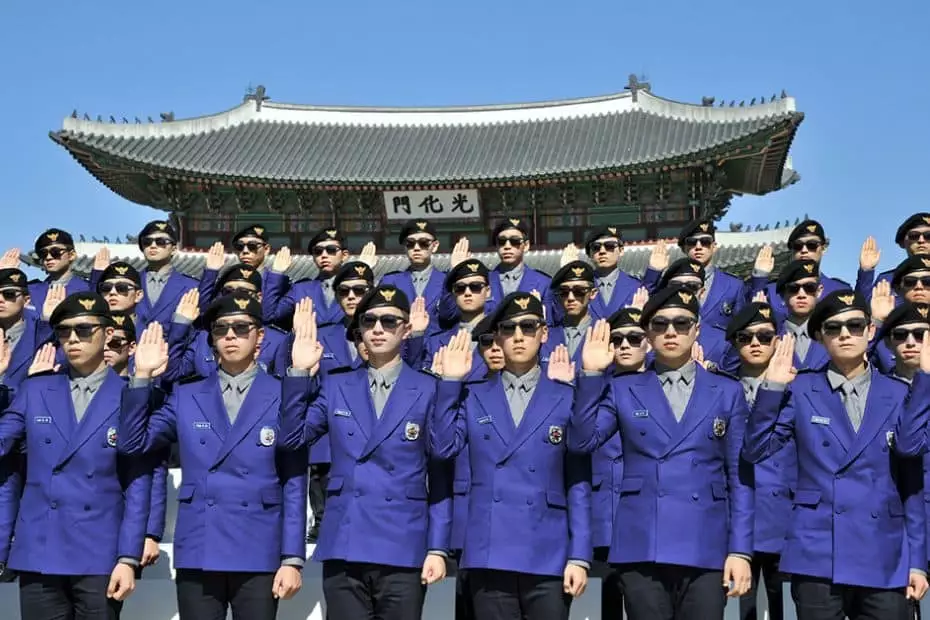
How Do You Contact Tourist Information Services In Korea?
Call 1330 in Korea to contact the Travel Helpline . The Korean Travel Helpline provides the following services free of charge to tourists in Korea.
- Tourist Information : Find out about attractions, opening hours, prices, and other information.
- Tourist Interpretation : Access travel information in several languages.
- Tourist Complaints : Report rip-offs and problems you encounter when travelling in Korea.
- Tourist Police : Report minor crimes in English and other languanges.
There are tourist police patrolling the streets of Seoul, dressed in purple uniforms as shown in the picture above. In popular tourist locations like Myeongdong and Bukchon Hanok Village, you’ll also find friendly tourist information staff dressed in red shirts with matching red cowboy hats.
What Should You Do If You Have An Emergency In Korea?
If you need to report a fire or medical emergency in Korea, you should call 119 from any phone. To contact the police in Korea, call 112. You will need to select an option to report an emergency in English or another language. It may take some time to be redirected to an English speaker.
- 119 – Medical Emergency & Fire Rescue
- 112 – Police
When you use medical services in Korea, you have to pay the cost of treatment, but there is no fee for the ambulance ride as this is covered by the Korean government. Travel insurance should cover the cost of medical bills, so if you’re worried about a large medical bill, insurance is recommended.
Fortunately, the cost of treatment in Korea is quite reasonable and Korea has advanced medical facilities, which is why it’s a popular medical tourism destination . Many people travel to Korea for minor and major surgery, including laser eye surgery, cosmetic surgery, and internal medicine.
Is Air Pollution A Problem In Korea?
Air pollution is an issue in Korea, especially in spring & summer. Winds blow yellow dust from Central Asia, field burning spreads fumes across Asia, and fossil-fuel burning contributes to higher levels of air pollution. Some days there’ll be very low visibility and health risks for people with lung problems.
My Personal Travel Tips For Korea
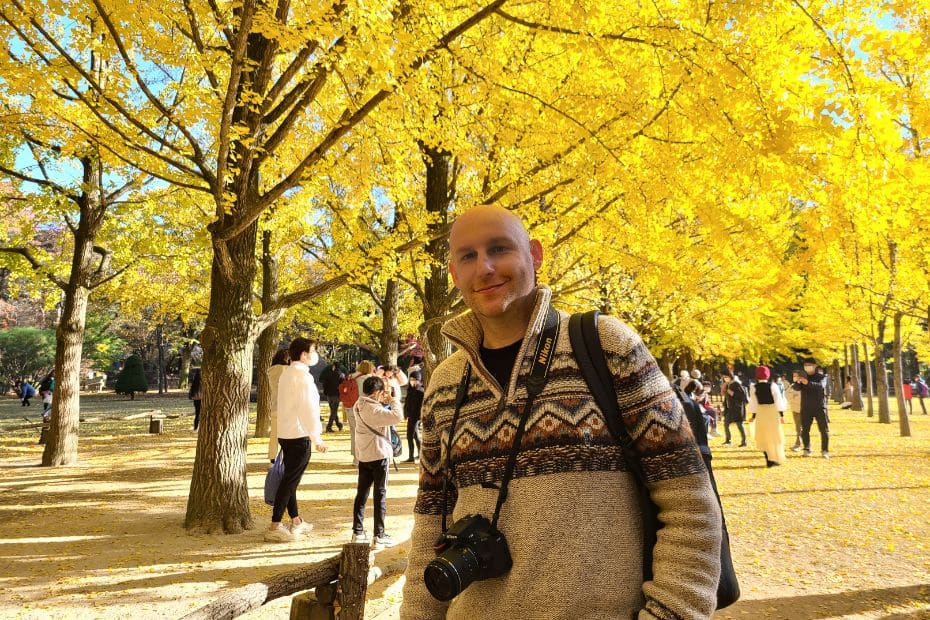
This South Korea travel guide is a collection of information I’ve researched and learned since moving to Korea in 2015 and blogging about Korean travel since 2019. I hope the provided information and insights are useful and assist you plan your dream first-time, or even tenth-time, trip to Korea.
This section includes my personal tips that didn’t really fit anywhere else and reflections built from travelling all over Korea in all seasons. These are tips I would offer to first-time travellers to Korea and people who might have some worries about visiting the Land of Morning Calm. I hope they help.
The Real Korea Isn’t What You See On TV
Korea is a developed country that went from being a 3rd world country in the mid 20th Century to a high-tech country in a short time. Despite the many high-rises and modern K-Pop stars, there are still shadows of the former Korea seen in both run-down slums and people with ‘traditional’ values.
The image created by selective K-Culture can distort people’s reality when dreaming of a trip to Korea in the same way Korean people can suffer from Paris Syndrome when visiting France. There are many wonderful things about Korea, but don’t travel thinking that everything is as shown on TV.
Be Prepared For Culture Shock
One of the best things about travelling is seeing a country and people that act and behave differently to how you do in your own country. This is known as culture shock and can be both a blessing and a challenge for first-time travellers to Korea. Things you might be used to can be different in Korea.
Some examples of culture shock in Korea include the way age determines hierarchy in Korea and how older people can be rather pushy, especially on the subway. Younger people also typically don’t question the decisions of older people in Korea as it is considered rude and disrespectful.
Less extreme cultural differences that might confuse some first-time visitors to Korea include having to shout to call someone to take your order in a Korean restaurant or not giving a tip. Koreans might similarly look at you strangely if you do something culturally different, such as walking while drinking.
Don’t Overpack When You Travel To Korea
First-time travellers to Korea may be worried about visiting a country like Korea without taking everything they need from home, even the kitchen sink. My advice is to pack as light as possible and leave yourself some space in your suitcase. There are two reasons for this.
- You can buy most things you need in Korea . This includes sun cream, heat packs, clothes, shoes, cosmetics, travel accessories, etc. They’re also probably cheaper in Korea, too.
- You will want to take home lots of things . From weird Korean snacks to beautiful hand-crafted pottery and woodwork, there are so many things to buy in Korea.
(1) The only exception is if you might have a problem finding correct-fitting items. Korean shoes and clothes are slightly smaller than what you’d find in Western countries and the sizes are also differently labelled. I’m a medium in the UK but a large (sometimes XL!) in Korea. Be careful when shopping.
(2) It’s hard to fit everything you buy in Korea into an already full suitcase. Fortunately, you can buy extra suitcases at low prices. Check out Namdaemun Market for cheap luggage options, as well as shops like the one pictured below (this is in Busan) in places like Hongdae and Dongdaemun.
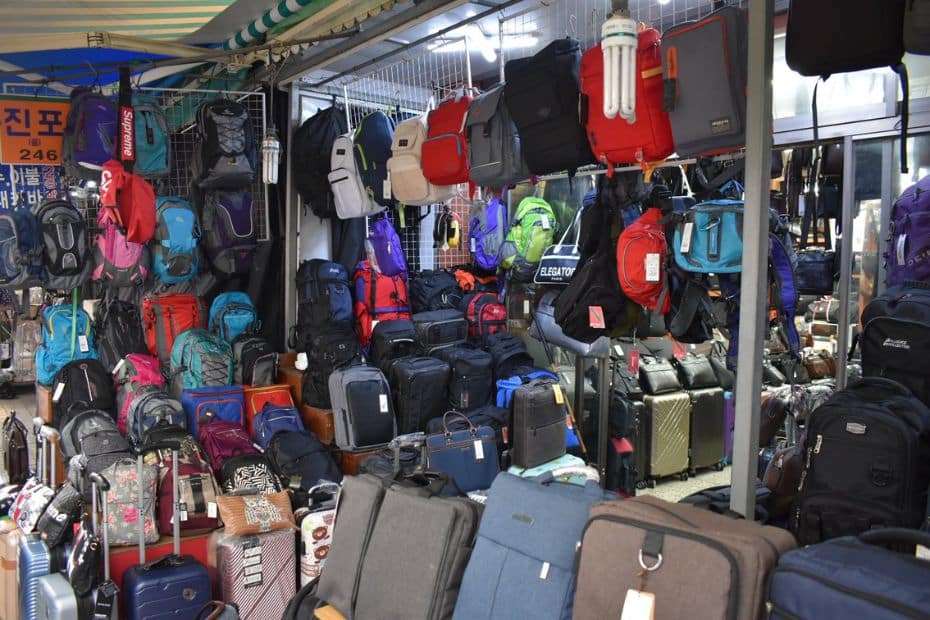
Electricity In South Korea
Be careful with electric items when travelling to Korea. Korea uses type C and F plugs , which are used in Europe, Russia, and other parts of Asia. The standard voltage is 220V with 60Hz frequency. Anything designed for a standard voltage between 220V and 240V should be fine in Korea.
Laptops, mobile phones, and other portable devices will be fine when you travel in Korea as long as you use a travel adapter with a USB or socket connection. Hairdryers, shavers, curlers, and similar devices might have problems charging in Korea and run out of power very soon. My shaver did.
Go With The Flow And Go Quickly
Korea is a very busy country and you might hear people mutter ‘빨리빨리’ ( ppalli ppalli ) if you walk slowly, especially in the subway. Koreans work long hours and are eager to get home or go out for dinner. Don’t take it personally if people push past you and don’t feel like you have to rush.
Know Where To Throw Away Rubbish
It can be difficult to find a bin to throw away rubbish in Korea, even in urban areas. The best place to dispose of rubbish in Korea is at a convenience store. You can find recycling and trash bins in these shops. If you go hiking or explore the countryside, expect to carry your rubbish home with you.
South Korea Travel Guide FAQs
Finally, here’s a few FAQs about this South Korea travel guide, in case the above information didn’t cover enough for you.
What is the best month to visit South Korea?
The best months to visit South Korea are April and October. April is warm and you can see cherry blossoms in Seoul at the start of the month. October is warm with clear skies. During October you can see autumn foliage across Korea.
How much money is enough for South Korea?
The amount of money you need to travel in South Korea depends on your travel style and desired level of comfort. A rough budget for South Korea is 50-100,000 KRW per day for budget travellers, 100-200,000 KRW per day for mid-range travellers, and 200,000+ KRW per day for luxury travellers.
Is South Korea friendly to tourists?
South Korea is a welcoming country and friendly to tourists. There are many services to welcome tourists to South Korea, including free transit tours from Incheon Airport, cultural performances in tourist destinations, low entry fees to traditional attractions like Gyeongbokgung Palace, and tourist information and signs in multiple languages.
What do I need to know before travelling to South Korea?
It’s important to know about the weather before travelling to South Korea as this can impact your day to day travel and affect what clothes you’ll need. You should also research what festivals are on before you travel, what seasonal events are happening, such as cherry blossom viewing, and also how to use public transport and get connected to the net.
What is the cheapest month to visit South Korea?
January and February are two of the cheapest months to visit South Korea and are considered low season as the weather is cold. Hotel prices and flights to Korea will be lower in these months. Winter is a good time to travel to Korea to see snow and enjoy winter sports and festivals, however, some attractions will be closed during this time of year.
Do I need a South Korea travel guide?
It is good to check a South Korea travel guide to research your trip, especially for first-time travellers to Korea. Korea has a unique culture, language, and customs that might be confusing for new travellers. A South Korea travel guide will help you prepare for these factors and give you ideas to create your perfect trip to Korea.
Can you drink tap water in Korea?
Korean tap water is potable and safe to drink. You can drink water from hotels and apartments in Korea. Restaurants and cafes will provide you with free drinking water, which usually comes from a water cooler. Bottled water is available from convenience stores and is reasonably priced.
Is South Korea safe for first-time travellers?
South Korea is a safe country for first-time travellers to visit. Personal crimes, such as theft, mugging, and physical violence are rare in Korea and it is safe to walk the streets of Seoul, even at night. First-time travellers can prepare for a trip to South Korea by being aware of potential scams, such as taxi drivers over charging them or being ripped off in the traditional markets.
What are the best apps for travelling in South Korea?
The best apps for travelling to South Korea are Papago, Kakao Taxi, Naver Maps, and Seoul Subway. These apps will allow you to translate between Korean and English, hail taxis, and navigate as you travel. All of these apps have English language options and are free to use.
Support In My Korea Thanks for reading. If you want to help me to create more great content in the future, why not buy me a coffee? A strong coffee helps me write more and is a simple way to show gratitude for this free content.

Liked This? Pin It For Others
If you enjoyed reading this article, then please share this with your friends on Pinterest.
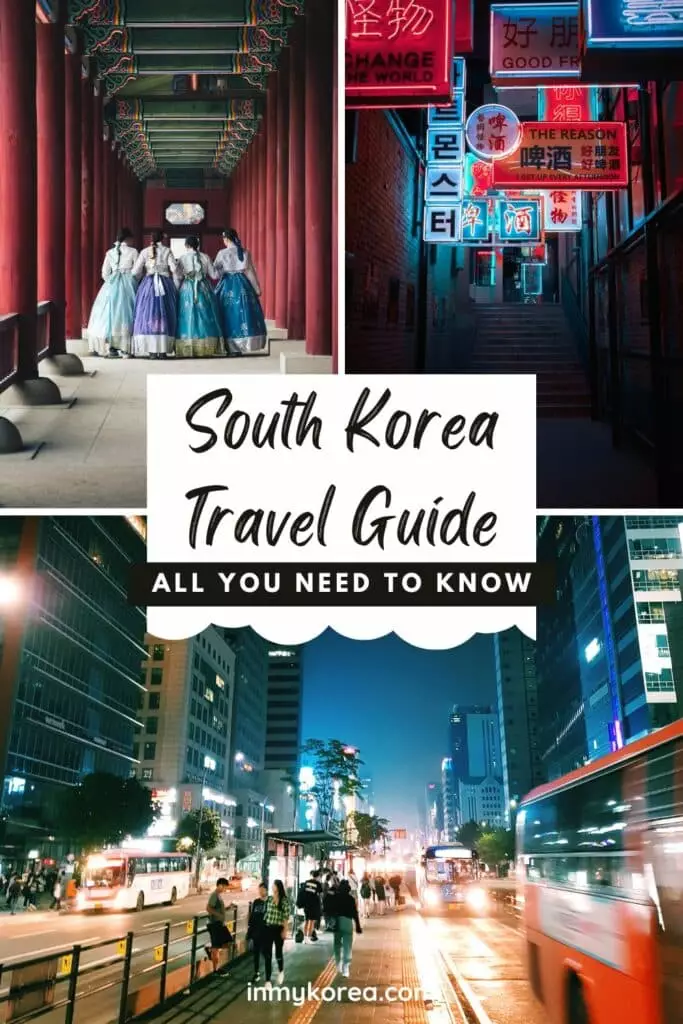
Related Articles
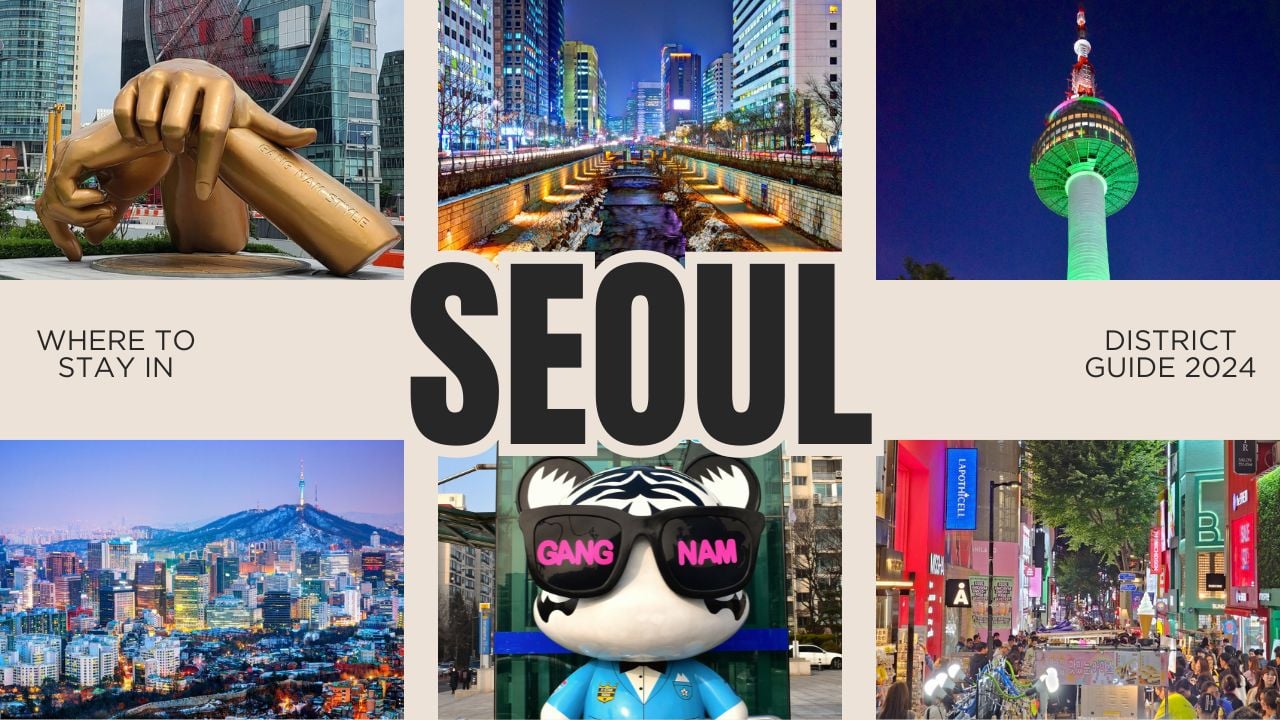
Where To Stay In Seoul 2024: District Guide For Tourists
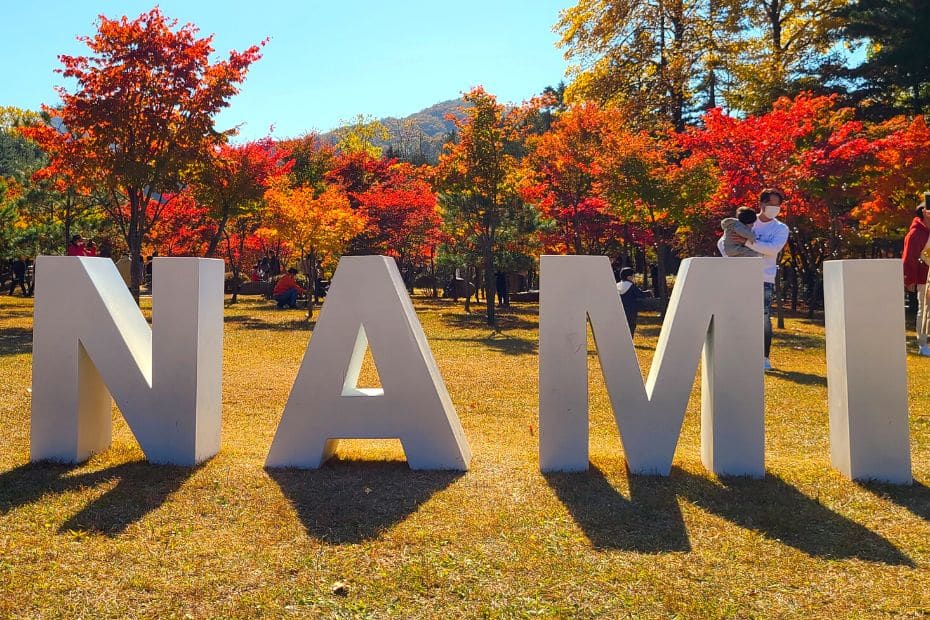
How To Get From Seoul To Nami Island By Car, Train, Tour 2024
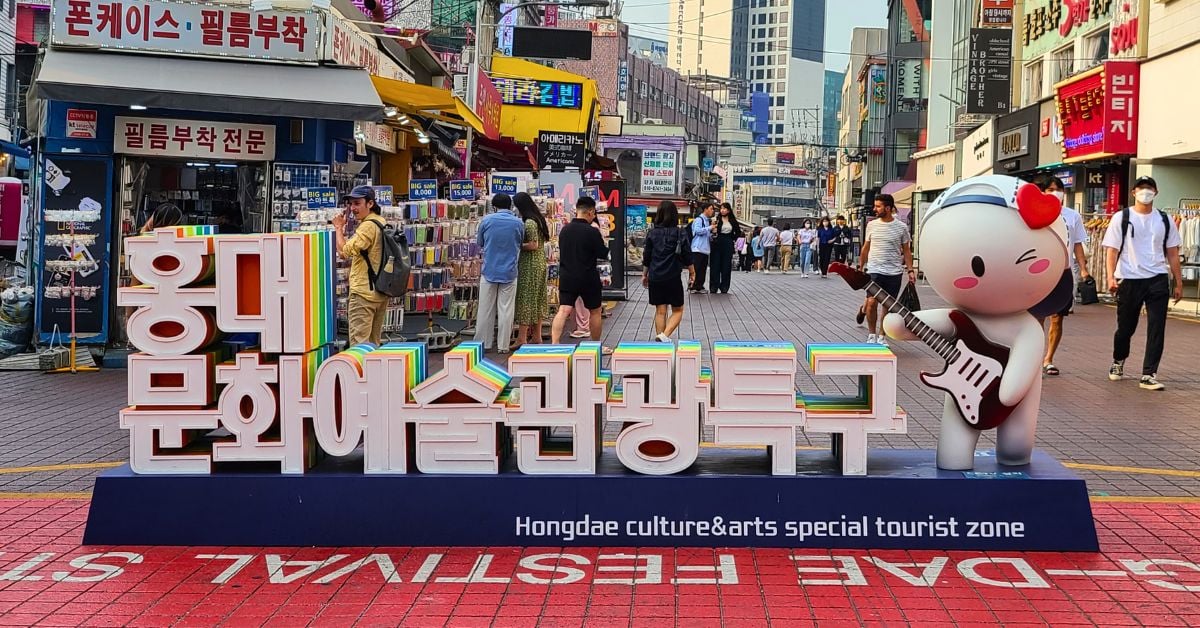
10 Best Hotels In Hongdae 2024: Seoul’s Coolest District
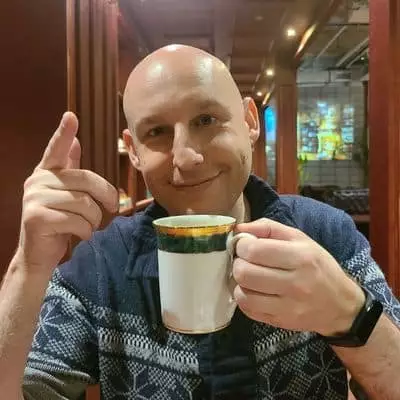
Hi! My name is Joel, I'm the author of In My Korea and writer of this article. I've lived, worked and travelled in Korea since 2015 and want to share my insights, stories and tips to help you have the best experience during your trip to Korea.
I love learning more about Korean culture, hiking the many mountains, and visiting all the coolest places in Korea, both modern and traditional. If you want to know more about my story, check out the ' about me ' section to learn why I love living in Korea.
4 thoughts on “Complete South Korea Travel Guide 2024: Korean Travel Tips”
This South Korea travel guide is a comprehensive resource for anyone planning a trip to Korea. It covers everything from entry requirements and travel tips to accommodation options and places to visit. Whether you’re a first-time traveler or have been to Korea before, this guide has something for everyone. The inclusion of the latest travel news and COVID-related updates adds to its relevance and usefulness. I appreciate the detailed breakdown of sections and the inclusion of quick links for easy navigation. Overall, this guide is a valuable tool for anyone looking to explore the wonders of South Korea.
Moderator – Nice Article! In My Korea
Thank for the great info! Could you please recommend any tours agency for a few day trips around Korea? I found a few , but they are pretty pricey!
Hi, thanks for reading. Klook and Viator have a good selection of tours in Korea with some of the best prices on the market. I’m not sure which tours you’re looking for, but they usually do day trips for less than $100 per day that cover popular tourist sights.
Leave a comment Cancel reply
Save my name, email, and website in this browser for the next time I comment.
- Meet the Team
- Work with Us
- Czech Republic
- Netherlands
- Switzerland
- Scandinavia
- Philippines
- South Korea
- New Zealand
- South Africa
- Budget Travel
- Work & Travel
- The Broke Backpacker Manifesto
- Travel Resources
- How to Travel on $10/day
Home » Asia » South Korea » 26 South Korea Travel Tips You Need to Know! • 2024
26 South Korea Travel Tips You Need to Know! • 2024
South Korea is a tiny country that punches way above its weight in a number of arenas, and that extends to being one of Asia’s greatest travel spots!
The land of KBBQ, the world’s fastest internet speeds, futuristic cities, and a breathtaking mix of ancient and modern, this is one of the best countries in Asia to travel in, and yet it’s criminally underrated.
I spent a few years calling this country home, and I’ve created the ultimate Korea travel guide to help you navigate your way through this gem of northeast Asia.
Whether you’re a first-time traveler or a return visitor, here’s a list of 26 South Korea travel tips you need to know before stepping off the plane!
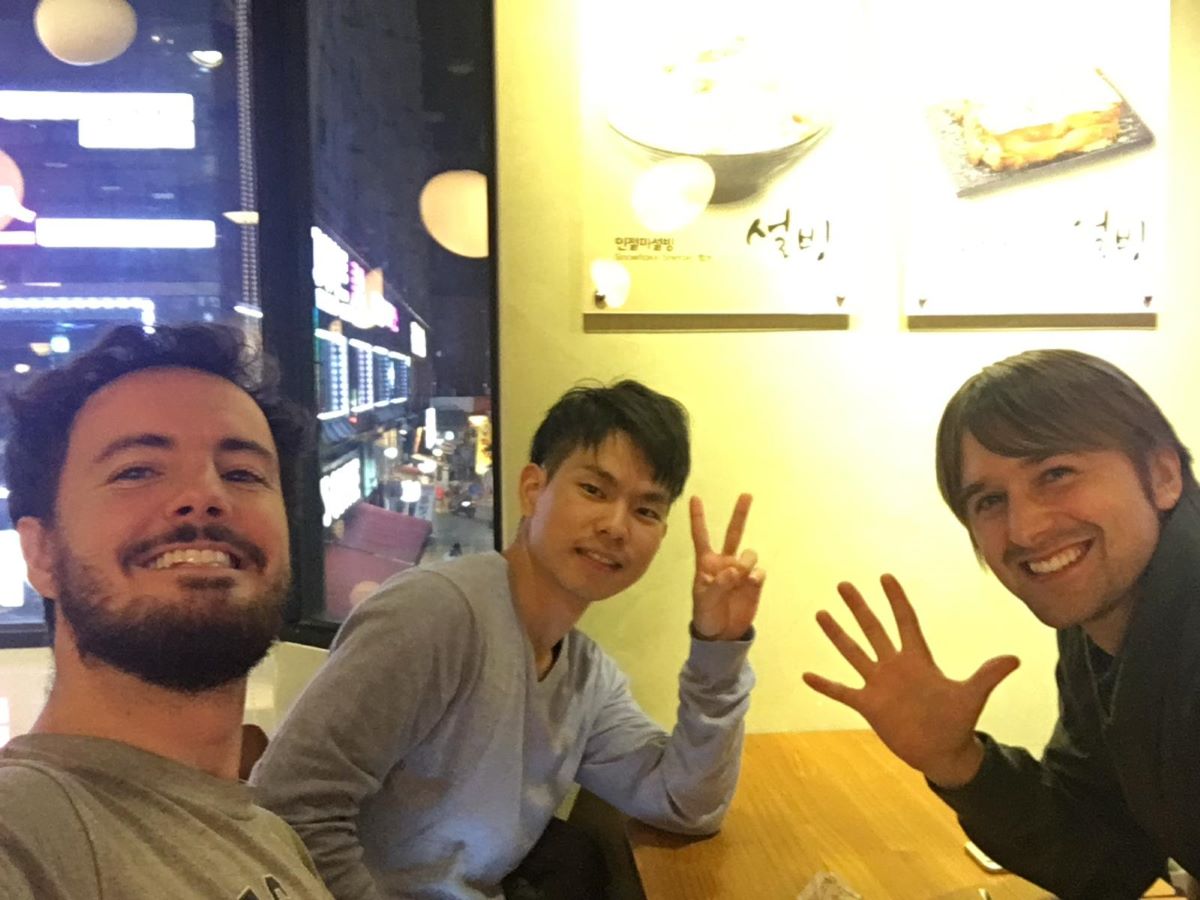
The Broke Backpacker is supported by you . Clicking through our links may earn us a small affiliate commission, and that's what allows us to keep producing free content 🙂 Learn more .
26 EPIC South Korea Travel Tips
After years of living and traveling in South Korea , here are some of the most important tips I’ve learned along the way!
1. Download These Apps!
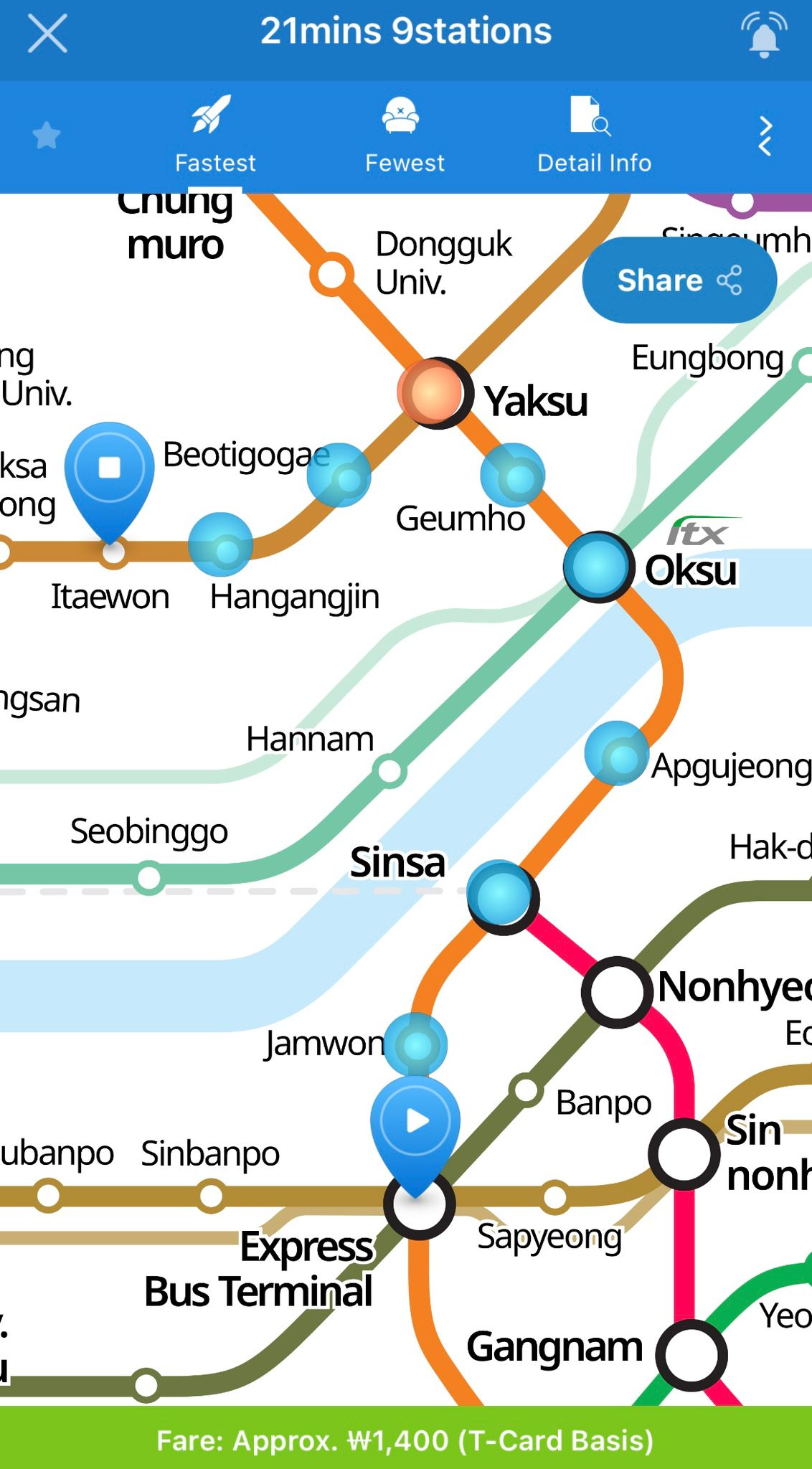
South Korea is one of the most tech-savvy societies on the planet, and you’re going to need to keep up. These apps are just a few of the essentials you want to have to make your trip to South Korea the unforgettable experience it should be.
Subway Korea
Not the most exciting app to download but crucial all the same, this is going to make your time in Seoul so much easier.
With a full, interactive map of Seoul’s ( Korea’s capital city ) absolutely sprawling subway system, Subway Korea tells you exactly which station you need to begin and end at, which stations to transfer at, and how long it’s going to take you from start to finish.
You can find this on the App Store for both Android and iPhone, and a companion app exists for Busan’s smaller (but still pretty big!) subway system.
When it comes to Korean, Google Translate can give you some hilariously bad translations and while that’s always entertaining, you’re going to need to be able to communicate with more than just hand gestures!
That’s why you need to download Papago . It serves many languages and its Korean translations are far better than Google’s, so this is going to make traveling to South Korea for the first time go much smoother.
You can get around places in Seoul with only English, but beyond that you’re going to need some help which makes Papago a must-download.
In my experience, Google Maps isn’t too helpful in Korea, and that’s why you’ve got to download Kakao Maps!
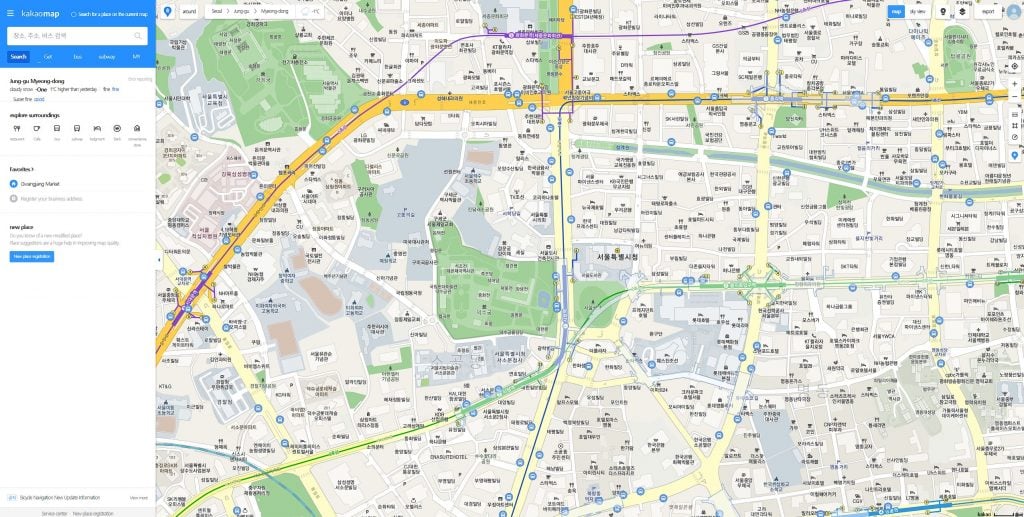
An app made by a Korean company, Kakao Maps is going to provide you with a level of detail, precision, and helpfulness that Google Maps simply can’t deliver.
Whether you’re exploring the city or out in Korea’s gorgeous countryside, this app is the best option for navigating the country.
2. Learn Some Basic Korean Phrases
Having a solid translation app is all well and good, but it’s also important to memorize a few basic phrases in Korean just in case your phone doesn’t come through for you.
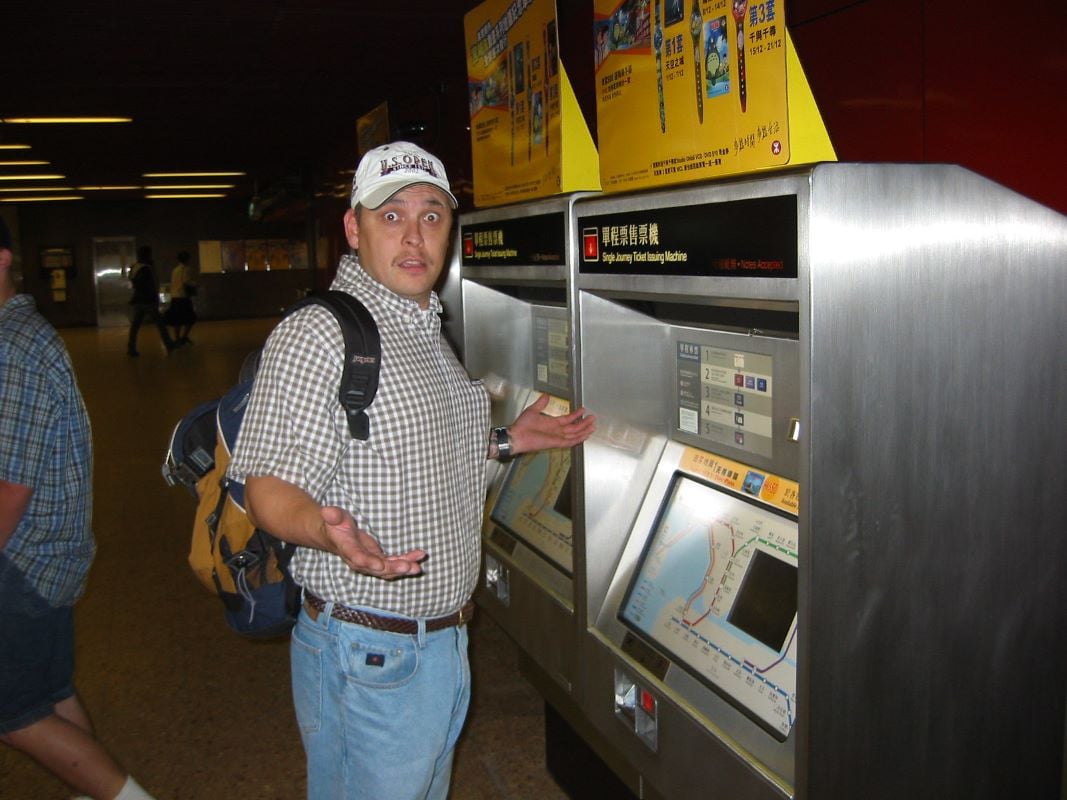
Anyeong Hasaeyeo – Hello
(You might have heard anyeong as meaning “hello” in Korean before and while that’s true, it’s important to say the full phrase because shortening it to anyeong can be seen as disrespectful.)
Kamsamnida – Thank you
Kohn Bae! – Cheers!
Odi / Odi…? – where / where is…?
Hwajangshil – Bathroom
3. Explore the Dramatic East Coast
Staying in Seoul is great, but the country has SO much more to offer.
Korea’s east coast in particular flies far under the radar for most foreigners and isn’t visited nearly enough. But I can attest that it’s easily one of the most epic regions in Korea!
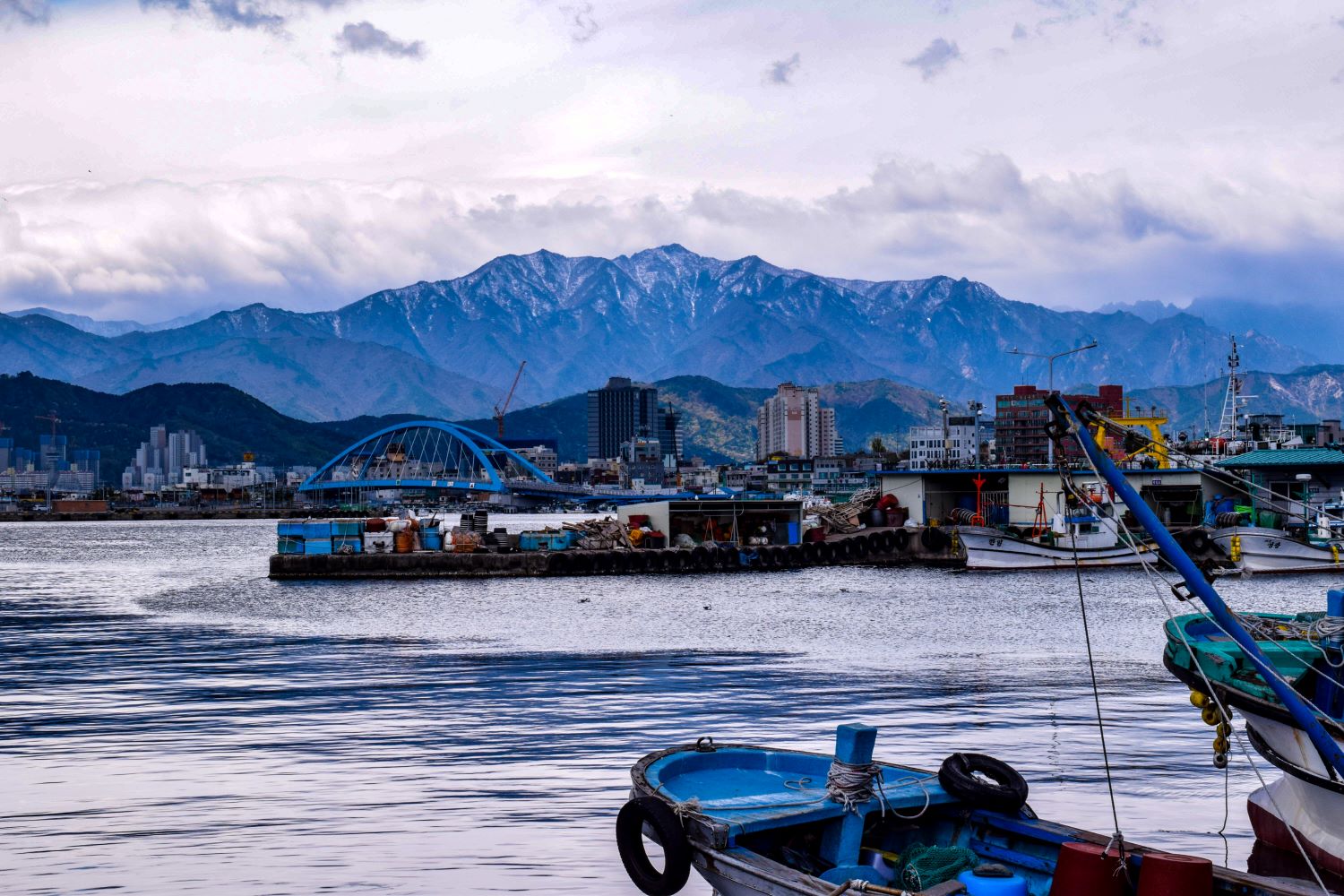
With tall, jagged peaks rising straight out of the sea, the east coast is the perfect place for travelers looking to escape Korea’s ultramodern cities and get out to explore the country’s natural wonders.
The east coast holds some of Korea’s best hiking spots, and Seoraksan National Park in particular is a favorite of mine, especially during winter and spring.
4. Korea is a Shopper’s Mecca
If you’re keen on shopping for the latest fashion or newest tech, South Korea is pretty much unbeatable.
Between Shinsegae, Lotte World, and a TON more, Korea has limitless options for shoppers of all stripes.
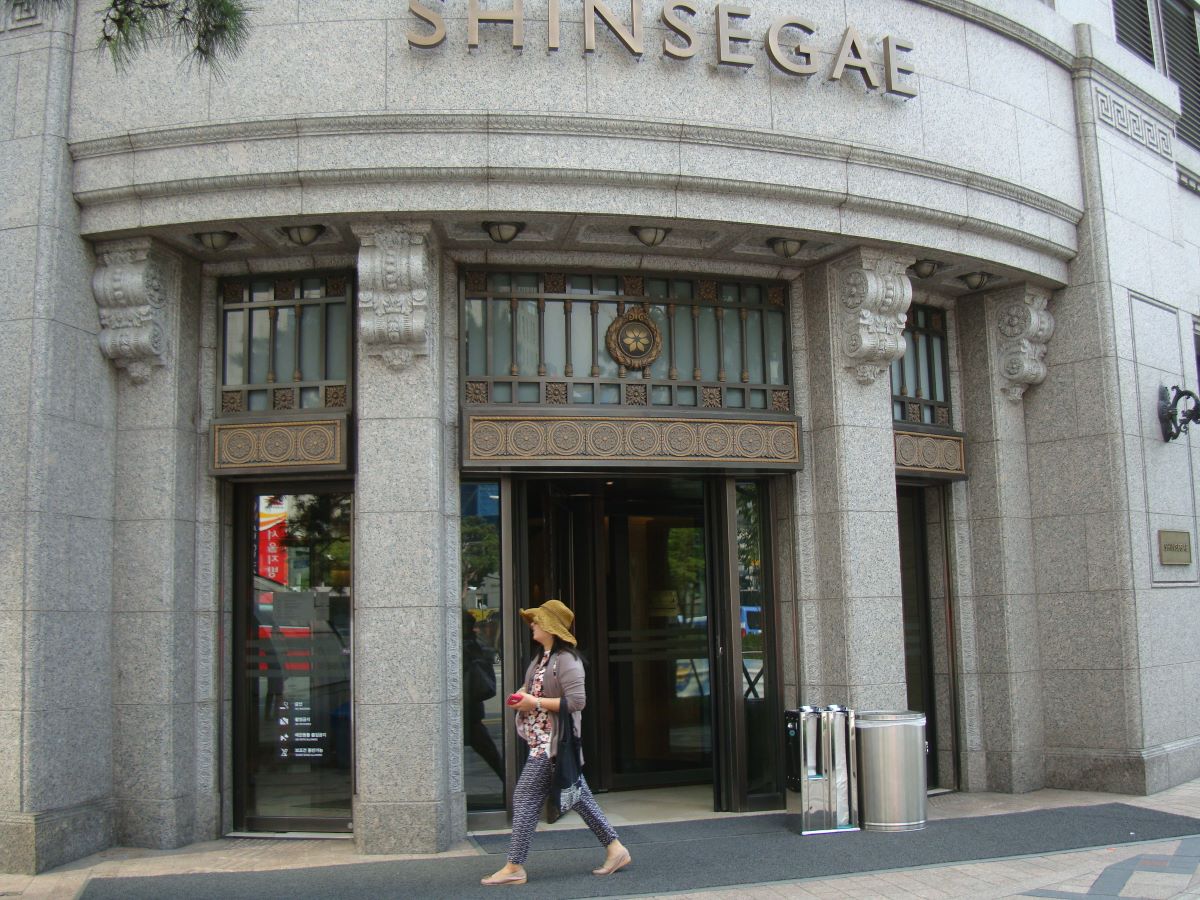
Shinsegae and Lotte are two absolutely massive department store chains in Korea that house countless stores within their walls, and there are so many more on top of those two to choose from and explore.
Your choices really are infinite.
The one thing you need to keep in mind though is that you should be prepared to spend.
Korea is not a cheap country in general, and that extends to its shopping scene. If you’re going to buy a higher-end item here, be ready to shell out a lot of cash.
5. Avoid Drinking Tap Water
Sadly, Korea isn’t a place where you can drink the tap water worry-free. While many places in the countryside have springs with fresh water straight from the mountains, you will need to have a filtered water bottle for your trip!
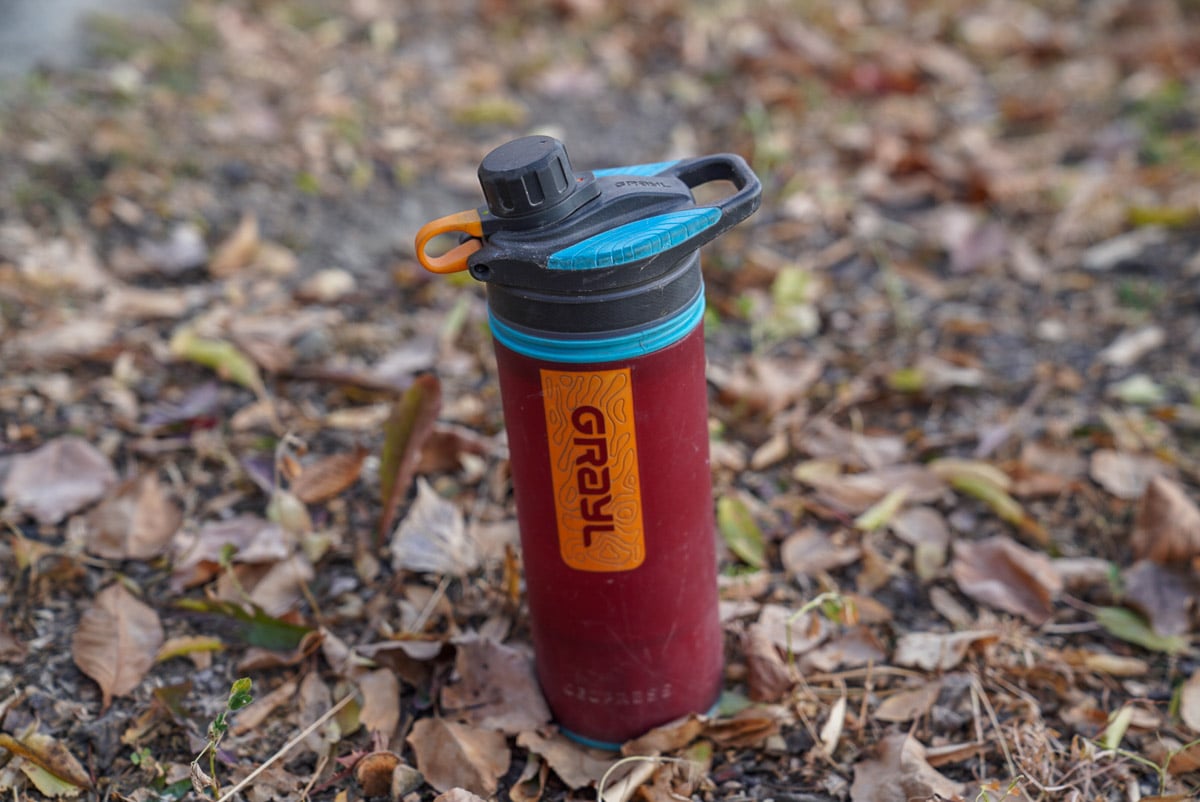
That’s why we strongly recommend you invest your hard-earned cash in getting a Grayl Filtration Bottle to accompany you on your travels!
It’s a reusable, zero-waste system that allows you to drink water from pretty much anywhere and in the long run, will save you countless dollars that you would have otherwise spent on water bottles, filters, and purification tablets.

Drink water from ANYWHERE. The Grayl Geopress is the worlds leading filtered water bottle protecting you from all manner of waterborne nasties.
Single-use plastic bottles are a MASSIVE threat to marine life. Be a part of the solution and travel with a filter water bottle. Save money and the environment!
We’ve tested the Geopress rigorously from the icy heights of Pakistan to the tropical jungles of Bali, and can confirm: it’s the best water bottle you’ll ever buy!
6. Learn How to Get Around in South Korea
Nearly every corner of South Korea is connected by an intricate web of trains and buses that link large cities like Seoul and Busan in the south with the tiny villages and hamlets in the countryside.
Public transportation in Korea is fantastic: it’s reliable, clean, convenient, and always on time!
Even if you’re waiting at a bus stop in the middle of nowhere, if the schedule says a bus arrives at 8:30, it will be there at 8:30, give or take a few minutes.
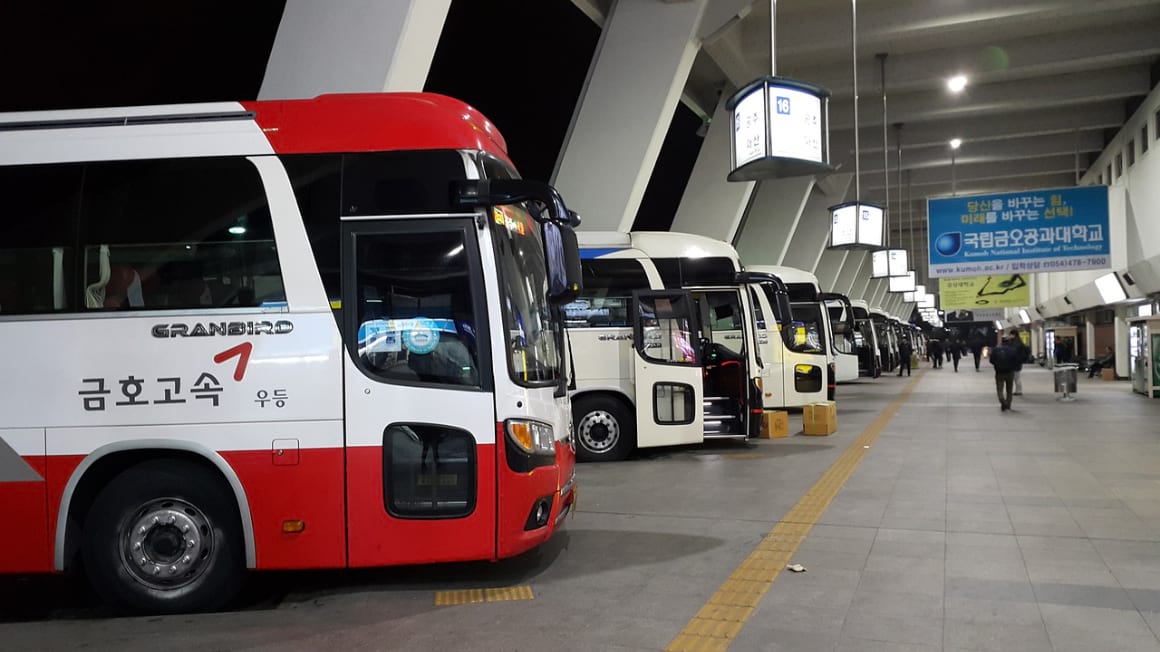
On that note, if you’ve got a bus or train ticket departing at a certain time, make sure you’re there early because you will get left behind if you’re not there on time!
That brings me to one of the most important points of this piece: I highly recommend that you do NOT rent a car or motorbike in Korea if you’re considering it.
While the roads are modern, impressive feats of engineering, drivers here can often be very unpredictable and that can lead to some dangerous situations on the road if you’re not used to it.
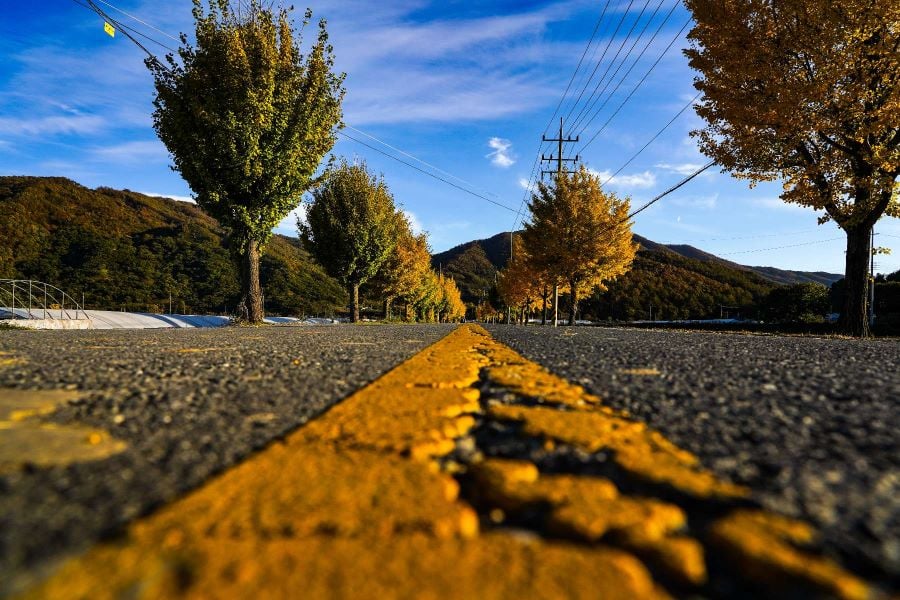
A one-hour motorbike ride between two cities in Korea felt longer and scarier to me than a nine-hour ride on Pakistan’s Karakoram Highway, and anyone who’s made that trip can tell you how much that statement means!
It’s for that reason that I think you should avoid getting your own wheels in Korea, and that risk combined with the excellent public transportation system makes any rentals a needless expense.
When going between different cities, you can use Trip.com to book your train or bus tickets.
Remember to book in advance because if you show up and try to buy the ticket the day of your intended departure, there’s a good chance you’ll be out of luck.
Simple Seoul Travel Tips You Need to Know
Whether you’re traveling to South Korea for the first time or coming back for more, you’ll be spending a ton of time in Seoul so it’s good to know how to stay on top of things when exploring this behemoth of a city!
7. Invest in a Month-Long Tmoney Card
You’ll probably be using public transportation a lot, so it’s best to invest your money where it counts to get the most bang for your buck.
Bus and train fares in Korea are cheap anyway (about one dollar or less per ride), but the government just launched a new transit card option which allows passengers to spend $49 for a one-month pass and get unlimited access to Seoul’s huge network of trains and buses, as well as public bicycle rentals.
The card is rechargeable, so if you plan on staying in Korea for longer than a month, this is a great option to make your Seoul itinerary easier to execute.
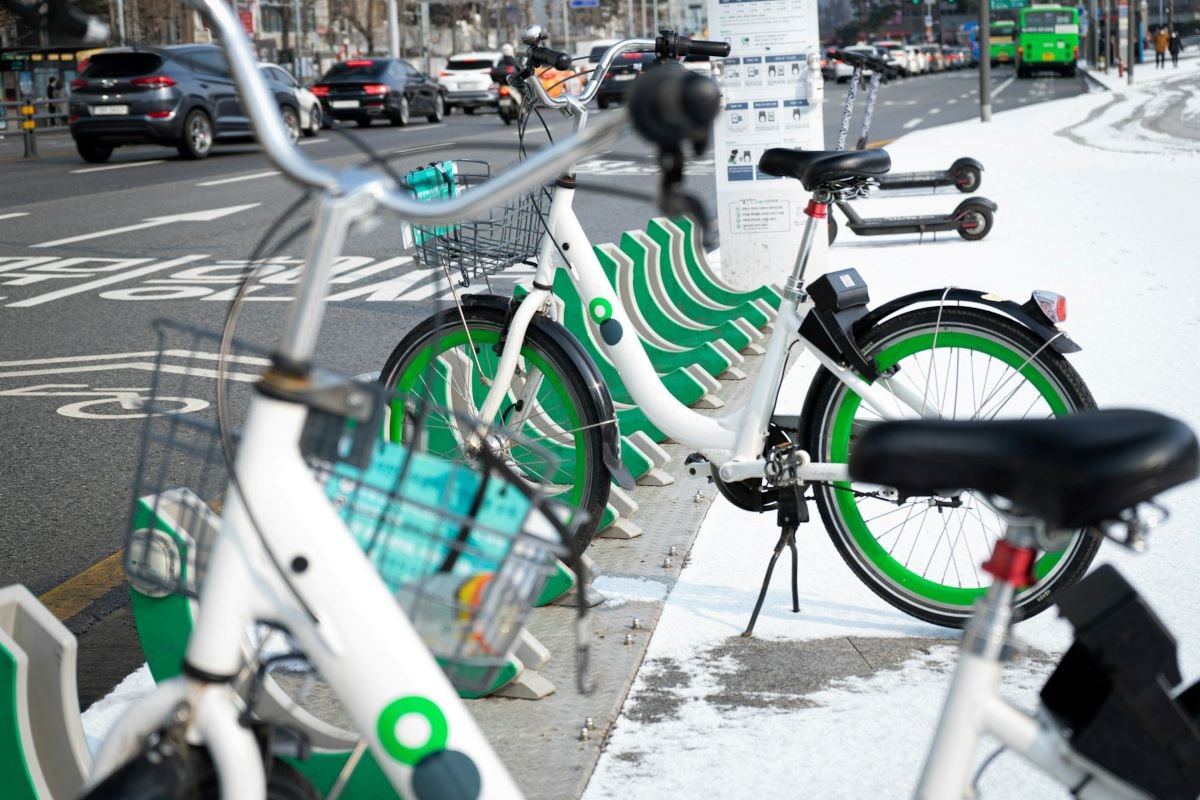
You can get one at any major subway station, but sadly this card only covers public transportation in Seoul for now, so keep that in mind before buying.
If you’re just looking for a good old-fashioned Tmoney card without the month-long plan, you can get one at any convenience store or subway station and charge it with cash.
8. Make Reservations in Advance if Possible
When it comes to accommodations or more popular restaurants/cafés, it can be difficult in Seoul to simply show up to a place and expect to find an open spot, especially in high season.
This is a country where it’s best to make your reservations beforehand. If you don’t, there’s a very good chance that you’re going to miss out and get turned away.
9. Try Seoul’s amazing street food
Korean cuisine has plenty of tasty street snacks that are quick and cheap, making this one way to cut costs in Seoul! There’s no shortage of markets and stalls offering a quick bite, so be sure to check them out.
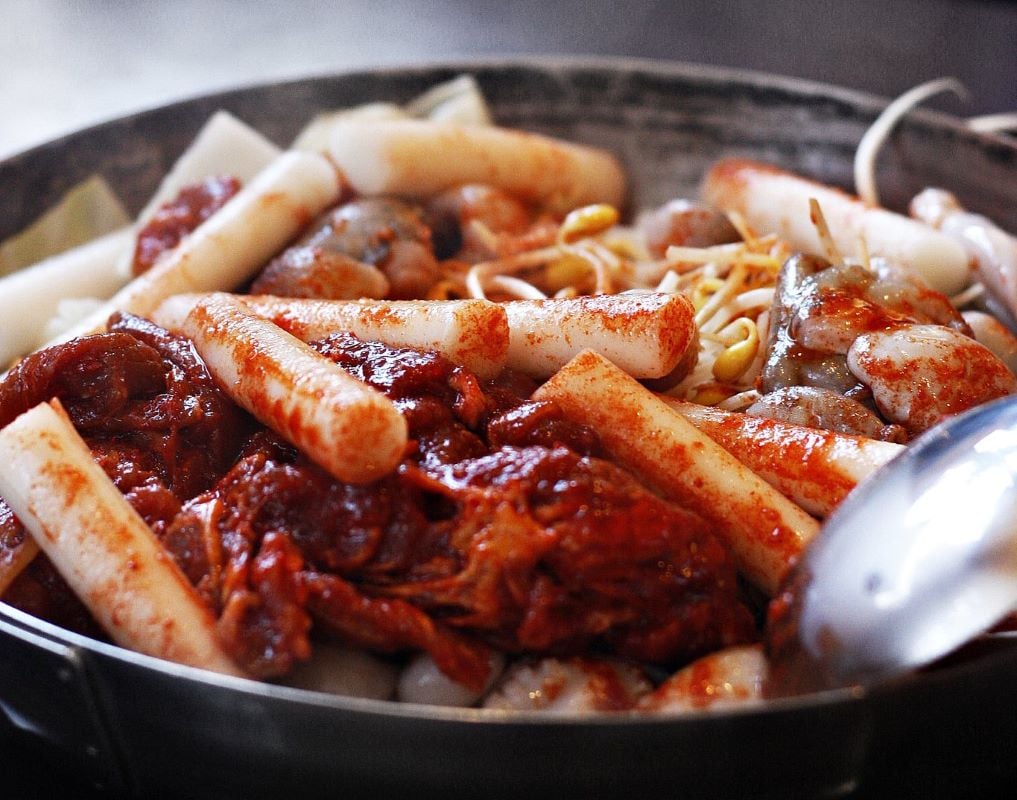
Kimbap and tteokbokki are two classic Korean eats that are cheap, delicious, and filling.
10. Understand Internet and Data in South Korea
Wifi is everywhere and internet speeds are lightning fast, but you’ll still want to stay connected when you’re on the move!
SIM cards and data plans tend to be pricy by Asian standards, and while you can get Korean e-SIMs at the airports, there’s a better option: a WiFi Egg rental.
You can check out a list of rental options here , and any of them will keep you connected to Korea’s ridiculously fast internet while you’re on the go without breaking the bank.
11. Korea Isn’t Cheap
Expenses in Korea aren’t quite as scary as Western Europe in summer but this isn’t Thailand either, so you need to be prepared to spend a little more.
Hostels will cost at least $15 USD/night but usually a bit more, and proper meals will start at around $8.
Public transportation is cheap, but going to a different city is going to cost a bit more: between $10-$50 depending on how far you’re going.

We’ve tested countless backpacks over the years, but there’s one that has always been the best and remains the best buy for adventurers: the broke backpacker-approved Osprey Aether and Ariel series.
Want more deetz on why these packs are so damn perfect? Then read our comprehensive review for the inside scoop!
12. Bring Masks to Protect Yourself from Pollution
Korea and neighboring China are heavily dependent on coal for their energy needs, and as a result, the skies can occasionally have dangerous levels of smog, especially in big cities.
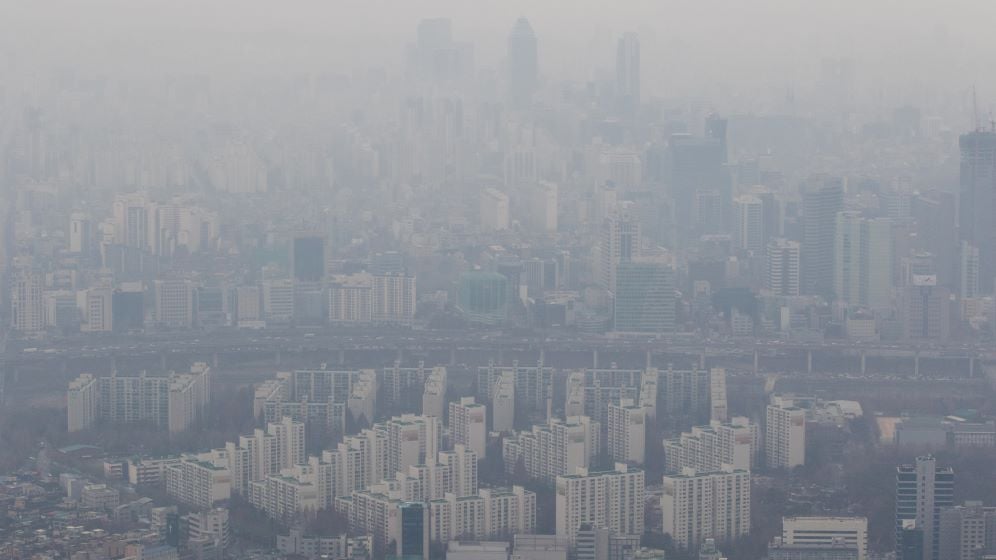
Masks are technically not an essential, but you’re going to want to have a few masks on hand to help you deal with this problem.
Just to give you an idea of how bad this can be sometimes: I’ve had an easier time breathing whilst hiking in difficult conditions at 5000m+ altitudes than I’ve had while just sitting outdoors at a café in Seoul trying to enjoy my coffee on a day when the pollution is at its worst.
13. Pay Attention to the Rules
Koreans are meticulous rule-followers, and it’s very important to keep this in mind when planning a trip to South Korea.
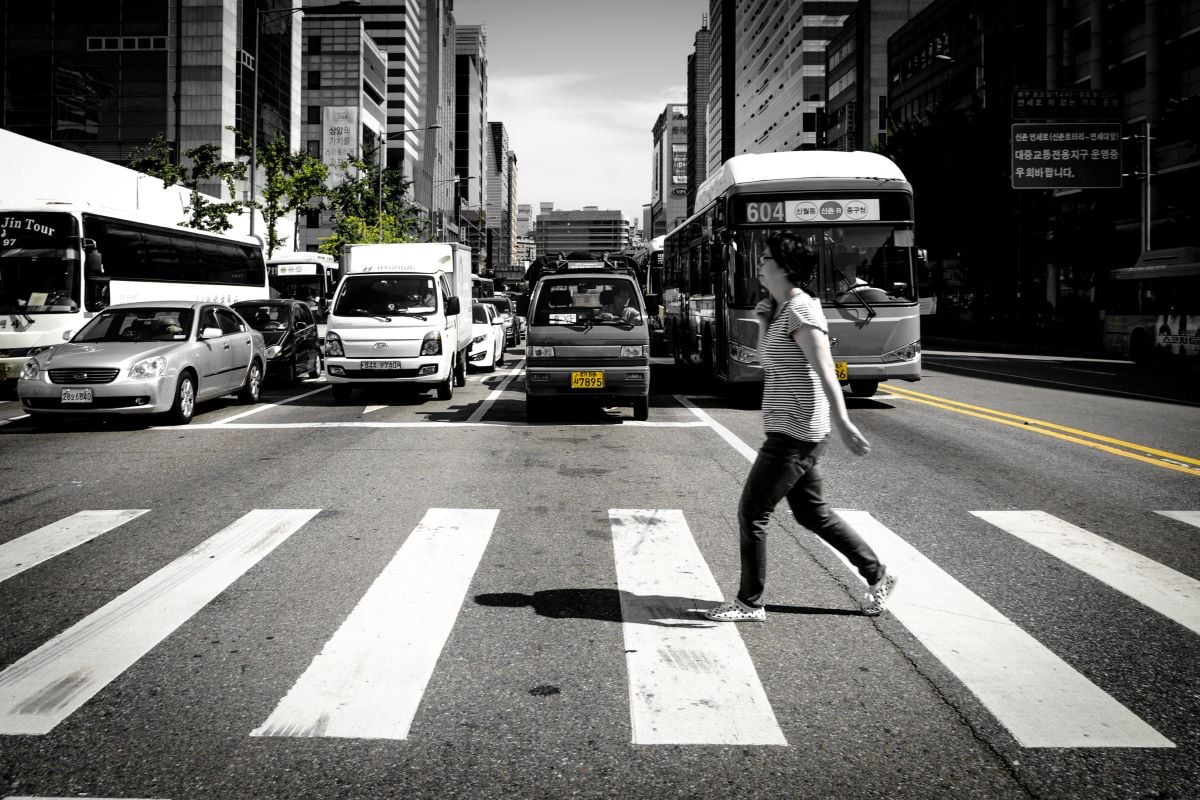
No matter how ridiculous a rule might seem to you, Koreans will obey it almost without exception. Even if it’s 3am and the roads are completely empty, a pedestrian is going to wait until the crosswalk turns green before they think about venturing out onto the empty road while the sign is red.
Many countries are really loose with the law but this is not one of them, so make sure that you’re completely respectful of the rules when you’re visiting South Korea.
A Few South Korea Cultural Travel Tips
Respecting Korean societal norms are SUPER important. Let’s get into a few of them…
14. Don’t tip
This might come as a huge relief to visitors, especially for Americans, but it’s important to know that tipping isn’t really a thing in Korea. Very rarely a place will ask for tips for its workers, but otherwise you should avoid tipping in all situations.
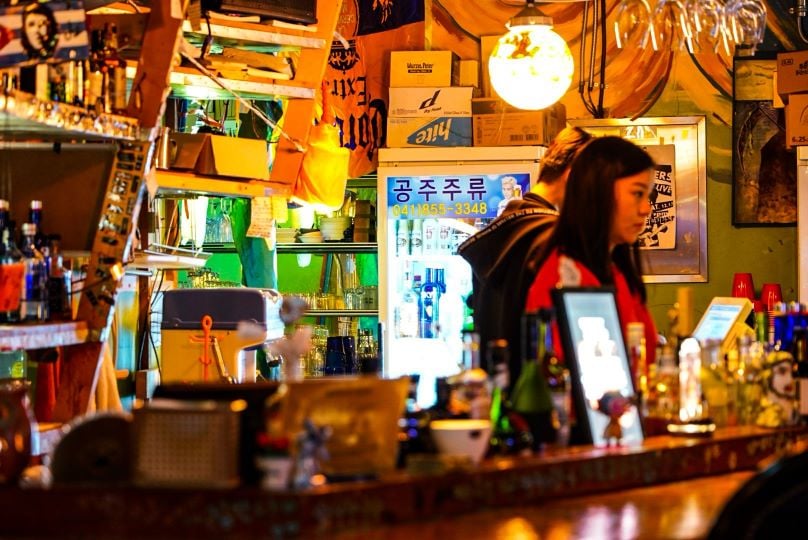
15. Politeness and respect are non-negotiable
Korean culture is deeply rooted in visibly showing respect for others, and it’s important to adopt that attitude while you’re visiting South Korea. Sass and sarcasm are looked down upon in nearly all situations so it’s best to avoid using those entirely.
16. Koreans tend to be reserved
While Koreans are very polite and hospitable, they are usually pretty reserved and it takes awhile for them to open up, so don’t worry if it seems like they’re not too friendly at first!
17. Learn to Read Korean
Okay, I realize this might sound insane, but hear me out!
Hangul – the name for the Korean alphabet – is incredibly easy to learn how to read and will take you an hour or two max to get the basics down.

Just a bit of study goes a long way in helping you read signs and menus, making this a great return on investment for your time.
Even if learning languages isn’t your thing, I promise you that this is way easier than it sounds and strongly recommend giving it a try!
18. Understand When to Visit South Korea
Autumn and Spring are majestic.
Japan gets a lot of recognition for its stunning seasonal colors (and rightly so!) but these seasons in Korea are just as magical and can’t be missed.
It’s also way less crowded than Japan, and the colors you’ll see here are simply unreal.
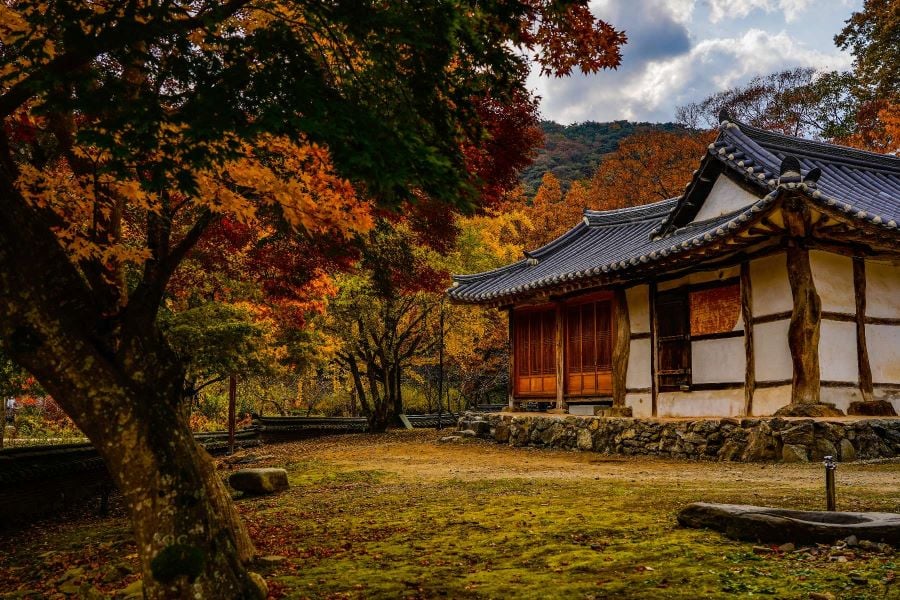
These are not busy seasons in Korea as far as foreign tourism is concerned, so you’ll have a lot more space than you would in summer.
You’ll have to get out of the city to see these colors at their best, and Magoksa Temple is one of the most stunning locations in Korea during peak foliage!
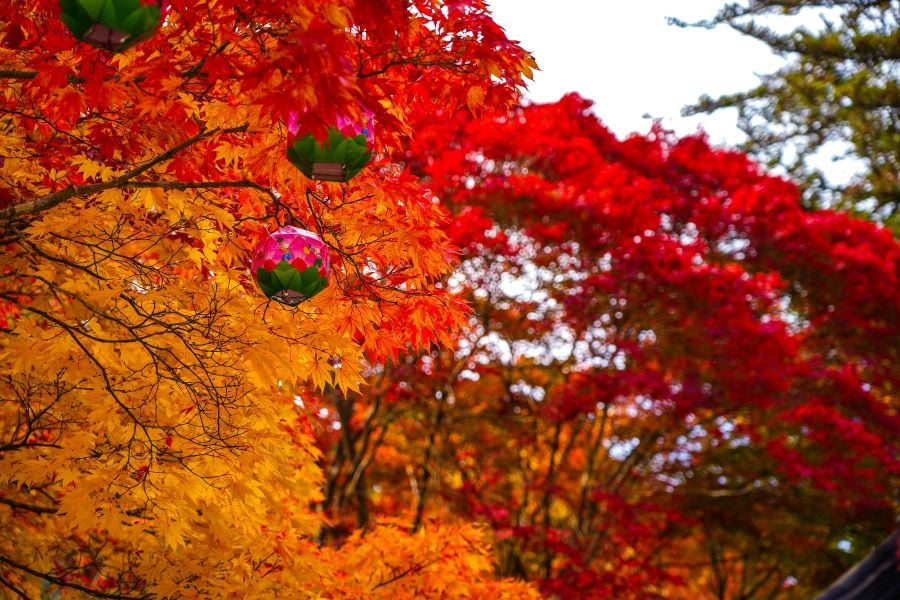
Magoksa Temple is not too far from Seoul so it’s very accessible. If you’re in Korea during Autumn, this spot is a can’t-miss.
If you’re keen on visiting South Korea during Spring, you will see spellbinding cherry blossoms pretty much everywhere you go, but Seoraksan National Park on the east coast is one of the best spots in the country this time of year.
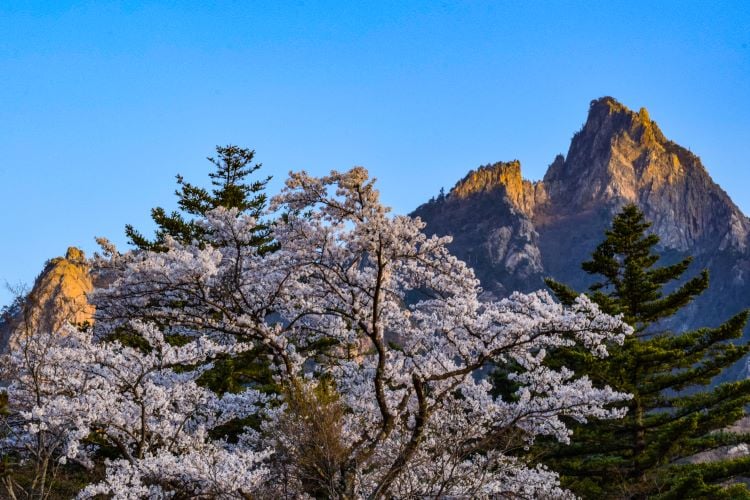
This one’s a bit further out of the way as it’s a 3-hour bus ride from Seoul, but it’s more than worth it! I’ve made the trip out to Seoraksan multiple times and it still isn’t enough.
Going to South Korea in summer is going to be a non-stop sweatfest and while winter can be utterly breathtaking, it’s freezing cold, so Autumn and Spring are the ideal seasons to visit Korea.

Stash your cash safely with this money belt. It will keep your valuables safely concealed, no matter where you go.
It looks exactly like a normal belt except for a SECRET interior pocket perfectly designed to hide a wad of cash, a passport photocopy or anything else you may wish to hide. Never get caught with your pants down again! (Unless you want to…)
19. Seoul is a Foodie’s Paradise
Not only does Seoul have tons of excellent spots for trying Korean food, but the capital is also home to cuisines from all over the world! Italian, Japanese, Mexican, barbecue of all kinds, and so much more: you name it, Seoul has it.
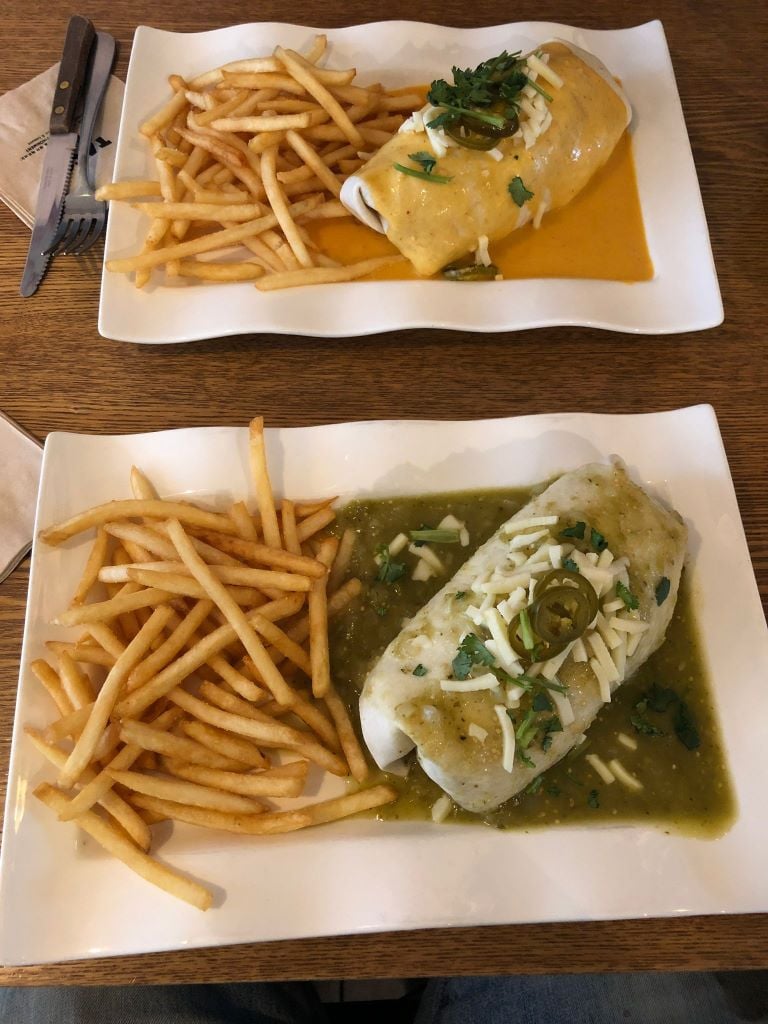
While you could easily dedicate an entire book to Seoul’s many restaurants, here are a few highlights!
One of the best Mexican restaurants I’ve found anywhere in East Asia is Taco Amigo , located right in the heart of Itaewon.
Just up the road and right on Itaewon’s main street is Vatos , a Mexican fusion restaurant that has a seemingly infinite number of delicious meals to try out.
If you’re craving some classic Texas BBQ, Low and Slow Itaewon has got you covered.
The Royal Food and Drink is a cliffside restaurant with a stunning view of Seoul and serves a majestic brunch that will send you into a food coma.
Not only one of the best brunch places in Seoul but one of the best I’ve been to anywhere, meals here are unforgettable.
Whether you’re looking for izakayas, Levantine restaurants, kebabs, Mexican, or pretty much anything else: this city is a paradise of cosmopolitan cuisine, and taking advantage of that is a must.
Seoul does have unforgettable KBBQ restaurants and countless more excellent Korean restaurants, but the best (and cheapest) Korean food will be found beyond Seoul’s expansive boundaries!
20. Being Vegetarian or Vegan in Korea Isn’t Easy
As with a lot of Asian countries, it can be a challenge to navigate the food scene if you’re vegetarian or vegan. When visiting Busan , Seoul, Daegu, and other larger cities, many restaurants can cater to your diet but in the countryside, you’ll find that your options are much more limited.
Thankfully, Korean food does have some options for those of you who don’t eat meat!
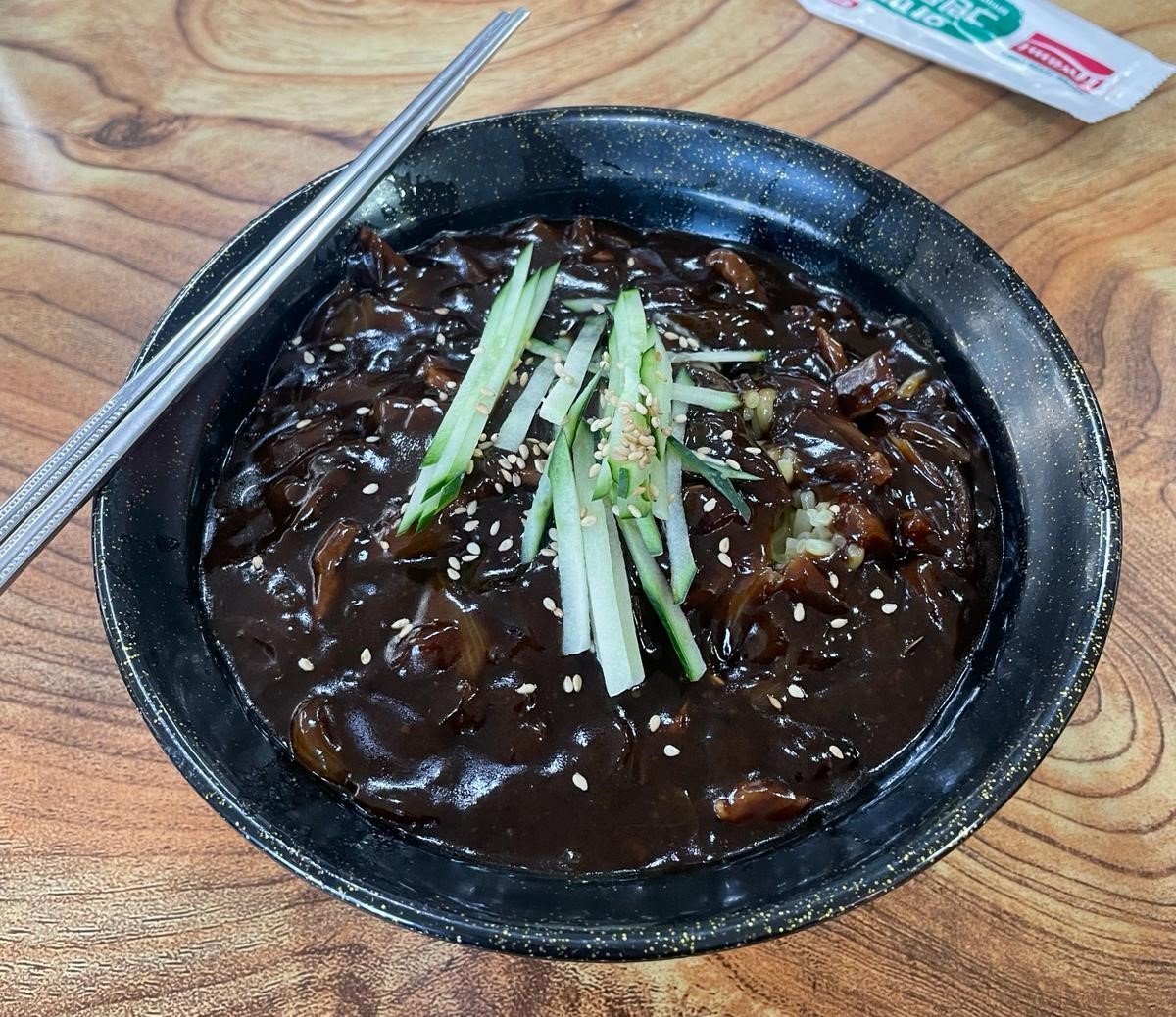
Vegetarian mandu (dumplings), kimbap, and bibimbap are all tasty vegetarian dishes that you can’t miss out on, and jjajangmyeon is one of my personal favorites.
If you’re at a restaurant and ordering food that may or may not come with meat, like dumplings, just ask the waiter for “gogi opsoyo” (“no meat”) and you’ll be all set.
21. Explore Korea’s Amazing Café Scene
Going to South Korea means you get to explore a café scene which is second to none. A massively diverse range of cafés awaits travelers from the traditional to ultra-modern and quirky.
Seoul itself is home to countless unique, very photogenic cafés that you could probably spend a lifetime venturing through.
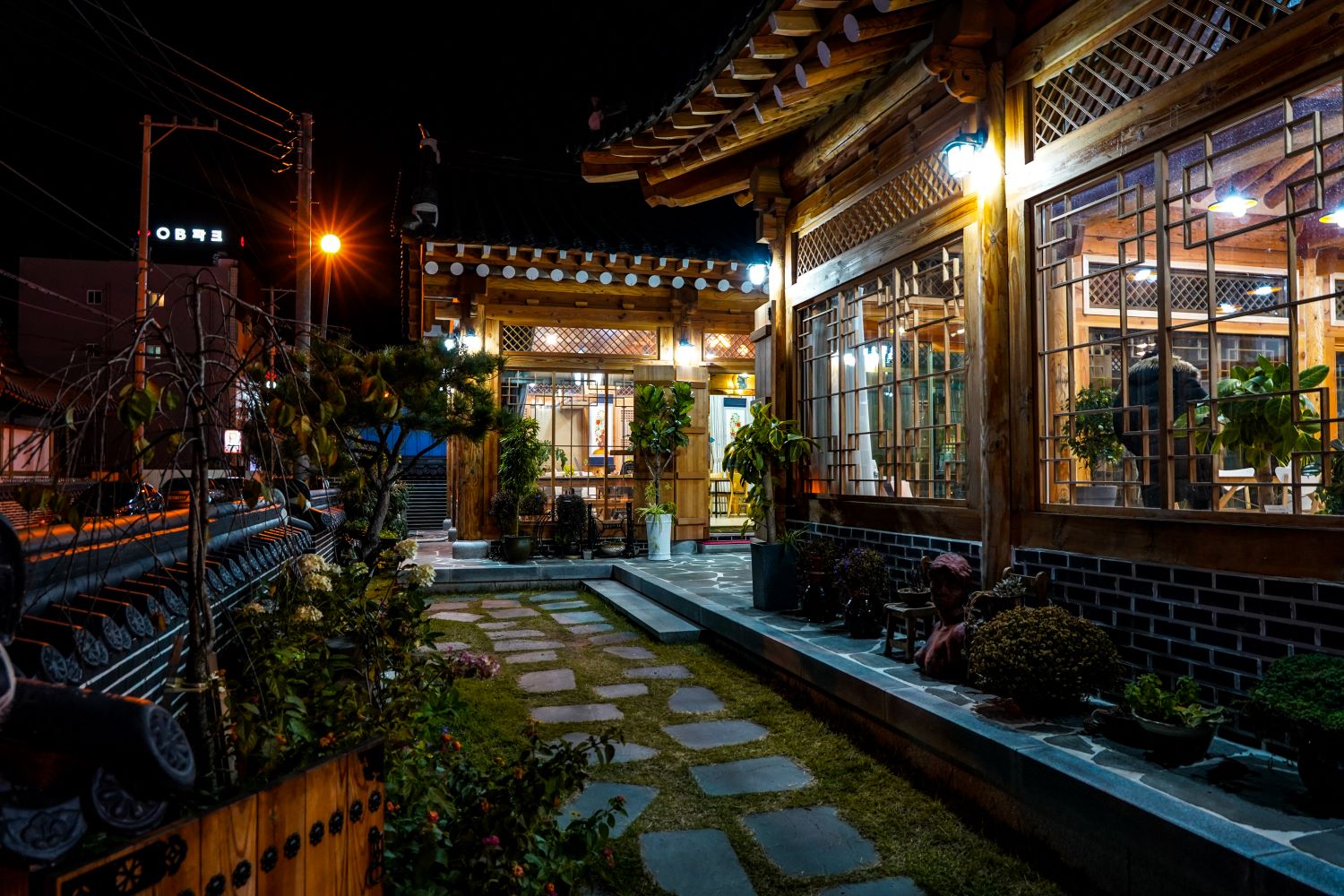
One of the capital’s most iconic spots is C.Through Café, which you’ll find here . Not only are the drinks delicious, but they also look so good that you almost feel bad for drinking them.
The coffee itself may or may not be what you’re looking for depending on your own personal tastes, but Korea’s cafés and teahouses are so diverse and incredible that I highly recommend you spend some time exploring what they have to offer!
22. Discover Korean Meals You Might Not Know Of!
Korean BBQ, samgyupsal, and kimchi are famous Korean culinary exports for good reason, but there are so many more Korean dishes that any backpacker worth their salt has got to try at least once.
Dakkalbi is a truly epic dish served in a massive pan that contains meat, rice cakes (called dak), vegetables, spices, and more depending on what you request.
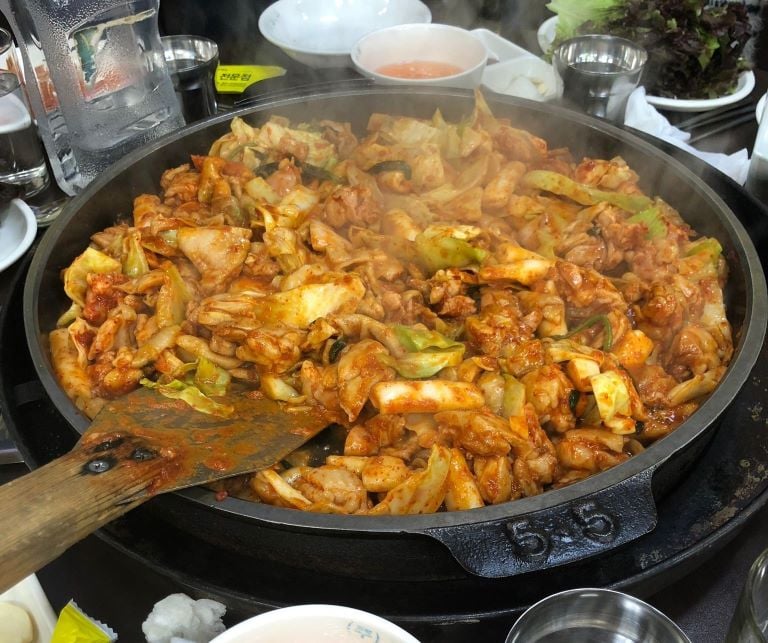
This is the perfect meal to have after you’ve worked up a huge appetite from exploring all day, and best to share with friends.
Quite possibly my favorite Korean meal is jjimdak. Often served in an enormous pan, this dish consisting at its core of chicken, glass noodles, rice, spices, and onions is a gluttonous, decadent meal that everyone should reward themselves with, and you can add more to the pan to mix things up a little.
Hint : add cheese.
23. Get Lost in Seoul’s Insane Nightlife
Seoul’s nightlife is famous and for very good reason: it’s amazing .
Coming out of a difficult few years due to the COVID pandemic, the capital’s bars and clubs are slowly returning to their former glory.
Gangnam, Itaewon, and Hongdae each have an endless supply of bars, restaurants, and clubs to explore that are wild fun, and a visit to Seoul is incomplete without at least a few sleepless nights spent in these districts.
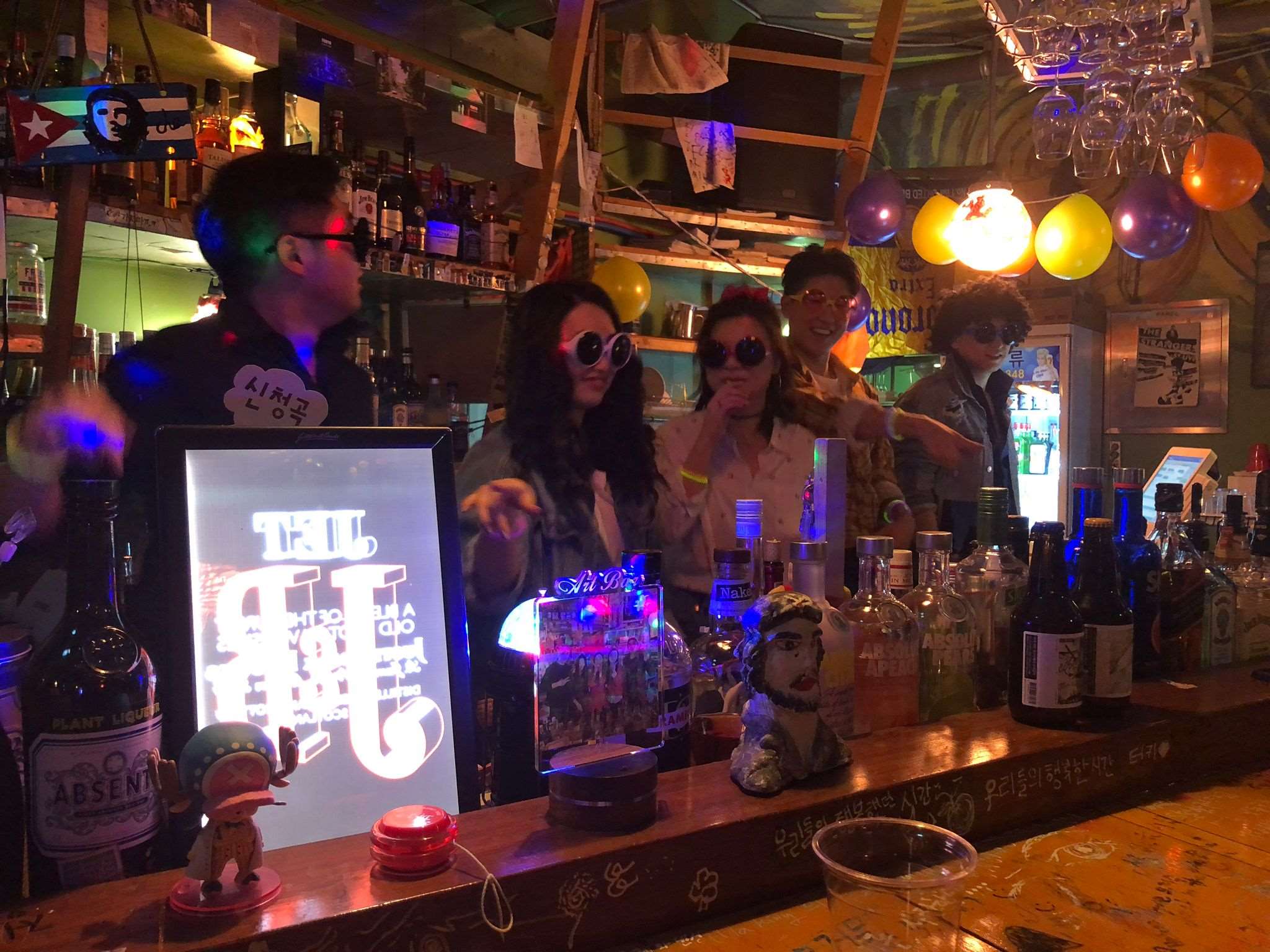
You’ll also find unique escape rooms, board game cafés, and more.
It’s simply not possible to list all the things you can do in Seoul, which is exactly why you should get hopelessly lost in wandering through this amazing city’s nightlife.
24. Get Off the Beaten Path
South Korea is rightly well-known for being a haven of futuristic cities, shopping, and lightning-fast internet, but it’s so much more than that!
This is a country where ancient wonders mix with natural beauty in a way that doesn’t happen anywhere else, and one of the best tips for traveling to South Korea I can give you is to journey away from the typical tourist loop of Seoul, Busan, and Jeju.
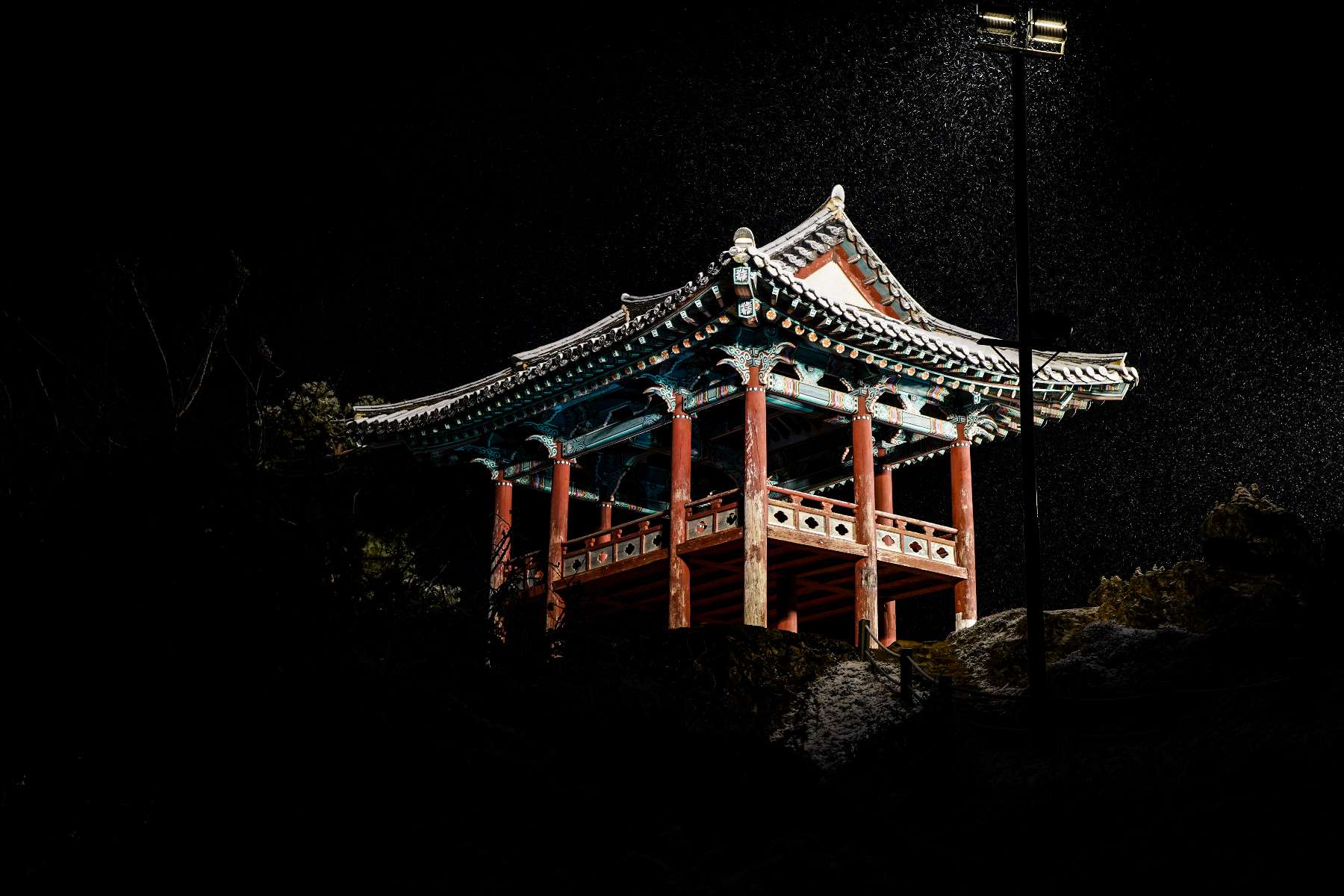
That might seem like hard advice to follow in a tiny country that’s so modernized, but venture beyond the confines of the cities and you’ll find a side of Korea that most people don’t see.
Experiencing Korea’s ancient, rich culture and all the gems hiding in its many hills simply can’t be missed out on, and this is what makes going to South Korea an unforgettable experience, far more so than a night out in Seoul or Busan.
25. Know Which Places to Stay/Avoid
Korea has no shortage of great hostels to stay at that range from cozy and classy to social and wild, but here are just a few to keep in mind:
If you’re looking for a good time in Seoul that doesn’t involve much sleeping, The Time Traveler’s Party Hostel in Hongdae is hard to beat. Fun and social with a downstairs bar and a crew that goes out into Hongdae’s vibrant nightlife every night, this is the place to be for all kinds of partiers.
Its sister hostel, Time Travelers’ Relax Guesthouse , is for backpackers looking for something more low-key and restful. Also in Hongdae, this hostel is in a quiet neighborhood that’s just a short distance from the district’s unbelievable nightlife scene, so it gives you the best of both worlds.
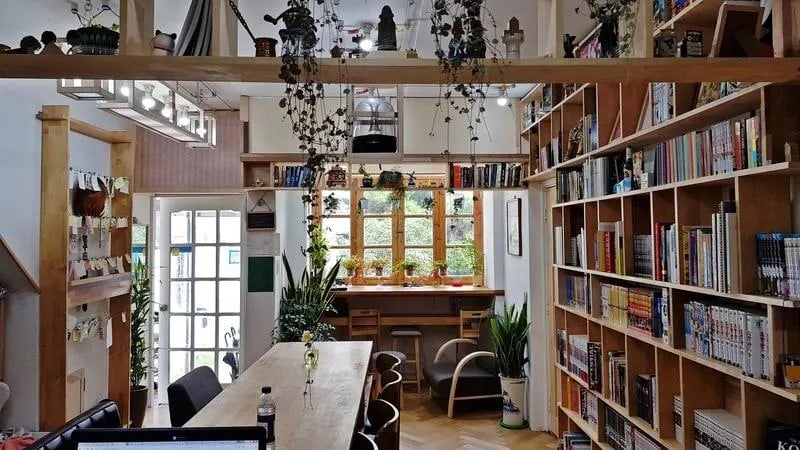
Seoul Cube Itaewon is also an incredible hostel with a great reputation, and its location right in the center of Itaewon is basically unbeatable!
When it comes to Seoul – and Korea in general – pretty much any hostel or guesthouse you choose is going to be solid with one exception: the Hongdae Bird’s Nest Hostel. This is the one place I recommend you absolutely avoid at all costs unless you have no other choice.
You might be tempted by its low prices and convenient location (I was!), but the facilities are less than ideal and the management is strange, unhelpful, and at times very unfriendly to guests. Avoid, avoid, avoid.
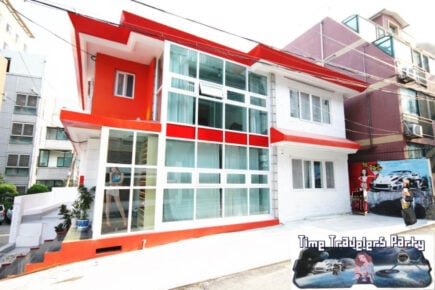
Time Traveler's Party Hostel
With a basement bar and a perfect location just 7 minutes from Seoul's Hongdae neighborhood, this is the best hostel for those looking to get the most out of the city's epic nightlife. It's super social, and you can even get a taste of authentic Korean BBQ every Friday night at their weekly group dinners.
26. Travel With Good Insurance!
Travel insurance is one of the most essential items all travelers simply should not go without, and you need to make sure you’re covered in the event a disaster happens!
Korean healthcare is some of the best – and most affordable – in the world, but you still don’t want to be stuck paying for 100% of a hospital bill.
That’s where SafetyWings comes in: at $40 per month and contract-free, this is an excellent choice for travelers and digital nomads.
Having that peace of mind that you’re covered in case of emergencies is priceless, so don’t forget to sign up before you set out on your travels: it could make all the difference.
ALWAYS sort out your backpacker insurance before your trip. There’s plenty to choose from in that department, but a good place to start is Safety Wing .
They offer month-to-month payments, no lock-in contracts, and require absolutely no itineraries: that’s the exact kind of insurance long-term travellers and digital nomads need.

SafetyWing is cheap, easy, and admin-free: just sign up lickety-split so you can get back to it!
Click the button below to learn more about SafetyWing’s setup or read our insider review for the full tasty scoop.
So is South Korea Worth Visiting?
100%, absolutely, undeniably yes. Not only is it more than worth the effort, I stand by the fact that Korea is one of Asia’s greatest countries to travel in.
Temples, towers, unforgettable nights, delicious food and more await travelers who make the trip to this unique land caught at a crossroads.
Going to South Korea is the experience of a lifetime and when your trip is at an end, no matter how long it is, you’ll find yourself wanting more.
I hope you’ve learned something from these South Korea travel tips. Now all that’s left is to book that ticket.
A wild ride awaits!
- Become a MASTER traveler with our epic travel tips.
- Embrace your backpacker spirit and travel off the beaten path , because… why not?
- Our killer guide to living in hostels will transform your stay. Check it out!
- Get off the couch and into the great outdoors with our hiking guide .
- Or… explore more of the region and go backpack Japan .
- See what most backpackers do not with an epic trip to China .
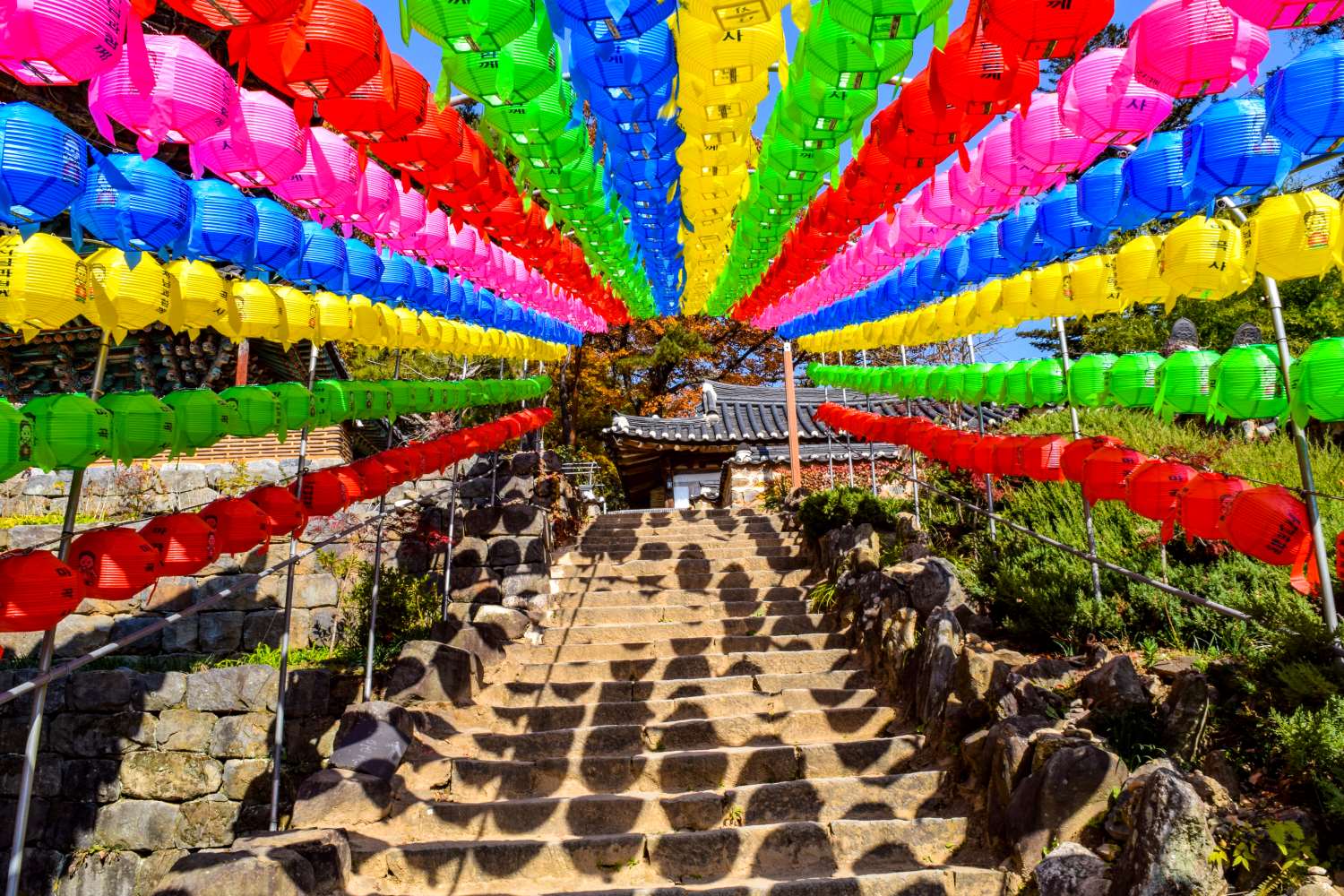
Nathan Jordan
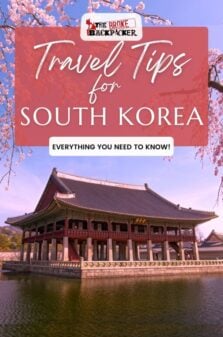
Share or save this post

Leave a Reply Cancel reply
Your email address will not be published. Required fields are marked *
Save my name, email, and website in this browser for the next time I comment.
Notify me of followup comments via e-mail.
May 29, 2024
5 Reasons You Must See “The Shape of…
The gold gala: oscar winners, olympians and business…, all the 2024 baeksang arts award winners for…, ready, set, binge the 10 best k-dramas on…, “beyond utopia”: fleeing from paradise.
Join Our Newsletter

- Korean Childbirth Traditions
- HWANGAP 60TH BIRTHDAY
- LEARN THE KOREAN LANGUAGE
- KOREAN ZODIAC
- Korean Weddings
- TRAVEL GUIDE
- RESTAURANTS
- FOOD STORIES
- K-DRAMA & MOVIE
- South Korea Travel Guide
Where to Go, What to See & How to Stay on Budget
By Patricia Liu and Joel Marinan
There has never been a better time to visit South Korea. Clean, modern, sophisticated, and ultra safe, Korea is a destination that you will want to come back to again and again. With the rise of Korean culture and entertainment throughout the world, the country is experiencing a renaissance of sorts, especially for foreigners who wish to experience all that Korea has to offer.
Korea has always been a fascinating country to visit and deserves a place on everyone’s travel bucket list. Known for its stunning blend of tradition and modernity, Korea features futuristic technology, bustling markets, and a thriving pop culture scene. There are no guns or drugs allowed in Korea, and visitors can expect a high level of safety and cleanliness while exploring the country. Also of note is that Korea is a no tipping culture, so savoring the delicious cuisine is extra affordable, as are the cab rides to restaurants and other destinations.
Speaking of affordability, the exchange rate between the Korean won and the US Dollar has been very favorable for Westerners, which is another perk of traveling to Korea right now.
Our South Korea Travel Guide shows you where to go, what to see, and when to travel. Start your journey with itinerary ideas and pre-travel tips, the best day trips, and lots more essential Korean travel advice. Let’s go!
Here are some of our most popular articles that will help you make the most of your trip to South Korea.

A Local’s Guide to Gyeongju
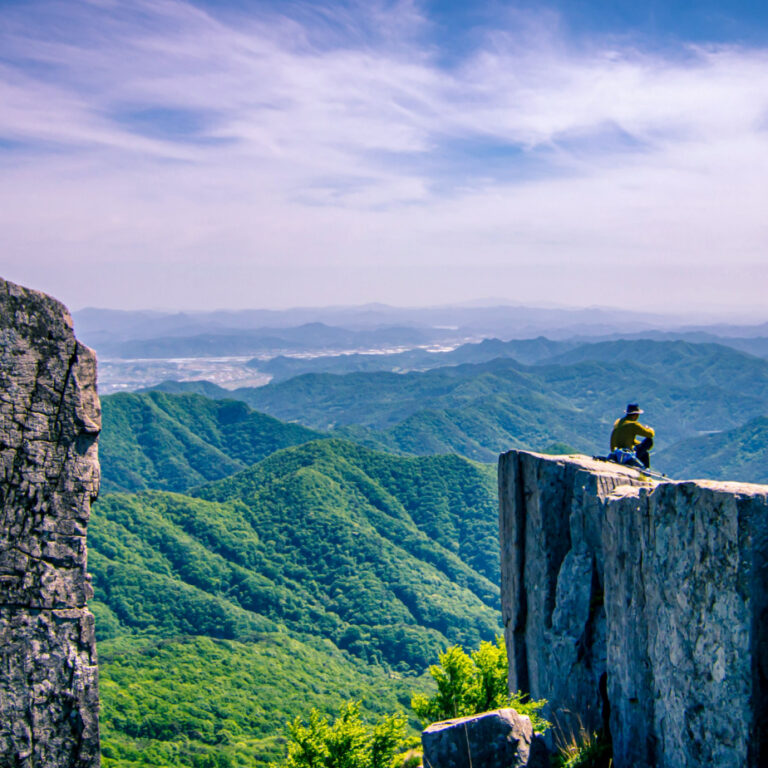
What To Do in Korea in May: The Family Month
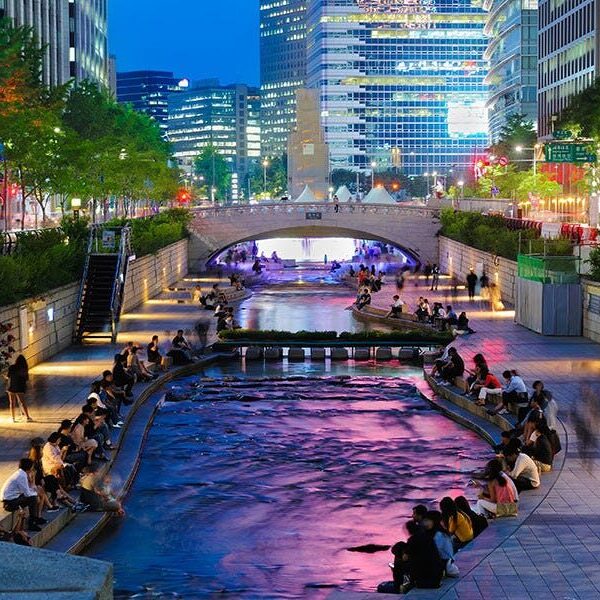
19 Did-You-Knows About Korea
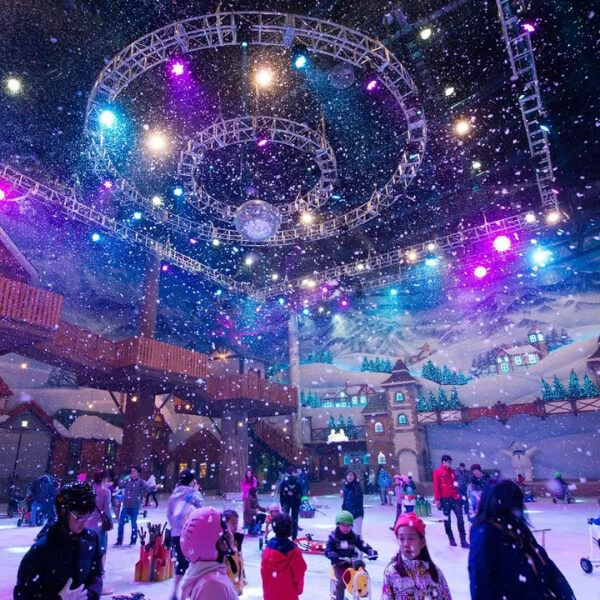
10 Ways to Spend a Magical Christmas in Korea

Hiking in Seoul, the Top 5 Mountains You Must Try

Jeju Island: Top 10 Places You Must See
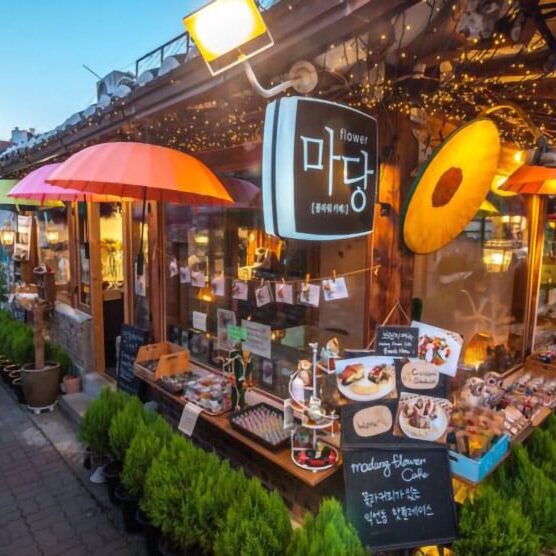
19 Best Things to Do in Seoul Right Now- An Insider’s Guide
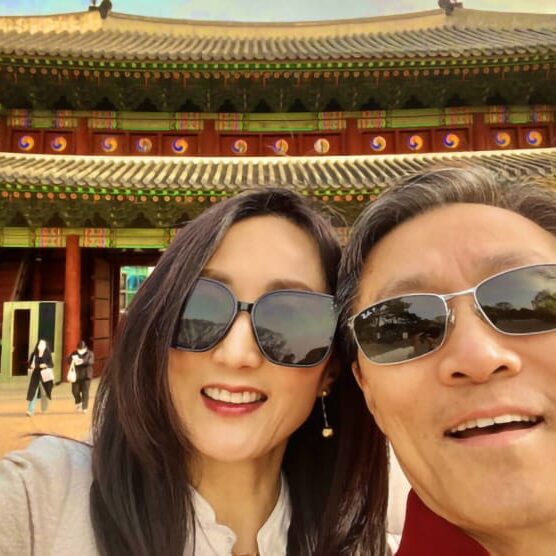
23 Reasons Seoul Will Be Your New Favorite City
Latest travel updates.
- Vaccination is NOT a requirement for entry into Korea.
- There is no requirement on the passport’s remainder validity for entry. You may travel to Korea as long as your passport remains valid throughout your stay in Korea.
- From April 1st, 2023, travelers from the USA, Canada, and 21 other countries no longer need to apply for the K-ETA to travel to Korea. This will run at least until 31st December, 2024 and is designed to make it easier to travel to Korea.

Planning Your Trip To Korea
Check the Korean Embassy for any possible travel restrictions.
- If you’re not sure where to stay, check out our guide to the best hotels in Seoul . You can find our recommendations for the best luxury, mid-range, and budget hotels in Seoul, as well as long-term apartments that you’ll love.
- For the best flight deals to South Korea, Best of Korea recommends Skyscanner and Expedia . You can find the cheapest prices and most convenient flights and buy the one that suits you best.
- For the best hotel prices in Seoul, Best of Korea recommends Klook 0r Agoda – they cover most hotels in Seoul and the rest of Korea and offer great prices without hidden fees.
- Before you travel to Korea, it’s a good idea to order an eSim card, regular sim card or portable WiFi router to collect at the airport so you’re connected as soon as you arrive. You can change a small bit of money before you travel, but you can also use the airport ATM to get some Korean won.
- There are large differences in exchange rates so you will need to do some comparing before you exchange a large sum of money. You can exchange USD to KRW easily at banks or money exchange shops in all major tourist areas like central Seoul (Myeongdong and Namdaemun are good places but the Coex Center also offers money exchange. You can also negotiate the exchange rate with the vendor if you think it is too high.
- You can withdraw cash from bank ATMs. Alternatively, use a pre-paid travel card like the one offered by Wise , which allows ATM withdrawals and payments and works perfectly in Korea.
- Don’t forget to bring a travel adapter for your electronics and leave plenty of extra space in your suitcase for the many Korean souvenirs and goodies you’ll buy on your tri
Do US Citizens Need A Tourist Visa?
No, travelers from the USA don’t need a tourist visa to enter South Korea. You can visit for up to 90 days visa-free.
Current COVID-19 Rules In Korea
Most COVID-19 rules in Korea have been dropped and now there are only 2 main rules to be aware of. First, face masks are mandatory when visiting medical facilities (hospitals). There is no longer a 7-day mandatory quarantine for people in South Korea. If you’re infected with COVID, the Korean government recommends a 5 day self-quarantine, but it’s not enforced. Travelers to Korea should follow the current restrictions or may be liable for fines or deportation.
Korean Tourism Support Hotline
If you have any concerns or problems when traveling in Korea, you can call 1330 . This is a dedicated tourism support hotline where trained specialists provide tourist assistance and is available in Korean, English, Japanese, Chinese, Russian, Vietnamese, Thai, and Malay.
US Government Travel Advisory For Korea
The U.S. Department of State currently has a level 1 travel advisory (Exercise Normal Precautions) for the Republic of Korea (ROK). Find out more about current travel advisories for South Korea on the Department of State website.

6 Best Destinations In Korea
South Korea is truly a country of contrasts. From the bustling, modern city of Seoul , with cutting-edge designer buildings, VR labs, and AI robots, to peaceful UNESCO World Heritage cities like Jeonju and Gyeongju , there are many unique places to explore.
There’s nothing worse than coming back from vacation and hearing about incredible places you missed that you wished you’d seen, such as a beautiful Buddhist temple by the beach (Haedong Yonggungsa Temple) or a leafy island getaway where deer and rabbits roam freely (Nami Island).
Here are 6 of the best destinations in Korea that you absolutely must visit, as well as some of the sights you’ll want to check out while you’re there. We’ll be bringing you lots more detailed destination guides in the future, so be sure to visit again soon.
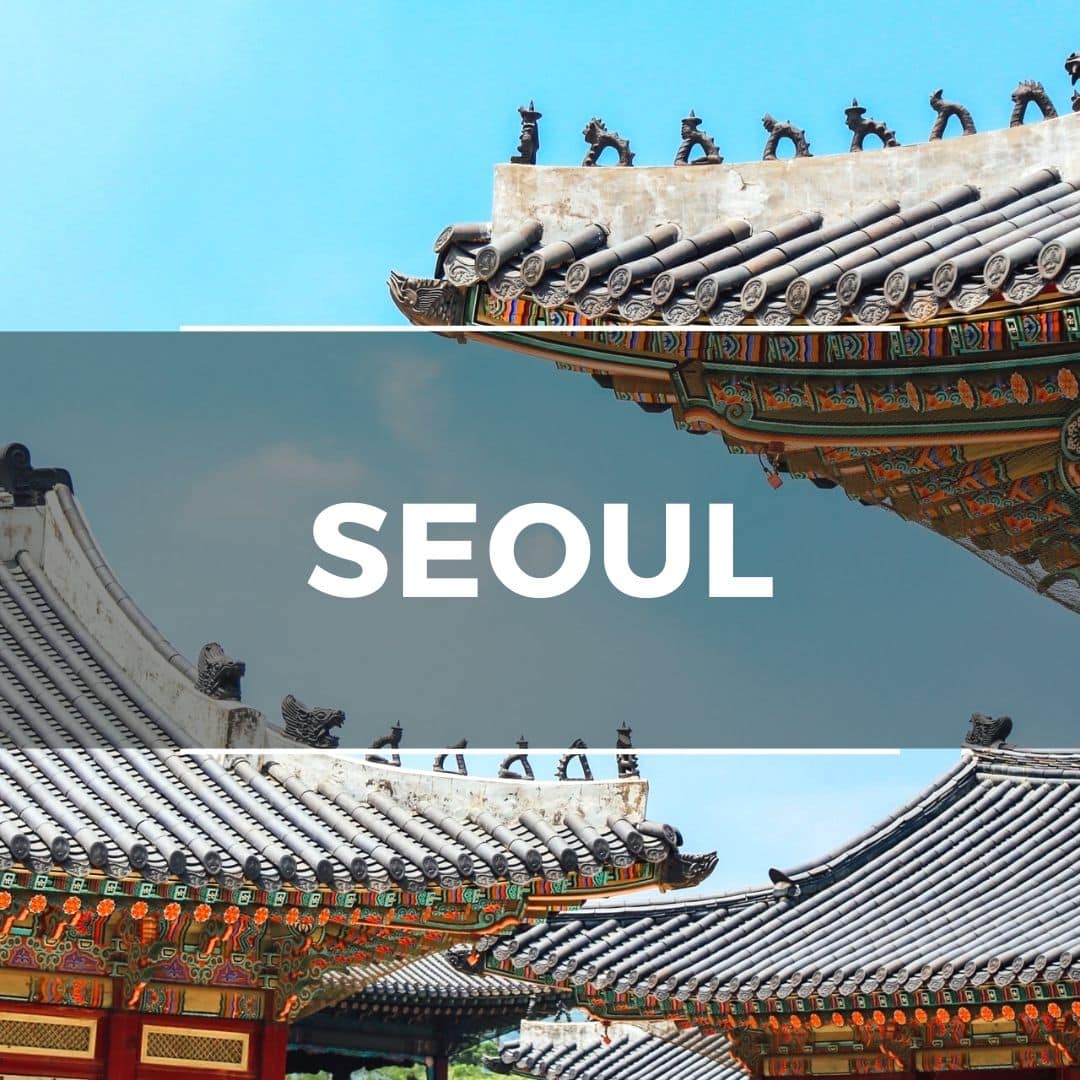
Korea’s Busy Capital
Seoul is Korea’s largest city, capital, and first, stop for most travelers to Korea. There are many beautiful places in Seoul , including landmarks, relics from ancient kingdoms, towering skyscrapers, Buddhist temples, Michelin-starred restaurants, and some of the best street food you’ll find in the world. If you see only one city in Korea, you should definitely visit Seoul.
You’ll never be bored in Seoul. Whether you’re traveling as a family, as a couple, or by yourself, there’s so much to do. Be sure to plan lots of time to check out Korea’s capital.
This Full Day Tour of Seoul will show you some of the hottest spots in the city, while this Customized Private Tour of Seoul will allow you to choose where to go.
Here are 10 of the best Seoul attractions:
- Gyeongbokgung Palace
- Bukchon Hanok Village
- Starfield COEX Mall
- Bukhansan National Park
- Myeongdong Street Markets
- Lotte World Tower
- Secret Garden (Changdeokgung Palace)
- Dongdaemun Design Plaza
- N Seoul Tower
- Yeouido Hangang Park

Korea’s Second City
Busan, Korea’s second city, is a thriving port city far away from Seoul both physically and culturally. This popular summer destination features some of Korea’s most popular beaches and bars. Explore Busan and you’ll find sprawling markets, fresh seafood, film festivals, the world’s largest shopping mall, coastal temples, and lots more.
Busan is a city with some very photogenic sights. See the sunrise on the beach, hike around leafy coastal streets on the side of cliffs, and marvel at the wide range of (living!) seafood in the markets.
This Full Day Tour of Busan will show you the best beaches, markets, and local sights, while this Customized Private Tour of Busan will allow you to choose where to go.
Here are 10 of the best Busan attractions:
- Haeundae Beach
- Gwangbokdong Food Street
- Haedong Yonggungsa Temple
- Huinnyeoul Culture Village
- Gamcheon Culture Village
- Oryukdo Sky Walk
- Lotte World Busan
- Jagalchi Fish Market
- BIFF Square & Centum City Mall
- Taejongdae Resort Park
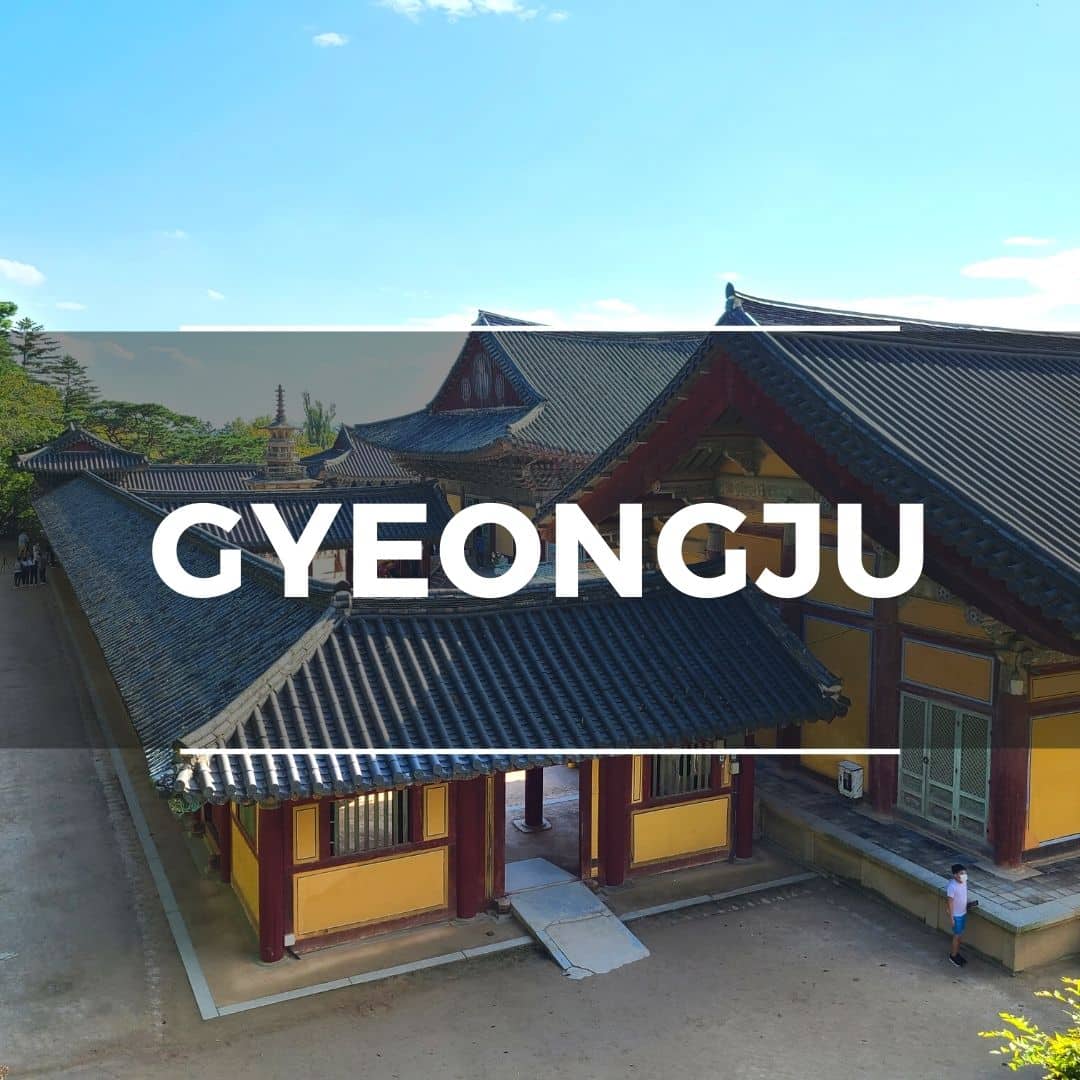
UNESCO City
Gyeongju is the former capital of the Silla Kingdom, part of the Three Kingdoms part of Korean history. These days, Gyeongju is an open air museum housing Korea’s finest history and monument. This UNESCO World Heritage City is a must-see for those who want to learn more about Korea’s deep cultural past.
Gyeongju is packed with temples, palaces, historical sights, and monuments. But it’s not just the history that draws the crowds, the city is an area of natural beauty, lined with cherry blossoms and shadowed by misty mountains.
This Full Day Tour of Gyeongju from Busan will take you around Korea’s open-air museum city, showing the top UNESCO sites along the way, while this Customized Private Tour of Gyeongju will allow you to choose where to go.
Here are 10 of the best Gyeongju attractions:
- Gyeongju Historic Area
- Bomun Lake Tourist Complex
- Bulguksa Temple & Seokguram Shrine
- Donggung Palace & Wolji Pond
- Yangdong Folk Village
- Cheomseongdae Astronomical Observatory
- Gyeongju National Museum
- Gyochon Traditional Hanok Village
- Woljeonggyo Bridge
- Gyeongju National Park
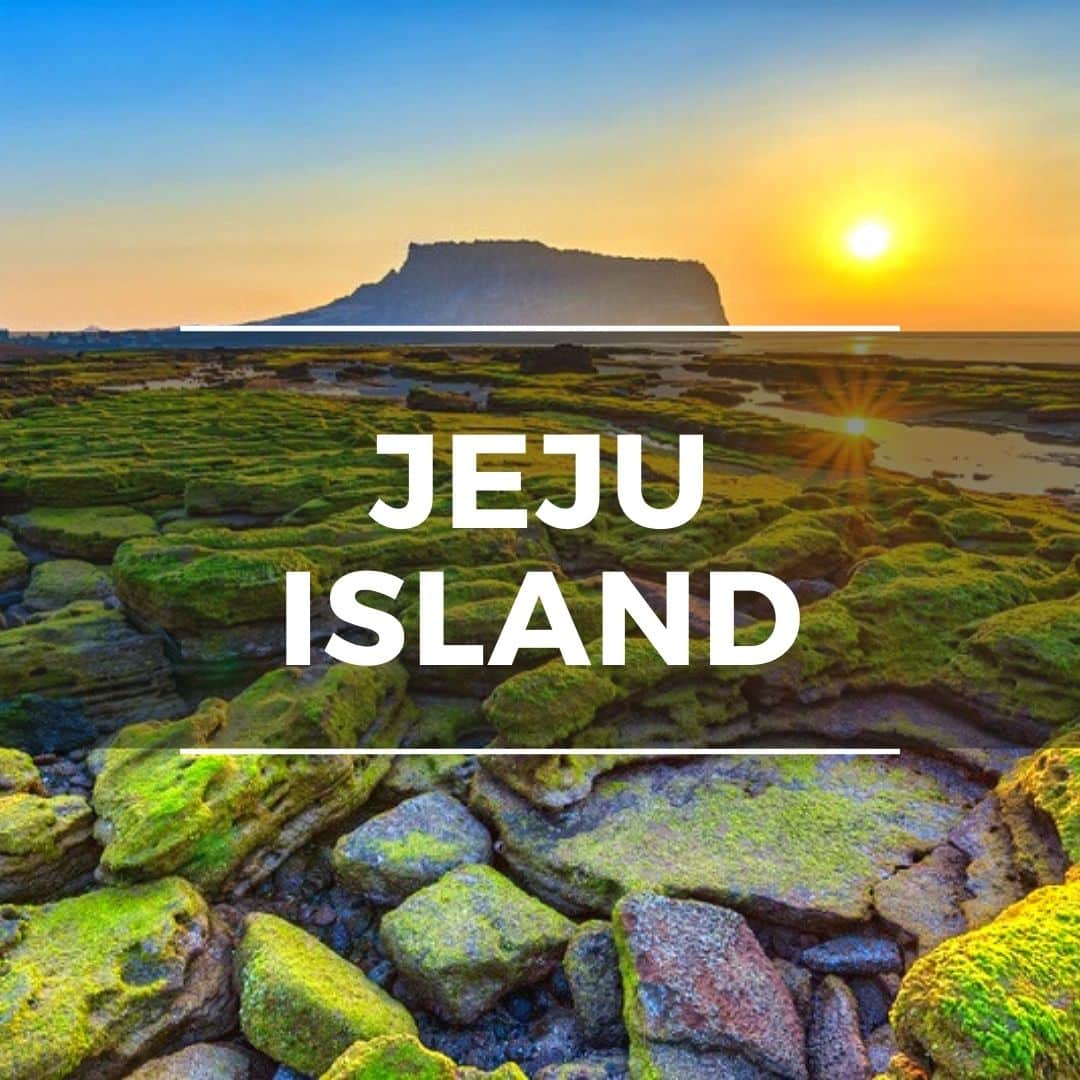
Natural Wonder
Jeju Island is Korea’s semi-tropical island that’s a popular vacation destination for locals and tourists alike. This area of outstanding natural beauty offers up rugged coastal walks, sandy beaches, green hills, and a volcano to hike up for those who enjoy a challenge. Culture and cafe lovers will also find Jeju Island a charm.
From snorkelling under the sea, to hiking above the clouds, sampling Jeju’s black pork BBQ, and drinking local green tea, there’s so many exciting activities, sights, tastes, and experiences waiting for you on Jeju Island.
This Full Day Tour of Jeju Island will show you some of the most incredible UNESCO World Heritage sites on Jeju’s East Coast, while this Customized Private Tour of Jeju Island will allow you to choose where to go.
Here are 10 of the best Jeju Island attractions:
- Seongsan Ilchulbong Sunrise Peak
- Jusangjeolli Hexagonal Lava Cliff
- Hallasan Mountain (Volcano)
- Hamdeok Beach
- Jeju Folk Village
- Hyeopjae & Geumneung Beach Areas
- Cheonjeyeon & Jeongbang Waterfalls
- Udo Traditional Island
- Yakcheonnsa Coastal Buddhist Temple
- O’Sulloc Green Tea Fields
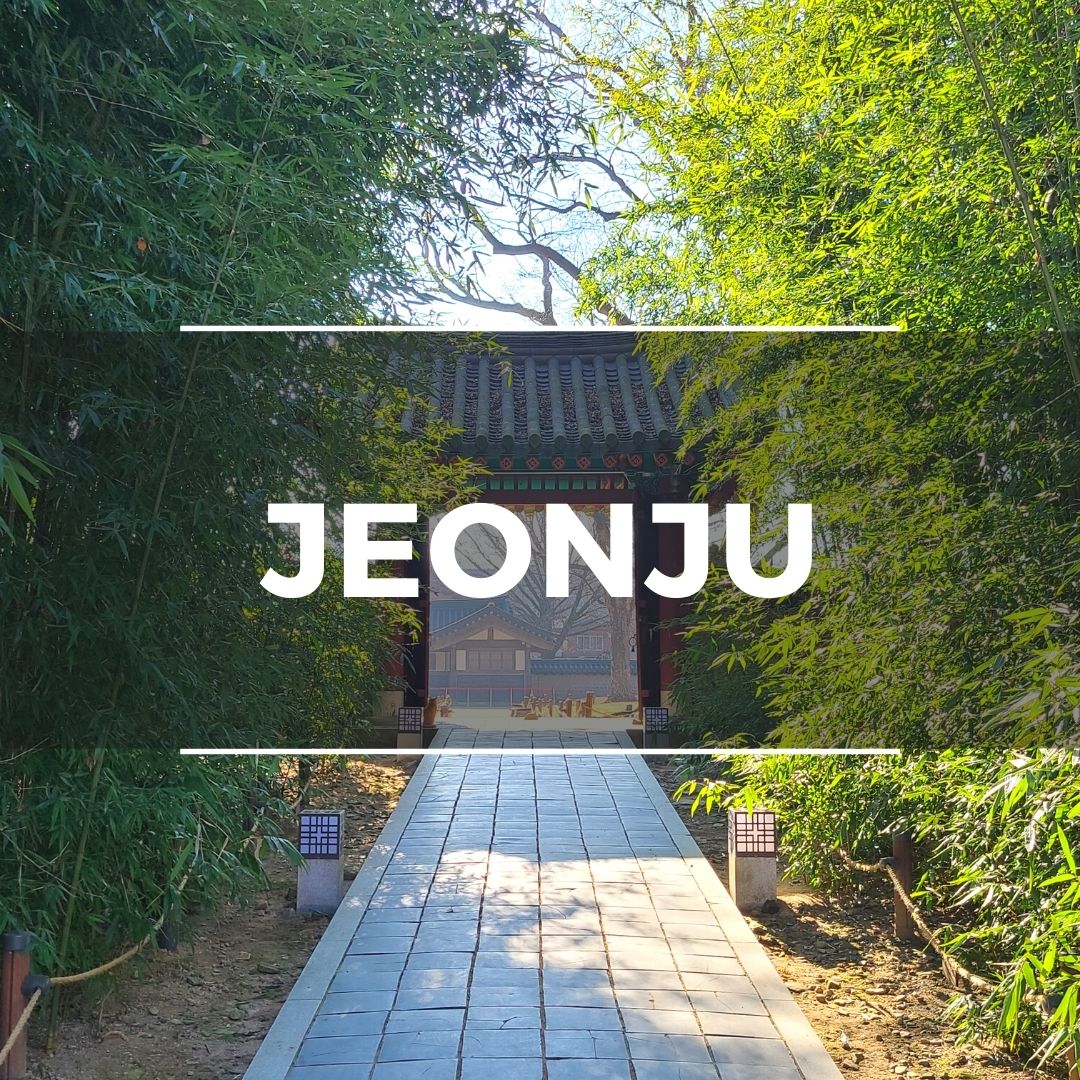
Traditional Korea
Jeonju is famous for its historical and cultural sights, including the sprawling Jeonju Hanok Village, packed with more than 700 traditional hanok houses. Jeonju’s many impressive sights are close to each other and perfect for a day trip from Seoul or Busan. You can even stay overnight in one of the traditional houses.
Jeonju is a tourist hotspot so there are plenty of things to keep travelers entertained and places to experience traditional Korean food and drinks. Be sure to check out the Jeonju bibimbap, one of Korea’s national dishes. Rent hanbok (traditional clothes), take lots of pictures, and see the sights.
This Full Day Tour of Jeonju will show you around the beautiful hanok houses and traditional Korean restaurants, while this 2-Day Tour of Jeonju includes an overnight stay in a hanok and lots of delicious Korean meals.
Here are 10 of the best Jeonju attractions:
- Jeonju Hanok Village
- Gyeonggijeon Shrine & Portrait Museum
- Jeongdon Catholic Church
- Jeonju Hyanggyo Confucian School
- Nambu Traditional Market
- Jaman Mural Village
- Omokdae Viewpoint
- Deokjin Park
- Hanbyeokdang Pavilion
- Taiji-ro & Hyangoyo-gil Shopping Streets
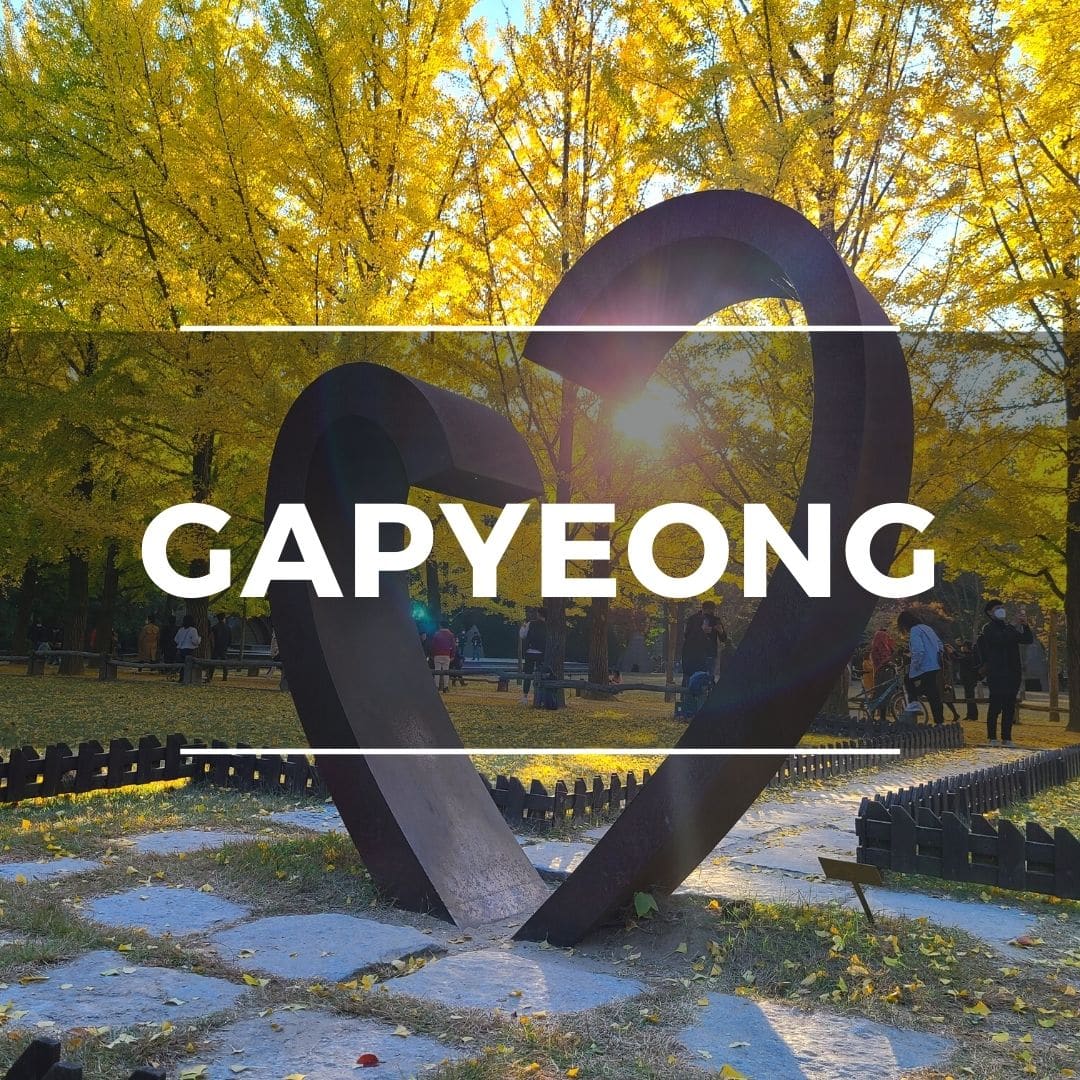
Rural Attractions
Gapyeong County is an area just outside of Seoul that’s home to several interesting attractions celebrating Korean and foreign culture. The lush green hills and blue rivers of Gapyeong make it a great place to immerse in Korean nature.
You’ll find some of the hottest day trip locations here. Explore Gapyeong County on a day trip from Seoul. You can see romantic tree-lined streets and cafes on Nami Island, explore one of Korea’s most beautiful gardens, take a trip to Petite France, and enjoy cycling through the hills on an abandoned railway track.
This Full Day Tour of Gapyeong will show you around Nami Island, Garden of Morning Calm, and the Rail Bike Park.
Here are 10 of the best Gapyeong attractions:
- Nami Island
- Garden of Morning Calm
- Petite France
- Ganchon Rail Bike Park
- Edelweiss Swiss Village
- Cheongpyeong Lake
- Jarasum Island
- Kalbongsan Recreational Forest
- Gapyeong Sledding Hills
- Nami Island Zip Line

There are loads of locations to visit in Korea that make for a perfect day trip from Seoul. Hop on a coach, train, or tour bus in the morning and explore one or more of these unique destinations.
Here are 10 of the best day trips from Seoul to discover on your next journey to Korea:
- DMZ (North Korean Border)
- Suwon Hwaseong Fortress
- Everland Theme Park
- Jeonju Historic City
- Seoraksan National Park
- Korean Folk Village
- Alpaca World
- Gwangmyeong Cave
Most travelers to Korea arrive at Incheon Airport and then travel into Seoul (it’s only 40 minutes away) to begin their journey. Seoul is certainly an incredible place to start traveling, but it definitely shouldn’t be your only destination. Korea has a lot to offer, including a lot of seasonal activities and events that you should take into consideration.
Spring and fall are the best seasons to visit Korea and during these times the traditional cities like Gyeongju and Jeonju look amazing. They’re covered with cherry blossoms or fall foliage and this creates some postcard-like scenes. Gapyeong area is packed full of natural sights to enjoy, so definitely check out these areas.
If you’re visiting during summer, head towards the coastal areas, including the north-east coastal towns of Gangneung & Sokcho, or the south-east coastal areas of Busan and the nearby islands, such as Geoje, Tongyeong, and Yeosu. You’ll find lots of winter activities to enjoy in these areas.
Winter is cold and dry and, ironically, a great time to visit Jeju Island. This semi-tropical island is warmer than the mainland, but still gets snow on the mighty Hallasan Mountain. You can sit on a sunny beach one day and then hike knee-deep in snow the next. Jeju is also famous for its citrus, with thousands of tangerine trees dropping their juicy fruits in early winter.

Where To Stay In Seoul
South Korea is truly a country of contrasts. From the bustling, modern city of Seoul , with cutting-edge designer buildings, VR labs, and AI robots, to peaceful UNESCO World Heritage cities like Jeonju and Gyeongju , there are many unique places to explore. If you’ve decided on Seoul, here are some of the best hotels that are well located and highly reviewed.
Choosing the best destinations to visit in Korea can be a challenge, especially if you don’t know what there is to see. You might not have heard of some of these destinations, which is not surprising. Korea is a country of undiscovered wonders that are waiting to be found.
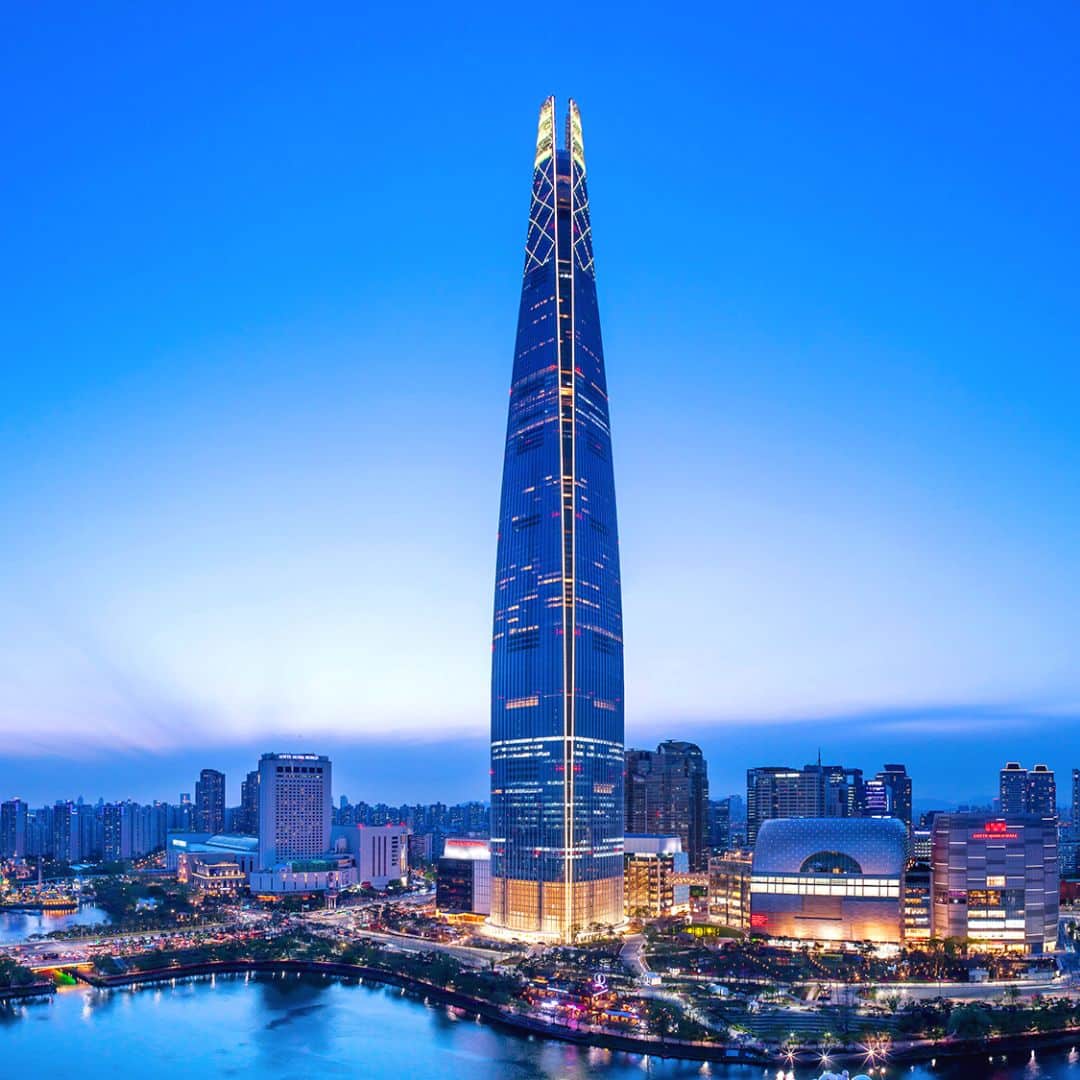
If you want the best Seoul has to offer, these luxury hotels are for you. Located in Seoul’s glitziest neighborhoods, these hotels are within walking distance of Michelin-starred restaurants, chic boutiques, galleries, museums, and the finest shopping experiences available.
Expect nothing but the best in terms of service and style at these luxury hotels. Silky soft sheets, immaculate rooms with the finest fixtures and fittings, and true 5-star service from the hotel staff. These hotels have sports, dining, and entertainment facilities to make you comfortable during your stay.
Airport transfers are available with these hotels, making your journey into and out of Seoul a breeze. Located in popular upmarket districts in Seoul, these neighborhoods have lots of local charm for you to discover, as well as allow easy access to other parts of the city with excellent transport options nearby.
Not only are these beautiful, comfortable hotels inside, but they are also located in some of the most iconic buildings or districts and provide amazing views over some of Seoul’s most interesting districts. The view from the first hotel is worth the cost alone.
Recommended Luxury Hotels In Seoul
Here are 3 of the best luxury hotels in Seoul that we recommend for an unforgettable stay in Korea’s capital:
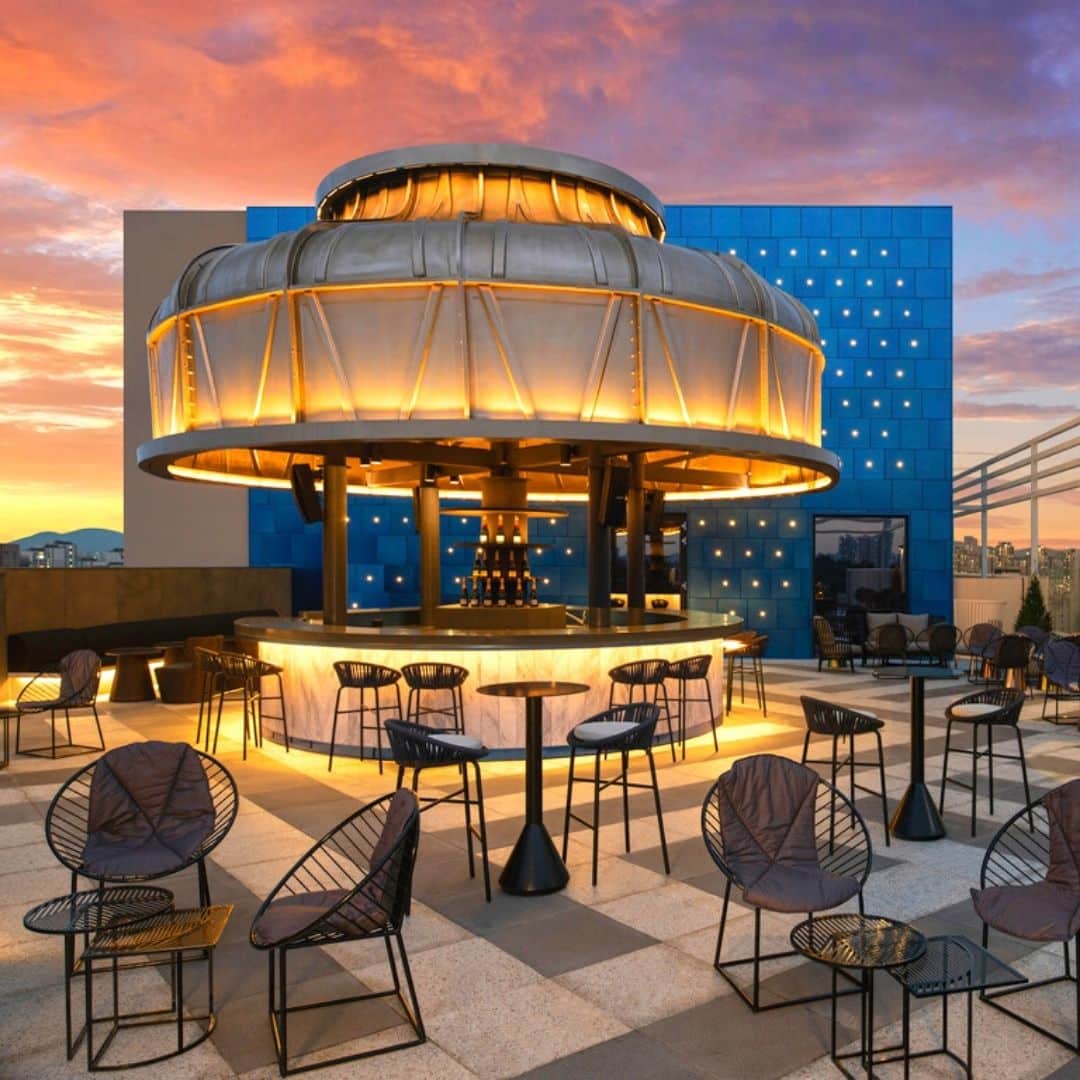
Families. couples and other travelers that want to experience the best of Seoul without breaking the bank can sleep easy with these mid-range hotel recommendations in some of Seoul’s trendy, vibrant districts, including Hongdae, Gangnam, and Myeongdong.
Encounter stylish accommodation in Seoul’s Hongdae districts, which is full of street culture and artistic scenes from the district’s eponymous Hongik University – one of Korea’s leading art centers.
Fashion lovers and shoppers will find lots to love in downtown Gangnam, with its wide streets and glassy storefronts bracketing narrow side streets and hidden delicacies.
Myeongdong is famous for its budget and mid-range accommodation options, including several hotels by the famous Lotte chain – one of Korea’s best mid-range brands.
Whichever mid-range hotel you choose in Seoul, you can be sure you’ll have fantastic city views, convenient subway access, and lots of unique cultural sights, sounds, and tastes to experience.
Recommended Mid-Range Hotels In Seoul
Here are 3 of the best mid-range hotels in Seoul that we recommend for an comfortable stay in Korea’s capital:
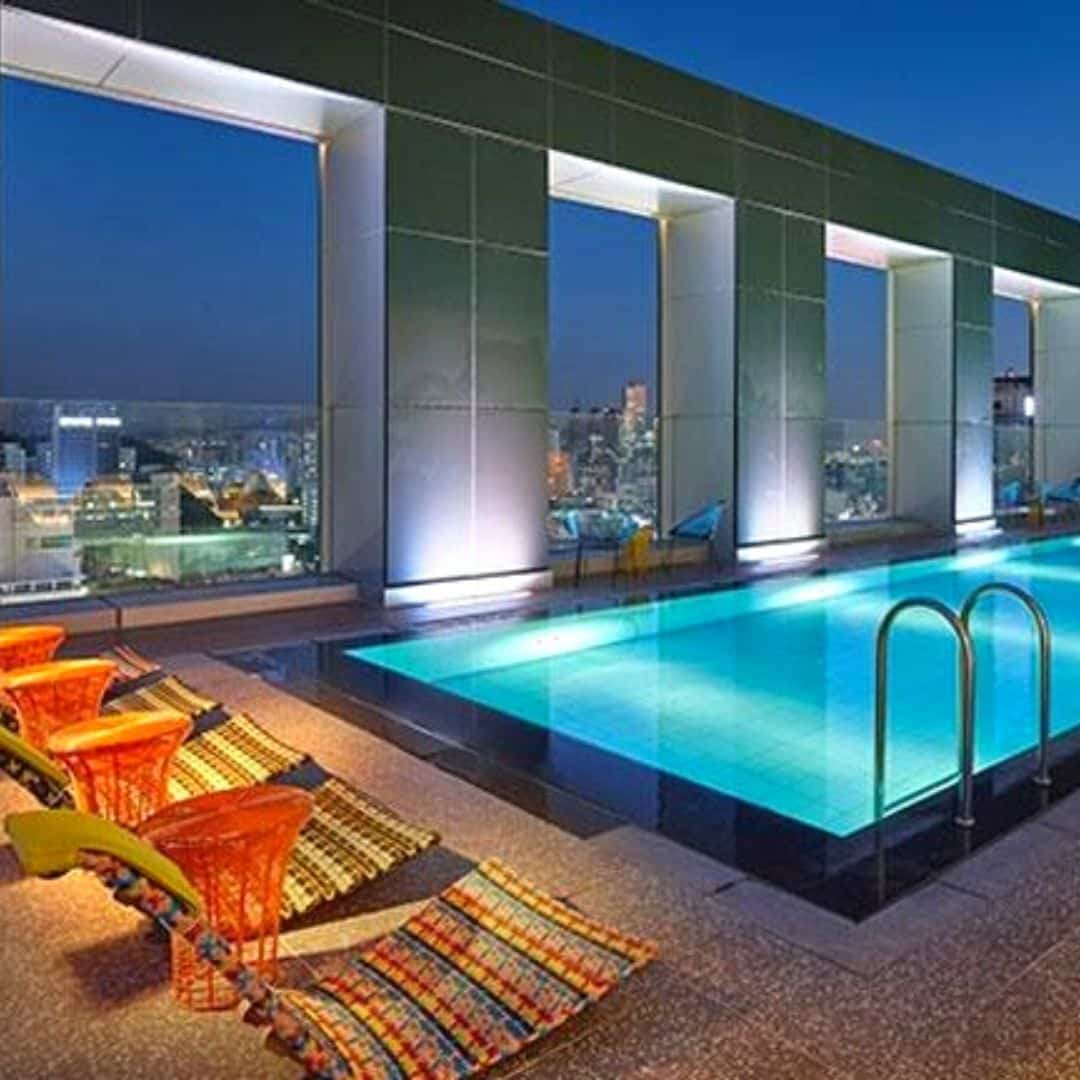
Seoul has a wealth of budget accommodation options that will help make your money go further. These hotels are all around $100 or less but offer the comfort and convenience that you’d expect to find in a mid-range hotel. One even has a beautiful rooftop pool.
Although these hotels are cheaper, don’t lower your expectations. You’ll always find great service in Korea. Save on sleeping to spend more on shopping, souvenirs, sights, and all the other fun things there are to do in Seoul.
These budget hotels in Seoul are also in great locations for shopping, enjoying local culture, and seeing the real side of Seoul and Korea. Hongdae offers bargain hunters the chance to get boutique fashion at market prices, Gangnam has plenty of cafes and cheap eats tucked away off the main avenues, and Myeongdong is a budget traveler’s paradise full of $1 street food and bargain souvenirs.
You won’t be disappointed with a night at any of these hotels. If you want to make your budget go further so you can spend more on some of the incredible day trips Seoul has to offer, definitely book a night at one of these hotels.
Recommended Budget Hotels In Seoul
Here are 3 of the best budget hotels in Seoul that we recommend for an affordable stay in Korea’s capital:

Korean Travel Tips
Korea is a unique country with a written language that looks nothing like English, fascinating etiquette rules , and an always busy lifestyle. Travelers may be lost trying to do even the simplest things.
These travel tips include the best options for staying connected, how to use public transportation easily and cheaply, great discount cards that will save you money as you travel, where to exchange money, and how to learn some basic Korean phrases for when you travel.
These essential Korean travel tips have been crafted by experienced travelers who love to save time and money. Only the best quality services and products are recommended here.
Here are our Korea travel essentials that’ll help you get around more easily, save you money, and let you get the most out of your trip.
Plan ahead now and you’ll have fewer troubles on your travels, giving you more time to enjoy your time in Korea.
If you’re traveling to Korea, you’re almost certainly going to want to get access to the internet to help you navigate, translate Korean, or even book tickets to attractions. Korea has one of the world’s best mobile internet and the prices are very reasonable. 5G mobile internet services are available across the country and Korea was one of the first to get the super-fast service. You won’t have problems connecting with a sim card or WiFi router when you travel.
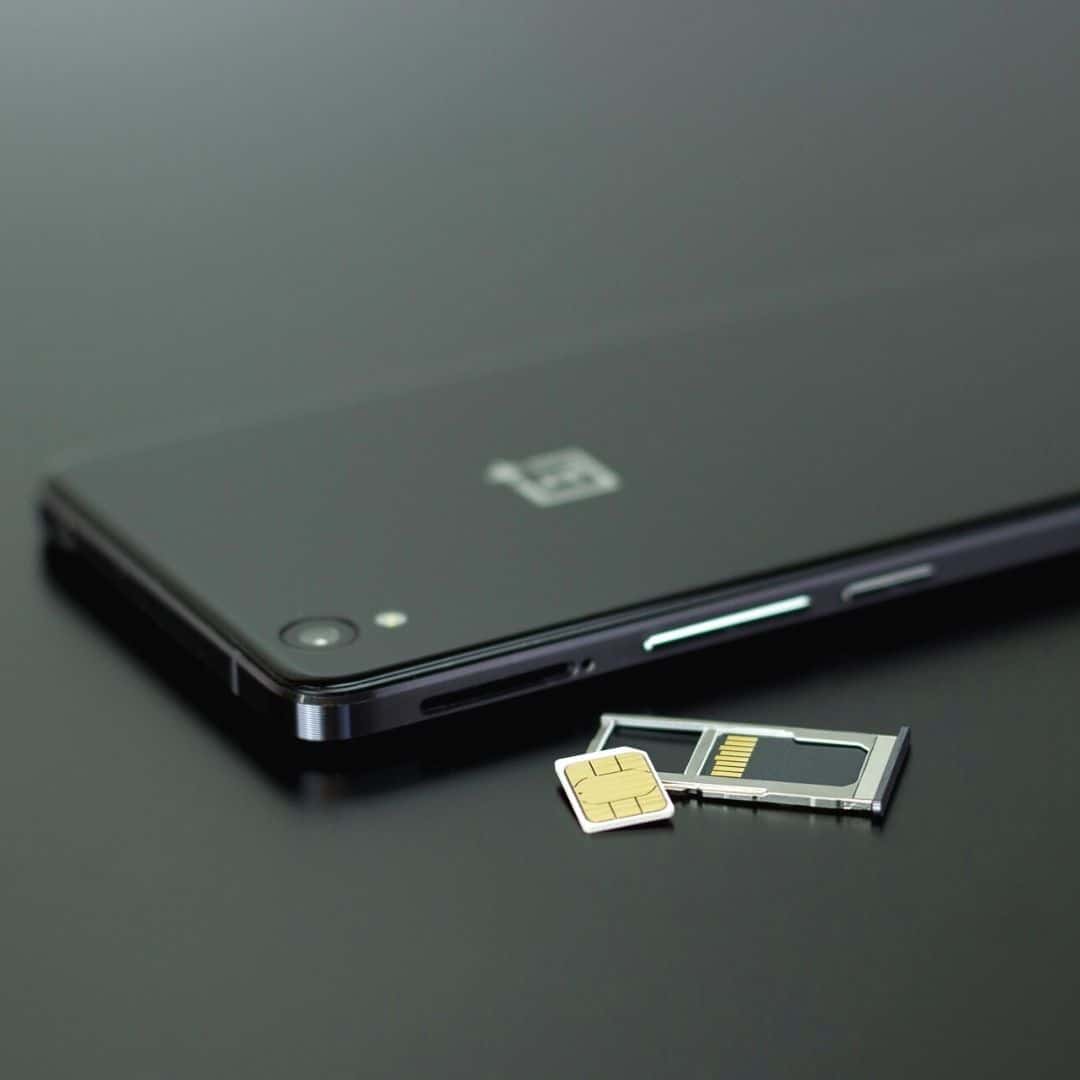
Sim Cards & Data Plans
A Korean sim card is a great way to get access to all your usual cellphone services when you travel to Korea. Sim cards come with data-only packages, or data and phone services combined.
Buying a Korean sim card will give you access to a Korean phone number, which is useful when using Korean apps. If you want to order food online in Korea, you need to have a Korean phone number to complete the order.
Korean Sim Card Costs
Prices start at W5,900 ($5) for a 1-day sim. You can also get 10-day sim cards (W34,700/$28) and 30-day sim cards (64,400/$52). These all come with unlimited data, domestic calls, and texts.
You can purchase a Korean Sim Card From Klook and collect it at the airport. This is a very convenient option as you can use it immediately to help navigate and check in back home.

Portable WiFi Routers
A Korean portable WiFi router will give you access to mobile internet throughout Korea by connecting to WiFi hotspots run by the major phone companies in Korea and comes with great coverage.
The major benefits of a portable WiFi router include a lower cost than a Korean sim card and also the ability to connect up to 3 devices to 1 router. That means that families and groups will be able to share the service.
Korean Portable WiFi Router Costs
The cost of a Korean portable pocket WiFi router is W3,200 ($2.60) per day. You can rent the WiFi router for as many days as you require and pay in advance and pay any excess days when you return it.
You can also purchase a Korean Portable WiFi Router From Klook and collect it at the airport. You can book online before you travel so that it’s guaranteed to be waiting for you.
Should I Get A Sim Card Or WiFi Router In Korea?
Both a sim card and WiFi router are great options for travelers to Korea and will almost guarantee a great reception for mobile internet. The choice between whether you should get a sim card or WiFi router in Korea really comes down to the costs involved and if you need a Korean phone number.
WiFi routers are cheaper and allow you to connect 3 devices, so they’re perfect for families. However, a sim card gives you a Korean phone number, which means you can call people and also register for Korean apps which require a phone number.
Check out our detailed article about the Best Sim Card & Portable WiFi options for traveling to Korea.
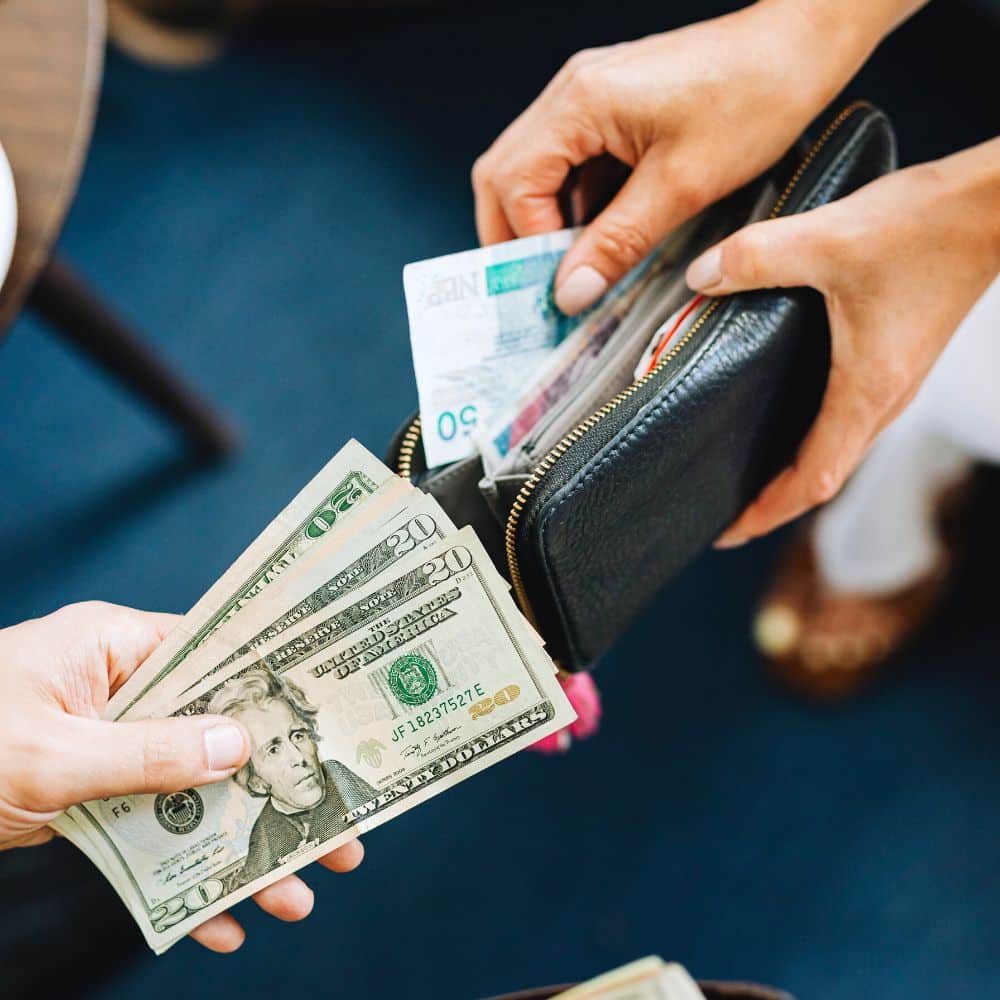
Korea is a safe, modern country and one that has pushed hard for the mass adoption of cards. Almost every location that deals with money is required to accept card payments. This is great news for travelers to Korea as you can use a card to pay for meals out, entrance tickets, trains, and lots more.
Cash is still needed for some things, such as topping up transportation cards like the T-Money Card (more on that soon) and for paying for small things like street food. Please note, as Korea doesn’t have a tipping culture, you don’t need cash for leaving a tip. In fact, if you try to leave a cash tip, it’ll be returned to you in most places.
Read on to find the best tips to avoid getting ripped off when exchanging money and how to pay the lowest fees when you use a card to pay in Korea. Be a smart traveler and save more money for shopping and souvenirs.
Korean Money Exchange Options
Once you arrive in Korea, there are several options for exchanging money. First, you can exchange money at a money changer in tourist areas such as Myeongdong. These money changers used to have the best rates in Seoul.
However, a better option these days is to use the currency exchange machines from WOW Exchange. These machines are located all over Seoul’s most popular tourist spots, stations, and hotels. They allow you to exchange foreign cash directly to Korean won, with better rates than at the airport. You can also use these machines to claim a tax refund for your shopping before heading to the airport. Both options require a passport.
Should I Change Money At The Airport?
Exchanging money at the airport is easy and convenient as you can instantly get cash to use for shopping, transportation, and general use. However, the exchange rate at the airport is usually much worse than you’ll find in other places in Korea, as mentioned previously. If you need cash as soon as you land, withdraw a small amount ($50) and then exchange the rest in Seoul.

Travel Money Cards For Korea
While cash is useful and familiar when traveling, a much better option is to use a travel money card (also known as a currency card). Travel money cards, such as the Wise Travel Money Card, allow you to pay for travel expenses without the need to carry cash or convert money.
A travel money card offers the convenience of using a credit card without high fees that a regular bank could charge. It also allows you to withdraw cash from an ATM without a fee (up to a limit), so you can avoid carrying any cash on the flight or using a money exchange. The exchange rate is the mid-market rate, meaning it’s better than you’ll find even at the money exchanges listed before.
Can I Use My Bank Card In Korea?
Credit cards are widely accepted in Korea. Visa and Mastercard users shouldn’t face a problem, but other cards aren’t as widely accepted. Debit cards and cash withdrawals might not work depending on the bank. Your bank may charge a fee when using it overseas, or give a bad exchange rate. Check with your bank before traveling.
The best option for travel money in Korea is to have a mixture of cash and cards, with a backup credit card just in case. Taking some USD with you is always a good option as you can find plenty of places to exchange it to Korean won and probably at a better rate than you’ll get in the US. If you want to withdraw money in Korea, look for the global ATMs in tourist areas.
Taking a travel money card will be safer, cheaper, and more convenient than relying on your own bank or credit card, too. These cards offer competitive rates and are widely accepted around the world so you can use them to visit other countries, too. If you use a travel money card and it gets lost or stolen, you can freeze the card instantly with the app and not have to worry about losing the balance on the card.
When you visit Korea, you’ll notice that most people pay for goods with a card or payment app, even for small purchases like a bottle of water. Unfortunately, the payment apps that are common in the US, such as Apple Pay or Google Pay, aren’t available in Korea. Korean apps, such as Kakao Pay, require a Korean bank account, and therefore aren’t an option for travelers.
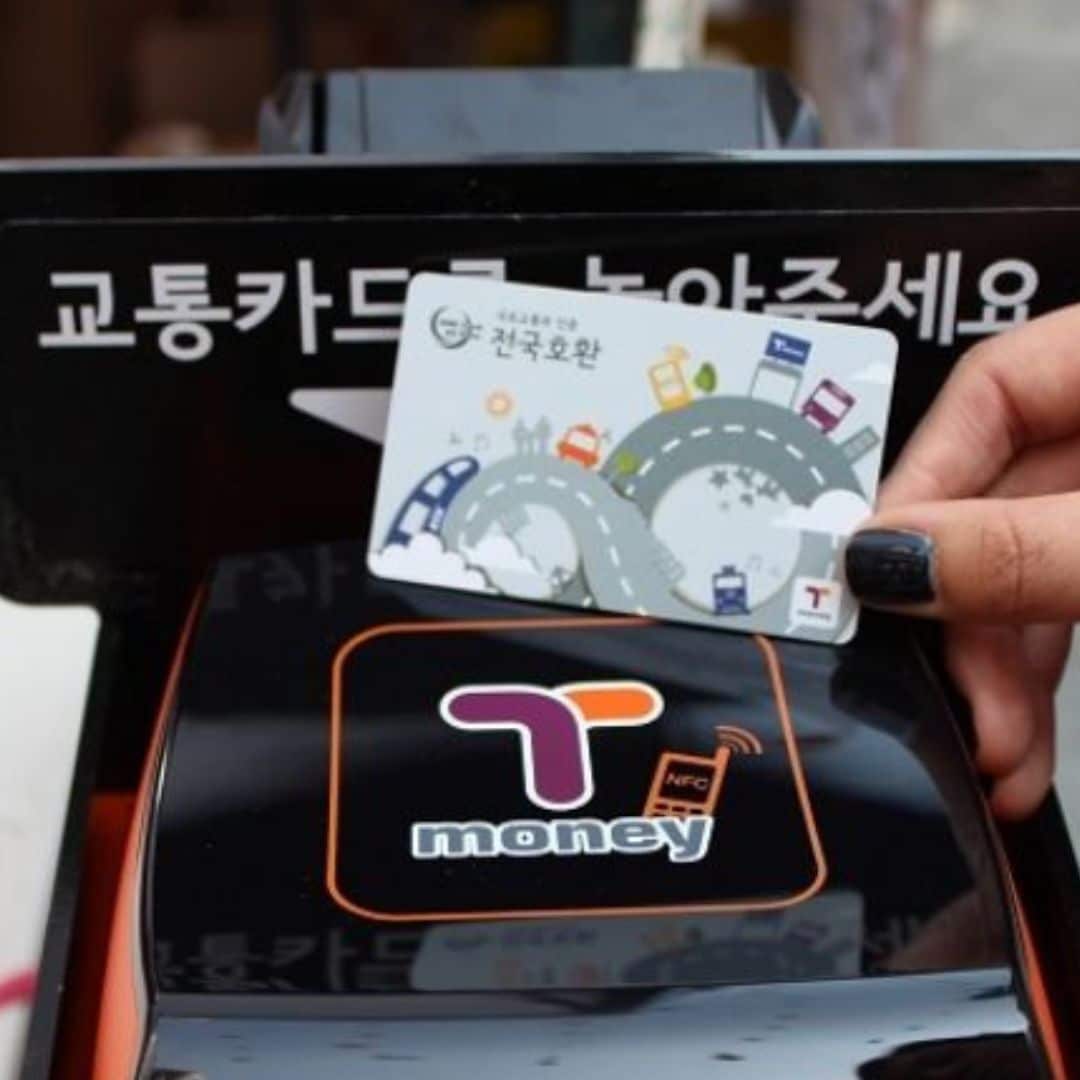
T-Money For Public Transport
The T-Money Card is an essential purchase for every traveler to Korea. The T-Money Card is a transportation card that allows contactless travel on Korea’s buses and subways. Simply buy a T-Money Card, top-up the card, then use it to travel.
Not only is this transportation card really convenient, it also saves you money. You’ll receive a discount on every bus or subway journey when you pay with the T-Money Card. These discounted fares are available in all cities across Korea, not just Seoul.
This isn’t the only use of the T-Money Card. You can also use to buy a coffee from Starbucks, get lunch in McDonald’s, shop for Korean cosmetics, and even to watch a baseball game. It’s a very useful card that can be used anywhere you see the T-Money Card.
You can get the T-Money Card in Korea from subway stations and at certain transport centers, including Seoul Station and Incheon Airport. The card costs 2,500 KRW. You can buy the card with a credit card, but to top-up the card, you need to use cash. If you buy a Discover Seoul Pass, this card includes the T-Money functions.
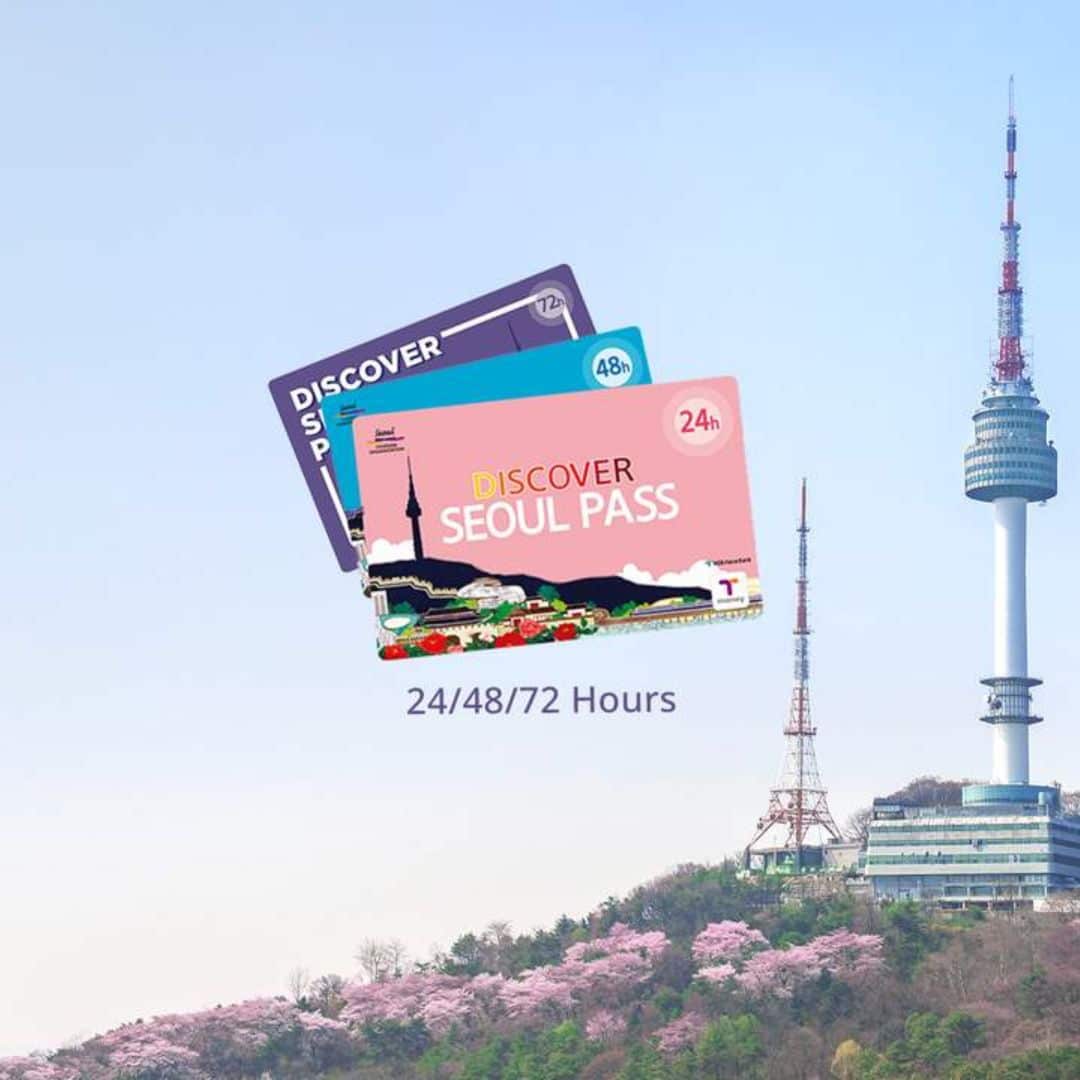
Save With The Discover Seoul Pass
Travelers to Seoul have a lot of options for incredible attractions to enjoy and experience. However, tourists, especially families, can find that the cost of these attractions quickly add up, especially when you are visiting many locations in a short time.
A great way to save money when you travel in Seoul is to buy a Discover Seoul Pass – a special card that offers you big savings on some of Seoul’s top attractions, as well as other benefits.
If you plan to visit Seoul’s Royal Palaces, N Seoul Tower, Lotte World Adventure Theme Park, the COEX Aquarium, Alive Museum, Seoul Zoo, or other premium attractions, you can gain free entry when you purchase a Discover Seoul Pass.
Not only that, you can also get a free river cruise, free hanbok rental, free ride on the Airport Express from Incheon Airport to Seoul, free City Tour Bus Ride, free T-Money Card and lots more.
The Discover Seoul Pass is valid for 24 | 48 | 72 hours and is valid from the moment you first use it until that many hours later.

Things To See & Do In Korea
If you want to build your own itinerary for South Korea, then this section of the South Korea Travel Guide will provide the building blocks you need to craft the perfect trip.
South Korea is a country packed with famous landmarks and sights, unique culture – modern & historical, family-fun activities, outdoor adventures, cozy cafe districts, and natural wonders. There’s more to do in Korea than you could imagine and it’s impossible to explore it all in one trip. Try to plan your itinerary by cities and locations. For example, plan your day in Seoul stay by district.
Here are some of the best things to see and do in South Korea, broken down into different themes so you can find things that interest you the most. The location of each of these attractions is included, too, so you can create a city by city itinerary, seeing the best South Korea has to offer.
These attractions are available all year round so whenever you go to Korea, you can enjoy them. There are plenty of things to see and do in Korea that only happen during certain seasons. Check out the Season Guide in this South Korea Travel Guide for more information about Korean festivals and seasonal events.
Here are 10 of the best Korean landmarks:
- Lotte World Tower (Seoul)
- Bukchon Hanok Village (Seoul)
- Nami Island (Gapyeong)
- Banwol ‘Purple Island’ (West Coast)
- N Seoul Tower (Seoul)
- Dongdaemun Design Plaza (Seoul)
- Seoraksan National Park (Gangwon Province)
- Hwaseong Fortress (Suwon)
- Cheonggyecheon Stream (Seoul)
- Gamcheon Cultural Village (Busan)
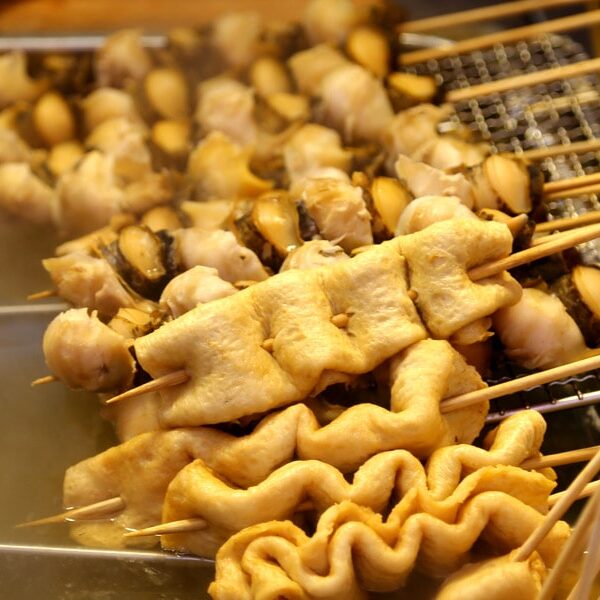
Why travel to a diverse country such as Korea and not embrace the local culture? Here are 10 of the best unique Korean experiences you can only enjoy fully in Korea. Be brave, try something new and create lasting memories of your Korean adventure.
Here are 10 of the best uniquely Korean experiences:
- Wear Traditional Korean Hanbok (Royal Palaces)
- Sing In A Korean Noraebang (Everywhere)
- Sleep In A Korean Hanok House (Hanok Villages)
- Visit The Kimchi Museum (Seoul)
- Eat Street Food (Traditional Markets)
- Experience A Korean Temple Stay (National Parks)
- Drink Makgeolli – Korean Rice Wine (Everywhere)
- Visit The World’s Most Dangerous Border – The DMZ
- Relax In A Korean Sauna (Everywhere)
- Visit A Korean Green Tea Field (Boseong, Jeju)

Here are 10 of the best Korean historic sights:
- Gyeongbokgung Palace (Seoul)
- The Secret Garden (Seoul)
- Bulguksa Temple (Gyeongju)
- Jeonju Hanok Village (Jeonju)
- Seoul Fortress Walls (Seoul)
- Haedong Yonggungsa Temple (Busan)
- Andong Hahoe Folk Village (Andong)
- Gyeongju Historic Area (Gyeongju)
- Baekje Historic Area (Gongju, Buyeo)
- Jangsaengpo Whale Museum (Ulsan)

Here are 10 of the best modern K-Culture spots:
- K-Pop Headquarters (Seoul)
- HYBE Insight (Seoul)
- COEX Artium (Seoul)
- K-Style Hub (Seoul)
- Hongdae Shopping Street (Seoul)
- Hallyu K-Star Road (Seoul)
- Asia Culture Center (Gwangju)
- Busan International Film Festival Square (Busan)
- MBC World Theme Park (Seoul)
As you’ll see, there’s just so much to see and do in Korea. You could spend a whole week in Seoul and not run out of exciting activities to do and sights to explore. Our advice is to try to avoid planning to do too many things in one day and adding in plenty of free time.
There’ll be many random things that catch your eye, such as a curious side street, or your nose, like the delicious smells from a food stall. Make sure you’ve got flexibility in your schedule to investigate these surprises and to take a rest if you need to – walking and traveling for days on end can get tiring.
Korea comes alive at night and markets and city streets are often best explored after the sun goes down. Drab concrete buildings come alive with neon signs, lanterns, and electric lights and are quite a sight to be seen. Visit popular tourist attractions such as the royal palaces and hanok villages during the morning as they’ll be less crowded.
If you plan to visit the Secret Garden in Changdeokgung Palace (you really should!), tickets are available on the day and sell out fast. Getting to these places early can guarantee you get tickets, see the sights unobstructed, and have time in the evening to soak up the night life and culture.
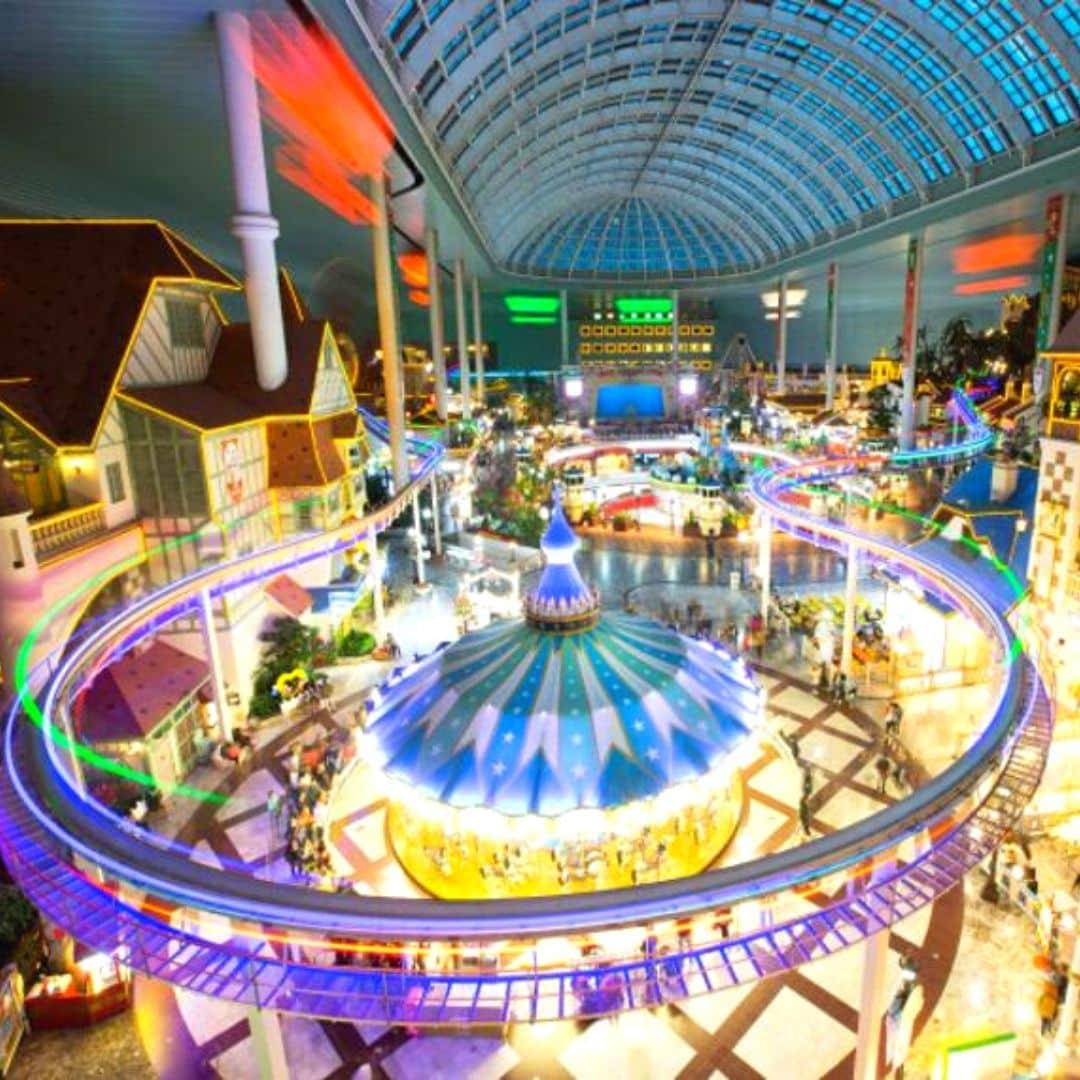
Here are the 10 best family-friendly activities in Korea:
- Nami Island & Garden of Morning Calm (Gapyeong)
- Seoul Grand Park & Zoo (Seoul)
- Lotte World Adventure (Seoul, Busan)
- Alive Museum & Dynamic Maze (Seoul)
- Seoul Children’s Grand Park (Seoul)
- Seoul Children’s Museum (Seoul)
- Everland & Caribbean Bay Theme Parks (Near Seoul)
- Sea Life Busan Aquarium
- Jeju Dinosaur Island (Jeju)
- Alpaca World (Gangwon Province)
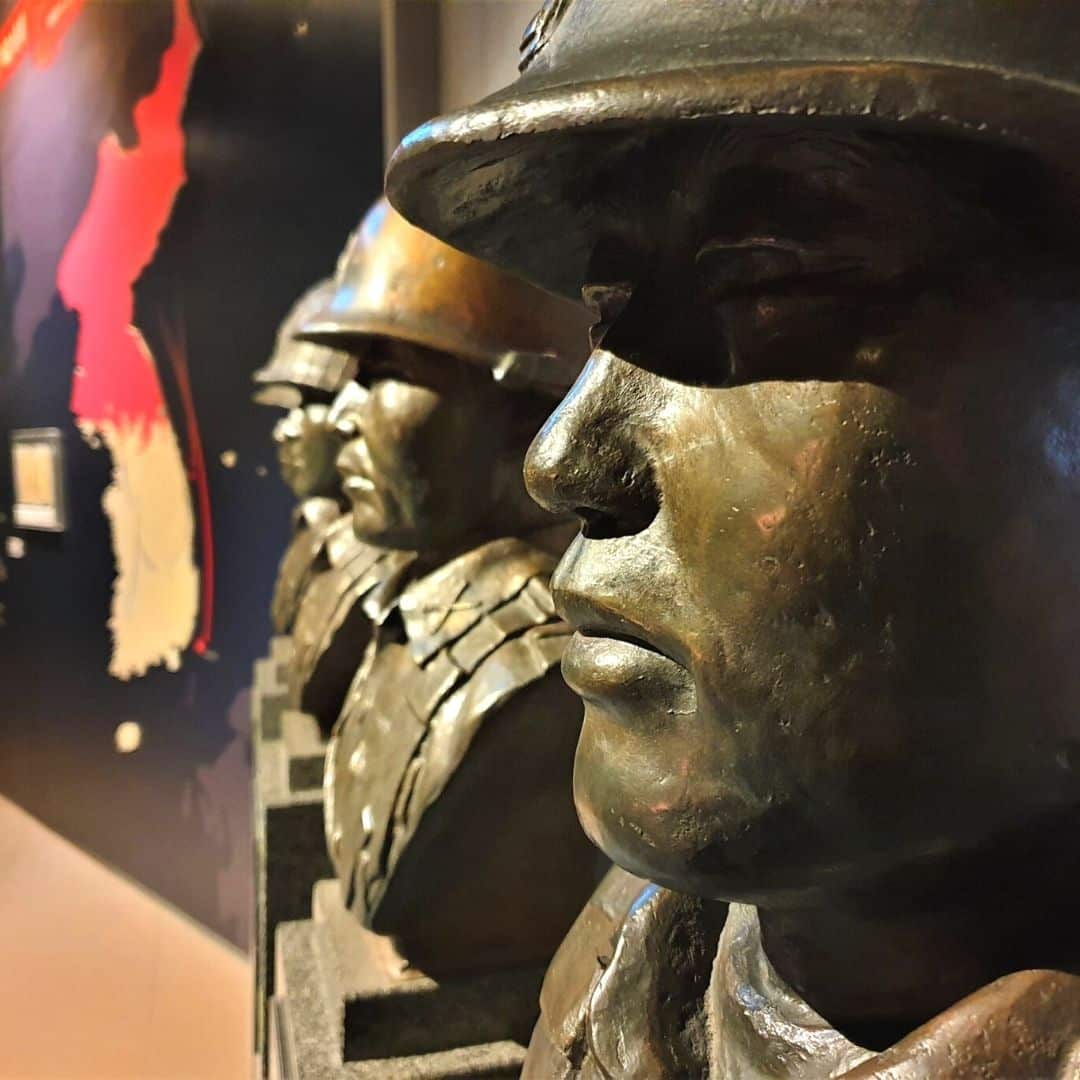
Here are the 10 best museums & galleries in Korea:
- National Museum of Korea (Seoul)
- Seoul Museum of Art (Seoul)
- Gyeongju National Museum (Gyeongju)
- War Memorial of Korea (Seoul)
- National Folk Museum of Korea (Seoul)
- National Maritime Museum (Busan)
- Seodaemun Prison History Museum (Seoul)
- Seoul Museum of History (Seoul)
- Museum Kimchikan (Seoul)
- Daegu Art Museum (Daegu)

Here are the 10 best cafe areas in Korea:
- Ikseondong Hanok Village (Seoul)
- Gyeongui Line Hongdae (Seoul)
- Samcheondong Cafe Street (Seoul)
- Jeonpo Cafe Street (Busan)
- Hwangnidan-Gil (Gyeongju)
- Gangneung Coffee Street (Gangneung)
- Sinsa-Dong / Garosugil Road (Seoul)
- Jukjeon Cafe Street (Seoul)
- Hwaseong Haenggung Area (Suwon)
- Kim Kwang Seok Gil Street (Daegu)

Here are 10 of the best Korean markets and shopping areas:
- Gwangjang Market (Seoul)
- Myeongdong Market Area (Seoul)
- Jagalchi Fish Market (Busan)
- Centum City Mall (Busan)
- IFC Mall (Seoul)
- Starfield COEX Mall (Seoul)
- Nambu Market (Jeonju)
- Seomyeong Underground Shopping Center (Busan)
- Seogwipo Maeil Olle Market (Jeju)

Here are 10 of the best natural sights in Korea:
- Hallasan Mountain (Jeju)
- Jirisan National Park (Jeollanam Provice)
- Seoraksan National Park (Gyeonggi Province)
- Seongsan Ilchulbong Sunrise Peak (Jeju)
- Damyang Juknokwon Bamboo Forest (Damyang)
- Boseong Green Tea Plantation (Boseong)
- Haeundae Beach (Busan)
- Udo Island (Jeju)
- Hwaamdonggul Cave (Gangwon Province)

Travel Itinerary For Korea
When planning a travel itinerary for South Korea, it’s best to think about what kind of experience you want when you travel to South Korea and build your itinerary from that. What kind of traveler are you and what do you want to take away from your Korea trip? Are you planning a trip for yourself, for your family, or as a romantic escape?
Do you want to learn about traditional Korean culture and history? Are you visiting to immerse yourself in modern Korean culture and maybe meet your idols? Are you planning to get out into Korea’s mountains to hike and join a Buddhist Temple Stay? Or are you going to eat, drink, shop, and make the most of Korea’s discounted goods? Or all of the above?
This section of this South Korea Travel Guide will offer some of the best one-week and two-week itineraries for South Korea. These itineraries are rough guides, created to help you begin planning your trip. Feel free to pick and choose the parts from them that you like to create your own travel itinerary for South Korea. We’ll be adding more great itineraries soon, be sure to check back for the latest ideas.
Classic 1 Week Itinerary For Korea: Seoul, Busan, Gyeongju
This is one of the most popular of the 1-week itineraries for South Korea and will take you to the most famous and interesting places that are top of most travelers’ South Korea bucket lists. Starting in Seoul, Korea’s capital, you’ll explore the best sights in this city before taking a day trip out to the lovely Gapyeong County to get a breath of fresh Korean countryside air.
From day 4, zip across the whole of Korea on the high-speed KTX train and explore Korea’s second city, Busan. See coastal temples, fish markets, wide beaches, and more in Busan before taking a day trip to Korea’s historic UNESCO World Heritage City, Gyeongju. On the last day, it’s time to return to Seoul to pack your bags full of the best souvenirs and snacks and say farewell in the highest part of the city.

Afternoon : Dressed in your hanbok, enjoy more traditional Seoul with a walk around the narrow streets of the Bukchon Hanok Village. Visit traditional Korean teahouses, galleries, markets, and more.
Evening : Check out the stalls and shops of artsy Insadong, contemplate Jeogyesa Temple, and take an evening stroll along the Cheonggyecheon Stream before dining in Myeongdong or the Jonggak Avenue of Youth. This Full Day Tour of Seoul will show you some of the hottest spots in the city, while this Customized Private Tour of Seoul will allow you to choose where to go.
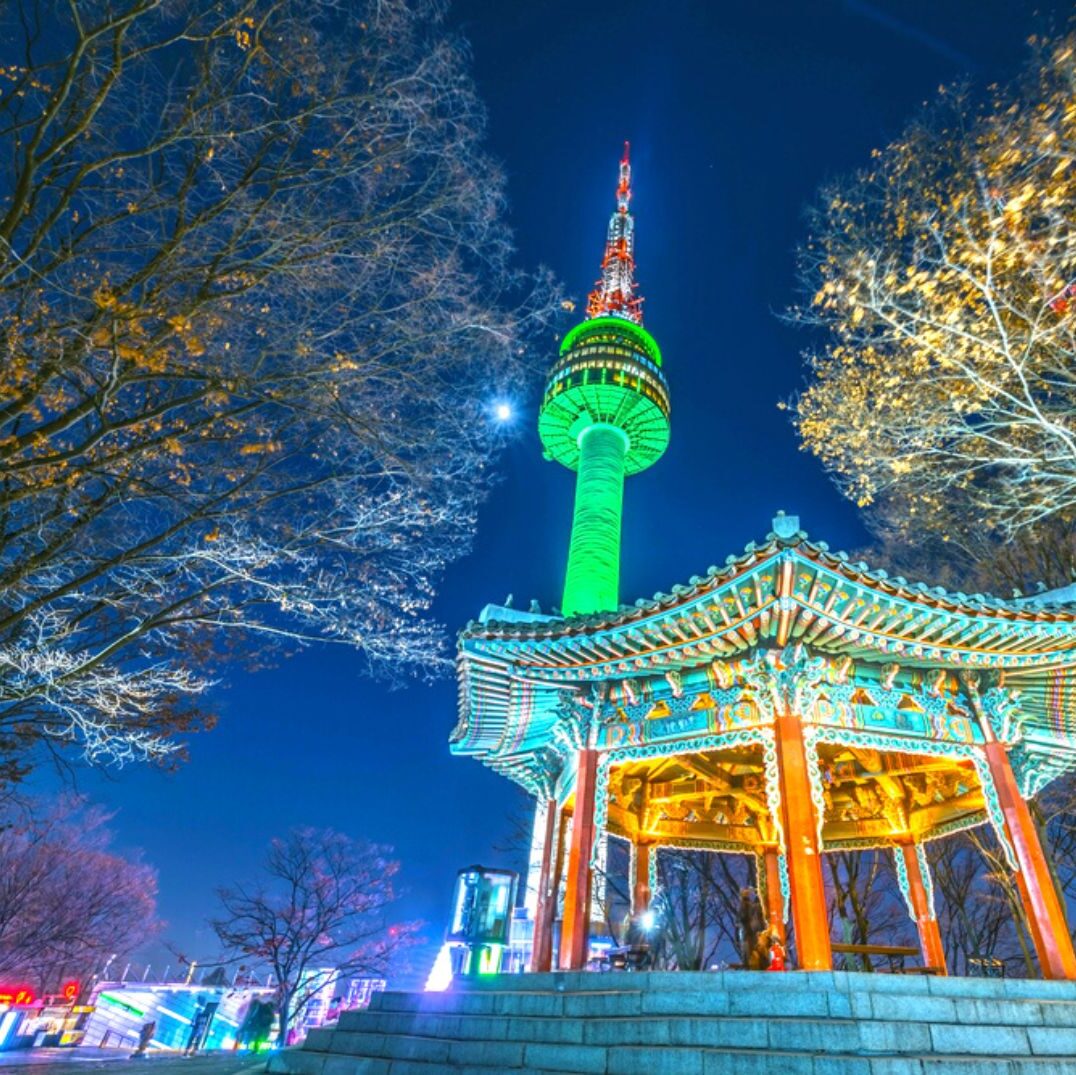
Afternoon : Head back to central Seoul and witness the bustling sights and delicious smells of Seoul’s traditional Gwangjang and Dongdaemun Markets. Try delectable Korean street foods here.
Evening : Take the Namsam Cable Car to the top of Namsan Mountain and watch the sunset from N Seoul Tower. See some of Seoul’s fortress walls before heading back down to go late-night shopping at Myeongdong Market.
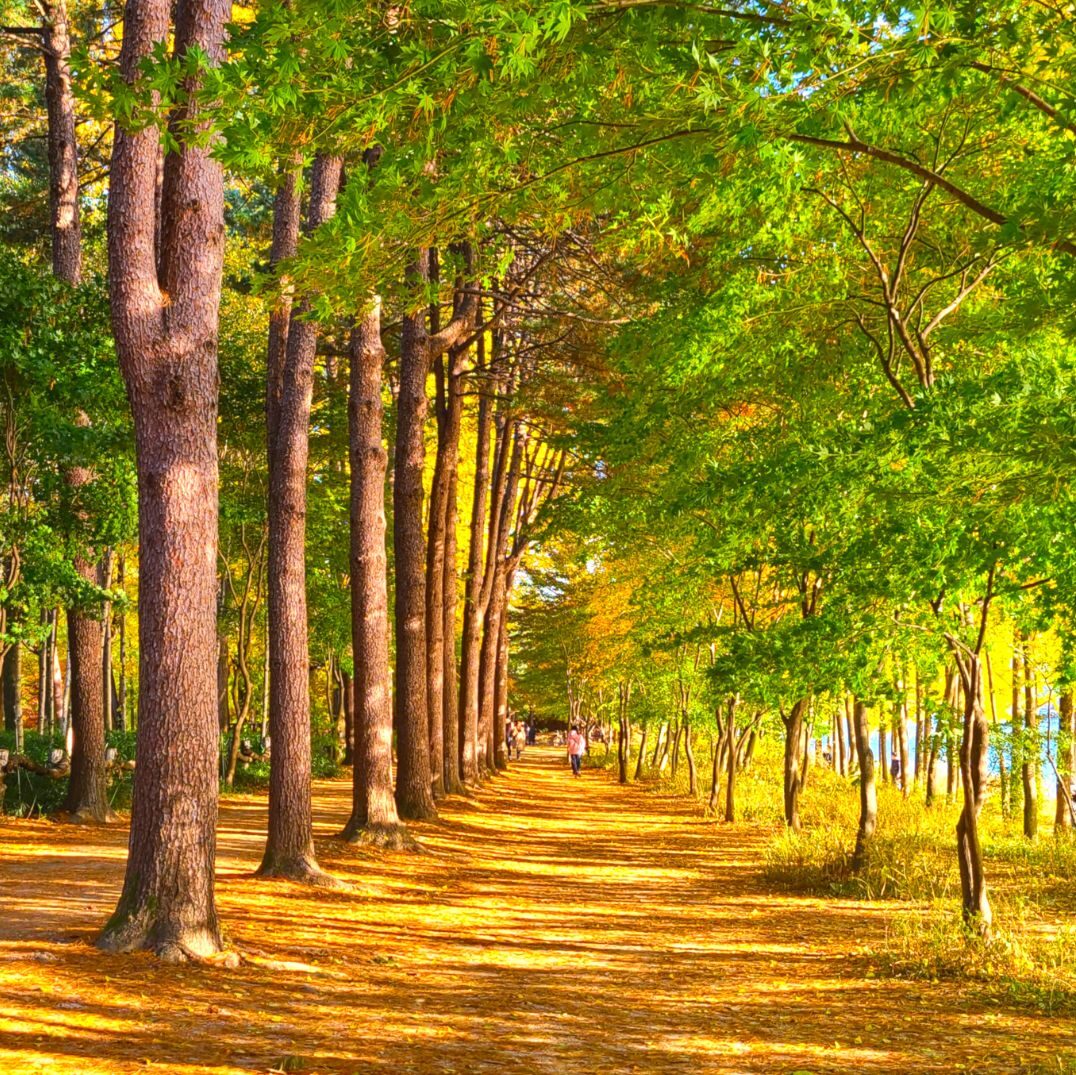
Afternoon : Zip line or sail over to Nami Island for impressive nature, bike rides, leafy walks, and cozy cafes. See popular scenes from K-dramas and even some wild animals, like deer and rabbits.
Evening : Pedal your way along an abandoned railway at the Gangchon Rail Bike Park before heading back to Seoul for fine dining in Gangnam’s Apgujeong Rodeo district.
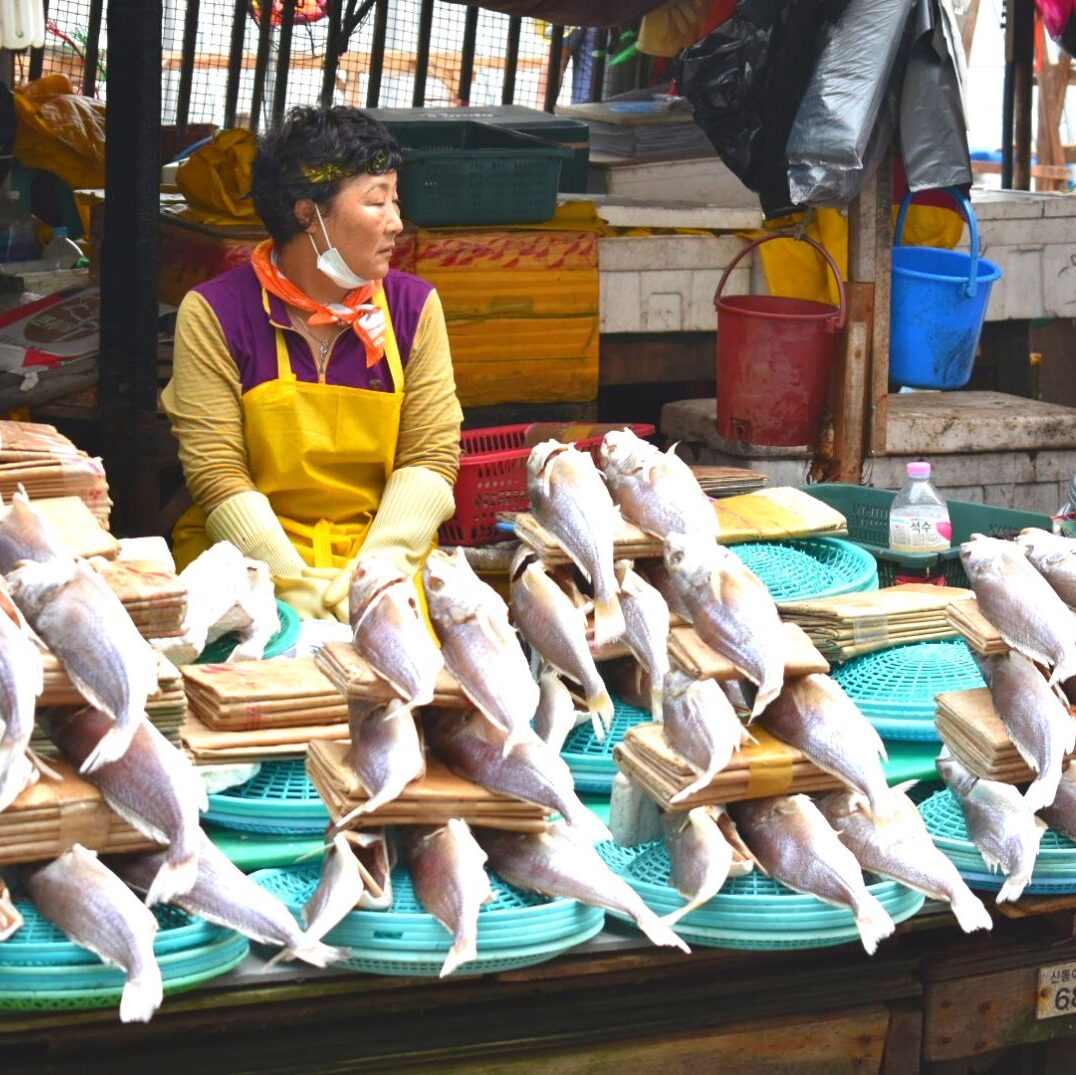
Afternoon : Head to the Nampo-dong near Busan Station and visit Jagalchi Market for a fresh seafood lunch. Then explore cosy Bosu-dong Book Alley or take a taxi to the Huinnyeoul Culture Village.
Evening : Take the subway up to Haeundae Beach for Busan’s best night-scenes. Grab dinner overlooking the beach, or at one of the market stalls. If you’re feeling brave, visit BUSAN X the SKY to see breathtaking views over the coast and city.

Afternoon : Head to the Gyeongju Gyochon Traditional Village for a traditional meal and to see the stunning Woljeonggyo Bridge. Gyeongju National Museum is nearby, too.
Evening : See the tranquil night views of Wolji Pond where palace buildings reflect perfectly in still waters. Stop at Hwangnidan-gil area for dinner and drinks before returning to Busan.
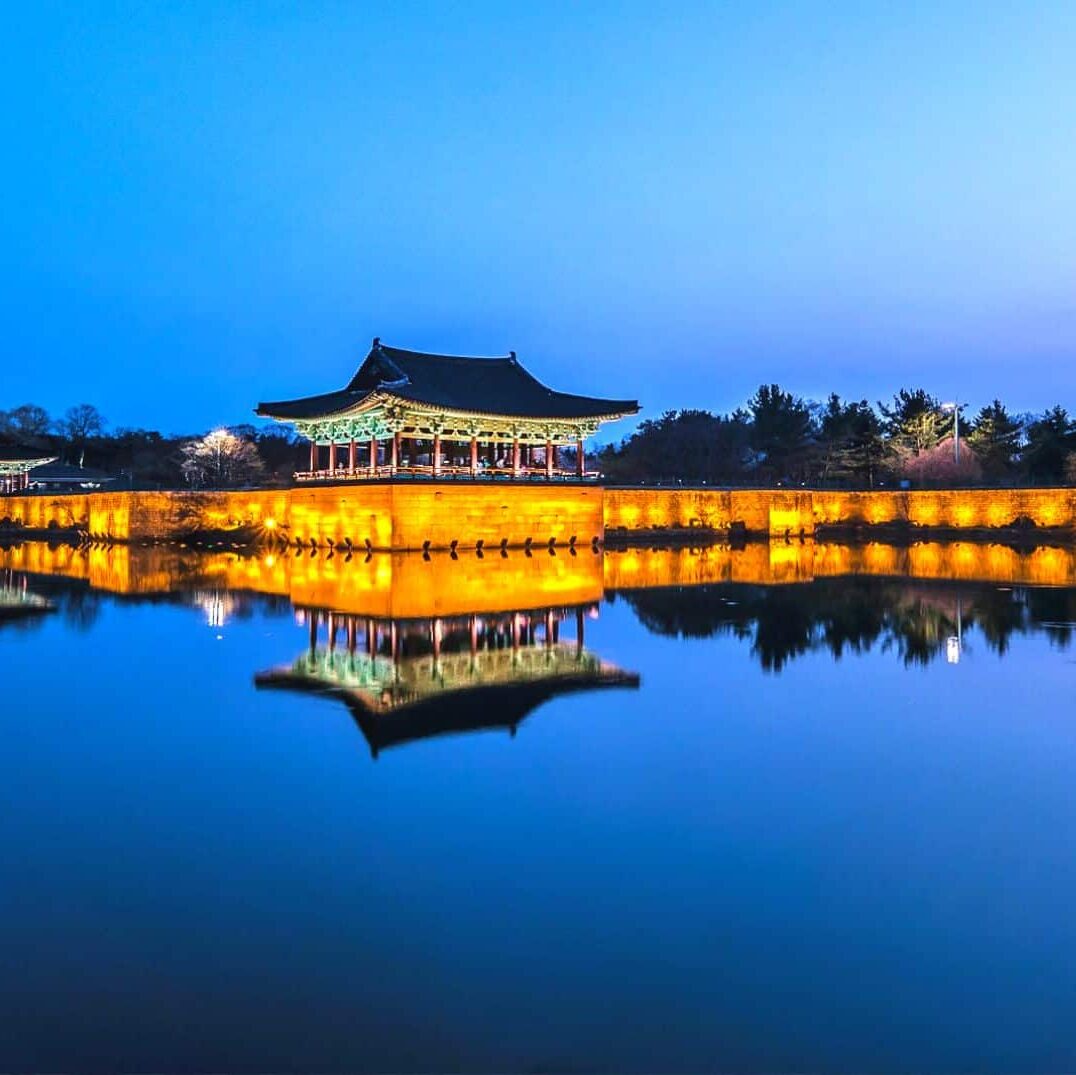
Afternoon : Explore the artistic shopping streets of Hongdae for last minute souvenirs and gifts for yourself. Take a break in one of the unique animal or artsy cafes.
Evening : Either take a night cruise along the Han River from Yeouido Hangang Park or dine in style at the Lotte World Tower in Jamsil, the world’s 6th tallest building. Both offer great night views of Seoul and unforgettable memories to take home.

Korean Seasons Guide
The best time to visit South Korea is during the warm spring or fall seasons. The weather is mild and clear, there’s a range of festivals and seasonal activities to enjoy, and you can travel to Korea comfortably.
The best months to visit are April, May, September, and October. These months are all during the Korean school semester, so there won’t be as many local travelers around during the weekdays. However, expect the weekends to be busy as people leave the cities to travel within Korea.
Large public holidays, including Chuseok (mid-autumn festival) in September / October) and Buddha’s Birthday (May), provides travelers with the opportunity to experience Korean culture and celebrations. These holidays change each year based on the lunar calendar.
Korean Weather & Climate
South Korea is a country that experiences four very distinct seasons, with temperatures ranging from 100 Fahrenheit in the summer to below 0 Fahrenheit in the winter. Each of South Korea’s seasons brings opportunities to see unique natural views and enjoy the different climates in Korea.
Spring has some of the gentlest weather, with light rain and a quick jump in temperature to the 60s and 70s by late March. Summer begins with the rainy season in late June and becomes extremely humid and hot throughout July and August before cooling again in September.
Fall has the best weather in Korea, with many warm, sunny days. Cold winter weather appears very quickly in mid-November and the first snow usually appears by late November. Winter is dry and sunny with the lowest chance of rainfall but is also very cold. Snow isn’t constant, but can fall for several weeks on and off during winter.
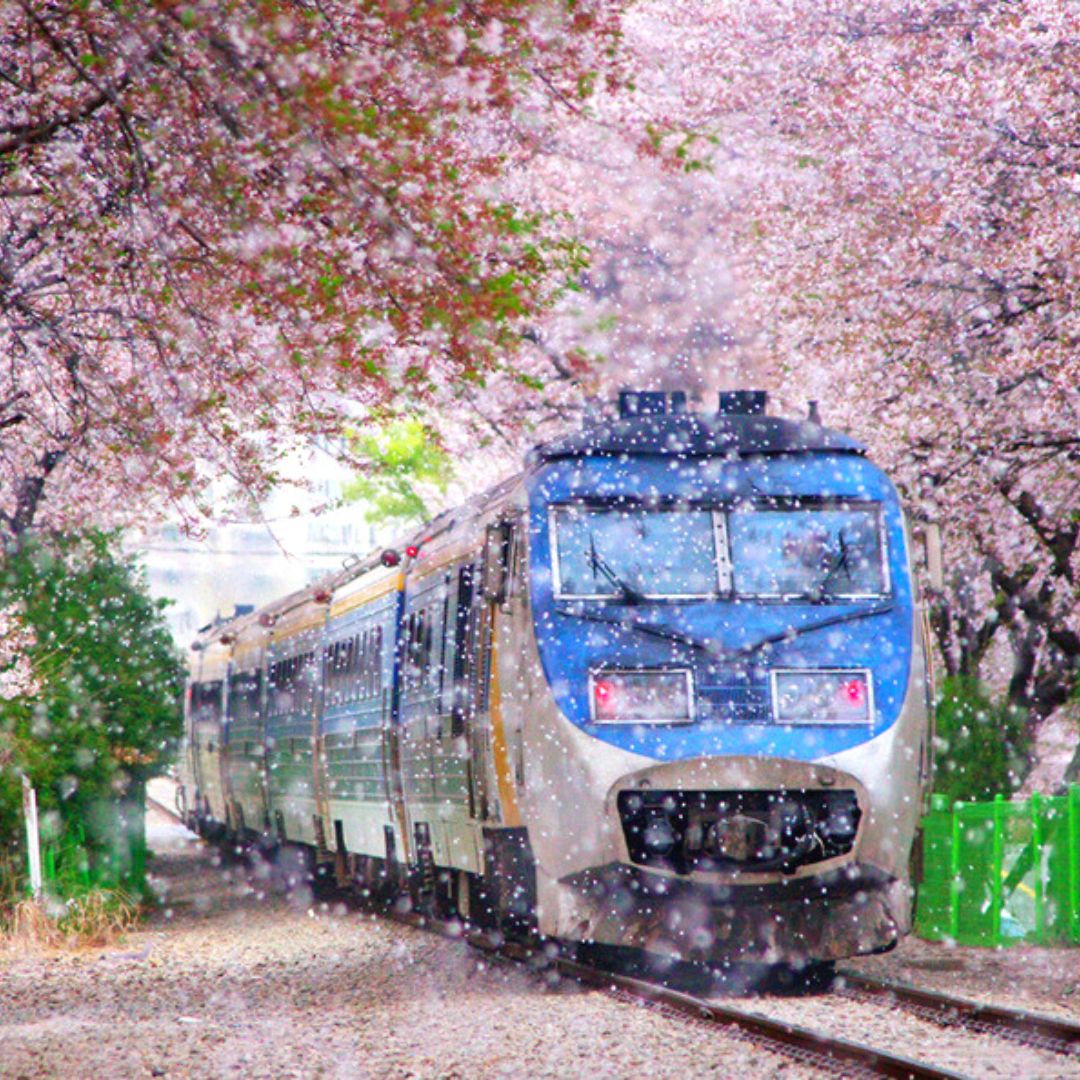
Visiting in spring offers the chance to see beautiful cherry blossoms stretch across the country, as well as many other spring flowers that brighten up Korea after a cold winter.
Spring starts in late March with the awakening of the cherry blossoms and ends in early June with the start of the rainy season. South Korea is a country with a close connection to nature, which can be witnessed in the many spring festivals and celebrations that happen throughout the year.
Some of the best spring festivals include the Jinhae Cherry Blossom Festival, Damyang Bamboo Forest Festival, Yeon Deung Hoe Lotus Lantern Festival, Jindo Sea Parting Festival, and Boseong Green Tea Plantation Festival.

The weather in summer is perfect for getting outside and relaxing on one of Korea’s many beaches. Some of the best activities include spending a weekend camping or glamping by the beach, hiking in shaded valleys in the national parks, and water sports such as surfing, kayaking, and scuba diving.
Unfortunately, the heat may put off some travelers, and high humidity makes it uncomfortable to move around too much. Fortunately, Korea is a modern country with lots of air-conditioning and ways to deal with the hot weather, including delicious summer dishes.
Cool down with a bowl of Korean bingsu (shaved ice dessert) or a cool latte in one of the many cozy Korean cafes in popular beach destinations.

Travelers to Korea in the fall are treated to spectacular fall foliage creeping far and wide. You can see it falling on palace grounds, sprawled on mountains in national parks, and along city streets.
The start of the fall foliage season in Korea coincides with the end of the hot and humid summer, with clear skies and cool weather, making it the perfect time to travel in Korea. Like spring, the fall season in Korea is one of the festivals and celebrations.
The Chuseok holidays in late September / early October are the biggest public holidays of the year, with cultural events held in popular tourist destinations. There’s also a range of cultural festivals, such as the Andong Mask Festival, Baekje Culture Festival, Jinju Namdang Yudeung Lantern Festival, Jeonju Bibimbap Festival, and the Seoul Kimchi Festival.

Winter, like summer, has more extreme weather than spring and fall, with temperatures often in the 20s and 30s and below. This season, however, is also one of the best for travelers who want to see clear, blue skies and experience good weather.
Winter is the driest season and it very rarely rains. If you don’t mind the cold weather, it’s perfect for traveling around South Korea. One of the biggest draws during winter is the chance to see snowy Korean landscapes, from snow-bedecked royal palaces to frosty peaks atop Korea’s many mountains.
Winter sports are popular in Korea, with ski and snowboard resorts aplenty. Winter also offers the chance for family fun with winter attractions including sledding, winter illuminations, and Christmas parades.

Cost To Travel To Korea
The cost to travel in South Korea largely depends on your personal style of travel. You can travel on a low budget in Korea, for under $50 per day, or you could also travel for 10 times that amount if you wished to.
Food costs range from a few dollars for a bowl of jajang (black soybean) noodles to hundreds for premium hanwoo (Korean beef) steak. The same applies to accommodation, with budget hostels costing $10 per night and premium 5 stars hotels costing hundreds.
Most travelers to Korea will already know what they want to prioritize their spending on. Some travel to Korea to eat, others to shop, and many more to experience the unique culture and history that Korea has to offer.
The costs in this section of our South Korea Travel Guide are based on the latest costs in Korea from this year. Examples of different costs have been covered to give you an idea of what to expect when you try to budget.
Please note, these prices are based on traveling in Seoul during non-peak times. Prices may be higher in peak times, which include cherry blossom season (Apr) and fall foliage season (Oct). Popular tourist cities, such as Gyeongju and Jeonju, may also have higher prices on weekends.
How Much Does It Cost To Travel In South Korea?
Travelers may find they want to spend more on hotels and less on eating out, or vice-versa, so don’t feel like you have to only follow the costs for one section. This is only a guideline to help you plan based on your own personal preferences.
To make it easier to figure out your expected costs to travel in Korea, this South Korea Travel Guide has broken down the costs into 3 different categories. These categories loosely fit 3 different types of travelers, as described below:
- Accommodation: $200+ per night, per room (double)
Korea has a wide range of luxurious hotel options, including rooms in the Lotte World Tower, historic hanok houses, and glamping for those who want to escape to the countryside.
- Food & Drink: $100+ per day, per person
It’s easy to spend a lot on food and drink in Korea as there are so many delectable restaurants. Fresh seafood, Korean steak, or the finest foreign foods are all available.
- Transportation: $20+ per day, per person
Taxis and transportation are relatively cheap in Korea. A taxi journey across Seoul can cost less than $20 for 30 minutes and even the 1st class options on Korea’s high-speed trains are under $100 for the longest journey (Seoul to Busan).
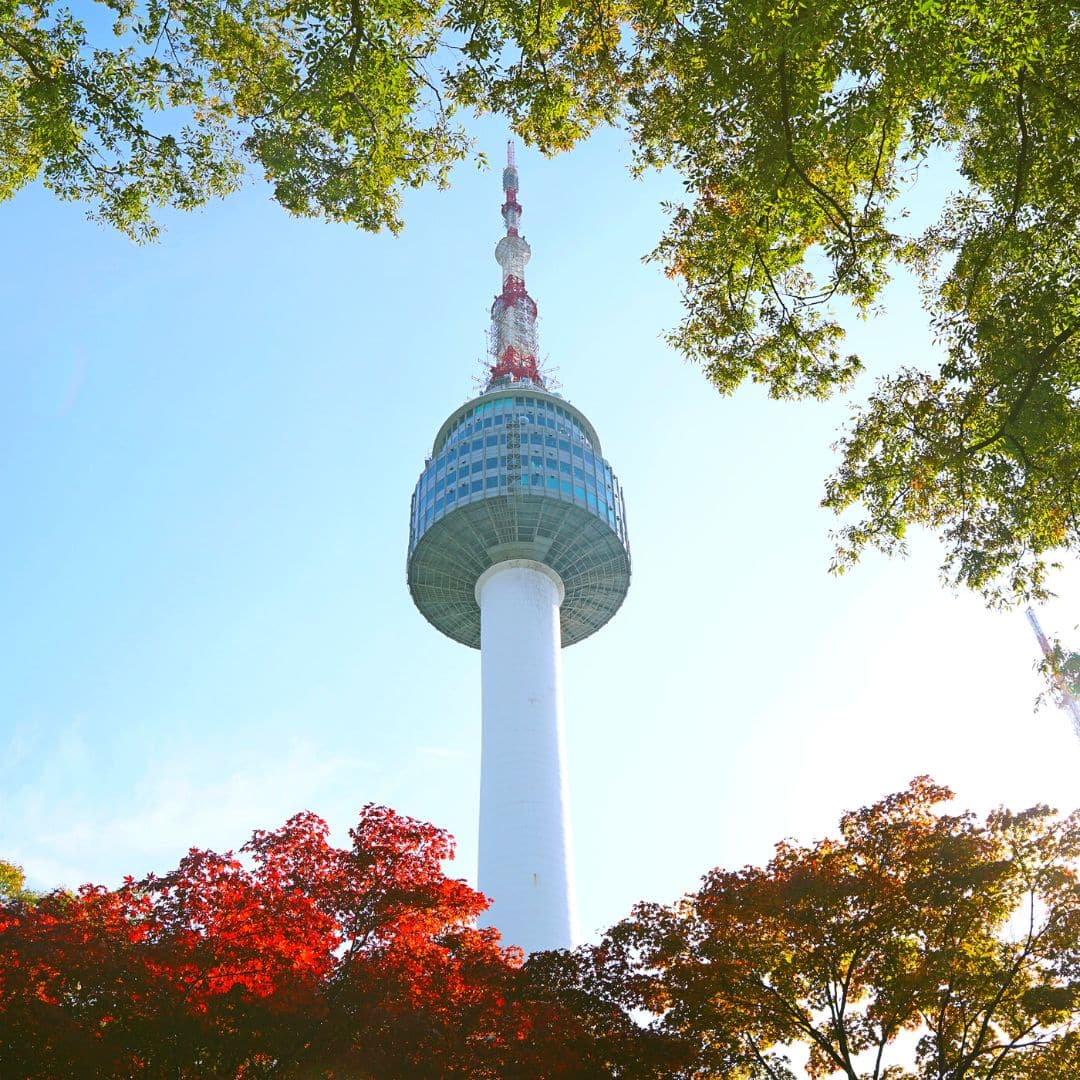
- Accommodation: $100 ~ $200 per night, per room (double)
You can book 4-star hotels in Seoul for very reasonable prices and enjoy both comfort and lower prices than you’d find at home. Korea has a wide range of comfortable mid-priced hotels.
- Food & Drink: $50+ per day, per person
With all-you-can-eat Korean restaurants that serve unlimited Korean BBQ and other dishes for under $20 or $30 per person, it’s easy to enjoy the best food Korea has to offer without breaking the bank.
- Transportation: up to $15 per day, per person
Use the subway and buses to get around the big cities and trains to travel further around Korea without breaking the bank. You can even splash out on a taxi and pay only a few dollars per person when traveling as a group for a few dollars extra.
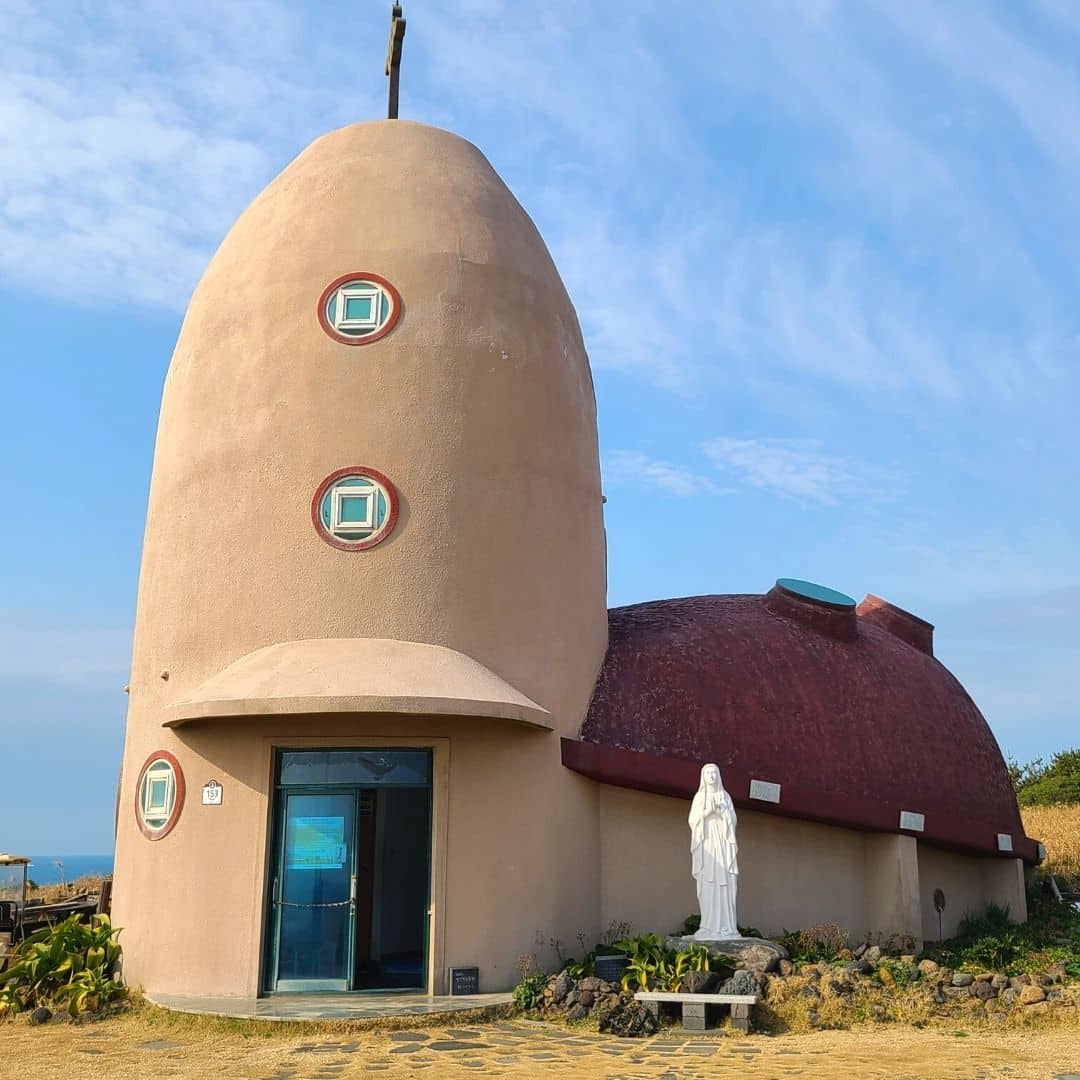
- Accommodation: up to $100 per night, per room (double)
Hostels and guesthouses can be found for under $50 per night and are perfect for somewhere to rest and recharge. If that’s all you need, save money here and spend it elsewhere.
- Food & Drink: $20 – $30 per day, per person
If you budget well and stick to street food, free hotel breakfasts, and convenience store foods, you can eat well and still have enough to splurge on good food for dinner.
- Transportation: up to $10 per day, per person
Walking and buses are cheap and convenient ways to travel around Korea’s biggest cities. Traveling from city to city is also cheap, with intercity buses costing less than $10 for 1-2 hour journeys.

Further Costs To Travel In South Korea
Besides these everyday costs to travel in South Korea, there are other costs that you’ll need to cover from time to time. These costs include internet & phone access, day trips, activities, souvenirs, travel insurance, and flights. These costs will be broken down into low and high-end costs that you can expect to pay in Korea.

Museums and galleries offer unique (and authentic) Korean souvenirs such as pottery, painting, tea & soju sets, and more. If you want something a bit more special, head to the underground markets near Gwangjang Market in Seoul and get your own handmade hanbok, which you can get posted back home to save luggage space.
- Small Souvenirs: $5+
- Korean Cosmetics: $5+
- Korean Artworks: $10+
- Korean Tea (box of): $10 to $20
- Korean Soju Set: $10 to $20
- Korean Handcrafts: $10+
- Tailored Hanbok: $200+
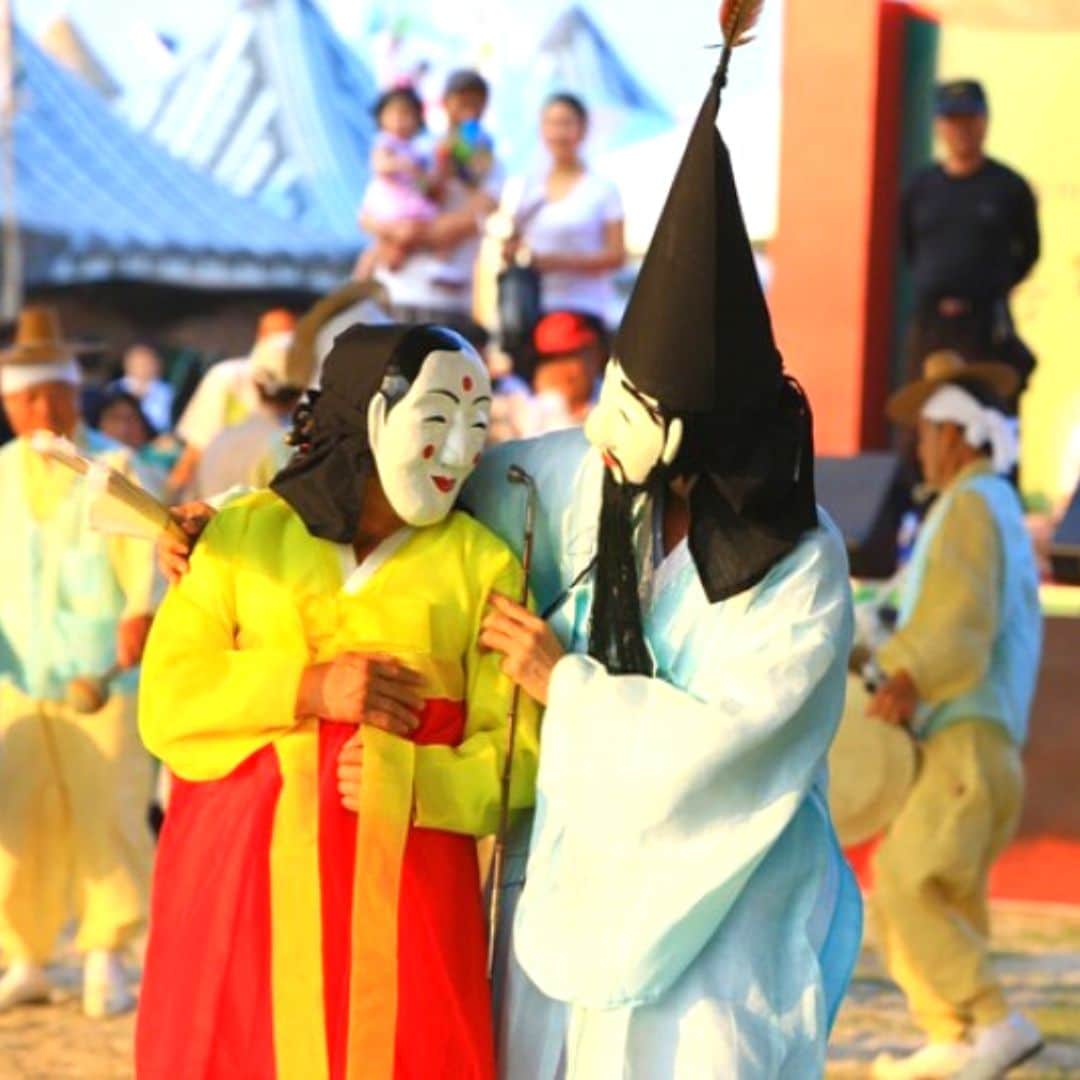
The day trip prices quoted below are the prices you can expect to pay with a reputable tour company like Klook or Trazy . Hiring a private guide will be a lot more expensive and might come to $200+ per day.
Please note: The prices quoted below are estimates and may change depending on the season or tour services.
- DMZ Tour – $50 to $120
- Nami Island Area – $40 to $70
- Everland Theme Park – $30 to $50
- Jeonju Hanok Village – $50 to $70
- Korean Folk Village – $50 to $60
- Seoraksan Mountain – $70 to $150
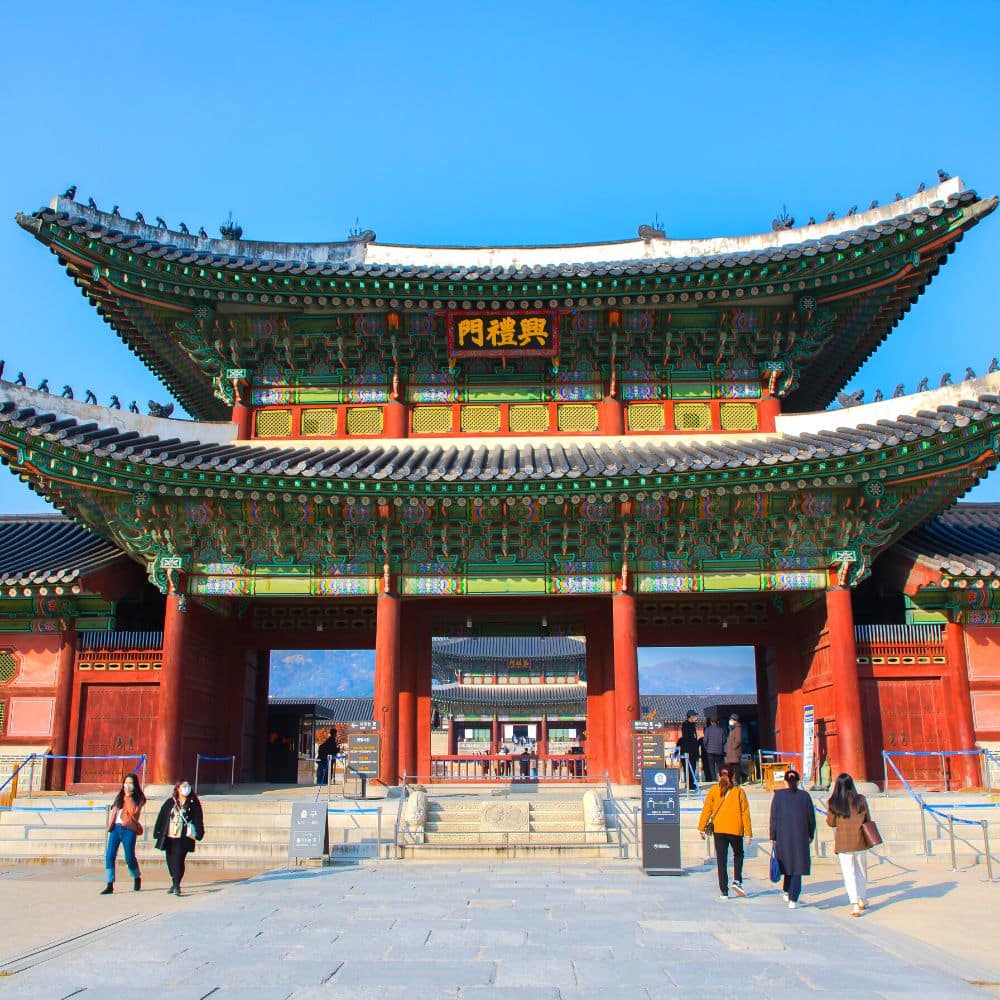
As mentioned earlier in this South Korea Travel Guide, buying a Discover Seoul Pass is a great way to save money on Seoul’s premium attractions.
- Royal Palaces – $3
- N Seoul Tower – $10
- Hanbok Rental – $10+
- Seoul City Tour Bus – $10
- Han River Cruise – $15 to $30
- Seoul Sky Observatory – $30 to $50
- Aquariums – $20 to $30
- Seoul Zoo & Seoul Grand Park $10
- Amusement Parks – $30 to $40
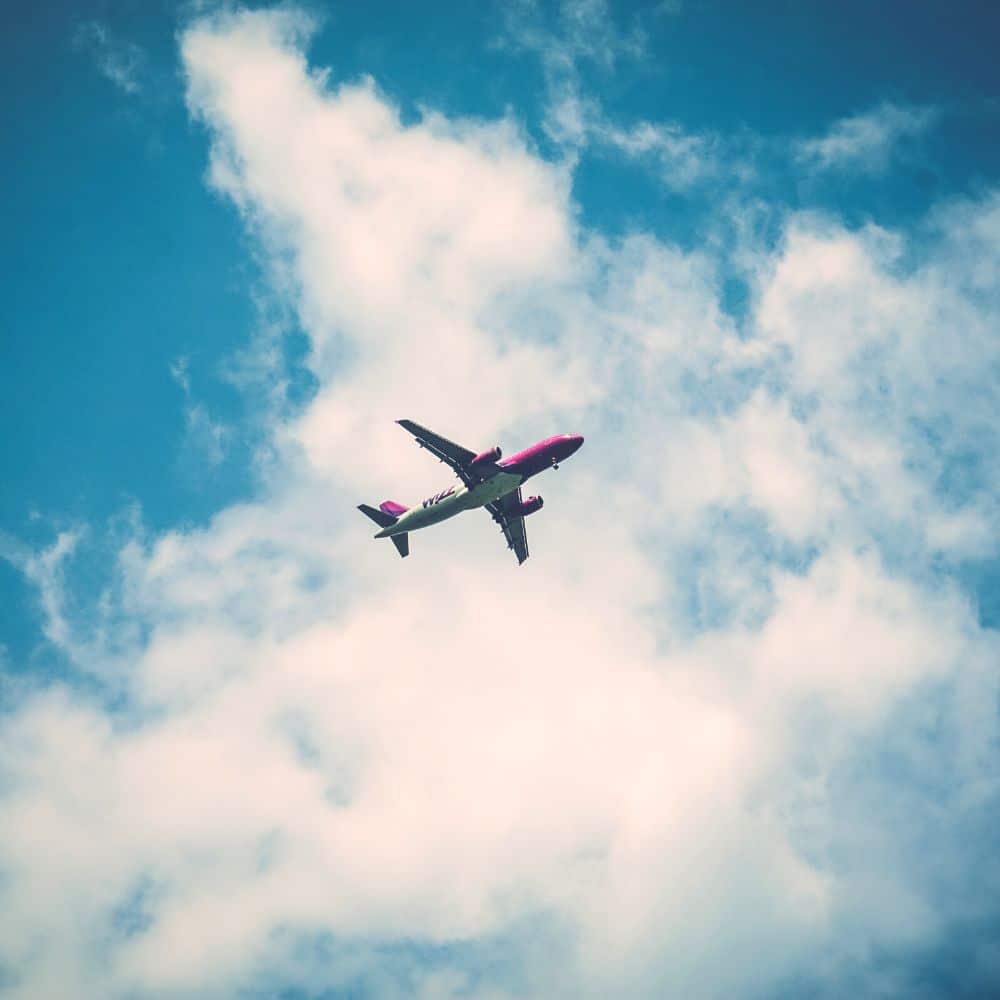
The cost to fly to Korea is more than twice the normal price right now. Fortunately, Korea ended the restrictions on the number of flights into the country from June 2022 and flight costs and availability should be improved in the near future.
Best of Korea recommends Skyscanner and Expedia for the best flight deals to Korea.

Why Travel To South Korea?
In recent years, travelers from around the world have been increasingly drawn to South Korea. The country is a must-see destination in Asia, with more than 17 million travelers in 2019. After reading this South Korea Travel Guide, you’ll understand what draws so many people to the Land of The Morning Calm, as Korea is also known.
There are myriad reasons why people visit Korea. Many come to experience life in a unique country, packed with historical and cultural sights that you won’t find elsewhere in the world. In the afternoon you can walk through a royal palace dressed in hanbok (traditional Korean clothes), sip green tea in a hanok (traditional Korean house), and pass Buddhist monks walking peacefully through an ancient temple.
Modern South Korean culture is conquering the world, with chart-topping acts that include BTS and Black Pink, Oscar-winning movies like Parasite, and phenomenally successful TV shows like Squid Game. This brings in legions of fans flocking to shooting locations and film sets to relive their favorite K-Culture moments. Some lucky travelers even get to catch sight of their favorite K-Stars walking around Gangnam, a hotspot for Korea’s most famous citizens.
Not only is Korea a beautiful country, it’s a country that will make you beautiful, with some of the world’s best fashion and beauty shops. Korea is famous for its K-Beauty products and is a beauty and fashion shoppers paradise. From the street fashions of Hongdae, to the luxurious fashion malls of Gangnam, and the wall-to-wall malls with discount clothes in Dongdaemun, you’re guaranteed to find something you can’t resist at a great price. If you prefer a cultural shopping experience, there are traditional markets all over Korea, where you can experience street food, buy novel gifts, and see how locals live and socialize.
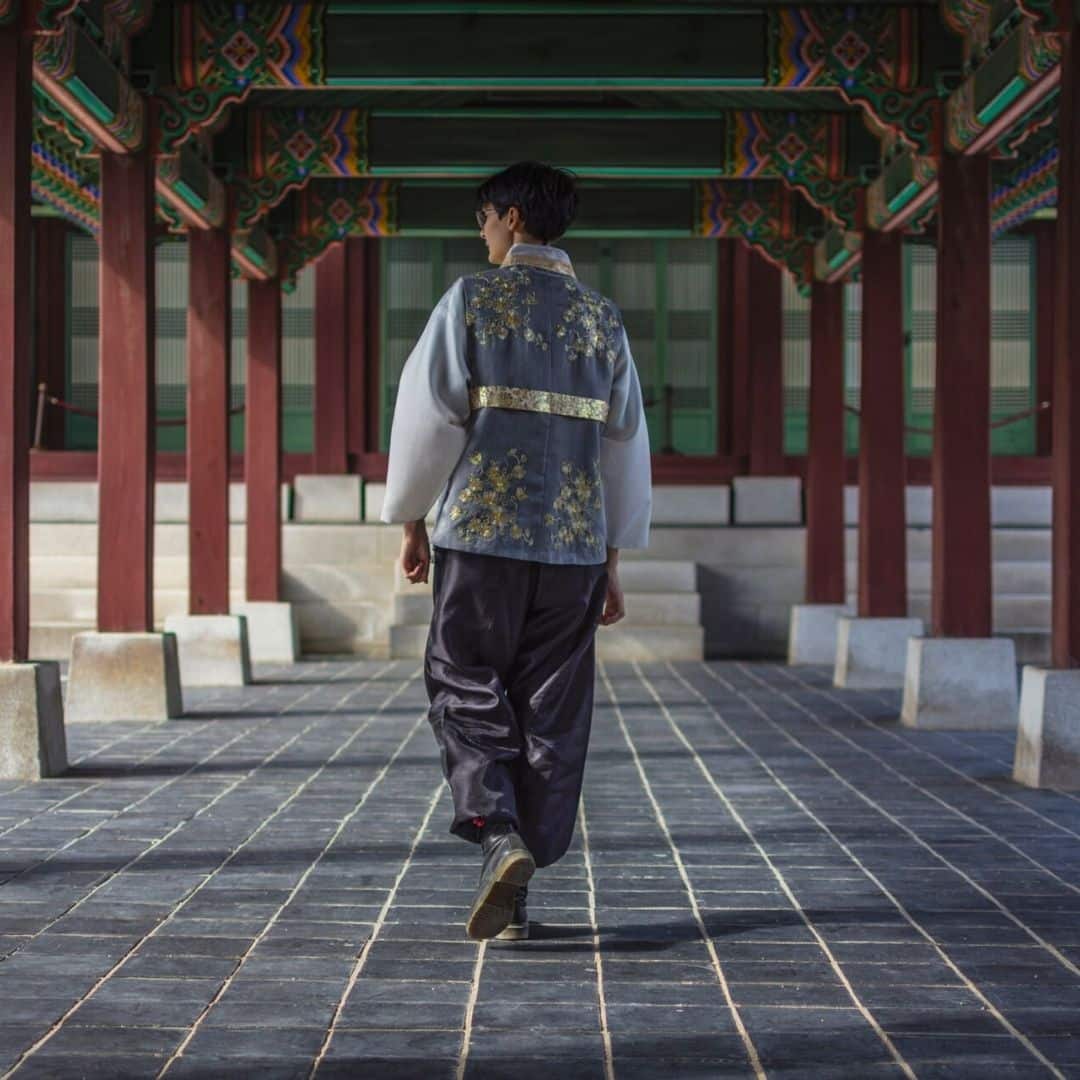
There’s so much more to South Korea than what you’ll find in the cities, however. South Korea, a country that’s 70% mountainous with coasts on three sides, offers so much to nature and adventure lovers. Hiking, South Korea’s national pastime, is a popular way to see more of the Korean countryside, looking down over rice fields, forested valleys, and pockets of urbanization. Skydiving, parasailing, scuba diving, water sports, cycling, rock climbing, white water rafting, and lots more are on offer and very reasonably priced. South Korea is a great place to enjoy the great outdoors.
The real jewel in South Korea’s natural crown, however, has to be Jeju Island – one of the New 7 Wonders of the Natural World. Explore lava caves, hike to the peak of the central dormant volcano (Hallasan Mountain), trek around the rugged coast, relax on a sandy beach in a modern cafe, and even try your hand at horse riding.
Whatever your reason to travel to South Korea, you’re sure to find more and more reasons to return again and again. Let this South Korea Travel Guide whet your appetite for your first trip, inspire you to plan a follow-up trip, and guide you to the best things to see and do in South Korea.

South Korea Travel Guide FAQs
Not sure about the South Korea travel restrictions and want to know more about visas, vaccinations, and what the rules are? This next section covers some of the most frequently asked questions about traveling to Korea now. If you have more questions that aren’t covered below, feel free to write to us on the Best of Korea Facebook page.
Do I need a visa to travel to South Korea?
US citizens and tourists from 111 other countries, including Canada and Mexico, don’t need a visa to travel to South Korea. The US government and South Korea have a visa-free travel arrangement and tourists can stay for up to 90 days.
What happens when I arrive in South Korea?
From September 2022 onwards it is no longer necessary to provide any vaccination status or take any PCR or RAT tests. A mandatory health check will be required, but this is only a simple form you can fill in on arrival.
What happens if I get a positive PCR result?
If you test positive for COVID-19 while in Korea, you will need to quarantine for 7 days at government facilities. Travelers who break the quarantine rules are subject to deportation or fines.
Can I travel to Korea if I'm unvaccinated?
Yes, you can still travel to South Korea if you’re unvaccinated. South Korea no longer restricts travel based on vaccination status (as of October 2022).
However, if a traveler (vaccinated or unvaccinated) tests positive for COVID-19 in Korea, they will have to self-quarantine until negative.
South Korea is a dynamic and culturally rich country that deserves a place on everyone’s travel bucket list. Known for its stunning blend of tradition and modernity, Korea features futuristic technology, bustling markets, and a thriving pop culture scene. Perhaps most importantly, visitors can expect a high level of safety and cleanliness while exploring the country and savoring its delicious cuisine.
This South Korea Travel Guide shows you where to go, what to see, and when to travel. Start your journey with itinerary ideas and pre-travel tips, the best day trips, and lots more essential Korean travel advice. Let’s go!
LATEST KOREA TRAVEL UPDATES
How to travel to korea, best destinations in korea, where to stay in seoul, korean travel tips, things to see & do, travel itineraries for korea, korean season guide, cost to travel to korea, further costs to korea, why travel to korea now, south korea travel faqs.
6/1/23 From June 1st, 2023, there is no longer any mandatory quarantine for COVID-infected people in Korea – both locals and travellers. The Korean government now recommends that infected people showing symptoms should self-isolate (voluntarily) for 5 days.
4/1/23 From April 1st, 2023, travelers from the USA and 21 other countries no longer need to apply for the K-ETA to travel to Korea. This will run until 31st December, 2024 and is designed to make it easier to travel to Korea.
3/20/23 From March 20th, 2023, the indoor mask mandate has been removed for public transport, including buses, trains, subway, taxis, and flights. The only remaining mask mandate is for medical facilities, including hospitals, care homes, and pharmacies.
How To Travel To Korea
Current Travel Restrictions For South Korea 2023
If you’re suspected of infection when you arrive (high temperature, feverish signs), you may be asked to take a PCR test. PCR tests are now free for travelers suspected of being COVID-19 positive within the first 3 days of arrival. This South Korea Travel Guide is regularly updated with the latest Korean travel restrictions.
Requirements To Travel To Korea
Here’s a simple 2-step guide about how to travel to Korea right now. Most restrictions have been lifted so travel to Korea is easier than ever. This applies to travelers from the US, Canada, and many other countries . As mentioned, it doesn’t matter whether you’re vaccinated or not.
Check the Korean Embassy if you’re not sure in either situation.
- When you travel to Korea, you will be asked to complete a self-check health questionnaire to show you’re not sick. You can do this when you arrive or complete it before you depart on the Q-Code website .
- You don’t need to do any testing before you fly, but it is a good idea to take a self-test to make sure you’re safe. If you’re infected in Korea, it’s necessary to do 7 days self-quarantine. You don’t need to bring copies of your vaccination records but printing a copy of the K-ETA is recommended.
No, travelers from the USA don’t need a tourist visa to enter South Korea. You can visit for up to 90 days visa-free. However, you must apply for the K-ETA before traveling and upload your travel plans and hotel details.
Here are 6 of the best destinations in Korea that you absolutely must visit, as well as some of the sights you’ll want to check out while you’re there. We’ll be bringing you lots more detailed destination guides in the future, so be sure to visit again soon

This Full Day Tour of Seoul will show you some of the hottest spots in the city, while this Customized Private Tour of Seoul will allow you to choose where to go.

Korea is a unique country with a written language that looks nothing like English, interesting Korean Cultural And Etiquette Rules , and an always busy lifestyle. Travelers may be lost trying to do even the simplest things.
If you’re traveling to Korea, you’re almost certainly going to want to get access to the internet to help you navigate, translate Korean, or even book tickets to attractions. Korea has one of the world’s best mobile internet and the prices are very reasonable. 5G mobile internet services are available across the country and Korea was one of the first to get the super-fast service. You won’t have problems connecting with a sim card or WiFi router when you travel
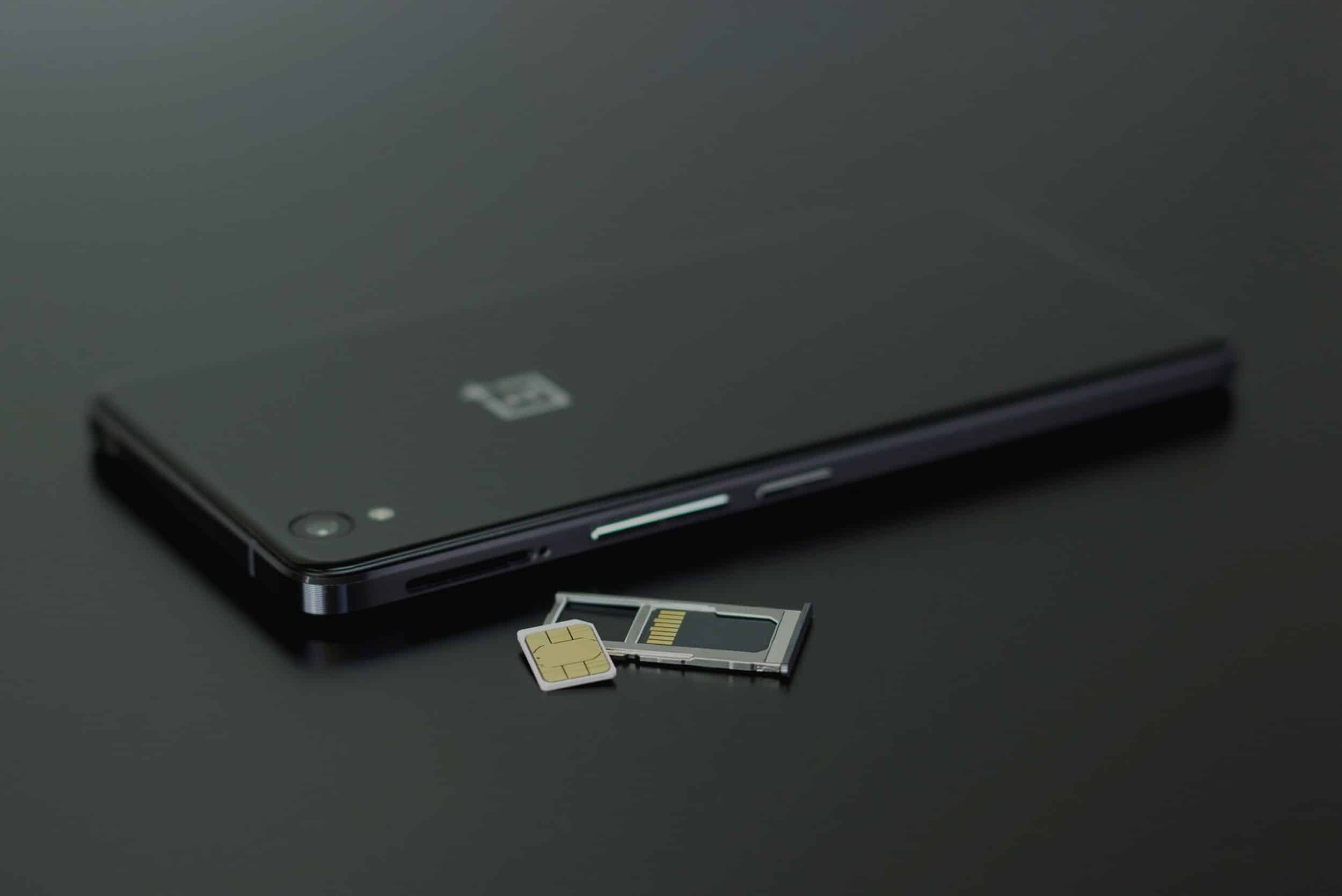
Traveling to any country involves potential scams, bad exchange rates, mistakes, and confusion when it comes to dealing with foreign currency. Fortunately, travelers to Korea have a wide range of options for travel money both before and while they travel.

South Korea is a country packed with famous landmarks and sights, unique culture – modern & historical, family-fun activities, outdoor adventures, cozy cafe districts, and natural wonders. There’s more to do in Korea than you could imagine and it’s impossible to explore it all in one trip. Try to plan your itinerary by cities and locations. For example, plan your day in Seoul and stay by the district.
Here are some of the best things to see and do in South Korea, broken down into different themes so you can find things that interest you the most. The location of each of these attractions is included, too, so you can create a city-by-city itinerary, seeing the best South Korea has to offer.
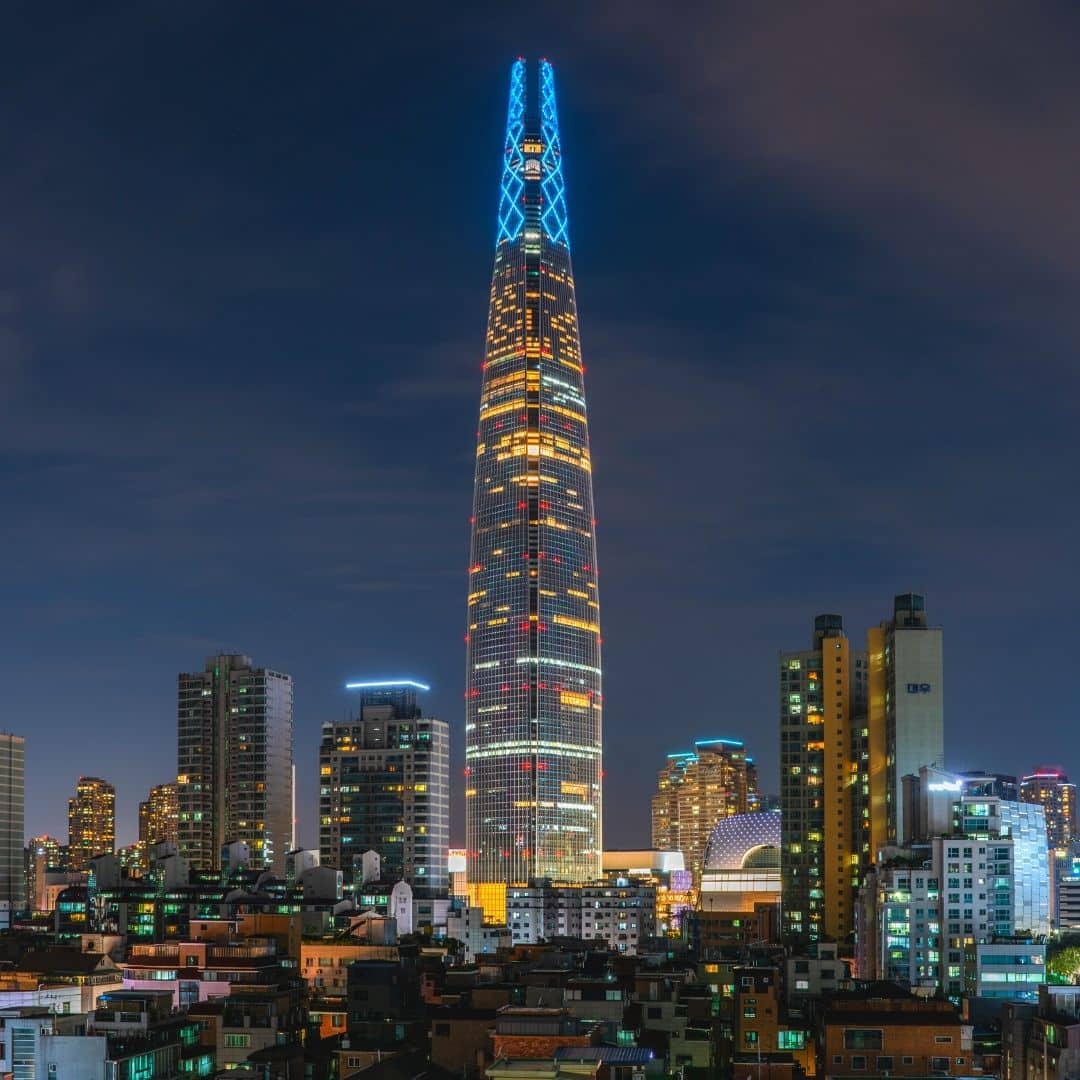
Any South Korea Travel Guide would be incomplete without thee top landmarks & famous areas in Korea. These unmissable Korean attractions offer some of the best sights in Korea, showing you Korean history, culture, design, and sense of humor.
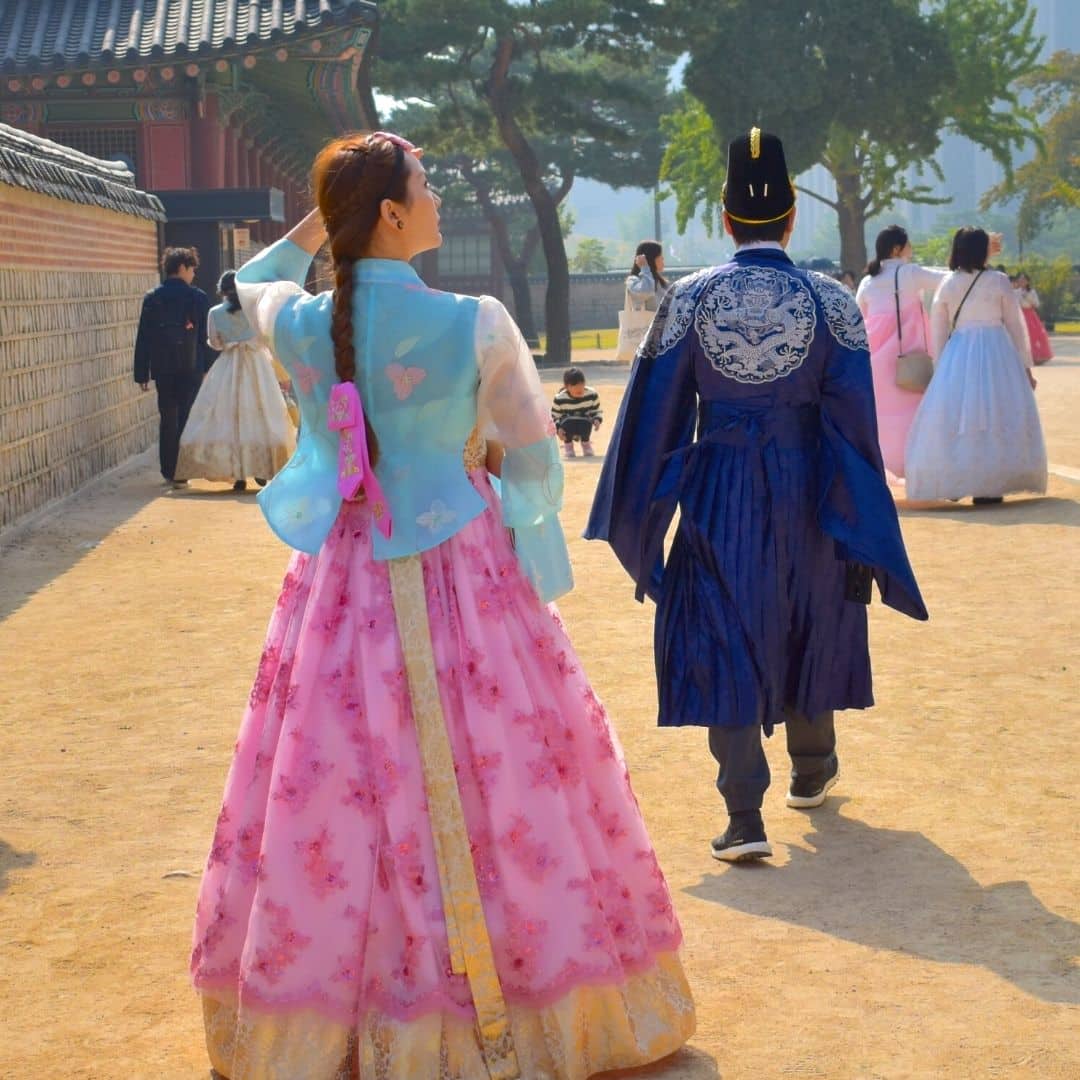
Learning about Korea’s past is not only enjoyable, it’ll also open your eyes to how modern Korean culture has evolved. Witness the majesty of grand palaces and the humble Buddhist temples and gain an insight into life in Korea with these fascination historical sights.

Are you a fan of Korean culture? Then check out these 10 modern K-Culture locations in Korea. Whether you’re ARMY or an arthouse cinema fan, you’ll love these sights. K-Drama fans, check out these K-Drama Filming Spots in Seoul .

If you’re traveling to Korea with your family, you don’t need to worry about the kids getting bored. There are plenty of family-fun attractions in Korea to keep them amused and to show them what Korea’s really like.

Culture lovers will find no shortage of places to learn about Korean, Asian, and world history & culture. Korea has a rich history and displays this through a range of museums. Learn about traditional life, Korean wars, the democracy struggles, and even kimchi .

Once a land of teahouses, Korea has now fully embraced coffee culture. Korea’s late-night culture makes cafes a great place to gather and chat. The rise of social media has also led to hundreds of insta-worthy cafes with photogenic decor, unusual coffee designs, and delicious desserts.

Many people travel to Korea just to shop, thanks to the low prices, haggling in the markets, and good quality items. From traditional markets to high-end designer goods, there’s somewhere to shop for everyone. Be sure to try authentic Korean street foods in the markets, too.

Korea is a country surrounded by sea on 3 sides and 70% mountainous, giving it a wealth of natural beauty. Besides Korean cherry blossoms , flowers, and fall foliage, there are sculpted gardens, shimmering ponds, riverside parks, and a volcano to see.

Morning : Explore Seoul’s historic royal palaces starting with Gyeongbokgung or Changdeokgung Palace in central Seoul. You get free entry if you’re wearing a Korean hanbok, so be sure to pick one up from the rental shops outside.
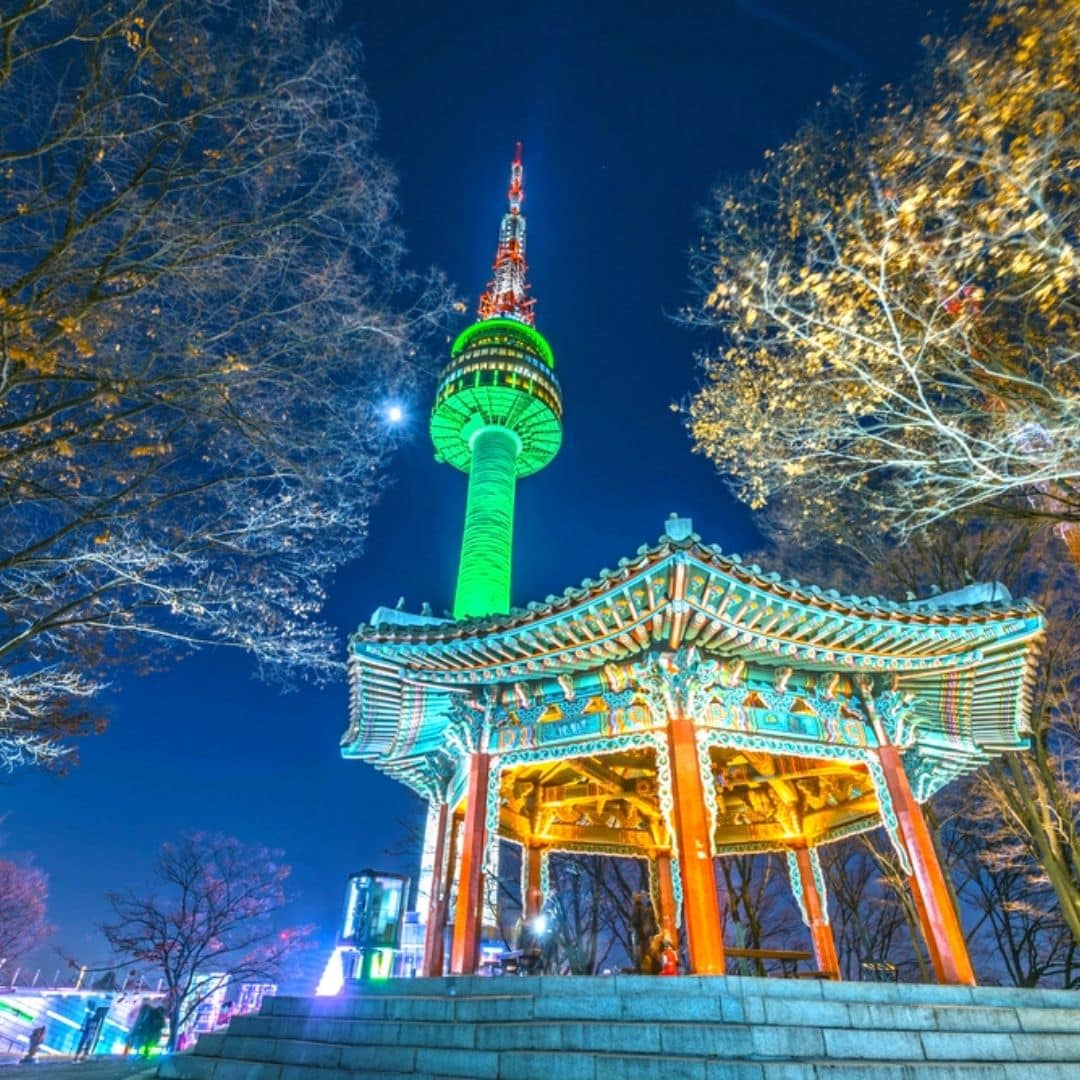
Morning : Learn about Korea’s history at the National Museum or War Memorial in Yeongsan. These fascinating museums have interactive exhibits and feature 1000’s of years of Korean history.

Morning : Take a day trip from Seoul to explore Gapyeong County. See the wonders of the Garden of Morning Calm and its idyllic nature. This is one of the most beautiful gardens in Korea.

Morning : Grab an early breakfast at Seoul Station and ride the high-speed KTX train directly to Seoul. It takes less than 4 hours and rides past rice fields, mountains, and the Korean countryside.

Morning : Take a day trip to the UNESCO World Heritage City of Gyeongju and roam the Gyeongju Historic Area. See Daereungwon Tomb Complex and Cheomseongdae Observatory.

Morning : Pack your bags and ride the KTX back to Seoul. Head to Hongdae for street food snacks or Michelin-starred delights in famous restaurants.

March to May

June To August

September to November

December to February
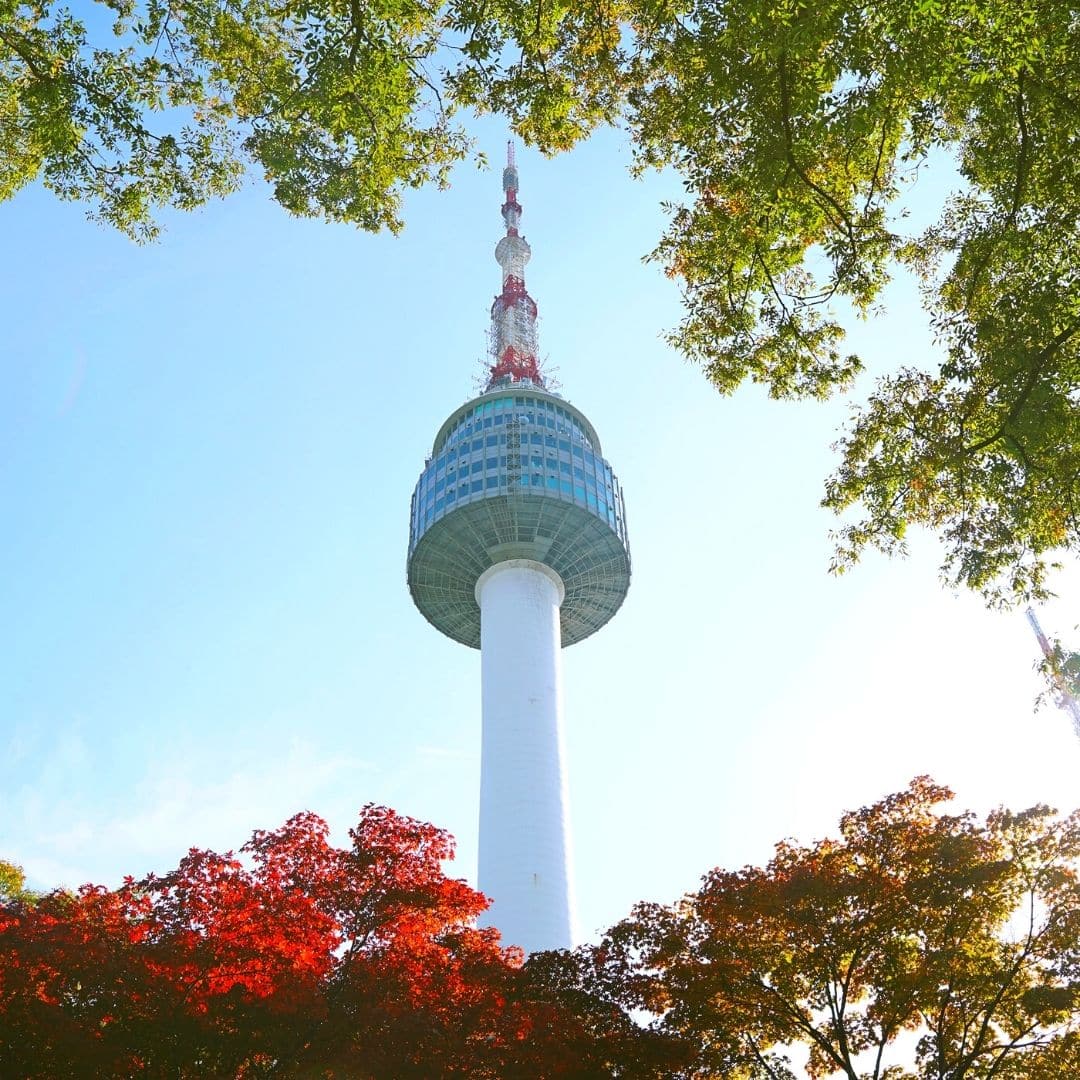
Korean Souvenir Costs
The best places to buy souvenirs in Korea are in the traditional markets and tourist areas. Insadong in Seoul has a lot of art and souvenir shops, as do the market streets around Bukchon Hanok Village. Hongdae offers lots of bargain snacks and souvenirs to take home.

Day Trip Costs From Seoul
A day trip from Seoul is a must to see a different side of Korea from what you’ll experience in the capital. Taking a day trip is a great chance to experience Korea’s countryside, nature, and hard-to-reach cultural attractions.

Korean Activity Costs
Seoul and other Korean cities have so much to offer to tourists. From historical palaces to exciting theme parks and attractions, it’s easy to have fun, explore, and discover more about Korea’s history.

Flight Costs To Korea
Flight costs depend on which airports you’re traveling from. A flight from Los Angeles to Incheon Airport (Korea’s main airport) costs around $1370 right now. Flight costs vary depending on the season and time of day.
Welcome to Best of Korea!
Please Sign Up for Updates
We hate spam. You can unsubscribe anytime.
Get Daily Travel Tips & Deals!
By proceeding, you agree to our Privacy Policy and Terms of Use .
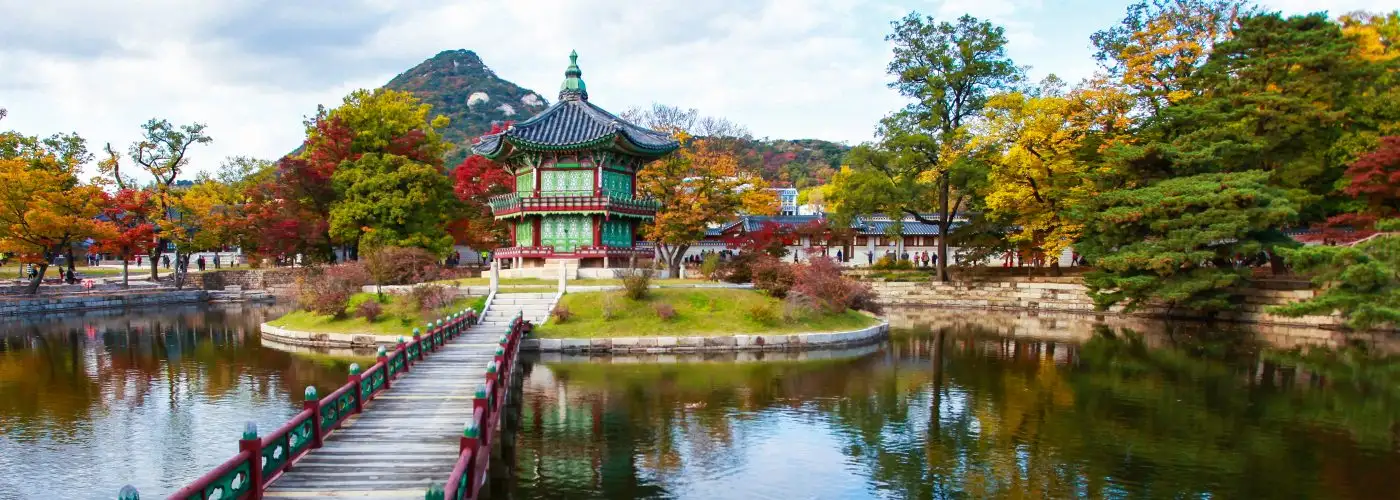
Tipping in South Korea: The South Korea Tipping Guide
Kate H. Knapp
Travel Smarter! Sign up for our free newsletter.
Tipping in South Korea isn’t customary, but there are times when a tip is welcome. This South Korea tipping guide will help you know if and when to tip.
Tipping in South Korea
Tipping in South Korea isn’t customary, and is therefore not expected or an obligation. In fact, it is not uncommon for staff to politely refuse a tip if the establishment doesn’t accept gratuity. You won’t offend someone by not tipping, but there are times when a small token of appreciation is welcome, such as in Western-influenced businesses or when hotel services are exemplary.
Though tipping isn’t common in most places, there are some general guidelines that you can use to help ensure a stress-free vacation. This South Korea tipping guide will help you navigate if you can leave a little extra for great service.
The South Korea Tipping Guide
Restaurant Server : A tip of 5 to 10 percent given directly to the server is acceptable in Western-influenced restaurants, but isn’t recommended in traditional restaurants. Don’t be surprised if a tip is politely refused.
Bartender: There is no obligation to tip at a bar.
Tour Guides : A tip is not expected, but you can try to give 5 to 10 percent of the cost for a memorable tour.
Taxis: You can let the driver “keep the change” for a smooth and courteous ride, but a formal tip isn’t standard practice and, therefore, isn’t recommended.
Doorman: Tipping isn’t common or expected, but feel free to give a little extra for exemplary service.
Bellhop: Tipping isn’t common or expected, but a small tip is always appreciated.
Housecleaning: Tipping isn’t common or expected, but is most appreciated when service exceeds expectations.
Concierge: A tip is not expected, but feel free to show your appreciation with a small amount for a special recommendation or hard-to-get reservation.
Stylist : A tip isn’t expected, but you can try to leave a little extra if thrilled with the new look.
Spa Service Provider : Tipping isn’t expected, so it is up to you if you decide to offer a little extra to the staff. Don’t be surprised if a tip is politely refused.
More from SmarterTravel:
- Tipping: The Ultimate Guide to Tipping for Travelers
- Does the Hotel Maid Look Through Your Stuff?
- Hotel Tipping—Do You or Don’t You?
We hand-pick everything we recommend and select items through testing and reviews. Some products are sent to us free of charge with no incentive to offer a favorable review. We offer our unbiased opinions and do not accept compensation to review products. All items are in stock and prices are accurate at the time of publication. If you buy something through our links, we may earn a commission.
Top Fares From

Don't see a fare you like? View all flight deals from your city.
Today's top travel deals.
Brought to you by ShermansTravel
Croatia, Slovenia & Montenegro: 9-Night, Small-Group...
Indus Travels

5-Star, All-Inclusive Exploration Small-Ship Cruises w/Up...
Swan Hellenic

Ohio: Daily Car Rentals from Cincinnati

Trending on SmarterTravel
- Work with me
- Privacy policy

- Years in review
- United Kingdom
- Bosnia & Herzegovina
- North Macedonia
- Philippines
- South Korea
- South Africa
- Africa Overlanding
- Central America
- New Zealand
- Solo Travel
- Budget travel
- Travel tips
- Travel itineraries
- Hidden gems
- Bucket list
- Travel resources
- Digital nomadism
- Blogging tips
- Start a travel blog
30 South Korea Travel Tips To Know Before Going!
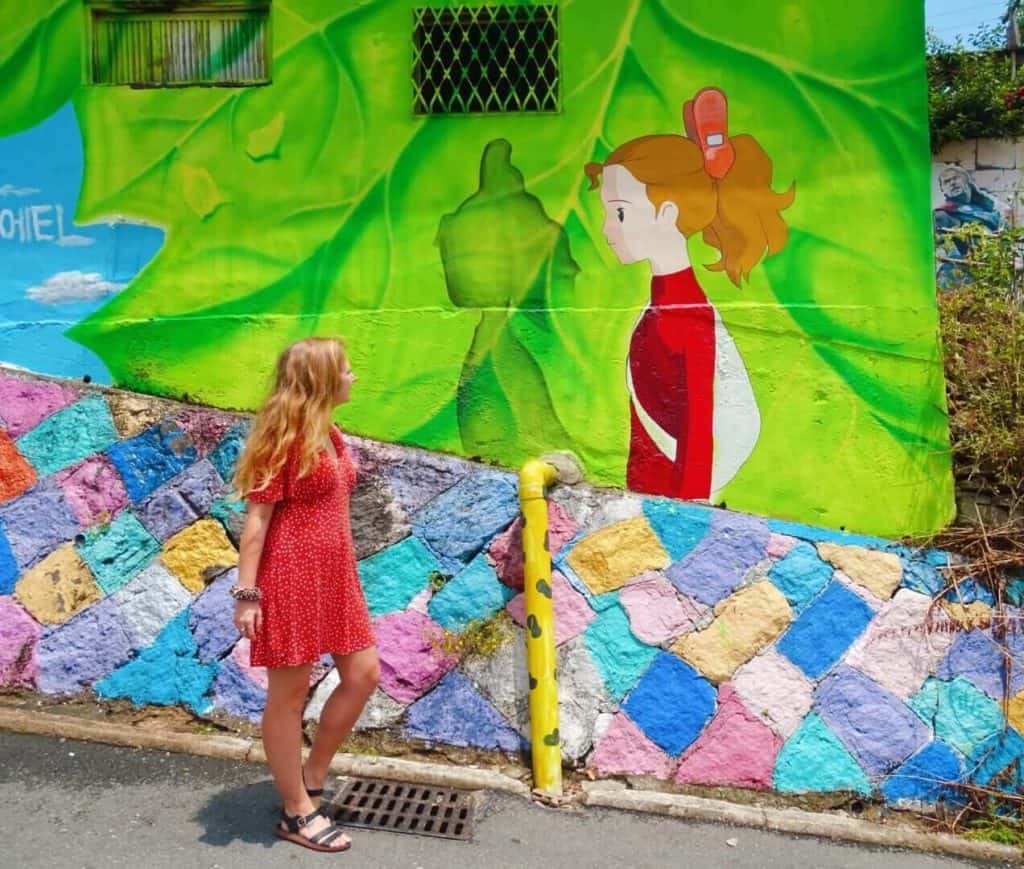
Table of Contents
This post may contain affiliate links to things like tours, hotels, Amazon associates and products. These help me earn a small commission at no additional charge to you.
South Korea is a place you’ll benefit from researching before visiting. If you’re reading my South Korea travel tips, you’re already doing a good job! Saying this, I went in fairly blind and didn’t do much research before I arrived. Nothing went majorly wrong but there were a few things that floored me, such as why Google Maps wasn’t working and why no one would sell me an aff ordable SIM card!
KOREA ESSENTIALS Accommodation: Booking.com / Hostelworld Activities: Viator / GetYourGuide Getting there: air ( Skyscanner ) Getting around: Train ( Trip.com ) / bus Pre-book private airport to hotel transfer Travel insurance: True Traveller (European travellers) / Hey Mundo (other nationalities) / Safety Wing (digital nomads)
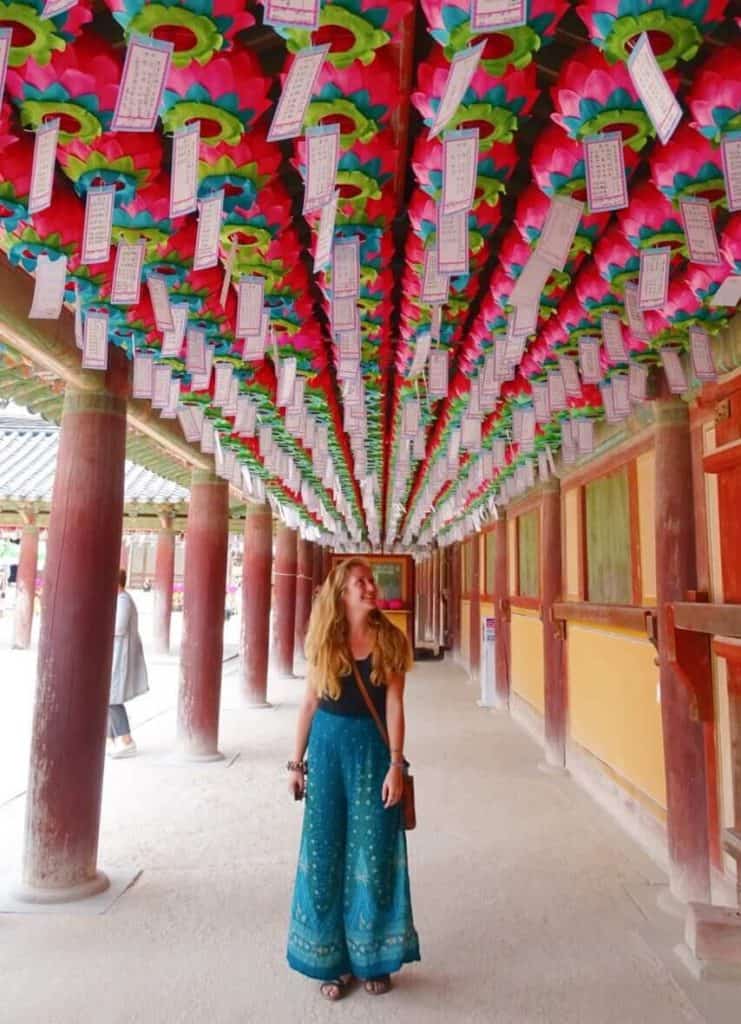
South Korea tips
After spending three weeks in South Korea , I feel confident to share my Korea tips and advice. I can’t promise I know absolutely everything about the culture and history (although I did my best) but I’m certainly clued up when it comes to Korea travel tips. The following 30 tips for visiting South Korea are designed to share practical advice and cultural know-how, making your trip easier and more meaningful. Here are some things to know before going to South Korea:
Psst – looking for Seoul travel tips? Check out my Seoul itinerary and guide!
1. Data is expensive
My first Korea travel tip relates to the internet. I assumed I’d buy a local SIM like I do everywhere but this turned out to be more complicated than I’d realised . Without a residency card, you can’t access the deals the locals get. I tried asking in countless stores and phone shops but to no avail.
2. But Wi-Fi is everywhere
When visiting South Korea, ask yourself if you actually need a SIM card. I’ve never been anywhere with quite so many Wi-Fi hotspots. Every subway station has Wi-Fi access as well as many trains and local buses. Whenever I was out sightseeing, I’d nip into a station to download directions to my next location even if I wasn’t catching a train. I got by fine without data so you might want to disregard my South Korea travel tip #1 and use Wi-Fi instead.
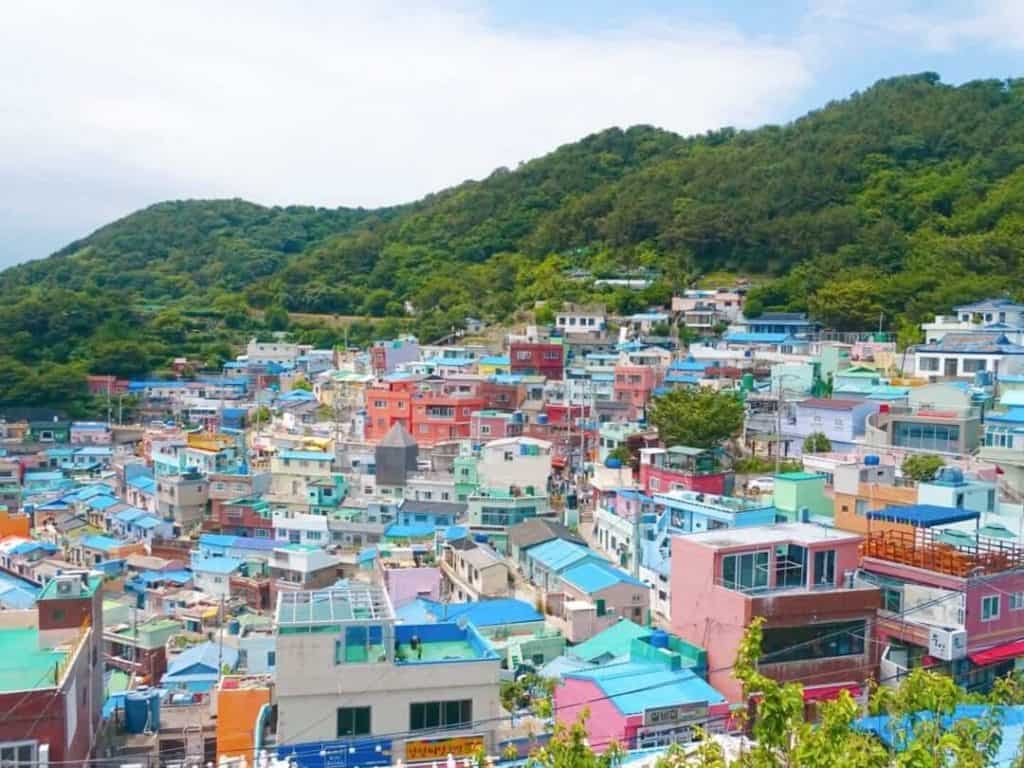
3. Rent your SIM/hotspot at the airport
If you do decide you’d rather get a SIM card than rely on Wi-Fi, a good option is to pre-order one and collect it at the airport. I started my SIM card hunt by asking my hostel owner where to get one. She answered ‘the airport’ which wasn’t ideal since I’d just spent an hour coming from there. Yep, it’s hard to find tourist SIM cards anywhere but the airport so this is definitely a helpful thing to know before visiting South Korea. B ook your 4g SIM to collect at Seoul airport . The other option is renting a portable Wi-Fi device. This often works out a bit cheaper than a SIM card and they also can be collected at the airport. Reserve your pocket Wi-fi device here.
4. Tipping isn’t necessary
Worried about the cost of travelling in South Korea ? I’ll touch on this later but there’s one thing you don’t need to worry about: tipping. The price you see on a restaurant menu or at the bar is exactly what you’ll pay. In fact, tipping can appear quite rude, just like in Japan. Giving a tip might suggest you think a waiter is below you hierarchically which is obviously to be avoided. Save those pennies for dessert!
5. Google Maps doesn’t really work
I’d never been somewhere without Google Maps so I was very surprised when I arrived in South Korea. It’s not that Maps doesn’t work at all but it’s not regularly updated and the maps won’t load to a close level. Public transport directions work but walking and driving ones do not. South Korea prefers to rely on its own system rather than global companies which explains its reluctance to partner with Google. Some apps for travelling in Korea are Naver Maps and KakaoMap.
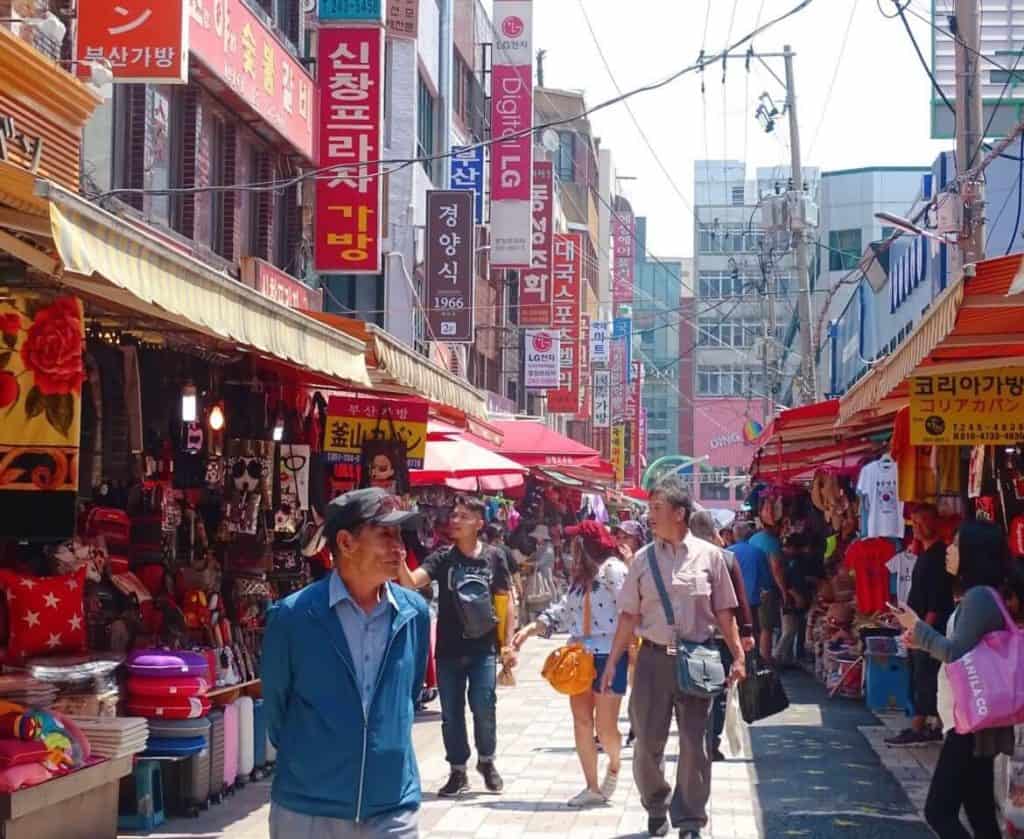
6. South Korea gets COLD
A tip for visiting South Korea in the winter is to prepare for the weathe r. Unlike other places in Asia that stay warm all year round, South Korea has severe winters. This means you’ll want to look at the seasons and weather before planning your trip, or at least dress accordingly. As a lover of the sun (and a backpacker with too many sarongs and summer dresses), I waited for spring to visit. But if you have a woolly wardrobe ready to be packed, winter might be a beautiful time to visit South Korea.
Of all the things to know before going to Korea, the weather may be the most impactful. Here’s a rundown of the seasons.
- Spring (March to May) – the best time for cool temperatures and seeing cherry blossoms
- Summer (June to August) – hot and humid in the cities but generally manageable
- Autumn (September to November) – this season is short with cool temperatures of 10-20 degrees. Note this is typhoon season.
- Winter (December to March) – temperatures go down to -3 degrees.
7. It’s amazing for hiking
One thing that South Korea isn’t overly famous for is hiking . I hope this changes because this green and glorious island is the perfect place for long and short hikes for all abilities. I took some excellent day trips from Busan that nature lovers will enjoy. Most are super easy to reach from the city thanks to efficient public transport.
Worthwhile hikes include:
- Bukhansan National Park from Seoul
- Seoraksan National Park (2.5 hours from Seoul, stay over in Sokcho city)
- Apsan Park and observation deck from Daegu
- Palgongsan Mountain from Daegu
- Igidae Coastal Walk from Busan
- Taejongdae Resort island hike from Busan.
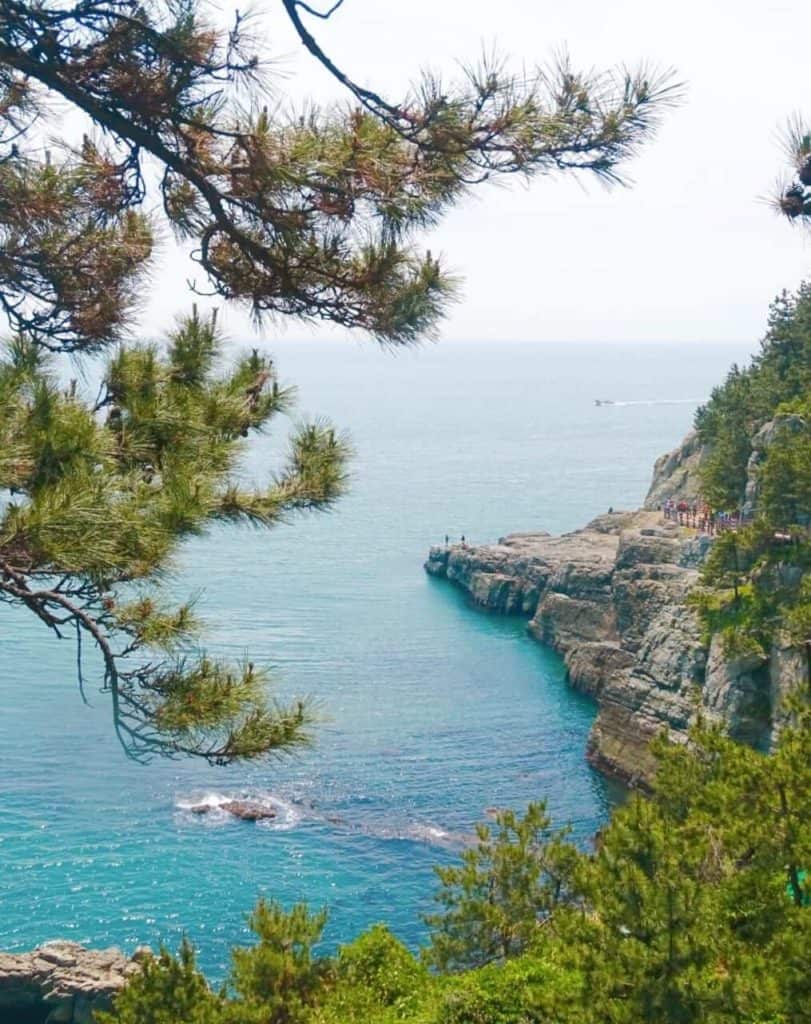
8. The Korean alphabet is easy
Apparently! I can’t say I learnt it but many travellers claim it’s pretty easy, plus it would be a fun activity for your South Korea bucket list . Of course, I’m not saying that learning fluent spoken Korean is easy, but knowing the alphabet will enable you to recognise dishes on menus and place names. If you’re good with languages, this could be a worthwhile tip for visiting South Korea.
9. Get a Tmoney card
My top South Korea tip for getting from a to b? Purchase a travel card. Tmoney cards only cost 500 won when you consider that you get back 3,500 of the 4,000 deposit you pay. They make travelling South Korea so much easier because you don’t need to queue for ticket machines and you can quickly tap onto any bus or subway train. You can buy them at subway stations and convenience stores.
10. The subway is efficient but don’t overlook the buses
Jumping on buses in foreign countries can be nerve-wracking but don’t worry in South Korea. The buses are safe, efficient and regular. For certain routes, they’ll even be quicker than catching the subway. Personally, I much prefer to get my bearings and watch the world go by from the window of a bus than sit underground so I always take the bus when I can. In smaller cities like Daegu, Gyeongju and Jeonju , buses are the only option as there’s no subway. This South Korea travel tip is to embrace them!
11. Use Trip.com to book trains
You can book trains on Trip.com , the official partner of Korail (the railway network of Korea). This is the only train website that will take foreign payment card.
12. For buses, just show up
Unfortunately, for buses, you can’t use Trip.com and other booking websites only take Korean payment cards. Don’t worry because buses rarely book up so you can just turn up on the day. This is what I did and never had any problems. As a general rule, before moving to a new place I checked out bus and train prices then took whichever was cheapest or quickest, depending on how much time I had.
13. You can only visit the DMZ with a tour
Visiting the DMZ is a fascinating addition to your South Korea trip. However, the only way to visit is with an official guide and organised tour group. Check out my tips for taking a DMZ tour from Seoul .
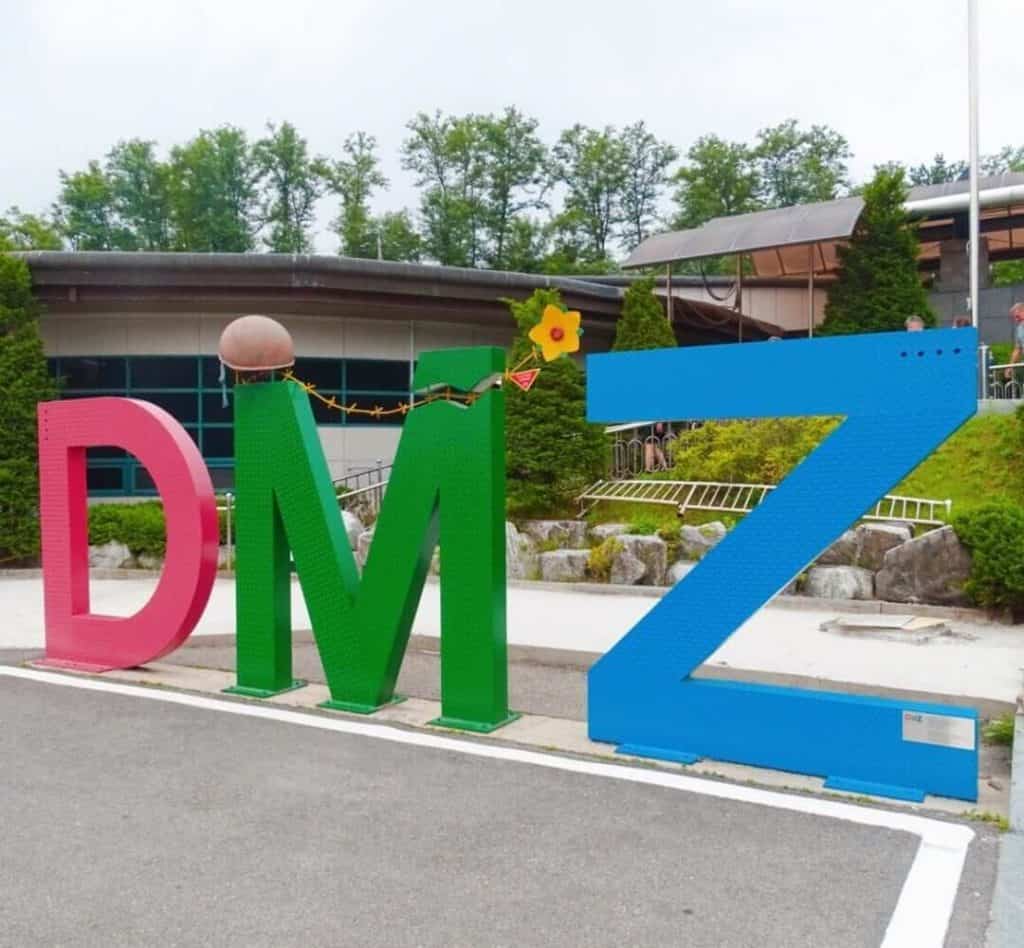
The second thing to know about visiting the DMZ is that tours can book up during busy months. Book a couple of days in advance if possible. An additional South Korea tip: bring your passport to the DMZ with you otherwise you’ll be refused entry to the area. Imagine coming all that way and not being allowed in!
14. There are lots of affordable tours
Despite the fact that general costs are higher in South Korea than many other Asian countries, the price of tours a r e pretty similar. Trips and day tours on GetYourGuide and Klook start at $15, a useful Korea tip if travelling on a budget without your own vehicle.
15. Bank cards are widely accepted
Before arriving in South Korea I’d been in Southeast Asia, somewhere you can rarely pay on card. While I’d recommend having some cash on you in South Korea, most restaurants and shops do allow card transactions. However if you’re having street food for dinner, it’s cash payment or going hungry.
16. The currency is the South Korean won
The South Korean currency might make you feel wealthy but soz, it’s an illusion! The rate at the time of writing (Jan ‘22) is 1,600 to the pound or 1,200 to the dollar. You’ll be dropping at least 5,000 for dinner and 20,000 for hostel beds.
17. Prices are fairly high
I’d put South Korea between Southeast Asia and the West in terms of costs. You’ll certainly find it expensive if you’re used to Vietnam or Thailand but it won’t seem so bad if you’re arriving from the UK or US.
Read next: Korea on a budget
Hostel dorms cost around 20,000 won (£15 / $18) per night; street food meals cost between 2-5,000 won; cheap restaurant meals cost between 5,000-10,000 won; and train journeys are between 5-000-25,000 won. If you’re looking for South Korea tips for travelling on a budget, you need to get familiar with market food and dorms!
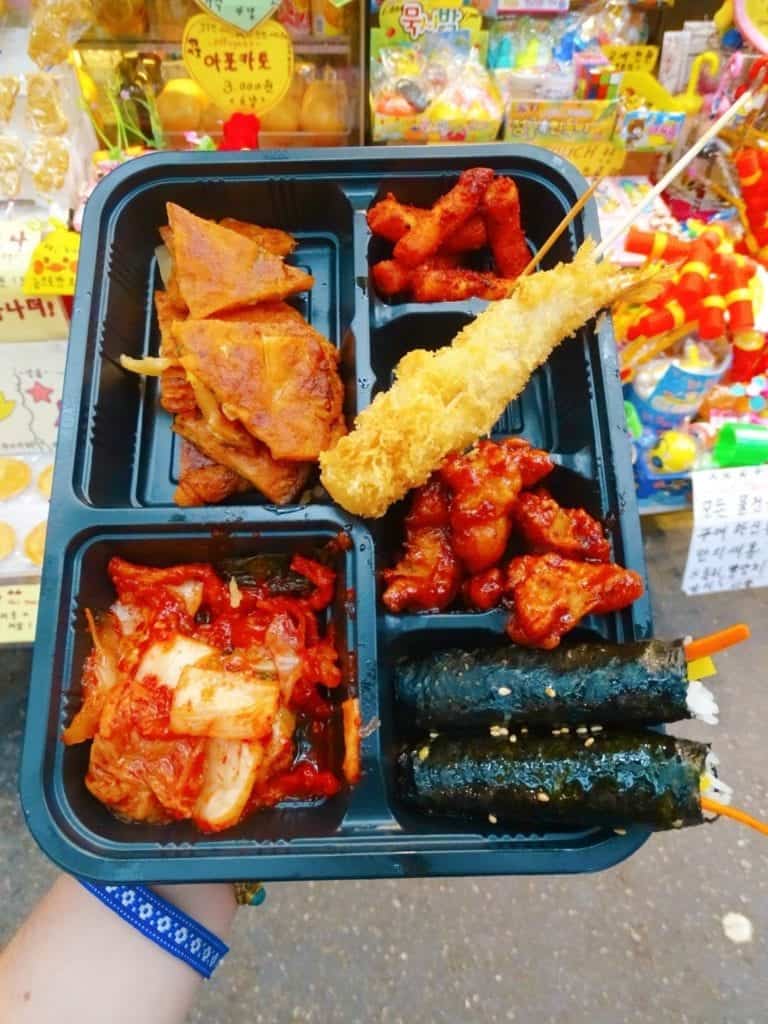
Read next: guide to Seoul street food
18. The beauty culture is something else
Get ready to be bombarded with beauty products left right and centre ! The South Korean beauty industry is one of the biggest in the world worth over $10 billion US. It’s also impossible to avoid. South Koreans are often super glamorous and rely heavily on whitening p roducts. Areas of Seoul like Myeondong are packed with beauty stores selling everything you never knew you needed. They’re a lot of fun to browse.
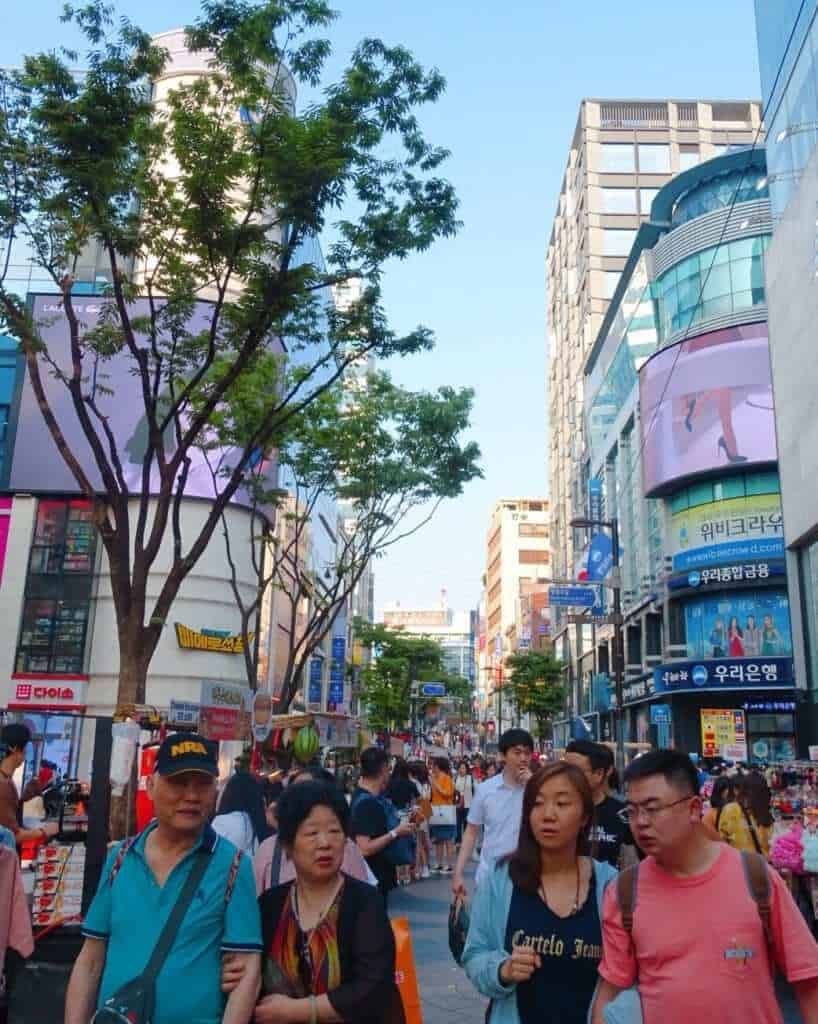
19. Get ready to feel scruffy!
On that note, I’ve never felt scruffier than in South Korea. My backpack wardrobe was passable in other Asian countries but felt oh-so-crumpled and faded compared to what the locals wore. Particularly in Seoul! If you’re looking for Seoul travel tips, I would suggest you pack a few smart outfits if you want to visit nice restaurants and bars. They aren’t mandatory but might make you blend in better!
20. Go hard or go home
I was surprised to learn that South Koreans are big social drinkers and love to party. Previously I’d been in Taiwan where the drinking culture was virtually nonexistent so I’d expected more of the same. How wrong I was! In Seoul’s Hongdae, local partygoers stay out until 6am. You’ll also see businessmen pretty tipsy after post-work drinks. It was a side I’d not seen before in Asia and liked – after all, how often do you get to party with the locals?
21. Soju is life
If you’re headed to South Korea and don’t yet know Soju, you’ll want to remember this Korea travel tip. Soju is a fermented spirit and the national drink of South Korea. Apparently, it’s considered offensive to refuse a shot. And we wouldn’t want to cause offence now, would we? 😉 If you’re backpacking Korea on a budget, there’s a second reason to know about soju. It’s very cheap. Drinking soju at home is a fraction of the cost of drinking at a bar. Visit the 7-Eleven for apple, grape and grapefruit flavoured soju that can be drunk neat (it’s nowhere near as strong as the flavourless version).
22. There’s nowhere as crazy as Seoul
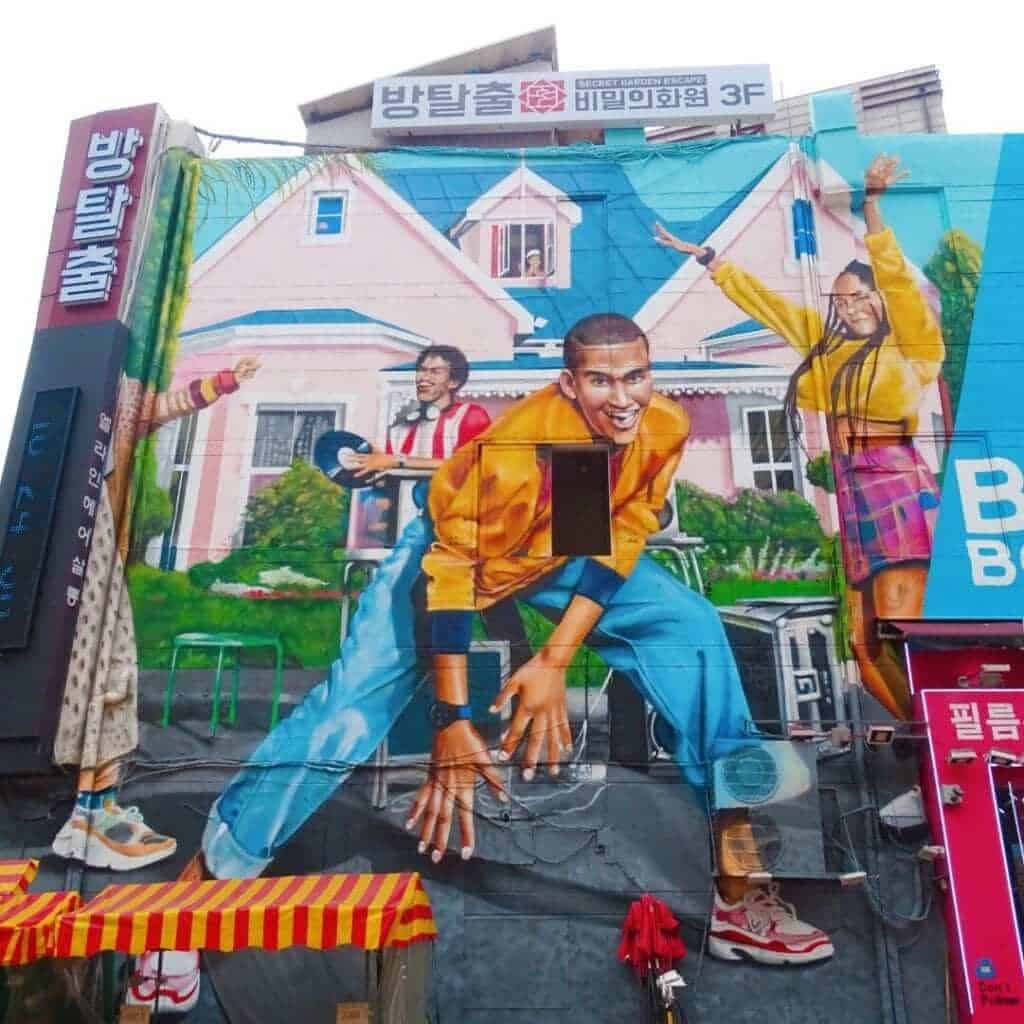
Seoul is different from anywhere in the country. It reminded me of London in that way. If you try and compare anywhere else in South Korea to Seoul, you’ll end up surprised or even disappointed. While I’d recommend around 3 days in Busan , I’d suggest at least 5 days in Seoul. Nowhere rivals Seoul in size, quirkiness or diversity of the things to do. For a real taste of what makes Seoul special, visit Hongdae in the evenings. You’ll find live music, street food, bizarre cafes where you can pet sheep and racoons, street art, and locals dining out and drinking coffee ‘til 4am . And partying ‘til even later!
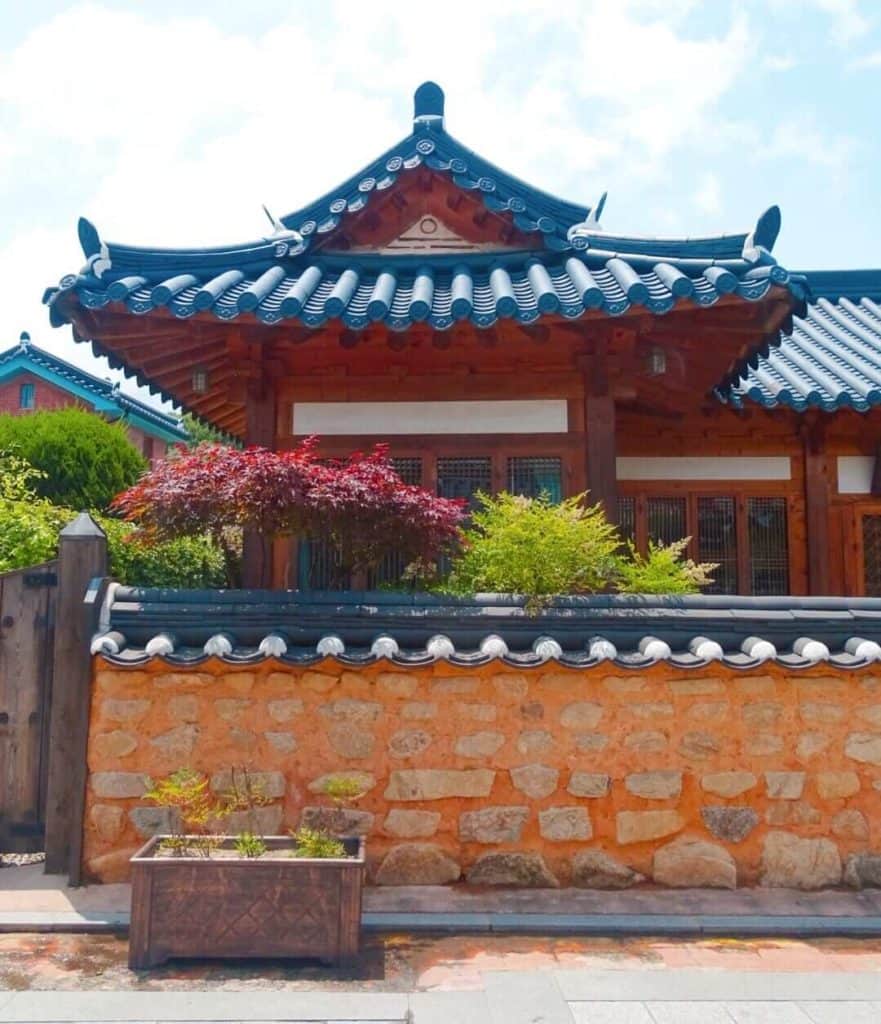
23. Buddy up for dinner
Something I didn’t anticipate in South Korea was not being to dine solo. Sure, sometimes newbie solo travellers might feel uncomfortable dining solo anywhere but that’s usually down to fear of being judged rather than actual restaurant restrictions. For Korean barbecues and dak galbi meals (a chicken and cheese hotplate dish), there’s often a minimum of 2 diners required. Super annoying right? My best South Korea travel tip is to always ask. I found a barbecue restaurant that were happy to seat me but charged me an extra 5,000 won (£3). Irritating but better than not being able to try a Korean barbecue while in Korea. The other option is to stay in a hostel where they offer shared dinner trips to counteract this problem.
Read next: tips for solo female travel in South Korea
24. Veggies & vegans may struggle
South Korean food is meat-heavy, from barbecues to Korean fried chicken and street food. Even bibimbap usually contains beef although you can usually ask for it without. Use HappyCow to seek out veggie and vegan cafes and restaurants. You can also check out this Seoul vegan guide .
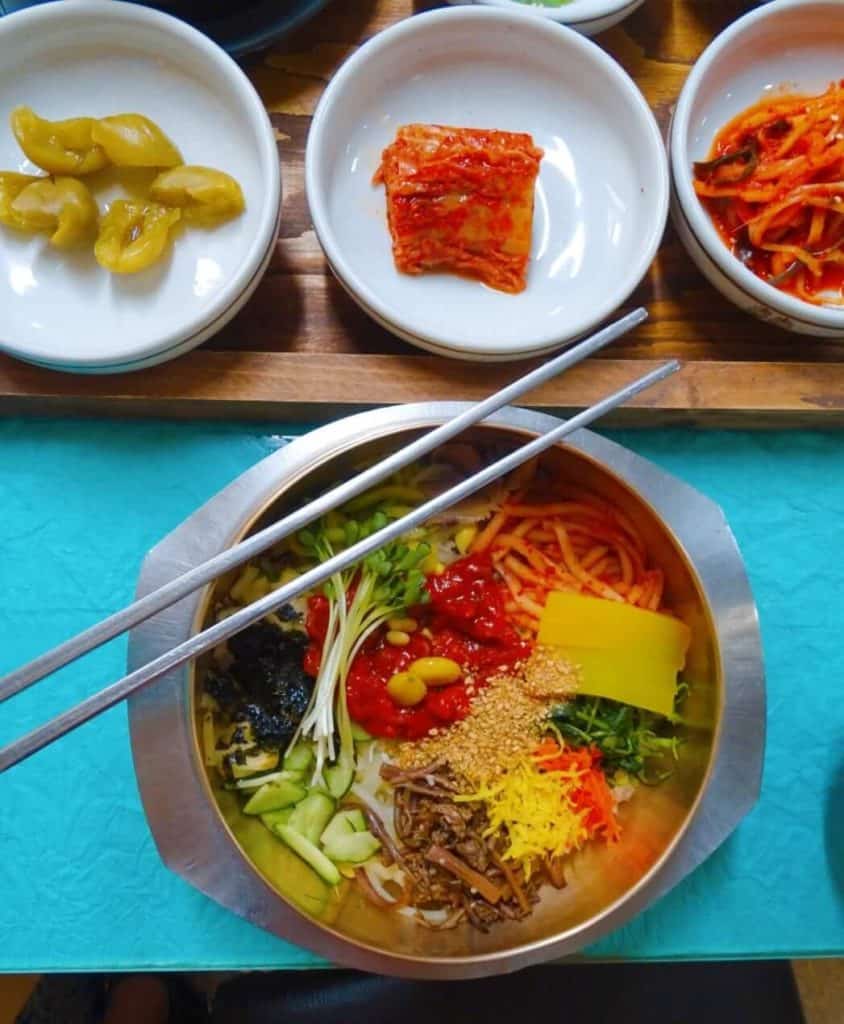
25. Fresh veggies are hard to find
This follows on from the last point. I’m not vegetarian but that doesn’t mean I want to eat fried meat three times a day and never see a vegetable! Of all the places I’ve been (apart from maybe the P hilippines), South Korea is the most challenging for finding fresh food. The best you’ll get in a 7-Eleven is a lone banana wrapped in plastic and strapped to polystyrene. Supermarkets aren’t prevalent so unless you know where the local markets are and manage to haggle in Korean (or with a bit of pointing and gesturing) it can be tricky. My best Korea travel tip for staying healthy is to have a Korean barbeque meal and go easy on the meat and heavy on the salad bar. Otherwise, get your miming skills on and pick up some sweet potatoes and peppers at a local market.
26. South Korea is safe for solo females
Super safe! South Korea has a low crime rate and you’ll feel perfectly safe during your trip. The locals can be shy when talking to foreigners but they’ll certainly help you out if they can. Whenever I asked for directions, they went out of their way to help even if they clearly had no idea! Check out my solo female travel archives for travel tips around the world.
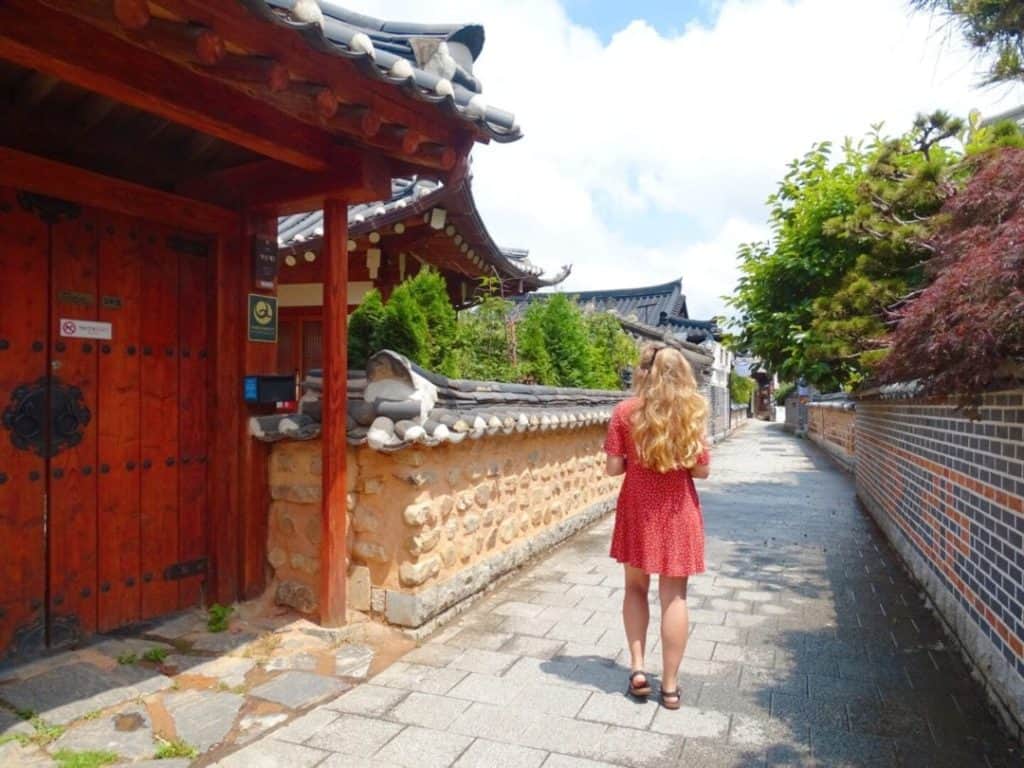
Finally, some tips around etiquette and society…
27. South Korea only became wealthy recently
South Korea today is thriving, especially in the cities. Locals have money for leisure and socialising which means there are great cafes, restaurants and theme parks. However this hasn’t always been the case. The Korean War lasted until 1953, destroying the economy and ripping the country in two quite literally. For many years, people struggled and the average family had very little to live on. Nowadays things have drastically improved. Young people may not remember the dark days but the older generation do. Many traditional professions are dying because young people prefer to work in offices or within the tourist industry. I can’t say I blame them but it’s a sad situation to consider.
28. South Koreans are very romantic
When you arrive in South Korea, you might notice the couples behaving very… coupley. Although not quite how they would in the West. Rather than openly kissing, young couples in South Korea like to play fight in a cutesy way. They’ll tickle each other’s arms, pinch ears, lovingly caress elbows. Well, each to their own right? Apparently, showing public affection wasn’t considered acceptable until a couple of decades ago. In fact, it was frowned upon to even hold hands. Nowadays, young people are enjoying their newfound freedom – elbows and all! The other thing to know? There’s a huge pressure to couple up. Single shaming is way worse than the West and I’m sure some of us can vouch for how bad it is there!

29. Respect the elders
Most Asian societies have strong respect for their elders but Korea has a whole language to honour theirs! The Korean language takes into consideration the relationship between the speaker and their subject. So if you’re addressing someone of hierarchal superiority (like a boss, customer or teacher) or an elder, you’ll use different nouns and word endings. You’ll only use informal versions if someone is younger than you or an employee/student. And getting it wrong is considered very rude. Eek. It’s unlikely to affect you as a tourist but you should always try to be extra polite and respectful to older Koreans.
30. South Korean society is stressful for young people
This point is more of a cultural one than a tip for visiting South Korea. However I think it’s an interesting point to consider while travelling around. South Korea is a wealthy nation with good education and career opportunities for young people. Perhaps because of recent improvement in these areas, the older generation are keen to ensure their children and grandchildren do as well as possible and therefore sometimes put tremendous pressure on them, in terms of getting good grades and then high-flying jobs. Despite being modernised, South Korea is still a conservative country. Gay rights are poor and sex before marriage is still frowned upon. People are expected to get married young and feel they are ‘left on the shelf’ otherwise. Combine that with unrealistic beauty standards (remember all those products I mentioned) and I’m sure you can imagine the stress on young South Koreans. With all the above considered, it’s little wonder mental illness and suicide rates are at an all-time high for South Koreans. With a long life expectancy and ageing population, the problem even extends to older people who don’t want to be a burden on their families. You’ll unlikely see any evidence of this travelling around but it’s something to think about, plus we should all practise kindness wherever we go!

Thanks for reading my South Korea travel tips!
Check out my other South Korea blogs:
- South Korea 2 week itinerary
- The perfect 5 days in Seoul
- Korea travel budget guide
- Solo female travel in Korea
- A guide to visiting Jeju Island without a car
- Best things to do in Busan + 3 day itinerary
- Tips for visiting the DMZ from Seoul
- Jeonju travel guide & 1 day itinerary
- The ultimate South Korea bucket list
- 20 best South Korean foods to try
- The best day trips from Busan
See you next time for more adventures,
For more travel content, follow me on Instagram , Facebook , Twitter and YouTube .
Ps. Liked these Korea travel tips? Pin this for later!
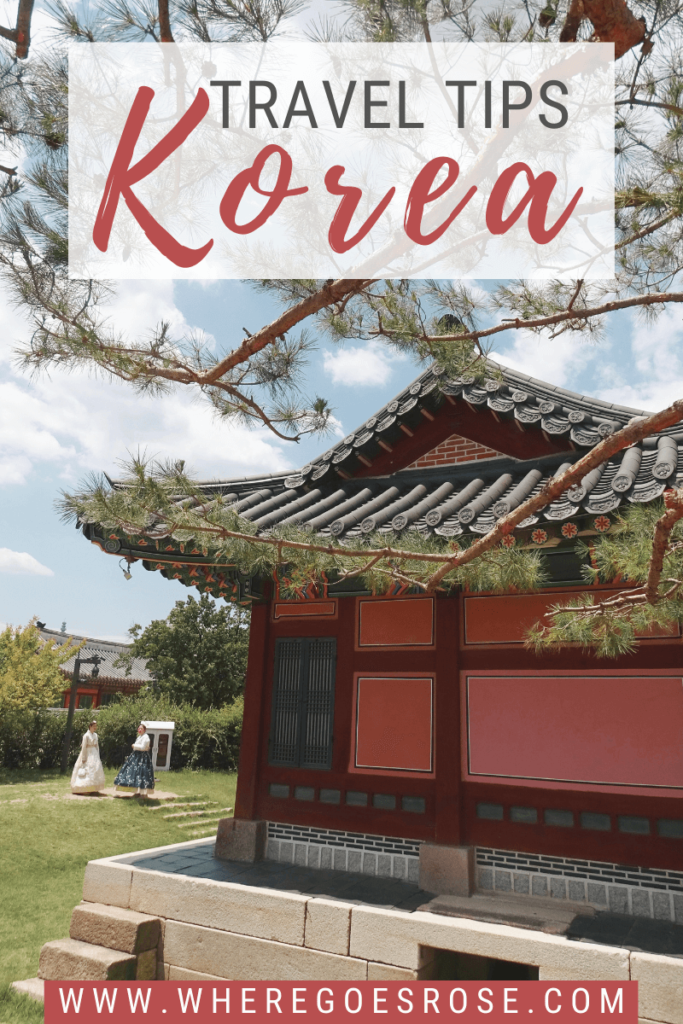
VISITING SOUTH KOREA? These are my trusted resources: Getting around by air – I use Skyscanner to find the best-value flights, using the ‘search by month’ tool to find the cheapest dates. You can also use the ‘to anywhere’ feature if you’re flexible on where you’re going. Buses – buses are comfy and efficient. It’s tricky for foreigners to book online so it’s best to turn up on the day. Trains – use Trip.com , partner of Korail (the official railway network of Korea) to book your tickets in advance. The website accepts international payment options, unlike Korean rail websites. Click the three stripes in the top right corner then the flag to change it to English. Driving in Korea – use Rentalcars.com to compare car rentals. Hiring a car will be especially useful on Jeju Island. For hotels in Korea, I use Booking.com – they also have self-catering apartments. You can filter by review score and price to find the best-rated budget places. For hostels, I use Hostelworld . To save money on accommodation, I use Trusted Housesitters , a website that connects homeowners going away and travellers who can sit their homes & pets. Browse South Korea tours and activities on GetYourGuide . I also check Viator and Klook in case they have a better price. For food tours with passionate local chefs and foodies, check out EatWith . Need travel insurance ? I use True Traveller (for UK & Europe residents) since it’s affordable but covers everything you’d need including various activities, valuables and pre-existing conditions. Unlike some companies, they insure you if you’re already travelling / don’t yet have your flight home booked. Get a quote . For travel insurance for other nationalities, I recommend Hey Mundo and for long-term digital nomad travellers, I suggest Safety Wing . Check out my resources page for more travel discounts and tips!
Rose is a solo traveller from the UK who has been on the road since 2015. She wants to show other women that solo travel isn't scary and doesn't have to be expensive! Rose has lived in Mexico, Canada and all over Asia, seeking out food, bubble tea and street art wherever she goes!
1 thoughts on “ 30 South Korea Travel Tips To Know Before Going! ”
Excellent post, very complete. Thank you!
Leave a Reply Cancel reply
Your email address will not be published. Required fields are marked *
You can see how this popup was set up in our step-by-step guide: https://wppopupmaker.com/guides/auto-opening-announcement-popups/

- Accomodation
- Attractions
- Food & Drink
- K-Entertainment Tours
- Korean Culture
- Shopping Destinations
- Transportation
- Travel Essentials
- Travel Tips
- Travel News in Korea
- Gyeonggi-do
- North Gyeongsang (Gyeongsangbuk-do)
- North Jeolla (Jeollabuk-do)
- South Chungcheong (Chungcheongnam-do)
- South Gyeongsang (Gyeongsangnam-do)
- South Jeolla (Jeollanam-do)

First-Timer’s Ultimate South Korea Travel Guide – Things to Know Before Traveling to South Korea

5,167 total views, 1 views today

Before making your travel plans South Korea, check out this South Korea travel guide that will help you in finalizing your travel itinerary!
South Korea is a country of juxtaposition. You can find serene mountain valleys bumping against pulsing lights and rush of 24-hour cities. Korean tradition collides with ultra-modern fashion and design. To experience the depth and vibrancy of the country, you must see the serene countryside as well as rapidly changing cities.
There is something for everyone in the country, whether you like city-life, mountains, beaches, or anything in between. Planning can become a bit difficult as there is so much to see and do in South Korea.
Traveling to a new country like South Korea can be very exciting. It’s a whole new adventure waiting for you, but the entire planning and going to a different country can be a bit distressing. The culture, the people, and the laws governing the country are probably very different from where you are from. This is why we have compiled a guide for you of what to expect when you visit South Korea for the first time.
Table of Contents
South Korea Travel Guide
Most travelers do not need to get a visa to travel to South Korea. You can check the visa requirements on your country’s State Department website. Citizens from many countries have visa-free entry for a limited period under certain conditions. To check whether you can enter Korea without a visa issuance, please contact a Korean Embassy or consular offices in your country or visit the Ministry of Foreign Affairs to confirm.
There are some changes to visa requirements for Jeju Island in lieu of COVID-19 situation worldwide.
The local language is Korean, and it script is Hangeul. But there is no need to worry! There are lots of signs in and around the city in English as well. A lot of restaurant menus also include translations of main dish ingredients.
You can always learn a little Korean before you travel from apps like Duolingo . The locals are definitely going to appreciate your efforts!
Money Matters
The official currency of South Korea is ‘ Korean Won .’ Most places accept credit cards too. Small stores and mom-n-pop food outlets generally accept cash only.
Getting around in South Korea is very easy. There are domestic airlines, trains, and intercity buses. It’s easy to move around within the country. Even intercity travel is very convenient with all the available public transportation.
We have covered transportation in detail in the guide about understanding Korean culture.

Travel Apps
For first time travelers to South Korea, travel Apps are handy and can be useful as guide. The train and bus maps might look complicated, but you can use maps with English translations. Apps like KAKAO Maps and Naver Maps are especially for use in South Korea and are the preferred travel Apps. For more traveling tips, you can download the VisitKorea App. It can provide you with suggestions regarding food, tourist destinations, and many more.
Read More: 10 Best Apps for South Korea Trip You Must Download
There are quite a number of public toilets wherever we go, and they are generally clean. If you can’t find one right away, you can search in any of the travel map Apps “화장실,” which means toilet in Korean. On the other hand, it is challenging to find dustbins around, so you may have to carry your trash for quite a distance before you find one bin.
Read More: Understanding Korean Culture: Hygiene Culture in South Korea
South Korea has four distinct seasons — Spring, Summer, Fall, and Winter. Each season has something unique to offer visitors to the country, but depending on what you want out of your Korean experience, sometimes are better to travel than others. The best time of year to visit South Korea is generally the spring months of April, May & June, and the autumn months of September, October & November. During these two seasons, days are typically sunny and dry with comfortable average temperatures.
Read More: South Korea Travel Guide – When is The Best Time of Year to Visit South Korea?
Drinking-Water
Tap water in South Korea is drinkable. If you are not comfortable with it, you can purchase bottles of water from convenience stores or vending machines.
Accommodation
No matter what your budget is, you will find amazing places to stay during your trip to Korea. You can stay anywhere, ranging from a youth hostel to a luxurious hotel. For a unique cultural experience, you can also arrange a homestay like hanok stay via the Korea Tourism Organization.

Tour and Travel Services
Some places are only accessible with a tour guide or a tour bus to bring you around. The added benefit is that you can relax on the bus while you are going from one destination to the next.
Internet Connectivity
South Korea is a well-connected country. Wherever you are, you will have access to mobile data and public Wi-Fi. Did you know that you can get free WiFi in most of the buses in Seoul?
Read More: Korean Sim Card Guide for All the Travelers
Most tourists are familiar with Korean barbeque and look forward to having the authentic dish right from the source. You can find it in abundance no matter where you go in Korea! To avoid any goof-ups in restaurants, you can check out our restaurant guide . You can also check out the post on Netflix-fame street food places.

Read More: What to Eat in Seoul – Best Korean Food
Shopping Tips
The prices are pretty much fixed in stores. Most store owners hardly speak in English, even in tourist places. You won’t face such problems in popular shopping areas with big brand stores. Some of the shopping places in Seoul include Myeongdong, Dongdaemun, Common Ground , and many others.
Read More: 10 Exquisite Handmade Gifts You Can Buy in Seoul
Travel During COVID-19
The South Korean government raised the coronavirus disease threat alert level to its highest on February 23, 2020. Many attractions have been temporarily closed, and festivals have been postponed or canceled throughout the country. Travelers are recommended to check the attractions’ official website before visiting.
Korea aggressively maps and tracks infected cases. Self-quarantine is strictly monitored and enforced. The country also prohibits individuals who have been in contact with confirmed cases from exiting Korea during the day 14-day self-quarantine period. Korea provides advanced medical care to confirmed patients. The treatment is free-of-charge for both Koreans and foreign nationals.
The KCDC has urged everyone to participate in an enhanced social distancing campaign for the next 15 days (March 22 – April 5). The KCDC strongly recommended that all non-urgent international travel plans be canceled or postponed. Persons who are unable to avoid traveling for a critical reason are advised to refrain from visiting any enclosed facilities or healthcare facilities.
Starting March 22, the KCDC is conducting COVID-19 diagnostic testing for every inbound traveler entering from Europe. Asymptomatic Korean nationals (with domestic residence) will be directed into self-quarantine at home and get tested at their local public health center within 3 days of arrival. Foreigners will be quarantined at the facility and tested.
Apps to Track COVID-19 in South Korea
You can use a locally developed App like ‘Corona 100m,’ which, as its name implies, alerts users if they breach a 100-meter (328-foot) radius of the latest tracked whereabouts of the coronavirus patient. The person using the app can see how close they are to coronavirus patients. It also allows people to see the date that a coronavirus patient was confirmed to have the disease, along with that patient’s nationality, gender, age, and where the patient visited. It was launched on February 11 and had a million downloads in the first 17 days.
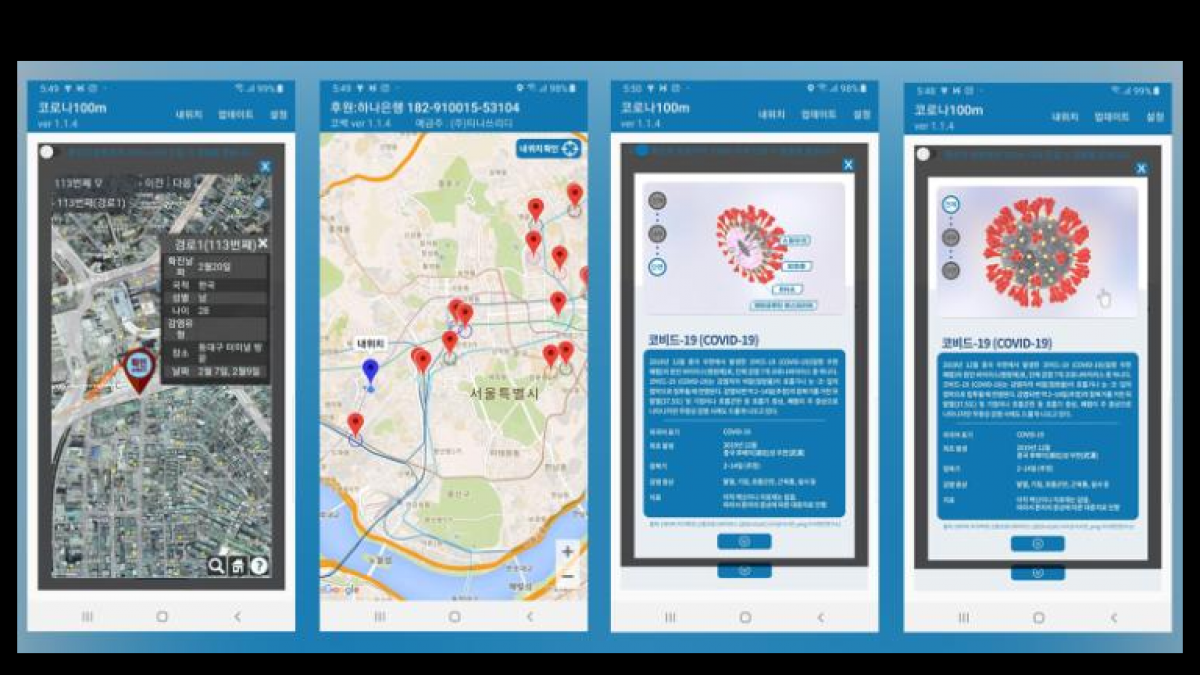
‘Corona Map’ is another such app that tracks the locations of people know to have COVID-19. Like Corona 100m, Corona Map plots the places where people known to have had COVID-19 have been, to make avoiding these areas easier.
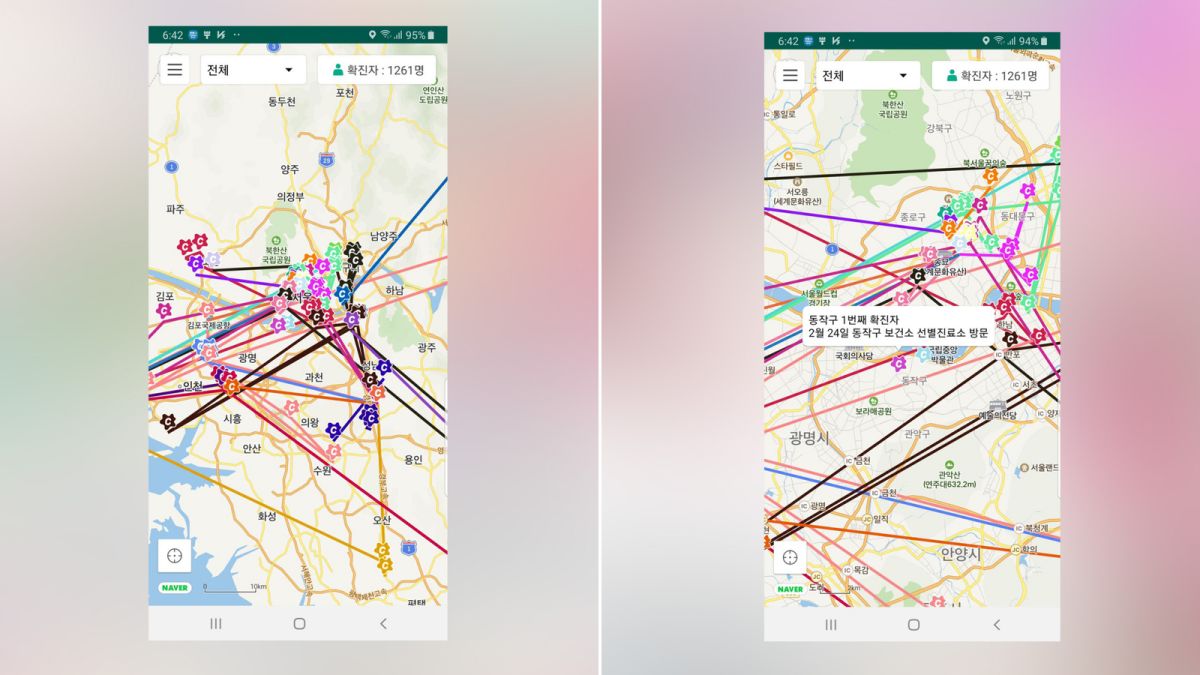
These are some of the essentials that you need to know before making your travel plans to South Korea and this travel guide will be helpful in making your itinerary!
KoreaTravelPost Editor
Hello there! I'm the Features Editor for KoreaTravelPost.
Related Posts
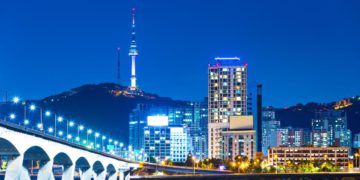
Explore Korea Like a Boss with InterparkTriple TRIPLE Korea
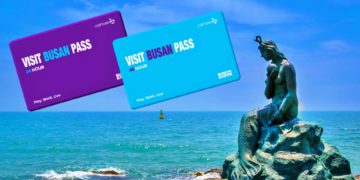
Temporary Suspension of VISIT BUSAN PASS Sales – Important Information for Travelers

Seoul Trip PASS App: Your Ultimate Travel Companion for Hassle-Free ID, Seamless Payments, and Instant Tax Refunds!
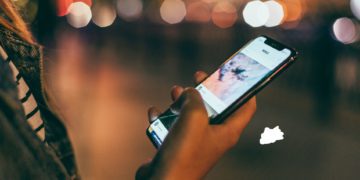
Best Korean to English Translation Apps for Your Korea Trip
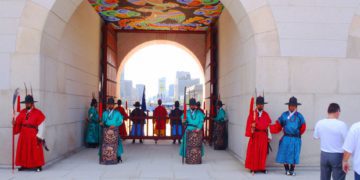
Discover South Korea with the Best: Top 10 Tour Operators
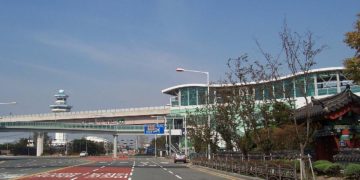
A Complete Guide to Gimhae International Airport

5 Best National Parks in South Korea
Leave a reply cancel reply.
Your email address will not be published. Required fields are marked *
Save my name, email, and website in this browser for the next time I comment.

TESSAN Germany France Travel Power Adapter

Lonely Planet Korea 12

Korean Snack Box Variety Pack

OSULLOC Lovely Tea Gift Box Set
More from our network.

- Medical Tourism
FREE NEWSLETTER
Copyright © 2024 About Us| Terms of Use |Privacy Policy| Cookie Policy| Contact : [email protected]
Login to your account below
Fill the forms bellow to register
Retrieve your password
Please enter your username or email address to reset your password.
Ultimate Korea Guide – Everything you need for your Trip!
South Korea – a land of rich traditions, modernity and breathtaking landscapes, known for K-Pop, Korean Drama, Technology, Skin care, Fashion and so much more. It became a favorite Travel destination for tourists all over the world offering an unforgettable travel experience. So in this ultimate guide, I’ll cover everything you need to know for an amazing South Korea trip from Basic Information about the country, weather all around the year, Visa and Entry Requirements, best Korean SIM Cards, Transportation, Must Visit Spots and Recommended Activities in Korea. So let’s dive right into it:
In this post:
South Korea is an East Asian country known for its culture, exceptionally delicious food, and technology-driven economy. It is located on the southern half of the Korean Peninsula and is one of the most densely populated countries in the world with a population of over 51 million people. Of these, approximately 40% live in and around the capital city of Seoul. The country is also known for K-pop music, Korean dramas, Skincare and Fashion and gained popularity worldwide in recent years.
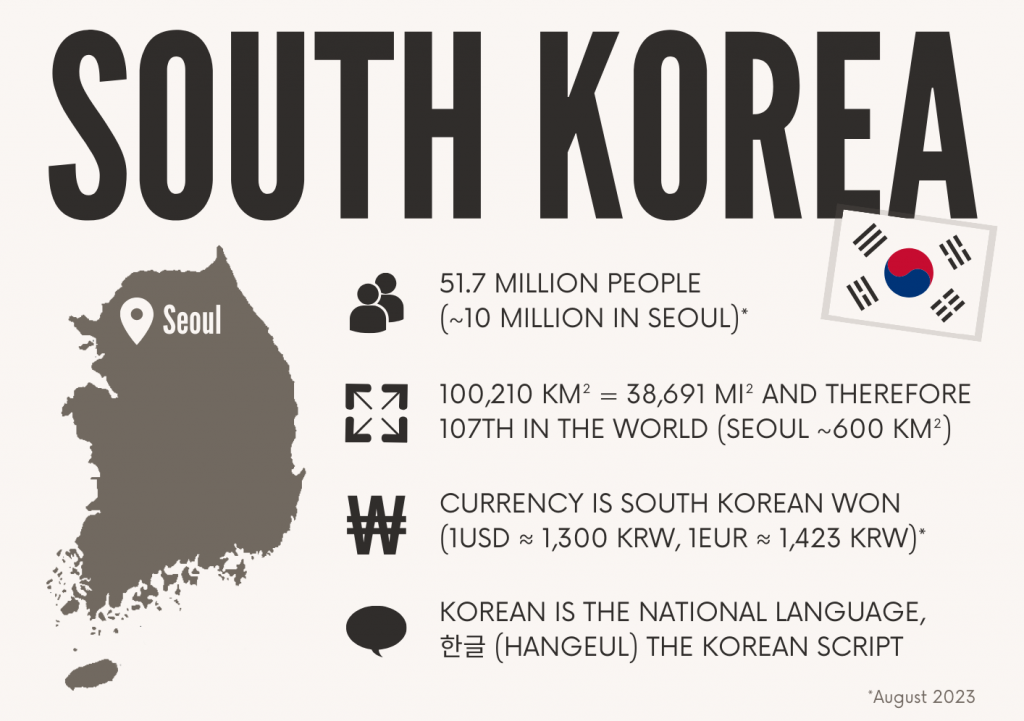
Traveling to South Korea is always a good idea as each season offers a unique and captivating experience. Generally you can say that summers are really hot and humid while winters can be freezing cold. Still I found all seasons to be beautiful and worth visiting, so here a little more details about what to expect.
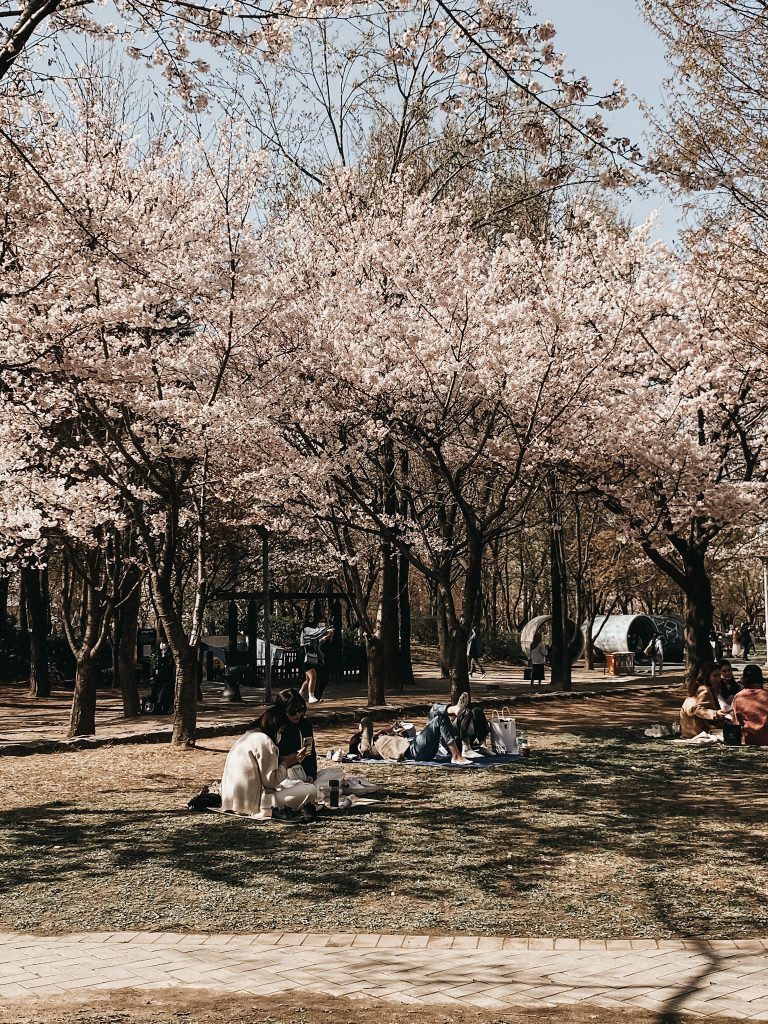
(March – May)
Spring in South Korea is mild and generally pleasant. Make sure to bring a jacket for the still chilly evenings and nights. Temperatures in March are around 3°C (37°F) to 13°C (55°F), in April ranging from 8°C (46°F) to 19°C (66°F) and in May between 14°C (57°F) to 24°C (75°F). Spring is also known for its beautiful cherry blossoms, attracting many tourists.
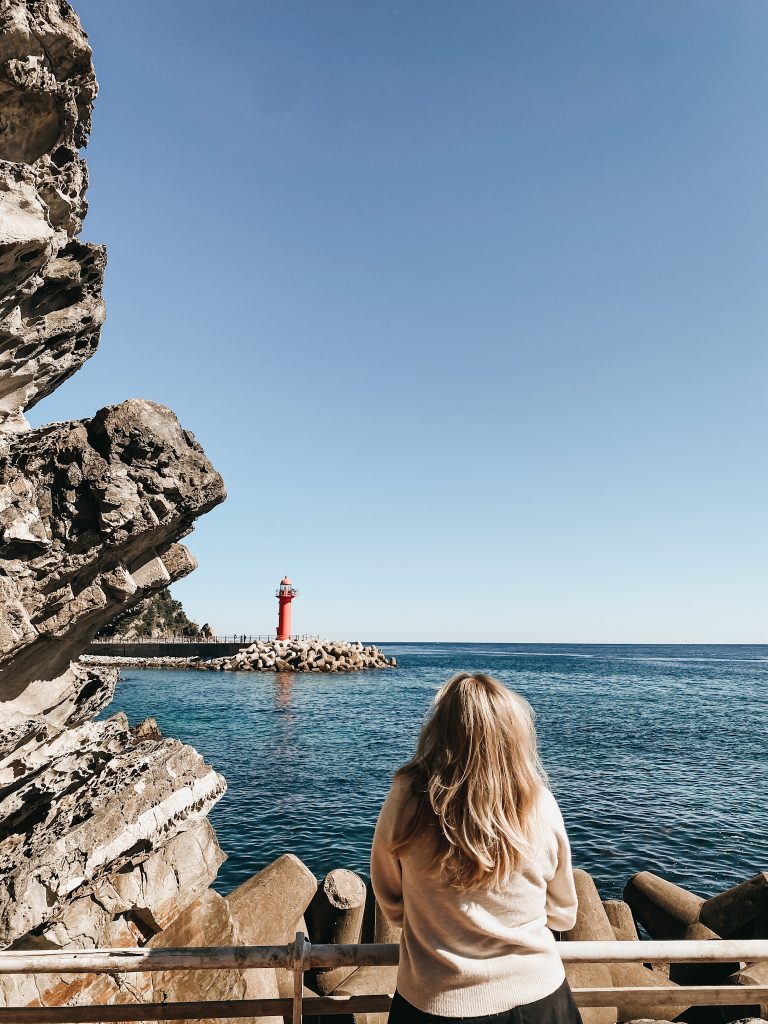
(June – August)
Because of the Korean Monsoon, summers in Seoul are hot and humid. June temperature is similar to May between 14°C (57°F) to 24°C (75°F), while July and August are the hottest months of the year. Temperatures ranging from 25°C (73°F) to 35°C (86°F) or even higher. July and August also experience a significant amount of rainfall, so be prepared for occasional showers or thunderstorms.
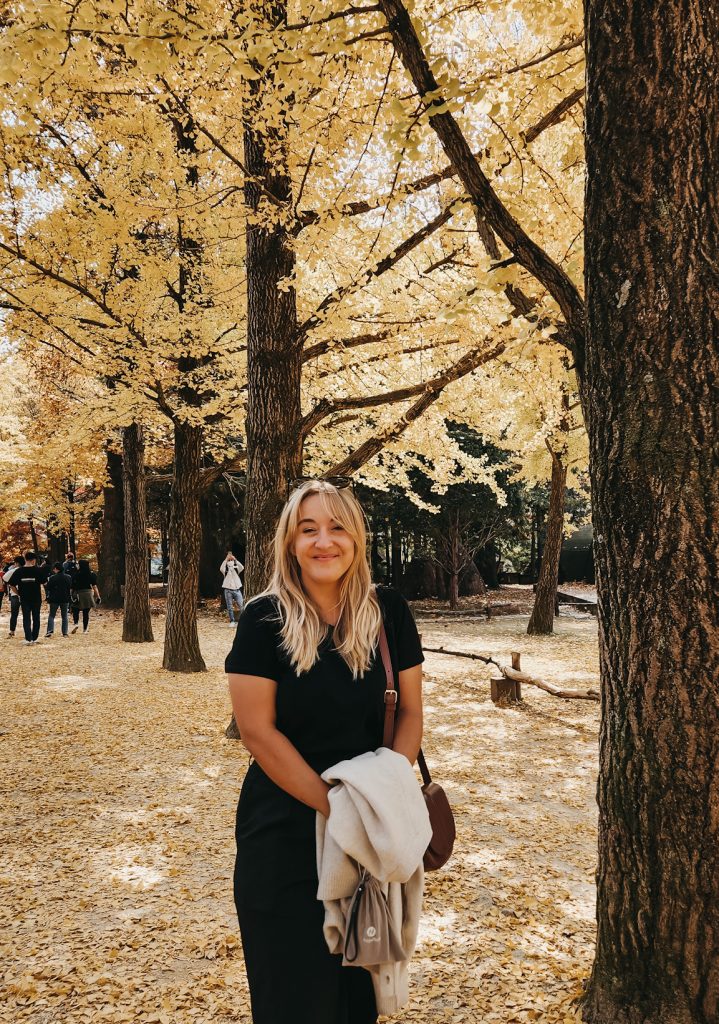
(September – November)
Autumn in Seoul is mild and in my point of view it’s the best time to visit. September starts with temperatures ranging from 19°C (66°F) to 26°C (79°F) and gradually cools down. October brings crisp and cool weather, with temperatures ranging from 11°C (52°F) to 19°C (66°F). November gets colder, with temperatures ranging from 4°C (39°F) to 12°C (54°F). Autumn foliage is another highlight, with vibrant colors across the country.
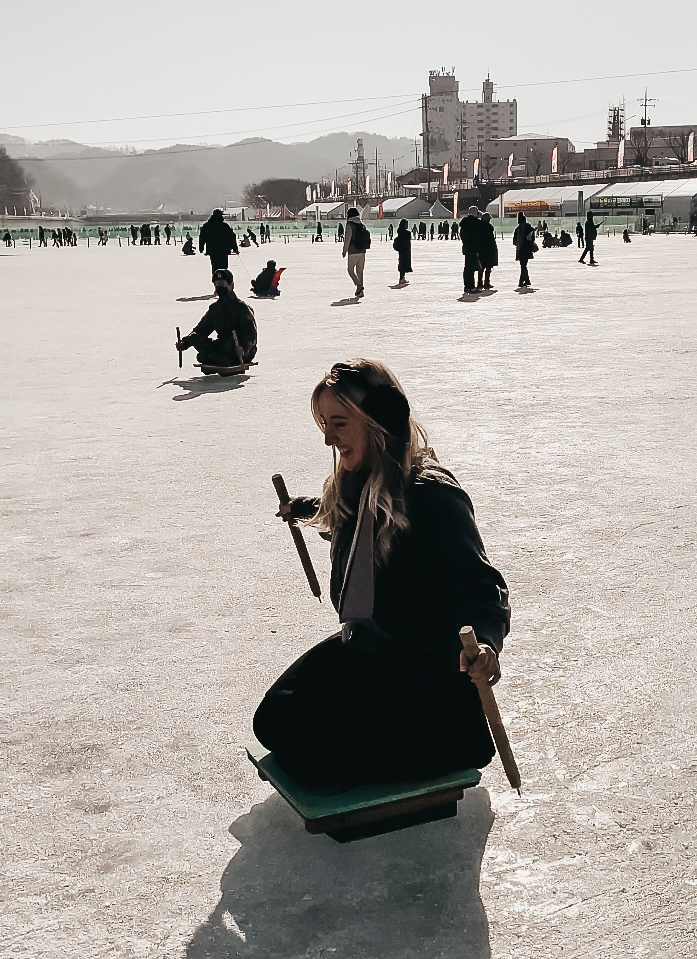
(December – February)
Winters in Seoul are cold and often snowy. December starts with temperatures ranging from -3°C (27°F) to 5°C (41°F). January and February are the coldest months, with temperatures ranging from -7°C (19°F) to 1°C (34°F). Snowfall is common during winter, creating a picturesque atmosphere. It’s essential to bundle up and be prepared for icy conditions.
NEXTSTOPKOREA TIP: The busiest times are March to early April because of Cherry Blossom & End of October to November because of the Fall Foliage. If you want to avoid those crowded and overpriced periods, I recommend coming end of April to June or September to Mid of October.
When planning a trip, understanding the entry requirements is crucial. Fortunately, South Korea has made it easier for travelers from various countries to explore its beauty through the K-ETA (Korean Electronic Travel Authorization) system.
This online process allows citizens of eligible countries to obtain a travel authorization before their departure, eliminating the need for a visa for short stays. The K-ETA is valid for up to 90 days (180 days for Canada) and permits tourism, visits for business meetings or visiting relatives. If you want to know how to apply, here the official >K-ETA Application Guide . Also make sure, that your passport has at least 6 months validity when entering Korea.
Here the list of K-ETA eligible nations and the allowed period of stay (last updated August 2023):
- ALBANIA (30)
- ANDORRA (30)
- ANTIGUA-BARBUDA (90)
- ARGENTINA (90)
- AUSTRALIA (90)*
- AUSTRIA (90)*
- BAHAMAS (90)
- BAHRAIN (30)
- BARBADOS (90)
- BELGIUM (90)*
- BOSNIA-HERCEGOVINA (30)
- BOTSWANA (90)
- BRAZIL (90)
- BRUNEI (30)
- BULGARIA (90)
- CANADA (180)*
- COLOMBIA (90)
- COMMONWEALTH OF DOMINICA (90)
- COSTA RICA (90)
- CROATIA (90)
- CYPRUS (30)
- DENMARK (90)*
- DOMINICAN REP. (90)
- ECUADOR (90)
- EL SALVADOR (90)
- ESTONIA (90)
- ESWATINI (30)
- FINLAND (90)*
- FRANCE (90)*
- GERMANY F.R (90)*
- GREECE (90)
- GRENADA (90)
- GUATEMALA (90)
- GUYANA (30)
- HOLY SEE (30)
- HONDURAS (30)
- HONGKONG (90)*
- HUNGARY (90)
- ICELAND (90)
- IRELAND (90)
- ISRAEL (90)
- ITALY (90)*
- JAMAICA (90)
- JAPAN (90 Days)*
- KAZAKHSTAN (30 Days)
- KIRIBATI (30)
- KUWAIT (90)
- LATVIA (90)
- LESOTHO (60)
- LIECHTENSTEIN (90)
- LITHUANIA (90)
- LUXEMBOURG (90)
- MACAO (90)*
- MALAYSIA (90)
- MARSHALL ISLANDS (30)
- MAURITIUS (30)
- MEXICO (90)
- MICRONESIA (30)
- MONACO (30)
- MONTENEGRO (30)
- MOROCCO (90)
- NETHERLANDS (90)*
- NEW CALEDONIA (30)
- NEW ZEALAND (90)*
- NICARAGUA (90)
- NORWAY (90)*
- PANAMA (90)
- PARAGUAY (30)
- POLAND (90)*
- PORTUGAL (90)
- SERBIA (90)
- ROMANIA (90)
- RUSSIA (60)
- SAN MARINO (30)
- SAUDI ARABIA (30)
- SEYCHELLES (30)
- SINGAPORE (90)*
- SLOVAK (90)
- SLOVENIA (90)
- SOLOMON IS. (30)
- SPAIN (90)*
- SOUTH AFRICA (30)
- ST. KITTS-NEVIS (90)
- ST. LUCIA (90)
- ST. VINCENT (90)
- SURINAM (90)
- SWEDEN (90)*
- SWITZERLAND (90)
- TAIWAN (90)*
- THAILAND (90)
- TRINIDAD-TOBAGO (90)
- TUNISIA (30)
- TURKIYE (90)
- TUVALU (30)
- UK-GBR (90)*
- UK – GBD, GBN, GBO, GBP, GBS (30)
- URUGUAY (90)
- VENEZUELA (90)
* K-ETA is temporarily exempted for 22 countries until December 31, 2024 – means you can just travel to Korea without a applying for K-ETA
If your country is not in this list, then it might be, that you need a visa to travel to South Korea or that your home country is having a different agreement with South Korea. Therefore please check the visa requirements on >the Korea Visa Portal .
While South Korea has an advanced healthcare system, it’s wise to take a few steps before you depart. Make sure your routine vaccinations are up-to-date, including measles, mumps, rubella, and influenza. While no specific vaccinations are required for entry, being immunized is recommended by most countries.
South Korea’s healthcare system is highly regarded for its quality and accessibility, with modern facilities and well-trained medical professionals. However, unexpected situations can happen, and that’s where travel insurance comes in. Having >comprehensive travel insurance that covers medical expenses is strongly recommended. It provides peace of mind knowing you’re covered in case of illness or injury.
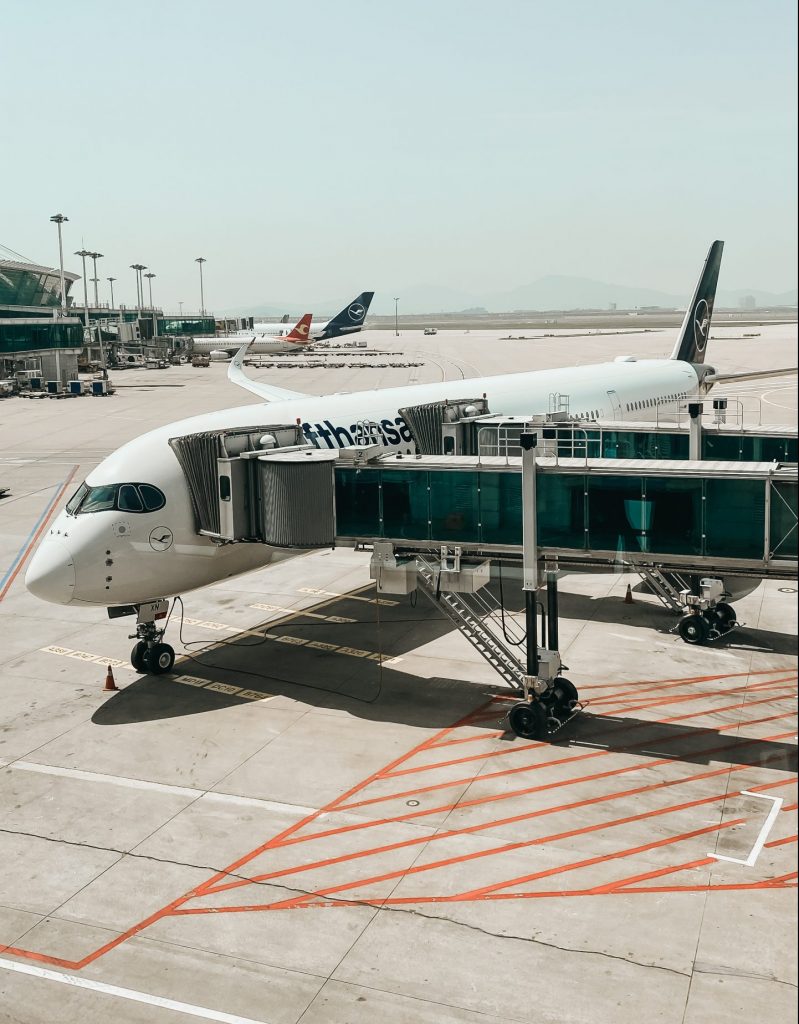
Incheon International Airport (ICN) and Gimpo International Airport (GMP) are the primary hubs that connect South Korea to the world. Incheon International Airport, located around 1 hour from Seoul, is the larger of the two and offers a wide array of international flights. Gimpo International Airport, about 40 minutes from Seoul, mainly handles domestic flights like to Jeju and some short-haul international routes. Both are known for their modern facilities and efficient services.
NEXTSTOPKOREA TIP: I usually book my flights on Kiwi, Momondo or on Skyscanner >here .
Choosing the right accommodation for your South Korea trip sets the tone for a comfortable and memorable stay. From budget-friendly options like guesthouses and hostels ranging from $30 to $60 per night, to mid-range hotels providing a balance between comfort and cost in the range of $60 to $150 per night, and upscale hotels offering luxury from $200 onwards, South Korea caters to all types of travelers.
As you explore different neighborhoods to stay within Seoul, consider Myeongdong (Jungno) for most convenient sightseeing, Heongdae (Mapo) or Itaewon (Yongsan) for nightlife and Gangnam for Shopping. These central locations not only grant easy access to bustling markets, vibrant culture, and historic sites, but they also offer a range of accommodations that suit various budgets.
If you want to save money and don’t mind a daily commute in the subway, you can also check accommodations a bit outside of the city centre. And if you’re looking for the fully traditional Korean experience than have a look at Hanok-Stays – the Korean traditional housing.
NEXTSTOPKOREA TIP: Airbnb, Booking and similar Hotel-Websites work perfectly fine for your Accommodation search in South Korea. A famous Korean app for this is ‘Yanolja’. As everywhere I highly recommend you to check the reviews of the place you’re planning to stay at!
While English is commonly spoken in most tourist hubs like Myeongdong, Gangnam, Hongdae or Itaewon and you can use the translating app Papago to communicate, branching out with basic Korean phrases can truly enrich your Korea experience. Learning a handful of key expressions can help you navigate beyond the popular areas and connect with locals easier and on a deeper level.
Learning the korean alphabet called hangeul is actually easier than you might think and with some basic phrases like “안녕하세요” (annyeonghaseyo) for “hello” and “감사합니다” (gamsahamnida) for “thank you” you can already achieve a lot when talking to Koreans.
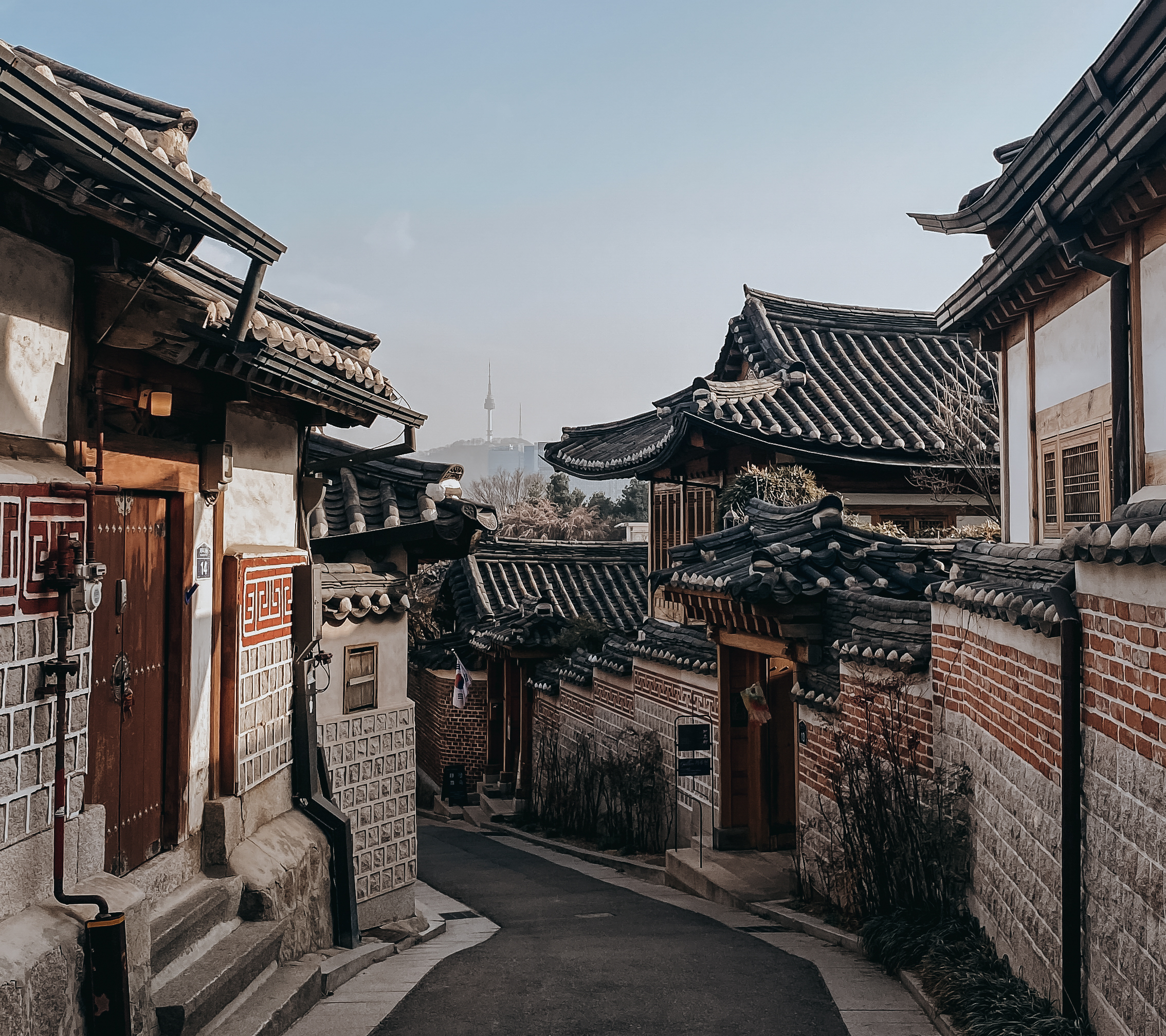
Here a list of the best Korean Language Study Resources!
NEXTSTOPKOREA TIP: In case you urgently need a translation for example in a store or taxi, there are luckily services for travelers to help you. You can either use the Korea Travel Hotline or the bbb Korea Service, whose number you can find in the next paragraph. Or check out the bbb App > here .
Important Hotlines
The area code for South Korea is +82, so when calling a South Korean number from abroad, you need to dial this country code before the actual phone number. There also are area codes that vary for different cities and regions (e.g. 02 for Seoul, 051 for Busan, 010 for mobile phone numbers). But for the following numbers those are not necessary either if you are in South Korea:
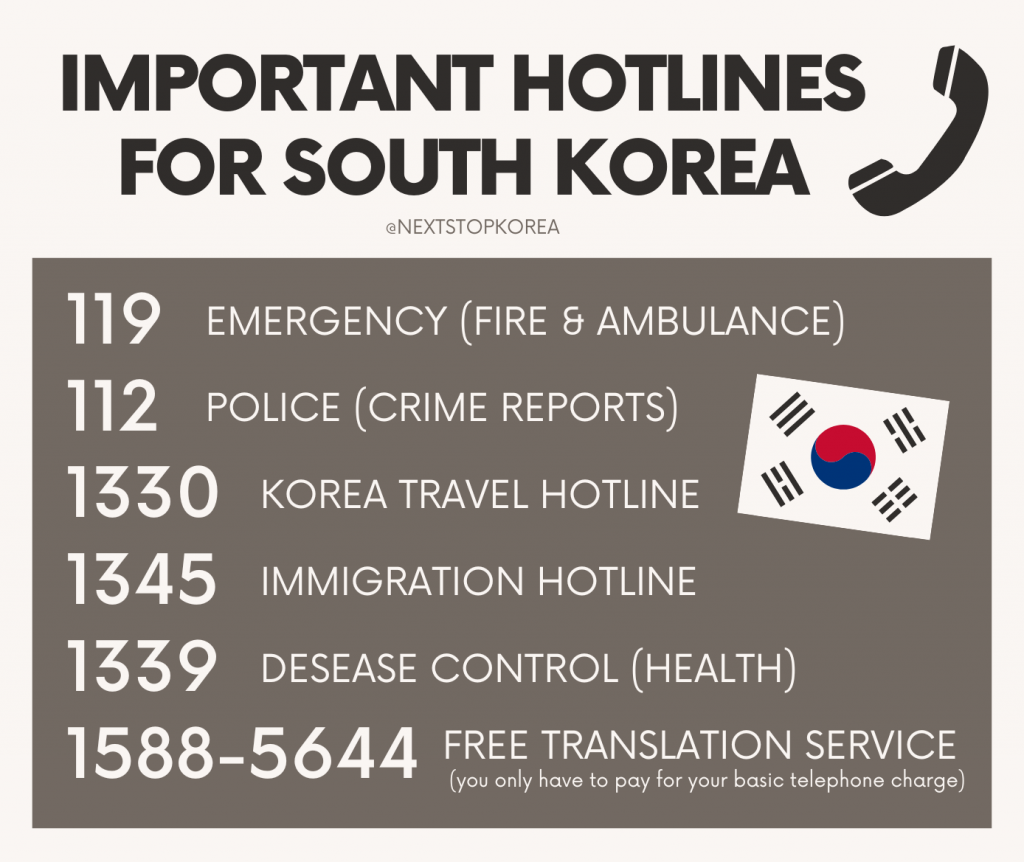
South Korea uses the Korean Won (KRW) as its currency , so familiarize yourself with the currency and the current exchange rates. When I first came to Korea I used an app to calculate the exchange rates for me, so I had a good feeling of how much I actually spent per day.
Make sure you’ve saved enough funds to cover accommodation, activities, and unforeseen expenses. Flights, Hotels and activities can be quite pricey, but you can save a lot through Korea’s cheap public transportation and food options. Depending on your general budget and standards, I recommend 60-100$ per day per person including accommodation, transportation, food and activities.
Credit cards are widely accepted and offer convenience, security, and favorable exchange rates. Among the credit cards commonly recognized in South Korea are Visa, Mastercard, American Express, JCB, and many more. Remember to inform your bank of your travel plans to prevent any payment disruptions.
I recommend you get some cash , even though you can pay almost anything with your credit card – you know.. just in case. You can either use one of the exchange booths at the airports, in Myeongdong or Itaewon (they usually offer quite bad rates), you can use a >WOWExchange Kiosk or you get cash through your credit card from an ATM, e.g. located in front of most convenience stores.
If you’re too afraid that your Credit Card could be declined, I can highly recommend the Namane Card – a transportation card that works like a korean bank card. Find more about that in the Paragraph about Transportation.
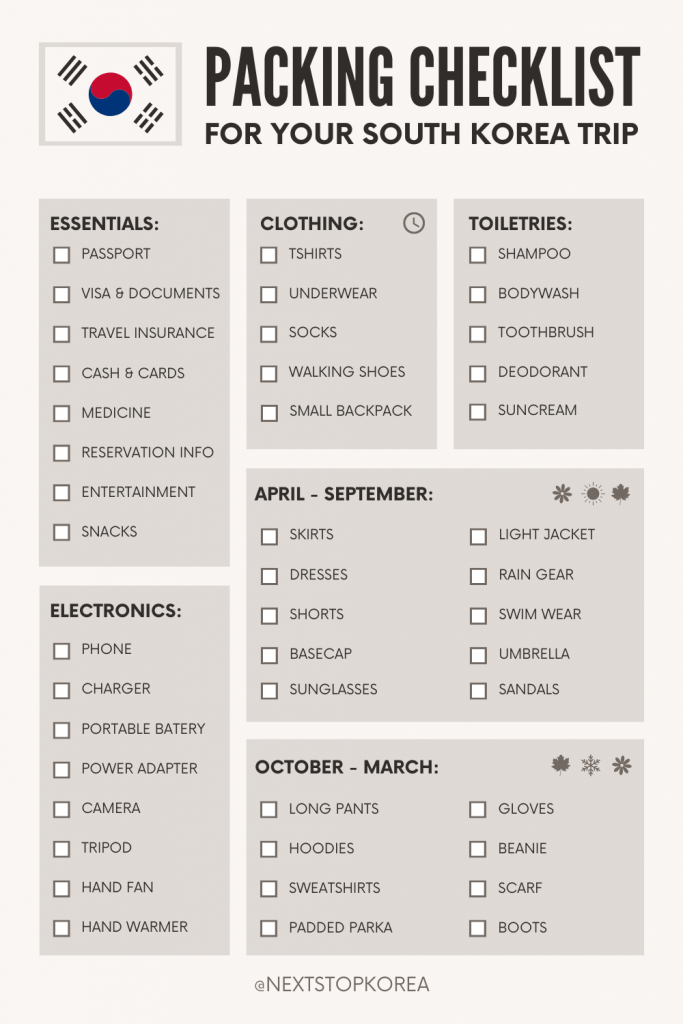
Before embarking on your journey to South Korea, make sure to download essential travel apps that will enhance your experience and make your visit more convenient and enjoyable.
- Papago : The biggest challenge when traveling in Korea is the language. Papago is by far the best Korean to English translator, can also translate websites and even has a conversation and photo feature.
- Kakao/NaverMap: Since Google Maps has limited functionality in South Korea, it is recommended to download one of the Korean map apps. KakaoMaps and NaverMaps are the two most commonly used options.
- KakaoTalk: Koreans mainly use KakaoTalk instead of WhatsApp or Telegram. So when you make a new friend, they usually don’t ask for your cell phone number, but for your KakaolD.
- Naver: Instead of Google, Naver is the most used search engine in Korea. Restaurant reviews, blogs, booking tools can usually be found quickly on Naver. Compared to Google, I tend to find a local recommendation or hidden gem here more easily.
- KoRail: It you are planning a trip to another city in South Korea, you will need a KTX ticket. The easiest way to book this is to use the official Korail app. This way you also avoid the many rip-off websites online.
- TabaKakaoT: Compared to most other big cities, cabs in Korea are much cheaper, so sometimes it’s more convenient to take a cab. With KakaoT that is super easy and you can pay with credit card in the cab.
- Seoul Bike: One of my favorite activities in Seoul is a bike ride along the Han River. Although you can find larger bike rentals at the hotspots, you are much more flexible with the Seoul Bike App. Once set up, you can rent and return a bike within seconds.
- Currency: There are several different apps in the appstore, but they all have similar functions to convert currencies quickly and easily. Especially in the beginning it helped me to get a feeling for how much money I spend.
- AirVisual: In Korea people wear a mask not just because of Covid, but also because of the regularly occurring fine dust pollution. With AirVisual, you can quickly see when it is advisable to wear a mask outside and to do indoor activities.

Here the 10 most important tips you should know and keep in mind to not look rude to Koreans:
- Bowing : Bowing is a common form of greeting and showing respect. The deeper the bow, the more respect is conveyed.
- Shoes Off : It’s customary to remove your shoes before entering someone’s home or certain traditional establishments.
- Tipping : Tipping is not common in South Korea and may even be refused. Exceptional service is already included in the price.
- Use Both Hands: When giving or receiving items, especially money or business cards, use both hands. This gesture reflects politeness and respect for the person you’re interacting with.
- Dining Etiquette: During meals, wait until the eldest or the host starts eating before you begin. Do not start eating or stop eating before everyone is finished. Additionally, avoid sticking chopsticks upright into a bowl of rice, as it resembles a funeral ritual.
- Respect for Elders: Respect for elders is deeply ingrained in Korean society. Use formal language and honorifics (ending sentences with “-yo”) when addressing older individuals. When pouring drinks, hold the bottle with two hands when offering to someone older than you.
- Silence on Public Transport: Maintain a quiet demeanor when using public transport. Loud conversations and phone calls are generally considered rude. Use headphones if you want to listen to music or watch videos.
- Cover Shoulders and Knees at Temples: If you plan to visit temples or religious sites, dress modestly. Cover your shoulders and knees as a sign of respect for the sacred space.
- Queueing Up: Whether you’re waiting for public transport, entering an establishment, or even using an elevator, respect the queue. Cutting in line is considered impolite.
- Trash Sorting: South Korea has strict waste disposal regulations. Sort your trash into different categories, including food waste, recyclables, and general waste. That’s also one reason why there are almost no garbage cans in public as people should bring their trash home to recycle it properly. But no worries: Most subway stations have a trash can 😀
Incheon Airport
When arriving at Seoul’s Main Airport there are some important steps to go through. First, you’ll proceed to immigration, where you’ll need your passport and visa ready for inspection. The process is generally efficient, and friendly immigration officers are there to assist you in English or Korean.
After that, you’ll head to baggage claim to collect your luggage. Incheon Airport is known for its quick baggage handling, so I promise you won’t be waiting long!
Once you have your bags, it’s time to breeze through customs. Please check the latest customs regulations for South Korea when packing your suitcase.
Finally, you’ll step out of the arrivals area into a bustling terminal filled with helpful signs and information booths. Make sure to get a Korean SIM Card and some cash before leaving the airport. Find a map of the Airport Facilities >here or below.
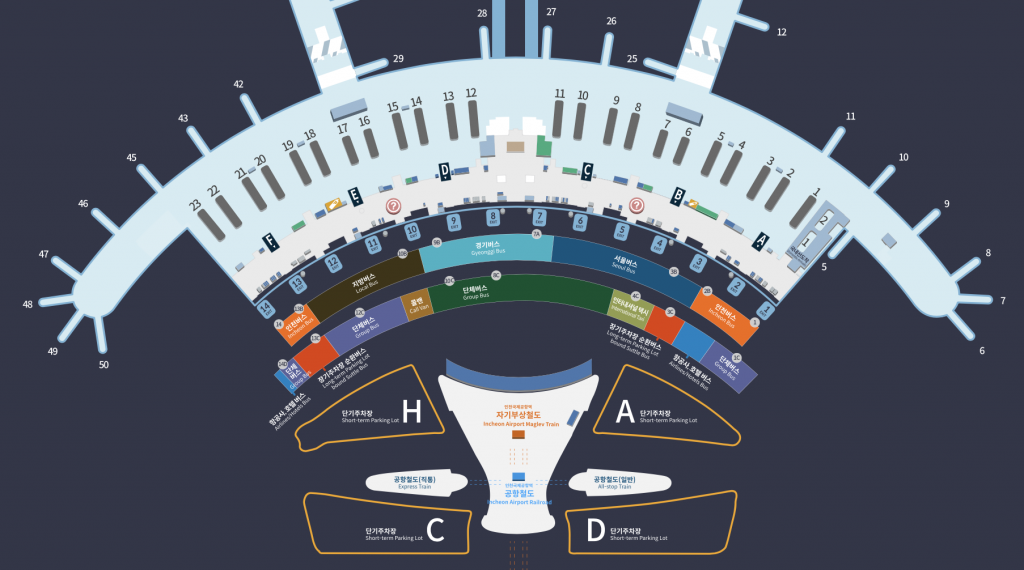
Right after clearing customs, you’ll spot various kiosks and mobile service providers offering SIM cards tailored to your data and duration needs. Whether it’s a short stay or an extended visit, you can easily choose a prepaid SIM card with a suitable data package. I can recommend this SIM card from >Klook or >Woorimobile .
Once inserted into your phone, you’ll be instantly connected to South Korea’s fast and reliable mobile networks, ensuring you can navigate, communicate, and share your Korean adventures with ease.
In case your Phone has a SIM Lock or you’re coming with some friends or stay a few weeks, maybe a >pocket wifi device could be helpful.
TRANSPORTATION
It’s at this point that your Korean adventure truly begins, and you can start exploring this dynamic country. But before I will give you recommendations what to do and see, I want to introduce you to the different Transportation Options in South Korea.
Transportation Cards
But first, let me introduce you to your new best travel-buddy: a Korean transportation card! Those smart cards offer a convenient and efficient way to pay for various modes of public transportation, including subways, buses, taxis, some ferries and even can be used as a payment method at many convenience stores. Users can recharge those cards and use them as often as they want by easily tapping them on card readers when boarding or leaving public transportation. They can be used not just in Seoul, but in the whole country, even on Jeju Island.
You could also buy single ride tickets at the vending machines in every Subway station or get the MPass, which is like a 1 to 7 Day unlimited pass. But for this ticket to be worth it, you have to take the Subway at least 7 times per Day. The Seoul Metro also announced new unlimited 1 Day (5,600 KRW) or 3 Day (11,800 KRW) Passes , but they’re not yet available. So for now I would highly recommend you to get a transportation card, here are two options explained:
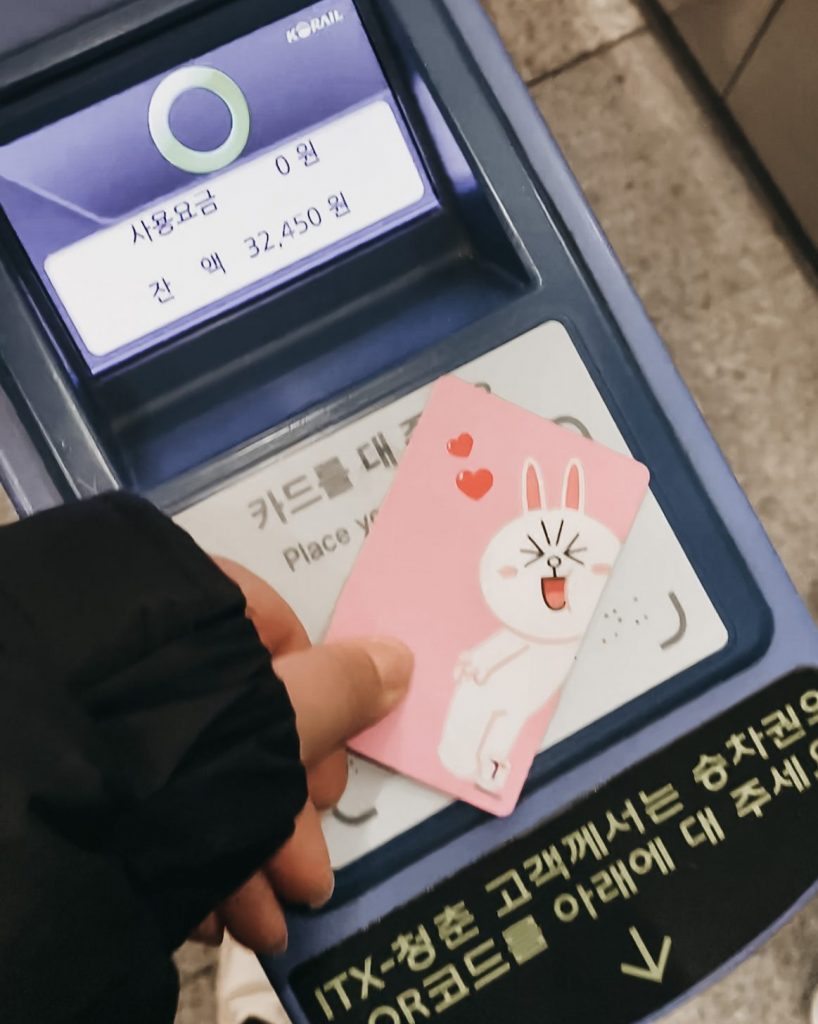
T-Money Card
As an originally government founded company this is the most common card in South Korea – you probably heard of this one too. You can basically find them everywhere with different designs, for example by Kakao or Line Friends or the most famous Kpop Groups (around 4,000-7,000 KRW). You can top up money (only by using cash) at convenience stores and at the machines in every Subway Station and then use it in the whole country for public transportation.
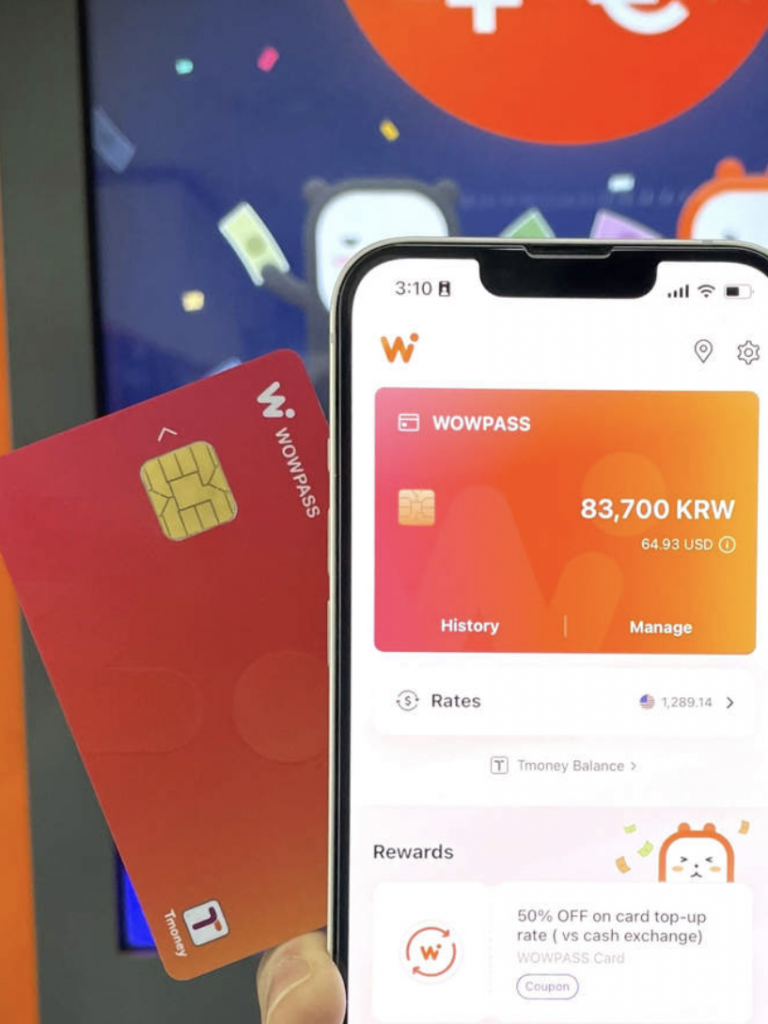
Even though many people might not know about this yet, this is my recommendation! It’s like the following Namane Card offering all the advantages of a Korean Bank Account including a Transportation Card. but with this one you can also withdraw cash from various Kiosks and the app is very handy and helpful!
You can get the Wow Pass in advance >here .
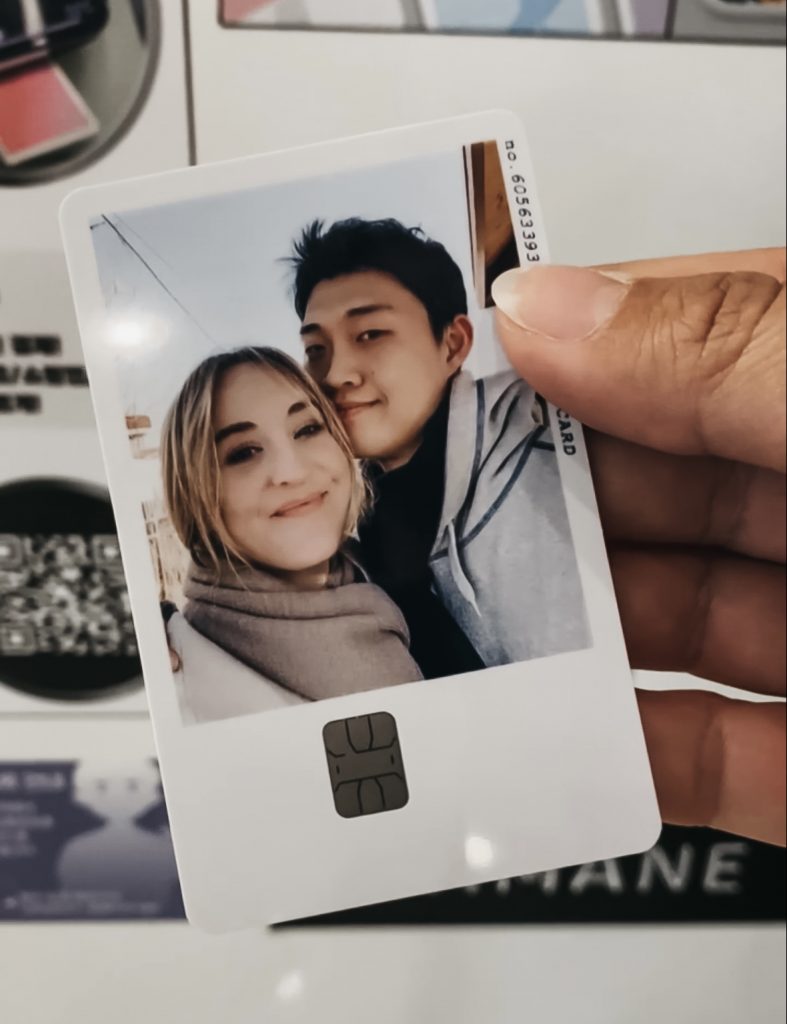
Namane Card
Even though many people might not know about this yet, but this is my absolute recommendation! You can not just freely personalize the design of your Namane Card, you can also use it like a normal Korean bank card, top it up with cash or your foreign credit card (with a small transaction fee) and check the remaining amount easily in the app. It’s much more convenient and especially for tourists the best option.
NEXTSTOPKOREA TIP : You can get the Namane Card for 7,000 KRW (printed with your favorite design within a few minutes) at one of the Kiosks in Incheon Airport. Find out more >here .
Navigation Apps
Some people prefer to read the Seoul Subway or Bus Map simply as it is.. That’s absolutely not an option for me 😀 Luckily there are many Apps you can use to find the best way to get from A to B:
- GoogleMaps (works to some extent)
- Seoul Subway App
The last App of this list is the one I use and the one I explain in >my Subway Guide . There is no special reason, why I would recommend NaverMaps in comparison to KakaoMaps, it’s like Apple vs. Samsung.. You always like what you first got used to 😀
Transportation from the Airport
One of the first exciting steps is making your way from Incheon Airport to the vibrant heart of Seoul. There are different options I will just list here. For a full Guide click on the link below!
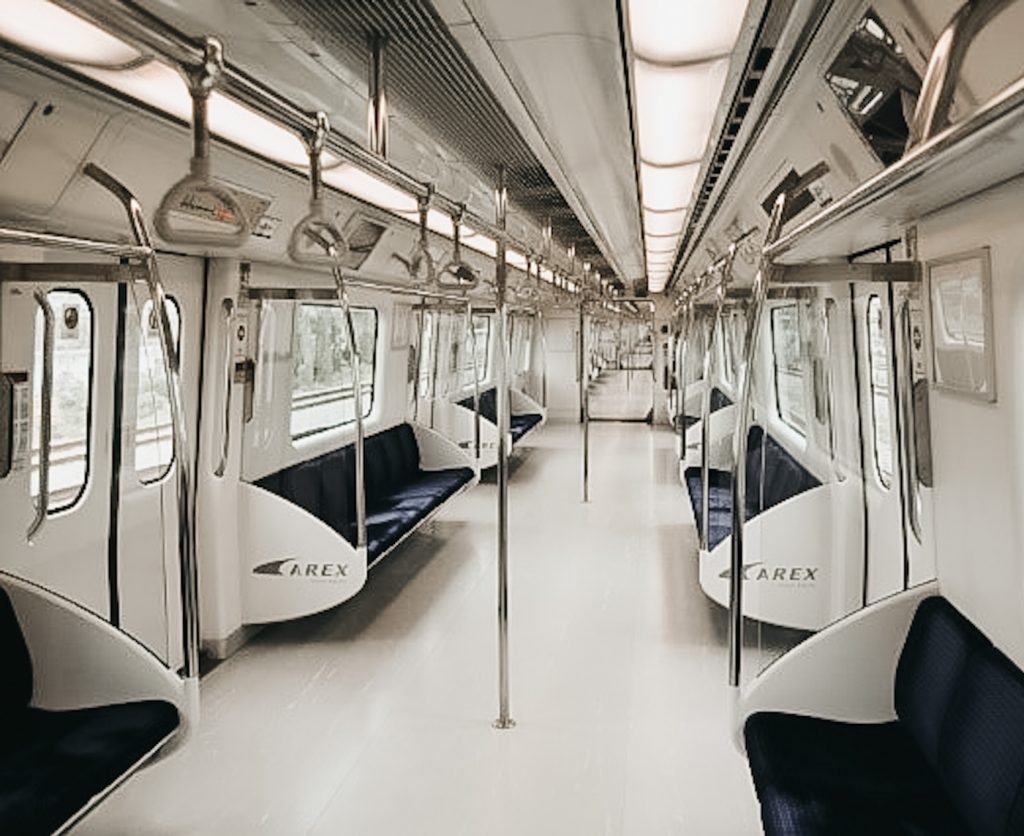
- Express Train to Seoul Station
- All-Stop Train with many stops
- Airport Limousine Bus (my fav!)
- General Taxi (Orange, White)
- Private Taxi (Black) > AVOID
- International Taxi (fixed price)
- Private Driver
How to get from Incheon Airport to Seoul City?
Transportation within Seoul
From the extensive subway network, various bus routes, well-maintained roadways, comparably cheap Taxis, to the impressive bicycle-sharing system and numerous pedestrian-friendly areas – There are endless ways to explore Seoul. I will explain some in the following paragraphs.
NEXTSTOPKOREA TIP : For all public transportation options: Try to avoid the rush hours during 6:30 – 9am and 4:30 – 7pm, as it can get really really busy and crowded in Subways or on the streets during that time.
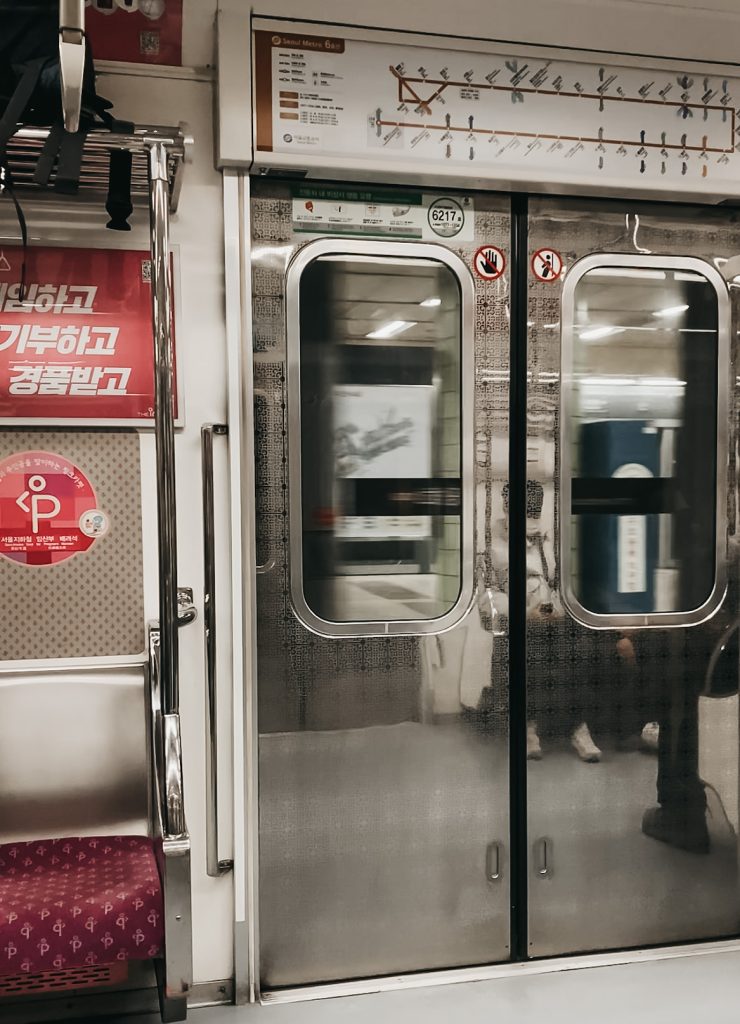
The Seoul subway fare system is based on distance, so the first 10 km start from 1,250₩. For longer trips a small additional fee will be applied when leaving the station. Seoul Subways usually start operating at 5am and the last train leaves around midnight or until 1am. After that there are usually only night busses and taxis available.
The Seoul subway system is a marvel of efficiency and connectivity, making it the lifeline of the city’s bustling urban landscape. With over 20 lines crisscrossing the metropolis and reaching even the farthest corners of the city, it’s no wonder that Seoul’s subway is renowned as one of the best Subway Systems in the world. Not only is it the fastest way to beat the notorious traffic jams, but it’s also remarkably cheap, clean and safe.
F ind a detailed Seoul Subway Guide here!
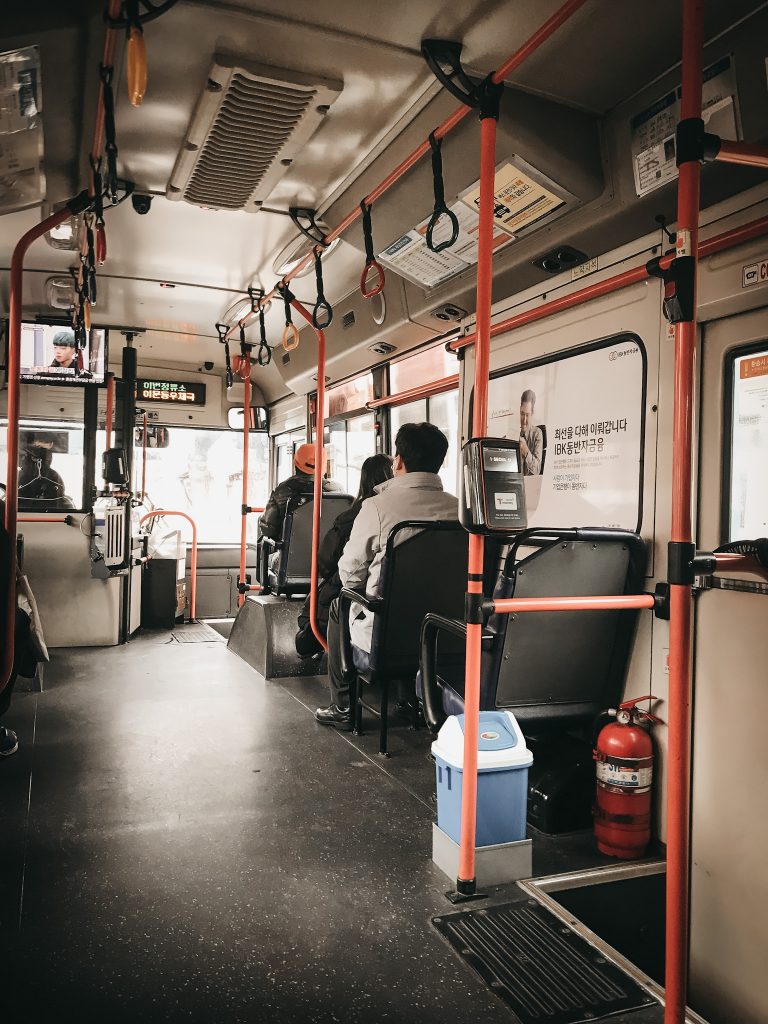
With an extensive network of routes covering virtually every nook and cranny of Seoul, the bus system is a reliable and cost-effective mode of transit. Especially for people that might be too overwhelmed by the Subway system or that want to see Seoul’s lively street scenes while moving from one exciting destination to the next, taking a bus is a great alternative.
You have to enter the bus in the front tapping your T-Money Card on the card reader next to the bus driver. When you want to get out, press the “Stop”-Button and tap your T-Money Card again when leaving through the back doors. I recommend you to keep track of the buses’ route on the map, so you don’t miss your station, as the screen and speaker announcements are often in Korean only.
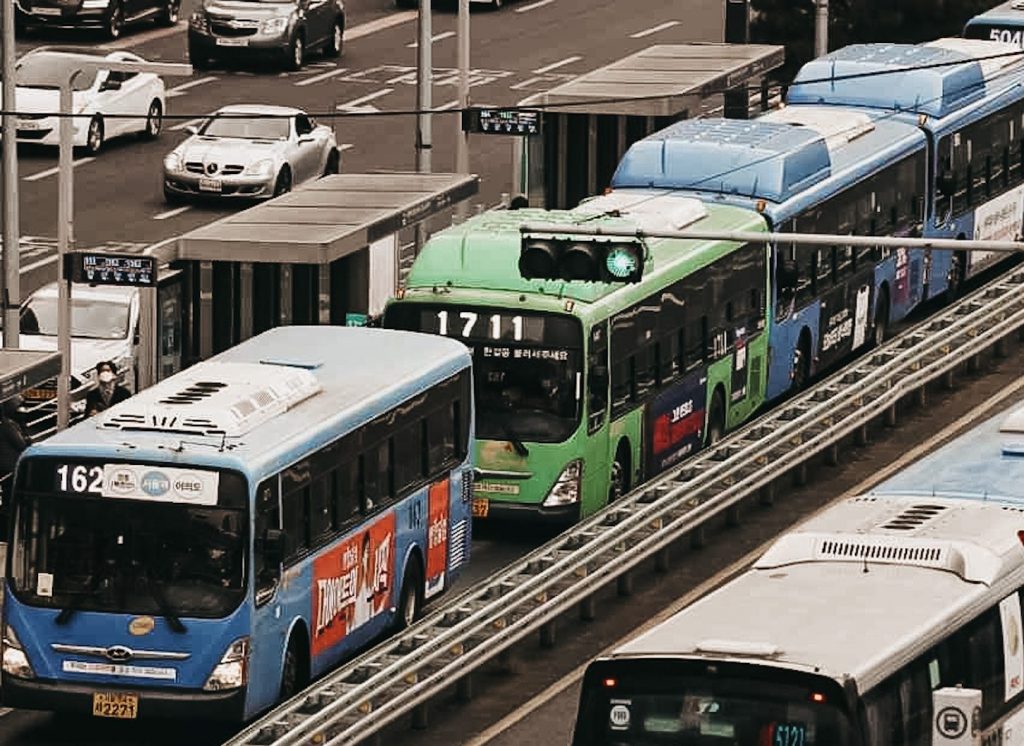
Good to know: Seoul Buses are color coded. The red buses are going out of the city (e.g. Incheon or other regions in Gyeonggi Province), the blue ones connect different districts within Seoul, green buses mostly stay within the same district and the very tiny yellow ones are local buses making small loops around a neighborhood.
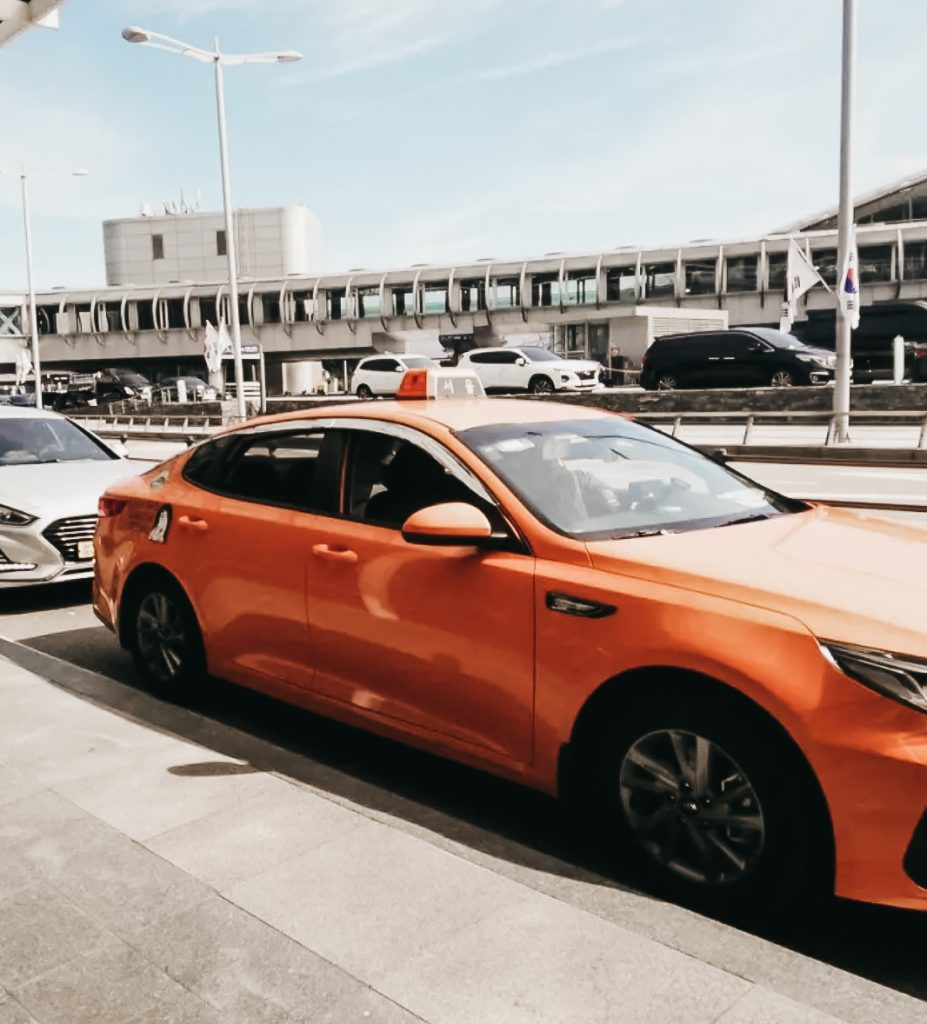
Taxis are comparably cheap in South Korea, so I’m taking a taxi way more often than in Europe. The basic fare of a general Taxi is 4,800 KRW and then the taximeter will keep track of the kilometers travelled.
To grab a Taxi you can either wait on one of the Taxi Stands at big train or bus stations and around the main tourist attractions, use the app KakaoT or simply hail one off the street by raising your hand. Different than in most other countries, the RED sign saying “빈차” in the window of the taxi symbolizes that it is free. Green is taken and blue is done with work for the day, so avoid those.
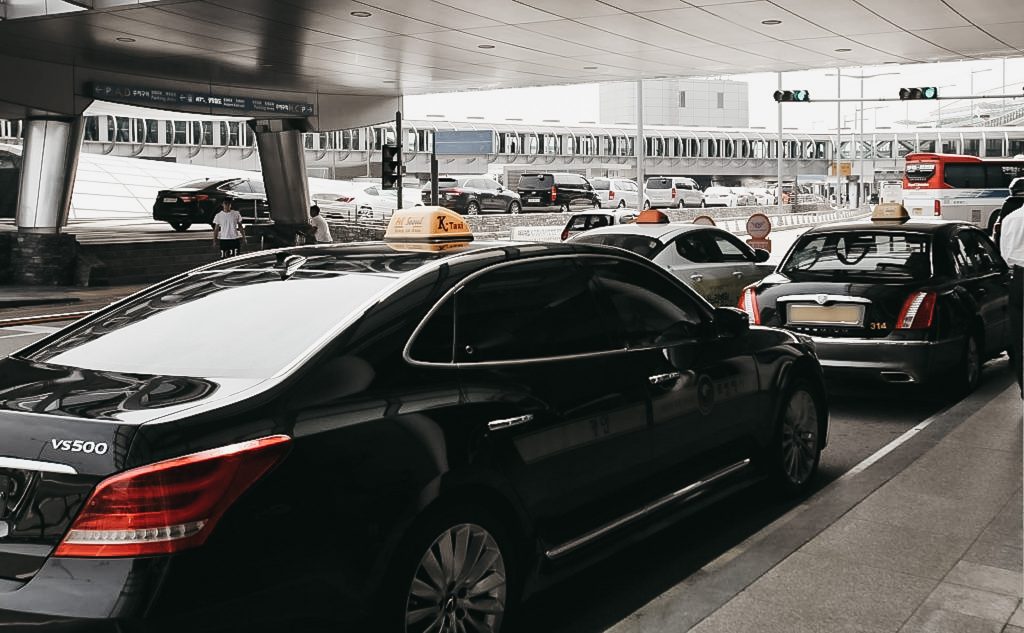
Like I mentioned in my > Airport Transportation Guide , I recommend you to avoid the black private or “Deluxe” Taxis as they usually offer similar services to normal taxis but for a much higher price. General orange or white taxis are my go to choice^^
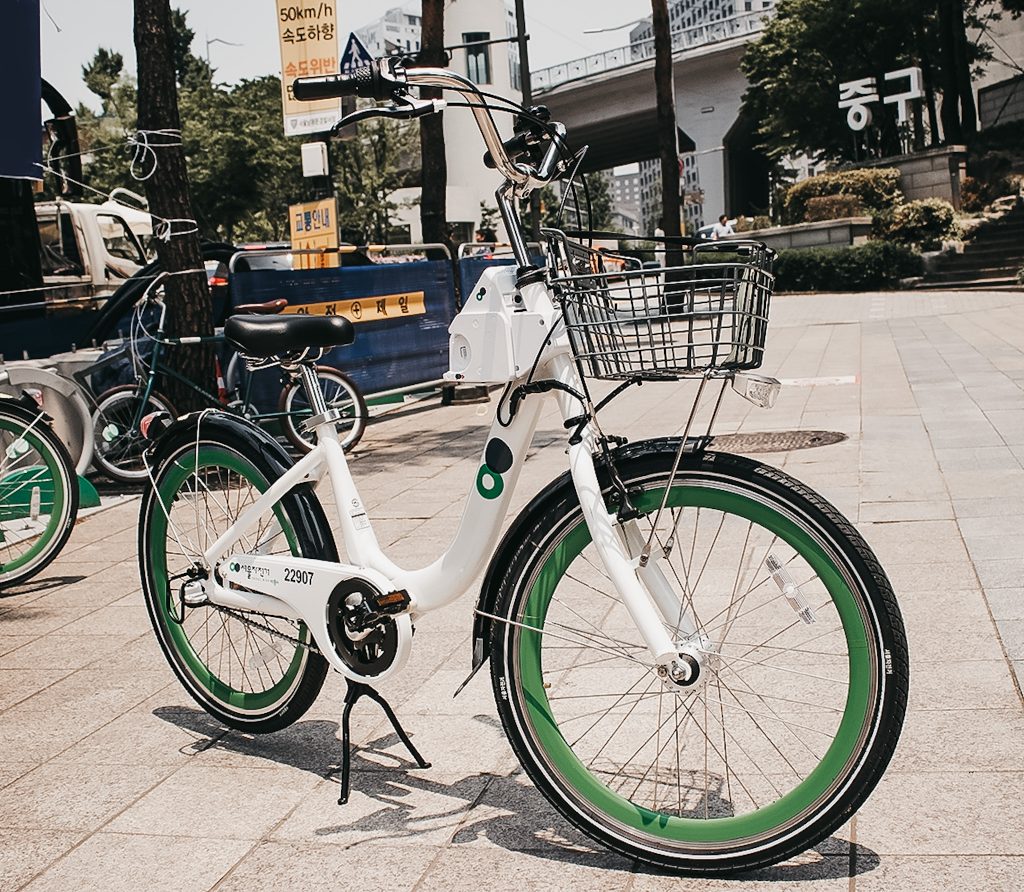
The “Seoul Bike” system – called 따릉이 (Ddareungi) – offers a unique and eco-friendly way to explore the city. With a convenient app and a well-organized network of rental stations, it’s easy for both locals and visitors to hop on a bicycle and pedal through Seoul’s vibrant streets. The bikes are not only convenient but also affordable, so you can literally see the green white bikes so often on the street or along the Han River.
Transportation to other cities
While Seoul offers a vibrant and bustling urban experience, I highly recommend travelers to venture beyond the city limits to truly immerse themselves in the rich tapestry of South Korean culture and landscapes. Take a short train or bus ride to discover the country’s hidden gems. By venturing out of Seoul, you’ll unlock a deeper understanding of South Korea’s diverse heritage and natural beauty, creating unforgettable memories along the way.
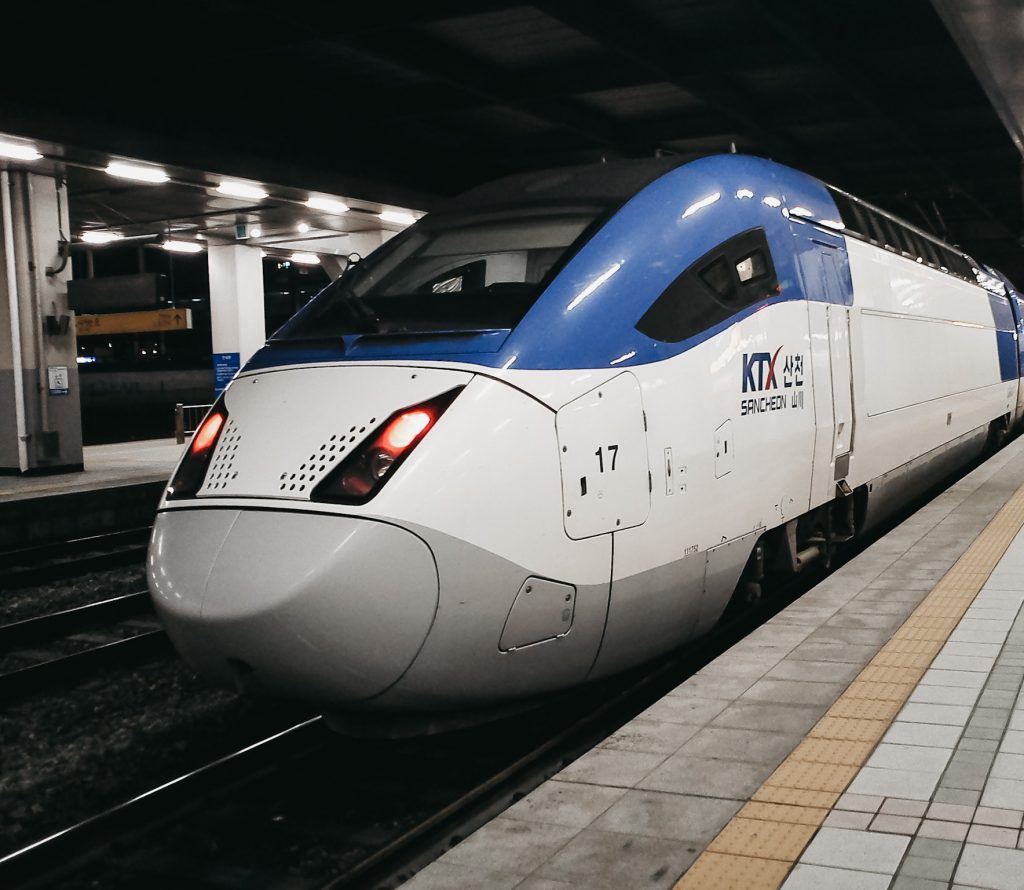
The high-speed KTX trains are the stars of the show, bringing passengers to other major cities like Busan, Jeonju, Gyeongju or Daegu at speeds of up to 300 km/h (186 mph). The well-maintained rail network also includes slower, more scenic options, such as the Mugunghwa trains, which provide a leisurely journey through picturesque landscapes making stops at smaller cities too. Korail App oder Pass
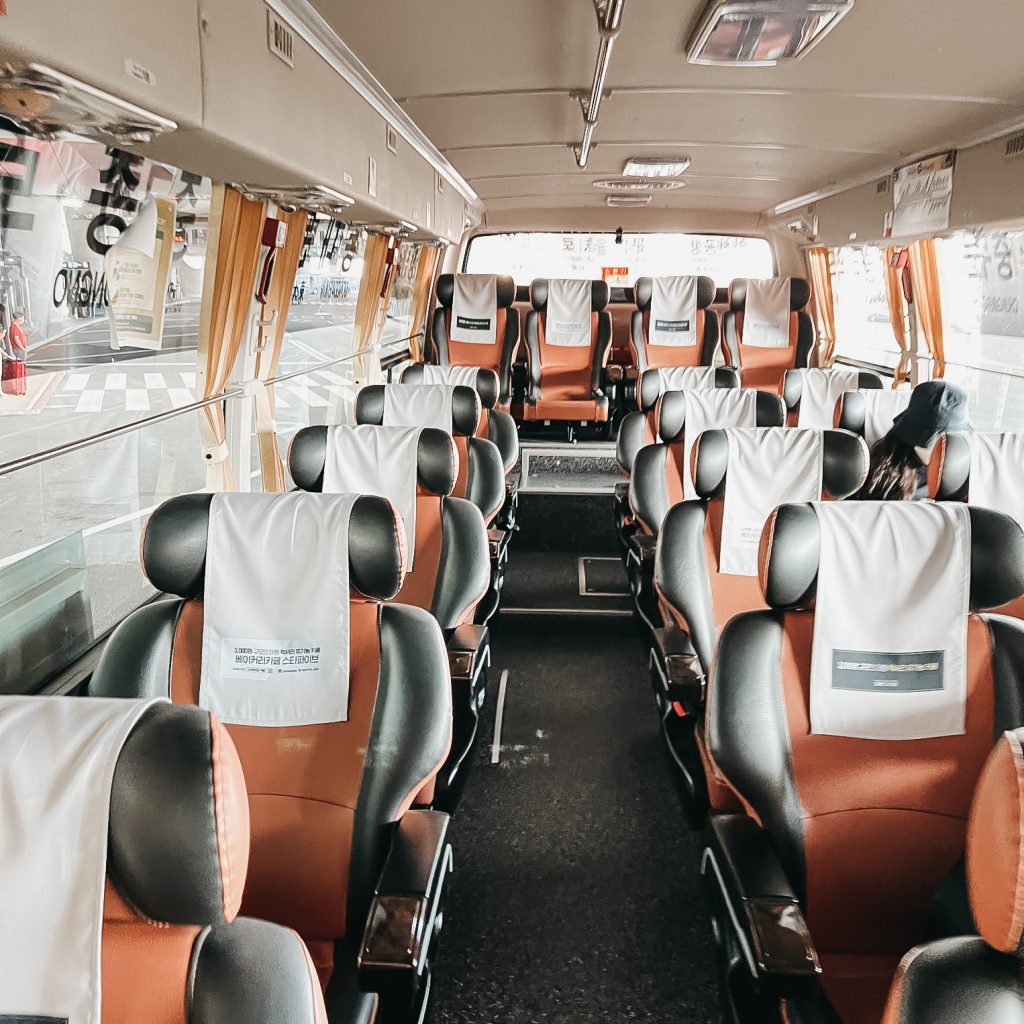
Express Bus
Express buses in South Korea are a convenient and affordable way to traverse the country’s diverse landscapes and reach destinations beyond the bigger cities. These comfortable, long-distance coaches offer a well-organized network that connects urban centers to charming rural areas and scenic countryside. The buses are equipped with modern amenities, ensuring a pleasant journey with features like Wi-Fi, spacious seats, and on some routes even onboard restrooms.
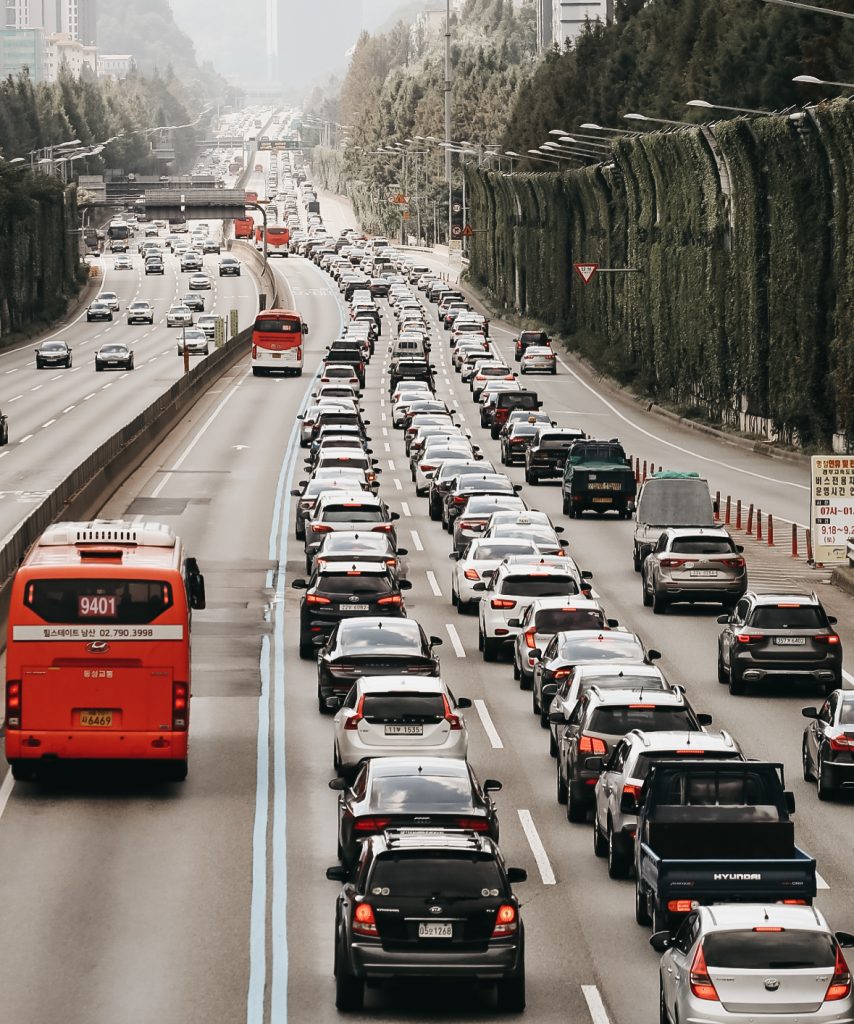
Within Seoul: Absolutely not recommended! Driving in and close to Seoul is definitely challenging and stressful due to the insane traffic and parking availability. I would only recommend it to very experienced drivers, but even then I would avoid it on all costs 😀
Going out of Seoul? Totally fine and a fun way to see more of the country’s stunning landscapes. Especially on Jeju Island or if you’re going to a rural area a Rental car is highly recommend to stay flexible and comfortable.
NEXTSTOPKOREA TIP : I usually book my rent cars for anywhere in South Korea via > Klook.com or directly via >Lotte Rentcar . Please be aware that you usually need an international drivers license (on Klook some one except Korean licenses, so check that well) and the credit card that was used when making the booking.
Now that you know how to get around the city and country, here some places I recommend you to visit or activities that will help you experience real Korean culture during your trip.
Must see Places in Seoul
If you travelled a lot you probably learned one thing: You can never see everything! I lived in Korea for 2 years now and still there are so many places on my bucket list.. it’s a never ending story!
So when you come to South Korea, I would recommend you to see some of the “Must Sees” that are tourist hotspots for obvious reasons and mix it up with unique experiences and hidden gems. Here a list of the most famous places in Seoul:
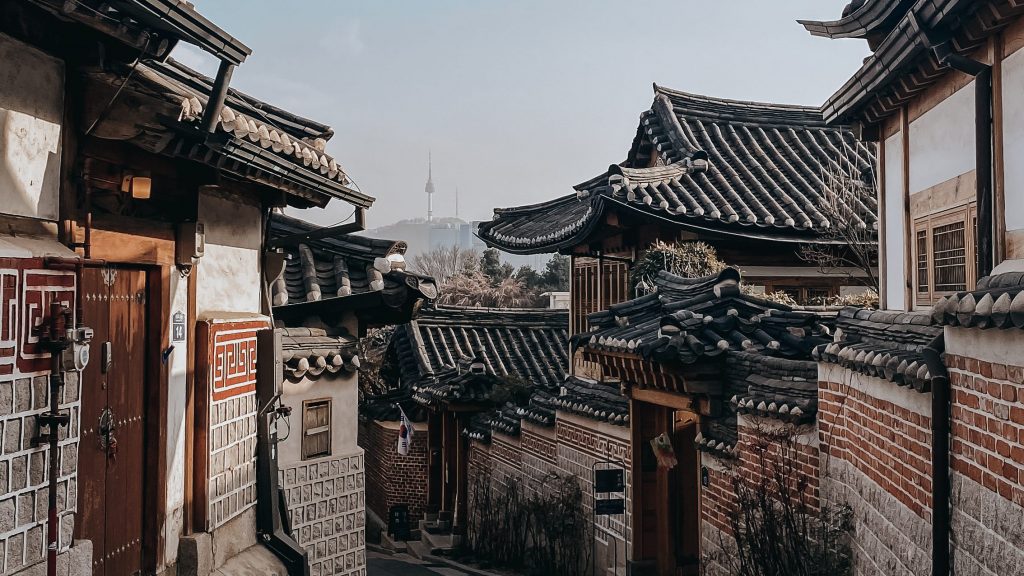
Alternatives
If you are looking for some Alternatives to the main tourist spots mentioned above, here some less famous and a bit less crowded recommendations:
- Tongin Market
- Namsangol Hanok Village
- Deoksugung Palace Changgyeonggung Palace
- Bongeungsa Temple
- Gyeonggui Line Forest Park
- Eunpyeong Hanok Village
- Euljiro Pocha Street
- Jeongdong Observatory
- Ssamziegil Insadong
- Changdeokgung Palace
- Seoul Forest
- Ihwa Mural Village
- Ansan Mountain
- Sejong Village
- Blue House (Cheong Wa Dae)
- Seoullo 7017
- Cheonggyecheon Stream
- Nodeul Island
- Haneul Park
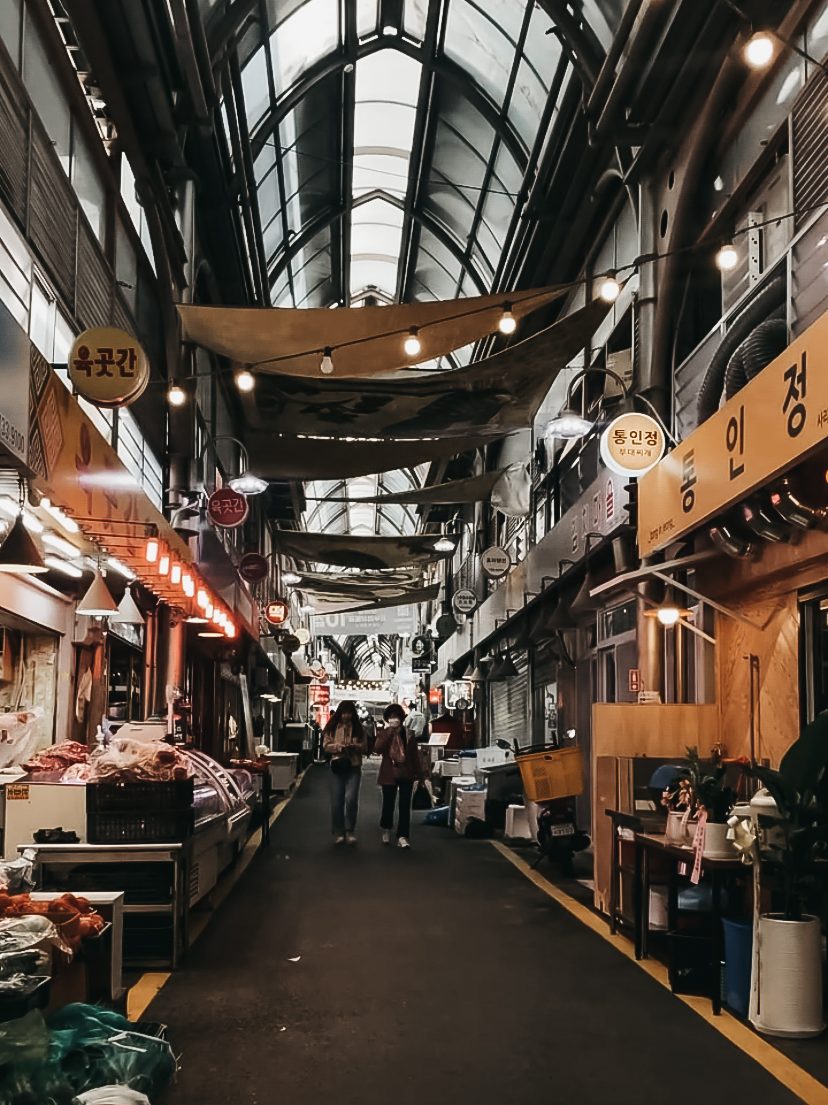
Overwhelmed with things to do? Subscribe to get a free 7 Day Seoul Itinerary in the first Newsletter!
Must do Activities
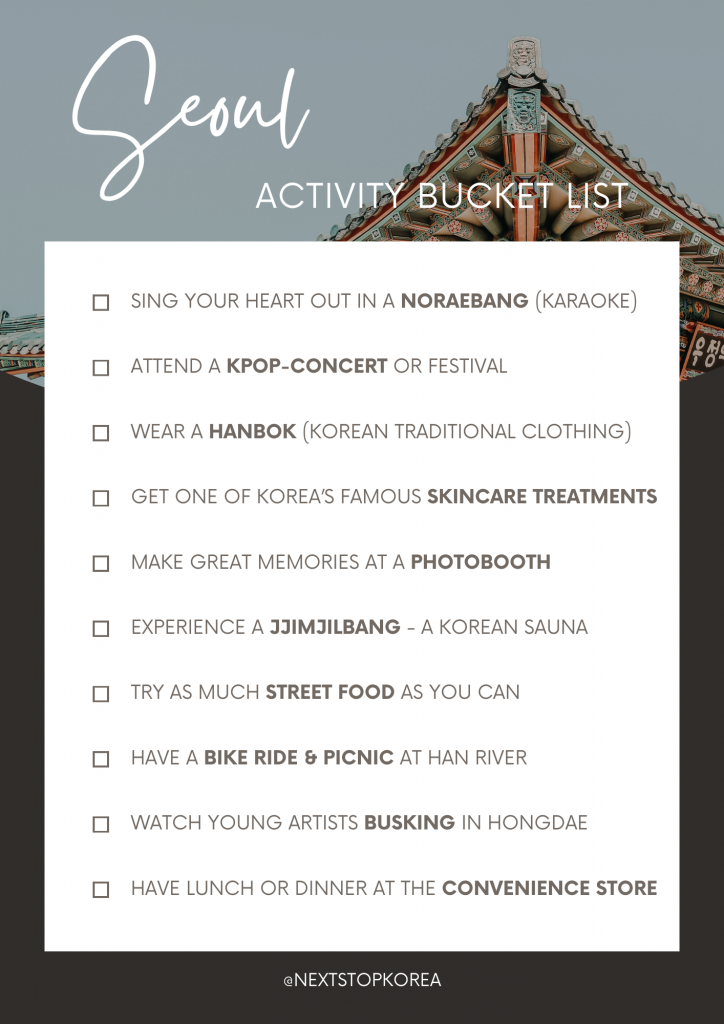
Other places out of Seoul
Even after 2 years I have an endless bucket list of places I want to visit in this country. Here 10 of my favorite trips from Seoul either short One-Day-Trips or longer journeys if you have enough time:
- DMZ Tour : Take a guided tour to the Demilitarized Zone (DMZ) to understand the divided history of North and South Korea. Please keep in mind, that many DMZ Tours do not include the most famous part – the Joint Security Area (JSA) – but they are still very much worth a visit!
- Suwon : Explore the impressive Hwaseong Fortress in Suwon – designed in the late 18th century to defend the city – and many other sights very close to Seoul City.
- Nami Island : Known for its natural beauty and tree-lined paths, Nami Island gained fame from K-Drama “Winter Sonata” but a tour to Nami Island is definitely recommend all over the year!
- Busan : Known for its stunning beaches and fresh seafood, this coastal city is a must-visit . It’s one of my favorite places in South Korea!
- Jeonju : A beautiful huge Hanok Village in the middle of the country especially recommended during Cherry Blossom, but also the rest of the year . Must Try: Jeonju Bibimbap & ChocoPie!
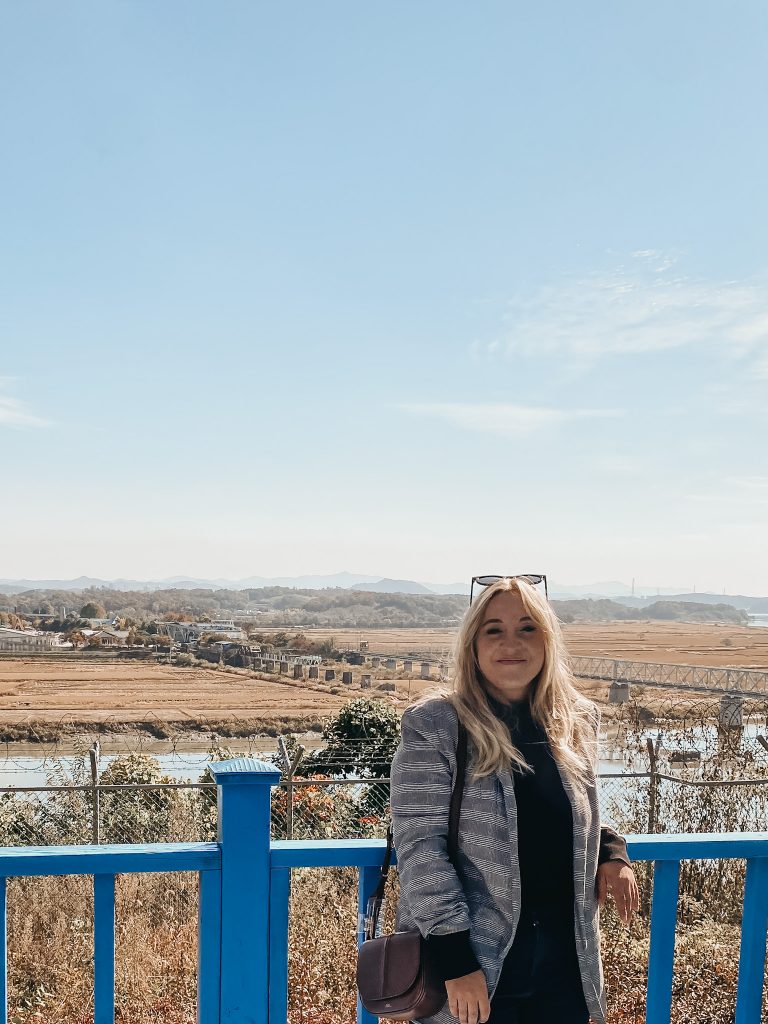
- Gangneung : Famous for Coffee and its stunning beaches this East Sea city is a perfect retreat from the crowded and hectic metropolis. Here a recommended tour !
- Danyang : My absolute top recommendation but unfortunately there are not many organized group trips yet. If you’re in to plan it yourself, this is one of the most beautiful spots to visit! (Combine it with the close by city Jecheon for a 2-3 day trip)
- Gyeongju : Often referred to as the “Museum Without Walls,” Gyeongju is a UNESCO World Heritage site with ancient tombs, temples, and ruins.
- Jeju Island : A volcanic island with dramatic landscapes, waterfalls, and hiking trails. It’s a UNESCO World Heritage site and a popular travel destination. Here some organized tour recommendations.
- Yeosu : A picturesque coastal city on the southern coast of South Korea, is celebrated for its stunning natural beauty and the iconic Dolsan Bridge, which provides breathtaking views of the surrounding islands and clear blue waters.
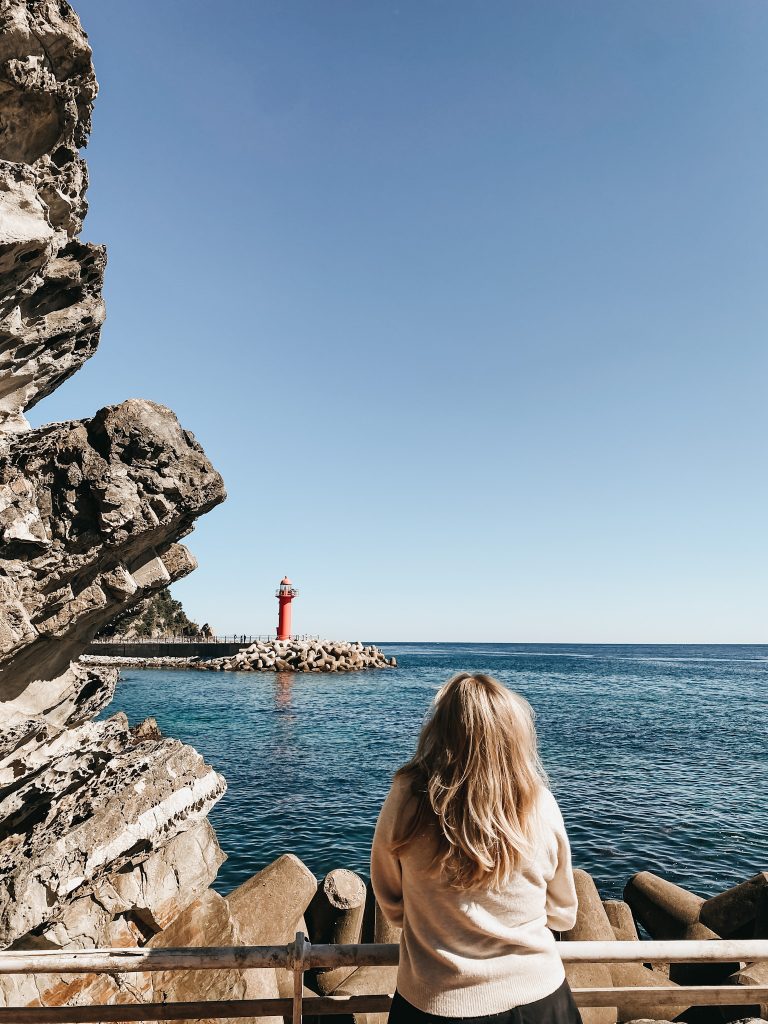
Korea is renowned for its diverse and colorful festivals, which celebrate everything from ancient traditions, contemporary art to korean pop music, providing visitors with unique cultural experiences throughout the year. Here some examples of the most popular festivals per month:
- Chilgapsan Ice Fountain Festival : Snow and Ice Sculptures, grilled potatoes and the best part: a completely frozen waterfall (January)
- Jeongwol Daeboreum Fire Festival : Marks the first full moon of the lunar year with fire-related activities. (February)
- Gwangyang Plum Blossom Festival : 200,000 square metres of plum trees near the Seomjin River, in an area known as Maehwa Village in Gwangyang. (March)
- Cherry Blossom Festivals : Join locals in celebrating spring’s arrival with breathtaking cherry blossoms. Jinhae Gunhangje Festival is one of the most famous. (April)
- Buddhas Birthday Festivals : Lantern Displays, Big parades and my favorite: special temple stay offers in temples all over the country. (May)
- Gangneung Danoje Festival : Traditional festival featuring mask dances, rituals, and cultural performances. (June)
- Waterbomb Festivals : Big music festivals in every bigger city in Korea featuring fun water activities – water guns are a must to bring to cool down. (July)
- Boryeong Mud Festival : Enjoy mud-based activities, music, and fireworks at this unique and lively summer festival. (August)
- Andong Mask Dance Festival : Experience traditional mask dance performances, showcasing Korean folklore and culture. (September)
- Seoul Firework Festival: A stunning fireworks display along the Han River, accompanied by music and performances. (October)
- Geoje Island Flower Festival : Enjoy fall at its best on the beautiful island with this event full of flowers and activities for the family. (November)
- Lantern Festivals: Colorful lantern displays that illuminate the hearts of many cities in South Korea, the biggest one happens in Seoul. (December)
COMING SOON: 50 Festivals in South Korea – all over the year!
When it comes to culinary traditions, South Korea boasts a vibrant and diverse food culture that’s as rich as its history and as varied as its landscapes. Korean cuisine is a delicious reflection of the country’s cultural heritage and its people’s deep connection to the land.
- Kimchi: The Korean National Dish -Fermented Napa Cabbage
- Bibimbap: Rice Bowl with Vegetables, Red Pepper Paste, Beef or Tofu
- Bulgogi: Thinly Sliced Marinated Beef or Pork grilled to Perfection
- Tteokbokki: Spicy Stir-fried Rice Cakes often with Fishcake
- Korean BBQ: Usually Pork belly or Marinated Beef or Pork Ribs
- Jjajangmyeon: chewy Noodles with a thick, savory Black Bean Sauce
- Korean Fried Chicken: the best Fried Chicken of the World.. trust me
- Kimbap: Seaweed Rolls with Rice, Vegetables, Beef, Crab or Tuna
- Naengmyeon: spicy (Bibim 〃 ) or non spicy (Mul 〃 ) Korean Cold Noodles
- Haemul Pajeon: Savory Seafood Pancake (or a Green Onion Version)
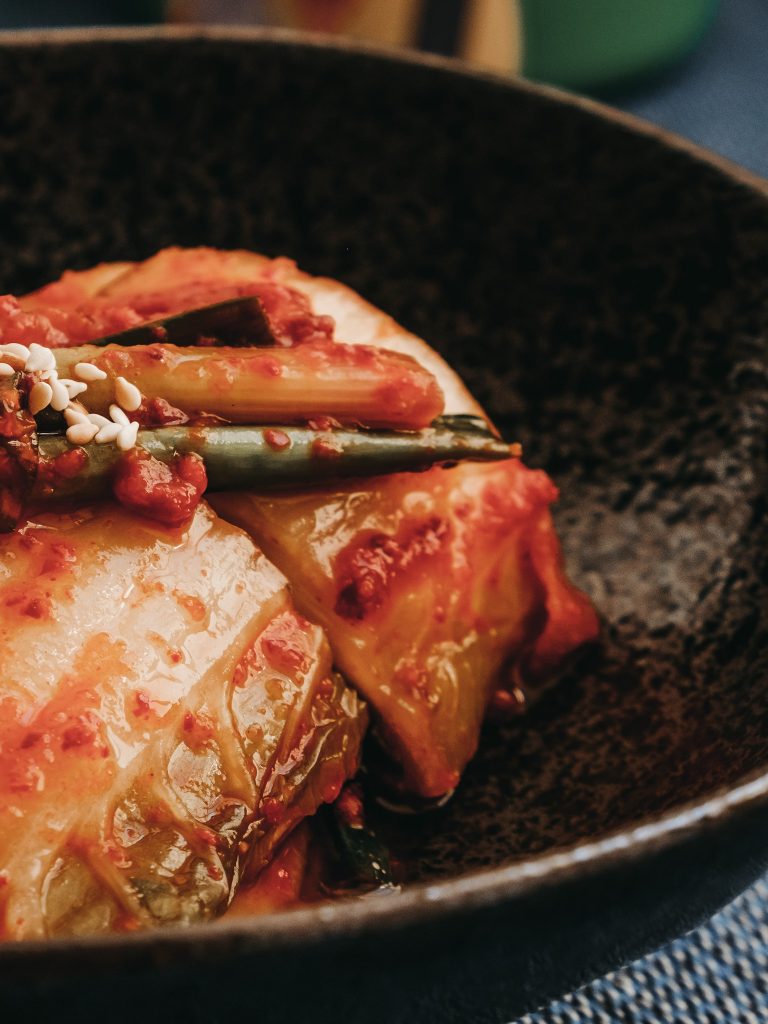
Korea is a shopper’s paradise, where traditional markets and modern malls coexist harmoniously, offering an array of unique and trendy products. Whether you’re looking for fashion, cosmetics, electronics, or traditional souvenirs, South Korea has it all.
Before diving into the shopping destinations, it’s essential to be aware of the typical operating hours in South Korea. Most stores and markets open around 10 AM and close between 9 PM and 10 PM . However, some smaller shops might have shorter hours, and certain areas, like Myeongdong, stay bustling well into the night. And of course most Convenience Stores are open 24 hours. Banks, Post offices and government organizations usually open from Monday to Friday 9 AM to 6 PM.
- Myeongdong : Shopaholics will love this bustling shopping district in Seoul, offering everything from cosmetics to fashion. You can get some free samples there, but be aware of clever sales people trying to sell you overpriced product packages!
- Dongdaemun Market: Dongdaemun is a historic market known for its wholesale clothing and fabrics. It’s the place to go for fashion enthusiasts, second hand fans and night owls, as many shops are open until late at night.
- Hongdae Shopping Street : This area close to Hongik University is not just great for busking and party, it’s also the perfect spot for young fashion and the newest trends.
- Namdaemun Market: As one of the oldest and largest markets in Seoul, Namdaemun Market offers a wide variety of goods, including clothing, accessories, electronics, and traditional Korean products.
- Insadong: If you’re looking for traditional Korean crafts, art, tea and antiques, Insadong is the place to go. It’s a hub for Korean culture and heritage.
- Department Stores: Lotte, Hyundai, Shinsegae are some of Korea’s leading department store chains, offering a wide range of luxury brands, cosmetics, and duty-free shopping for tourists.
- Airport Duty-Free Shops: Before departing, explore the extensive duty-free shops at Incheon International Airport, where you can purchase cosmetics, electronics, and luxury items at tax-free prices.
When visiting Korea, you’ll find an abundance of unique and memorable souvenirs to bring back home. Here are ten common souvenirs – besides magnets or postcards – to consider:
- Korean Beauty Products: Innovative cosmetics and skincare products from brands like Laneige, Innisfree, and Tony Moly – Olive Young is perfect for this!
- K-Pop Merchandise: Posters, albums, apparel, and memorabilia featuring your favorite K-Pop idols are usually much cheaper in South Korea.
- Hanji Crafts : Traditional paper-made crafts like fans, lanterns, and stationery.
- Korean Ginseng: Renowned for its health benefits, Korean ginseng is available in various forms, including teas, soaps and supplements.
- Handmade Pottery: Traditional ceramics like tea sets make great gifts
- Mother of Pearl: Exquisite traditional pearl jewelry, boxes, mirrors or the new option: Griptoks.
- Korean Tea: High-quality teas such as green tea or traditional Korean herbal teas – Insadong is the best place to shop for those.
- Korean Snacks: Unique Korean snacks like ginseng candy, honey butter chips, and seaweed snacks.
- Hand Fans: Hand-painted folding fans often adorned with intricate designs or the electric equivalent used by almost all Koreans to survive Korean hot, humid summer.
- Korean Socks : Sounds weird, but they’re just too cute and cheap, but still offer great quality.
TIME TO SAY GOODBYE
I am certain that you will love your stay in Korea and even if you won’t be able to see and explore everything (I lived here for 2 years and there are still endless things I haven’t done) I hope that you will go home packed with great memories! Come back soon ♡
Thinking about moving to Korea? Check the most common Visa Types here.
Liked this post share the love, join the family.
I am really interested in going 2024 as a solo traveler and really would like to know more stuff you offer. But wondering if you do like a tour guide type of thing. For the most part I’ve found some and it’s usually men who host it. For personal reason o don’t feel comfortable hence why I am looking for a female travel guide.
I unfortunately am not doing Guide Tours, but maybe check the website Greether for some female guides! Or NomadHer for a travel buddy 🙂
Leave a Reply Cancel Reply
Your email address will not be published. Required fields are marked *
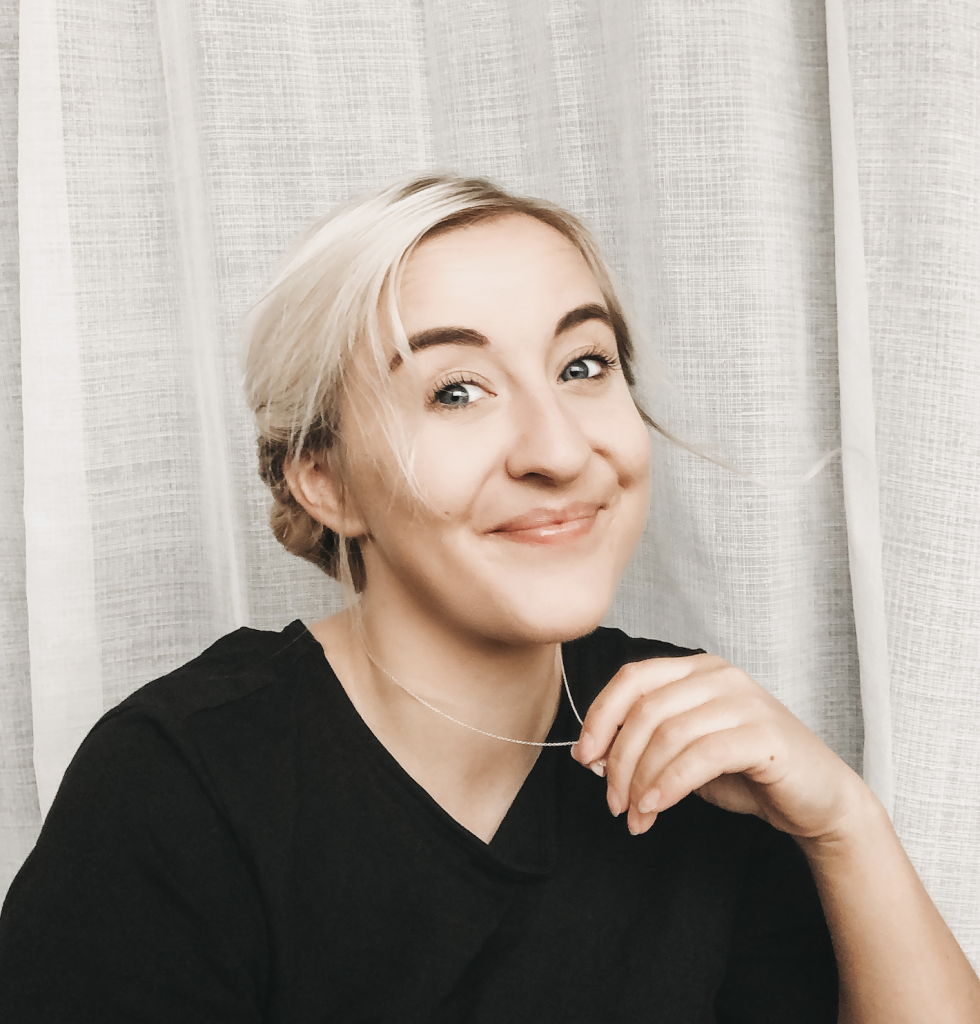
Hey, great that you're here!
Get to know me >>, recent blog posts.
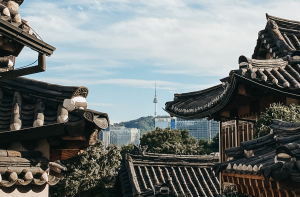
South Korea in June 2024 – Everything you need to know!
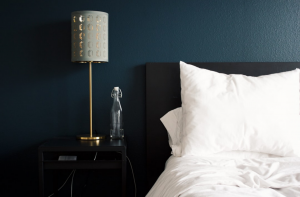
Best Hotels in Seoul – A Traveler Approved list
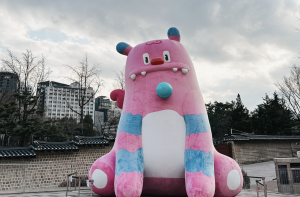
South Korea in May 2024 – Everything you need to know!
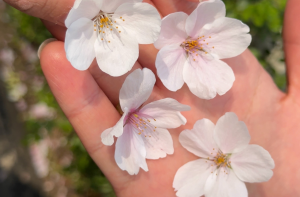
Enjoy Seoul’s 85 stunning Flower Paths [from March to June]
Let me plan your trip.
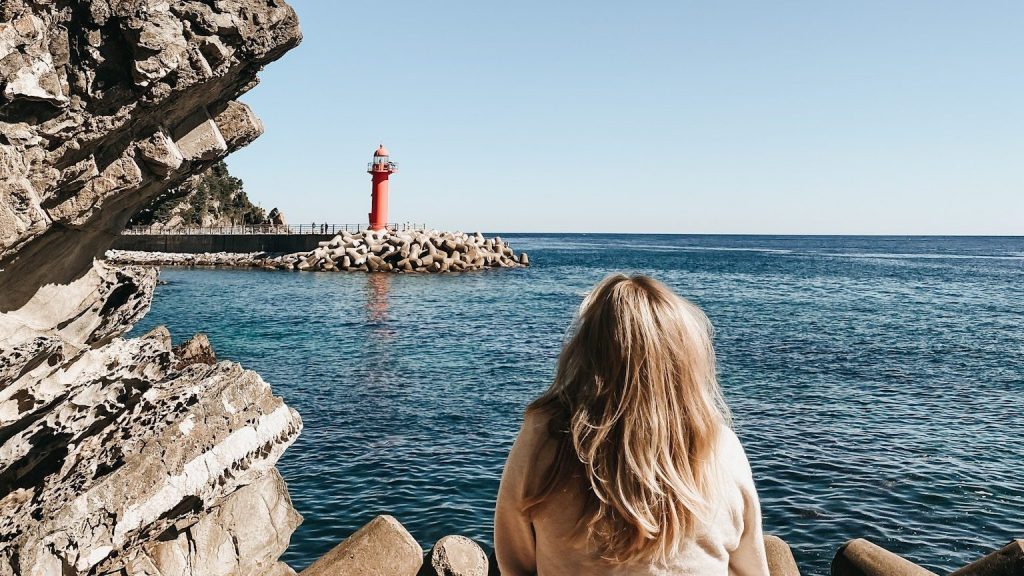
I can help you planning your Korea Trip in case you’re a bit overwhelmed with all those places and tips.
Check out Planning Service >>
Terms and Conditions - Privacy Policy

25+ Best South Korea Travel Tips: What to Know
Looking for some South Korea Travel Tips ? We’re here to tell you all the best things to know before visiting South Korea! We’ll share many recommendations along the way – including sim cards, Korean street food, transportation , and a few things that stand out in South Korea compared to other countries.
Let’s find out what to know before visiting South Korea & the best South Korea travel tips!

This post may contain affiliate links. We will receive a small commission if you make a purchase using these links, at no additional cost to you .
South Korea is a unique country in East Asia that’s a little underrated compared to its neighbours! The country has so much to offer, Koreans are so friendly, the nature is incredible and the culture is beautiful! We can’t recommend visiting South Korea enough which is why we’re excited to create these guides!
This guide was created to show you the best South Korea travel tips so you can plan your trip and have a great time. We’ve created itineraries for some amazing destinations in South Korea – check them out!
2 week South Korea Itinerary / 5 Day Seoul Itinerary / The Best Templestay in Korea / 3 day Busan Itinerary / Best Things to do in Gyeongju & Itinerary
25+ Best South Korea Travel Tips
Table of Contents (Skip to a section!)
Let’s get straight into it! Here are the best South Korea travel tips and all the best things to know before visiting South Korea! Enjoy !
1. Book Accommodation in Advance
If you want to get the best accommodation for your time and budget then we recommend booking accommodation at least 3 weeks in advance! Although it’s possible to find hostels or hotels last minute, they may not be the best you could have had.
If you’re travelling to South Korea on a budget – hostels do exist but they can get booked up quite fast compared to on-the-go travel! We’ve listed all our recommendations in our 2 week South Korea itinerary – check it out !
2. South Korea has a big cafe culture
It’s impossible to walk around a corner in Seoul without discovering another cafe. The cafe culture is huge in South Korea and you’ll find trendy or themed cafes all around the country. Check out Hongdae in Seoul to experience dog cafes or a Harry Potter themed cafe!

3. Download Naver Maps & More(alternative to Google)
One of the most important things to know before visiting South Korea is that Naver will become your Google of South Korea! When trying to get around South Korea, Naver Maps is the way to go! Google Maps doesn’t work too well in South Korea so it’s best to download the Naver and Naver Maps apps before you arrive in the country.
Here are a few other apps to download for travelling in South Korea:
- Naver (like the Google search engine)
- Kakao Maps (like Google Maps)
- Kakao Talk (like Whats App)
- Subway Korea (subway navigation)
- Klook (deals on activities)
- Papago (like Google Translate)
- Naver Dictionary & Translate (like Google Translate)
- XE Currency (currency comparison)
- Kakao Taxi (like Uber)

4. Get Data!
Another one of the best things to know before visiting South Korea is that although the wi-fi is good, it isn’t everywhere . This means you’ll struggle with navigation if you’re used to using Google Maps to get around. As almost everything is online these days we recommend getting a sim card or portable wifi for your trip to South Korea! Here are a few options (we used an E-sim!) :
E-Sim – The best option if you don’t need a Korean number. They’re really easy to use – purchase the sim online and with instructions you can install the sim on your phone settings. You don’t even have to worry about a physical sim or picking anything up! Here’s a 12 Day E-Sim . (around £9.50 for 12 days)
Prepaid Sim – This may be the best option if you want a Korean number as well as data. Price changes depending on the length you want the sim. Find a sim card on Klook here ! (around £15 for 10 days) Pick up at the airport.
Portable Wifi – A great option if you want to connect with multiple devices. These are usually the more expensive option but so handy! Find a portable Wifi on Klook here ! (around £20 for 10 days) Pick up at the airport.
We also recommend carrying a portable charger for your phone so you always have enough battery to last a full day! We recommend this one – Anker Power Bank .
5. Try some of the best Korean Skincare
Korean Beauty is popular all over the beauty world – with Korean skincare and Korean makeup designed to give you flawless and glowing skin. Myeongdong in Seoul is definitely the area to hunt for Korean beauty products and even get a makeover done! It’s also more common to get plastic surgery in South Korea as appearance is really important to Koreans.

6. Best time to visit South Korea
The best time to visit South Korea is Spring (April to June) or Autumn (September to November) ! In these months the weather is usually at its best with sunny days and comfortable temperatures.
It’s totally possible to visit South Korea any time of year – the winter is a magical time of year to visit with snow covering the mountains and cities. Summer is rain and typhoon season, so it’s not really the best time of year to visit due to the unpredictable climate.
7. Learn some Korean phrases
Another one of our South Korea travel tips is how handy it will be to learn some Korean phrases before visiting South Korea. Learning basic phrases should be done when travelling to any country around the world. Here are a few we think you should memorize:
- Hello – ahn-nyong-ha-se-yo
- Thank you – gahm-sah-hahm-ni-da
- Yes – neh or deh
- No – ah-nee-oh
- Please – jwe-song-ha-ji-mahn
- Excuse me – sil-le-hahm-ni-da
- Good-bye – ahn-nyong-hee ga-se-yo
The best way to start learning some Korean phrases is to watch YouTube videos or use apps such as Lingodeer, Duolingo or Memrise . It’s very helpful when travelling in Seoul and around the country.

8. Book trains tickets in advance
If you’re planning on taking any trains or buses on a weekend, then a South Korea travel tip for you is to book your train tickets in advance ! Trains in South Korea can often sell out if you leave them till the day. Make your reservations at least 1-2 weeks in advance to secure them on the Korail website !
You can only book buses in advance if you have a Korean phone number – however, you can book them a couple of days in advance when arriving at the station. Get your train tickets here – Korail tickets ! and here’s a link to check bus times !
9. Spend the most time in Seoul
We don’t want these South Korea travel tips to be too obvious but – you will fall in love with Seoul! It’s the capital city of South Korea surrounded by beautiful mountains and there’s so much to do in the city including many neighbourhoods to explore! Check out our 5 Day Seoul Itinerary travel guide here!
10. Get a T-Money Card
The best way to get around cities and towns in South Korea is by public transport! One of the first things to do when you arrive in South Korea ( which is probably going to be Seoul ) is to purchase a T-Money Card .
T-Money Cards are transport cards that you top up with cash-only and you just swipe the card when entering transport. It’s the easiest way to use public transport as you don’t have to worry about buying a ticket every time you want to travel. You can purchase these cards at convenience stores or vending machines at main points of travel (such as the airport) .

11. Always carry cash (Korean Won ₩)
This leads us to one of the next South Korea travel tips – carry cash everywhere you go in South Korea! To top up your T-Money card you have to use cash even in convenience stores to add to the card. Cash is also used for buying Korean street food and is often preferred in restaurants! We even had two accommodations asking for cash-only which was a panic rush to a cash machine!
12. Get Papago (or use GoogleTranslate)
Papago is an app for translating the Korean language into your own. It also helps with translating your own language to Korean when speaking with any Koreans. Papago was recommended to us by travellers we met in South Korea, however, Google Translate actually worked perfectly for us! We even used it to have conversations with Koreans – which was so fun!
One of our South Korea trips is to use the Google Translate app to scan your food in grocery stores, the app picks up the Hangul characters. There are a few ingredients we don’t eat, so it was very helpful to read the ingredients on food packets just like it was in English!
13. No need to tip
Another one of the things to know before visiting South Korea is that you won’t have to tip! There’s no tipping culture in South Korea as service should be the best at all times. It’s a very useful tip to know when visiting South Korea!
14. Prepare for the season
South Korea has four seasons and it’s definitely good to be prepared for the season at any time of year.
- Winter – (December – February) – Wrap up warm and be prepared for snow!
- Spring – (March – May) – One of the best times to visit, it may still be cold & it’s a busy time of year!
- Summer – (June – August) – Be prepared for hot & humid weather with heavy rains!
- Fall – (September – November) – Another popular time to visit, fall starts to get a little chilly!

15. South Korea is safe
South Korea is one of the safest countries in the world ! We’ve heard that some Koreans leave their phone on the table to keep their spot when buying a coffee – we’re not sure if that’s true, but it’s honestly believable! South Korea has a low crime rate and strong security measures in the country.
It’s important to note – whenever travelling, always be cautious of your surroundings and stay safe.
16. South Korea Travel Costs
From our experience, prices in South Korea are pretty good if you’re travelling on a budget as long as you know it’s not as inexpensive as South East Asian countries. However, South Korea is less expensive than Japan and the UK. We’re in the process of creating a full breakdown of our costs in South Korea, for now here’s what you can expect for 2 weeks of travel in South Korea per person.
Accommodation – £33 / ₩52,000 per night (private room, can be shared between two people)
Food – around £20 / ₩300,00 a day with a mix of restaurant and convince store meals
Transport – around £95 / ₩150,000 for 2 weeks of travel
Activities – around £10 / ₩15,000 a day
How can you save extra money? Choose restaurants that aren’t so expensive, shop at convenience stores more often, stay in private rooms in hostels and take buses instead of trains.
17. Couples culture is a thing
When walking around South Korea you’ll notice that couples often wear matching clothes or shoes and it’s the cutest thing. Korean couples love doing things together and if you visit one of South Korea’s many theme parks you’ll definitely notice a lot of matching outfits ( including friend groups! )

We use a Joby GorillaPod 3K Pro Kit to take photos of us together on our camera, it’s so useful especially when there’s no one around! There’s also a version for a phone – Joby Phone Tripod to get the best photos on your South Korea trip!
18. The tap water is safe to drink
Another one of the things to know before visiting South Korea is that tap water is safe to drink! Most Koreans will often boil the water before drinking it but the water is completely safe. Bring a reusable water bottle to always have water on the go without buying plastic!
19. Watch a Korean Drama before you visit
K-dramas are a big deal in South Korea and many people outside of the country love them too! Filming locations are very popular sights to see around South Korea! If you’ve never seen a K-drama before, here’s a list of some of the most popular shows:
- Mr. Queen (2020-2021)
- The World of the Married (2020)
- Sky Castle (2018-2019)
- Reply 1988 (2015-2016)
- Crash Landing on You (2019-2020)
20. You have to try Korean food
Korean cuisine is amazing! ( even for vegetarians !) Hopefully one of the reasons you’re visiting South Korea is to try the food but even if it isn’t – you will love the experience! Korean food is warming, tasty and unique all at the same time. Here’s few dishes to try on your visit to South Korea:
- Tteokbokki (Rice cakes in a spicy sauce)
- Kimchi (Spicy fermented cabbage)
- Gun Goguma (Roasted sweet potatoes)
- Mandu (Korean dumplings)
- Bibimbap (Rice bowl with toppings)
- Gamja-Hotdog (Korean-style corn dog covered with potato)
- Dakgangjeong (Korean fried chicken with a sweet spicy coating – There’s vegan options too!)
- Soju (like Korean wine)

21. Trains are fast, but buses are amazing!
Another one of our South Korea travel tips is that although trains are fast, they aren’t the only way to get around the country. Express and intercity buses are underrated in South Korea and they’re so comfortable.
Buses are usually half the price of trains and they do take a little longer to get to the destination – but South Korea is a small country so it’s really not too long! Find tickets here – Express & Intercity Kobus tickets !
22. The country has so much to offer
There isn’t enough time you can give yourself on a trip to South Korea. We spent 2 amazing weeks exploring the country and wanted to stay longer! If your first trip is a few days in Seoul – that’s the best introduction to the country and we’re sure you’ll be planning another trip straight away.
Seoul / Jeju Island / Gyeongju / Seoraksan National Park / Gunsan / Golgulsa Temple / Gwangju / Suwon / Hwaseong / Busan / Chuncheon / Andong / Jeonju / Boseong – Check out our Ultimate 2 week South Korea Itinerary: Best Places (2024) to plan your trip!

23. Eat at convenience stores
Convenience stores are everywhere in South Korea with more than 40,000 stores in the country. They’re helpful for everyday items but most importantly they’re great for food. Whether you’re on a budget or not, eating meals from convenience stores has to be done on your trip.
Try a ramyeon or rice snack from CU , 7/11 or GS25 !
24. Korea is fashionable
As we’ve mentioned in this South Korea travel tips – Koreans take pride in their appearance! This means South Korea has amazing fashion taste. The country has maintained a unique and individual style of fashion and it’s usually quite contemporary. Unfortunately, our backpacker clothes didn’t really look the part in South Korea and we felt like getting a new wardrobe!
25. Try to learn Hangul (Korea’s Alphabet)
South Korea’s alphabet is surprisingly easy to learn compared to other surrounding countries. Hangul is made up of 24 characters and although it looks difficult to learn at first, it’s actually quite logical and makes sense.
Learning Hangul will be so helpful for menus, shops and transport in South Korea although there are also English signs in cities! Here are a few apps to help you learn: Lingodeer, Duolingo or Memrise .

26. Understand Korean Culture
When visiting a country it’s always polite to follow the etiquette being used and to respect the culture. Here are a few things to know before visiting South Korea! (not all of these are used by every Korean!)
- When accepting or offering money use both hands.
- Remove your hat when indoors
- Remove shoes when entering a home or accommodation
- Respect anyone whose older than yourself
- Respect anywhere that’s quiet (such as subways or quiet outdoor spaces)
27. Look into going on a hike
South Korea is amazing for nature! The country is made up of beautiful greenery and mountains and it’s even possible to go hiking in the capital city – Seoul! If you’re not into hiking, you do the short walk up to Seoul Tower in Namsan Park.
- Ulsanbawi Trail (Seoraksan National Park)
- Biryong Falls (Seoraksan National Park)
- Bukhansan (Seoul)
- Jirisan (near Gurye / South part of South Korea)
- Hallasan (Jeju Island)

That concludes our 25+ best things to know before visiting South Korea and top South Korea travel tips! We hope that these will help you on your future trip to South Korea! Check out our other South Korea travel guides to plan the most amazing trip.
What to pack for South Korea?
As you know, from this South Korea travel tips guide – there are four seasons in South Korea! Make sure you’re prepared and have the correct type of clothes when visiting the country. Always have a decent pair of footwear with you for lots of walking! Here are a few travel essentials we always carry:
- Stainless Steel Water Bottle – A must when travelling to countries with drinkable tap water!
- Amazon Basics Packing Cubes – The best way to pack your bag or suitcase!
- Rain Mac in a Bag – A lightweight raincoat to carry around with you in South Korea!
- Anker Power Bank – Always have charged gadgets with your own portable charger!
- Worldwide Travel Adaptor – The ultimate travel adaptor when travelling to multiple countries!
- Joby GorillaPod 3K Pro Kit – The best lightweight tripod to take anywhere in South Korea! We are obsessed with our Joby GorillaPod and use it with our Sony A600 . Joby also has a phone version – Joby Phone Tripod .
Here’s 10 travel essentials for women travelling in South Korea and anywhere around the world!

Quick South Korea travel tips:
Currency – Korean Won (compare to your own currency here ) Language – Korean (한글) Cuisine – Korean Cuisine (noodles, rice, bbq & kimchi) Apps – NaverMaps (like GoogleMaps) & Kako Talk (like GoogleTranslate) Transport Card – T-Money Card (the easiest way to use public transport in South Korea) Korea Power Voltage – Plugs C & F (220 V)
Best places to stay in South Korea
- Seoul – Hostel Tommy – Find here on Booking.com !
- Busan – Dynamic Guesthouse – Find here on Booking.com !
- Jeonju – Jungdam – Find here on Booking.com !
- Gyeongju – Doobaki Guesthouse – Find here on Booking.com !
More South Korea guides:
- Ultimate 2 week South Korea Itinerary: Best Places (2024)
- 5 Day Seoul Itinerary – Best Things To Do (2024)
- Staying in Golgulsa Temple: The Best Templestay in Korea (2024)
- 3 day Busan Itinerary: What to do in Busan (2024)
- 11 Best Things to do in Gyeongju: Itinerary (2024)
- Ultimate South Korea Bucket List: 20 Best Things To Do
- All our South Korea posts!
That’s the end of our 25+ Best South Korea Travel Tips: What to Know Before Visiting South Korea ! Have the best trip to South Korea and if you need any more help planning – send us a message on Instagram (@thesunrisedreamers) or leave a comment below!
LIKE THIS POST? PIN IT FOR LATER & SHARE IT WITH OTHERS!

Amy & Dan are the founders of The Sunrise Dreamers. They are travellers from the UK who have been on the road since 2017 whilst living in places like England, Canada, Thailand and the Canary Islands. They share their knowledge of travelling the world with detailed travel guides and tips. They're experts in vegan travel and show their audience how to travel on a budget.
Similar Posts

20 Tips to Know Before Travelling to Sri Lanka (2024)
Are you planning a trip to Sri Lanka soon? That’s amazing! We have a great list for you – 20…
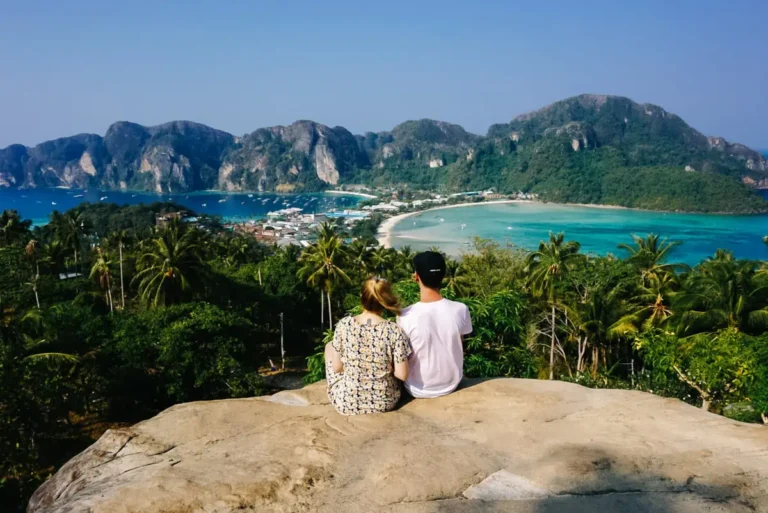
The Best 2 week South Thailand Itinerary (2024)
Wondering how to plan your 2 week South Thailand Itinerary? We’ll help you! The Thai Islands are incredibly beautiful –…

Koh Lanta Vegan Guide: Best Vegan Restaurants (2024)
Looking for a Koh Lanta vegan guide in 2024? You’re in the right place! We’ve created the best list of…

The Best El Nido Itinerary: 3 Days in El Nido
Are you planning a 3 Day El Nido itinerary? Here’s our in-depth travel guide to help you plan your trip…

What to do in Colombo: 7 Amazing Places to Visit in 2024
Are you wondering what to do in Colombo? Sri Lanka’s busy capital city is filled with beautiful temples, hidden foodie…

The Best Coron Itinerary: 3 Days in Coron, Philippines
Planning a 3 day Coron itinerary or wondering what to do in Coron? In this travel guide, we’ll show you…
Leave a Reply Cancel reply
Your email address will not be published. Required fields are marked *
Save my name, email, and website in this browser for the next time I comment.
About South Korea
South Korea is well known for its rich culture, delicious food and stunning landscape. Found in the southern half of the Korean Peninsula Korea is one of the most densely populated countries in the world with a population estimated at over 51 million people.
FREE Resources
Don't miss out on my FREE travel tips and recommendations for traveling in South Korea on my blog!
Popular Blog Posts
Korea Travel Essentials
1. Data & Connectivity 📶
Why should I buy a SIM Card or WiFi Egg?
1) You can share your travel experiences in real-time on social media.
2) You will always have data access to use for navigation apps such as Naver Maps or KakaoMaps. You will need to have a connection to data otherwise you WILL get lost.
3) You can stay in contact with your loved ones from back home easily.
SIM Card vs Pocket Wifi
Whether you choose to use a SIM card or WIFI egg depends on what will work best for your travel needs for your trip. I personally always buy a SIM Card over a WIFI egg based on the PROS.
1) There is no need to carry an extra device i.e. Pocket WiFi
2) Possible to MMS/SMS/Call
3) Provides a local Korean phone number - Some places such as restaurants and cafes require visitors to put down a Korean phone number for a waiting line. If you want to book an appointment e.g. hair or make a reservation for a workshop then having a Korean phone number will allow you to do this.
1) Need an unlocked phone to use a SIM card
POCKET WiFI
1) There is no need to swap your original SIM Card
2) Pocket WiFi can provide a larger amount of data compared to a SIM card. I've generally found I've never 'run out of data' when using a SIM Card. This ultimately depends on what you're using the data for. I mainly use it for basic tasks like navigating around places, translation services, updating my social media and communicating with loved ones back home.
3) Can be connected to multiple devices. This makes it perfect for traveling with family and/or friends and you can split the cost.
1) You need to carry an extra device. This can add weight to your bag, which makes a difference if you're already carrying your phone, camera and other essentials.
2) If you rent a portable WiFi router you will need to return it. This can take up time on your trip which can be used instead for more exploration on your travels.
3) The battery life of a pocket wifi can run out of charge. The battery life drains really quickly if it is used simultaneously.
BEFORE getting a SIM CARD 🚨
Please make sure you check this information before you purchase a SIM Card.
1. Check if your phone is unlocked or not. To check whether your phone is unlocked you can call your mobile phone carrier to unlock it. If you are from Japan, Canada, or the US check with your phone carrier before your trip to Korea. If your phone is locked then you won't be able to use some of the prepaid SIM Cards.
2) Check to see if your device supports GSM network frequencies. To see if your phone is compatible with Korean mobile carrier networks use the link below. Afterwards check if your device supports one of the GSM network frequencies below:
3G Bands: HSDPA 2100MHz/HSDPA+
4G LTE Bands: Band 1(2100MHz), Band 3(1800MHz), Band 8(900MHz)
CHOOSING the right SIM Card Type ❗️
It is recommended that you buy a universal type USIM card, which is compatible with phones using any type of SIM card (Standard, Micro, or Nano-SIM). Most Android phones use a Nano or Micro SIM whilst most iPhones use a Nano-Sim.
If you are choosing to pick up your SIM card in Korea, choose a location that coincides with your arrival destination in the country. For example if you are flying into Incheon Airport, make sure it can be collected at this location.
Where can I buy a SIM card or Pocket WiFi? 💸
The easiest and most convenient way to purchase a SIM card or Pocket WiFi is online before your trip. Alternatively, if you want to buy it in person, you can purchase it at Incheon Airport or at outlets operated by Korean mobile services such as KT, SKT, and LG U+. You can also find SIM cards at convenience stores like Seven-Eleven, CU, and GS25.
Instant Connectivity to Data
To get instant access to data abroad I recommend Airalo. This is an app that allows you to download a prepaid eSIM to your phone in over 190 countries. You can skip waiting for your SIM card to arrive at your home address or pick it up at the location.
Recommendations for SIM Cards & Pocket Wifi ✨
SIM Cards (PICK UP) 📱
I'll talk about T-Money Cards in the section below.
SIM Cards (DELIVERY) 📱
The following options allow purchasers to buy the SIM card online and get it delivered to their home address.
WiFi Pocket 📱
Remember to select the correct pick up destination for your WiFi Pocket.
Staying connected abroad is important for safety and travel. If you don't plan on ordering s SIM card or a pocket WiFi consider getting a VPN. A VPN ensures that your personal information isn't accessed easily by third parties. By using NordVPN to access websites in your home country and have protection when you use public WiFi.
Staying connected abroad is important for safety and travel. If you don't plan on ordering s SIM card or a pocket WiFi consider getting a VPN. A VPN ensures that your personal information isn't accessed easily by third parties. By using NordVPN you can also access websites in your home country and have protection when you use public WiFi.
I've been using NordVPN ever since I moved abroad to South Korea and it has been a lifesaver! Not only does it allow me to access Australian sites and added protection when I connect with WiFi at any airbnbs or hotel.
If you sign up using my link you'll be able to get 63% off a plan!
2. Travel Essentials
Important Etiqutte
🚊 Don't sit in priority seats
💵 There is no tipping culture ~ don't give tips.
🍚 Don't stick your chopsticks in your rice
🤲🏻 Never receive items with one hand. Always use both hands when giving and receiving.
✍🏻 Don't write names in red
🤧 Don't blow your nose at the table
Important Numbers
✆ Tourist Information Center: 1330 (for any other tourism-related assistance)
✆ Emergency Medical Information Center: 1339 (medical assistance for international visitors)
✆ Fire Department: 119 (for general accidents and ambulance)
✆ Police Department: 112 (for theft, assault, and other crimes)
The currency used in South Korea is Korean Won (₩ or KRW). I recommend before you visit South Korea that you exchange money. If you have to exchange money do NOT do it at the airport because you'll get the worst exchange rate.
Travel Insurance
If you’re traveling overseas, don’t forget to purchase travel insurance. I always recommend World Nomads as my preferred travel insurance.
Where Can I Find the Best Flight deals to South Korea?
In order to find the best and most affordable deals I always recommend using a combination of booking websites and the airlines' websites. You'll want to compare the prices as well as what is included in terms of baggage, layovers, etc.
You will most likely be flying into Incheon International Airport, which is located in the city of Incheon.
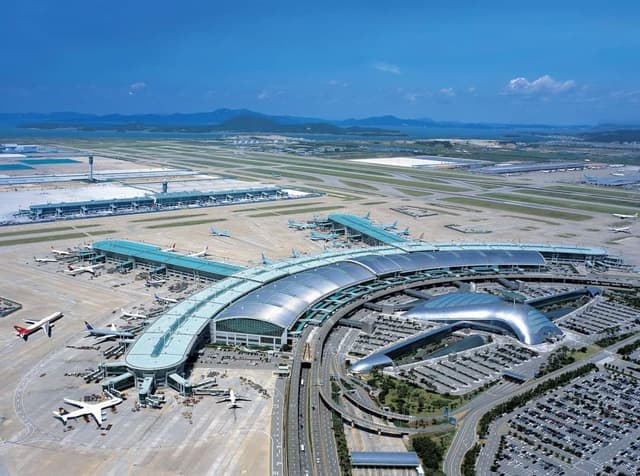
Here are my recommendations for price comparisons.
Accommodation
Where can I find the best local and affordable stays in Korea?
I use a variety of booking platforms for hostels, hotels and airbnbs in South Korea.
If you want all the best stays in South Korea (best areas in each city, recommendations for a temple stay and hanok) check out my guide below.

Activities & Tours
Where can I find and book local tours, activities or tickets for attractions in Korea?
I use a combination of travel booking sites. This isn't sponsored I've just had great experience with both sites for my travels overseas. When I traveled solo in South Korea and to other countries it was great having everything planned for me and I also got to meet some other travelers on my trip.
RECOMMENDATIONS
Don’t miss out on top-rated excursions, attractions, and sightseeing tours in South Korea. From guided local tours to private day trips, Get Your Guide has something for every traveler to enjoy.
Use Klook to find activities, tours, cars, hotels, and tickets to attractions at affordable prices. I love how easy it is to book in advance saving me $$ and time on my trip planning. Klook also offers seasonal activities and tours for South Korea. So if you're visiting in autumn, winter, or spring you'll have to check out the unique local experiences they have to offer. From summer sports, cherry blossom tours, or fall foilage day trips.
Travel Adaptor
Korea has Type C and F plug sockets with a standard voltage of 220. Although you can buy an individual adaptor with these plug sockets I strongly recommend buying a universal or 'world' travel adaptor.
I started using Universal or 'World' travel adapters for my travels instead of buying individual adaptors for every country I would visit. Not only are they affordable but you'll also be saving money in the future because you can re-use them for your future travels to other countries.
Don't miss out on these travel adaptors recommendations!
I've also listed other essential items I use for my travels.
3. Must-Have Apps for South Korea📱
These are essential apps you should download to help your travel, shop, and navigate around Korea.
Reminder - Download the Thatch App.❗️
Download the FREE Thatch app so you can access this interactive guide while you are traveling!
1. Navigation Apps 📱
Kakao Map and Naver Map will be your best friend for navigating and finding recommended cafes and/or restaurants in South Korea. Do NOT use Google Maps because it is not supported and kept up to date. You will often get inaccurate map directions and locations if you use Google Maps.
Both apps are in Korean by default but the mobile apps are available in English. Naver Map is also more English-friendly but I personally found using both apps as the best way for navigate and finding points of interest in South Korea.
Download Naver Map
Download Kakao Map
2. Transportation 🚆
Subway Korea (Navigation & Transportation) 🚆
No, it's not the sandwich place but a subway map app. It provides the most up-to-date maps of the subways in Korea. Simply put your starting station and the destination and it will map out the directions for you.
4. What are the best transport passes?
Korea Rail Pass
The Korea Rail Pass (KR Pass) provides unlimited rides on almost all the trains operated by South Korea’s major railway provider KORAIL.
There are different options for KR Passes including booking a pass to cover trains for flexible 2 or 4 days or 3 or 4 consecutive days. Not only does the KR pass covers 80 routes and +600 stations. The pass offers discounts only available for foreign tourists including on tourist attractions and accommodation.
Seoul Pass
If it's your first time visiting Seoul and you're planning on visiting a lot of sightseeing attractions that require a lot of paying admission consider the Discover Seoul Pass.
The Seoul Pass doubles as a T-money card and an admission ticket to top attractions in Seoul. Not only does this pass give you a T-money card that can be topped up and refunded for any remaining balance.
The pass also gives you discounted tickets to over 101 tourist attractions (within 24, 48, and 72 hours) and free access to over major attractions. If you plan on visiting multiple sightseeing attractions in Seoul that require tickets for admission this is a great option to save money for your travels around Seoul.
Busan Pass
If you're heading to Busan make sure to add this pass to save money on admission to tourist attractions and discounts on public transport fares.
The Busan Pass offers a 24 or 48-hour ‘free pass’ around the city. This includes access to free entry to over 30 major tourist attractions in Busan, special discounts on restaurants, shopping, and tourist attractions, and free use of the city tour bus and pre-paid use of the subway.
Want more insider information about Korea?
I go into more depth about what you need for your trip to South Korea in this one-stop survival guide for Korea! Keep an eye out for the 'Korea Survival Travel Guide' on my Thatch page my subscribing for new releases!
Why Should I Get the Survival Travel Guide?
As an Australian expat that has lived in South Korea since 2022, I know firsthand how it can be overwhelming navigating a new country. That's why I've personally curated a list of places, tips, and information from living and traveling in South Korea. You'll be getting personal recommendations from someone that has lived in Korea compared to the ordinary tourist providing recommendations.
Curious about me? Check out the 'ABOUT ME' section on my website. You can find out about my personal story and FAQS I get asked from my +22k community.
Features of Korea Survival Travel Guide
❗️ Korea Travel Essentials (Data Connectivity, Transport, Language, +8 More Must-Have Apps & More)
🚶🏻♀️ Must Things to know for your trip (Things NO ONE tells you about Korea)
🙋🏻♀️ Answering FAQS about traveling in South Korea (Language Barrier, Best Times and Spots to Visit, Best Ways to Travel, Luggage Storage & More!)
🇰🇷 Essential Korean Vocabulary & Phrases
🚆Getting around South Korea (Transportation) ("What's the best way to travel?")
🛍️ Recommendations on where to shop (shopping districts, brands)
📍Recommended Places to Travel (Seoul and Beyond + Hidden Gems)
.... and lots more!

FAQs about South Korea ❓
In this section I'll be answering frequently asked questions about travelling in South Korea.
Where can I store my luggage?
There are so many different luggage storage options in cities around Korea. From short-term options in subway lockers to long-term storage in the airport and subway stations. You'll be able to reserve a couple of hours, a day, or a multiple-day service. If you want map links for storage lockers and recommended luggage services I've linked them in my Korea survival guide.
When is the best time to visit South Korea?
I personally think Spring or Autumn is the best time to visit South Korea. This is based on my personal preferences because I absolutely loved the cherry blossoms and the autumn foliage. The weather during these seasons is also warmer which makes it perfect for a lot of activities you'll want to experience in Korea such as rental hanboks (traditional Korean dress), day trips exploring the cultural attractions outside, etc.
Note that during spring and autumn, these are peak travel times for both tourists and locals. Expect to find a lot of accommodation and travel (KTX tickets) to be booked out well in advance.
However, I will say that each season in Korea is beautiful and has its own unique charm. These recommendations are based on my personal preferences. As an Australian who prefers warmer weather, I generally prefer travelling in spring or autumn. In Winter, it's still beautiful and there are a lot of fun seasonal activities you'll enjoy.
Must-Know Things For Your Trip
If you're planning a trip to South Korea make sure to read up on these FREE 10 tips for your trip. I'll be covering all the essentials on planning for your trip, Visa requirements, how you can save money on bookings, the best places to visit and more.
Cafe Culture
Where do you recommend for cafe hopping in Seoul?
If you're looking for an one-stop area for cafe-hopping look no further than in Hongdae in Mapo-gu or Garosu-gil in Gangnam. Both areas are known for their trendy local cafes. If you're looking for more charming traditional cafes I'd recommend exploring Samcheong-dong in Jongno-gu.
Here are a few cafe recommendations in Seoul
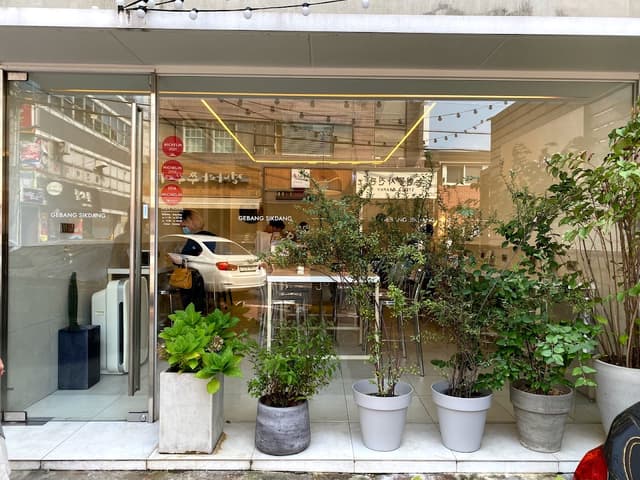
If you want a more in-depth guide on how to find local restaurants and cafes in Korea I go into more detail in my 'Korea Restaurant & Cafe Hopping Guide.' I also share my personal local cafe and restaurant recommendations from living in Korea since 2022.
Want more local cafe & restaurant recommendations?✨
If you're looking for more recommendations for local cafes and restaurants and want more tips on cafe hopping check out my guide below.
Guide Features
☞ More ways to find HIDDEN & local eateries (like a local)
✩Things I Wish I Knew Before about Cafes & Restaurants in Korea
✓Over 290 recommendation cafes & restaurants (Includes Map Links!)
☑︎ Over 30 essential Korean phrases & vocabulary
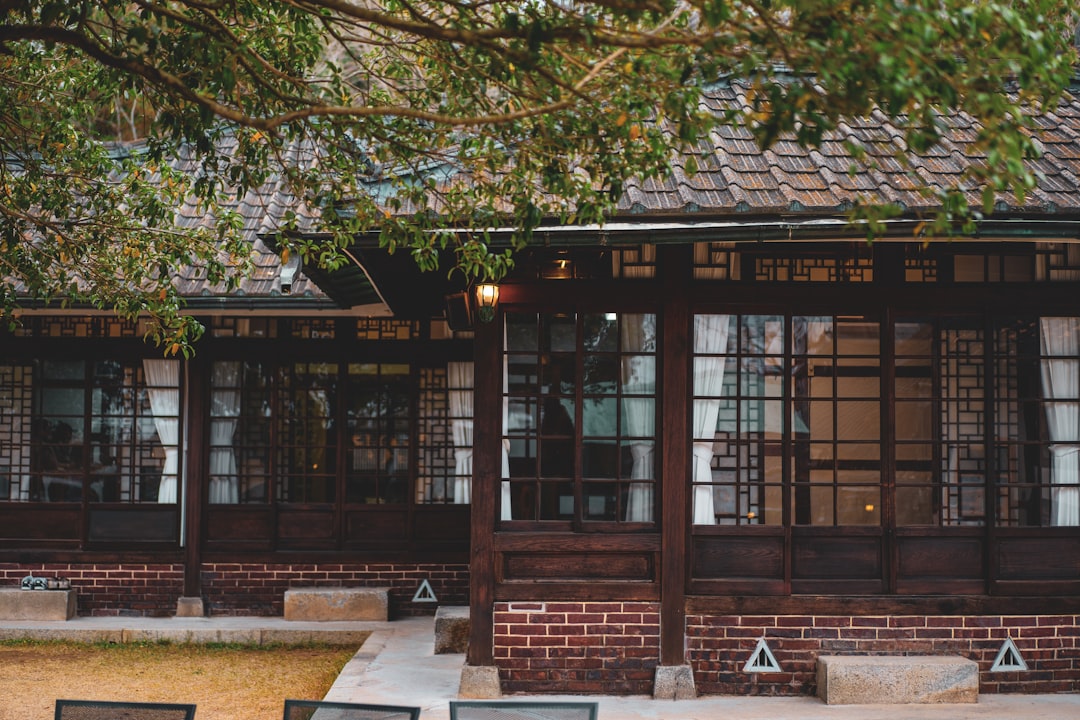
Korean Culture 🇰🇷
How are Koreans reacting to foreigners in your opinion?
I hate to generalise because I think everyone’s experience will differ. As an Asian foreigner in Korea, I’ve never felt like I was going to get scammed or discriminated against (mind you I often get mistaken as Korean). I think Koreans are getting more used to foreigners as tourism is increasing a lot. In general, I think Koreans might be mistaken as a ‘bit cold at first’, and most often it is because they are shy or intimidated to speak English. As long as you show them respect and appreciation they are likely to show the same in return.
Language Barrier 👩🏻🤝👨🏼
Is it easy to get around Korea speaking Korean?
This depends if you are planning to just visit or work here. If you’re only visiting for a trip then I don’t think it’s essential to know Korean but it will make your experience more comfortable and rewarding. You’ll definitely find navigating and ordering at restaurants more easily. I would recommend as a bare minimum to know at least the Korean alphabet (hangeul) as sometimes not all restaurants and cafes have English menus. Knowing a few basic common phrases will also go a long way in making you navigate more easily and perform daily tasks on your travels like ordering at a restaurant, shopping, etc.
TRAVEL ESSENTIAL PHRASES
Yes/ No [네/아니요.] = Ne \ Aniyo
제 이름은 (Kelly) 입니다. = Je ireumeun (Kelly)imnida = My Name is (Kelly)
(실례합니다) = Sillye hamnida = Excuse me
한국말 못 해요 = [hanguk-mal mot haeyo] = I don't speak Korean
죄송합니다. 이해 못 해요 = [Joe-song-ham-nida. ihae mot hae-yo] = I'm sorry, I don't understand.
[영어 할 줄 아세요?] = Yeongeo haljul aseyo? = Can you speak English?
안녕하세요. [an-nyeong-ha-se-yo.] = Hello.
안녕히 계세요. [an-nyeong-hi gye-se-yo.] = Good bye. (When you are the one leaving.)
감사합니다. [gam-sa-ham-ni-da.] / 고마워요. [go-ma-wo-yo.] = Thank you.*
죄송합니다. [joe-song-ham-ni-da.] / 미안해요. [mi-an-hae-yo.] = I’m sorry.*
If you want an entire guide for 'Essential Korean Phrases' for shopping, cafes, restaurants, directions, navigations, and more. Check out my 'Korea Survival Guide' there are over 100 essential phrases to help you speak like a local and help you travel in Korea.
Can you recommend Korean learning resources?
Check out these free Korean learning resources. I've used a combination of these resources at the beginning of my Korean learning journey before investing into paid resources.
Is it necessary to have a Korean phone number (Prepaid SIM Card)?
I would recommend getting a sim card as it makes it easier and more convenient for traveling like navigation and also making reservations, waiting lists, and booking appointments.
Refer to the 'Data & Connectivity' section for more information.
Would you recommend solo travel in South Korea?
It's an awesome idea! You'd be surprised at how many people come to Korea alone as a visitor, exchange students, or for work. For me, I came alone at 23 years old to work as a teacher and I've had an amazing experience. I've also had friends who came here by themselves for solo travel and they felt safe and it was relatively easy to navigate in Korea.
Based on my personal experience, I always recommend Korea as one of the best places for solo traveling as it is quite safe compared to other countries I've been to (France, London, Hong Kong, South Africa, Japan). I totally understand your fear about solo travel it's completely normal. Obviously, it's always good to be mindful of your surroundings no matter where you go. If you are nervous stick to traveling to the main cities like Seoul and Busan.
I'm also hosting a group trip to South Korea in April of 2024. You are more than welcome to join! Here's a post answering all the frequently asked questions and information about the group trip.
How long do you recommend for a trip to Korea?
This really depends on your personal circumstances and preferences. For example, what is your budget and what do you really want to see and experience in South Korea? Generally, I'd recommend around 1.5 to 2 weeks for a visit to South Korea. As a minimum, I would suggest 8 days, but this is really making you squeeze everything in a short time and I personally would feel rushed. If you're just doing two or three cities in Korea I think it is manageable you'd just have to carefully plan what you're doing each day.
If you're planning a visit to Korea make sure to read up on these 10 must-see places in Seoul, Korea.

Want more travel recommendations on places, activities, and tours for South Korea? Check out my Korea Survival Guide for a breakdown of over 20 cities to visit in Korea. I go beyond exploring tourist traps helping you explore local finds in Korea.
Where to Stay in Korea (Accommodation) 🛌
Where do you recommend staying in Seoul?
This depends on what you will be doing here and what you want to see and visit. So if you think you will spend most of your time in an area e.g. Hongdae, then it would make sense to stay in this area since you will be conveniently located there.
For tourists exploring Seoul, I would recommend staying somewhere central such as Euljiro or Myeongdong just because of how convenient it is so transit to and from (often between lines 2 and 3 which are the two major metro lines). As a general rule whenever you do end up staying in Korea always make sure that it is near public transport (subway stop or bus stop) because it will make your life much easier in getting to and from places.
Where do you recommend for a hanok stay?
If you're looking for recommendations on a traditional Korean stay experience I'd recommend looking in Seoul or Jeonju.
For hanok stay experiences in Seoul refer to this article.
If you want a more in-depth guide on where to stay in Korea in over five cities check out my 'Accommodation Guide in South Korea.' I'll also be sharing insider tips and recommendations on how to find the best accommodation deals as a budget traveler. As well as sharing personal recommendations on where I've stayed (best hanok stays, areas, linked hotels & Airbnb) across Korea from Seoul, Busan, Jeonju, and more!
Features of the Korea Accommodation Guide
🙋🏻♀️ Must Things To Know For Booking your Travel Accommodation (Save $ on your stays in Korea & overseas)
✨ Helping you avoid tourist traps & overrated spots by giving you local hidden gems.
Tips for booking accommodation ("What resources do you use to find the best accommodation for traveling?")
🛏️ Where to stay in South Korea in five cities (Recommended Areas in the Cities) ("Where is the best areas to stay in Busan/Seoul etc.?)
✨Recommendations for a Temple Stay & Hanok Stay
💵 Exclusive discount code for another guide!
...... and more!
Must Try Activities in Korea
Local Tour
Why should I do a tour?
1) If you're traveling solo it's a great way to meet like-minded travelers. I've met some amazing people from these tours that I now regularly hang out with in my free time.
2) They organise all the activities and transfers for you. If you're a bit nervous organising all the details and navigating the language barrier this is a great solution for you.
3) You'll get local inside from an expert guide!
Tours for Foodies 🍴
Eat your way around Seoul with this guided foodie walking tour. You'll get to try freshly made local dishes from dumplings, rice rolls, tteokbokki and more!
Tours for Adventurers 🪂
If you're feeling a bit adventurous and want to do some sightseeing at the same time these activities are for you.
Hiking Experience🥾
Enjoy a guided trip from Seoul on a short hike to Korea's stunning Mt Seorak National Park. You get the option to either visit the ancient Naksansa Temple or stroll through beautiful tree-lined walks on Nami Island.
Luge Racing Adventure ⛰️
Ride from the top of the mountain and get stunning views of the countryside at this Luge racing park. This activity is both for adults and kids.
Morning Seoul Tour ☀️
Get a taste of Korean heritage in this morning tour around Seoul. You'll get to discover the beautiful historic buildings with a local guide from it
Seoul Night Tour 🌃
Han River Night Cruise & Park Picnic 🧺
Immerse yourself in Seoul's nightlight at Han River Park. Have a local experience by exploring Korean games, culture and food. You'll get to discover the city's skyline and history on the night cruise and a picnic.
Busan Night Cruise 🛳️
Discover Busan at night by exploring all the best viewpoints in the city with this evening cruise.
Day Trip from Seoul
Demilitarised Zone (DMZ)
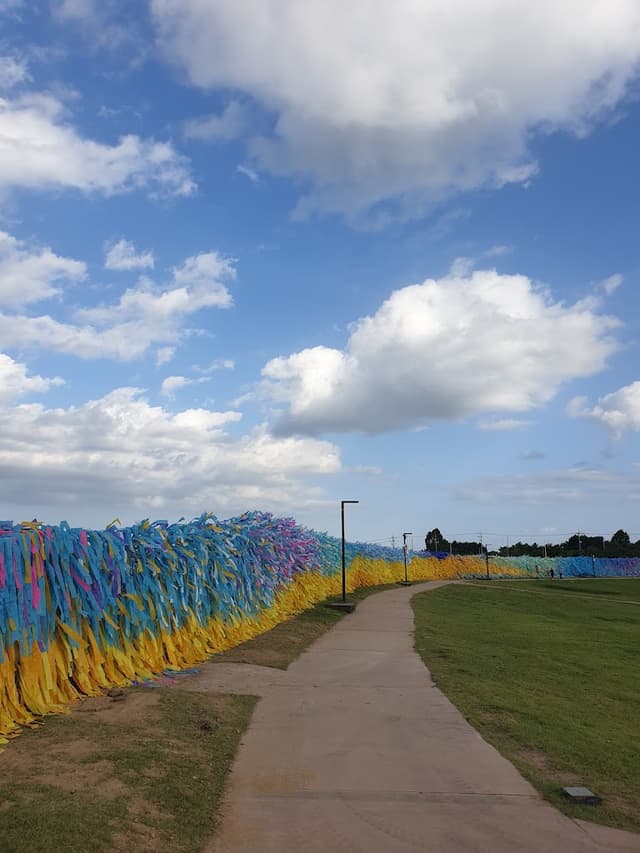
If you’re visiting Korea you’ll want to add the demilitarised zone in Korea to your travel bucket list. The easiest way to visit is through a guided DMZ tour which includes transfers and a local expert to learn about the history of the Korean War. Here are a few recommendations to choose from.
DMZ, 3rd Tunnel & Suspension Bridge
In this DMZ day trip tour from Seoul you'll be able to visit the 3rd infiltration tunnel, Dora Observatory, and suspension bridge for scenic views and learn more about Korea's war story.
Half Day or Full Day DMZ Day Trip Tour
Half Day DMZ Tour from Seoul (Peace Gondala)
Discover the history and monuments of the DMZ on a half-day tour from Seoul. You can also enjoy a Peace Gondola ride for a birds-eye view of the DMZ.
Ganghwa Island
Ganghwa Island also called Ganghwado (강화도) is Korea’s fifth largest island located a few hours away from Seoul. Ganghwa is a hidden gem away from the bustling Seoul that offers an ideal escape for those seeking to explore Korea’s rich history, captivating landscapes, and unique attractions without crowds. From ancient relics to picturesque landscales, Ganghwa offers a variety of attractions for every type of traveler.
If you’re planning a day trip visit to Gangha here is everything you need to know about visiting Ganghwa Island. From 20 must things to do in Ganghwa, how to get to Ganghwa from Seoul, and more.

Nami Island 🌳
If you’re looking to escape the bustling crowds of Seoul. Take a day trip to Nami Island for the beautiful scenery and immerse yourself in local activities including ziplining, cycling around the island, and checking out the local eateries.
It involves a bit of planning and booking multiple transfers (public transport) to get to the island from Seoul. So I recommend booking a day trip tour as they include transfers and admission onto the Island.

Nestled along the eastern coast of South Korea, Pohang emerges as a hidden gem that promises an unforgettable adventure. From pristine beaches to cultural landmarks, this city offers a plethora of activities that cater to diverse interests.
Find out these 20 things to do in Pohang.
Read the full travel guide for in-depth tips for traveling to and around Pohang.
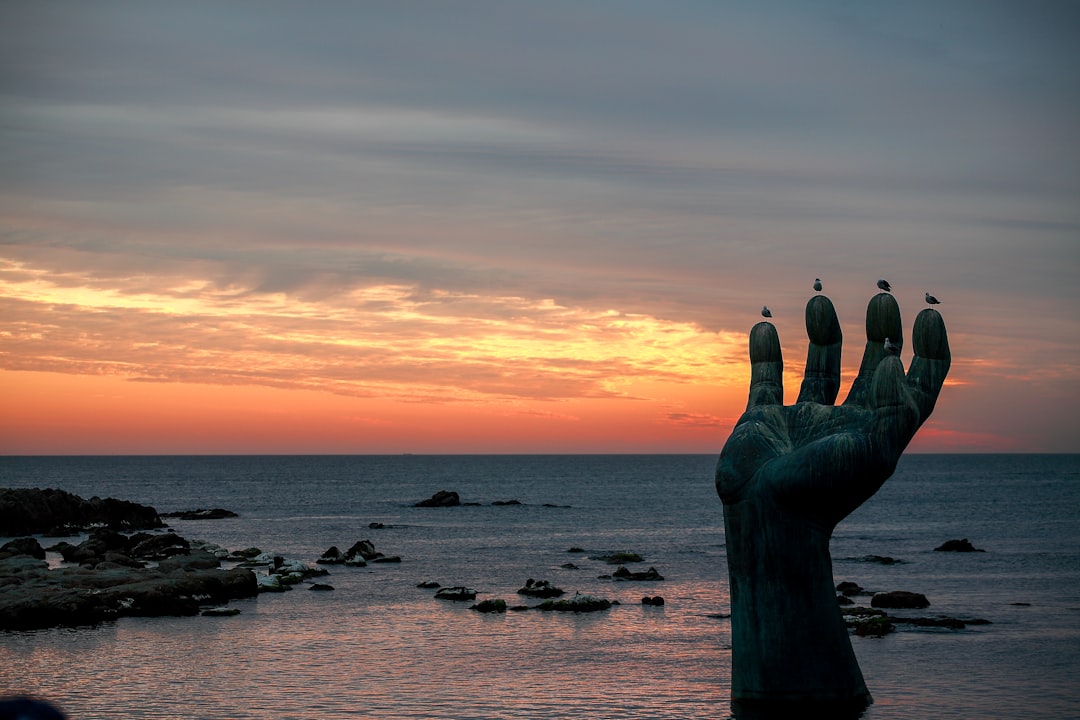
Visit a Cultural Village

Visit a Palace
If you're visiting Seoul make sure to check out at least one palace in Korea.
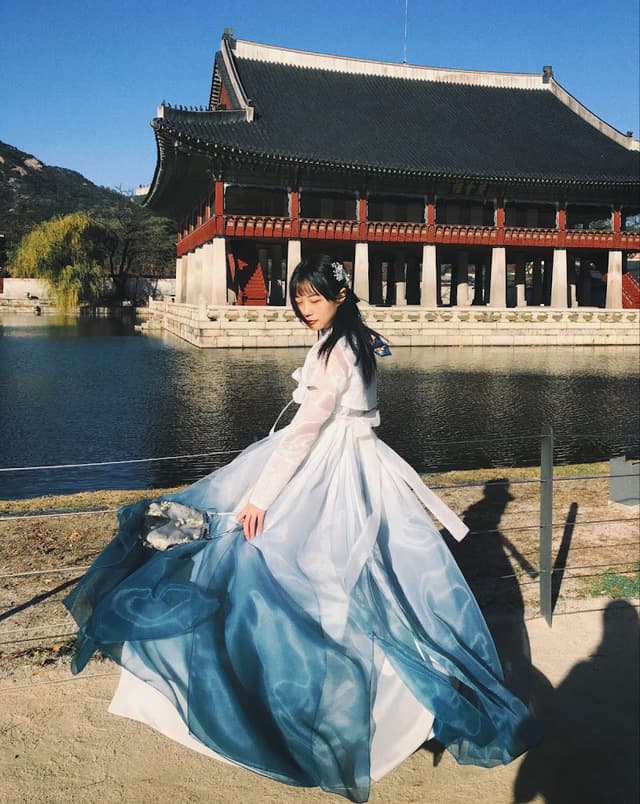
Don't forget to add these places in Seoul to your Korea itinerary!
Try a Workshop
There are so many fun workshops you can try not only for an authentic experience but also you can make your own unique personal souvenir for yourself or loved ones.
Try a Perfume Workshop
Experience a unique perfume-smelling tour and design your own fragrance at the GN Perfume Studio in Seoul.

Handmade Stamp Engraving
Take home a personal souvenir by creating your own South Korean-style hand-engraved seal. You'll get to engrave your own name or custom logo onto a personalized seal.
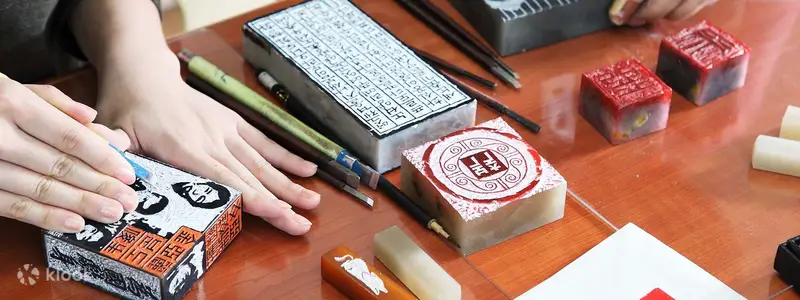
Korean Traditional Dessert Rice Class
Learn how to make traditional Korean desserts in this fun cooking class.
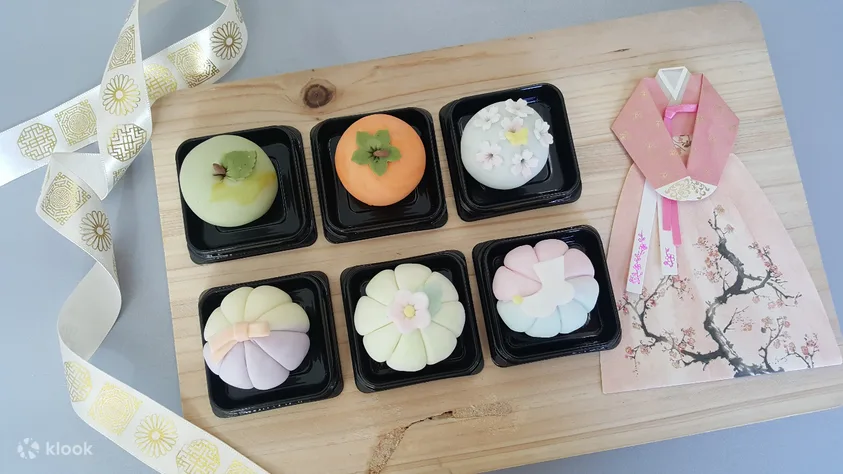
Seoul Kimchi & Culture Experience
Learn how to make delicious kimchi, instructed by professional Korean chefs with a choice of three cultural package options.
Makeup Workshop
Make your own personal lipstick in Seoul! It's the perfect souvenir for yourself or a loved one back home.
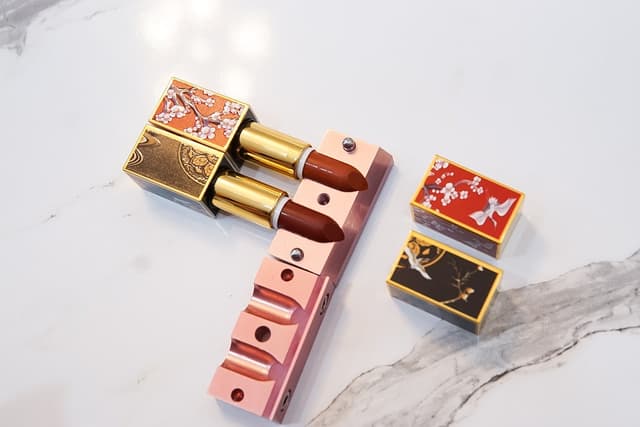
Ring Craft Workshop
Design and craft a personal ring for yourself or a loved one back home. You'll get to learn how to use raw materials to make the perfect personal gift.
Jewellery Workshop
Make your own jewelry using Korean alphabets or Hangeul and take it home as souvenirs in Euljiro Seoul.
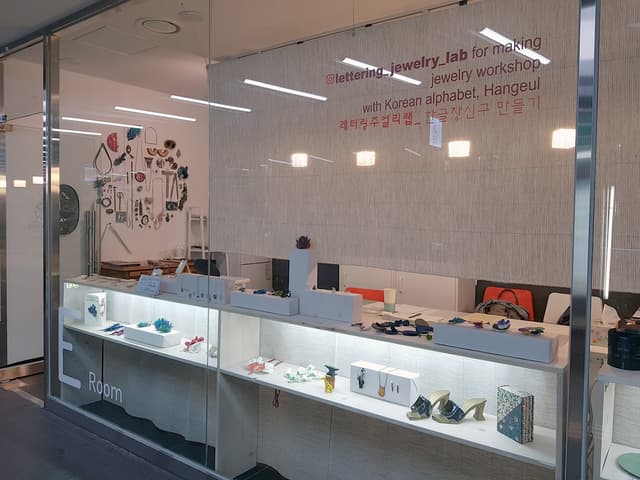
Visit a Themepark
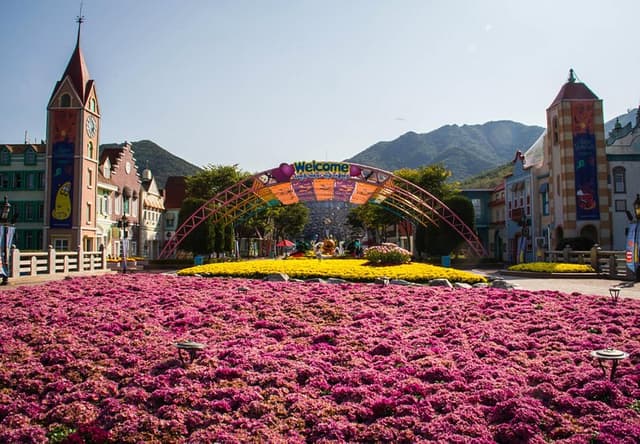
Guide to Hanbok Rentals
If you’re planning a trip to South Korea you must try this activity to immerse yourself in the Korean culture and make some memories for your trip. It’s a fun cultural experience to try with family and friends to make your trip to South Korea more memorable.
What is a hanbok?
A hanbok is a traditional piece of clothing previously worn for everyday wear. However, in more recent times it is reserved for special occasions including birthday celebrations, major holidays, and weddings.
Things to know about a hanbok
The hanbok consists of two different parts - the skirt and the shirt. In line with Korean customs, there are distinctions in costume structure in various classes in society. Each hanbok is unique with a combination of emotion, creativity, and sophistication in design and color.
Why should you wear a hanbok?
1) Free entrance to any of Seoul's five grand palaces. This includes the palaces Gyeongbokgung Palace, Changdeokgung Palace, Gyeonghuigung Palace, Deoksugung Palace, and Changgyeonggung Palace.
2) It's a great way to embrace Korean culture and to make some unique memories on your trip.
Where are the best places & tips for renting a hanbok?
I go into things I wish I knew before I rented a hanbok and the best places to rent a hanbok in Seoul and other cities.
Best Places for Hanbok Rentals
Depending on your budget and the time you have for your trip there are a variety of places for hanbok rentals in South Korea. My personal recommendation to rent a hanbok includes Seoul and Jeonju. Personally, I found the charming city of Jeonju as the quintessential place to try this cultural activity. However, if you’re short on time you can explore Seoul by heading to Gyeongbokgung Palace with its picturesque mountain views and nearby Bukchon Hanok Village. This place serves as the perfect backdrop for your photos.
As a general rule, I always recommend choosing places that are close to the attractions you’ll want to explore in the hanbok. This is to save time traveling to and from the location. Here are a few personal recommendations on where to rent a hanbok in South Korea in cities including Seoul, Jeonju, and more.

Booking a Hanbok
Did you know you can book a hanbok (a traditional Korean dress) in advance? There are a few reasons why you should book in advance.
1) Save Money
Bookings in advance are essential to save money but also to ensure you don’t miss out on securing a rental booking. If you choose to do just ‘walk in’ to a rental store you’ll have to consider if the place has English-speaking staff and if the place offers ‘walk-in’ appointments. Some rental places only accept a certain amount of bookings per day which can be common in high-traffic places in South Korea. Worst case you might have to wait a long time or you won’t be accommodated at all. So remember to book ahead of time!
2) Hanbok Selections
If you book an early morning time slot so you’ll have a wider selection of hanboks before they get rented by other customers. Think of it as ‘first comes, first served.’ You will also have more time to wear the hanbok without feeling rushed exploring and taking photos before you have to return it at the end of the day.
Hanbok Rental Recommendations
Here are a few of my recommendations for hanbok rentals in Seoul and other cities. My best advice for choosing a rental place is to decide on where you want to visit and take photos in your hanbok. Choosing a rental place near your selected attraction will make it easier to get to and from - saving you time walking to the place and you'll get more time in the hanbok!
If you're looking to rent a hanbok in Seoul check out these places. Most of the rental places are situated around the local attractions such as Gyeongbokgung Palace, Changdeok Palace and Bukhon Hanok Village.
1) Seohwa Hanbok Rental (Gyeongbokgung Palace)
Looking for a hanbok rental and photoshoot all-in-one package? Look no further. This rental shop is located near Gyeongbokgung Palace and offers hanbok rentals and photography sessions. Visitors can choose from renting a variety of hanboks (‘traditional’, ‘fusion’, or ‘premium’ from 3 to 4 hours to a full day.
2) Hanboknam (Changdeok Palace)
Select from over 500 Hanbok designs at this rental store near Changdeokgung Palace. One of Seoul’s five remaining Joseon palaces. They offer both traditional and themed hanboks to rent from 1.5 hours to a full day depending on your budget for this activity.

3) Bukchon Hanbok Rental
Choose from renting a hanbok for four hours to a full day. This rental place offers a variety of sizes and designs with hair accessories for those interested. This place is available in Seoul South Korea near Bukchon Hanok Village.
4) 한복남 프리미엄점 Hanboknam Premium Store
Try booking a premium hanbok service at the Hanboknam Premium store. They offer the latest trendy hanbok designs and have branches near Gyeongbokgung and in Jeonju. The rental services range from an hour to three hours to a full day depending on your budget.
Outside of Seoul
Looking to rent a hanbok outside of Seoul? Why not try the cities of Jeonju or Jeju Island. You'll be able to escape the usual crowds of the main city and explore places where not many tourists venture.
1) Jeju Hanbok Private Guide Tour & Photo Session
Book a private tour of Jeju inclusive of a hanbok rental and a photo session around the island. They offer packages for one individual or groups depending on your travel preferences.

2) Hanboknam Jeonju Store
Try a hanbok rental in Jeonju Hanok Village. You’ll get to try traditional Korean clothing and the option to get your hair styled in a traditional look. You can choose from a traditional or themed hanbok from 1.5 to 4 hours or a full-day rental.

Did you find this helpful? 🙋🏻♀️
I'm in the process of creating more travel guides for South Korea. Keep your eye out on my page for more releases. I'll be posting guides for cafe & restaurant hopping, travel itineraries, a Korea survival guide, and more.
Subscribe to my Thatch Page for updates on new releases.
Want to travel to Korea in 2024? 🌸🇰🇷
Want to travel to South Korea without planning anything? Come and travel to South Korea in April 2024 with me! I'm hosting a group trip and would love for you to join me. The best part? Everything is planned for you. From the accommodation, activities, local transfers, meals, and more! All you have to do is sign up and show up for the trip!
Want the FULL trip information pack about the group trip?
❗️GET ACCESS TO:
✈️ FULL trip itinerary
💬 Answers to frequently asked questions ("Can I join alone?" Why is it so expensive?" "How does flying in and flying out work?"
👀 Answers to COMMON concerns from sign-up interests ("I'm scared of traveling alone," "I'm concerned about paying the full amount," "I'm nervous about meeting new people, etc"
👇🏼DOWNLOAD the full info pack below!👇🏼
Are you a bit hesitant about solo travel? Or maybe curious about what a group trip is? Read up on why group travel is a perfect way for you to travel more in 2024. Maybe you want to travel more but your friends aren't free, or you want to visit a place that no one is interested in. Find out how group travel is a perfect opportunity for you!
💌 Let's stay connected!
Want to get access to exclusive discounts for digital products, early product releases, insider tips & recommendations?
Join my community to be notified first!
Want FREE information on my latest travels or resources? Check out my blog for the latest posts.
📱Follow my daily adventures!
Catch me on the 'gram for my almost daily life. From my travel adventures, and lifestyle content. You can also subscribe to notifications for my stories, posts, or reels where I share the latest drops for limited discounts, products, events, and group trips.
I can't wait to connect with you!
If you have any questions or issues regarding the guide feel free to contact me at [email protected].

South Korea Travel Guide
Last Updated: July 17, 2023
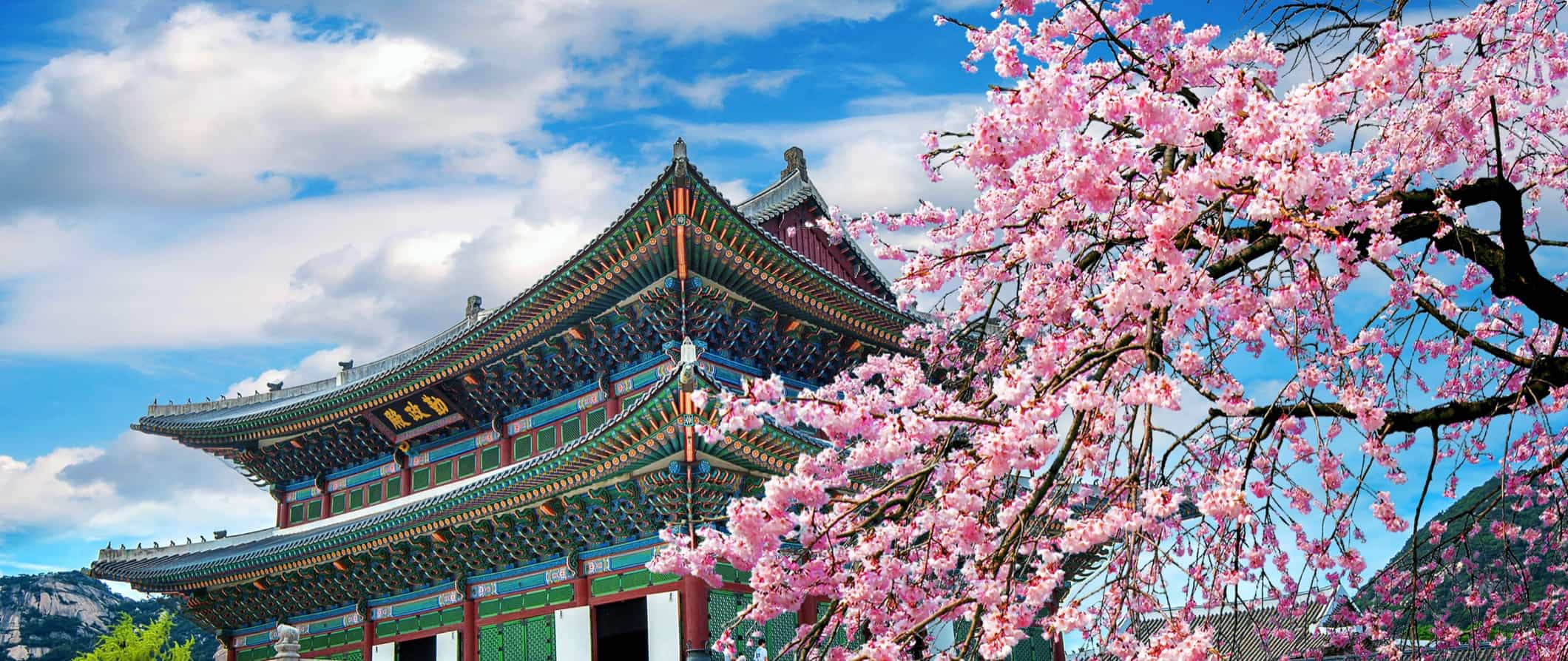
Though South Korea is small (about the size of the US state of Indiana), it punches well above its weight in terms of things to see and do. Boasting a vibrant culture, incredible history, natural beauty, delicious food, and a wild nightlife, it’s home to both major cities and untouched nature, offering something for every traveler.
Seoul, the capital city and fourth-largest metropolitan area in the world (over half the country’s population of 50 million is concentrated here), is a lively hub for food lovers and partying. But while it gets all the attention, there is much more to explore, including 22 national parks, lush Jeju Island, and the infamous Demilitarized Zone (DMZ) bordering North Korea.
Best of all, since South Korea is a manageable size, you can see a good portion of it in a limited amount of time. The transportation here is modern, clean, and efficient, so it’s easy to get around quickly.
The country is also a foodie’s paradise, with cheap street food and delicious dishes like bibimbap, kimchi, and the famed Korean barbecue.
It’s one of my favorite countries in the world and one that I think is super under the radar and often overlooked by travelers. You never see the tourist crowds found in other Asian countries.
This travel guide to South Korea can help you plan your trip, save money, and make the most of your visit.
Table of Contents
- Things to See and Do
- Typical Costs
- Suggested Budget
- Money-Saving Tips
- Where to Stay
- How to Get Around
- How to Stay Safe
- Best Places to Book Your Trip
- Related Blogs on South Korea
Top 5 Things to See and Do in South Korea
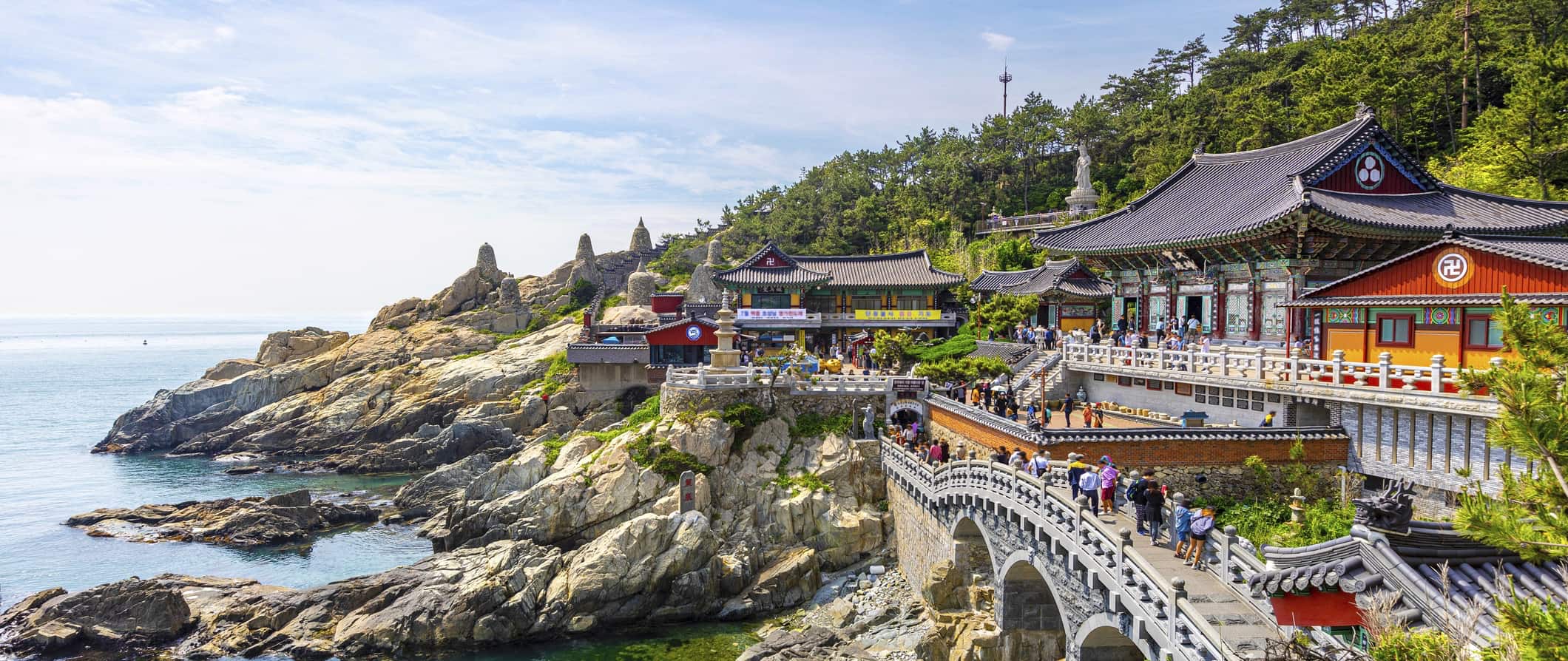
1. Explore Seoul
Korea’s capital has a little bit of everything. It’s a bustling metropolis and global technology hub, with sleek and modern neighborhoods like Gangnam and iconic sights like the Lotte World Tower, the sixth-tallest building in the world. Yet there is a lot of history here too, including many museums, palaces, and temples, among them five UNESCO World Heritage Sites. When you’re done exploring for the day, Seoul has a robust street food scene, countless trendy restaurants, and fast-paced, soju-driven nightlife. You could easily spend weeks here and never get bored.
2. Tour the DMZ
The Demilitarized Zone (DMZ) separates North and South Korea and, despite the name, is the most militarized border in the world. You can only visit the Joint Security Area (JSA), which has military personnel from both sides, on a guided tour, but it’s a unique experience and an important way to learn about this ongoing conflict (the war started in 1950 and has not officially ended). On the tour, you’ll be able to actually stand in North Korea, visit the Third Tunnel of Aggression (which North Korea dug to sneak soldiers across the border), see the Freedom Bridge, and catch glimpses of North Korea from the Unification Observatory. Guided tours of the DMZ start from 80,000 KRW.
3. Visit Jeju Island
This volcanic, semitropical island is a popular domestic vacation spot. It’s accessible via cheap daily flights from Seoul that take just one hour. Known as “the Hawaii of Korea,” it’s a natural paradise, home to the tallest mountain in Korea (Mount Hallasan), lava tubes, beautiful beaches, and countless hiking and walking trails. Other attractions include visiting mythic Jeju Stone Park, wandering the Yeomiji Botanical Gardens, and watching the haenyeo divers — women who dive without any protective equipment to gather underwater treasures like shellfish and seaweed, which they then sell on the beaches. You can visit the Jeju Haenyeo Museum as well to learn more about this cultural practice that dates back centuries.
4. Sing karaoke
Known as noraebang , this is a cultural phenomenon and something worth experiencing at least once while visiting Korea. While the karaoke machine was originally invented in Japan, Koreans have adopted the pastime and made it their own. Here, you rent out a private room with a group of friends (instead of singing in a public bar, as is often the case in Western countries). Pricing is determined by the hour, with rates varying wildly depending on the number of people, time of day, day of the week, and whether snacks and drinks are included. Average group karaoke rates range from 5,000 to 15,000 KRW.
5. Step back in time at a hanok village
Other things to see and do in south korea, 1. visit changdeokgung palace.
One of the Joseon dynasty’s Five Grand Palaces, this 15th-century complex in Seoul was built in harmony with the natural environment at the foot of Bugaksan Mountain. Changdeokgung, or “Palace of Prospering Virtue,” was the main royal residence for 13 kings over the course of three centuries. The complex sprawls over 110 acres, 60% of which is taken up by the beautiful Huwon Secret Garden, home to over a hundred species of trees, flowers, and other plants (some of the trees here are over 300 years old!). The main draw is wandering around the exterior, with its restored buildings and gates, though you can also go inside Injeongjeon Hall, the palace’s throne room. Admission to the complex is 3,000 KRW; the Secret Garden is an additional 5,000 KRW. There are guided tours in English as well.
2. Explore Busan
Korea’s second-largest city is located just two hours from Seoul on the KTX high-speed bullet train. A coastal city, Busan boasts great beaches, such as Haeundae Beach, with its miles of sand, and Gwangalli Beach, known for its sunsets. Gamcheon Culture Village, the “mural village of Korea,” is a hillside neighborhood rich in street art and covered in murals, and nearly all the houses are painted bright colors. It’s a great place to wander around for a few hours, popping into the unique shops, cafés, and restaurants.
3. See the National Museum of Korea
If you visit only one museum in Korea, make it this one. Located in Seoul, it covers all aspects of Korean culture, art, and history, from prehistory to the early modern era. It also contains many national treasures and artifacts that have been designated as having special importance and value in Korean culture and history. Some of the most important ones include the sixth-century inscribed Bukhansan Monument, detailing military expansions; sixth-century gilt-bronze Buddhist statues; and the 10-story Gyeongcheonsa Pagoda, which dates to the 14th century. Don’t miss the exterior gardens, which feature indigenous plants, reflecting pools, and traditional Korean sculptures and lanterns. Admission to the main exhibitions and children’s museum is free.
4. Take a food tour
As a foodie, learning about a culture through its food is one of my favorite things to do while traveling. Korea has an incredible variety of amazing dishes to try, as well as a bustling (and delicious) street food scene. Taking a food tour with an experienced guide is one of the best ways to gain a deeper understanding of Korean cuisine. O’ngo Food offers a variety of tours in Seoul, Busan, Jeonju, and Jeju, with prices starting from 70,000 KRW per person.
5. Visit Gyeongbokgung Palace
Originally built in the 14th century by the kings of the Joseon dynasty, this palace in Seoul served as the seat of the government for two hundred years until it was destroyed by a fire and abandoned for centuries. Since the 19th century (and still today), it has been undergoing renovations to restore the complex to its former glory. It is considered the most stunning of all five royal palaces in Seoul, featuring grand gates, open courtyards, and terracotta-topped buildings set against the backdrop of Mount Bugak. In addition to wandering through the complex, you can also go into the many administrative halls and residential chambers set up to resemble the palace’s heyday. You can watch the changing-of-the-guard ceremony as well, every day except Monday. The National Palace Museum and the National Folk Museum are also located in the complex. Admission is 3,000 KRW.
6. See the cherry blossoms
While cherry blossoms are often associated with Japan, festivities surrounding the blooms are incredibly popular in Korea as well. Here, the season runs from late March to late April, with many festivals throughout the country. Just be prepared for crowds at the more popular ones, like the Yeouido Cherry Blossom Festival in Seoul.
7. Try taekwondo
Korean’s native martial art, taekwondo, is characterized by high kicks and punches and, like all such disciplines, emphasizes mental training. An Olympic event since 2000, taekwondo has only grown in popularity in recent years and is a point of pride in Korean culture. Kang’s Global Taekwondo in Seoul offers classes to adults and foreigners that cost around 43,000 KRW for one hour.
8. Learn to cook classic Korean foods
If you’d like to take your knowledge of Korean food one step further, take a cooking class, where you’ll learn to prepare classics like bibimbap, kimchi, bulgogi, and Korean pancakes. Hello K Cooking in Seoul offers a class where you’ll learn how to cook three main dishes and one stew — recipes and skills that you can bring home with you. Classes are 107,000 KRW.
9. Go hiking
Korea is an incredibly mountainous country, so hiking is a favorite pastime for locals. Be sure to immerse yourself in nature while visiting this lush land. There are even hiking spots near the bigger cities if you don’t have enough time or don’t want to venture too far afield. Bukhansan National Park, just outside Seoul, is a popular place to go hiking, offering panoramic views over the capital (expect crowds due to its proximity to the city, though). Yet with 22 national parks spread across the country, there are plenty of opportunities to escape the crowds (including lots of guided hikes if you don’t want to organize one yourself). For a multiday hike, the Jirisan Ridge Trek in Jirisan National Park is one of the most famous — a four-day walk from mountain shelter to mountain shelter.
10. Wander around Seoul Olympic Park
In 1988, Seoul hosted the Summer Olympics, which was only the second time the summer games had been held in Asia (the first was in Tokyo in 1964). Today, you can visit the massive park where the games were staged, and while Olympic Park does have many sports facilities, there’s much more to explore here as well. The park is divided into four sections, focusing on the arts, history, nature, and sports. In the arts section, you’ll find the SOMA Museum of Art and a park with over 200 sculptures, while in the history section, you can see the third-century defensive Mongchontoseong Earthen Fortifications, excavated dugout huts and storage pits left in the state in which they were uncovered. You can easily spend an entire afternoon here. Admission to the park is free.
11. Discover Jirisan National Park
Located in the southern part of the country (Namwon is the nearest city), this park is named after Jirisan (Mt. Jiri for short), the tallest mountain on mainland Korea. As it’s South Korea’s first national park (as well as its largest), hiking trails and cultural sites abound. You can visit seven major Buddhist temples and see several of Korea’s national treasures of ancient carved stonework from the seventh to the tenth centuries. One of the most important sites here is Samseonggung, or Three Sages Palace, a mountainside shrine dedicated to the legendary founders of Korea. Admission to the park is 1,600 KRW.
South Korea Travel Costs
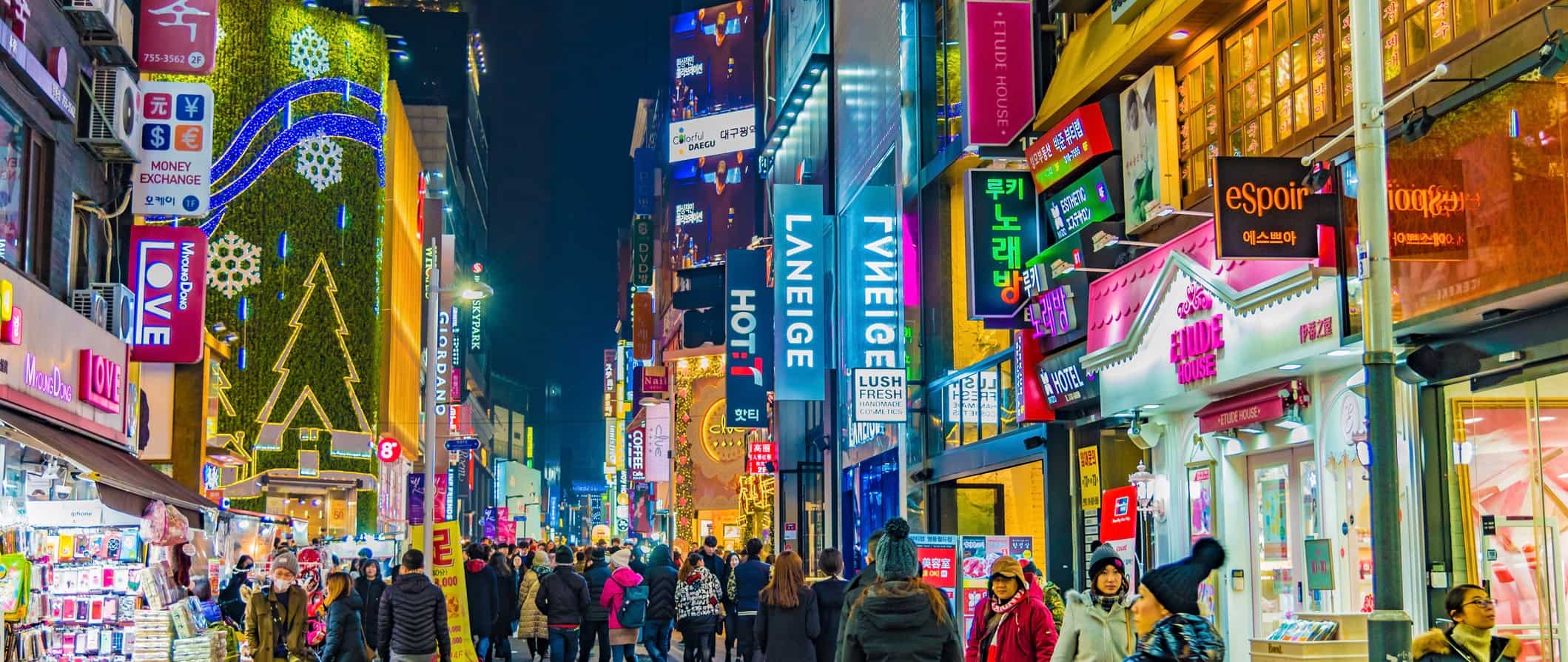
Cheap hotel rooms start at 28,000 KRW for a room that sleeps one, while a double room generally costs at least 40,000 KRW. Expect basic amenities like Wi-Fi, a TV, air conditioning, and an electric teapot. Breakfast is usually not included at budget hotels.
Airbnb is available around the country, with private rooms starting at 25,000-30,000 KRW. For an entire home or apartment, expect to pay at least 50,000-70,000 KRW per night.
While wild camping is illegal in Korea, there are plenty of campgrounds should you want to pitch a tent. Expect to pay 7,000-20,000 KRW for a plot with access to bathroom and shower facilities, and usually even Wi-Fi.
Food – Korean cuisine has developed its own traditions and flavors over the centuries, with a unique emphasis on using uncooked, fermented, and pickled vegetables. Traditional Korean meals are often composed of a variety of side dishes, eaten with short-grain rice. A meal isn’t considered complete unless there’s kimchi on the table.
Common dishes include bulgogi (marinated, grilled beef), samgye-tang (chicken and ginseng soup), bibimbap (a mixed rice bowl), chap chae (a glass noodle dish), and many other noodle and rice dishes. Popular street foods include hotteok (a sweet, filled pancake), tteokbokki (spicy cylindrical rice cakes), and bungeo-ppang (a fish-shaped pastry filled with red bean paste).
Dining out in South Korea is relatively inexpensive. A meal at a casual restaurant serving traditional Korean food is around 9,000-15,000 KRW, while a three-course meal at a mid-range restaurant is around 25,000-30,000 KRW. Expect higher prices in larger cities.
Western food is more expensive. Expect to pay at least 20,000 KRW for a pasta dish at an Italian restaurant.
In terms of fast food, a combo meal (think McDonald’s) is around 7,000 KRW, while a burger is around 4,500 KRW. A typical Korean street food dish is 1,500-3,000 KRW.
A pint of beer is 4,000-5,000 KRW, a glass of wine is 6,000 KRW and up, and a cocktail is 7,000 KRW and up. A latte or cappuccino is 5,000 KRW.
If you cook your own food, expect to pay 50,000-70,000 KRW per week for basic staples like rice, pasta, vegetables, and some meat. Shopping at local markets is the best way to get great fresh produce for cheap.
Backpacking South Korea: Suggested Budgets
On a backpacking budget of 75,000 KRW per day, you can stay in a hostel dorm, cook all your meals, use public transportation and intercity buses to get around, skip the alcohol, and do mostly free activities like walking tours and hiking.
On a mid-range budget of 135,000 KRW per day, you can stay in a private Airbnb or cheap hotel, eat out for most meals at casual restaurants, enjoy a few drinks, take the occasional taxi as well as trains between cities, and do more paid activities like museum visits and food tours.
On a “luxury” budget of 255,000 KRW or more per day, you can stay in a nicer hotel or entire Airbnb apartment, eat out pretty much anywhere you want, drink at the bar, get a high-speed rail pass, and do as many guided tours and activities as you want. This is just the ground floor for luxury, though. The sky is the limit!
You can use the chart below to get an idea of how much you need to budget daily. Keep in mind these are daily averages — some days you’ll spend more, some days less (you might spend less every day). We just want to give you a general idea of how to make your budget. Prices are in KRW.
South Korea Travel Guide: Money-Saving Tips
I find South Korea to be one of the best value countries out there. It’s a really affordable place to visit. Accommodation can add up but food and drinks are generally cheap. Here are some ways to save money when you travel around South Korea:
- Visit the free attractions – With countless museums, shrines, temples, historic neighborhoods, and parks, Korea is filled with opportunities to become immersed in its culture. Many of the nation’s museums and cultural attractions are free, so don’t pass them up!
- Purchase a KORAIL Pass – If you want to travel by train, getting a rail pass is the most economical way to do so. You’ll get unlimited train travel for the time period you choose (2-5-day increments). Prices start at 121,000 KRW.
- Get a transit pass – Most major cities in Korea offer a day pass for public transit, which means great savings if you plan to hop around using buses and subways. Seoul’s day pass costs 15,000 KRW, though the longer you stay, the more you’ll save (a seven-day pass is 64,500 KRW).
- Buy a city pass – If you plan on visiting a lot of attractions, buy a city pass . Seoul and Busan both offer ones that include admission to popular sights, a transit pass, and discounts to restaurants and other attractions. A one-day pass starts at 33,000 KRW.
- Eat from the convenience stores – Convenience stores in Korea offer not only snacks and drinks but prepared boxed meals and cheap alcohol. If you’re on a tight budget, shop in those.
- Take the bus – While the trains are fun, the cheapest way to get around Korea is by bus. They take longer but are much cheaper, so if you have the time, opt for long-distance buses. Just show up at the bus station to reserve your tickets in advance, as most websites and apps are in Korean.
- Stay with a local – Couchsurfing lets you stay with a local for free, cutting your accommodation costs drastically. You’ll get to spend time with someone who can share their tips and advice in exchange for your own travel stories and culture. You can also use the app to meet people for activities (coffee, museum visits, etc.) if you don’t feel comfortable staying with a stranger.
- Drink like the locals – Soju, the national alcohol of Korea, is incredibly cheap, as is domestic beer. Just be careful to not let it sneak up on you — both monetarily and physically. Korea’s drinking culture is infamous!
- Stay in capsule hotels – If you don’t want to Couchsurf or stay in hostels but still want to save money, capsule or pod hotels are great options. These offer just what you need to sleep (a small, basic pod) yet can be surprisingly comfy and much more affordable than a traditional hotel. Prices start as low as 45,000 KRW per night.
- Bring a water bottle – The tap water here is safe to drink, so bring a reusable water bottle to save money and reduce your plastic use. LifeStraw is my go-to brand, as its bottles have built-in filters to ensure that your water is always clean and safe.
Where to Stay in South Korea
South Korea has plenty of budget-friendly hostels and guesthouses. Here are some of my recommended places to stay when you visit:
- Time Travelers Relax Guesthouse (Seoul)
- Zzzip Guesthouse (Seoul)
- Time Travelers party Hostel (Seoul)
- INSIDE Busan (Busan)
- Jeju Hiking Inn (Jeju)
- Backpacker’s Home (Jeju)
How to Get Around South Korea
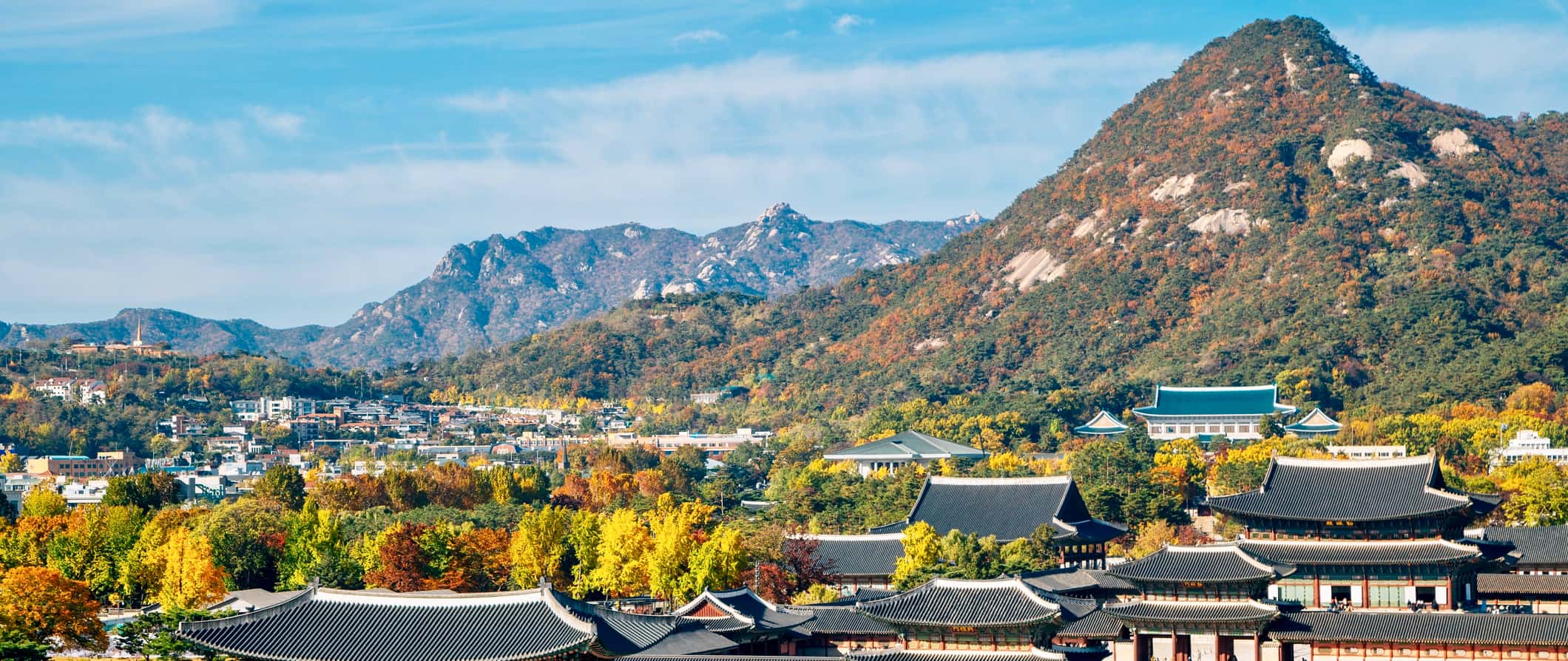
Bus – Taking a long-distance bus is the cheapest and most popular way to get around the country. There are two types: express (which makes few to no stops) and intercity (which travels between smaller destinations and makes more stops).
Your best bet for reserving tickets in advance is to go directly to the bus terminal, as most bus websites and booking apps are in Korean and only accept Korean credit or debit cards.
Pricing depends on what class ticket you choose: standard, luxury, or premium. The four-hour bus ride from Seoul to Busan costs around 36,000 KRW for a standard ticket, Incheon to Busan takes just over four hours and costs 38,000 KRW, and Seoul to Daegu is 29,000 KRW and takes just under four hours.
Train – South Korea has a robust train system that can take you all over the country. Korean Train Express (KTX) is the country’s bullet train, regularly running at speeds up to 305 kilometers (190 miles) per hour. However, these only go between major cities, have limited schedules, and are more expensive, so KTX may not always be the most convenient choice.
KORAIL (the national railway service) operates slower-speed, intercity trains that offer a wider range of schedules and destination choices. You can also get the unlimited KORAIL Pass, which is offered exclusively to international tourists. A two-day adult pass is 121,000 KRW; a five-day adult pass is 210,000 KRW.
As a comparison of the two train types: the journey from Seoul to Busan on a KRX train costs around 90,000 KRW and takes 2.5 hours, while on a regular intercity train, it takes 5.5 hours and costs 47,500 KRW.
The further out you book, the cheaper KTX train prices get, while intercity prices stay about the same. You can book up to a year in advance.
Flying – South Korea is so small that flying around the country doesn’t really make sense. Trains can get you anywhere pretty quickly. However, if you’re very pressed for time and have cash to burn, there are a few budget airlines offering domestic flights between major cities. Most are around one hour long.
The flight from Seoul to Busan is around 30,500 KRW, Seoul to Jeju is 55,000 KRW, and Busan to Jeju is 22,000 KRW. However, you can find flights even cheaper when you book further in advance.
Low-cost airlines in South Korea include the following:
Car rental – Renting a car isn’t incredibly cheap in South Korea. However, it is one of the best ways to explore all the natural wonders that the country has to offer, many of which are inaccessible by public transportation. Expect to pay around 50,000-55,000 KRW per day on a multiday rental. Drivers need to be at least 21 years old.
When to Go to South Korea
Generally, the best times to visit South Korea are March-May and September-November. During these periods, the weather is mild, with temperatures of 10-24°C (50-75°F); prices for accommodation and transportation are lower; and there are fewer crowds.
In the spring, the cherry blossoms are in bloom all over the country, while the fall brings the beautiful colors of the changing leaves. Also, if you plan on doing a lot of hiking, the fall is the best time to visit.
The summer starts with monsoon season, from June through mid-July, and the rest of the summer is hot and humid in the cities (though it cools down in the mountains and along the coasts). Prices for accommodation are also very high during this time.
Winters in South Korea get very cold, with temperatures dipping as low as -6°C (21°F), so unless you plan on skiing, visiting from December through February might not be the best option (though the temples and landscapes look beautiful covered in snow).
How to Stay Safe in South Korea
South Korea is an incredibly safe place to backpack and travel around. Petty crime is rare here, though it never hurts to be cautious on public transportation and around popular tourist landmarks. Always keep your wallet and valuables secure and out of reach, just in case. Violent crime is even more rare.
Solo female travelers should feel safe here. However, the standard safety precautions apply as always. For specific tips, consult one of the many solo female travel blogs on the web.
While scams are super rare in South Korea, to avoid getting ripped off, you can check out this list of common travel scams to avoid .
When hiking, always bring water and sunscreen. Be sure to check the weather before you depart and dress accordingly.
Earthquakes occur regularly in the region, so it’s best to be prepared and download the Emergency Ready app, which the Korean government developed to provide information in English to foreign residents and tourists. It has all kinds of advice and tips for natural disasters, shows you where nearby emergency shelters are, and sends out warnings and notifications should a disaster occur.
If you do experience an emergency, dial 112 for assistance.
Always trust your gut instinct. Make copies of your personal documents, including your passport and ID, and forward your itinerary along to loved ones so they’ll know where you are.
South Korea Travel Guide: The Best Booking Resources
These are my favorite companies to use when I travel. They consistently have the best deals, offer world-class customer service and great value, and overall, are better than their competitors. They are the companies I use the most and are always the starting point in my search for travel deals.
- Skyscanner – Skyscanner is my favorite flight search engine. They search small websites and budget airlines that larger search sites tend to miss. They are hands down the number one place to start.
- Hostelworld – This is the best hostel accommodation site out there with the largest inventory, best search interface, and widest availability.
- Booking.com – The best all around booking site that constantly provides the cheapest and lowest rates. They have the widest selection of budget accommodation. In all my tests, they’ve always had the cheapest rates out of all the booking websites.
- Get Your Guide – Get Your Guide is a huge online marketplace for tours and excursions. They have tons of tour options available in cities all around the world, including everything from cooking classes, walking tours, street art lessons, and more!
- SafetyWing – Safety Wing offers convenient and affordable plans tailored to digital nomads and long-term travelers. They have cheap monthly plans, great customer service, and an easy-to-use claims process that makes it perfect for those on the road.
- LifeStraw – My go-to company for reusable water bottles with built-in filters so you can ensure your drinking water is always clean and safe.
- Unbound Merino – They make lightweight, durable, easy-to-clean travel clothing.
- Top Travel Credit Cards – Points are the best way to cut down travel expenses. Here’s my favorite point earning credit cards so you can get free travel!
South Korea Travel Guide: Related Articles
Want more info? Check out all the articles I’ve written on Asia travel and continue planning your trip:
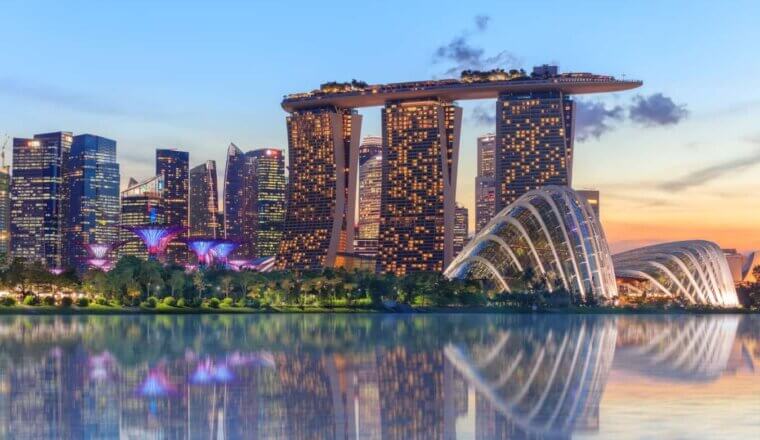
The 5 Best Hotels in Singapore
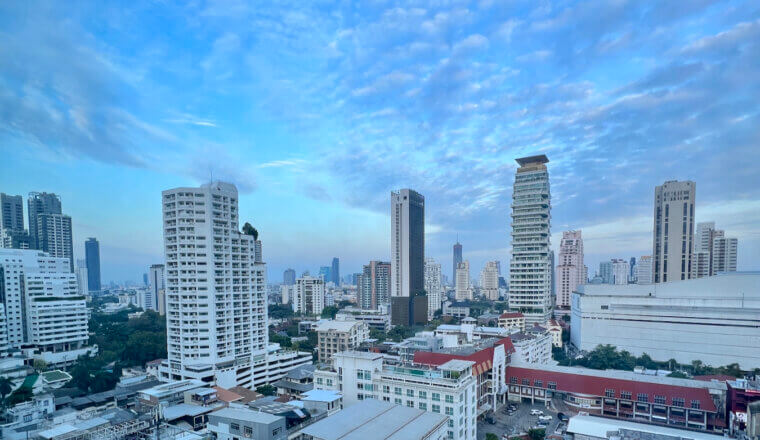
The 7 Best Hotels in Bangkok

The 4 Best Hostels in Singapore
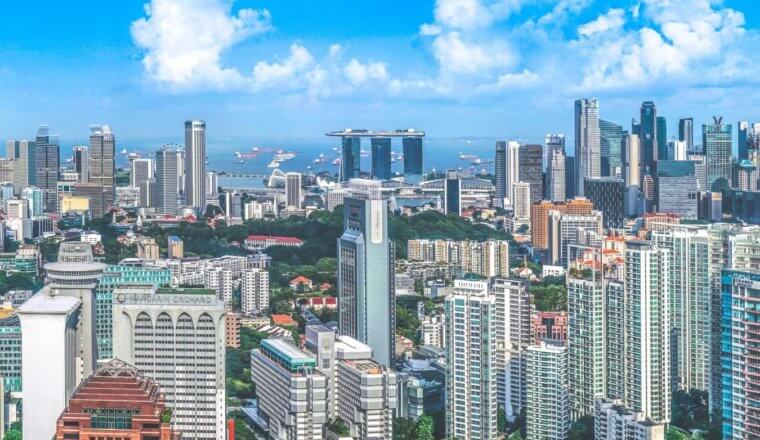
Where to Stay in Singapore: The Best Neighborhoods for Your Visit
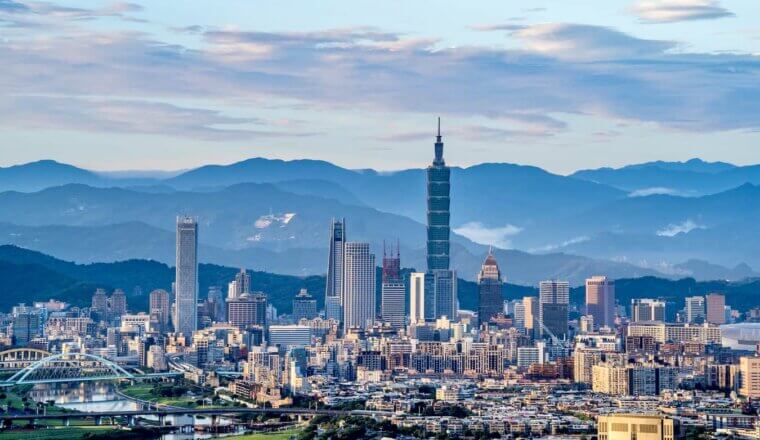
The 13 Best Things to See and Do in Taipei
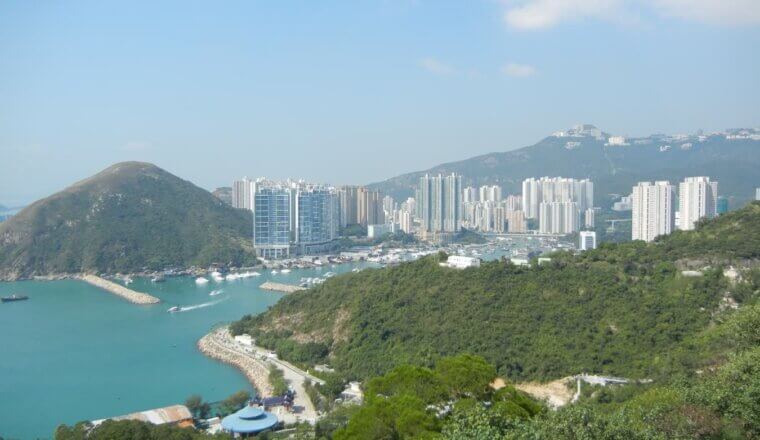
The 23 Best Things to Do in Hong Kong
Get your free travel starter kit.
Enter your email and get planning cheatsheets including a step by step checklist, packing list, tips cheat sheet, and more so you can plan like a pro!

- Where To Stay
- Transportation
- Booking Resources
- Related Blogs
Living and traveling in Korea

An Epic Travel Guide To Seoul, Korea For The First Timer
Seoul, Korea is huge and has gained a ton of attention in the past decade for not only a beautiful culture but also the Hallyu wave that has swept over the world. When you begin to plan your trip to the capital city of Korea it can seem overwhelming and you may not know where to begin.
While I’m known for promoting the off the beaten path spots in and around Seoul and promoting new hot spots to check out, I wanted to create an essential guide for the first time visitor to this busy and fun capital of Korea.
Having lived here since 2006 when I first came as an English teacher, you can be assured, this is THE guide to read before you get here. Whether or not it’s your first time to Korea though, read through it and make sure you’ve seen everything there is to see. From Seoul’s quirky cafes to the best spots to get gorgeous views. it’s all here. Make your time in Seoul, Korea the best it can be!

This is a massive travel guide with all of the information you need for any trip to Seoul, Korea. Because it’s so long, definitely feel free to skip around. Here is what you’ll find in this post:
- What To do To Prepare For Your Trip To Seoul
- Is It Safe To Travel In South Korea?
What To Know About Money & ATMs In Seoul
- Which Is The Best Area To Stay In Seoul?
- What Is The Best Time To Visit Korea?
General Travel Tips For Korea
- A Korean palace
- A traditional market
- Rent a Hanbok
- Find the hotspots
- Visit the Han River
- Get a good view
- Visit lots and lots of cafes
- Visit a museum
- Visit a spa
- Visit an amusement park
- See the DMZ
- Check out these notable spots in between
To Join A Tour Or Not To Join A Tour
- Where To Get Out Of Seoul For A Day Trip
Want To Get Off The Beaten Path In & Around Seoul?
Places to take trips from seoul.
(This post contains affiliate links, which means I receive a certain percentage of a sale if you purchase after clicking at no cost to you. Thank you for your support.)
Need help with an itinerary? Elevate your travel experience with our downloadable Seoul Itinerary Pack. combine, and conquer the city’s wonders, one unforgettable day at a time.
What To Do To Prepare For Your Trip To Seoul
Are you traveling to Seoul soon? Here are some things to help you prepare for the trip:
Buy Your Plane Ticket: You can get some great deals on flights to Seoul, Korea. If you haven’t tried, check Skyscanner.com for the best rates.

Can I use the Wise Card In Korea? How To Send Money To Korea
Wise Travel Card: Whether you’re looking to travel to Korea for the first time or you’re moving to Korea and want to be able to use your money from home in Korea easily, you should look into the Wise travel card when it comes to converting currencies and getting away from card fees and bad exchange rates. The first time I came to Korea I had difficulty getting my debit card/Mastercard to work. Don’t be like me, come prepared. You can learn more about the Wise travel card in my review .
Get a Visa/Korea Electronic Travel Authorization: The process for coming into Korea has changed during Covid and now everyone must apply for a K-ETA before arrival. The K-ETA is for visa-free foreign visitors and while you’re visa free, they still want to know you’re coming and where you’re headed. Here is a guide to fill out the information for the K-ETA . Go to the K-ETA website to apply. You should find out if you’ve received approval within 24 hours, but usually faster.

Study Korean: 90 Day Languages has a great course on Korean and offers a lot of help if you’re interested in preparing before you come. A little goes a long way here and it actually only takes about an hour to learn how to read Hangul… no joke! You can also check out this guide to learning Korean online and through apps I put together to get some more Korean learning options.

Plan Your Airport Transfer: There are numerous ways to transfer from Incheon International Airport outside of the city into the city of Seoul from the subway/train and bus to taxis. To be honest, we almost always opt for the private transfer. It’s fast and easy and we don’t have to worry about dragging our bags this way and that and up and down escalators. TaDa is a great company that provides transfers as well as rides within the city. Book your transfer in advance to make the trip smooth and easy.
Get Good Hard Case Luggage: Packing all of the essentials is good only if they get to the other side with you. Make sure to have good luggage to get you and your belongings all the way. Roam Luggage has awesome customizable bags that will go the distance and look super cool on the way. We highly recommend using hard case luggage for any international flight.

International Driver’s License: To be honest, I wouldn’t recommend driving in Seoul if it’s your first time to this massive city. BUT, if you plan to and will rent a car while you’re here, then remember to bring your International Driver’s License. I highly recommend renting a car if you’ll be headed to Jeju Island or anywhere aside from Seoul and Busan because it’s much easier to get around that way in those cases.

Where To Buy A TMoney Card For Korea

How To Get A T-Money Card For Kids in Korea

The Discover Seoul Pass: Travel On A Budget In Seoul

The Seoul City Tour Bus Guide: What To See & Do When You Hop On Hop Off
T-Money Card/Discover Seoul Pass/Hop On & Hop Off Bus: To get around using the Seoul Subway System or buses or other public transportation options, you’ll need to get a T-Money card . This card allows you to put money on it and scan it at the turnstiles in subways and when you’re getting on and off buses and even works in taxis.
HOWEVER, if you’ll be doing a lot of touristy things and visiting the touristy sites, then you might be better off getting the Discover Seoul Pass . This pass comes with a variety of perks like access to Hanbok rentals, palaces, view points and other major attractions AND it also works as a T-Money card. On top of that, you get a free ride on the AREX and Airport bus to/from Incheon International Airport.
SO, if you’ll be touristy, grab the Discover Seoul Pass to get out and about plus this also acts as a T-Money card. But do know how to use it. Here is a guide and itineraries for using the Discover Seoul Pass to the max. There’s also a great Hop On/ Hop Off Tour Bus option here in Seoul you can use too.

Korea Rail Pass: If you want to get out of Seoul and plan to use the train more than twice, then the Korea Rail Pass is the economical/budget choice you want to have on hand. You can get back and forth between the popular Nami Island nearby the city or go as far as Andong or even Busan . The train line is the limits. Grab the card here and just head to the station with your confirmation and it’s as easy as that.
Wifi Eggs/Sim Cards: While there is great WiFi in many places around Seoul and Korea, nothing beats having your own Wifi Egg so there’s no lag in connection. You can pre-reserve Sim Cards via Klook so they’re ready and waiting for you when you fly into either Incheon International Airport or into Busan International Airport. You can alco get an eSIM with eSIM Korea which is even’t easier. Here’s a complete guide to the best Korean SIM cards for your trip to Korea.

Top 15 Apps to Download When You Come To Korea
Download Some Useful Apps: The Seoul subway system is super efficient and you can ride it for two hours or more, not pay an arm and a leg, and see a ton. Make sure to download the subway app to know where to go the easiest. The app even tells you which subway car to stand on when.
On the note of apps, do note that Google Maps is horrible when it comes to Korea and will be more difficulty than it’s worth. Another map app that you’ll find useful is Kakao Maps which can be used in both Korean and English. Kakao also has Kakao Taxi which is the best option should you want to get around using local taxis.

Pack The Right Clothes: Seoul has four distinct seasons. The summer is hot hot hot and the winter is cold cold cold! Be prepared. Check out this post for what to pack when you come to Korea . You’ll want to have everything from a fine dust mask to good walking shoes for the best trip you can have in Korea.

Recommended Travel Adapters For Korea
Don’t Forget A Travel Adapter: For some reason travel adapters are easily forgotten among the tourists I’ve met. Remember that not every place has the same plugs/outlets. Make sure you know which travel adapter to bring to Korea so your trip isn’t bumpy at the beginning as you race around trying to charge your devices.
Get Your TEFL: This is less for travelers than it is for the soon to be teachers. There are a lot of teaching positions available in Korea so to make yourself stand out, definitely make sure you get your TEFL before you come… though you can also get it online once you come too!
Is it safe to travel in South Korea?
Generally, yes, it is very safe in Korea. That said, many foreigners come here assuming that because there is no gun violence or drug issues in Korea it’s MUCH safer than it really is. While you will likely not have any problems while you’re here, certainly don’t put yourself in situations you wouldn’t in your home country.
While I don’t think there is a ton of scamming to look out for, I do want to say you should be wary of cults in Korea that will see tourists coming a mile away. Most vendors aren’t jacking up prices just because you speak a different language, but I would watch out for people that spike drinks. Just be mindful as you should be at all times.

Is it safe to drink tap water in South Korea?
After coming here and seeing how everyone consistently opts for bottled water over tap water, you might be surprised to learn that tap water is indeed potable in Korea and actually tested more than most other places for safety. Yes, you can drink the tap water in Korea, but read this article to find out why Koreans tend to drink bottled water.

The unit of currency is the Korean Won (KRW)
Your cards will likely work, but they will also likely not work. That is to say that for every ATM you find that your card works at, it won’t work at two others and this can be frustrating. While Koreans walk around swiping everywhere now and probably have NO cash in their wallets, as a traveler, you’ll want to have some.
Make sure to let your bank/creditor know that you’ll be traveling to Korea before you come and you will be able to find an ATM that works…. at some point. But bring at least W300,000 = $300.00 in cash to get by at the beginning just in case it takes you longer to find cash.
You could even bring more just to be safe. Most places downtown will also accept your card, but if you’re looking to get into some hole in the wall spots, you’ll probably find spots that won’t take your card. Just be prepared. This is one of the biggest worries for tourists here so better to be safe rather than sorry.
If you want to exchange when you get here, the best spot to do it is in Myeongdong if you have cash and can’t find an ATM that works.

Tipping culture in Korea : Tipping is not a common part of Korean culture. Yes, you can try to tip at restaurants, to taxi drivers, or to your tour guides, but it isn’t expected, though may be accepted. Learn more in this guide to tipping in Korea so you can understand.
Is Korea cheap?
It can be, but it also may not be. For instance, a mistake a lot of new residents and tourists make is heading to expensive bars for drinks or trendy restaurants. Eating out can definitely rack up the bills, however, eating at traditional markets or in small mom and pop shops will definitely make it cheaper.
There are numerous ways to make a trip to Korea more budget friendly like taking advantage of the 40 free walking tours in Seoul. There is even hiking gear available to borrow for free from the city. Find out more ways to save money on a trip to Korea and check out this list of completely free things to do in Seoul to help you if you’re on a budget.
Which is the best area to stay in Seoul?
There are some areas that are definitely better for tourists to stay in if you’re hoping to see the top sites, have the fun, and get in the cultural experiences. Seoul is massive and you definitely don’t want to be in an area that requires a lot of transportation to get to the major sites. I’ve written a complete guide to where to stay in Seoul here. Check it out. More concisely, here are the top areas to stay in and a bit of info about each:

Myeongdong: Myeongdong is a very central location and a great spot to stay for tourists, especially tourists that want to shop. It’s a big shopping district but that also means all of the restaurants and cafes have Korean AND English menus among other language options. Things open up with the tourists and stay open late with them too.
Transportation on the train, subway, and buses is easy from here and a lot of the tourists sites are within 20 to 30 minutes. I wrote a guide to the best places to stay in Myeongdong , but you can also go directly to Booking.com to find Myeongdong hotels here . If you want to check out the Airbnb options, look here.

Bukchon Hanok Village: If you’re looking for a more traditional Hanok house to stay in, then you’ll want to head to this area. The Bukchon Hanok Village is between the main palaces and near a lot of the cultural experiences. This is also a highly touristed area so restaurants will be able to help you and you’ll see some of the gorgeous older neighborhoods in the city.
You can find Bukchon Hanok Village stays here . If you’re an Airbnb person, then you can check here for some amazing Airbnbs in the Bukchon Hanok Village .

Hongdae: If you’re looking for a younger, hipper area with live music and an arts scene, this is the neighborhood for you. It doesn’t wake up as early as the above areas because it stays awake so late. There are a ton of restaurants and cafes here and it’s an area that best serves the night owls and the people that want to see busking, find a cool pub or bar, or see some live music.
I have culled a list of the best places to stay in Hongdae right here. But, if you want to get right to it, you can find Hongdae hotels here . For Airbnbs in the Hongdae area, look here .

Itaewon: Itaewon is the foreign area of Seoul and where a ton of foreign locals reside so there is GOOD foreign food if you’re looking for that foreign comfort food. I don’t usually recommend this area to tourists because I think the majority of sites you’ll want to see are more north, BUT if you’ll want to split your time between the Hanok villages and palaces and Gangnam which is south of the river, then Itaewon is your best bet so you have the same transportation time from here to there and everywhere.
You can find Itaewon hotels here . There are some great Airbnbs in the Itaewon area, too.

Dongdaemun: Another shopping district, Dongdaemun is very close to the touristy north and also has easy transportation to the south. This is a vibrant neighborhood with a lot of hidden gems and a lot fashionable people. There are quite a few subway line options, buses, and it’s easy to get taxis here too. You can find Dongdaemun hotels here . You can check here if you’re more of an Airbnb person.
What is the best time to visit Korea?
There are four distinct seasons in Korea… well maybe five if you include monsoon season. Since I live here and have gone through every season, I can honestly say that they are all amazing for one reason or another.

Summer (June ~ Mid-September): Summer can be horribly humid. If you aren’t used to humidity, then you definitely won’t want to stay in Seoul the entire time you’re here. Most Seoulites head to the coast whenever they can or up into the mountains to soak in the rivers and lakes because that is just the best way to cool off. There are beautiful beaches on the eastern, southern, and western coasts of Korea so make sure to have time to visit one.
Once you get here, you’ll definitely want to make the time because summer is hot hot hot! Find out all there is to know in this complete guide to summer in Korea for more information.
Autumn (Mid-September ~ November): Autumn is definitely one of the most beautiful times to visit Korea when the fall foliage bursts into an array of colors across the peninsula and the scents of cinnamony hoddeok waft down the streets. Not only do the leaves change, but there are flower fields that burst into bloom as well. You can find some gorgeous flowers in the World Cup Parks as well as at Nari Park .
The only problem with autumn is that it’s difficult to pin down. You can make plans, but the foliage can burst at any time. October is a sure bet and early November for flowers and foliage at the same time. Find out all there is to know in this complete guide to fall in Korea for more information.
Winter (December ~ February): Winter is not easy in Seoul. It can be beautiful if it snows and I know a lot of tourists headed here in the winter are hoping for that winter wonderland they may have seen in Korean dramas. Honestly though, if you definitely want to see snow, make plans to head out of Seoul to the mountains where you can ski or snowboard or just visit a resort with a ton of snow. There are some great options for getting out of the city to see snow if that’s what you’re looking for.
Otherwise, if you’re staying in Seoul this winter, just plan to wear a long parka and jump inside as often as possible. It is freezing especially in January and February. Find out all there is to know in this complete guide to winter in Korea for more information.
Spring (March ~ May): Spring is a gorgeous time to visit… again if it’s planned right. People often come looking for the cherry blossoms and that’s just so difficult to pinpoint early in the year. They’re often blooming on my birthday in mid April, but this year it was still soooo cold and no blooms that early, so it’s hard to say.
However, that said, there are lots of flowers to see around Seoul whether it be cherry blossoms, tulips, or daisies, so just be ready to look for some other bloomers if flowers is what you seek. Also, make sure to bring jackets and cover ups because it can still be quite chilly in the spring. Find out all there is to know in this complete guide to spring in Korea for more information.

A Guide To Spring In Korea: Cherry Blossoms and More

A Guide to Summer in Korea: Get Ready For Fun

A Guide to Fall In Korea: Foliage and More

A Guide To Winter In Korea: Snow and Ice and Everything Nice
- Tipping is not required or expected in South Korea.
- Water from the tap is potable, safe to drink.
- You won’t find large glasses of water at restaurants but you can find water machines so grab a water bottle to carry along with you.
The Top Things You Must See & Do In Seoul
1. a korean palace.
There are five palaces in the city of Seoul with the largest and most popular being Gyeongbokgung Palace . Gyeongbokgung Palace is beautiful and very much worth the visit. This is THE palace that a first-timer to Korea should see but it does get crowded during high tourist seasons so here’s what you should know about the other palaces nearby just in case.
A lot of tourists rent Hanboks and visit the palaces. Did you know you actually get free entry if you’re wearing a Hanbok? Keep reading to find the best places to go to rent a Hanbok in downtown Seoul.

The nearby Changdeokgung Palace and Secret Garden require a tour reservation and is known for having gorgeous views in every season. Changgyeonggung Palace is just around the corner from Changdeokgung Palace and actually connects in the back corner and yet most people never even see this one.
If you want a palace to yourself with a beautiful pond and a gorgeous greenhouse built during the Japanese colonization, don’t miss it and then you can walk through the back gate into Changdeokgung Palace. Kind of a two for one experience and a unique one at that.

Deoksugung Palace is one that’s rather well known because it’s easy to find near City Hall and they have a changing of the guard ceremony which is great fun to watch. This palace is unique in that there are numerous architectural styles on the grounds as well as an art museum inside one of the buildings in the grounds. This palace is much smaller than the others and easy to see quickly if you don’t have much time in your schedule.
Gyeonghuigung Palace is the smallest and least popular of the palaces, which doesn’t mean it shouldn’t be visited, so do look at the info for it.

Though that is the five that are well known, there is also a royal residence that is downtown that you could easily walk to and is very different from the others in that it’s unpainted and often used for photos by the locals. The royal residence is called Unhyeonggung Royal Residence. This beautiful spot is great for photos.
2. A traditional market
There are traditional markets all around Seoul and in just about every district. Some are more popular than others, but what’s for sure is that traditional markets are fun to visit and always have delicious food to eat.

Gwangjang Market: This is my FAVORITE spot to take visitors and get good authentic eats in the city of Seoul. It is hustling and busy and there are good eats to be had from every vendor there.
If you want to see an awesome traditional market, the oldest traditional market, in Seoul, then go here and check out my guide t o Gwangjang Market if you want to know what to eat. This market was also featured in a Netflix series as well so if you’re a foodie, do not miss it.

Tongin Market: Tongin Market is another traditional market that does it just a bit differently. This market which is just west of Gyeongbokgung Palace , a neighborhood not often visited by tourists but more well known by locals, does a cool thing with old traditional coins and food.
This is a great option if you aren’t sure what you like yet and want to try a little of a lot of different things. Here is some information on how to use the coins at Tongin Market and what you can get.

Noryangjin Fish Market: If you want to see the largest fish market in Seoul, then Noryangjin Fish Market is the one for you. While it is by no means the ONLY fish market in the city, it is the most popular for tourists to visit.
If you want to see the real action, you’ll have to wake up before sunrise to see the sale, but if you want to some good eats, definitely go later so you can pick out your own fish and then eat it in the market. There is both an old and a new part of Noryangjin Market , so make sure you know where you’re headed.

3. Rent a Hanbok
Renting a Hanbok is one of the most memorable and unique experiences you can have in Seoul. On top of it being a great way to learn more about the culture, it’s also a lot more budget friendly than you might realize and you can even get into traditional sites for FREE when you’re wearing a Hanbok. Learn more about where to rent a Hanbok in Seoul and everything else you need to know about it.
4. Find the hotspots
Bukchon Hanok Village: One of the must see neighborhoods in the city of Seoul, the Bukchon Hanok Village is popular for a reason. The residential neighborhood is home to traditional Korean Hanok houses lined up all in a row. They are beautiful and there are a ton of intimate Hanok cafes and traditional experiences.
This is one of those areas that you’ve seen pictures of again and again but will want to visit on your own. Check out this guide to Bukchon Hanok Village to learn more about the area, where to go, and what to eat. Or, check out this Bukchon Itinerary .

Insadong District: Near Bukchon Hanok Village and Gyeongbokgung Palace, this is a popular district for traditional tea houses and Buddhist restaurants. If you want to prepare for the traditional tea houses, check out this guide to traditional Korean tea options because there are so so many!
This is also THE district to head to if you’re looking to purchase Korean souvenirs to take home to friends and family. If you want to learn more about the area, check out this guide to Insadong that I put together.
Gangnam: The district that became popular around the world when Psy’s song “Gangnam Style” took over the airwaves, this district is known for a bit of luxury, lots of cosmetic surgery, and some great eats too.
If you’re interested in seeing what there is to see in the area, then check out this guide to Gangnam to see it all from amazing street art to museums and more. Oh, and definitely make sure you see the Banpo Bridge Moonlight Rainbow Show .

Hongdae: Full of live music, artistic fun, and plenty of pubs, restaurants, and fun cafes to check out . Check out this guide to Hongdae for all of the best things to do there.
The area has grown and expanded and now when people saying they’re going to Hongdae, they might very well mean they’re headed to Yeontral Park (a play on Central Park) in Yeonnam-dong or they’re headed to the up and coming district of Mangwon-dong . There are buskers and groups of K-pop dancers that make the entire area very vibrant and fun.
Myeongdong Shopping District: Myeongdong is THE spot to go if you’re looking to get your shopping on while you’re in Seoul and is one of the best districts to try a ton of amazing street food options.
With all of the major international and local brands as well as a TON of K-beauty shops, you can get everything on your list in this area. Find out more in this guide to Myeongdong with some fun things to do in the area.
5. See a show
Nanta: This is the most popular and longest running theater show in Seoul. The show is a hilarious kitchen-based performance with a talented group of performers who have a mix of traditional folk pieces as well as modern skits.
Don’t worry if you can’t understand Korean, this performance is non-verbal and fun fun fun. Get your Nanta tickets through Klook to get an awesome discount.
The Painters: A new concept art performance that combines colorful live drawings with cutting-edge media art has been remodeled and reopened. Actors resembling idols, numbering from 4 to 8, express world-famous paintings such as Michelangelo’s ‘Creation of Heaven,’ Vincent Van Gohee’s ‘Self-Portrait,’ and Gustav Klimt’s ‘Kiss’ with splendid choreography and live drawings.
Their super luxurious stereoscopic images and live performances create a a new impression of painting. G et your tickets to see The Painters online with Klook for the discount.

6. Visit the Han River
The Han River cuts through the center of the city so at some point, you’ll definitely see it either when you’re crossing a bridge or from your tall hotel, but you should definitely take some time to go and visit one of the Han riverside parks. They are gorgeous and there is definitely going to be one near wherever you’re staying. Some of them have beautiful art installations while others are where you can jump on a Eland Hangang River cruise .
There are some great experiences to be had at the river. Check out this complete guide to all of the Han River parks to see which one will be near you. Some have outdoor swimming pools, one even has a beautiful infinity pool that ends at the river and it is super budget friendly. Some have bike rental kiosks, kayaks, sail boats and more.
7. Get a good view

Seoul Sky Tower: Seoul Sky Observatory is the third highest observatory in the world and features the highest glass deck in the world. The views are absolutely stunning and there are multiple floors for viewing from the 117th to the 120th floor. This is just next to Lotte World as well if you want to combine it with some fun and views! Seoul Sky Tower is a bit out of the way compared to a lot of the tourist sites but worth the subway ride.
And, to top it off, if you want to stay in the tallest hotel in Seoul and get the most beautiful views right when you wake up in the morning, then look no further than Signiel Hotel which is right in this tower too!

N Seoul Tower: While Seoul Sky is the newest dazzling spot in the city to get views from, Namsan Tower, also called N Seoul Tower , is older, more central, and a bit more romantic. Take a cable car up to the tower and then sit beneath a beautiful pagoda until your time to head up to the top. This tour is a major highlight in the city and is easy to combine with any bit of the itinerary in central Seoul. It’s an iconic spot that is definitely one of the top three must visit locations in the city.

Other Spots For Views: The two spots above are definitely the most popular for views, but they are not the only places to get views though they are the most iconic. If you want some more ideas though, here are more great spots in Seoul to get amazing views that also happen to be super budget friendly. These are definitely spots that will surprise you and even some that locals don’t know about.

8. Visit lots and lots of cafes
It honestly amazes me how many cafes there are and how interesting they all are. Koreans go all out with aesthetics and creating Instagrammable cafes and you can really find them all over but there are a few neighborhoods that you can literally hop from fun and quirky cafe to beautiful cafe and back again. How many coffees can you possibly drink in one day? Don’t miss the cafes in Mangwon-dong . If you want to know what some of the trendiest cafes are, check out this guide to the awesome greenhouse cafes that have been popping up over the past couple of years.
9. Visit a museum
The Korean War Memorial: There are some really amazing museums in Korea and what’s even better is that they’re budget friendly if not free. The Korean War Memorial is really interesting especially if you’re interested in learning about the Korean War and the numerous other wars in Korean history.
There are also often docents who actually fought in the Korean War available to show you around and offer stories and information. If you have children, it’s also great because there are historic planes and other relics outside that kids can climb up to and through to check out. You can learn more about the museum here .

The National Museum Of Korea: Another great museum that has both free and paid exhibitions, is the National Museum of Korea which also has a substantial park and pond with relics beautiful in all seasons. This is a museum more focused on the historical artifacts of Korea.
This is also a great option to have during monsoon season. Learn more about the National Museum of Korea here. FYI, you can also visit the National Hangeul Museum which is just in front of this one as well.
Seodaemun Prison History Museum: The Seodaemun Prison History Museum is a former prison that housed martyrs during the Japanese colonization of Korea and is now a museum dedicated to tell the stories about the people that were once housed there.
Again, this is a very impactful museum especially if you are interested in the tumultuous history in Korea. Here is more information about the Seodaemun Prison History Museum.

The War & Women’s Human Rights Museum: A much smaller but no less impactful museum in Seoul is the War and Women’s Human Rights Museum which is dedicated to tell the story about the comfort women. The issue of sexual slavery during WWII is still highly contested by Japan but certainly proven by enough groups at this point.
The Korean comfort women are still fighting to be heard. Go visit this museum to learn more about what they went through and the fight they continue to have today.
The Museum of Modern & Contemporary Art (MMCA): If you’re more interested in the arts, then don’t miss the Museum of Modern & Contemporary Art which is just east of Gyeongbokgung Palace so it’s easy to add to any itinerary in downtown Seoul. This museum uses varying architectural styles and hosts some gorgeous exhibitions. To check out the hours and learn more about the Museum of Modern & Contemporary Art, check out this guide .

Leeum Samsung Museum: The Leeum Samsung Museum is both architecturally stunning and always has some amazing exhibitions to check out. It’s in the easy to visit area of Hannam-dong and is one of my favorite art museums in the city. There are quite a few to choose from, but this is one that should be on your list if you like art museums and architecture.
This is probably a museum that is off the beaten path for most first-travelers but might just be up your alley if you like art and architecture. Here’s more information about Leeum Samsung Museum here .
Seoul Museum of Craft Art: SeMoCA is the first national museum in Seoul created to showcase Korean crafts. The museum is made up of seven buildings so you need to weave in and out and around much like some of the embroidery products you’ll see inside.
Not only is the museum amazing, the children’s museum is just wonderful and offers so many free experiences for kids. Learn more in this guide to the Seoul Museum of Craft Art.

10. Visit a Spa
There are some great options if you want the Korean spa experience. If you don’t want to get all the way nude but want to experience at least a Korean facial , you can do that too! Here are a couple great spas to check out in Seoul if you want the full experience complete with a Korean Italy towel exfoliating scrub.
Yeo Yong Guk Korean Traditional Medicine Spa: Want something more traditional? Visit this spa which is one of the 25 must visit wellness attractions in Korea as designated by the Korea Tourism Organization. After a quick physical analysis, the staff will provide a customized spa package using natural medicinal plants, pressure point, and massage. It’s a truly unique spa experience here in Seoul .
Hana Mud Spa: If you want a more local experience, check out this Korean bath house. The spa is a bit extra with their mud masks straight from the Boryeong mud that’s rich in minerals, but other than that, it’s a pretty standard spa for women only. Prepare to bare and enjoy the experience. If you want to know more about a Korean bath house and what to do inside, here’s a step by step guide to the Korean bath house culture.

11. Visit an amusement park
Lotte World: Lotte World is the most popular theme park in Seoul and is easy to get to right in the city. Get the Magic Pass to skip the lines and enjoy the rides. The rides to check out are the Conquistador, World Monorail, French Revolution, VR Space, and the Flume Ride. There’s fun, adventure, and more. Take a day and enjoy!
Everland: If you’ve got a bit more time, visit Everland, outside of the city of Seoul, but hop on the shuttle bus and you can get there. It is one of the world’s largest theme parks and features a ton of rides and experiences to be had. Make sure to get your tickets online before you go to get the discount that is available.

12. See the DMZ
While this isn’t technically IN Seoul, most tours to the DMZ start from Seoul . If you don’t know it yet, you’re technically visiting a country that is at war. Have I ever been scared living here? No. Let’s just get that question out the way.
Should you visit the DMZ? If you want to have a glimpse of North Korea and visit the most heavily guarded limit line in the world? Then definitely yes. There is a lot to be learned and some interesting spots to check out.

You can only go INTO the DMZ with a tour. You can get pretty close without one, but you need to be on a government approved tour if you want to go in. Most tours will take you to the DMZ area in Paju where you will first make a stop in the Nuri Peace Park and then head into to see one of the tunnels that the North Koreans dug to try and sneak into South Korea. If you want to go it on your own and try to get in, there is one option.

You can go in to see Camp Greaves which was formerly an American base which was given back to the Korean people and is now a museum featuring art and history information. Another option if you want to go it on your own a bit, head up to the Cheorwon DMZ area where you can enter with an approved taxi. No matter what, you can’t just wander in though so if you want to make it easy on yourself, sign up for a tour early as they do fill up. Here are some good options to choose from:
- Panmunjom & DMZ Tour: Visit the Unification Bridge and Panmunjom along with Imjingak/Nuri Peace Park and the 3rd Tunnel on this full day tour. Join this tour here.
- Imjingak Transfer Service: If you just want to get back and forth to Imjingak/ Nuri Peace Park area where you can get on the bus to Camp Greaves, or just enjoy the unification village, then look into this transfer service which will take you back and forth easily.
13. Check out these notable spots in between

Seoul Botanic Park: Seoul Botanic Park is one of the newest and beautiful parks in Seoul. There is a gorgeously huge greenhouse and if it’s winter, it is warm warm warm inside. If it’s summer, head inside, but then check out the substantial park that surrounds.
This is in an up and coming area of Seoul and it’s super easy to get to right out of the subway station. To learn more about this greenhouse and park, check out this complete post on the Seoul Botanic Park.

Cheonggyecheon Stream: The Cheonggyecheon Stream is another iconic spot in central Seoul. This stream was actually covered over in the modernization of the city after the war but during construction some years later was rediscovered and the high way built atop it was removed.
Not only did it make for a beautiful green space in central Seoul, but it helped in lowering the temperature downtown and birds and fish returned. Now, there are events like the Lantern Festival held here throughout the year. Walk along the stream from Gwanghwamun Square down to Gwangjang Market and even all the way down to Dongdaemun Design Plaza.

Dongdaemun Design Plaza (DDP): The Dongdaemun Design Plaza was immediately popular upon being built and opened to the public. Now the host of the Seoul Fashion Week as well as numerous other exhibitions and events, this eye catching structure designed by Zaha Hadid was the most Instagrammed location in Korea in 2015.
You’ll have to walk up, down, inside, and outside to really understand what is going on. Want to see some more architectural wonders in Seoul? Check out this list of really interesting architectural spots in Seoul .

Ihwa Mural Village: Ihwa Mural Village is a fun neighborhood in central Seoul near the palaces that provide a great spot to take a walk and area to learn about local communities. The neighbors didn’t ASK for their neighborhood to be turned into an attraction though, so it’s important to know the rules before you go.
Here’s more information on the street murals to see there and how to find it. See the murals and you can walk along a section of the Seoul Fortress Wall for great views out over the city as well.

Seoullo Walkway: In central Seoul just outside of Seoul Station, is a beautiful walkway that connects the downtown neighborhoods for pedestrians so that they never have to wait for a traffic light.
The walkway used to be an overpass but was renovated into a fun spot to take a walk with outdoor installations, trampolines for kids, tons of plants and greenery and there are often events held on the walkway. If you’re headed to the train station for any reason, this is an easy addition onto the day that doesn’t take too long to enjoy. Here is more info about Seoullo and what you can do there.

Oil Tank Culture Park: I personally like to check out unique spots that show how a city is growing and adapting. The Oil Tank Culture Park is just that. There are six massive oil drums that have been converted through a series of conservation measures to now be a public space.
The drums have been opened up so visitors can use them with one housing a cafe, another a performance space, and more. If you want to see some awesome eco-friendly innovation, this is a must visit. Learn more about the Oil Tank Culture Park here.
In general, it’s easy to get around and you’ll be able to see what you see, but if you really want to learn about a place, know what’s in the food you’re about to eat, and understand Korean culture and history, I’d highly recommend joining a tour or two to get some insight. The other reason to join a tour or at least book tickets for shows, entrance fees, etc, is because online is almost always cheaper.
Koreans use companies online always and that’s because tickets can be 10%-50% cheaper than when you just walk up. Don’t get left out of the discounts. Book what you can in advance. If it’s your first time in Seoul, then find a few tours, maybe one focused on culture, one on food, and one on adventure to join while you’re here.
Here are some ideas I’d recommend:
- History of Joseon Dynasty Tour: Spend the day visiting one of the royal palaces and witnessing a beautiful changing of the guard ceremony. Stop into the Jogyesa Buddhist temple and ginseng center while learning about history and architecture and culture and then end the day in one of the traditional folk villages. It’s an all encompassing tour to see traditional spots and learn a ton about how Seoul was started and built. Check out the tour here on Klook .
- Cooking classes in Seoul : There are a number of cooking classes in Seoul that I think are great not only to try some great food, but to learn about Korea’s culinary history, tradition, and culture and you can ask questions about dining etiquette in Korea and more.
Want help with your itinerary? I have a lot of experience building the perfect itineraries for travelers to Seoul. I’ve created 15 interchangeable daily itineraries for Seoul, Korea that cover the popular spots you must see, some districts that aren’t so touristy but offer great fun, and more.
Where To Get Out Of Seoul For a Day Trip
Daytrips are awesome and there are so many places you can get to if you’ve got a free day on your itinerary. Here are a few ideas, but if you want more, check out my list of “ Best Daytrips to take from Seoul “. There are 25 spots to see and enjoy and I’ll know there is something you’ll want to do.

Nami Island: This is by far one of the most popular day trip options and for good reason. It’s gorgeous. While it’s popular with K-drama fans, I can say, as someone who has NOT seen any drama that was filmed there, that it’s not just a fan that would appreciate this place. There are art installations, restaurants, cafes, and plenty of nature to see.
I’ve visited in the autumn and summer and would definitely go back in the winter and spring too. It’s an easy option for a day trip and can be combined with some other great spots in the area. Read this guide to Nami Island if its on your list.

The DMZ: At just 60km from Seoul, it’s easy enough to visit the DMZ, but only if you book a tour in advance. Tours do sell out so if you’re at all interested in visiting the border between North and South Korea, you’ll want to plan this ahead of time. The Demilitarized Zone is a 4 kilometer wide buffer zone between North Korea and South Korea.
There are various options from Seoul with the most popular being out to Nuri Peace Park in Paju and into the DMZ. If you do get out there and want to do something really special, visit Camp Greaves, an abandoned military base that’s been converted into an art experience. If you want to visit a spot that’s more off the beaten path but just a bit more involved, check out the trip to the Cheorwon DMZ .

Heyri Art Village: This is one of my favorite spots to take my daughter to, but it’s not just for kids, it is for everyone. There are chic art galleries and museums as well as artistic experiences for children to partake in. There are SO many museums and galleries to check out that you could stay an entire weekend and still not see everything.
We’ve gone and gone again and there’s always something new to do. If you want to know how to get there, and have some ideas on what to do, here is a guide to Heyri Art Village.

Anyang Art Park: The Anyang Art Park is an awesome natural area with art installations and exhibitions throughout the year. There are restaurants and cafes and it’s a great spot to check out if you want to get out into nature and take a walk.
The installations are super fun to find and require a bit of a walk up into a nearby mountain… but not to worry, it’s not really a trek and toddlers can even do it. Here is a guide to Anyang Art Park to help you on your way.

Seongsu-dong
Seongsu-dong has been called the Brooklyn of Seoul. Once a district known for shoe factories, today, many of those factories are being converted into cafes, galleries, and restaurants. This district is hip, it’s cool, and it is THE place to go if you want to do something different in Seoul. There is awesome street art and murals and a ton of hidden gems in this new hot spot in Seoul. If you want some suggestions for where to go, what to do, and what to eat while you’re there, check out this guide to Seongsu-dong .

Mullae-dong
Also a district known for factories, Mullae-dong is still very much filled with the iron works factories it’s famous for. Some years ago, artists from Hongdae that couldn’t afford the rent in the popular district moved south and found homes in Mullae-dong. By day, this area is noisy and gritty with iron workers, but come evening into night, there are galleries and restaurants owned by artists and musicians.
It’s off the beaten path to tourists for sure, but there are some cool things to be found if you like to have a good hunt. Here are my suggestions for what to see in Mullae-dong if you want to head there.

Yongma Land
Yongma Land is a popular abandoned amusement park in Seoul. It’s been showcased in various K-pop videos and dramas and anyone looking for some cool photos can head to the park to take their own photos. It’s a funky spot but a fun one especially if you’ve got some friends that want to get some quirky photos in Seoul or if you are a Hallyu fan and want to take photos in the same spots that you’ve seen in dramas and vids. Here’s more information on the popular abandoned Yongma Land in Seoul.

Ganghwado Island
Ganghwado is an island west of the city of Seoul that is easily accessible with public buses from the city. It used to be a bit more difficult to get to, but in recent years a bridge was added and now more and more Seoulites are making their way out to this island to see what there is to see, like the awesome Royyal Dog mural above.
There are cool restaurants and cafes, a few beaches, and some interesting historical spots to check out. Here are some flower fields and cool cafes to check out if you want to make your way out to Ganghwado.

Hannam-dong
Hannam-dong is the district that’s just up the road from the foreigner district known as Itaewon. Hannam-dong has art museums and a ton of cafes and restaurants with foreign treats if you want something in the American-fare style. Here’s a guide to the Hannam-dong area that has cool cafes, good eats, and a lot of Instagrammable book stores and staircases.
This isn’t a hugely popular spot for tourists but mostly for expats and foreigners in Korea that want to get good authentic foreign food. If you have a hankering for something other than Korean food, then you’ll easily find it over here.

Pocheon is an interesting area northeast of Seoul that has hidden wooden giants in forests, bridges, and lakes. There are some beautiful hidden wonders that are really only accessible if you’ll be renting a car for a day. But if you will be, look into this easy trip from Seoul that is off the beaten path.
Here’s a guide to Pocheon and what to see there. Again, this isn’t a spot that’s usually on the radars of most tourists, but if you want something unique, it’s a good area to get out to where can visit an amazing makgeolli, or rice wine, brewery and find nature too!

Busan is the second largest city in the country and on the southern coast of Korea. It’s the most popular spot to check out for most travelers that want to see something outside of Seoul. The city is easy to get to from Seoul using the KTX fast train and there are beaches, a seaside temple, a colorful seaside village, and a TON more to check out.
Some of the must see spots include Gamcheon Culture Village, Taejongdae , and Haeundae. You could easily spend a couple days or more in this awesome city.
Here’s a guide to Busan to help you on your way! Definitely don’t miss stops into the Huinnyeoul Culture Village and then take a ride on the cable car in Songdo or a ride on the now very popular Busan Sky Capsule . For a real treat, check out the premier spa in the country, Busan’s Spa Land . There’s so much to do, you could fill a week or more!

Gyeongju was the capital of Korea during the Silla Dynasty and the capital before Seoul. It’s one of the most historic, if not THE most historic, cities in the entire country and features more pagodas, relics, and historic sites in one city than any other in the country.
The small city is basically an open air museum as every corner you turn leads to another historic observatory, tomb, palace, or Buddhist relic. It was one of the first trips I made out of Seoul when I first moved here in 2006 and is an easy trip to make using the KTX from Seoul.
It’s a gorgeous area with history and culture and beautiful sites to visit. Definitely look into Gyeongju if you want to learn more about history in Korea and appreciate quite peaceful surroundings. Here is a guide to Gyeongju with more information on what you can find there.

Andong has been called the most traditional place in Korea. There is a beautiful huge traditional village and some amazing food to eat in Andong. It’s gorgeous in the spring when the cherry blossoms bloom and the Andong Mask Festival is an amazing event to check out in the autumn if you’re visiting at the same time.
From delicious food to traditional and cultural spots, Andong has it all. Here’s a guide to Andong , how to get there, and what to do if it sounds like the spot for you.

Most likely you came into Korea through Incheon but you probably didn’t stay too long as you headed into Seoul. You should definitely head back out there. There are some really interesting spots in Incheon including the only legit Chinatown in the country.
Incheon’s Chinatown was first started by the Chinese immigrants that came to Korea to work. Nearby there is also a fun fairytale mural village and a village made entirely of older buildings. It’s a fun area to walk around and makes for a great day trip from Seoul.
You could also plan to see what’s around the Incheon International Airport on your way in or out. The airport is on an island in Incheon and there’s plenty to do just around the airport. If you want to treat yourself on your way in or out, then definitely look into staying at the amazing Paradise City Resort . Even if you don’t stay there, there’s a free art museum and a beautiful pool and sauna that you can visit.
Want to see some amazing architecture, check out the Songdo Central Park where the awesome TriBowl is located. Another great option in Incheon is to take a ferry and visit nearby islands like Modo, Sindo, and Sido ! All of these spots are really in different parts of Incheon so don’t try to see them all in one day. You’ll have to pick one if you just have one day to travel.

Jeju Island is the most popular and largest island in Korea. It has been called the Hawai’i of Korea and is absolutely stunning. The island is bigger than you might expect so know that before you go. You can really only see things in one quadrant; northwest, northeast, southwest, or southeast at a time especially if you’ve only got a weekend. Choose what you want to see and then stay nearby (Here’s a guide to help you figure out where to stay on Jeju Island ) and an absolute must do is hiking up Mt. Halla .
If hiking isn’t your thing though, there’s also a walking trail that follows the entire coast of Jeju. Choose an area and you can walk and enjoy cliff views, black sand beaches, and forests too. If you want to get somewhere easily and have fun, check out Hamdeok Beach . Another hot spot for tourists is the O’Sulloc Green Tea Fields and the gigantic and gorgeous Jeongbang Waterfall .
But if you want my two recommendations, definitely get a ferry out to nearby Gapa Island which you can only leisurely enjoy via bicycle and then walk up Sanbang Mountain to visit a beautiful grotto Nearby you can walk along the rocky but beautiful Yeongmori Coastcoast . Jeju is amazing and there is just so much to do and see there. You can even go island hopping to visit nearby islands like Udo Island or Gapa Island . If you have time, don’t miss a trip there to get a completely different experience from the hustling bustling city of Seoul.

Danyang, Korea is in the central area of Korea so a lot of people pass right by on the way south without stopping. But if you like adventure and maybe have a bit less time, it’s definitely worth a look. Visit the Mancheonha Skywalk and then zipline down.
From there, head to Chungju Lake and ride a ferry to see the gorgeous views. Head down into the Gosu Caves that were formed over 450 million years ago and then end the weekend paragliding off of the mountains. It’s a spot for the adventure loving traveler. Here’s what you should check out in Danyang.

Oido & Daebudo Islands
Maybe you want to see the coast in quick fashion. Oido is an island you can actually reach using just the Seoul subway system! If you’ve got a car, you can go just a bit further to Daebudo Island to see the glass museum and watch the waves come in.
The islands are beautiful and great for a summer’s day. There is seafood to be eaten and a rest stop that even features an observatory. I love getting to the coast whenever I can and this is an easy spot to get to if you just have a day to work with. Here’s what you can find in Oido and Daebudo.
Did you like this post? Pin It!

You May Also Like

10 Things to Know Upon Arrival in Korea

How To Get To Seoul From Incheon International Airport: A Guide To All Of The Transfer Options

Culture Day in South Korea: Free Things To Do In Seoul and More
Amaizing and so useful website! Congratulations! I will arrive in Korea on 20th of May and can’t wait to explore the country.
Michelle Topham
Wow, I just discovered your site and, honestly, it’s probably the best travel site I’ve ever seen.
I’m currently considering moving to Korea within the next 18 months, and was looking for a site that could answer the thousands of questions I have about the country.
And then I stumbled across yours.
(I’ve only been on an airport layover in Seoul a couple of times during the 14 years I lived in Bangkok so, weirdly, never actually visited Korea. But, after 6 years in Europe, I’m desperate to get back to Asia permanently and Korea interests me. A lot),
An absolutely superb site, with SO much useful information. I have you bookmarked and will be back pretty much every day as I read through everything you have written — and maybe with some questions too 🙂
Thanks for this. I couldn’t be happier to hav e found something so darned useful 🙂
I really envy you. I wish I could do the same thing. Thank you for sharing such valuable information. I am planning a trip to Seoul and this is definitely very very useful. thank you.
Hallie Bradley
I hope you have a fantastic trip!
Hi you mentioned a subway app under useful apps to download. I’m curious if you could tell me the name of the app? Thank you!
I am just amazed! What a fantastic job you did here Hallie. Hello from Centerville Ohio!
Leave a Reply Cancel reply
Your email address will not be published. Required fields are marked *
Sign me up for the weekly updates newsletter!
This site uses Akismet to reduce spam. Learn how your comment data is processed .
- Countries visited: 115
- Currently in : Singapore 🇸🇬
- Partner with us
- SOLO FEMALE TRAVELERS COMMUNITY
Disclaimer: This page may contain affiliate links. Please see our disclaimer policy here . Never leave without travel insurance .
50+ Insider South Korea travel tips from a long term expat
So you’ve planned your journey to the Land of the Morning Calm, but you want to find out a bit more about the nation. From the intricacies of drinking culture to practicalities like visas and vaccinations, this article has all and the best South Korea travel tips directly from a Korean-speaking expat who has lived in the country for over 10 years.
Find out how to experience South Korea like a local, from riding the subway like a pro to where to get the best shopping deals. This is an essential guide for both tourists and for those who are considering living in Seoul and beyond. You’ll definitely find some practical and really interesting tips for traveling to South Korea below…
Preparing a trip to South Korea
There are some things to consider when traveling to South Korea. Even if you’ve visited several times, you may find some new information below, so don’t skip to the next section just yet. After living here for over 10 years there’s always something new to learn. Here are our most useful South Korean tips.

The very first thing to consider when traveling to South Korea is to check whether you need a visa. Many countries are allowed to enter visa free for 30 days, some can be extended to 90 days. You can see which countries are allowed in here .
Of course, this has now changed with the Coronavirus pandemic. Tourist visas have currently been put on hold and if you do have a visa currently and are in the country, you will need to obtain a re-entry permit in order to leave and come back into the country, no matter whether you are teaching, are married or even have a child with a Korean national. There is also a 2-week mandatory quarantine on arrival.
One travel tip for South Korea concerning visa extension that I learned the hard way is that you cannot extend your visa in the country.
For example, I am a South African citizen and can enter Korea with no visa for up to 30 days (pre-Covid). I am also allowed to extend this to 90 days, BUT only if I do it before entering the country. Even though I am married to a Korean citizen, I was not able to extend my visa and had to do a visa run to Taiwan.
The best South Korea travel advice I can give about visa extension is that you may extend in an emergency, but there needs to be proven documentation from hospitals or the relevant institution. So it’s best to you to understand how long you’re allowed and if you need to obtain a visa or visa extension before your trip.
Vaccinations
Other than a negative PCR test , you do not have to prove any vaccinations to enter the country like you may need in some parts of Southeast Asia. South Korea is a first world country with brilliant medical practitioners. It is recommended to keep up to date on all routine vaccinations like Chickenpox (Varicella), Diphtheria-Tetanus-Pertussis, Flu, Measles-Mumps-Rubella (MMR) & Polio. For other vaccines you may want to get, you can check this list .
Connectivity
South Korea is notably one of the most connected countries in the world. With 96% of the country online and an average mobile Internet speed of 52.4 MB/s, South Korea’s internet connectivity is ridiculously fast and ubiquitous.
While you can connect to the public Wifi, it can sometimes get choppy and may even be difficult to connect to at times. Cafes are more stable with 5G connections, but you will need to purchase a drink as the passwords are usually on the receipts. If you can’t find the password, just ask the staff for Wifi bimilbeonho (비밀번호 = password).
Internet plays a vital role in the comfortability of your trip as you will need it constantly when traveling, especially when mapping your journey. For this reason, one of the useful tips for traveling to South Korea is to rent a portable pocket Wifi device as soon as you land at Incheon or Gimpo airports. This will save you a lot of time and worry when traveling. You can book one ahead of time by visiting this link for Incheon and this link for Gimpo . You could also get a 4G LTE sim card at Incheon if you’d rather not carry around an additional device.
What you can/cannot bring into the country

South Korea has an absolute 0 tolerance policy for illegal drugs. Controversially, they are even allowed to throw Koreans in jail if they have partaken in drug activities abroad even if they were legal in the country taken. For example, a citizen could be locked up in South Korea for smoking a joint in Oregon in the US where marijuana is legal.
Once I brought in two bottles of wine from Cape Town and a bottle of olive oil. The limit is one liter of alcohol. I have traveled to Seoul many times, but this time I found a large belt around my luggage with a lock. I needed to visit the customs official who told me I needed to declare the wine, as they thought the bottle of olive oil was wine. If this happens to you, don’t panic, it’s just a precaution from customs.
You’re not in trouble if this happens, you just need to state how much the items cost as you may need to pay import taxes if it is over a certain monetary limit. Usually, they don’t speak English too well, so you can just show the amount on your calculator and they will either ask you to pay or they’ll let you pass through.
Quick mention here if you are visiting Jeju, due to conservation efforts it is illegal to take the black volcanic stones with you when flying out of the island, just like in Hawaii . There are souvenir stores all around the island that sell the lava rocks where you can buy it legally.
Learning Hangul & Korean phrases

One thing I always recommend to friends when coming to Korea is to not only learn a few helpful phrases but to also learn the writing system called Hangul. This will be especially helpful if you’re planning to visit some of the remote areas outside of Seoul, but will also help when traveling around the country.
The reason why learning the alphabet is one of the top South Korea travel tips is that it is both super useful and extremely easy to learn. Unlike Japanese and Chinese that use thousands of pictograms, Hangul was developed fairly recently and mimics the shapes of the mouth, throat and tongue to bring about sounds, i.e. the sound for “m” is “ㅁ” mimicking the closed mouth. Consonants and vowels are grouped together to form blocks of syllables, i.e. bap or rice is a combination of b (ㅂ), a (ㅏ) and b (ㅂ) to form “밥”.
There are only 10 consonants & 14 vowels to learn, making it an alphabet with a total of 24 letters. Sound familiar? I am terrible with languages and it took me 2 weeks to learn Hangul before I came.
Many English words are also brought into Korean, but written in Hangul. For example, you might encounter the word “세일” at a store and keep on walking. If you knew that that word phonetically sounded out “Sale”, you most likely would have got a great bargain.
So basically, you don’t have to even speak the language in order to phonetically sound out and understand words that are borrowed from English. This is also great if you’re on a bus and need to go to a destination but all the bus stops are in Hangul, you can easily read where to get off.
Another one of the most useful travel planning tips for South Korea is that it also helps when using Korean map apps like Kakaomap or Naver Map . The English is quite limited on Kakoamap and Naver has a strange translation system (i.e. 릴리스커피 “Lillies Coffee” in Korean is translated as “Release Coffee”). Also when you type coffee in English there are limited results.
Take for example, typing in “coffee”. This will only bring up a few search results. Yet, if you type “커피” (coffee), “카페” (cafe) or “로스터리” (roastery) thousands of options come up for coffee shops and cafes.
Visit a site like this one and give it a try for a few days, you’ll be pleasantly surprised at how easy it is to learn. For phrases, visit this link . You’ll get around just fine in Seoul with a few key phrases under your belt and you’ll very quickly learn a few after arriving.
Familiarising yourself with the culture

Korea has a very strong and proud cultural heritage and there are a lot of interesting and unique facts worth understanding ahead of your trip and many intricacies that you can only learn by living in the country.
It pays to read up on interesting and uniquely Korean concepts like bballi bballi (getting things done fast), nunchi (ability to listen and gauge others’ moods), jeong (feeling attachment, affection, or bonding) and han (emotion that is a form of resentment and hatred).
You’ll be doing yourself a huge favor if you read up a little on Korean history, culture and traditions before you go. There is a lot more than the glossiness of Kdramas and superficiality of Kpop and some people are shocked to find that Korea is a very different place than what’s shown on TV. So doing a little research online is probably one of the top South Korea travel tips I can give. But watching some beloved Kdramas can also help, like Secret Garden, Reply 1997 or 1988, Signal, or the recent The World of the Married.
I highly recommend browsing through or reading in its entirety “ Korea: The Impossible Country ” by Daniel Tudor. He covers a lot of concepts in depth, so you can choose which sections you’d like to read and which to gloss over or skip. You’ll really get to understand why Korea is the way it is due to its tumultuous history and lightning-pace recovery after the Korean War.
Booking accommodation
Booking an accommodation is fairly easy as sites like Agoda and Booking.com have plenty of options, even in the more rural and off-the-beaten-path destinations. All you need to remember is that Korean accommodation is fairly unique in that there are many more options than just the hotel.
What you should note is how the different types of accommodation differ so you can make a more informed decision. While this will not always be mentioned on the booking site, you can understand what you’re getting by looking at the images and facilities provided. One of the top things to consider when traveling to South Korea is where you are going to stay as there are so many options. Here is a breakdown of each type.
Pro South Korea travel tips: Instead of air heaters, Koreans use a system known as ondol (온돌 translated as “warm stone”) which is essentially floor heating. With modern ondol , water is heated in a boiler, pumped throughout a network of pipes under the floor, which then heats up to the temperature you choose. Most Korean accommodation will have ondol (even templestays out in the mountains). So if you have to sleep on the floor in winter, this is no problem!

The same you’ll find anywhere else in the world, on a sliding scale from the cheap and old to the fancy and luxurious. Usually with an option for breakfast and various other facilities. Check our guide to the best luxury hotels in Seoul for the best options in the capital as well as a description of the various neighborhoods.
Motel & Love Motel (모텔)
The same set up as a hotel but with a more “romantic” undertone. Love motels, as the name suggests, are usually hired by the hour for amorous escapes. In Korea, much of the population lives at home until marriage, so this is the only option if you’d like to get intimate with your partner.
They may look like a standard hotel, but you’ll notice a strange heavy “curtain” for cars, the telltale sign it’s a love motel. They are usually discrete, have covered parking, and are super kitsch. These are good options if you’d like to save some cash.
While originally Love Motels have gotten a bad wrap, they are changing more to just Motels these days and are brighter, cleaner and more done up.
Yeogwan or Inn (여관)
Similar to motels, the yeogwan (also yeoinsu) are older, a bit more dingy, usually located in alleyways, and are the cheapest options when everything else is booked up. This is your last port of call and best to be avoided if you can.
Hostel (호스텔)
The same concept as anywhere else in the world. Budget accommodation with either your own room or a shared dormitory, bathroom and possibly kitchen facilities.
Favorited by intrepid and extroverted backpackers, hostels are great for serendipitous meetings of fellow travelers. Staff are usually friendly and speak some English as they have lived the backpacker lifestyle themselves. You can ask the staff about any insider info in the area you’re traveling.
Minbak (민박)
A very uniquely Korean accommodation, a minbak is sort of a guest house style stay that is very basic and sometimes you will be sleeping on the (heated in winter) floor. There are a few kitchen facilities and an en-suite bathroom. Minbak can be hotel style or a spare room in the owner’s house. The cheaper the minbak, the more basic and older.
Some minbak are really nice though, which is related to the price, the higher the price, the better the minbak. If you just need a place to sleep for the night in a rural area, minbak are great options. I once stayed at one in Sapsi-do (island) and the owner cooked us a seafood stew for breakfast with clams she caught before sunrise. Yum!
Pension (펜션)

Pensions are basically the big brothers of minbak. They are quite basic with a few amenities and en suite bathroom. These are catered toward groups of travelers and families vacationing together. Some provide BBQ facilities and patios.
We’ve stayed at all kinds of pensions and there is usually a relaxed and calm feel where elder folk stay up drinking at night with the doors wide open. They can also be cheap or more expensive and can range from dated and in need of renovation to recently renovated, from kitsch to classy. They are usually clean and great for larger groups and more in remote destinations like mountains, islands and beaches.
Guesthouse (게스트 하우스)
For a bit of a local taste, guesthouses have rooms with either private or shared facilities and set up in the owner’s house. They are similar to minbaks in the sense that you are renting a room in another person’s house, but are more like a B&B. They are often in the same category as hostels in Korea.

Just like anywhere in the world, Airbnbs can range from the simple to the glamorous. Some are hotels that are also on sites like Booking.com , others are guesthouses with very hands-on hosts.
Our favorite Airbnb was in Jeju where the host offered to teach us wood carving, calligraphy and coffee roasting. He took his property off Airbnb but we still visit him when we go to Jeju. This shows that you can get a really local experience, just read the reviews to get a better vibe. One of the top South Korea travel tips is to stay with a local family and Airbnb is a great place to find this type of experience.
Templestay (템프스테이)

Another uniquely Korean experience is to go on a Templestay where you get to live like a Zen (Seon in Korean) monk. You literally get a (shared or single) room at a Buddhist temple. This is an extremely calming and relaxing stay that focuses on mindfulness and inner peace. There are usually schedules to follow like bowing, chanting and meditating, but it’s kind of up to you if you want to partake in all these. My Christian friends had an issue with the bowing, so they either stood, sat or just skipped this completely.
You eat in silence with real monks, discuss Zen principles over tea with a head monk, and just wander around the ancient temple grounds. I went for a full hike on my own when I stayed at Haeinsa.
The rooms vary by temple. I got my own room with ondol, an aircon, a desk, and en-suite bathroom. This is a bit more expensive than staying dormitory style, but nice if you want to get away alone. It can be as pricey as an average hotel if you get your own room. You’ll leave feeling refreshed and calm as the setting is otherworldly.

Basically a guesthouse, but this time in a traditional Korean house, which is called hanok. These could be in recently built houses that mimic ancient architecture, or actual hanok that are sometimes 100 years old.
The traditional rooms have sliding paper doors and you may be sleeping on a yo (a soft mattress) or a western bed. It’s similar to the templestay in that there is no TV or Wifi in the older buildings, so be warned if you need the Internet.
This is a homely experience and truly Korean, although the Japanese ryokan does come very close. One of the most popular South Korea travel tips when considering staying in a Hanok is that toilets may be in an outhouse, which is not fun when temperatures get negative in winter. You can always just visit Bukchon in Seoul for the day and have tea in a Hanok and skip the sleepover.
Resort (리조트) & Condo (콘도)

Definitely catered toward locals and family, resorts, like in other area of the world, are usually all-inclusive and therefore more expensive. They’re usually out of the major cities and are for holiday seekers that don’t want to worry about what to eat, how to keep their kids entertained or where to venture off to.
Resorts are usually upper scale and can be exorbitant in the high season or weekends. While a condo is usually partially owned by several people, similar to a timeshare, the word is often used interchangeably with resort. Sometimes you’ll have both in the name, like “Yongpyong Resort Villa Condo”. If not used interchangeably, the condo would be more like a pension than a resort, meaning it is more basic with less amenities.
Goshiwon (고시원)
While you most likely will not come across a goshiwon, I wanted to include it here as some Airbnbs are goshiwon. If the images of the place just show a bed and desk and looks like a shoebox, this is a goshiwon.
These may be good options if you are coming to Korea alone for an extended period of time and don’t have the budget for a hotel. They are very small (roughly 16 sqm) with an en suite bathroom. Outside guests are not allowed, so take this into account before booking.
Connecting with other travelers or expats
Traveling alone doesn’t mean you need to be lonely. There are a multitude of different options to meet up with both foreigners and locals as you travel through the country.
If you stay at a hostel, you are likely to meet other travelers, especially solo ones. If you aren’t staying at a hostel, one of the best ways to meet others is by joining a group tour on providers like Klook or Getyourguide where you can meet like-minded individuals and connect with a local guide.
Meetup is also a great place to join groups of expats and locals who go on hikes, drink wine together, do pub crawls, visit UNESCO sites and so much more. Another one of the useful South Korean tips is that Facebook Groups are also pretty amazing places to find out more information on the areas you’re visiting, travel issues and general questions you may need answered. Just type in “Korea” and you’ll see the ample results from surfing to expats to foodies.
You’ll miss out on a lot of the culture if you don’t at least go out once with a local. Koreans are communal by nature, so much of the culture involves meeting, drinking, chatting and eating outside the home.
South Korea travel tips for safety – which areas are unsafe

The answer to which areas are unsafe is basically none of them. The entire country is pretty safe . Coming from South Africa , I still can’t believe the things people do here on a daily basis.
Delivery men leave their motorbike running, people leave the keys in their car when popping into a convenience store, customers leave their laptops and phones on the table of coffee shops when going to the bathroom. It still blows my mind.
The other day I dropped my gloves at a busy subway station in Seoul. They were pretty expensive too. Counting my losses, my wife suggested I phone Lost & Found, and yup, they had it there, waiting for me. I have heard numerous stories like this where expats have left their bags, cameras or laptops on buses or taxis, only to recover them the next day.
Of course, don’t go doing these things on purpose, there are criminals in the country that will take the opportunity to steal if the situation arises. The major South Korea travel advice here is that there are no areas that you should “stay away” from, that if you happen to wander there by mistake your life will be in danger.
Take normal precautions, don’t flash your valuables (even if everyone else is), and use your common sense. For some objective facts you can read this South Korea Crime & Safety Report (for 2020). You can also read my in depth article on Safety in South Korea for a more personal view on the topic (although a lot of objective research was also done).
What about North Korea
While the Korean War never officially ended and the North and South are still technically at war, Western media usually has a way of blowing things out of proportion. The “North Korean threat” is not felt at all in the country and the South Korean army is all over the border with service being mandatory for all South Korean males.
If you want to visit North Korea, you can only do this through China. We have written extensively on visiting the hermit country which you can read about here .
How about safety in South Korea for a solo female traveler
There are women of all ages walking around alone at all hours of the night and there are CCTV cameras everywhere, especially in tourist destinations. While it is one of the safest countries in the world for solo female travellers there are a few precautions you will needs to take.
There was a rise on toilet, upskirt and changing room cameras ( molka or spy porn ) for a while in South Korea. The government has now placed extremely stringent rules on this where even pointing your camera at a female in the wrong place will wind you up in jail. This is due to large protests headed by the slogan “ My life is not your porn “. There are now also free hidden camera detectors you can download on your phone.
Laws in South Korea are also quite archaic when it comes to charging men for sex crimes. Being drunk in some cases if a legitimate excuse in the eyes of the law . Women are even victimised and blamed for “bringing it upon themselves”. So when you hit the club, always watch your drink. Some very bad people do take advantage of extremely drunk women.
Other than the above, South Korea travel tips for solo female travelers is to try and avoid going solo to the clubs. If you aren’t planning to visit South Korea for the clubs, you will be in good hands as South Korea is generally an amazingly safe place for female travelers.
Best season to visit South Korea

Korea is always a good idea. The entire country is on year round. There are festivals happening throughout the year as the citizens love being entertained and the country provides.
The best time to visit Korea will largely depend on the type of weather you like as South Korea has four very distinct seasons.
Autumn and Spring are the shortest and most beautiful with mild temperatures and the most beautiful foliage. The only thing is that they only last for just under 2 months each. Spring sees the cherry blossoms bloom and Autumn witnesses the changing of the leaves (dan-poong – 단풍 in Korean).
Winter and Summer in Korea are stark opposites, the former being absolutely freezing and dry, hovering around zero Celsius for four months. The latter is humid with harsh downpours and will have you sweating profusely.
One of the top South Korea travel tips for seasons is that there is roughly a 3-4 hour difference of sunlight between peak summer and winter, so your days will either be longer or shorter depending on the season you travel. Food is also seasonal, which is why there are so many food festivals in South Korea.
There are pros and cons of each season. Autumn and Spring have more moderate temperatures with higher tourist traffic. Winter is constantly freezing, but you can ski and hike the snow capped mountains. Summer sees a hoard of festivals and outdoor activities and you can visit all the best beaches.
I would personally suggest coming just before Summer (April) or Winter (October) where temperatures are more moderate and tourist traffic is slightly down. Avoid all public holidays, especially Lunar New Year and Chuseok (Harvest Festival), as transportation is fully booked and many things are closed.
How long you need to visit South Korea
The question of how long you’ll need to visit South Korea depends very much on your travel style and what you’re coming to see. If you’re just visiting the capital, you will need less time, but a weekend in Seoul would be very rushed. We’d recommend at least 4 days in Seoul as there is a lot to cover and you won’t want to skim by the sites.
Those wanting to venture onto other areas like Busan, Daegu, Gyeongju, Jeju or any day trips from Seoul to places like the DMZ or Suwon will need much more time. Each additional place can be visited over 2 days on their own.
We would say a good amount of time to Seoul plus one other area is a full week. This way you can explore the various districts of the capital and you get to visit another area to get a well-rounded experience of the country. South Koreans might all be one nation with a similar mentality, but the cities all vary in vibe and atmosphere and you’d be doing yourself a disservice by only visiting Seoul.
We have written pretty extensive articles on all these topics and suggest perusing through them before booking your trip. It will give you an idea of where to stay in Seoul, over 100 things to do in Seoul, which day trips you want to make and a complete suggested itinerary for 2, 4 and 7 days (including day trips).
- Complete Seoul Itinerary – 2, 4 & 7 Days in Seoul
All the best day trips from Seoul
100+ great things to do in seoul, best areas to stay in seoul.

Seoul is spread out quite haphazardly and where to stay will very much depend on the sites you want to see.
In our article on where to Stay in Seoul , we map out the entire city into different districts, state the best things to do in those districts and then offer advice on which type of traveler would stay there, offering tips for choosing the best place to stay in Seoul. Use the article to decide on where to stay.
South Korea travel tips
In this section we’ll be providing actual South Korea travel tips and tricks to make your visit easier and more convenient. Read it all or skip to the sections that you need the most.
There are some gems in here that you won’t find anywhere else on the internet as they are drawn from personal experiences throughout the years and a short term traveler cannot provide the same level of insight of someone who has lived here for a decade.
General South Korea travel tips on public transportation
While using public transportation in South Korea is much like other countries, there are a few things to note that will make your life a whole lot easier and help you get around with ease. Before we start, know that in Seoul public transportation does shut down from around 12am-5:30am, so plan your trips accordingly.
Taxis are always in operation but the rates differ depending on the times and days, rush hour and weekends are more expensive for example. They can also be a bit more difficult to find in the wee hours of the morning. One of the most useful South Korea travel tips is to download an app. Having an app will be a big help for finding cabs and also planning your journeys on public transportation.
Using an app

There are two major apps that you can use when traveling in South Korea. They can be used to see the best routes for walking, driving, cycling or taking public transportation. In fact, they show the exact times that buses will arrive, to the second. You will however need a basic knowledge of Hangul to use them, another reason to learn the Korean alphabet.
Google Maps is terrible in Korea, especially if you’re looking for the best routes. Before your trip, download and familiarize yourself with the following three apps: Kakaomap , Naver Map and Subway ( Mac , Android ).
Naver is Korea’s Google and is better for English speakers than Kakaomap (started as Korea’s Whatsapp but is now a major conglomerate), but you can find many more options if you know how to write basic Hangul.
Travel cards
It’s very rare to see people carrying cash these days. Wireless is the way forward in South Korea. People even have their credit cards on the phones now, where banks provide app cards instead of the usual plastic. This means wallets are a thing of the past .
This is no different for transportation. While there is the option to pay for your ride with cash, it is very rare and inconvenient to do these days. You could purchase a transportation card (called Tmoney) from any convenience store, but you will need to have a good handling of the language to direct the clerk to what you want.
The easiest way to get your scannable travel card is to order it online and then pick it up from the airport as soon as you land. Reserve a Tmoney card with $5 top up online here . You can use this card on basically any form of transportation including buses, the subway, taxis and even some retail stores. It even comes on a mobile app where you can top up your card instantly and check your remaining balance.
One of the top South Korea travel tips for those traveling by rail to other areas is to also book a KR Rail Pass. Book it online here . The pass allows you to travel to over 600 stations on 80 different routes using the high-speed rail. It provides unlimited rides for options of 3 or 5 consecutive days or flexible 2 and 4 day options.
Riding the bus

Buses in South Korea are color coded by type, super modern, and ridiculously punctual. In Seoul, you get several types of city buses.
The red buses go between districts and even provinces and have less stops as they usually only stop at major stations before hitting the highway. The green or blue buses are smaller and more local with more stops along the way so they can take longer to get between destinations. The yellow buses are super local tiny little things that don’t stretch too far. Purple buses are airport limousines.
Larger buses occasionally have Wifi and USB chargers that actually work (many don’t) and most buses have small TVs playing constant ads. Seats are clearly marked for the elderly (yellow) and pregnant women (pink) and are usually close to the front. It is customary to give your seat to an elderly person should no other seats be available.
Bus driver friendliness will range from polite to aggressive. Some bow to each person that enters, some listen to the radio without even looking in your general direction and they don’t speak much English. They are under extremely tight schedules and often drive like they’re in an F1 race, but accidents are few and far between . It’s a common sight to see bus drivers hop out the bus, take a smoke break while the light is red and hop back in. Occasionally they jump into buildings to use the bathroom.
The bus is a very common mode of travel in Korea as they are really efficient. One major reason to choose the subway over the bus is traffic, which gets atrocious during rush hours. Otherwise the bus is usually quicker and more convenient. Buses are the kings of the road in Korea with their own lanes on the freeways and people actually let them cut in.
As bus drivers are trying to stick to an almost impossible schedule, they can be quite cranky. One of the top South Korea travel tips to know to avoid their wrath, is to have your bus card or cash ready and waiting. Know that you need to scan your bus card when you get on and off the bus (see our section above on cards to understand where to get them).
I have seen a driver scream at a poor female foreigner passenger when she couldn’t find her card when getting off. Just have your card on the ready and know where you’re getting off.
Taking the subway

The subway is the most convenient way to travel around Seoul. There are also subways in Busan, Daegu, Daejeon and Gwangju. The reason I say that this is the most convenient is that the subway is most always on time, you can plan your trip to the minute using the subway app mentioned above, there is no traffic to sit in, and you will not be waiting outdoors.
Getting a seat during rush hour is most likely not going to happen. Note that there are seats reserved for the elderly and pregnant women. If you are not in this category, you are expected not to sit in these seats, even if they are empty. It is also etiquette to give your seat up to an elderly person.
Pro South Korea travel tips: Drinking and eating is prohibited on the train and you are supposed to either talk very quietly or not at all (on the phone or in person) unless you want to get the evil eye from fellow passengers.
The subway is extremely well connected in Seoul. You can get to almost anywhere in the city and places in surrounding Gyeonggi Province conveniently. All maps, directions and stops are mentioned in Korean, English, Japanese and Chinese. If you use the app mentioned above you can see the best possible routes, depending on if you want less time or less transfers. There is even information on which cart to stand in to lessen your transfer time.
Avoid rush hours at all costs if you can. It gets absolutely packed, especially in areas like Gangnam. Sometimes it gets so packed that it feels as if your feet leave the ground as you are pushed up against other passengers.
All subways have free bathroom facilities, vending machines and some have convenience stores. You can either use a single transfer card at one of the machines which is in multiple languages. You get 500 won back at your final destination when you give the card back. Another option is to get a T-money card which you can top up at any subway station and most convenience stores around the city. You then just tap it when entering the subway.
Catching a cab

Cabs are very affordable in South Korea and there are millions of them wherever you are in the country. They are more difficult to find in rural areas though. Not all drivers speak English so you may need to learn a few phrases to get by.
The driver may choose not to give you a ride if your destination is too close or if they are headed to another city, like catching a Seoul taxi in Gyeonggi. Note that there are different color taxis depending on the service you need. We have written about the system here .
You can ask your hotel to order you a call taxi to take you to your destination. If you are registered, you could also use an app like Kakao T or the premium TaDa (which took a short hiatus ), which is Korea’s version of Uber or Grab.
Pro South Korea travel tips: It is against the law for a cab driver to swindle you out of money by going on extended routes or overcharging. If you feel something is up, you can take a picture of the driver’s taxi license which is always prominently displayed and call the Dasan Call Center by dialing 120. Once taking the picture, the driver will most likely change their tune.
Hiring a car

It is advisable not to hire a car if you are only visiting Seoul. Public transportation is so good and convenient that you would not need a car to get around at all. If you are planning on taking a day trip from Seoul, you still have the option of taking an intercity bus or train (like the KTX, ITX or SRT) as they are also pretty easy and convenient to catch.
Hiring a car is also more convenient when traveling outside of major cities where public transportation is less frequent. Places like Gangnueng on the East Coast or even Daegu are just so much better when you have a car as you can explore more and really understand the areas much better.
If you do choose to hire a car you will need an international driving permit along with your original license. Hiring a car is a great option if you plan on venturing out to more unknown, rural areas as there is so much to explore in Korea beyond the bus routes. Driving, like in the US or most of Europe, is on the right. Try Kayak or Lotte Rentacar to book your car.
Camping has grown in popularity and there are many RV camp sites popping up all over the country. You will need to book well in advance in season though if you plan to hire a car and go camping.
Unfortunately, in order to use the keyless and contactless car hire services like GreenCar , where all you need is an app to unlock the car, you need to have a Korean license. Enterprise is apparently trying to introduce contactless car pickup though.
I do feel the need to mention Korean driving style as this is different from other countries. Korean driving style is very aggressive where you need to push to get into a different lane. Oftentimes drivers will turn without signaling, so be aware of this. Don’t be afraid to push in when needed. And always allow buses in.
Pro South Korea travel tips: You can turn right on red traffic lights and are expected to if no pedestrian is crossing the road. Always let buses in, they will drive directly into you if you don’t.
Korea has many speed cameras. Your car will come with navigation, so make sure it is set to English before leaving. The navigation will warn you of any traffic lights ahead, the dinging sound can become quite annoying as there are so many, but it’s better than paying fines. Filling up with gas is very easy and simple, just say how much you need to fill up in Won. Note that there are both self services and gas stations with staff.
Public bikes & scooters

There are multiple choices when it comes to e-scooters and bikes in Korea. Unfortunately, most of them cater to the locals. The easiest to set up for foreigners is Lime.
Because scooters have been classified as motorcycles, most of the local options like Beam or Kickgoing , require you to put in your Korean driver’s license. Laws have changed though and e-scooters are classified as bicycles, so it may be easier to grab one of these. You also now do not have to wear a helmet and you can be as young as 13 to ride one of these. These laws may change in the future.
Remember that Korean drivers are quite aggressive and will turn into oncoming pedestrian traffic occasionally. So always make sure that you are safe before crossing the road. It may even be a good idea to get off the scooter before crossing as cars come fast and furious.
Cities have public bicycles to use which can be normal manual push pedal bikes like the green Ddareungi (따릉이) in Seoul or electric hybrid ones like Kakao T Bike . They are pretty simple and easy to use and charge per kilometer.
Pro South Korea travel tips: Note that some of the bike and scooter apps only allow you to place the items in certain areas when you are done. If you plan on going far, make sure that your final destination is not out of the zone otherwise you will be charged with an additional fee. These are clearly delineated on the apps as greyed out areas. You will also get a warning when you are entering one of these zones.
Queuing in Korea
This is some South Korea travel advice you learn by living here. Queuing for public transportation in Korea is slightly different from other countries. The style of queuing will depend on the type of transport you are taking.
When catching intercity buses, for example, the usual first-come-first-serve method works here. For more local transport, there is no queuing system whatsoever. Even if you got there early and have been waiting for 20 minutes, once the bus comes, everyone will fight to be the first on the bus, especially elderly women.
You will need to push in like the rest of the people even if this seems against your instincts. The same goes for the subway in Seoul. Unlike places like Taiwan where the flow is very Zen, people tend to form a cluster instead of waiting patiently in line. My advice as a Westerner is to just go with the flow and not to get too hung up about people cutting in line. And if you see a seat, make a beeline for it. If you hesitate for a moment, it will be gone.
Taking shoes off in homes & in changing rooms

As in other Asian countries like Japan or China , it is customary to take off your shoes when visiting some Korean homes and also some restaurants where you need to sit on the floor. As it was traditionally customary to sit on the floor at homes in Korea, this is an obvious hygienic practice, so you don’t muddy up the place you’re about to sit on.
It’s mostly traditional Korean restaurants that will ask you to take off your shoes at the door where you will be provided with a pair of inside slippers (if you have feet over 280cm, i.e. US 10, expect them not to fit). It’s becoming more rare these days though.
Korean homes still practice this custom, so make sure to take off your shoes before entering a house or any establishment where you will be sitting on the floor, like a tea room. Other places you may need to do this is in changing rooms like at Uniqlo or Zara. The sales person may say this to you in Korean which will be clearly indicated with their body language (they will point to your feet). If you are unsure, just ask!
Is South Korea expensive
Generally South Korea is less expensive that Japan, but definitely miles more expensive than most of Southeast Asia. Imported products like wine or alcohol are all very pricey. A meal out for one will most likely fall around the 10,000 KRW range, but this will vary depending on the restaurant.
Pizza and Western dishes can be outrageously pricey, like 25,000 KRW for a pizza. Local dishes will also vary on the prestige of the restaurant and the meal served. Eating Korean style sashimi or eel for example can be around 25,000 – 40,000 per person. Eating at a pojang macha can be roughly 1,000-5,000 KRW per item.
Alcohol at a convenience store is pretty cheap if you’re buying local. A beer will set you back around 4,000 KRW from 7-11 but will cost around 7,000 at a pub for exactly the same thing. Restaurants may charge even more. An Americano is about 4,000 KRW at a chain.
Hotels can vary largely depending on where you’re staying and can range from 20,000 KRW for a hostel to over 150,000 KRW for a quality hotel per night. Motels are roughly 50,000 KRW depending on the quality.
Subway rides and buses are around 2,000 KRW but can vary depending on where you are traveling to. Taxis have a basic fee of around 3,000 as soon as you step in and then charge an additional 700 KRW per km.
Shopping tips

Shopping is Korea’s national pastime. So of course a lot of our South Korea travel tips revolve around this. Although much of the shopping has moved online over the past few years, malls and department stores are still thriving. They allow a sense of escapism and are always busy on the weekend and public holidays no matter where you are in the country.
We have written extensively about shopping in South Korea, so we won’t talk much about that here. You can find out some shopping facts (facts 2 & 14), places to go shopping on a Seoul itinerary , or more about shopping at major areas in Seoul like Dongdaemun, Myeongdong, Insadong or Apgujeong.
Here, we will concentrate on the different types of shopping experiences you can have in Korea along with sizing, events, currency, discounting and bartering. This will help you to plan your shopping so that you are well prepared and can save some time, energy and hopefully money!
Currency & ATMs

Korean currency is known as the won (KRW) and written “₩”. Like the Japanese yen, the won is displayed in larger numbers such as ₩1,000 being equivalent to roughly US$1. So, expect to change your mindset before entering the country as everything will be in the thousands and millions. You’ll be an instant millionaire on arrival.
As an economic powerhouse, Korea has a very strong and stable currency. For example in 2011, US$1 equaled 1,117 won; in 2021, it was at 1,098 .
Withdrawing money is not an issue in South Korea as there are ATMs all over the place. You can even search for ATMs if you download Korean map apps like Kakaomap or Naver Map. Withdrawal fees will depend on the bank and country of origin of the card, I usually pay around US$2 for withdrawals.
The only issue withdrawing cash in South Korea is that you will need to find a “Global ATM” otherwise your card will not be accepted. Of course, you will also need to make sure your bank has activated your card for overseas usage.
I always use Woori Bank to withdraw as they are consistently in working order and allow for the highest withdrawal allowance (1 million per transaction). I have personally had issues with Hana and Shinhan where the ATM clearly said “Global” but the card didn’t work. Woori, Hana and Shinhan ATMs all offer international languages beyond English which you can choose by selecting the correct button on the touch screen. The amount will be in won, so convert the amount before you step up to the ATM.
One of the best South Korea travel tips for currency conversion is that the best place to exchange foreign currency other than at the airport (which should be your first pick) is at Dongdaemun in Seoul. I don’t have experience of exchanging currency outside of Seoul, but market areas usually have money changers.
Shopping experiences

There’s a lot of shopping to go around in South Korea. If you’re visiting the greater Seoul area and surrounding Gyeonggi Province, you’ll be struck with the number of department stores. Along the yellow subway line going from Seoul into Bundang District and onto Suwon, there is almost a department store at every subway stop.
So where do you start your shopping journey and what do you need to know along the way? The best places to begin are the touristy areas as they cater for foreigners with store clerks that speak some English, tax refund services and larger sizes if you want to purchase clothing.
For this reason you can start at places like Dongdaemun, Myeongdong and Namdaemun for all your fashion needs. Insadong is the best spot for cultural souvenirs. These areas have all the different shopping location types available from malls to department stores, outlets to underground shopping, big brands to boutique stores.
Starfield COEX , the largest underground mall in the world, is a great option if you prefer a mall setting. Lotte & Avenuel in Jamsil (the same building that houses the Seoul Sky Tower ) is another option for upscale brands.
Luxury items can be purchased at Apgujeong along Rodeo Street or at one of the big name malls like Galleria department store or top-notch Hyundai Department store . We have written extensively about all these places in our Top Things to do in Seoul Guide .
Now that you know where to start your shopping spree in Seoul, we think some great South Korea travel tips will include more about the types of shopping experiences you can have in the country for a bit more insider info and a few more personal suggestions of places we love.
First is to know the difference between the various types of places you can shop at. Operating hours will vary but usually go between 10am-11pm.
Shopping at fashion streets

These are quaint outdoor areas where shops are lined along paved pedestrian avenues and usually have more of a boutique, fashion-forward feel, but some have major brands too. There are usually also eateries and cafes all around.
Some famous areas in Seoul include Insadong, Myeongdong, Samcheongdong (next to Gyeongbokgung Palace), or Apgujeong Rodeo Street. All major cities will have at least one of these roads which will sometimes end in “Pashon eu Gori” (패션의거리 – “Fashion Street”) like in Busan or Suncheon. Some are less obviously stated like Daegu Dongseongno Street (대구 동성로거리).
Student boutique shopping areas

Very similar in layout to the fashion streets, the major difference is that they cater to students and are mostly situated around major universities. The brands are therefore mostly youth culture with an array of dives, bars, cafes and inexpensive eateries.
These areas are rowdier, particularly at night when everyone’s had a drink or two, but they are quite vibey and fun. It’s always an interesting experience going shopping here at night and you can also find super trendy brands as well as some great sales.
In Seoul you can try Hongdae (Hongik Uni), Edae (Ewha Women’s Uni), and Kondae (Konkuk Uni near Seongsu). It’s good to know that not all student areas will have shopping streets, but most do have a few stores around, i.e. Hyehwa is known for its theaters, but there are some shops along the main road.
Underground shopping

If you want to go subterranean, you can visit one of the major underground shopping complexes in Seoul or around the country. These are usually near or joining the subway stations, so it includes smaller boutique style stores in small compartments along the passageways. They are different from COEX which is a proper mall.
You can find some really great fashion finds here sometimes. Just note one of our South Korea travel tips for shopping is to be aware that electronics and some brands may be fake, so use your common sense and if something is too good of a bargain, it probably is.
The most popular underground sopping areas include the ones at Gangnam, Jamsil & Jonggak Stations, with another in Myeongdong near Euljiro 1(il)ga Station entrance 6.
Department Stores

Department stores are great places to experience shopping like a local, which means you can find discounts like a local. These are multi-level shopping complexes housed in large buildings where each level has a theme. They are usually separated into Mens fashion, Ladies fashion, Youth, Sports, and Home.
As is the case across most Asian capital cities, some classier department stores have luxury brands and perfume on the first floor which feels more like an airport, and there is typically a grocery store in B1 with a food court or restaurants and an Event Hall somewhere in the building with ever-changing sales, sometimes the events are outside at the entrance.
There are cafes, events, activities for kids and year-round sales at department stores where you can sometimes find items for up to 80% off. There are also concierge services, pushcarts, wheelchair facilities, seamstresses, shoe repairs, tax refund services, everything under one roof.
In terms of which department stores to check out, there are too many to recommend, but if you are staying in Seoul, you could visit one of the many in the Dongdaemun or Myeongdong areas that we mention in our post . Alternatively, take a day trip to Bundang to visit some of the other options if you want to get away from the touristy ones, just don’t expect much English.
Outlets & Malls

My favorite places to find sales, outlets are huge spaces where fashion goes to die. Korea is extremely fashion-forward, so if you’re okay with wearing Nike’s from last season, then these are great places to visit as there are some enormous sales.
Outlets and malls are basically department stores, yet spread out over 2-3 floors instead of 8-10. Malls are closer to department stores in content with seasonal international brands and occasional sales. Outlets are more the places where last season’s fashion is dumped and there are always sales.
There are some great places to visit in Seoul and Gyeonggi including Lotte Mall in Suwon, Suji and Gimpo. Lotte outlet in Giheung, right next to Ikea, is my favorite as it reminds me of a Californian American Mall and it has a flowrider . There is also one in Gwanggyo which we mentioned in our Day Trips from Seoul article.
Starfield, part of Shinsegae Group and owner of COEX also has some amazing Malls, the best one is in Hanam (city in Gyeonggi, not Hannam-dong in Seoul), next to Misa-ri and close to a marsh along the Han River. It is massive and joined to a Shinsegae Department Store.
One more thing to note is the major shopping chains brands to look out for. Most department stores, malls and outlets are owned by Lotte, Hyundai, AK or Shinsegae (Starfield). Each has its own vibe, for example Lotte is more family-focused while Hyundai is more concerned about boasting a premium and luxury experience. The stores are basically the same. Happy shopping!
Bartering & cash discounts

If you’re expecting to come to Korea to haggle, your ability to get a cash discount will depend very much on where you are shopping and what you are buying.
Some places in Korea are known for bargaining like the Yongsan electronics area, or if you are purchasing in bulk at places like Dongdaemun, Namdaemun or one of the wet markets like Noryangjin. Cash discounts are also accepted here.
Prices at malls, department stores and chains are all fixed, so you won’t be able to haggle prices down at these establishments. You can try your luck at smaller, boutique stores or college areas, but expect nothing.
To ask for a discount, you can say “kkakka juseyo” which basically translates into “give it to me for less”. The store clerk will then whip out a calculator and start typing furious equations to get a new price. You can always use your phone calculator if they don’t speak English and you are having troubles with the large numbers.
Sizes (Asian fit)

The stereotype that South Asians have a smaller frame is fairly true in South Korea. Due to size differences clothing is catered to Koreans and is therefore smaller in the country. I take a male large in the US, but in Korea I’m an XL, for example. Lululemon has been clever and introduced an “Asian Fit” that caters for a more petit frame, so their sizing is universal.
Clothing is also measured differently here, so you can’t always rely on the S, M, L, XL etc. sizing guide. I have found one of the top South Korea travel tips is to measure using centimetres. I found out that I am a 105 for a t-shirt, so I completely disregard the previously mentioned format and look only for the numbers. The same goes with waist size.
I have heard from my plus size female friends that shopping for clothing in Korea is quite a nightmare and that bras in larger sizes are basically non-existent. Some areas, like Itaewon, do cater for larger sized individuals though.
When it comes to shoes, it is extremely difficult to find larger sizes, which is a 290 (US 11) for males. What is standard in Western countries, is extremely large in Korea. There are some places with larger sizes like Itaewon, flagship stores and the bargain bins at the outlets. Going to places like ABC Mart that sell multiple shoe brands will most likely result in failure.
Events (or Sales)

There’s always sales going on in Korea and if you know where and when to look you can get some amazing deals.
Firstly, if you’re visiting a department store or outlet, try locating the Event Hall. This is a partitioned area with massive sales. They are usually once off and change every week. Sometimes they have luxury brands, other times they have homeware, but it never hurts to walk past to see what’s on sale at the time of visit. Sometimes they’re located outside under tents by the entrance to the building.
Seasonal sales are massive in Korea. As the country changes in season, so does the fashion and there is a massive push to get rid of “old” stock. The biggest event is Korea Festa which usually happens in November throughout the entire country where every mall has some kind of sale going on.
Basically, one of the top South Korea travel tips is to buy winter goods in summer and summer goods in winter. And always look for the red tags in department stores, as well as sale racks which might have a sign saying “Last Chance” or “Last Size”. And if a store is having a sale, always ask if the price tag has the final price. Oftentimes, the discount is not clearly stated. Many times I’ve come to the counter and there had been an additional 40% off the marked discounted price on the label.
Then, look out for various other events marked “2+1 Event”, “1+1 Event” etc. This basically means buy 2, get 1 free or buy 1, get 1 free etc. This is everywhere from food items at convenience stores to clothing and electronics.
Sometimes it gets a bit complicated like if you buy 2 of the same item, you get 50% off the second item only. Or you need a specific bank card to obtain the discount. These types of sales are even difficult to understand for native speakers. With that being said, there are always discounts available if you keep your eyes open.
Walking paths & hiking

The entire country is absolutely covered in hills and mountains of all sizes and for all fitness levels. You could easily go from sprawling metropolis to the splendor of nature in minutes. One example is visiting Seoul Arts Center in Seocho.
The huge art center is located right in the center of the Gangnam greater district close to Seoul National University of Education and Nambu Bus Terminal. At the back of the art center there is a path that leads up to a mountain called Umyeonsan (우면산) which is a 4.5km hiking trail ending near Sadang station, reaching an elevation of 221m with a temple called Daesongsa to visit.
This is just one of thousands of examples of how accessible hiking is in Korea. All paths are well trodden, sometimes even lit up at night, with bathrooms along the way and outdoor fitness areas if you feel like having a workout on the top of a mountain.
Hiking is extremely safe in South Korea with CCTV cameras usually at the start and end of the trails. You will notice that Koreans like to dress for each occasion and hiking is no different, with hikers decked out in the most up to date trekking apparel.
Try to download one of the map apps mentioned above before you go as path signage can be deceiving, in Korean only and are not always 100% clear or accurate. While there is always a path down to a metropolitan area, especially in Seoul, you may take a completely wrong turn and end up going for longer than expected. Maps will help with this.
Pro South Korea travel tips: Always take enough water and some snacks with you in case you get lost or need some energy. You can always call 119 if you need urgent assistance. On the more popular routes, there are even signs with numbers so that you can clearly tell the operator exactly where you are.
Korea is also a very walkable country. There is even a path from Seoul in the north to Haenam in the south called the Samnam Route (삼남길) or you could walk from Busan to Haenam on the Namparang (south wave) Route. Jeju has it’s Olle Gil Route circling the entire island. Koreans love their “courses” and each major mountain has several to follow, usually marked on maps and color-coded.
You can take a stroll along the Han River into Gyeonggi Province and beyond. Or just get lost in the maze that is Seoul, there is always a convenience store, public bathroom or transportation nearby.
Avoiding crowds

If you can, always try to avoid using public transportation or driving during rush hour which can be from around 7-10am and 5-8pm. Being packed on the subway or waiting to get onto a bus can be quite an uncomfortable experience, so try to abide by these South Korea travel tips on avoiding crowds.
Lunch and dinner times are also extremely busy at restaurants. Like clockwork, the restaurants will all be filled up with people between 12-1pm and 7-8 and then like magic, everyone disappears. Coffee shops also fill up after lunch as Koreans love going to a second destination after the main meal. If you want a good seat at a cafe, arrive during lunch hours.
Pro South Korea travel tips : Avoid traveling to Korea on the biggest holidays Chusoek and Lunar New Year (Seollal) as the entire population goes on holiday, so prices for accommodation are sky high and sold out. Transportation is also sold out as the entire country goes back to their hometowns during these holidays. As these go by the Lunar calendar, the date changes each year. Chuseok is in September or October and Seollal is in January or February.
Weekends are also super busy, so if you can, avoid the major sites on Saturdays and Sundays as there will be loads of foot and road traffic. Weekdays see much less people.
Night clubs

Clubbing in Korea is an impressive experience. Megaclubs are state of the art facilities attracting international DJs and are always a blast.
Pro South Korea travel tips: There have been cases of racial profiling at certain establishments , as South Korea has no legal prohibitions on racial discrimination by private businesses. Whatever the reason, you may be declined entry into particular venues for the way you look. Some clubs, pubs or bars deny entry to US military GIs for example. So just keep this in mind, there is not much one can do about the situation unfortunately. Just try the next venue on your list. If you get aggressive, or act against verbal assaults, know that Korean law most always favors the Korean citizen, no matter whether you instigated or not. Just walk away.
Drinking culture
If you read our Korean facts article , you might be shocked to see how heavily Koreans drink , or that you can get alcohol at any time of the day and can drink in public.
My first experience of drinking culture in Korea was seeing a group of youngish men huddled in a circle throwing up in the centre. Later that night I witnessed a grown businessman passed out on a staircase, cell phone in hand. These are not once-off sights.
It’s important to note that alcohol is a social lubricant that cancels out otherwise stringent social norms. It’s a way for Korans to open up about their very busy and frantic lives to friends, family and coworkers. If you get blind drunk at a social gathering, it’s not uncommon for this to be canceled out Monday morning when you come back to work.
At the centre of most meals is alcohol, usually a bottle of soju (rice wine) or makgeolli (fermented rice wine) depending on the meal. If you end up drinking with a local, you’ll also see that you’ll move locations quite frequently, especially if it’s a gathering of business colleagues. You may have pre drinks somewhereI (il-cha or first round), then move onto your main meal (i-cha or second round), and then head to a noraebang (sam-cha or third round) and beyond.
The heaviness of drinking culture is thankfully shifting in recent years, making it much easier to skip on the alcohol if you aren’t a heavy drinker. Older men will still push the alcohol though as old habits die hard.
South Korea food tips
In our next section on South Korea travel tips, we’ll move onto one of the biggest draws the country has to offer, the glorious food. See our complete guide to Korean food if you’re unsure what there is on offer.
This section provides some tips on dining out, etiquette at the table and a few small things that will make your life a bit easier at restaurants, eating in South Korea is a whole new experience worth enjoying fully.
Matjib Gori (Delicious food streets)

A lot of the tips for traveling to South Korea are for getting the best food. If you read the shopping section above, you will remember that we mentioned above about “fashion streets” or clusters to go shopping at. The same thing goes for food in Korea.
When you hear the expression “matjib” (맛집 – directly translated as “delicious house”), this means a popular restaurant where the food is highly rated.
Restaurant areas, like fashion districts, are usually clustered together where there are hundreds of choices to choose from. These areas will have different names such as matjib gori (matjib street), meokja golmok (먹자골목 – Let’s eat alleyway) and so on and are usually situated near business districts or universities. They are lively areas where everyone is eating and drinking in a jovial and social atmosphere.
You will be able to find just about any meal in these areas from Western and Southeast Asian to Indian, fusion and local. As restaurants are clustered together, in Korea, it’s not necessarily about visiting a specific restaurant, but rather you select the meal you feel like and then choose a restaurant accordingly. There are also Cafe Streets (Cafe Gori) which have an array of cafes to choose from.
Restaurant breaks between rush hours
Restaurants usually have a break time between meals to prepare for the next rush. If you are visiting a specific restaurant from afar, make sure they will be open. Eateries in malls usually don’t have a break time. Just keep this in mind if you choose to eat out of the usual dining times, many restaurants may be closed.
One of the greatest things to consider when traveling to South Korea is that is does not have a tipping culture at all. In fact, some people may feel insulted if you provide a tip. The only places I have seen with a tip jar are bars and pubs, but then again, it is not necessary to leave anything. I have been chased down the street by store owners wanting to give me my cash back when I left a tip.
Eating times

Koreans are trained very well at eating 3 meals a day. For this reason you will find meal times extremely busy. You may have walked into a restaurant at 11:50 to think they are going out of business and by 12:10 you can’t even hear the person sitting across from you it’s so noisy.
Restaurants also often take breaks between meals to rejuvenate or prepare for the next rush. The door may be open, but they may not be serving food at the particular time you walk in. If it is not meal time and you pop your head in and things look stagnant, you may want to ask if they are serving food. You can say “문 열었나요?” (mun yeol-eotnayo, basically “is your door open?”).
Try to arrive early at meal times, which is roughly 12pm for lunch and 6:30pm for dinner. Breakfast is usually eaten at home, so you won’t really be struggling early in the morning. In fact, many restaurants only open for lunch and dinner. There may already be queues outside of popular places 30 minutes before meal times for fear of missing out, or as they say in Singapore , kiasu .
Call bells & ordering food
In western countries, your server is usually friendly and chatty as they know this will provide a greater tip. In Korea, servers are exactly that, people to serve your every foodie desire. There is no chit chat, discussing menu options, asking for recommendations and so on. You select what you want to eat and then either shout for service or some larger establishments have a call button on the table which calls for a server.
Pro South Korea travel tips: Don’t be afraid to shout “yogi-yo!” (여기요! – over here!) to get someone’s attention. You’ll hear the response neh! (yes) and a server will come your way. Don’t keep them waiting. Ordering food in Korea is a quick process and is done swiftly so as to save time.
Not all servers will speak English, or at least they won’t feel confident to speak it. So you can either point at what you want on the menu and say how many you want. They should understand one through ten in English. If the menu is in Korean either ask for an English menu or use the translate image feature on Google Translate. Just know that this may bring some very strange translation results.
Your food will come with the bill which is inclusive of tax. If you want to order something else, go ahead and they will update your bill. Unless the restaurant you are visiting is super fancy, you are expected to order, eat and leave as quickly as possible. Lingering around means less customers and you will feel a very rushed and awkward vibe if you stay around chatting after you have finished your meal. This is what coffee shops are for.
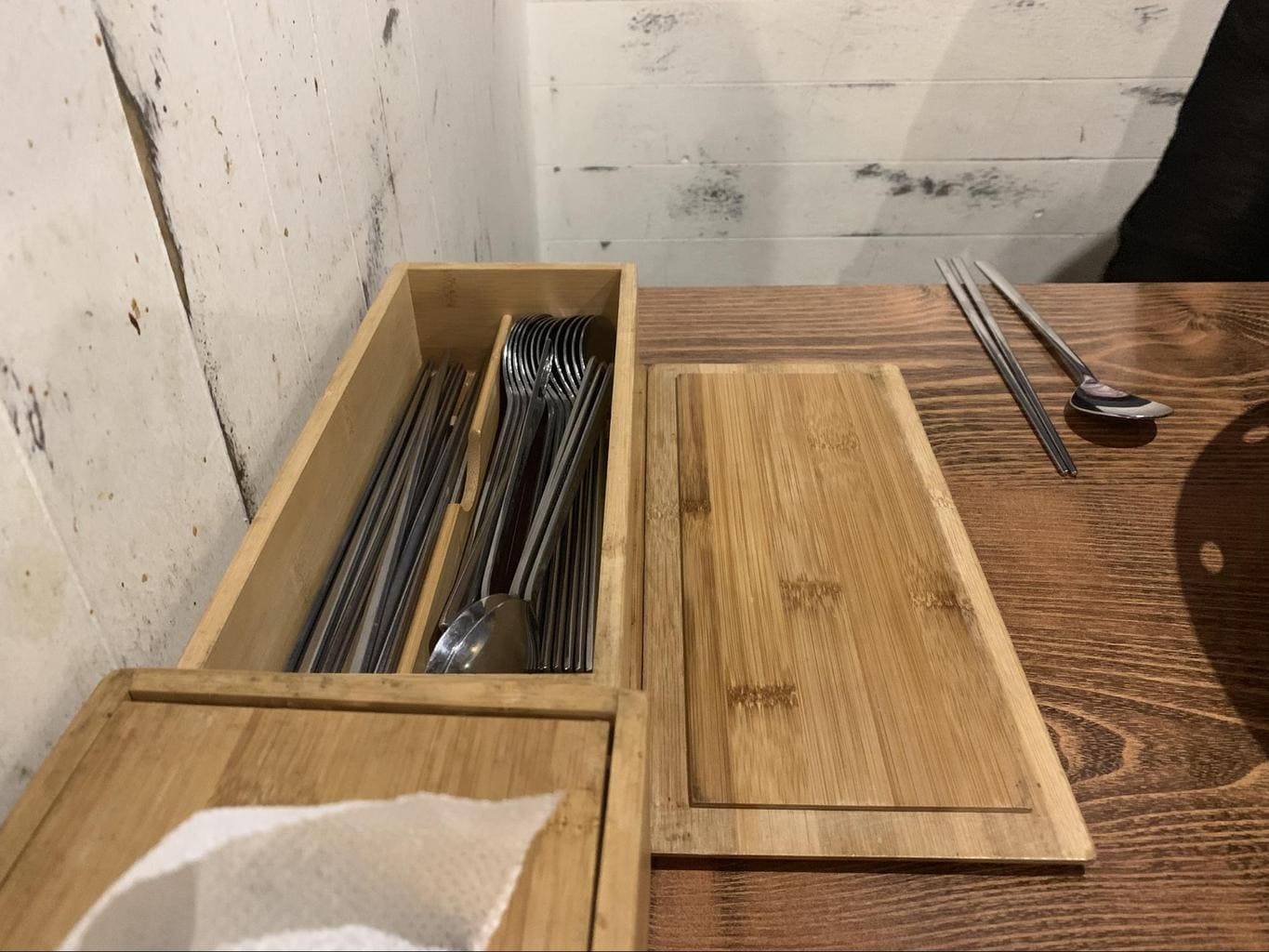
Unless you are ordering Western food, your meal will come with metal or wooden chopsticks and a spoon. Some restaurants offer forks if they see you are struggling, but not all will have. It’s up to you to bring your own fork if you struggle with chopsticks.
Sometimes cutlery is hidden out of sight. If this is the case, either it will come with your meal, it may also be in a small container on the table, or it might be in a cutlery drawer underneath the table.
Self water / coffee / side dishes

Most restaurants have a free water filtration system. You are expected to collect your own water and if you are with locals, you will also get water for the entire table as a custom. Sometimes there is free mix or capsule coffee too. If it isn’t free there should be a price nearby.
Traditional Korean food comes with several side dishes like kimchi or sigeumchi (seasoned seaweed). If you finish one, don’t be afraid to ask for more, they will bring it to you for free. Just know that the second helping is usually aggressively larger and you are expected to finish everything. Sometimes side dishes are also self service where you can fill up to your heart’s content. Look for the “Self” sign to see if anything is self service.
Vegan & Vegetarian friendly
I am a pescatarian and know very well about vegetarianism in South Korea. When I first arrived there was one single vegan restaurant in the entire country, but now it seems to be coming a new craze. From all the Impossible Burgers sprouting up in the fast food chains to plant-based restaurants, South Korea is becoming more vege friendly.
Beware that if you use ask if something has “meat” in it (gogi in Korean) and the person answers “no”, don’t be shocked if you bite into a piece of ham. You will have to say that you are vegetarian rather as there are multiple words for various types of meat and Koreans will take you very literally. Gogi means “cow meat”, so if it has “pig meat” they will answer you directly.
Broths will 99% of the time contain some form of meat or bones. So if you ask if the kimchi or tofu stew has meat in it, and the answer is “no”, what they really mean is, “It was made using meat but doesn’t include chunks of meat in its current form”.
Join the Seoul Veggie Club on Facebook where you can find all the best plant-based restaurants and food in the city. Happy Cow is another great option to finding the most amazing and avant-garde restaurants that do not have meat on the menu.
Cafe culture – Sitting / working in a cafe

As a digital nomad, this is probably one of my favorite parts about living in Korea. There seems to be an endless stream of cafes and coffee houses throughout the country. It’s not an uncommon sight to see five Starbucks on one block, surrounded by other chains like Ediya, Coffee Bean & Tea Leaf or Mega Coffee with a sprinkle of mom and pop stores.
One of the best things about these cafes is that they are a digital nomad’s dream with super fast free Wifi, power outlets, bathrooms and pretty comfortable seats. The best part is that, unless you’re at a more boutique cafe, you won’t get evil stares from the staff when you’ve been sitting there for several hours.
South Korea also has something called a “study cafe” where you can hire a desk for a specified period of time. Shared workspaces are also popping up in Seoul like WeWork or FastFive . But coffee shops, especially the chains, are still amazing places to go to get some work done. The larger double, triple or even quadruple storey mega franchises are always great if you want a bit of privacy. And this is all for the price of an Americano.

Coffee shops are a little different in Korea than in other countries. They are more focused on dessert and baked goods than brunch and meals, as bread is a dessert food in Korea. So don’t go expecting a huge assortment of food.
Cafes also tend to get really busy after lunch as they are usually post-lunch meetup spaces. So if you want to get a seat, try going mid-morning before the rush. And when you’re done, always take your mug and plate back to the designated spot, don’t leave it on the table. As you can stay in cafes for hours, some places offer discounts for takeaways so that more seats open up, or if you bring your own tumbler.
There are also designated areas in certain districts called Cafe Streets (Cafe gori) which is a cluster of cafes all in one walking street. Great examples include Samcheongdong (near Gyeongbokgung), Buamdong (only reached by bus), a few in the Hongdae / Hapjeong / Sangsu area and a really romantic one near Jukjeon Station in Bundang, Gyeonggi province.

This is one of the most important South Korea travel tips, especially when dining with locals. Dining with others is an art in South Korea. When a Korean person invites you to a meal and at the end the bill is miraculously paid, don’t take it personally.
Of course, the situation may differ depending on who you are dining with, but usually the oldest person at the table or the senior of the company will pay for everyone. You can then pay for coffee, dessert, or wherever you go for round two or three if you are younger.
If someone travels to your area, you will need to pick up the check as they have put in the effort, and vice versa. Going Dutch (splitting the bill) is not really a thing here. Although, things are changing a bit with the younger, more worldly, generation. But still, expect an awkward pause or a bit of a struggle if you say “Shall we split?”
You may need to be quite sneaky if you want to pay for a meal. The best is to say you’re going to the bathroom and then you take the bill with you to the counter to pay. Expect to be berated and shouted at by the oldest at the table if you do pay as you may have disrespected their honor. It’s all about knowing the person you’re dining with. I still have no clue when I’m supposed to pay for my Korean in-laws.
Pouring drinks, dishing food

Drinking is a serious and subtle art in Korea. The most important thing to know is that you don’t decline a drink from someone who is older than you unless you have legitimate religious or health concerns. You are also expected to keep up with the oldest, having as many shots as them. One cheat is to sip slowly and always leave some alcohol in your glass. If your glass has liquid in it, it will not be topped up.
If you are the youngest, keep a hawk’s eye on the other diners’ glasses. It is customary to pour for other people and to always top up when the glass is empty. You pour with one hand, the other hand holds onto your arm or rib while you pour. To receive a drink, hold your cup with two hands. When taking a sip it is customary for the younger individuals to turn their heads either to the right or away from the table, covering your mouth with your left hand as you drink. If someone is topping you up and it is enough, gently lift your glass up to inadvertently tell them “it’s enough”. When toasting, say “geon-bae”.
As with alcohol, if your dish is empty, it means you want more. Always leave a bit of food on your plate if you’re done. If you see others with empty plates, you can take some of the shared food and place it on their dish. If one of the side dishes is empty, call the server and ask for a top up – the table will be very impressed with you.
Before the meal, you can place tissues at the table and then lay out the chopsticks and spoons as well. If there is self service water, you can pour a glass for everyone at the table.
The importance of sharing & communal eating

Following from the previous point, you should know that eating with company in Korea is a shared experience. This means that you will sit around a table and order a meal for everyone to share, unless it is a Western style restaurant. This is exemplified by Korean BBQ where you sit at a round table, cooking a meal for everyone to eat.
Side dishes, main courses and desserts are all shared. This takes quite a bit of getting used to if you come from the West where it’s all about the individual. Dining is not about “what do I feel like today”, it’s more about sharing time together and eating “delicious food”.
So what constitutes delicious in Korea. Healthy and fresh are the words that come to mind. You will find that Korean food has much less sodium and sugar than other countries, so expect a bit more of a dull taste. Over time your palate will change and when you return to the West everything will taste processed and unhealthy.
You will most likely never be invited to eat at a Korean person’s home as this is not the norm for the culture. To dine with a Korean is to learn a lot about the culture and the traditions.
Street food & pochang macha

A top experience in Korea is to dine on some deep fried, sugary street food at a pochang macha. Pochang macha are street food vendors housed in makeshift clear tented apparatus. They are either set up randomly around the area or at a specific location like Jongno 3-ga Pojangmacha Street, Namdaemun or Gwangjang Market, or even underground at Jamsil Station.
We will not tell you what amazing food to find or where to find, that’s all been written in our article on the Best Korean Food in the street food section . What we focus on here is street food dos and don’ts.
Eating street food at a pochang macha will be a different experience depending on the type of establishment. Some places you sit down, have a few drinks and eat multiple courses. Other places you stand, munch down your meal as fast as possible and leave. If the pochang macha has seats and it’s night time, it’s usually a longer affair.
Unless you’re in a very touristy area, English will most likely not be spoken, so you will need to know how to order your food in Korean. Some vendors will have card machines, but it’s always best to pay in cash so that they don’t have to incur any fees.
If you’re eating tteokbokki (spicy rice cakes) and odeng tang (fish cake soup) from a wheel cart vendor, know that you can drink as much of the soup as you like, just use the ladle and dish up for yourself. Know what you want to order and how to order before you go up to the cart as the vendor will not be patient. Don’t even expect them to look at you, just shout your order and pay the money. Eat there or take it away, the choice is yours.
Ordering food at a pub, bar or hof

The biggest difference between going to a bar in the west and one in South Korea is that you’re expected to order food with your drinks. The type of food will depend on the establishment ranging from Western style finger food to Korean snacks to full on pub food.
One thing for sure is that you will at least need to order one thing off the menu along with your drinks, even if you’ve just had a gigantic meal a few minutes before. The words pub, bar and hof are basically used interchangeably to mean a watering hole with snacks.
Sometimes there will be electronic dart boards and other fun stuff too. These days wine bars are also gaining in popularity. While they are usually pretty pricey, there are some cheaper ones like the Wine Han Jan franchise.
South Korea travel tips on etiquette

While a lot of Korean etiquette has been discussed throughout the article already, we thought it would be nice to have some general etiquette tips so that you don’t commit too many cultural faux pas.
As you saw in the food section above, there are a lot of intricate dining and drinking musts that are interwoven into the culture. The biggest take away is that you need to respect your elders. This is shown most noticeably in the language where the wording will actually change depending on whether you’re speaking to someone older or younger than you, whether they are senior or junior at your company.
While you most likely won’t be learning the language on your trip, respecting your elders is evident in other areas of Korean life. For this reason, one of the first questions Koreans ask is your age. This is not considered rude, in fact, it would be rude not to ask as you may be speaking impolitely by using the incorrect phrasing.
Respect for your elders and also the patriarchy has its roots in Confucianism which places emphasis on family, personal betterment and respect for age and authority. It is the reason why Korean women may seem more timid, why the elderly are treated so well and why everything in Korea is about family and the community.
If you come from a Western country, which places more emphasis on the individual, this may be quite a shock to the system. My advice would be to go with flow, silently observe the difference in culture and don’t visit Korea with the idea that an entire culture with thousands of years’ history should change to suit your “modern” needs.
This may sound harsh, but many Westerners visit without considering that things will be vastly different which leads to anger and rage. Visiting Korea is a chance to really explore a wonderful nation with many great practical positives that you can take home with you.
No doubt you’ll witness the harsh elbows of the furious ajumma at the bus stop (ajumma is the word for “aunt” but is basically a stereotypical middle-aged to elderly woman), the politically incorrect meanderings and wind breaking of the ajeossi (like ajumma, but for a man), the leech-like store clerk following your every move and the handbag carrying 20-something man. Soak it all in, be attentive, let things slide and you will have a wonderful time.
- Check if you need a visa, get help processing it at iVisa .
- Never ever leave without travel insurance. Get affordable coverage from World Nomads or long term insurance from Safety Wing .
- I find all of my flights on KAYAK . Check their Deals section too.
- Search for all your transportation between destinations on the trusted travel booking platform Bookaway .
- I book all my day trips and tours via GetYourGuide , they are the best and their tours are refundable up to 24h in advance.
- Get USD35 off your first booking with Airbnb .
- Compare hotels EVERYWHERE at HotelsCombined and book with Booking.com .
- Compare car rental prices at Rentalcars.com
You may also like
Winter in korea – where to go, festivals,..., where to stay in seoul and best hotels, the most delicious korean food, safety in south korea, complete seoul itinerary – 2, 4 & 7..., amazing south korean festivals you cannot miss, 30+ facts on south korea, 10 things you didn’t know about traveling to....
7 Essential Seoul Travel Tips for First-Timers (+ everything I wished I knew)
The first time I went to South Korea, I spent three weeks there, with two weeks in Seoul as a super-tourist and took beautiful side trips to Jeju Island and Busan in the south.
Here’s everything I wish I knew before going to South Korea as a tourist. These are specifically Seoul travel tips, but some can apply to South Korea travel in general.
If you’re new to South Korea, read my South Korea travel guide .
📖 Read Next: 28 Places to Visit in Seoul and watch the vlog 🎥
Prebook before your trip: 📲 Local sim card or eSIM card from Klook 🚊 Ride from the airport: prebook a transfer | airport bus | AREX train 🚊 Purchase a KTX Pass online for travel to multiple cities 💳 Buy a pre-loaded T-money card 🚙 Rent a car in South Korea for as cheap as $28 USD a day 🎫 Browse through dozens of available South Korea tours
Table of Contents
Best Area to Stay in Seoul
Seoul is massive, but these are three main areas where tourists generally stay.
📖 Read next: Where to Stay in Seoul Based on Your Interests
1. Central-Northern Seoul
If you want to be closer to the main tourist attractions like all the palaces and famous shopping streets, stay in the Insadong or Myeongdong area more up north.
If you like to be around a nightlife, stay in Itaewon. There’s a lot of locals and foreigners who go there. People party on the weekdays til early morning. There’s also a lot of restaurants and shops there.
🍶 Looking for a social night activity? Consider joining a Seoul pub crawl
For a busy but chiller vibe, stay in Hongdae, which is known for being the youth and indie music culture area. There’s a long walking street with tons of cute cafes, shops, and music performances.
Free printable of 70+ places to visit in Seoul
Check your email for your Seoul bucket list.
Seoul Travel Tips: My Recommendation for First-Timers
If you’re staying longer than a week and don’t mind moving hotels, I recommend trying out 2 or 3 hotels in separate areas just to experience different parts of Seoul , which is what I did.
But for first-time tourists , I recommend staying closer to Insadong and Myeongdong. It’s just closer and easier to get to the main tourist sites.
My favorite stay was Travelodge Myeongdong City Hall (photo below).
Basic Korean Language Travel Phrases
English is not widely-spoken in South Korea. It’s best to learn some basic phrases if you’re just visiting.
In non-touristy areas or restaurants, menus may not be provided in English.
But, you can use Papago or Google Translate to scan the menu text to English.
9 main Korean phrases to learn and what I used the most
- Hello : Annyeonghaseyo (ahn-nyung-ha-seh-yo)
- One please (Just 1 person, or 1 of this): Hana juseyo (ha-na joo-seh-yo)
- Sorry : joesonghamnida (jeh-song ham-ni-da)
- Thank you : Kamsahamnida (kham-sa-hum-knee-dah)
- No : animida (ah-knee-me-dah)
- Yes : ne (neh)
- No thank you, or it’s alright : Gwenchanayo (gwen-chan-nah-yo)
- How much is it? : Eolmayeyo? (ol-ma-eh-yo)
- I don’t speak Korean : Hanguk-mal motteo (ha-ng-gook-mul mo-teh-yo)
Just remember, we’re visitors. We can’t expect locals to know or speak English to us. And if you ask someone for help and get rejected, try not to take it personally. They might have been too shy or were just busy!
Airport Tips for Seoul, South Korea
At the Incheon Airport , you want to do these 3 things:
1. Pick up a local sim card : IF your phone is unlocked. You can buy a sim card there or preorder a Korea sim card on Klook . 10 days of data costs about $20 USD.
📲 I usually use Airalo for esims in South Korea . You can use my code ROSEAN3468 for $3 USD off your first purchase.
2. Get some won, which is the currency in Korea. Credit cards are widely accepted in Seoul, but get back up cash, and for like food stalls that only accept cash.
In general, the ATM offers a better rate than exchanging at the airport. But do whatever’s easiest.
3. Lastly, buy a T-money card at the airport or at any convenience store. It costs about $2 USD. It’s a card that you can use to pay on trains, buses, convenience stores, some supermarkets and restaurants. Some taxis even accept it.
🎫 To make it easier, buy a pre-loaded T-money card to pick up at the airport
You can use it throughout South Korea, not just Seoul. But, if you don’t want to get a T-money card, you can just buy paper tickets at the train station. But getting a T-money card is one of the top Seoul travel tips you’ll read.
It takes about an hour to get to Seoul from the airport. Here’s some transportation options to/from the airport:
- Take the AREX express train. You can book your ticket in advance here .
- Hail an airport taxi or book a Kakao T or Uber taxi ( check my example Uber in Korea costs ).
- Arrange an airport pickup or drop off in advance.
- Take the subway, which will likely mean a transfer at Seoul station.
- My favorite: take an airport bus , which stops by major areas in Seoul.
How to Get Around Seoul – Transportation Tips
The first time taking public transit in a new country is always nerve-wracking! But it gets easier. And signs and ticket machines are in English. Here’s 5 main Seoul travel tips for getting around the city.
1. I highly recommend downloading the app CityMapper, which is in English. You can download Citymapper right now just to get an idea, and it’s simple to use. The app show directions for trains, buses, and walking.
2. You can’t rely on Google Maps. It’s not optimized to use in South Korea, especially for walking directions. If you’re looking up just walking directions on Google Maps, nothing will show up.
The most popular apps for getting around in South Korea are Kakao Map and Naver Map , which I still have, but they’re less user-friendly in my opinion. They are most helpful though when traveling Busan and Jeju Island.
3. You can add money to your T-Money card at a ticket machine in a train station, or at any convenience store. You have to use cash.
Depending on how long you’re in Seoul, start with 10,000 to 20,000 won. The base fair for trains is 1250 won.
4. When riding a train or bus, don’t sit in the designated areas for elderly or pregnant women, even when the train is empty. This is not the US. 😉
5. And last thing about train stations, elevators and escalators are not common . There are elevators, but they’re in certain entrances that you have to look for, and are just harder to find in my opinion.
You’ll rarely see this in Seoul travel tips posts, but prepare for a stairs workout if you’re not able to find them, but don’t be afraid to ask others.
How to Take Buses in Seoul
Buses may seem intimidating, but are pretty easy to take. Just look for your bus number on the bus stop sign. Once you’re on the bus, tap your T-Money card on the card reader and tap again when you get off the bus.
Buses cost 1,200 won. Only major stops are announced in English. I use Google Maps or another Maps app for this to follow the dot so you know when to press the stop button.
How to Take the Taxi in Seoul
1. Uber works in Seoul. When you open your Uber app, it converts to Uber T. Your original payment info is already saved in there. You don’t need to pay in person.
2. If you do have a local sim, you can also download Kakao T , which is the main taxi app. If you’re a foreigner though, you can’t link your credit card to the app. You’ll have to pay with cash or T-money card at the end.
Kakao taxis are more readily available than Uber, but sometimes you’ll come across a language barrier if the driver can’t find you. There’s still plenty of Uber drivers. Sometimes you just have to wait a bit longer.
3. Tipping for taxis is not common.
What to Pack for Seoul, South Korea
Here are a few essential packing items for Seoul:
1. Plug Type F
In case you don’t know, South Korea uses a specific type of plug for charging your phone or laptop. It’s not the same as in the US.
You’ll have to get a plug type F charger , which is the same as a lot of European countries. Or just get a universal travel adapter , especially if you plan to travel a lot.
Some hotels do provide a USB plug, but most don’t. Make sure to get the correct plug. You can also look for one in a convenience store or supermarket in Seoul.
2. Umbrella!
If you’re visiting during the summer months of June to August, bring an umbrella, or buy one from a store, and carry it with you. Rain stops and goes.
📖 Read my Summer in Seoul tips and experiences .
3. Skin Protection
General tip, bring a hat and sunscreen to protect your skin from UV rays. One of my top Seoul travel tips.
4. Walking Shoes
Bring good walking shoes. You’re most likely going to be walking a lot. I wear Xero Shoes – I can walk for hours and not have sore feet.
Culture Shocks and Cultural Differences
Here are just some random cultural differences and observations in Seoul.
1. Seoul is generally safe, and statistically safer than many countries. Always be careful of your surroundings, but I walked alone past midnight and it was fine. If you need to call for help, the number is 112.
2. Most of the restaurants I went to were self-service, which also meant returning your plates and cups to the counter and clearing out any napkins from your table.
If you’re unsure, just look at what other people do, which is what I did. ^^
You usually pay at the counter. And tipping is not common at all.
3. For those going in the summer, it gets REALLY hot. And it sometimes rains. I was always drenched in sweat. But when I looked at the locals, they looked flawless.
4. Lastly, here’s the tea, don’t expect locals to be social and friendly to you just because you’re a foreigner or an obvious tourist. They’re just minding their own business.
If you want to make friends, you have to actively try, join a meet up, a club, or English exchange. At least, that’s my experience.
And if you just want to enjoy traveling solo, that’s fun too. There’s so much to do in Seoul! You won’t run out of things to do alone. Look out for my solo Seoul travel tips post coming soon.
Top Places to Visit in Seoul
There’s always something to do in Seoul. Nature sites, cultural and historic sites. Entertainment. Here are 4 of my favorites spots.
Looking for more? Check out my 28 Places to Visit in Seoul list.
1. Gyeongbokgung Palace
If you only have time to visit just one palace in Seoul, go to Gyeongbokgung Palace . It’s massive and so beautiful.
There’s historical sites as well as nature sites. It feels like a time-hop. It’s the most popular palace and only about $2 USD.
🚌 Join a group tour for Gyeongbokgung Palace + Temple Guide
2. Cheonggyecheon Stream
This must-visit is a 7-mile stream in the middle of downtown. You can walk it or sit on a step and put your feet in the water. At night it’s lit up as well. It’s open 24 hours.
🌌 Join a Seoul Moonlight night tour of Cheonggyecheon Stream, Royal Palace, & Naksan Park
3. Bukchon Hanok Village
This is a beautiful neighborhood of hanoks, or traditional Korean houses designed with nature in mind. It’s really pretty to walk through. People also dress in traditional hanboks to take photos. You can rent a hanbok online to pick up .
4. Namsan Seoul Tower & Park
You’ll get a beautiful view of Seoul on the way up and down. I’d probably go there multiple times. The park itself is huge and the views are amazing.
🎫 Pre-book your Namsan Tower cable car ticket to skip the lines
Hope these Seoul travel tips were helpful!
Have a great time in Seoul!
Check out my city guides for: Jeju Island | Busan | Gyeongju | Pohang
Related Posts
Best One Day in Seoul Itineraries (+ Hour Breakdown)
Where to Stay in Seoul Based on Your Interests (from a Frequent Visitor)
28 Top Seoul Attractions to Check Out in 2024
My Summer in Seoul Experiences + Tips (Worth it?)
Uber in Korea: Where it Worked & Where it Didn’t (+ Costs)
7 Best Parks in Seoul to Visit in 2024 – Don’t Skip These!
How to Visit Yonsei University in Seoul – Kdrama Filming Sites 13 Free Things to Do in Busan (Popular + Underrated Spots!)
Roseanne Ducut is a solo female traveler and Filipina from the Bay Area, California. She writes practical and culture-rich travel guides and encourages solo female travelers to take #yolo trips. A veghead for over 15 years, Roseanne also writes vegan guides to help others plan their trips.

A Korea Travel Guide
If you’ve found yourself on this page, yay! I love when people want to come visit one of my favorite places in the world. Korea has become somewhat of a second home to me – a place I always feel somewhat comfortable in, even if I’ve been away for a while. I first visited in 2011 when I studied in Seoul for the summer and returned in the fall of 2014 to teach English in the countryside. I spent two years living in Namwon and traveling on the weekends and then I came back in 2017 to teach for one more year in Suncheon! Now I go back at least once a year to visit friends and to continue exploring this country (although with how the world is, it’s been 2 years). I hope you find all my guides helpful!
Just Starting to Plan Your Trip?
Check these posts if you’re just starting to plan your trip to Korea, especially my very long travel tips post which will give you quite literally everything !

Tips & Guides
50 South Korea Travel Tips
80 Things to Do in Korea: The Ultimate Bucket List
Korea Trip Planner: All the Logistics
The Best Apps for Korea Travel: Which Ones I Use and the Ones I Don’t
22 Places in the Korean Countryside You’ll Love

Inspiration
102 Unbelievably Beautiful Places in Korea
20 Photos to Make You Fall in Love with Traditional Korea
85 K-pop Summer Songs from 1985 to Today: Your Ultimate Playlist
12 of the Best Korean Dramas I Recommend to My Friends (And 4 I Don’t)

Itineraries
How to Spend 2 Weeks in Korea: 4 Itinerary Ideas
The Only 1 Month Korea Itinerary You Need
A Very Efficient Korea Itinerary for 7 Days

Summer in Korea: What to Do + How to Stay Cool
Autumn in Korea: Forecast, Food, Festivals, and More
Best Places to See Fall Foliage
A Guide to Winter in Korea
Spring in Korea: Top Tips and Things to Do
Cherry Blossoms, Korea : A Forecast Guide & Where to Go

What to Eat & Drink
Your Guide to the Best Korean Food: 66 Dishes & Drinks!
All About Kimchi

Learn Korean
Getting a Tattoo in Korea – Is it Illegal?
14 Unique Gift Ideas for Your Friend Who Loves Korea
A Guide to Hiking in Korea
Seoul & Nearby
Every country has its major city, and for Korea that’s Seoul (which is also its capital)! Located up towards the northwest part of the country, it’s easily one of my favorite metropolitan areas in the whole world.
There’s just SO much going on no matter what you’re looking for, and it’s always changing.
It’s also very easy to see some cool nearby sights in Suwon and Gyeonggido, like a French storybook village, a kitschy island, a huge fortress, and more!

Seoul Guides
Seoul Travel Guide
13 Free Things to Do in Seoul
One Day in Seoul: 5 Layover Itinerary Ideas
7 Cool Libraries & Bookstores in Seoul

Where to Stay
Where to Stay in Seoul: Best Neighborhoods + Hotels
10 Best-Rated Hotels in Insadong
10 Best-Rated Hotels in Gangnam
10 Top-Rated Hotels in Hongdae
10 Best Hotels in Myeongdong by Reviews

The Palaces
The Five Grand Palaces of Seoul: A Guide
Gyeongbokgung
Changdeokgung Palace and its Secret Garden
Get an Aerial View of Deoksugung Palace

Cafes in Seoul
25 Cafes in Seoul: the Trendiest & Most Brewtiful
Seoulism (서울리즘): the Cafe with Views to Lotte World Tower
The Trendy Stylenanda Pink Hotel + Pink Pool Cafe in Seoul
The Dreamy Camera Cafe

Quirky Seoul
10 Quirky Things to Do in Seoul
What to Expect at the Hongdae Trick Eye Museum in Seoul (Some NSFW)
Complete Lotte World Guide
Complete Guide to Everland Theme Park

Scenic Seoul
Bugak Skyway: One of the Prettiest Views in Seoul
Ihwa Mural Village
What to Expect on a Han River Cruise
Guide to Seoul Sky Observatory

A Storybook Escape from Seoul
How to Visit the Incredible Suwon Fortress
17 Fun Day Tours in Seoul and Nearby
One of the most charming places to visit in Korea – Jeju! I always say it takes all my favorite parts about the mainland and does away with the more frustrating aspects. Definitely rent a car or arrange a driver so you can take your time and explore the island at the nice, slow pace you ought to!

Jeju Guides
Quick Guide to Jeju
30 Incredible Things to Do in Jeju + My Secret Spots!

Where to Stay in Jeju: An Expert Guide
25 Unique Jeju Airbnbs You’ve Got to Book

Specific Areas
Udo Island: A Little Travel Guide
Jeju’s West Coast
Jeju’s East Coast
North Jeolla Province (Jeollabukdo)
Jeollabuk (and Jeollanam below) are two of the provinces closest to my heart because they’re where I lived. Jeollabukdo, also known as North Jeolla or Jeonbuk, is down towards southwestern Korea and sits along the coast to the Yellow Sea.
Its main capital is Jeonju and as a province is known for its food. I’d go so far to say that Jeollabuk and Jeollanam are the best places to eat food in the whole country! Back when I lived in Namwon, I remember my friend going to Seoul and being unimpressed with the Korean dishes in the city compared to what we got everyday between our schools and ordering takeout!

City Guides
Namwon, Korea: A Local-ish Guide
Jeonju Hanok Village: A Complete Guide

Hiking in Jeollabuk
How to Hike Guryong Valley in Jirisan
Jirisan’s Baemsagol Valley Course
Naejangsan National Park: Finding Fall Colors
Hiking Wolchulsan to Cross One of Korea’s Must See Bridges

Temple Stay
Experiencing a Temple Stay in Korea at Naesosa
8 Lessons Learned from a Buddhist Temple Stay

Other Places
Enrogel Teapot Café
South Jeolla (Jeollanamdo)
Below Jeollabukdo is Jeollanamdo, aka South Jeolla or Jeonnam. This province sits all the way down to the southernmost tip of mainland Korea and surrounds the major city of Gwangju.
Historically, it, with Jeonbuk, was established in 1896 as one of the Eight Provinces of Korea (then they were both combined to be Jeolla). Today it’s home to some of the prettiest places in Korea! I’m talking a bamboo forest, a folk village, an ecological bay, tea fields, islands… There’s a reason I centered my tour around Jeollanam!

What to Do in Suncheon, Korea: A Local-ish Travel Guide
Suncheon Bay Garden – How to Visit
How to Visit Suncheon Bay Wetland Reserve
Suncheon Open Film Location – A Step Back in Time
Hiking Between Two Mountain Temples in Jogyesan
Naganeupseong Folk Village: How to Visit This Traditional Fortress Town

Damyang Travel Guide
Meta Provence, Damyang: A Little French Inspired Village in Korea

Seasonal Festivals
Gokseong Rose Festival
The Gwangyang Maehwa Festival: Finding Plum Blossoms in Korea
Visiting the Gurye Sansuyu Festival

Fun Things to Do in Yeosu, Korea + A Travel Guide
Boseong Green Tea Fields: Everything You Need to Know to Visit
Other Provinces
Admittedly, I don’t have quite as much experience with the other provinces on mainland Korea, which is part of what I’m hoping to fix with future trips!
Chungcheongbukdo and Chungcheongnamdo always felt a bit like the forgotten provinces that I passed through from Namwon to Seoul, but I couldn’t tell you what was there to do or see.
Gyeongsangbukdo and Gyeognsangnamdo are in the southeastern corner of Korea and surround Busan. They’re home to loads of cool coastal spots.
Gangwondo sits all the way up north and might be familiar as it’s where the Pyeongchang Olympics took place! I would say of all the provinces it feels the most like the countryside. Loads of amazing hiking and skiing in the winter.

Chungcheongbuk & Chungcheongnam
Hiking Daedunsan in the Fog
A Guide to Hiking Gyeryongsan in Korea

Gyeongsangbuk & Gyeongsangnam
A Quick Guide to Tongyeong, South Korea
How to Visit the Hwagae Cherry Blossom Festival
The Famous Jinhae Cherry Blossom Festival: ALL You Need to Know

Hike Seoraksan, One of Korea’s Tallest Mountains
A Hiking Guide to Odaesan National Park in Korea

18 Best Things to Do in Busan, Korea
A Guide to Gamcheon Culture Village: the Most Charming Place in Korea
Teaching & Living in Korea
For those of you hoping to live and work in Korea, hopefully these posts will help you out!

Your Ultimate Guide to Teaching in Korea

How to Save Money in Korea as a Teacher: Realistic Expectations, Budgeting, and How to Make Extra

How to Get a Korean E2 Visa in Japan

Promotions apply when you purchase
These promotions will be applied to this item:
Some promotions may be combined; others are not eligible to be combined with other offers. For details, please see the Terms & Conditions associated with these promotions.
Image Unavailable

- To view this video download Flash Player
Follow the author

Seoul Travel Guide 2024: Navigate, Connect & Experience Korea [Print Replica] Kindle Edition
Dreaming of Seoul's dazzling skyscrapers, ancient palaces, and electrifying nightlife?
But worried about navigating the bustling city, overcoming the language barrier, or sticking to your budget?
- Effortlessly exploring Seoul with our user-friendly transportation guide and QR codes whisking you directly to key locations on Google Maps.
- Conversing with confidence using our handy mini-phrasebook.
- Discovering hidden gems and budget-friendly experiences with our "Seoul on a Budget" section.
- Full Color : Immerse yourself in Seoul’'s vibrant culture through captivating full-color photographs.
- Updated Information: Stay informed with the latest insights and recommendations tailored for the year 2024.
This book is your travel companion!
More than just a guide, it's packed with:
- Family Fun: Plan unforgettable experiences for the whole family.
- LGBTIQ Travel: Explore Seoul's welcoming atmosphere with our dedicated section.
- Itineraries: Craft your perfect trip with curated itineraries for all interests.
- Safe Travels: Stay informed with essential safety tips.
Unlock your inner explorer:
- Accommodation: Find the perfect place to stay, from traditional Hanok stays to modern hotels.
- Culinary Adventures: Embark on a "Seoul Cuisine Adventure," savoring everything from street food to Michelin-starred delights.
- Shopping: Discover unique finds in vibrant markets and trendy districts.
- Nightlife: Explore Seoul's diverse nightlife, from karaoke bars to live music venues.
- Festivals: Immerse yourself in Seoul's vibrant cultural celebrations with our comprehensive festival and event guide.
- Locations are also written in Korean to make navigation easier.
Stop dreaming, start planning!
Seoul Travel Guide 2024 is your key to unlocking an unforgettable adventure. Packed with insider tips, essential recommendations, and user-friendly itineraries, this guide empowers you to create lasting memories in this extraordinary city.
EXCLUSIVE BONUS FOR PAPERBACK VERSION
It comes with a free downloadable ebook version for offline use.
Don't wait! Purchase your copy today and embark on your unforgettable Seoul adventure!
- Language English
- Sticky notes Not Enabled
- Publication date May 22, 2024
- File size 16972 KB
- Page Flip Not Enabled
- Word Wise Not Enabled
- Enhanced typesetting Not Enabled
- See all details
- Kindle Fire HDX 8.9''
- Kindle Fire HDX
- Kindle Fire HD (3rd Generation)
- Fire HDX 8.9 Tablet
- Fire HD 7 Tablet
- Fire HD 6 Tablet
- Kindle Fire HD 8.9"
- Kindle Fire HD(1st Generation)
- Kindle Fire(2nd Generation)
- Kindle Fire(1st Generation)
- Kindle for Android Phones
- Kindle for Android Tablets
- Kindle for iPhone
- Kindle for iPod Touch
- Kindle for iPad
- Kindle for Mac
- Kindle for PC
- Kindle Cloud Reader
Product details
- ASIN : B0D4ZC5WHT
- Publication date : May 22, 2024
- Language : English
- File size : 16972 KB
- Simultaneous device usage : Unlimited
- Text-to-Speech : Not enabled
- Enhanced typesetting : Not Enabled
- X-Ray : Not Enabled
- Word Wise : Not Enabled
- Sticky notes : Not Enabled
About the author
Mietrips travel.
Mietrips is a leading travel guide brand dedicated to providing travelers with comprehensive, user-friendly resources for exploring the world's most captivating destinations. Our expertly crafted guides are packed with insider tips, detailed itineraries, and practical advice to help you navigate new cities with confidence and ease. Whether you're a seasoned globetrotter or a first-time explorer, Mietrips is your trusted companion for unforgettable adventures, ensuring you make the most of every journey. Discover the world with Mietrips, where every trip is a story waiting to be told.
Customer reviews
Customer Reviews, including Product Star Ratings help customers to learn more about the product and decide whether it is the right product for them.
To calculate the overall star rating and percentage breakdown by star, we don’t use a simple average. Instead, our system considers things like how recent a review is and if the reviewer bought the item on Amazon. It also analyzed reviews to verify trustworthiness.
No customer reviews
Report an issue.
- Amazon Newsletter
- About Amazon
- Accessibility
- Sustainability
- Press Center
- Investor Relations
- Amazon Devices
- Amazon Science
- Sell on Amazon
- Sell apps on Amazon
- Supply to Amazon
- Protect & Build Your Brand
- Become an Affiliate
- Become a Delivery Driver
- Start a Package Delivery Business
- Advertise Your Products
- Self-Publish with Us
- Become an Amazon Hub Partner
- › See More Ways to Make Money
- Amazon Visa
- Amazon Store Card
- Amazon Secured Card
- Amazon Business Card
- Shop with Points
- Credit Card Marketplace
- Reload Your Balance
- Amazon Currency Converter
- Your Account
- Your Orders
- Shipping Rates & Policies
- Amazon Prime
- Returns & Replacements
- Manage Your Content and Devices
- Recalls and Product Safety Alerts
- Conditions of Use
- Privacy Notice
- Consumer Health Data Privacy Disclosure
- Your Ads Privacy Choices

6 Last-Minute Travel Tips for the 2024 Total Solar Eclipse
I n less than a month, people will look to the sky as the moon passes between the sun and the Earth in a celestial event known as a total solar eclipse . The phenomenon is set for April 8, 2024, and the next one that can be seen from contiguous United States will be August 2044 , so it's unsurprising that eclipse fever has gripped the nation. Between 1 and 4 million people are predicted to travel to the path of totality, joining the 31 million people already living within it.
Among the tours, cruises, hotels, and even scenic flights offering their own spin on the total solar eclipse experience, here are six tips that last-minute planners should keep in mind for the special day.
1. Figure out where you want to go
There are 13 U.S. states on the path of this year's eclipse: Texas, Oklahoma, Arkansas, Missouri, Illinois, Kentucky, Indiana, Ohio, Pennsylvania, New York, Vermont, New Hampshire, and Maine (small parts of Tennessee and Michigan are also in the path). Among all of these states, totality will occur in two national parks-Hot Springs National Park in Arkansas and Cuyahoga National Park in Ohio-and they're expected to get crowded. Instead, consider one of the more than 100 state parks along the path, some of which are more off the radar. If you're more of a city dweller, you can also experience totality in big cities, including San Antonio, Austin, Cleveland, and Rochester.
Consider the weather, too. According to NOAA 's past weather records, April weather seems to bring more chances of rain-meaning more potential for cloud coverage-in the Northeast than in the South.
2. Consider the length of totality
Aiming for a destination in the path of totality is a no-brainer, although the amount of totality you'll get depends on where you go. The closer to the center of the path of totality an area is, the longer the total eclipse lasts. Take Austin and Dallas: While both are on the path of totality, Austin will get 1 minute and 46 seconds of totality, while Dallas will get 3 minutes and 52 seconds of totality. The longest duration you can get for totality is about 4 minutes and 30 seconds. Particularly traveler-friendly spots to maximize your time in the dark are Texas Hill Country towns like Kerrville (which will receive around 4 minutes and 24 seconds of totality and is partnering with NASA) and Fredericksburg (which is set to get 4 minutes 23 seconds of totality). Texas Hill Country is also one of AFAR's best places to go in 2024 .
3. Consider camping
If you want a solar eclipse experience surrounded by nature rather than people, camping may suit you better. But booking developed campgrounds at state parks and well-known nature spots will likely be difficult at this point. As an alternative, check for privately owned land through platforms like Hipcamp or look for dispersed camping sites in a national forest, like Ozark National Forest or Green Mountain National Forest . While backcountry spots may not have amenities, they can be perfect for those seeking solitude.
In addition, be sure to check the capacity of a park when it comes to handling the influx of visitors for April 8. As an example, Erie's tourism board is discouraging visits to Presque Isle State Park to prevent bottleneck traffic from its one entry and exit point.
4. Look into a town, festival, or last-minute tour
Plenty of places within the path of totality are putting their own spin on the solar eclipse with dedicated festivities. Get an educational experience at Rochester Museum & Science Center's ROC the Eclipse Festival , a three-day event that includes talks titled "Frontiers of Plasma Physics" and "The Search for Earth-Like Planets" from science experts. Or lean into grandeur at the four-day Texas Eclipse Festival in Burnet, Texas; its lineup includes music performances, yoga sessions, and immersive art experiences. (If you're heading to Texas for the eclipse event in general, check out this interactive map of special activities happening across the state.)
If the mere thought of navigating trip logistics brings a headache, check for the availability of some solar eclipse tours. Some tours still have availability, like Holland America Line's whopping 22-day Solar Eclipse cruise tour through North America. Others, like Travel Quest's Mexico's Copper Canyon Total Solar Eclipse tour , only have wait-list spots. But don't give up hope: As last-minute cancellations roll in, a quick call could secure you a place.
5. Try to get a last-minute spot at hotels in the path of totality
Hotels are leaning into the solar eclipse experience too, and properties are throwing celebrations and dedicated solar eclipse events just for the event. Miraval Austin Resort and Spa is hosting a viewing session with its astrologer, while Hôtel Swexan in Dallas is offering solar eclipse wellness activities on the evening of April 8 that includes meditation, a sound bath, and a Reiki healing session.
Keep in mind that a last-minute booking may cost a premium. Properties all across the band of totality are recording sky-high prices -even budget hotels . Similar to booking tours, do your due diligence and call to check for a cancellation.
6. Come prepared
Of course, you should wear solar eclipse glasses to prevent permanent damage to your eyes. If you're going to an event, check to see if they will be provided or if you'll need to bring your own. If you don't want to buy them, you can use household materials like cardboard to make your own pinhole projector , a contraption that allows you to see the sun change shape as the moon crosses in front of it.
In addition to bringing materials for the day of the event, anticipate what happens next. The length of totality is less than five minutes, but the traffic afterwards may disrupt your plans for hours. If you're coming from a crowded park or city, be on the safe side and come prepared with extra snacks and water.

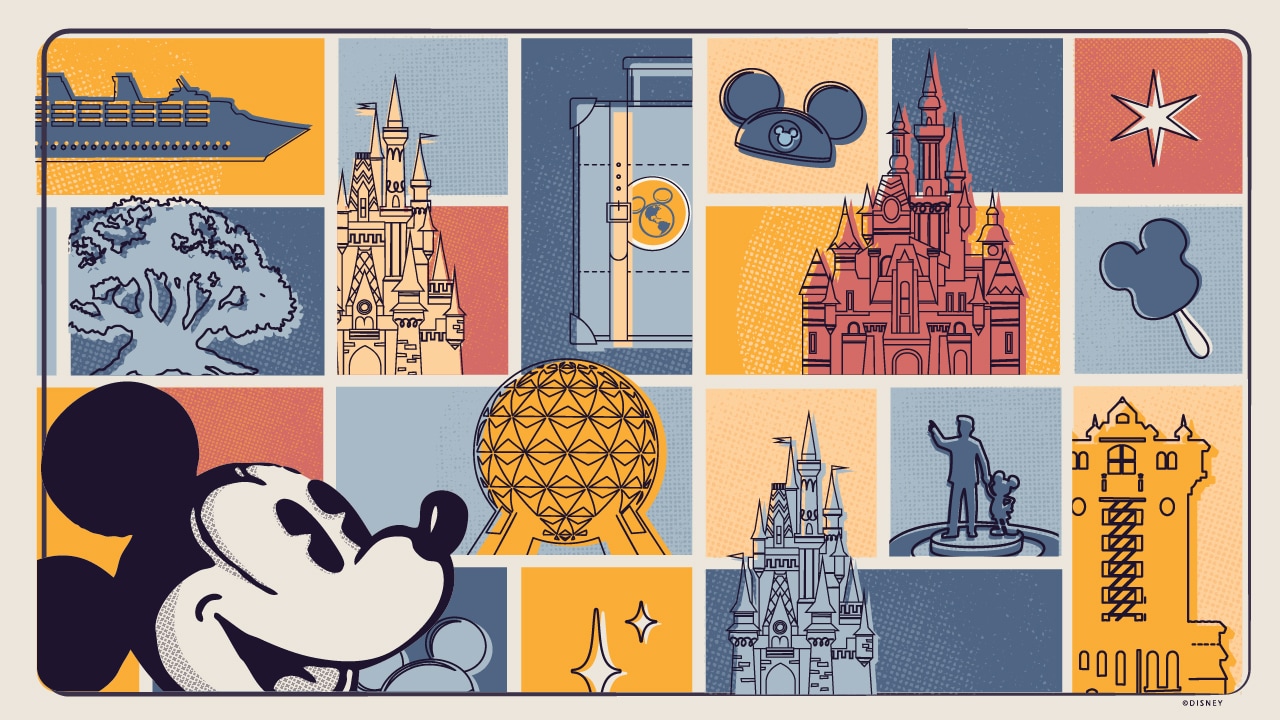
Walt Disney World Resort

Ultimate Guide to Baby Care Centers at Walt Disney World Resort
by Lisa Mendillo , Sr. Manager, Digital Integration
There is nothing quite as wonderful as experiencing the magic of Walt Disney World Resort through even the tiniest of eyes.
However, when those tiny eyes begin to cry and those little mouths quiver for food, where do you go to keep your little one happy, all while staying in the magic? Three words … Baby Care Centers !
Located within each of the four theme parks, the Baby Care Centers give families a dedicated space to take care of all of their baby’s and toddler’s needs in a welcoming, calming environment that really feels like home.
Once through the doors of the Baby Care Centers, guests will find spacious changing areas, comfortable seating, private nursing rooms (complete with rocking chairs and easy to access outlets), restrooms and TVs continually running Disney classic movies. That’s right, if there is a big brother or sister in tow, even they will enjoy a little down time here.
In addition to all the essential facilities for diaper changes and feedings, these well thought out Baby Care Centers also offer amenities such as water filter stations, sinks, bottle warmers and microwaves. And let’s not forget the highchairs!
Did you forget a bib? Perhaps you ran out of diapers? The Baby Care Centers have select essentials available for purchase. And did you know that these facilities are also the only location in the four theme parks where children’s medicines may be purchased?
The list of services all these centers have to offer goes on and on, but let’s take a moment and allow planDisney panelists Brent and Jennifer S . to show us all they have to offer as they tour all four Baby Care Centers at Disney World.
Wow, the Baby Care Centers really are so much more than a place to change a diaper! They are also a wonderful place for families to take a break and recharge.
Whether it’s for a nursing baby or a restless toddler, these facilities give everyone in the party a place to regroup, reset and get ready to delve back into the magic of their Disney vacation!
Traveling with little ones on your next Walt Disney World vacation and have more planning questions? Look no further than planDisney.com where you can ask your question and receive a personalized answer. You can also follow us on Instagram at @planDisneyPanel . And be sure to check out more tweens and teens tips on the Walt Disney World website .
Panelists receive compensation for their participation on planDisney.
Destinations: Walt Disney World Resort
Topics: planDisney
If at possible could we make the Baby Care Center bigger In Hollywood Studios it’s so small and with how many families that go to Disney this one is about an 1/8 of the other 3 Baby Care Centers.
Related Stories
A salute to military service in tiana’s bayou adventure.
by Cappy Surette , Manager, Communications at Disney Experiences and co-chair of the Veteran Employee Resource Group known as “Disney SALUTE”
21 Disney Topiaries Taking Art Form to the Next Level
by Thomas Smith , Editorial Content Director, Disney Experiences
Bunny, Bubbles, and Beulah Stun in New Country Bear Musical Jamboree Costumes
by Rachel Paige , Senior Manager, Editorial - Disney Experiences
Other Stories by

Fun, Time-Saving Ways to Get Around Walt Disney World
Ultimate guide to disney’s popular wild africa trek, sign up to get interesting news and updates delivered to your inbox from the disney parks blog.
By submitting this form, you are granting Disney Parks Blog permission to email you. You can revoke permission to mail your email address at any time using the unsubscribe link, found at the bottom of every email. We take your privacy seriously. For more information on our data collection and use practices, please read our Privacy Policy .
By providing my email address I'd like to receive updates, special offers, and other information via electronic messages and postal mail from Disney Destinations, LLC and other members of The Walt Disney Family of Companies.
You can withdraw your consent for these messages at any time. For more information on our data collection and use practices, and managing your preferences, please read our privacy policy .

IMAGES
VIDEO
COMMENTS
Only tip tour guide in the touristic areas of Korea, tipping a tour guide in the countryside is a no no as they are not used to this gesture and might be confused or offended. 4. Tipping In Hotels & Spas. The staff in hotels or spas in South Korea do not expect a tip. This might even be refused when you decide to leave a tip, don't be ...
My Personal Travel Tips For Korea. This South Korea travel guide is a collection of information I've researched and learned since moving to Korea in 2015 and blogging about Korean travel since 2019. I hope the provided information and insights are useful and assist you plan your dream first-time, or even tenth-time, trip to Korea.
Instead, try to respect their viewpoints and do your best to refrain from tipping. If you're really happy with the hotel's services, just put the tip in an envelope and leave it in the room. Avoid tipping in person at any cost. In the case of spas or conventional Korean jjimjilbangs, we strongly advise against tipping.
11. Korea Isn't Cheap. Expenses in Korea aren't quite as scary as Western Europe in summer but this isn't Thailand either, so you need to be prepared to spend a little more. Hostels will cost at least $15 USD/night but usually a bit more, and proper meals will start at around $8.
Tour guides as well as interpreters work predominantly with foreigners and thus understand the tipping culture a bit more than other industries in Korea. At the end of your tour, feel free to approach your guide and hand them a tip, with two hands and in an envelope.
We hope this Korea Travel Guide can help you have an amazing, safe, and memorable trip. Considering the enormity of planning an entire Korea tour, we will focus on providing general tips and suggestions. Subsequently, a lot of the Korean tour tips will be related to Seoul, the overall most popular tourist destination.
Look for things about the Joseon dynasty and the Korean War if you want something specific to focus on. A statue of the man, the myth, the legend — King Sejong. 3. Watch some Korean dramas, movies, or K-pop music videos. This is totally NOT necessary, but, hey, I love both of these things, so I'm biased.
Korean Seasons Guide. The best time to visit South Korea is during the warm spring or fall seasons. The weather is mild and clear, there's a range of festivals and seasonal activities to enjoy, and you can travel to Korea comfortably. The best months to visit are April, May, September, and October.
The South Korea Tipping Guide. Restaurant Server : A tip of 5 to 10 percent given directly to the server is acceptable in Western-influenced restaurants, but isn't recommended in traditional ...
Public transport directions work but walking and driving ones do not. South Korea prefers to rely on its own system rather than global companies which explains its reluctance to partner with Google. Some apps for travelling in Korea are Naver Maps and KakaoMap. Load journeys in advance to avoid getting lost. 6.
For first time travelers to South Korea, travel Apps are handy and can be useful as guide. The train and bus maps might look complicated, but you can use maps with English translations. Apps like KAKAO Maps and Naver Maps are especially for use in South Korea and are the preferred travel Apps. For more traveling tips, you can download the ...
Ultimate Korea Guide - Everything you need for your Trip! September 28, 2023. Traveling. South Korea - a land of rich traditions, modernity and breathtaking landscapes, known for K-Pop, Korean Drama, Technology, Skin care, Fashion and so much more. It became a favorite Travel destination for tourists all over the world offering an ...
Kakao Taxi (like Uber) Things to know before visiting South Korea - Golgulsa Temple. Gwangjang Market: South Korea Travel Tips. 4. Get Data! Another one of the best things to know before visiting South Korea is that although the wi-fi is good, it isn't everywhere.
Spring Festivals in Korea. Garden of Morning Calm Spring Festival | May. 16 - Jun. 17. Pohang International Fireworks Festival | May. 31 - Jun. 2. Seoul Car-Free Jamsugyo Bridge Festival | May. 3 - Jun. 23. Busan One Asia Festival | Jun. 8 - 9. All Spring Festivals & Events >>.
Flights: The cost of flights to South Korea will depend on your departure location, the time of year, and how far in advance you book. On average, round-trip flights from major cities can range from $600 to $1,500. Check Skyscanner for the best offers on flights to Seoul and plan accordingly.
Tipping in South Korea (especially if it's only 1,000 Won or two) carries strong tones of class division. It's often interpreted as a higher-class showing showing off or being demeaning to a lower-class individual. So even if you have good intentions, the gesture can be hurtful or piss someone off.
This guide is a one-stop resource on traveling in South Korea. You'll get a sneak peek into my Korea SURVIVAL Travel Guide, essential travel tips in Korea, things to know for your trip and must-try activities to do in Korea including renting a traditional Korean dress and more [About the author] 🏻 As an Australian expat that has lived in South Korea since 2022, I know firsthand how it can ...
South Korea Travel Costs. Accommodation - A bed in a hostel dorm with 4-6 beds costs 20,000-25,000 KRW per night, while a bed in a dorm with 8 or more beds costs around 14,000-20,000 KRW. A single private room is around 40,000 KRW, while a double private room is 70,000 KRW.
If you want to know more about a Korean bath house and what to do inside, here's a step by step guide to the Korean bath house culture. 11. Visit an amusement park. Lotte World: Lotte World is the most popular theme park in Seoul and is easy to get to right in the city.
Top South Korea travel tips is to familiarise yourself with the culture before visiting. Korea has a very strong and proud cultural heritage and there are a lot of interesting and unique facts worth understanding ahead of your trip and many intricacies that you can only learn by living in the country.. It pays to read up on interesting and uniquely Korean concepts like bballi bballi (getting ...
Airport Tips for Seoul, South Korea. At the Incheon Airport, you want to do these 3 things: 1. Pick up a local sim card: IF your phone is unlocked. You can buy a sim card there or preorder a Korea sim card on Klook. 10 days of data costs about $20 USD. I usually use Airalo for esims in South Korea.
Jeollabuk (and Jeollanam below) are two of the provinces closest to my heart because they're where I lived. Jeollabukdo, also known as North Jeolla or Jeonbuk, is down towards southwestern Korea and sits along the coast to the Yellow Sea. Its main capital is Jeonju and as a province is known for its food.
Seoul Travel Guide 2024 is your key to unlocking an unforgettable adventure. Packed with insider tips, essential recommendations, and user-friendly itineraries, this guide empowers you to create lasting memories in this extraordinary city. EXCLUSIVE BONUS FOR PAPERBACK VERSION. It comes with a free downloadable ebook version for offline use ...
Here are some last-minute travel tips for the total solar eclipse in April 2024, which include considering the length of totality and looking for a tour. AFAR. 6 Last-Minute Travel Tips for the ...
Wuthering Waves gives players a large open world with lots to do within. Naturally, it can be easy to feel overwhelmed by the options provided, but our beginner's guide provides a good early game ...
Ultimate Guide to Baby Care Centers at Walt Disney World Resort Tue, April 2, 2024 Fun, Time-Saving Ways to Get Around Walt Disney World ; Tue, March 26, 2024 Ultimate Guide to Disney's Popular Wild Africa Trek